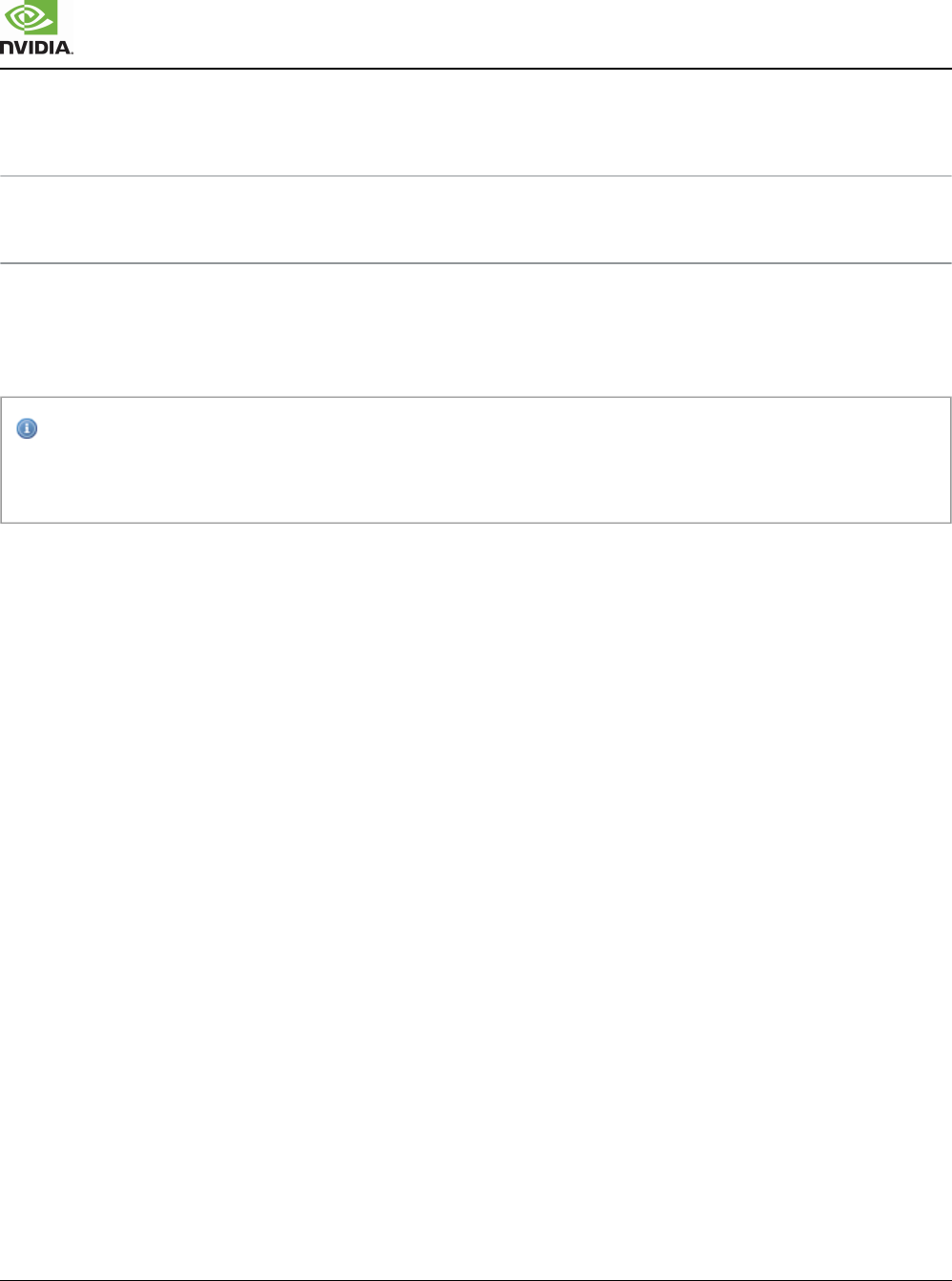
Xavier Series SoC Technical Reference Manual
XAVIER | TRM | DP-09253-002_v1.1 | SUBJECT TO CHANGE | www.nvidia.com Page of 5611 8287
8 System Components
8.1 Clock and Reset Controller (CAR)
The Clock and Reset Controller (CAR) block contains all the logic needed to control most of the clocks and
resets to the NVIDIA® Xavier series System-on-Chip. The CAR block provides the registers to program the
PLLs and controls most of the clock source programming and clock dividers.
For Xavier clocks and resets are controlled by NVIDIA provided firmware running on BPMP. This
hardware is not documented, and the software documentation should be consulted for details of how
these are controlled.
8.1.1 Reset Controller
Overview
This section describes the reset architecture for the NVIDIA Xavier series System-on-Chip (SoC), including the
®
reset-associated logic and the system-level reset domains. Asserting any of these domains results in a reset of
the majority of VDD_CORE, CV, CCPLEX and GPU rail logic and, potentially, some or all of the VDD_RTC
logic.
This reset architecture spans multiple modules, such as PMC, CAR, Timers, and BPMP. It also includes the
requirements of the downstream units. This chapter also includes details of unit-level reset generation from
these system-level resets and unit-level reset sources, such as software resets and resets for various power-
management states.
The high-level block diagram for the reset generation logic is shown in the figure below. The reset generation
logic is contained both in PMC and CAR and is a subset of those units.
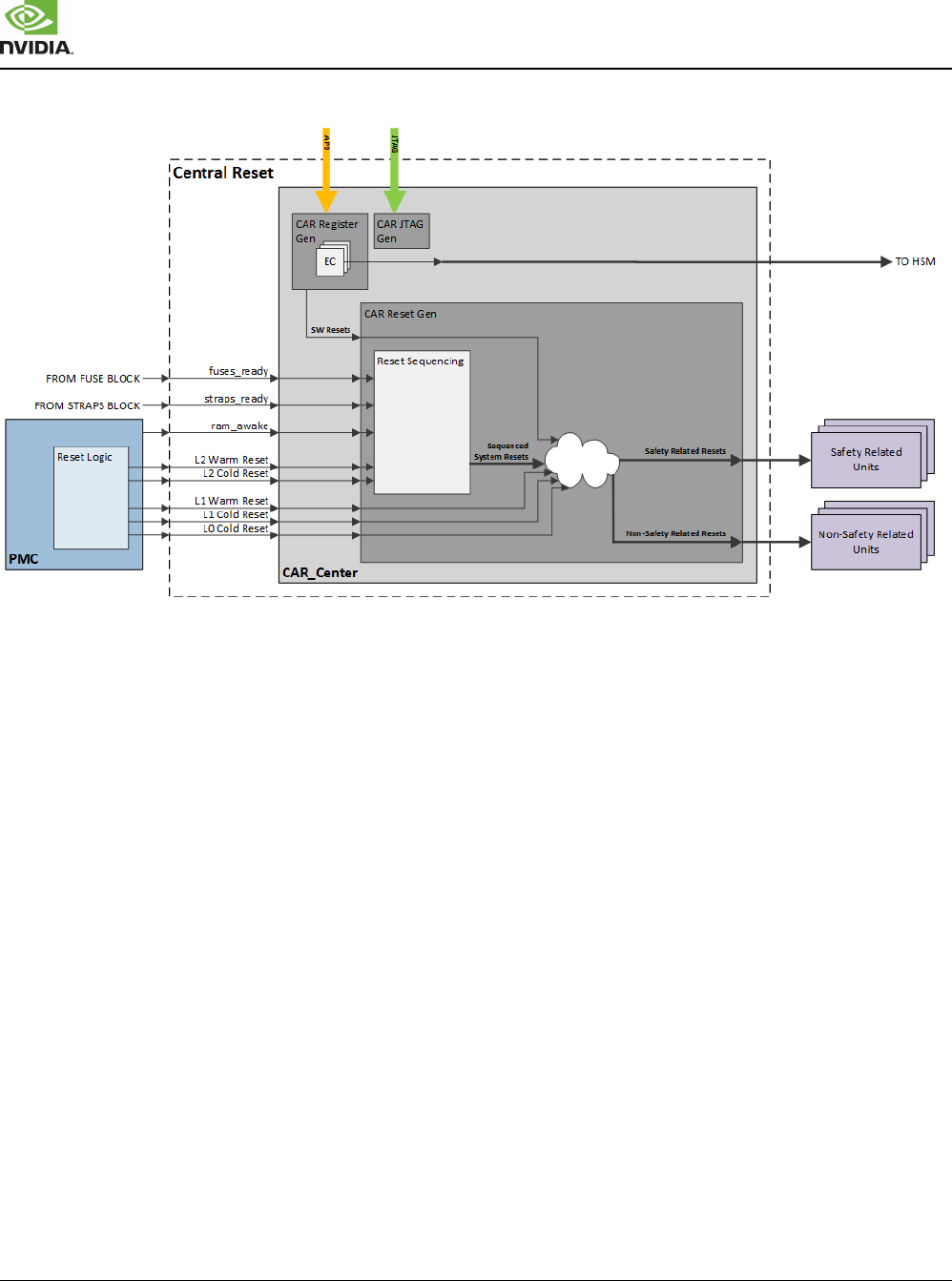
Xavier Series SoC Technical Reference Manual
XAVIER | TRM | DP-09253-002_v1.1 | SUBJECT TO CHANGE | www.nvidia.com Page of 5612 8287
Figure 8.1 High Level Reset Diagram
The reset logic has one main input from the external PMIC and one main output back to the external PMIC.
SYS_RESET_N is the reset input to the Xavier from the external PMIC. This reset is asserted when all of the
pre-boot core logic rails from the PMIC are enabled and stable and deasserted when the pre-boot I/O and PLL
rails from the PMIC, the 32-kHz clock, and reference clocks are enabled and stable. This is the only reset
source that asserts all resets from the PMC and CAR. Some register state can persist through the other internal
reset sources. Distribution of SYS_RESET_N is shown in the diagram above. SYS_RESET_N becomes
reset_IB_at the output of the pads block. It is distributed to the PMC for further system reset generation.
Also available on this interface are the watch-dog reset WDT_RESET_OUT* pads. These are sideband reset
request outputs for PMICs that support such a feature. These pads are pin-muxed and are only used one at a
time. By asserting one of these active low outputs (or sending an I C SFT_RST request for PMICs that do not
2
support this sideband input), it results in the assertion of the SYS_RESET_N to the Xavier.
8.1.2 Clock Controller
Overview
The clocking logic makes use of the following to provide the various clocks in the system, including the
frequency of operation, clock quality, spread, clock gating:

Xavier Series SoC Technical Reference Manual
XAVIER | TRM | DP-09253-002_v1.1 | SUBJECT TO CHANGE | www.nvidia.com Page of 5613 8287
Sources capable of generating frequencies independently or based on a reference clock – External oscillators, Phase-
Locked Loops (PLLs), and Noise-Aware Frequency Locked Loops (NAFLLs).
Clock manipulation elements – switches, dividers, gates, skippers, trimmers, shapers, etc.
The controls for these elements are present in the clock controller module. These controls may need to be
sequenced in an appropriate manner to ensure that there are no glitches or other clock artifacts in the system.
Features
Key features include the following:
Clock generation for all functional blocks
ASIL-C Clock Monitoring for safety-related clocks
Register parity for safety-related clock configuration registers
LUT RAM parity for safety-related NAFLL LUTs
8.2 Interrupt Controllers
8.2.1 Overview
This chapter discusses the Xavier Series SoC Interrupt controllers with focus on the mapping of all Interrupts
and the architecture for routing and handling of these Interrupts.
From the perspective of Interrupts, devices like the GPU, Memory Controller, Video Encode/Decode Engines,
functional blocks/clusters, and various I/O modules are the sources of Interrupts; and processors are the sinks
of Interrupts. From the Interrupt source, Interrupts go to the Interrupt controllers, receive prioritization, then get
routed to the appropriate target processor according to the software-defined configuration.
Multiple types of Interrupt controllers are used in Xavier:
ARM GIC-400 for the Carmel cores
®
for the Cortex-R class coresPL192
Central Legacy Interrupt Controller (LIC).
Masking of the Interrupts is always done at the source of Interrupts whereas removal of Interrupts is performed
at end of the appropriate Interrupt Service Routine (ISR) running on the target processor. This chapter does not
discuss the details related to the masking and removal of Interrupts.
Note: For masking (enabling and disabling) of Interrupts, refer to the individual ARM architecture documents.
Conventions of Units
This TRM chapter follows the IEEE and NIST conventions for multiplying prefixes.
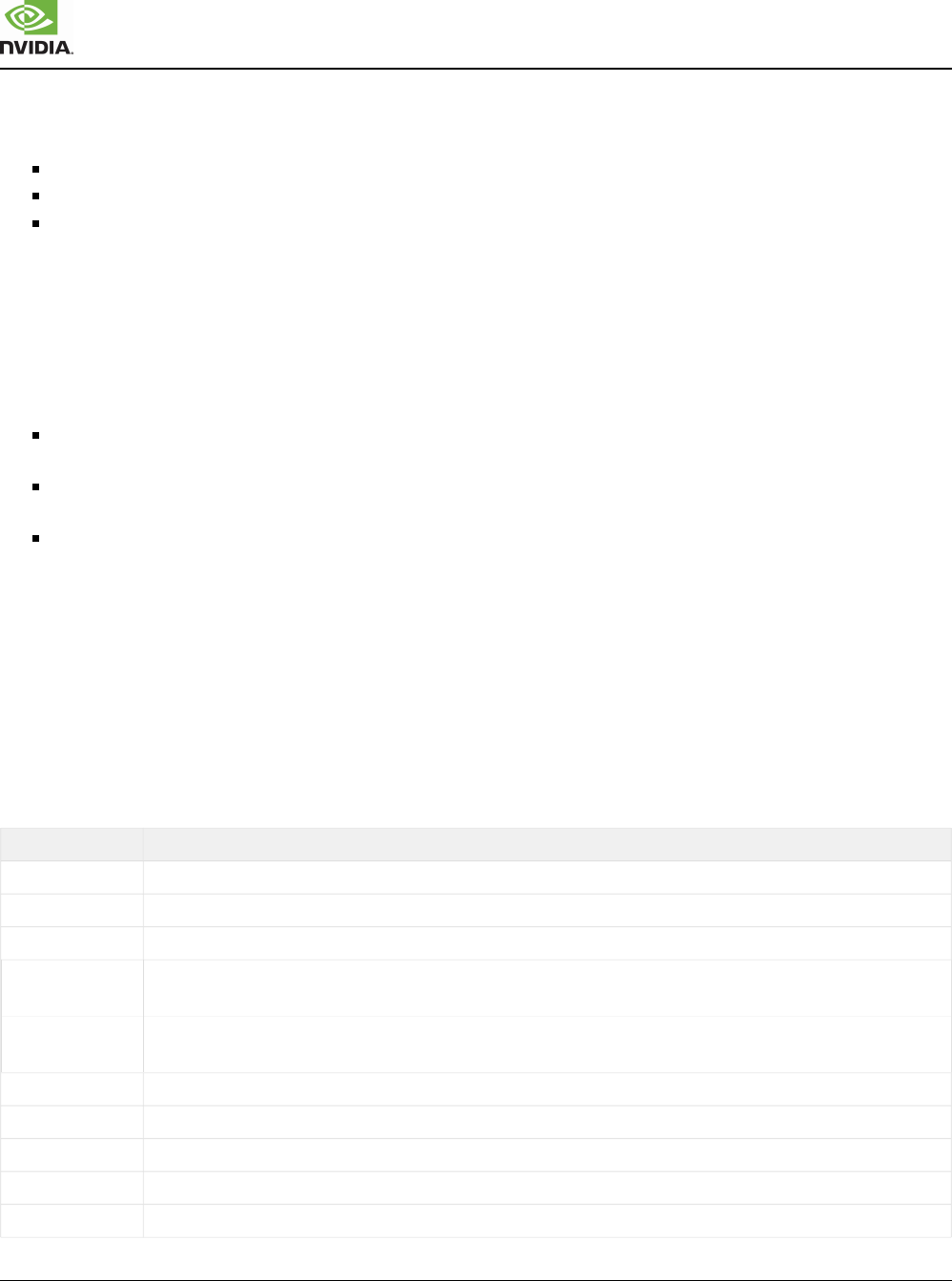
Xavier Series SoC Technical Reference Manual
XAVIER | TRM | DP-09253-002_v1.1 | SUBJECT TO CHANGE | www.nvidia.com Page of 5614 8287
Among other things, this convention uses an 'i' to indicate the binary convention, and its absence to indicate
decimal. So, 1 KiB is 2 or 1,024 bytes, and 1 KB is 10 or 1,000 bytes. Similarly it uses:
10 3
Mi for 2 and M for 10
20 6
Gi for 2 and G for 10
30 9
Ti for 2 and T for 10
40 12
List of References
This chapter makes the implicit use of the following document available from ARM based on the assumption
®
that readers are familiar with the ARM Architecture and have access to the documents for reference. Refer to
the ARM website to download the document.
ARM CoreLink GIC-400 Generic Interrupt controller Technical Reference Manual (version r0p1)
http://infocenter.arm.com/help/help/index.jsp?topic=/com.arm.doc.ddi0471b
ARM PrimeCell Vectored Interrupt controller (PL192) Technical Reference Manual
http://infocenter.arm.com/help/topic/com.arm.doc.ddi0273a/DDI0273.pdf
ARM Architecture Reference Manual ARMv8
http://developer.arm.com/docs/ddi0487/latest/arm-architecture-reference-manual-armv8-for-armv8-a-architecture-
profile
Note: ARM refers to the as VIC, but it is always termed as AVIC in this document to avoid confusion with PL192
the VIC (Video Image Compositor) block.
Glossary
Note that different names may end up in the same acronym when the entire Xavier TRM is put in perspective.
The acronyms listed here are within the context of the Interrupt controllers chapter.
Term Definition
AGIC APE GIC (referring to the vGIC in APE)
AON Always ON
APE Audio Processing Engine
AVIC ARM VIC (ARM Cortex-R5 specific)
(Multiple AVIC units can be daisy-chained together to handle more Interrupts than one AVIC unit can.)
AVIC Chain Multiple AVIC units in daisy chain
(The AVIC chains in Xavier's Cortex-R5 clusters all comprise of two AVIC units, namely AVIC0 and AVIC1.)
BPMP Boot and Power management Processor
CIDR CCPLEX Interrupt Disable Register
CTI Cross Trigger Interface
FIR Force Interrupt Register
GIC Generic Interrupt controller (ARM specific)

Xavier Series SoC Technical Reference Manual
XAVIER | TRM | DP-09253-002_v1.1 | SUBJECT TO CHANGE | www.nvidia.com Page of 5615 8287
Term Definition
GTE Generic Timestamping Engine
HSP Hardware Synchronization Primitives
IH Interrupt Handler (in CCPLEX, including vGIC and Floor-sweeping Redirection logic)
IPI Inter-Process Interrupt
ISR Interrupt Service Routine
LIC Legacy Interrupt Controller, serving only as an aggregator offering no service of any Interrupts
PPI Private Peripheral Interrupt
RAS Reliability, Availability, Serviceability
RCE Real-time Camera Engine
REI RAM Error Interrupt
SBE Single-Bit Error
SCE Safety Cluster Engine
SEI System Error Interrupt
SGI Software Generated Interrupts
SPE Sensor Processing Engine
SPI Shared Peripheral Interrupt
vGIC Virtual Generic Interrupt controller (ARM specific)
VIC Vectored Interrupt controller (ARM specific naming, referred to as AVIC in this document)
Relevant Chapters in the TRM
Address Map
Always-On (AON) Cluster and SPE
Audio Processing Engine (APE)
Boot and Power Management Processor (BPMP)
Clock Controller and Reset (CAR)
CPU Complex (CCPLEX)
Real-time Camera Engine (RCE)
Safety Cluster Engine (SCE)
Specifics in Reading This Chapter
There are eight UART units in Xavier. These eight units are dubbed with either an alphabetical suffix (A, B, C,
D, E, F, G, H) or a numerical suffix (1, 2, 3, 4, 5, 6, 7, 8) throughout its design specification and documentation.
For consistency and the sake of eliminating unnecessary confusion, this chapter uses only the alphabetical
suffix for these UART units, i.e., UARTA, UARTB, UARTC, UARTD, UARTE, UARTF, UARTG, UARTH (which
may be referred to as UART1, UART2, UART3, UART4, UART5, UART6, UART7, UART8 in other specification
and documentation including other parts of this TRM).
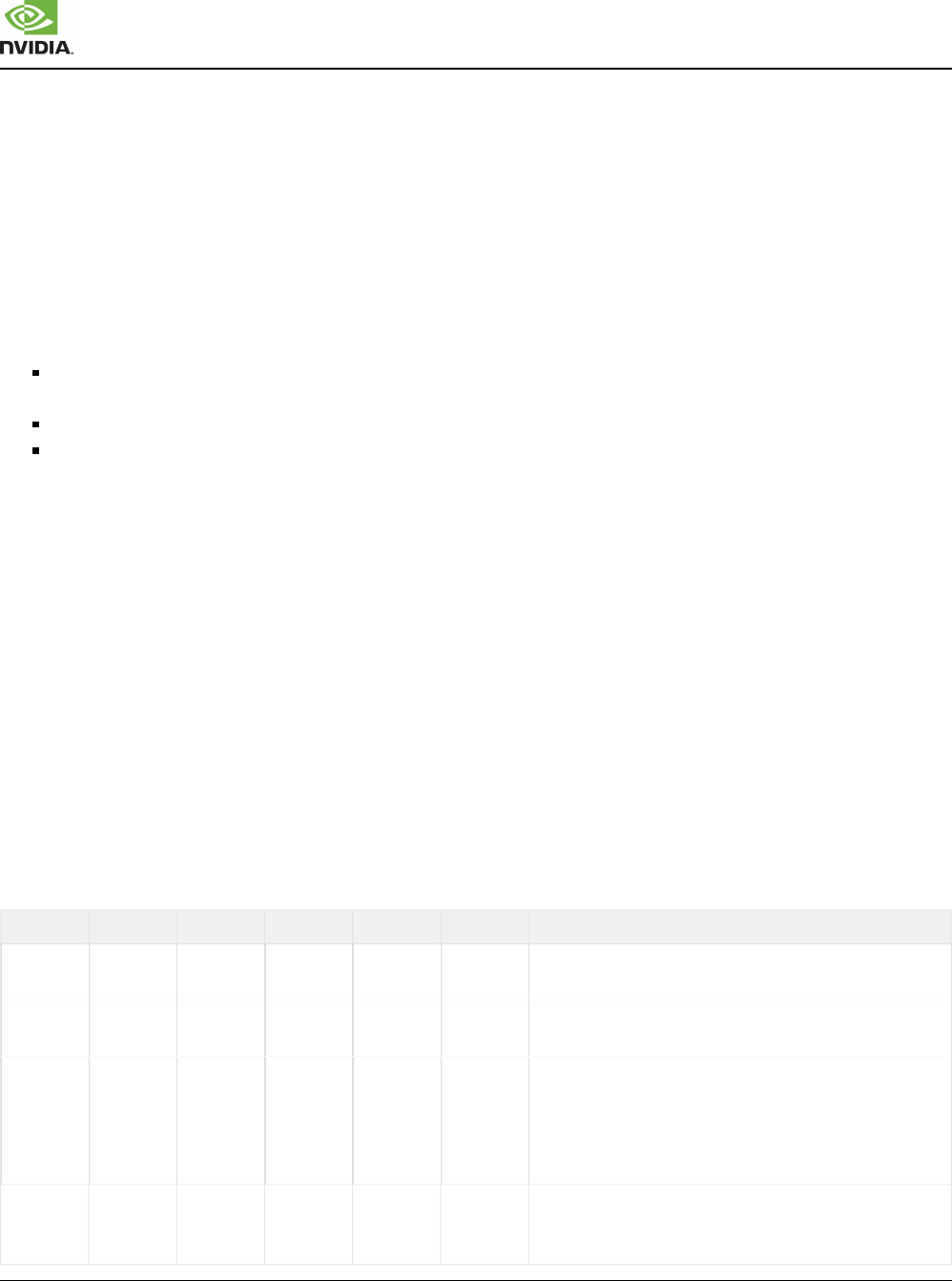
Xavier Series SoC Technical Reference Manual
XAVIER | TRM | DP-09253-002_v1.1 | SUBJECT TO CHANGE | www.nvidia.com Page of 5616 8287
8.2.2 Functional Description
Interrupt Handling Mechanism
There are different types of Interrupt controllers (GIC, vGIC, AVIC, LIC) which receive Interrupts from devices (i.
e., hardware Interrupts) or processors (i.e., software Interrupts including IPI). These different Interrupts are
arbitrated then sent to appropriate target processor(s). For software-related Interrupts, there are different types
of processors:
The Carmel CPU cores in the CCPLEX, receiving their Interrupts from the vGIC (in CCPLEX), an instance of the GIC-
400.
The Cortex-A9 core in the APE, receiving its Interrupts from the AGIC, an instance of the GIC-400.
The Cortex-R5 cores in each of AON, BPMP, RCE, and SCE, receiving their Interrupts from a daisy chain of two ARM
Vectored Interrupt controllers (AVIC), referred to AVIC Chain.
There is distinction between shared and local Interrupts as well. Xavier, however, doesn't make the distinction
between the two. Some Interrupts in Cortex-R5 clusters are local, and have strong affinity with their associated
processors therefore not directly visible outside of the processors clusters.
Shared Interrupts always use the LIC as the first-level routing. And any processor can also initiate by software a
shared Interrupt via a LIC register.
There are a total of 416 hardware Interrupts in Xavier. Interrupt sources are allocated one or more Interrupt
signals based on their requirement. The mapping of sources to Interrupts is specified in the address map for
both local and shared Interrupts.
All Xavier Interrupt controllers support a statically configurable number of Interrupts in steps of 32. The sizes for
the different instances, together with some of their other attributes are shown in the table below.
Table 8.1 Interrupt Controllers and Their Characteristics
Location Type IP
TS
[1]
Ch
[2]
Size
[3]
Description
Top LIC - Yes 8 352 The timestamping (TS) of the top Interrupts as shared
between LIC and GIC.
CCPLEX vGIC
GIC-400
[4]
PI 416 Extra local SPI (32) and 32 always reserved for SGI and
PPI.
AON
(SPE)
BPMP,
RCE,
SCE
AVIC PL192 Yes 1 64 All Cortex-R5 clusters use two daisy-chained AVICs.
APE AGIC
GIC-400
[4]
No 5 128 Four channels route aggregated signals to LIC, with more
than one supporting Virtualization by mapping a given
channel to a separate Virtual Machine.

Xavier Series SoC Technical Reference Manual
XAVIER | TRM | DP-09253-002_v1.1 | SUBJECT TO CHANGE | www.nvidia.com Page of 5617 8287
Location Type IP
TS
[1]
Ch
[2]
Size
[3]
Description
[1] TS: TimeStamping
Ch: Channel[2]
Size: Number of Interrupts[3]
GIC-400 is implemented with different configurations to use in CCPLEX and APE for different number of Interrupts to support.[4]
Note: For SPI, the CCPLEX GIC has no direct timestamping engine implemented, only the subset of SPI
coming from the LIC are timestamped. The PPI, SGI, and SPI are locally generated inside the CCPLEX are not
hardware timestamped.
The LIC uses the notion of a channel (the Ch column above), where a channel is essentially the logic required
to mask, demux, and aggregate a set of shared Interrupts into one pair of output signals (see the figure below).
The two aggregated signals in a channel are always routed as a pair. These two signals are typically identified
as IRQ and FIQ, and can be used in a more generic fashion in Xavier.
Channels are normally connected to a CPU core except for LIC where the channels are forwarded to local
Interrupt controllers. For LIC more than one channel can be forwarded to a given local Interrupt controller.
The CCPLEX is an exception as it gets all these Interrupts in non-aggregated fashion. The eight channels of
LIC are connected as shown in the table below.
Table 8.2 LIC Channel Mapping
LIC Channel Name LIC Channel Number IRQ / FIQ Connected to IRQ / FIQ Name
BPMP 0 AVIC's in BPMP lic2bpmp_intr[0] / lic2bpmp_intr[1]
APE 1 AGIC in APE LIC2APE_INT[0] / LIC2APE_INT[1]
AON (SPE) [1:0] 3,2 AVIC's in AON (SPE) lic2aon_int[0],[2] / lic2aon_int[1],[3]
SCE[1:0] 5,4 AVIC's in SCE sce_lic_irq[0],[2] / sce_lic_irq[1],[3]
RCE[1:0] 7,6 AVIC's in RCE rce_lic_irq[0],[2] / rce_lic_irq[1],[3]
The figure below shows where the different Interrupt controllers are and how Interrupts are routed.
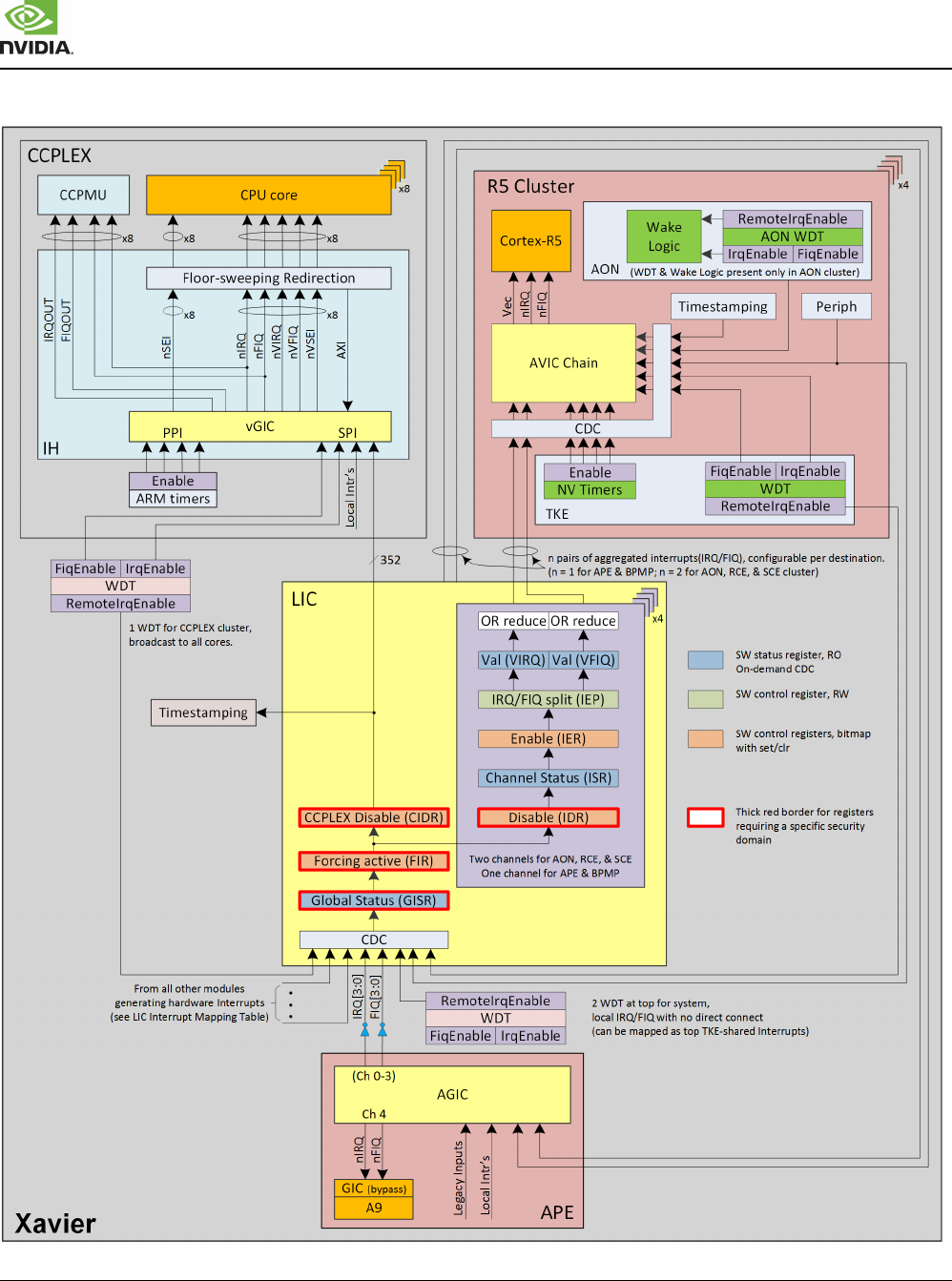
Xavier Series SoC Technical Reference Manual
XAVIER | TRM | DP-09253-002_v1.1 | SUBJECT TO CHANGE | www.nvidia.com Page of 5618 8287
Figure 8.2 Interrupt Routing (Top-Level View)

Xavier Series SoC Technical Reference Manual
XAVIER | TRM | DP-09253-002_v1.1 | SUBJECT TO CHANGE | www.nvidia.com Page of 5619 8287
ARM Processor's IRQ and FIQ
Processors implementing the ARMv8 architecture handle three types of Interrupts coming in from outside the
processor: System Error, IRQ, and FIQ. When the system signals an IRQ to the processor, the processor
switches to IRQ mode and jumps to the IRQ exception vector. FIQ is handled similarly. Traditionally, systems
have used FIQ for Interrupts which are time critical. In TrustZone capable processors, FIQ is generally used
®
for Interrupts directed to the secure world and IRQ is used for Interrupts to the non-secure world.
Most ARM processors include nIRQ and nFIQ input ports. The system tells the processor that an IRQ or FIQ
Interrupt is pending by asserting the appropriate input. Recent ARM processors add extra Interrupt inputs. The
list below applies to CCPLEX processors in Xavier:
nVIRQ and nVFIQ are virtual versions of nIRQ and nFIQ. These signals act as standard Interrupts for a VM, they are
injected by the Hypervisor through the GIC.
nSEI (System Error Interrupt) requests indicate errors and are designed to help support RAS features, and help
support server and other high reliability applications.
nVSEI is the virtual counterpart of nSEI
Note: For details of RAS features, refer to the RAS section of CCPLEX chapter of this TRM.
Interrupt Controllers
The Interrupt Controller receives Interrupts from a large number of sources. The Interrupt sources can be
assigned a target processor, a type (IRQ versus FIQ), priority levels, etc., by configuring Interrupt controller
registers. The Interrupt controller arbitrates among different incoming Interrupts and informs the target
processor of a pending Interrupt by asserting one or more of the signals described above.
LIC
The LIC is a simple Interrupt controller performing the following functions:
Routing all received (352) Interrupt signals through Force Interrupt Register (FIR) for potential forced Interrupts and
CCPLEX Interrupt Disable Register (CIDR) for potential disabled Interrupts then to Interrupt signals #0 through #351
of the vGIC in CCPLEX
Routing shared Interrupts to Cortex-R5 clusters, in aggregated form (i.e. via channels)
Timestamping of shared Interrupts
Security features
Note: The LIC does not service any of its received Interrupts, as there is no processor inside or associated with
the LIC.
The LIC can be extended in steps of 32 Interrupts, each group of 32 is called a slice. The input Interrupt signals
are combined with software set/clear bits (per Interrupt). This allows software to be able to set/clear individual
Interrupts (provided corresponding Interrupt is not asserted by hardware). The signals are further aggregated
using a channel structure, with two output signals per channel using masking and classification stages, followed
by a reduce operation.

Xavier Series SoC Technical Reference Manual
XAVIER | TRM | DP-09253-002_v1.1 | SUBJECT TO CHANGE | www.nvidia.com Page of 5620 8287
vGIC in APE (AGIC)
APE contains one instance of GICv2 (often referred to as vGIC for Virtual Generic Interrupt controller), called
AGIC (APE GIC) to support more channels than the built-in GIC in the Cortex-A9 MP. The AGIC is an SMP
Interrupt controller with five channels (0 through 4). Specifically, Channel 4 is routed to the APE's Cortex-A9
Interrupt controller (GIC) and Channel 0 through 3 are routed to the LIC. See the APE Interrupts diagram below.
Note that the Cortex-A9 core does not support virtualization.
vGIC in CCPLEX
The Interrupt controller used for the CCPLEX cluster is a GICv2, often referred to as vGIC (Virtual Generic
Interrupt controller) as it supports virtualization. The vGIC is an SMP Interrupt controller with eight channels
(one per CPU core in the CCPLEX) and receiving Interrupts targeted to (any) one or more of the CPUs in the
CCPLEX.
AVIC in Cortex-R5 Processor Complexes
The AVIC is an Interrupt controller that supports vectorized and prioritized operation for IRQs, i.e., hardware
selects the pending Interrupt of the highest priority, then sends an Interrupt request and its associated entry
address to the Cortex-R5 CPU core.
GIC in APE
The Interrupt controller in the Cortex-A9 multiprocessor logic in APE is an instance of the GICv1 (Generic
Interrupt controller). The AGIC in APE needs an external vGIC to allow for more channels. See section vGIC in
APE (AGIC). This GIC is used in a reduced functionality mode to handle the one channel of legacy IRQ/FIQ
from AGIC and timer Interrupts inside the Cortex-A9.
GIC Interrupt Classes
A GIC (either version 1 or version 2) can support a large number of Interrupts, with each Interrupt identified by
its unique ID. A GIC supports different classes of Interrupts. The rest of the discussion only presents the GICv2
(vGIC) operations.
Software Generated Interrupts
Software Generated Interrupts (SGIs) are software Interrupts which are generated by writing to the Software
Generated Interrupt register (GICD_SGIR). Each CPU interface can generate a maximum of 16 SGIs, with ID0-
15 for each target processor. The SGIs are also referred to as Inter Processor Interrupts (IPIs).
Private Peripheral Interrupts
Private Peripheral Interrupts (PPIs) are Interrupts generated by a peripheral that is specific to a single
processor.

Xavier Series SoC Technical Reference Manual
XAVIER | TRM | DP-09253-002_v1.1 | SUBJECT TO CHANGE | www.nvidia.com Page of 5621 8287
There are seven PPIs for each Carmel processor:
Virtual Maintenance Interrupt (ID25)
Hypervisor Timer Interrupt (ID26)
Virtual Timer Interrupt (ID27)
Legacy nFIQ (ID28)
Secure Physical Timer Interrupt (ID29)
Non-secure Physical Timer Interrupt (ID30)
Legacy nIRQ (ID31).
Note that the (Virtual) Maintenance Interrupt is not associated with a peripheral, but normally software
generated and used as a way to signal an Interrupt targeting explicitly the Hypervisor.
Shared Peripheral Interrupts
Shared Peripheral Interrupts (SPI's) are external hardware Interrupts generated by asserting signals on GIC or
vGIC input pins (called IRQs). From the Xavier hardware perspective, these are peripheral Interrupts. All shared
Interrupts are first routed to the LIC in Xavier. SPI IDs start at ID32. The SPIs can be configured to be edge-
triggered or level-sensitive (active-high), the vast majority of Xavier Interrupts are level, with some minor
exceptions.
Interrupt Routing
Every hardware Interrupt within Xavier is driven by a hardware module within the SoC. Some of those modules
may generate a hardware Interrupt in response to an external event (e.g., a GPIO assertion, a MSI received at
a PCIe root port, etc.). However, these external causes are outside the scope of this TRM chapter.
®
All of these hardware Interrupts are routed through side-band active-high level-sensitive signals either to LIC
(shared Interrupts) or to a local Interrupt controller (i.e., an Interrupt controller inside a processor cluster). The
general routing of Interrupt is illustrated in the figure above.
Interrupt Handling Targeting a Powered Off Processor
When an Interrupt controller asserts an Interrupt to a processor which is in a less-than-fully-powered state,
wake logic associated with the processor is responsible for transitioning the CPU back to a state in which the
CPU can handle the Interrupt. This is particularly relevant for processors within the CCPLEX. The exact details
of the wake logic are specific to the relevant processor complex.
Interrupts Used for Processors Power Up
In Xavier, the IRQ/FIQ associated with a given core are inactive while that core is in a low-power mode. The
GIC is on VDD_SOC power rail and remains active even when the CPU power is removed. The wake signal is
the IRQ/FIQ double, IRQOUT/FIQOUT, also generated by the GIC but only during sleep for wakeup.

Xavier Series SoC Technical Reference Manual
XAVIER | TRM | DP-09253-002_v1.1 | SUBJECT TO CHANGE | www.nvidia.com Page of 5622 8287
LIC Functional Description
The LIC handles a configurable number of Interrupts, using 32-bit slices. The LIC synchronizes the incoming
hardware Interrupt requests and combines (bitwise OR) them with the FIR register. The FIR allows software to
force the assertion of a particular Interrupt, using set/clear register. The combined software/hardware Interrupt
signals are forwarded to the CCPLEX GIC and to the LIC channels.
The rest of the logic is duplicated per channel, with each channel configured via Interrupt Disable (IDR),
Interrupt Enable (IER) and Interrupt Class Registers (IEP_CLASS). When a 1 is set in the proper bit position in
the IER/IDR register of a channel, that particular source is enabled/disabled for that channel. The class is set in
the proper bit position of IEP_CLASS for the corresponding source to be routed as IRQ or FIQ.
The Interrupt status register (ISR) allows the processor to view the state of the pending hardware Interrupt
requests regardless of the bit enables programmed in IER. The forced Interrupt status register (FIR) allows the
software to selectively force set or clear specific Interrupts. The read-only VIRQ/VFIQ allows the processor to
determine the source of the Interrupt request(s) causing the processor to enter the Interrupt service routine.
The individual nIRQ/nFIQ signals generated by all slices are combined (logical AND) in the combiner to
generate final nIRQ/nFIQ for the given channel.
The LIC in Xavier contains two security-related mechanisms:
the standard security model for registers, with each channel forming a security register group, and shared registers
forming also a security register group.
disable bitmaps per channel, in a specific security group, to control the visibility of certain signals across security
domains.
LIC Registers Description
Each channel is split into slices of 32 bits; the set of slices form a wide bitmap, with as many bits as there are
Interrupt signals (similar to the way the GIC uses multiple registers to construct wide configuration or status
registers). There are also a set of shared registers, i.e. outside of any channel. The set of bitmap registers are:
Shared registers:
Forcing active (FIR), with associated Set/Clr access registers
Interrupt status register (G ISR ), showing the input to LIC (before FIR and CIDR)
CCPLEX Interrupt Disable register (CIDR), allowing to block specific Interrupt in CCPLEX path
Per channel registers, for channel <c>:
Disable register (IDR<c>), with associated Set/Clr access registers, in a separate security register group.
Enable register (IER<c>), with associated Set/Clr access registers
Class register (IEP_CLASS<c>)
Valid Interrupt Status Register (VIRQ<c>) and Valid FIQ Status Register (VFIQ<c>) indicate the currently
active Interrupts that are valid on the respective pins (nIRQ or nFIQ) for that channel, that is after the enable
and class register for that channel
VIRQ<c> = (~IEP_CLASS<c>) & IER<c> & !IDR<c> & (G ISR | FIR)

Xavier Series SoC Technical Reference Manual
XAVIER | TRM | DP-09253-002_v1.1 | SUBJECT TO CHANGE | www.nvidia.com Page of 5623 8287
VFIQ<c> = (IEP_CLASS<c>) & IER<c> & !IDR<c> & (G ISR | FIR)
Interrupt Timestamping
Shared Interrupts (as connected between LIC and CCPLEX GIC) are fed into two generic timestamping engines
(two to allow for differentiated security domains).
Interrupt Mapping
This section presents the mapping of the Interrupts from system devices to the Interrupt ID's in the different
Xavier Interrupt controllers.
Interrupt Mapping by LIC
The following table shows the mapping of the Interrupts to the LIC, which serves only as an aggregator offering
no service of any Interrupts.
Table 8.3 LIC Interrupt Mapping
Source Module Interrupt Number Interrupt Name Interrupt Description
Top TKE 0 TOP_TKE_SHARED_0 Shared timer Interrupt from top TKE (1 of 10 total)
Top TKE 1 TOP_TKE_SHARED_1 Shared timer Interrupt from top TKE (1 of 10 total)
Top TKE 2 TOP_TKE_SHARED_2 Shared timer Interrupt from top TKE (1 of 10 total)
Top TKE 3 TOP_TKE_SHARED_3 Shared timer Interrupt from top TKE (1 of 10 total)
Top TKE 4 TOP_TKE_SHARED_4 Shared timer Interrupt from top TKE (1 of 10 total)
Top TKE 5 TOP_TKE_SHARED_5 Shared timer Interrupt from top TKE (1 of 10 total)
Top TKE 6 TOP_TKE_SHARED_6 Shared timer Interrupt from top TKE (1 of 10 total)
Top TKE 7 TOP_TKE_SHARED_7 Shared timer Interrupt from top TKE (1 of 10 total)
Top TKE 8 TOP_TKE_SHARED_8 Shared timer Interrupt from top TKE (1 of 10 total)
Top TKE 9 TOP_TKE_SHARED_9 Shared timer Interrupt from top TKE (1 of 10 total)
AON - RTC 10 RTC RTC Interrupt
LIC - GTE 11 LIC_GTE_0 Interrupt reflecting occupancy of FIFO in a Generic
Timestamp Engine; here a GTE coupled with LIC
LIC - GTE 12 LIC_GTE_1 Interrupt reflecting occupancy of FIFO in a Generic
Timestamp Engine; here a GTE coupled with LIC
AON - GTE 13 AON_GTE Interrupt reflecting occupancy of FIFO in a Generic
Timestamp Engine; here a GTE coupled with the
AON AVIC
BPMP - TKE 14 BPMP_WDT_REMOTE Remote Interrupt associated with a given WDT;
associated cluster probably down if risen (1 of 7
total)
AON - TKE
15
SPE_WDT_REMOTE

Xavier Series SoC Technical Reference Manual
XAVIER | TRM | DP-09253-002_v1.1 | SUBJECT TO CHANGE | www.nvidia.com Page of 5624 8287
Source Module Interrupt Number Interrupt Name Interrupt Description
Remote Interrupt associated with a given WDT;
associated cluster probably down if risen (1 of 7
total)
SCE - TKE 16 SCE_WDT_REMOTE Remote Interrupt associated with a given WDT;
associated cluster probably down if risen (1 of 7
total)
Top TKE 17 TOP_WDT_REMOTE Remote Interrupt associated with a given WDT;
associated cluster probably down if risen (1 of 7
total)
AON - RTC 18 AOWDT_REMOTE Remote Interrupt associated with a given WDT; this
one is the AON WDT with no direct hardware
association with a specific core (some affinity with
SPE in AON) (1 of 7 total)
RCE - TKE 19 RCE_WDT_REMOTE Remote Interrupt associated with a given WDT;
associated cluster probably down if risen (1 of 7
total)
APE 20 APE_WDT_REMOTE Remote Interrupt associated with a given WDT;
associated cluster probably down if risen (1 of 7
total)
XUSB - HOST 21 USB3_HOST_VF0 XUSB Interrupt (1 of 11 total)
XUSB - HOST 22 USB3_HOST_VF1 XUSB Interrupt (1 of 11 total)
XUSB - OST 23 USB3_HOST_VF2 XUSB Interrupt (1 of 11 total)
XUSB - HOST 24 USB3_HOST_VF3 XUSB Interrupt (1 of 11 total)
I C1
2
25 I2C1
I C Interrupt (1 of 10 total)
2
I C2 (in AON)
2
26 I2C2
I C Interrupt (1 of 10 total); from AON
2
I C3
2
27 I2C3
I C Interrupt (1 of 10 total)
2
I C4
2
28 I2C4
I C Interrupt (1 of 10 total)
2
I C5
2
29 I2C5
I C Interrupt (1 of 10 total)
2
I C6
2
30 I2C6
I C Interrupt (1 of 10 total
2
I C7
2
31 I2C7
I C Interrupt (1 of 10 total)
2
I C8 (in AON)
2
32 I2C8
I C Interrupt (1 of 10 total); from AON
2
I2C9 33 I2C9
I C Interrupt (1 of 10 total)
2
I C10 (in AON)
2
34 I2C10
I C Interrupt (1 of 10 total); from AON
2
QSPI0 35 QSPI0 QSPI Interrupt (1 of 2 total)
SPI1 36 SPI1 SPI Interrupt (1 of 3 total)
SPI2 (in AON) 37 SPI2 SPI Interrupt (1 of 3 total); from AON
SPI3 38 SPI3 SPI Interrupt (1 of 3 total)
QSPI1 39 QSPI1 QSPI Interrupt (1 of 2 total)

Xavier Series SoC Technical Reference Manual
XAVIER | TRM | DP-09253-002_v1.1 | SUBJECT TO CHANGE | www.nvidia.com Page of 5625 8287
Source Module Interrupt Number Interrupt Name Interrupt Description
AON - CAN1 40 CAN1_0 CAN Interrupt (1 of 4 total); in pair with CAN1_1
AON - CAN1 41 CAN1_1 CAN Interrupt (1 of 4 total); in pair with CAN1_0
AON - CAN2 42 CAN2_0 CAN Interrupt (1 of 4 total); in pair with CAN2_1
AON - CAN2 43 CAN2_1 CAN Interrupt (1 of 4 total); in pair with CAN2_0
UFSHC 44 UFSHC UFS Host Controller Interrupt
PCIE1 45 PCIE1_INT PCIe Interrupt (1 of 6 pairs, PCIE_INT and
PCIE_MSI)
PCIE1 46 PCIE1_MSI PCIe Interrupt (1 of 6 pairs, PCIE_INT and
PCIE_MSI)
PCIE2 47 PCIE2_INT PCIe Interrupt (1 of 6 pairs, PCIE_INT and
PCIE_MSI)
PCIE2 48 PCIE2_MSI PCIe Interrupt (1 of 6 pairs, PCIE_INT and
PCIE_MSI)
PCIE3 49 PCIE3_INT PCIe Interrupt (1 of 6 pairs, PCIE_INT and
PCIE_MSI)
PCIE3 50 PCIE3_MSI PCIe Interrupt (1 of 6 pairs, PCIE_INT and
PCIE_MSI)
PCIE4 51 PCIE4_INT PCIe Interrupt (1 of 6 pairs, PCIE_INT and
PCIE_MSI)
PCIE4 52 PCIE4_MSI PCIe Interrupt (1 of 6 pairs, PCIE_INT and
PCIE_MSI)
PCIE5 53 PCIE5_INT PCIe Interrupt (1 of 6 pairs, PCIE_INT and
PCIE_MSI)
PCIE5 54 PCIE5_MSI PCIe Interrupt (1 of 6 pairs, PCIE_INT and
PCIE_MSI)
NVDEC1 55 NVDEC1 NVDEC General Interrupt (1 of 2 total); 1 per
NVDEC
AON - GPIO 56 AON_GPIO_0 GPIO Interrupt (1 of 52 total); from AON GPIO
AON - GPIO 57 AON_GPIO_1 GPIO Interrupt (1 of 52 total); from AON GPIO
AON - GPIO 58 AON_GPIO_2 GPIO Interrupt (1 of 52 total); from AON GPIO
AON - GPIO 59 AON_GPIO_3 GPIO Interrupt (1 of 52 total); from AON GPIO
RESERVED 60 RESERVED (not used)
RESERVED 61 RESERVED (not used)
SDMMC1 62 SDMMC1 SDMMC Interrupt (1 of 6 total); in pair with
SDMMC1_SYS (SDMMC1_SYS required for
Windows standard driver operation)
RESERVED 63 RESERVED (not used)
SDMMC3
64
SDMMC3

Xavier Series SoC Technical Reference Manual
XAVIER | TRM | DP-09253-002_v1.1 | SUBJECT TO CHANGE | www.nvidia.com Page of 5626 8287
Source Module Interrupt Number Interrupt Name Interrupt Description
SDMMC Interrupt (1 of 6 total); in pair with
SDMMC3_SYS (SDMMC3_SYS required for
Windows standard driver operation)
SDMMC4 65 SDMMC4 SDMMC Interrupt (1 of 6 total); in pair with
SDMMC4_SYS (SDMMC4_SYS required for
Windows standard driver operation)
SDMMC1 66 SDMMC1_SYS SDMMC Interrupt (1 of 6 total); in pair with
SDMMC1
RESERVED 67 RESERVED (not used)
SDMMC3 68 SDMMC3_SYS SDMMC Interrupt (1 of 6 total); in pair with
SDMMC3
SDMMC4 69 SDMMC4_SYS SDMMC Interrupt (1 of 6 total); in pair with
SDMMC4
GPU 70 GPU_STALL GPU Interrupt; two for different levels of criticality
GPU 71 GPU_NONSTALL GPU Interrupt; two for different levels of criticality
PCIE0 72 PCIE_INT PCIe Interrupt (1 of 6 pairs, PCIE_INT and
PCIE_MSI)
PCIE0 73 PCIE_MSI PCIe Interrupt (1 of 6 pairs, PCIE_INT and
PCIE_MSI)
SLVSEC 74 SLVSEC SLVSEC Interrupt (1 total)
Central DMA 75 CENTRAL_DMA_CH0 Central DMA channel Interrupt (1 of 32 total)
Central DMA 76 CENTRAL_DMA_CH1 Central DMA channel Interrupt (1 of 32 total)
Central DMA 77 CENTRAL_DMA_CH2 Central DMA channel Interrupt (1 of 32 total)
Central DMA 78 CENTRAL_DMA_CH3 Central DMA channel Interrupt (1 of 32 total)
Central DMA 79 CENTRAL_DMA_CH4 Central DMA channel Interrupt (1 of 32 total)
Central DMA 80 CENTRAL_DMA_CH5 Central DMA channel Interrupt (1 of 32 total)
Central DMA 81 CENTRAL_DMA_CH6 Central DMA channel Interrupt (1 of 32 total)
Central DMA 82 CENTRAL_DMA_CH7 Central DMA channel Interrupt (1 of 32 total)
Central DMA 83 CENTRAL_DMA_CH8 Central DMA channel Interrupt (1 of 32 total)
Central DMA 84 CENTRAL_DMA_CH9 Central DMA channel Interrupt (1 of 32 total)
Central DMA 85 CENTRAL_DMA_CH10 Central DMA channel Interrupt (1 of 32 total)
Central DMA 86 CENTRAL_DMA_CH11 Central DMA channel Interrupt (1 of 32 total)
Central DMA 87 CENTRAL_DMA_CH12 Central DMA channel Interrupt (1 of 32 total)
Central DMA 88 CENTRAL_DMA_CH13 Central DMA channel Interrupt (1 of 32 total)
Central DMA 89 CENTRAL_DMA_CH14 Central DMA channel Interrupt (1 of 32 total)
Central DMA 90 CENTRAL_DMA_CH15 Central DMA channel Interrupt (1 of 32 total)
Central DMA 91 CENTRAL_DMA_CH16 Central DMA channel Interrupt (1 of 32 total)

Xavier Series SoC Technical Reference Manual
XAVIER | TRM | DP-09253-002_v1.1 | SUBJECT TO CHANGE | www.nvidia.com Page of 5627 8287
Source Module Interrupt Number Interrupt Name Interrupt Description
Central DMA 92 CENTRAL_DMA_CH17 Central DMA channel Interrupt (1 of 32 total)
Central DMA 93 CENTRAL_DMA_CH18 Central DMA channel Interrupt (1 of 32 total)
Central DMA 94 CENTRAL_DMA_CH19 Central DMA channel Interrupt (1 of 32 total)
Central DMA 95 CENTRAL_DMA_CH20 Central DMA channel Interrupt (1 of 32 total)
Central DMA 96 CENTRAL_DMA_CH21 Central DMA channel Interrupt (1 of 32 total)
Central DMA 97 CENTRAL_DMA_CH22 Central DMA channel Interrupt (1 of 32 total)
Central DMA 98 CENTRAL_DMA_CH23 Central DMA channel Interrupt (1 of 32 total)
Central DMA 99 CENTRAL_DMA_CH24 Central DMA channel Interrupt (1 of 32 total)
Central DMA 100 CENTRAL_DMA_CH25 Central DMA channel Interrupt (1 of 32 total)
Central DMA 101 CENTRAL_DMA_CH26 Central DMA channel Interrupt (1 of 32 total)
Central DMA 102 CENTRAL_DMA_CH27 Central DMA channel Interrupt (1 of 32 total)
Central DMA 103 CENTRAL_DMA_CH28 Central DMA channel Interrupt (1 of 32 total)
Central DMA 104 CENTRAL_DMA_CH29 Central DMA channel Interrupt (1 of 32 total)
Central DMA 105 CENTRAL_DMA_CH30 Central DMA channel Interrupt (1 of 32 total)
Central DMA 106 CENTRAL_DMA_CH31 Central DMA channel Interrupt (1 of 32 total)
Central DMA 107 CENTRAL_DMA_COMMON Central DMA common Interrupt
RESERVED 108 RESERVED (not used)
RESERVED 109 RESERVED (not used)
RESERVED 110 RESERVED (not used)
RESERVED 111 RESERVED (not used)
UARTA 112 UARTA UART Interrupt (1 of 8 total)
UARTB 113 UARTB UART Interrupt (1 of 8 total)
UARTC (in AON) 114 UARTC UART Interrupt (1 of 8 total); from AON
UARTD 115 UARTD UART Interrupt (1 of 8 total)
UARTE 116 UARTE UART Interrupt (1 of 8 total)
UARTF 117 UARTF UART Interrupt (1 of 8 total)
ARTG (in AON)U 118 UARTG UART Interrupt (1 of 8 total); from AON
NVCSI 119 NVCSI NVCSI Interrupt
Top HSP0 120 TOP_HSP0_SHARED_0 TOP HSP0 shared Interrupt (1 of 8 total)
Top HSP0 121 TOP_HSP0_SHARED_1 TOP HSP0 shared Interrupt (1 of 8 total)
Top HSP0 122 TOP_HSP0_SHARED_2 TOP HSP0 shared Interrupt (1 of 8 total)
Top HSP0 123 TOP_HSP0_SHARED_3 TOP HSP0 shared Interrupt (1 of 8 total)
Top HSP0 124 TOP_HSP0_SHARED_4 TOP HSP0 shared Interrupt (1 of 8 total)
Top HSP0 125 TOP_HSP0_SHARED_5 TOP HSP0 shared Interrupt (1 of 8 total)
Top HSP0 126 TOP_HSP0_SHARED_6 TOP HSP0 shared Interrupt (1 of 8 total)

Xavier Series SoC Technical Reference Manual
XAVIER | TRM | DP-09253-002_v1.1 | SUBJECT TO CHANGE | www.nvidia.com Page of 5628 8287
Source Module Interrupt Number Interrupt Name Interrupt Description
Top HSP0 127 TOP_HSP0_SHARED_7 TOP HSP0 shared Interrupt (1 of 8 total)
Top HSP1 128 TOP_HSP1_SHARED_0 TOP HSP1 shared Interrupt (1 of 5 total)
Top HSP1 129 TOP_HSP1_SHARED_1 TOP HSP1 shared Interrupt (1 of 5 total)
Top HSP1 130 TOP_HSP1_SHARED_2 TOP HSP1 shared Interrupt (1 of 5 total)
Top HSP1 131 TOP_HSP1_SHARED_3 TOP HSP1 shared Interrupt (1 of 5 total)
Top HSP1 132 TOP_HSP1_SHARED_4 TOP HSP1 shared Interrupt (1 of 5 total)
AON - HSP 133 AON_MBOX_OUT_0 AON MBOX Interrupt (1 of 4 total)
AON - HSP 134 AON_MBOX_OUT_1 AON MBOX Interrupt (1 of 4 total)
AON - HSP 135 AON_MBOX_OUT_2 AON MBOX Interrupt (1 of 4 total)
AON - HSP 136 AON_MBOX_OUT_3 AON MBOX Interrupt (1 of 4 total)
BPMP - HSP 137 BPMP_HSP_SHARED_1 BPMP HSP shared Interrupt (1 of 4 total)
BPMP - HSP 138 BPMP_HSP_SHARED_2 BPMP HSP shared Interrupt (1 of 4 total)
BPMP - HSP 139 BPMP_HSP_SHARED_3 BPMP HSP shared Interrupt (1 of 4 total)
BPMP - HSP 140 BPMP_HSP_SHARED_4 BPMP HSP shared Interrupt (1 of 4 total)
SCE - HSP 141 SCE_MBOX_OUT_0 SCE MBOX Interrupt (1 of 4 total)
SCE - HSP 142 SCE_MBOX_OUT_1 SCE MBOX Interrupt (1 of 4 total)
SCE - HSP 143 SCE_MBOX_OUT_2 SCE MBOX Interrupt (1 of 4 total)
SCE - HSP 144 SCE_MBOX_OUT_3 SCE MBOX Interrupt (1 of 4 total)
APE 145 APE_IRQ0 APE Interrupt (1 of 8 total); in pair with APE_FIQ0
APE 146 APE_IRQ1 APE Interrupt (1 of 8 total); in pair with APE_FIQ1
APE 147 APE_IRQ2 APE Interrupt (1 of 8 total); in pair with APE_FIQ2
APE 148 APE_IRQ3 APE Interrupt (1 of 8 total); in pair with APE_FIQ3
APE 149 APE_FIQ0 APE Interrupt (1 of 8 total); in pair with APE_IRQ0
APE 150 APE_FIQ1 APE Interrupt (1 of 8 total); in pair with APE_IRQ1
APE 151 APE_FIQ2 APE Interrupt (1 of 8 total); in pair with APE_IRQ2
APE 152 APE_FIQ3 APE Interrupt (1 of 8 total); in pair with APE_IRQ3
DISPLAY 153 DISPLAY_HEAD0 Display Interrupt (1 of 5 total)
DISPLAY 154 DISPLAY_HEAD1 Display Interrupt (1 of 5 total)
DISPLAY 155 DISPLAY_HEAD2 Display Interrupt (1 of 5 total)
DISPLAY 156 DISPLAY_TZ Display Interrupt (1 of 5 total)
SOR 157 SOR SOR Interrupt (1 of 4 total)
SOR1 158 SOR1 SOR Interrupt (1 of 4 total)
DPAUX 159 DPAUX DPAUX Interrupt (1 of 4 total)
DPAUX1 160 DPAUX1 DPAUX Interrupt (1 of 4 total)
HDA 161 HDA High Definition Audio Interrupt

Xavier Series SoC Technical Reference Manual
XAVIER | TRM | DP-09253-002_v1.1 | SUBJECT TO CHANGE | www.nvidia.com Page of 5629 8287
Source Module Interrupt Number Interrupt Name Interrupt Description
CEC 162 CEC CEC Interrupt
XUSB - HOST 163 USB3_HOST_INT XUSB Interrupt (1 of 11 total)
XUSB - HOST 164 USB3_HOST_SMI XUSB Interrupt (1 of 11 total)
XUSB - HOST 165 USB3_HOST_PME XUSB Interrupt (1 of 11 total)
XUSB - DEV 166 USB3_DEV_INT XUSB Interrupt (1 of 11 total)
XUSB - PADCTL 167 XUSB_PADCTL XUSB Interrupt (1 of 11 total); specifically targeting
wakeup
XUSB - DEV 168 USB3_DEV_SMI XUSB Interrupt (1 of 11 total)
XUSB - DEV 169 USB3_DEV_PME XUSB Interrupt (1 of 11 total)
SMMU0 170 SMMU_COMBINED_NS ARM SMMU combined non-secure Interrupt (global,
context, and TBU perf) (1 of 6 total)
SMMU0 171 SMMU_COMBINED_S ARM SMMU combined secure Interrupt (global and
context) (1 of 6 total)
AON Cluster 172 SECURE_AON_FABRIC Secure AON fabric Interrupt
SCE Cluster 173 SECURE_SCE_FABRIC Secure SCE fabric Interrupt
BPMP Cluster 174 SECURE_BPMP_FABRIC Secure BPMP fabric Interrupt
RCE Cluster 175 SECURE_RCE_FABRIC Secure RCE fabric Interrupt
Top HSP0 176 DOORBELL_CCPLEX_NOT_SE
CURE
Doorbell for CCPLEX via LIC (1 of 2 total)
Top HSP0 177 DOORBELL_CCPLEX_SECURE Doorbell for CCPLEX via LIC (1 of 2 total)
NVLINK 178 NVLINK2HOST NVLink Interrupt (1 total)
RESERVED 179 RESERVED (not used)
RESERVED 180 RESERVED (not used)
RESERVED 181 RESERVED (not used)
RCE - HSP 182 RCE_MBOX_OUT_0 RCE MBOX Interrupt (1 of 4 total)
RCE - SP 183 RCE_MBOX_OUT_1 RCE MBOX Interrupt (1 of 4 total)
RCE - HSP 184 RCE_MBOX_OUT_2 RCE MBOX Interrupt (1 of 4 total)
RCE - HSP 185 RCE_MBOX_OUT_3 RCE MBOX Interrupt (1 of 4 total)
EQOS 186 EQOS_TX_0 EAVB Interrupt (1 of 10 total); in pair with
EQOS_RX_0
EQOS 187 EQOS_TX_1 EAVB Interrupt (1 of 10 total); in pair with
EQOS_RX_1
EQOS 188 EQOS_TX_2 EAVB Interrupt (1 of 10 total); in pair with
EQOS_RX_2
EQOS 189 EQOS_TX_3 EAVB Interrupt (1 of 10 total); in pair with
EQOS_RX_3
EQOS
190
EQOS_RX_0

Xavier Series SoC Technical Reference Manual
XAVIER | TRM | DP-09253-002_v1.1 | SUBJECT TO CHANGE | www.nvidia.com Page of 5630 8287
Source Module Interrupt Number Interrupt Name Interrupt Description
EAVB Interrupt (1 of 10 total); in pair with
EQOS_TX_0
EQOS 191 EQOS_RX_1 EAVB Interrupt (1 of 10 total); in pair with
EQOS_TX_1
EQOS 192 EQOS_RX_2 EAVB Interrupt (1 of 10 total); in pair with
EQOS_TX_2
EQOS 193 EQOS_RX_3 EAVB Interrupt (1 of 10 total); in pair with
EQOS_TX_3
EQOS 194 EQOS_COMMON EAVB Interrupt (1 of 10 total)
EQOS 195 EQOS_POWER EAVB Interrupt (1 of 10 total)
SATA 196 SATA_RX_STAT SATA Interrupt (1 of 2 total)
SATA 197 SATA_CTL SATA Interrupt (1 of 2 total)
NVJPG 198 NVJPG NVJPG General Interrupt
NVDEC 199 NVDEC NVDEC General Interrupt (1 of 2 total); 1 per
NVDEC
NVENC 200 NVENC NVENC Interrupt (1 of 2 total); 1 per NVENC
VI 201 VI_THI VI_THI Interrupt
NVENC1 202 NVENC1 NVENC Interrupt (1 of 2 total); 1 per NVENC
PIPE2UPHY_16 203 PIPE2UPHY_16 PIPE2UPHY Interrupt (1 of 20 total)
ISP 204 ISP_1 ISP Interrupt (1 of 2 total)
ISP 205 ISP ISP Interrupt (1 of 2 total)
VIC 206 VIC VIC General Interrupt
UARTH 207 UARTH UART Interrupt (1 of 8 total)
BPMP - CVC 208 CVC Central Voltage Control coming from BPMP
AON - PMC 209 PMIC_EXT External Power Management Chip Intr
BPMP - ACTMON 210 ACTMON This is the Central Actmon Interrupt. Other
ACTMON Interrupts stay inside the individual R5
clusters; only this one from BPMP is exposed to LIC
and called simply ACTMON.
AON - PMC 211 PMC2LIC_INTR PMC Interrupt - pmc2lic_intr
AON - WAKE 212 AON_WAKE_0 Wake Interrupt from AON (1 of 3 total)
AON - WAKE 213 AON_WAKE_1 Wake Interrupt from AON (1 of 3 total)
AON - WAKE 214 AON_WAKE_2 Wake Interrupt from AON (1 of 3 total)
AON - VC 215 AOVC_LIC_INTR AON Voltage Control Interrupt
AON - PM 216 AON_PM AON Power Management Interrupt
BPMP - PM 217 BPMP_PM BPMP Power Management Interrupt
218
THERMAL

Xavier Series SoC Technical Reference Manual
XAVIER | TRM | DP-09253-002_v1.1 | SUBJECT TO CHANGE | www.nvidia.com Page of 5631 8287
Source Module Interrupt Number Interrupt Name Interrupt Description
BPMP - SoC
Therm
soc_therm Interrupt; for THERMAL event; from
BPMP
BPMP - SoC
Therm
219 EDP soc_therm Interrupt; for EDP event; from BPMP
PIPE2UPHY_17 220 PIPE2UPHY_17 PIPE2UPHY Interrupt (1 of 20 total)
PIPE2UPHY_18 221 PIPE2UPHY_18 PIPE2UPHY Interrupt (1 of 20 total)
PIPE2UPHY_19 222 PIPE2UPHY_19 PIPE2UPHY Interrupt (1 of 20 total)
MCB 223 MC MC General Interrupt
EMCB 224 EMC EMC General Interrupt
RESERVED 225 RESERVED (not used)
AON - CAR 226 AON_CAR Interrupt from CAR logic inside AON
EMCB 227 EMC_CORR_ECC_ERR Correctable ECC error
TSEC 228 TSEC TSEC General Interrupt
TSECB 229 TSECB TSECB General Interrupt
CBB 230 CBB_NONSECURE CBB non-secure Interrupt
CBB 231 CBB_SECURE CBB secure Interrupt
SMMU1 232 SMMU1_COMBINED_NS ARM SMMU combined non-secure Interrupt (global;
context and TBU perf) (1 of 6 total)
SMMU1 233 SMMU1_COMBINED_S ARM SMMU combined secure Interrupt (global and
context) (1 of 6 total)
PVA0 234 PVA0 PVA Interrupt (1 of 2 total); 1 per PVA
PVA1 235 PVA1 PVA Interrupt (1 of 2 total); 1 per PVA
NVDLA0 236 NVDLA0 DLA Interrupt (1 of 2 total); 1 per DLA
NVDLA1 237 NVDLA1 DLA Interrupt (1 of 2 total); 1 per DLA
CVNAS 238 CVNAS_NONSECURE CVNAS Interrupt (1 of 2 total)
CVNAS 239 CVNAS_SECURE CVNAS Interrupt (1 of 2 total)
SMMU2 240 SMMU2_COMBINED_NS ARM SMMU combined non-secure Interrupt (global;
context and TBU perf) (1 of 6 total)
SMMU2 241 SMMU2_COMBINED_S ARM SMMU combined secure Interrupt (global and
context) (1 of 6 total)
DISPLAY 242 DISPLAY_HEAD3 Display Interrupt (1 of 5 total)
SOR2 243 SOR2 SOR Interrupt (1 of 4 total)
SOR3 244 SOR3 SOR Interrupt (1 of 4 total)
DPAUX2 245 DPAUX2 DPAUX Interrupt (1 of 4 total)
DPAUX3 246 DPAUX3 DPAUX Interrupt (1 of 4 total)
VI 247 VI_VMID_0 VI VMID Interrupt (1 of 9 total)

Xavier Series SoC Technical Reference Manual
XAVIER | TRM | DP-09253-002_v1.1 | SUBJECT TO CHANGE | www.nvidia.com Page of 5632 8287
Source Module Interrupt Number Interrupt Name Interrupt Description
VI 248 VI_VMID_1 VI VMID Interrupt (1 of 9 total)
VI 249 VI_VMID_2 VI VMID Interrupt (1 of 9 total)
VI 250 VI_VMID_3 VI VMID Interrupt (1 of 9 total)
VI 251 VI_VMID_4 VI VMID Interrupt (1 of 9 total)
VI 252 VI_VMID_5 VI VMID Interrupt (1 of 9 total)
VI 253 VI_VMID_6 VI VMID Interrupt (1 of 9 total)
VI 254 VI_VMID_7 VI VMID Interrupt (1 of 9 total)
VI 255 VI_VMID_8 VI VMID Interrupt (1 of 9 total)
RESERVED 256 RESERVED (not used)
RESERVED 257 RESERVED (not used)
RESERVED 258 RESERVED (not used)
RCE Cluster 259 RCE_FABRIC RCE fabric Interrupt
AON Cluster 260 AON_FABRIC AON fabric Interrupt
SCE Cluster 261 SCE_FABRIC SCE fabric Interrupt
BPMP Cluster 262 BPMP_FABRIC BPMP fabric Interrupt
HOST Controller 263 HOST1X_GEN_CPU Host Controller general Interrupt
HOST Controller 264 HOST1X_SYNCPT_CPU Host Controller syncpt Interrupt (1 of 9 total) for
virtualization
HOST Controller 265 HOST1X_SYNCPT_CPUOS0 Host Controller syncpt Interrupt (1 of 9 total) for
virtualization
HOST Controller 266 HOST1X_SYNCPT_CPUOS1 Host Controller syncpt Interrupt (1 of 9 total) for
virtualization
HOST Controller 267 HOST1X_SYNCPT_CPUOS2 Host Controller syncpt Interrupt (1 of 9 total) for
virtualization
HOST Controller 268 HOST1X_SYNCPT_CPUOS3 Host Controller syncpt Interrupt (1 of 9 total) for
virtualization
HOST Controller 269 HOST1X_SYNCPT_CPUOS4 Host Controller syncpt Interrupt (1 of 9 total) for
virtualization
HOSTController 270 HOST1X_SYNCPT_CPUOS5 Host Controller syncpt Interrupt (1 of 9 total) for
virtualization
Host Controller 271 HOST1X_SYNCPT_CPUOS6 Host Controller syncpt Interrupt (1 of 9 total) for
virtualization
Host Controller 272 HOST1X_SYNCPT_CPUOS7 Host Controller syncpt Interrupt (1 of 9 total) for
virtualization
Host Controller 273 HOST1X_TZ_GEN_CPU Host Controller secure Interrupt (1 of 2 total)
Host Controller 274 HOST1X_TZ_SYNCPT_CPU Host Controller secure Interrupt (1 of 2 total)
Host Controller 275 HOST1X_GEN_BPMP Host Controller general Interrupt for BPMP

Xavier Series SoC Technical Reference Manual
XAVIER | TRM | DP-09253-002_v1.1 | SUBJECT TO CHANGE | www.nvidia.com Page of 5633 8287
Source Module Interrupt Number Interrupt Name Interrupt Description
Host Controller 276 HOST1X_SYNCPT_CAMERAPR
OC_0
Host Controller syncpt for camera processing (1 of 2
total)
Host Controller 277 HOST1X_SYNCPT_CAMERAPR
OC_1
Host Controller syncpt for camera processing (1 of 2
total)
GPU 278 GPMU GPU PMU Interrupt; also routed directly to BPMP
AON - PMC
AOTAG
279 AOTAG_INTR AON Thermal Alarm Generator Interrupt
AON - PMC 280 VFMON_INTR AON Voltage/Frequency Monitor Interrupt
SE0 281 SE_APB SE APB programming Interrupt
SE0 282 SE_HOST1X SE Interrupt from Host Controller programming
interface and only for NVIDIA engines
SE0 283 SE_ELPPKA SE Interrupt for Elliptic PKA module (PKA1 in SE)
SE0 284 SE_ELPRNG SE Interrupt for Elliptic RNG module (RNG1 in SE)
SCE - PM 285 SCE_PM SCE Power Management Interrupt
RCE - PM 286 RCE_PM RCE Power Management Interrupt
RESERVED 287 RESERVED (not used)
GPIO - CTL0 288 GPIO0_0 GPIO Interrupt (1 of 52 total)
GPIO - CTL0 289 GPIO0_1 GPIO Interrupt (1 of 52 total)
GPIO - CTL0 290 GPIO0_2 GPIO Interrupt (1 of 52 total)
GPIO - CTL0 291 GPIO0_3 GPIO Interrupt (1 of 52 total)
GPIO - CTL0 292 GPIO0_4 GPIO Interrupt (1 of 52 total)
GPIO - CTL0 293 GPIO0_5 GPIO Interrupt (1 of 52 total)
GPIO - CTL0 294 GPIO0_6 GPIO Interrupt (1 of 52 total)
GPIO - CTL0 295 GPIO0_7 GPIO Interrupt (1 of 52 total)
GPIO - CTL1 296 GPIO1_0 GPIO Interrupt (1 of 52 total)
GPIO - CTL1 297 GPIO1_1 GPIO Interrupt (1 of 52 total)
GPIO - CTL1 298 GPIO1_2 GPIO Interrupt (1 of 52 total)
GPIO - CTL1 299 GPIO1_3 GPIO Interrupt (1 of 52 total)
GPIO - CTL1 300 GPIO1_4 GPIO Interrupt (1 of 52 total)
GPIO - CTL1 301 GPIO1_5 GPIO Interrupt (1 of 52 total)
GPIO - CTL1 302 GPIO1_6 GPIO Interrupt (1 of 52 total)
GPIO - CTL1 303 GPIO1_7 GPIO Interrupt (1 of 52 total)
GPIO - CTL2 304 GPIO2_0 GPIO Interrupt (1 of 52 total)
GPIO - CTL2 305 GPIO2_1 GPIO Interrupt (1 of 52 total)
GPIO - CTL2 306 GPIO2_2 GPIO Interrupt (1 of 52 total)
GPIO - CTL2 307 GPIO2_3 GPIO Interrupt (1 of 52 total)

Xavier Series SoC Technical Reference Manual
XAVIER | TRM | DP-09253-002_v1.1 | SUBJECT TO CHANGE | www.nvidia.com Page of 5634 8287
Source Module Interrupt Number Interrupt Name Interrupt Description
GPIO - CTL2 308 GPIO2_4 GPIO Interrupt (1 of 52 total)
GPIO - CTL2 309 GPIO2_5 GPIO Interrupt (1 of 52 total)
GPIO - CTL2 310 GPIO2_6 GPIO Interrupt (1 of 52 total)
GPIO - CTL2 311 GPIO2_7 GPIO Interrupt (1 of 52 total)
GPIO - CTL3 312 GPIO3_0 GPIO Interrupt (1 of 52 total)
GPIO - CTL3 313 GPIO3_1 GPIO Interrupt (1 of 52 total)
GPIO - CTL3 314 GPIO3_2 GPIO Interrupt (1 of 52 total)
GPIO - CTL3 315 GPIO3_3 GPIO Interrupt (1 of 52 total)
GPIO - CTL3 316 GPIO3_4 GPIO Interrupt (1 of 52 total)
GPIO - CTL3 317 GPIO3_5 GPIO Interrupt (1 of 52 total)
GPIO - CTL3 318 GPIO3_6 GPIO Interrupt (1 of 52 total)
GPIO - CTL3 319 GPIO3_7 GPIO Interrupt (1 of 52 total)
GPIO - CTL4 320 GPIO4_0 GPIO Interrupt (1 of 52 total)
GPIO - CTL4 321 GPIO4_1 GPIO Interrupt (1 of 52 total)
GPIO - CTL4 322 GPIO4_2 GPIO Interrupt (1 of 52 total)
GPIO - CTL4 323 GPIO4_3 GPIO Interrupt (1 of 52 total)
GPIO - CTL4 324 GPIO4_4 GPIO Interrupt (1 of 52 total)
GPIO - CTL4 325 GPIO4_5 GPIO Interrupt (1 of 52 total)
GPIO - CTL4 326 GPIO4_6 GPIO Interrupt (1 of 52 total)
GPIO - CTL4 327 GPIO4_7 GPIO Interrupt (1 of 52 total)
GPIO - CTL5 328 GPIO5_0 GPIO Interrupt (1 of 52 total)
GPIO - CTL5 329 GPIO5_1 GPIO Interrupt (1 of 52 total)
GPIO - CTL5 330 GPIO5_2 GPIO Interrupt (1 of 52 total)
GPIO - CTL5 331 GPIO5_3 GPIO Interrupt (1 of 52 total)
GPIO - CTL5 332 GPIO5_4 GPIO Interrupt (1 of 52 total)
GPIO - CTL5 333 GPIO5_5 GPIO Interrupt (1 of 52 total)
GPIO - CTL5 334 GPIO5_6 GPIO Interrupt (1 of 52 total)
GPIO - CTL5 335 GPIO5_7 GPIO Interrupt (1 of 52 total)
PIPE2UPHY_0 336 PIPE2UPHY_0 PIPE2UPHY Interrupt (1 of 20 total)
PIPE2UPHY_1 337 PIPE2UPHY_1 PIPE2UPHY Interrupt (1 of 20 total)
PIPE2UPHY_2 338 PIPE2UPHY_2 PIPE2UPHY Interrupt (1 of 20 total)
PIPE2UPHY_3 339 PIPE2UPHY_3 PIPE2UPHY Interrupt (1 of 20 total)
PIPE2UPHY_4 340 PIPE2UPHY_4 PIPE2UPHY Interrupt (1 of 20 total)
PIPE2UPHY_5 341 PIPE2UPHY_5 PIPE2UPHY Interrupt (1 of 20 total)
PIPE2UPHY_6 342 PIPE2UPHY_6 PIPE2UPHY Interrupt (1 of 20 total)

Xavier Series SoC Technical Reference Manual
XAVIER | TRM | DP-09253-002_v1.1 | SUBJECT TO CHANGE | www.nvidia.com Page of 5635 8287
Source Module Interrupt Number Interrupt Name Interrupt Description
PIPE2UPHY_7 343 PIPE2UPHY_7 PIPE2UPHY Interrupt (1 of 20 total)
PIPE2UPHY_8 344 PIPE2UPHY_8 PIPE2UPHY Interrupt (1 of 20 total)
PIPE2UPHY_9 345 PIPE2UPHY_9 PIPE2UPHY Interrupt (1 of 20 total)
PIPE2UPHY_10 346 PIPE2UPHY_10 PIPE2UPHY Interrupt (1 of 20 total)
PIPE2UPHY_11 347 PIPE2UPHY_11 PIPE2UPHY Interrupt (1 of 20 total)
PIPE2UPHY_12 348 PIPE2UPHY_12 PIPE2UPHY Interrupt (1 of 20 total)
PIPE2UPHY_13 349 PIPE2UPHY_13 PIPE2UPHY Interrupt (1 of 20 total)
PIPE2UPHY_14 350 PIPE2UPHY_14 PIPE2UPHY Interrupt (1 of 20 total)
PIPE2UPHY_15 351 PIPE2UPHY_15 PIPE2UPHY Interrupt (1 of 20 total)
Interrupt Handling by CCPLEX via vGIC
The 352 Interrupt signals that are routed to the LIC (as listed in the table above) are sent from the LIC to the
vGIC in CCPLEX and joined by another 64 Interrupt signals, totaling 416 Interrupt signals to the vGIC. The
additional 64 Interrupt signals are listed in the table below.
Table 8.4 vGIC Interrupts Mapping
Source Interrupt Number Interrupt Name Interrupt Description
(See table above.) 351:0 (See table above.) (See table above.)
CCPLEX 352 CTI[0] Cross Trigger Interrupt
CCPLEX 353 CTI[1] Cross Trigger Interrupt
CCPLEX 354 CTI[2] Cross Trigger Interrupt
CCPLEX 355 CTI[3] Cross Trigger Interrupt
RESERVED 364:356 RESERVED (not used)
CCPLEX 365 Uncore Perfmon Overflow Uncore Perfmon Overflow Interrupt
(OR of 4 L2 and 1 SNOC perfmon overflow)
RESERVED 381:366 RESERVED (not used)
CCPLEX 382 WDT_IRQ Connected to WDT at SoC level
CCPLEX 383 WDT_FIQ Connected to WDT at SoC level
CCPLEX 384 PMUIRQ[0] Architectural Perfmon Interrupt
CCPLEX 385 PMUIRQ[1] Architectural Perfmon Interrupt
CCPLEX 386 PMUIRQ[2] Architectural Perfmon Interrupt
CCPLEX 387 PMUIRQ[3] Architectural Perfmon Interrupt
CCPLEX 388 PMUIRQ[4] Architectural Perfmon Interrupt
CCPLEX 389 PMUIRQ[5] Architectural Perfmon Interrupt
CCPLEX 390 PMUIRQ[6] Architectural Perfmon Interrupt

Xavier Series SoC Technical Reference Manual
XAVIER | TRM | DP-09253-002_v1.1 | SUBJECT TO CHANGE | www.nvidia.com Page of 5636 8287
1.
2.
Source Interrupt Number Interrupt Name Interrupt Description
CCPLEX 391 PMUIRQ[7] Architectural Perfmon Interrupt
CCPLEX 392 RAS FHI[0] ARM RAS Fault Handling Interrupt
CCPLEX 393 RAS FHI[1] ARM RAS Fault Handling Interrupt
CCPLEX 394 RAS FHI[2] ARM RAS Fault Handling Interrupt
CCPLEX 395 RAS FHI[3] ARM RAS Fault Handling Interrupt
CCPLEX 396 RAS FHI[4] ARM RAS Fault Handling Interrupt
CCPLEX 397 RAS FHI[5] ARM RAS Fault Handling Interrupt
CCPLEX 398 RAS FHI[6] ARM RAS Fault Handling Interrupt
CCPLEX 399 RAS FHI[7] ARM RAS Fault Handling Interrupt
RESERVED 401:400 RESERVED (not used)
CCPLEX 402 RAS ERI[0] ARM RAS Error Recover Interrupt
CCPLEX 403 RAS ERI[1] ARM RAS Error Recover Interrupt
CCPLEX 404 RAS ERI[2] ARM RAS Error Recover Interrupt
CCPLEX 405 RAS ERI[3] ARM RAS Error Recover Interrupt
CCPLEX 406 RAS ERI[4] ARM RAS Error Recover Interrupt
CCPLEX 407 RAS ERI[5] ARM RAS Error Recover Interrupt
CCPLEX 408 RAS ERI[6] ARM RAS Error Recover Interrupt
CCPLEX 409 RAS ERI[7] ARM RAS Error Recover Interrupt
RESERVED 415:410 RESERVED (not used)
Interrupt Handling by Different Cortex-R5 Clusters
ARM Vectored Interrupt Controller Chain (AVIC Chain)
The Cortex-R5 cluster employs two ARM Vectored Interrupt controllers, AVIC0 and AVIC1, in daisy chain,
referred to as AVIC Chain, to handle two types of Interrupts:
Local Interrupts internal to the Cortex-R5 cluster
External Interrupts from the Legacy Interrupt controller (LIC) and other SoC functional modules
The AVIC Chain is located off the Cortex-R5 Cluster NoC whose firewall protects accesses to AVIC
configuration space.
The Cortex-R5 interfaces to performs the following functions in hardware to minimize AVIC0 in AVIC Chain and
the software overheads of servicing Interrupt.
Determine which Interrupt source is requesting service.
Determine where the Interrupt Service Routine (ISR) for the Interrupt source is located.
Disable the Interrupt source, before re-enabling processor Interrupts to permit another Interrupt to be taken.

Xavier Series SoC Technical Reference Manual
XAVIER | TRM | DP-09253-002_v1.1 | SUBJECT TO CHANGE | www.nvidia.com Page of 5637 8287
The two types of Interrupts are connected to the AVIC Chain as follows:
Local Interrupts to AVIC0 or AVIC1, where they get vectored (identified with the corresponding ISR's starting address)
then serviced by Cortex-R5 with low Interrupt latency.
One or two pairs of external Interrupts, LIC_IRQ and LIC_FIQ (from LIC to AVIC0), that are the aggregation from a
subset of global Interrupts. Services to these aggregated Interrupts are expected to have high latency.
Note: There is one pair of IRQ/FIQ from LIC to BPMP, while two pairs of IRQ/FIQ are sent from LIC to AON,
RCE, and SCE respectively. (See the Interrupt Routing (Top-Level View) diagram above.)
Xavier comprises four Cortex-R5 clusters.
AON (SPE) cluster
BPMP cluster
RCE cluster
SCE cluster
AON Cluster Interrupt Controller
The AON Cluster Interrupt controller with its AVIC Chain is shown in the diagram below.
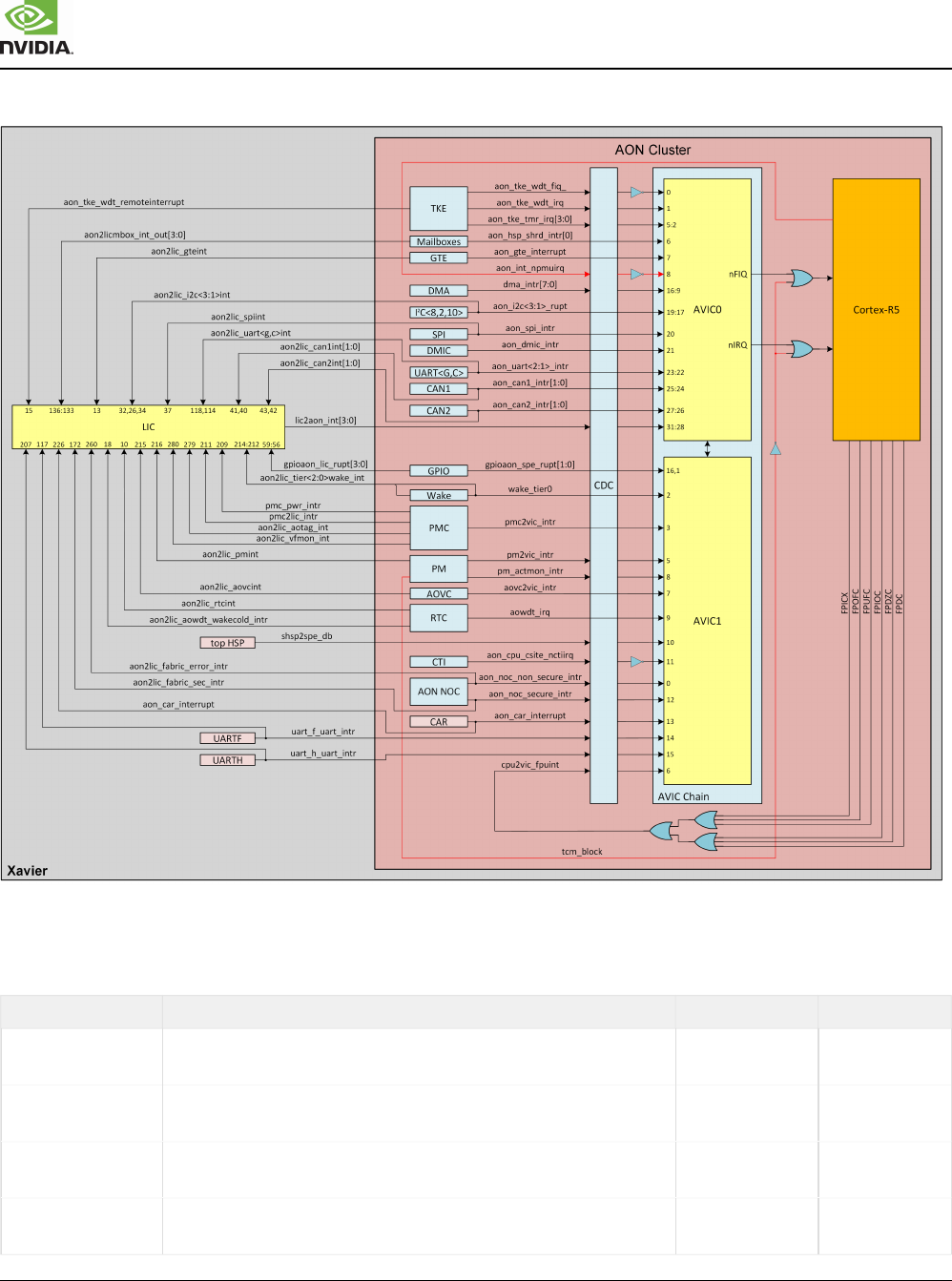
Xavier Series SoC Technical Reference Manual
XAVIER | TRM | DP-09253-002_v1.1 | SUBJECT TO CHANGE | www.nvidia.com Page of 5638 8287
Figure 8.3 AON Cluster Interrupt Structure
All the AON-related Interrupts are listed in the table below.
Table 8.5 AON Interrupts Connection
Source Interrupt Name (Software Name) AVIC Connection LIC Connection
AON - TKE aon_tke_wdt_fiq_
( AON_INTERRUPT_WDTFIQ )
0 - 0 none
AON - TKE aon_tke_wdt_irq
( AON_INTERRUPT_WDTIRQ )
0 - 1 none
AON - TKE aon_tke_tmr_irq[0]
( AON_INTERRUPT_TIMER0 )
0 - 2 none
AON - TKE aon_tke_tmr_irq[1]
( AON_INTERRUPT_TIMER1 )
0 - 3 none

Xavier Series SoC Technical Reference Manual
XAVIER | TRM | DP-09253-002_v1.1 | SUBJECT TO CHANGE | www.nvidia.com Page of 5639 8287
Source Interrupt Name (Software Name) AVIC Connection LIC Connection
AON - TKE aon_tke_tmr_irq[2]
( AON_INTERRUPT_TIMER2 )
0 - 4 none
AON - TKE aon_tke_tmr_irq[3]
( AON_INTERRUPT_TIMER3 )
0 - 5 none
AON - TKE aon_tke_wdt_remoteinterrupt
( SPE_WDT_REMOTE )
none 15
AON - HSP Mbox aon_hsp_shrd_intr[0]
( AON_INTERRUPT_MBOX )
0 - 6 none
AON - HSP Mbox aon2licmbox_int_out[0]
( AON_MBOX_OUT_0 )
none 133
AON - HSP Mbox aon2licmbox_int_out[1]
( AON_MBOX_OUT_1 )
none 134
AON - HSP Mbox aon2licmbox_int_out[2]
( AON_MBOX_OUT_2 )
none 135
AON - HSP Mbox aon2licmbox_int_out[3]
( AON_MBOX_OUT_3 )
none 136
AON - GTE aon_gte_interrupt
( AON_INTERRUPT_GTE )
0 - 7 none
AON - GTE aon2lic_gteint
( AON_GTE )
none 13
AON - R5 aon_int_npmuirq
( AON_INTERRUPT_PMU )
0 - 8 none
AON - DMA dma_intr[0]
( AON_INTERRUPT_DMA0 )
0 - 9 none
AON - DMA dma_intr[1]
( AON_INTERRUPT_DMA1 )
0 - 10 none
AON - DMA dma_intr[2]
( AON_INTERRUPT_DMA2 )
0 - 11 none
AON - DMA dma_intr[3]
( AON_INTERRUPT_DMA3 )
0 - 12 none
AON - DMA dma_intr[4]
( AON_INTERRUPT_DMA4 )
0 - 13 none
AON - DMA dma_intr[5]
( AON_INTERRUPT_DMA5 )
0 - 14 none
AON - DMA dma_intr[6]
( AON_INTERRUPT_DMA6 )
0 - 15 none
AON - DMA dma_intr[7]
( AON_INTERRUPT_DMA7 )
0 - 16 none
AON - I C10
2
aon_i2c1_rupt (AVIC) / aon2lic_i2c1int (LIC)
( AON_INTERRUPT_I2C1 (AVIC) / I2C10 (LIC) )
0 - 17 34

Xavier Series SoC Technical Reference Manual
XAVIER | TRM | DP-09253-002_v1.1 | SUBJECT TO CHANGE | www.nvidia.com Page of 5640 8287
Source Interrupt Name (Software Name) AVIC Connection LIC Connection
AON - I C2
2
aon_i2c2_rupt (AVIC) / aon2lic_i2c2int (LIC)
( AON_INTERRUPT_I2C2 (AVIC) / I2C2 (LIC) )
0 - 18 26
AON - I C8
2
aon_i2c3_rupt (AVIC) / aon2lic_i2c3int (LIC)
( AON_INTERRUPT_I2C3 (AVIC) / I2C8 (LIC) )
0 - 19 32
AON - SPI2 aon_spi_intr (AVIC) / aon2lic_spiint (LIC)
( AON_INTERRUPT_SPI (AVIC) / SPI2 (LIC) )
0 - 20 37
AON - DMIC aon_dmic_intr
( AON_INTERRUPT_DMIC )
0 - 21 none
AON - UARTC aon_uart1_intr (AVIC) / aon2lic_uartgint (LIC)
( AON_INTERRUPT_UART_1 (AVIC) / UARTC (LIC) )
0 - 22 114
AON - UARTG aon_uart2_intr (AVIC) / aon2lic_uartcint (LIC)
( AON_INTERRUPT_UART_2 (AVIC) / UARTG (LIC) )
0 - 23 118
AON - CAN1 aon_can1_intr[0] (AVIC) / aon2lic_can1int[0] (LIC)
( AON_INTERRUPT_CAN1_0 (AVIC) / CAN1_0 (LIC) )
0 - 24 40
AON - CAN1 aon_can1_intr[1] (AVIC) / aon2lic_can1int[1] (LIC)
( AON_INTERRUPT_CAN1_1 (AVIC) / CAN1_1 (LIC) )
0 - 25 41
AON - CAN2 aon_can2_intr[0] (AVIC) / aon2lic_can2int[0] (LIC)
( AON_INTERRUPT_CAN2_0 (AVIC) / CAN2_0 (LIC) )
0 - 26 42
AON - CAN2 aon_can2_intr[1] (AVIC) / aon2lic_can2int[1] (LIC)
( AON_INTERRUPT_CAN2_1 (AVIC) / CAN2_1 (LIC) )
0 - 27 43
LIC lic2aon_int[0]
( AON_INTERRUPT_LIC0 )
0 - 28 none
LIC lic2aon_int[1]
( AON_INTERRUPT_LIC1 )
0 - 29 none
LIC lic2aon_int[2]
( AON_INTERRUPT_LIC2 )
0 - 30 none
LIC lic2aon_int[3]
( AON_INTERRUPT_LIC3 )
0 - 31 none
AON - NOC aon_noc_non_secure_intr (AVIC) / aon2lic_fabric_error_intr (LIC)
( AON_INTERRUPT_NOC_NON_SECURE (AVIC) / AON_FABRIC
(LIC) )
1 - 0 260
AON - GPIO gpioaon_spe_rupt[0]
( AON_INTERRUPT_GPIO )
1 - 1 none
AON - GPIO gpioaon_lic_rupt[0]
( AON_GPIO_0 )
none 56
AON - GPIO gpioaon_lic_rupt[1]
( AON_GPIO_1 )
none 57
AON - GPIO gpioaon_lic_rupt[2]
( AON_GPIO_2 )
none 58
AON - GPIO gpioaon_lic_rupt[3]
( AON_GPIO_3 )
none 59

Xavier Series SoC Technical Reference Manual
XAVIER | TRM | DP-09253-002_v1.1 | SUBJECT TO CHANGE | www.nvidia.com Page of 5641 8287
Source Interrupt Name (Software Name) AVIC Connection LIC Connection
AON - Wake wake_tier0 (AVIC) / aon2lic_tier0wake_int (LIC)
( AON_INTERRUPT_WAKE0 (AVIC) / AON_WAKE_0 (LIC) )
1 - 2 212
AON - Wake wake_tier0 / aon2lic_tier0wake_int
( AON_WAKE_1 )
none 213
AON - Wake wake_tier0 / aon2lic_tier0wake_int
( AON_WAKE_2 )
none 214
AON - PMC pmc2vic_intr
( AON_INTERRUPT_PMC )
1 - 3 none
AON - PMC pmc_pwr_intr
( PMIC_EXT )
none 209
AON - PMC pmc2lic_intr
( PMC2LIC_INTR )
none 211
AON - PMC aon2lic_aotag_int
( AOTAG_INTR )
none 279
AON - PMC aon2lic_vfmon_int
( VFMON_INTR )
none 280
AON - PM pm2vic_intr
( AON_INTERRUPT_PM )
1 - 5 none
AON - PM aon2lic_pmint
( AON_PM )
none 216
AON - R5 FPU cpu2vic_fpuint
( AON_INTERRUPT_FPUINT )
1 - 6 none
AON - AOVC aovc2vic_intr
( AON_INTERRUPT_AOVC )
1 - 7 none
AON - AOVC aon2lic_aovcint
( AOVC_LIC_INTR )
none 215
AON - PM pm_actmon_intr
( AON_INTERRUPT_ACTMON )
1 - 8 none
AON - RTC aowdt_irq
( AON_INTERRUPT_AOWDT )
1 - 9 none
AON - RTC aon2lic_rtcint
( RTC )
none 10
AON - RTC aon2lic_aowdt_wakecold_intr
( AOWDT_REMOTE )
none 18
top HSP shsp2spe_db
( AON_INTERRUPT_TOP0_HSP_DB )
1 - 10 none
AON - CTI aon_cpu_csite_nctiirq
( AON_INTERRUPT_CTIIRQ )
1 - 11 none
AON - NOC aon_noc_secure_intr (AVIC) / aon2lic_fabric_sec_intr (LIC)
( AON_INTERRUPT_NOC_SECURE (AVIC) /
SECURE_AON_FABRIC (LIC) )
1 - 12 172

Xavier Series SoC Technical Reference Manual
XAVIER | TRM | DP-09253-002_v1.1 | SUBJECT TO CHANGE | www.nvidia.com Page of 5642 8287
Source Interrupt Name (Software Name) AVIC Connection LIC Connection
AON - CAR aon_car_interrupt (AVIC) / aon_car_interrupt (LIC)
( AON_INTERRUPT_CAR (AVIC) / AON_CAR (LIC) )
1 - 13 226
UARTF uart_f_uart_intr
( AON_INTERRUPT_UART6 )
1 - 14 none
UARTH uart_h_uart_intr
( AON_INTERRUPT_UART8 )
1 - 15 none
AON - GPIO gpioaon_spe_rupt[1]
( AON_INTERRUPT_GPIO_3 )
1 - 16 none
For further information of the AON Cluster Interrupt controller, refer to the Always-On (AON) Cluster and SPE
chapter of this TRM.
BPMP Cluster Interrupt Controller
The BPMP Cluster Interrupt controller with its AVIC Chain is shown in the diagram below.
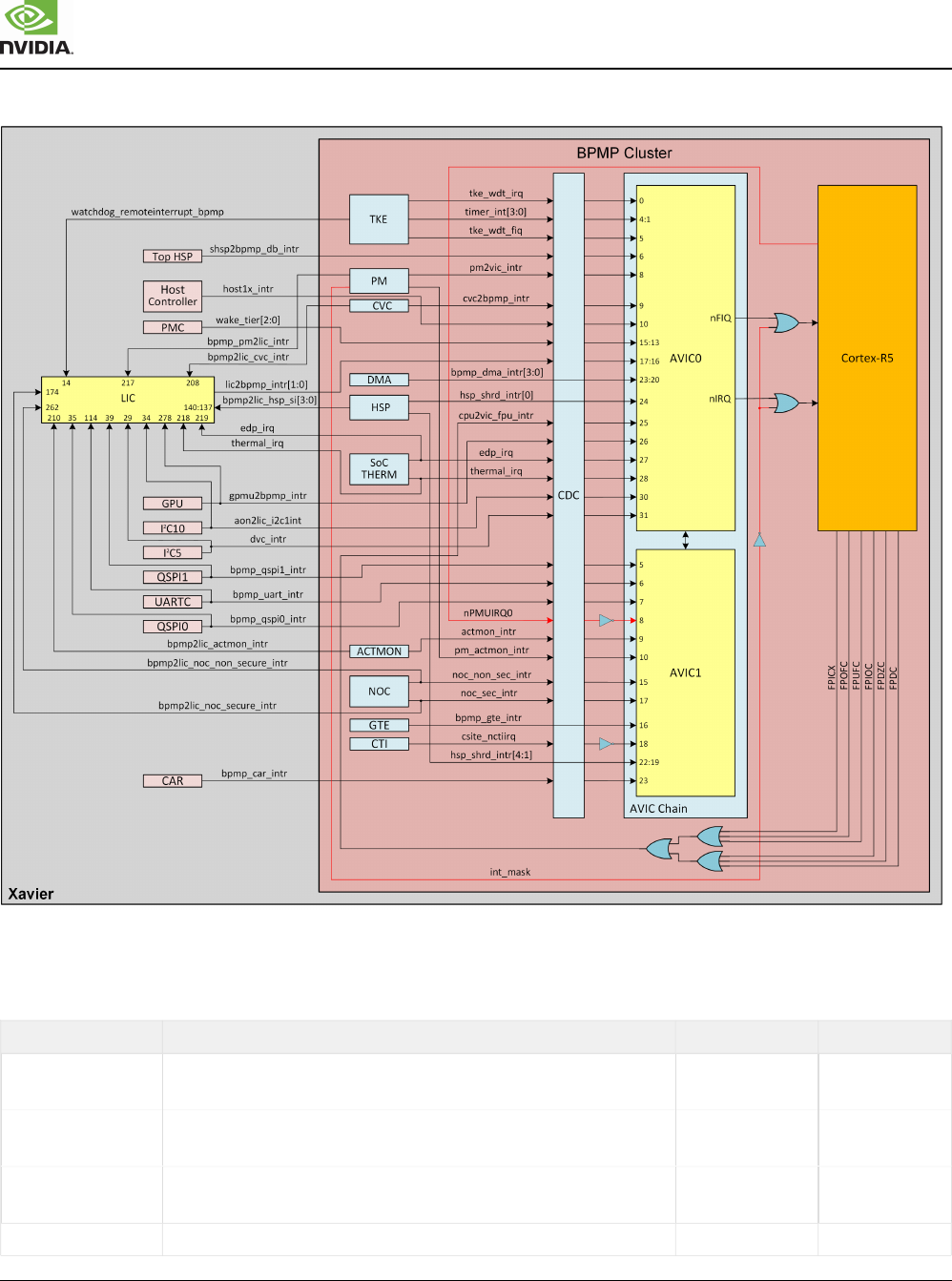
Xavier Series SoC Technical Reference Manual
XAVIER | TRM | DP-09253-002_v1.1 | SUBJECT TO CHANGE | www.nvidia.com Page of 5643 8287
Figure 8.4 BPMP Cluster Interrupt Structure
All the BPMP-related Interrupts are listed in the table below.
Table 8.6 BPMP Interrupts Connection
Source Interrupt Name (Software Name) AVIC Connection LIC Connection
BPMP - TKE tke_wdt_irq
( BPMP_INTERRUPT_WDTIRQ )
0 - 0 none
BPMP - TKE tke_timer_intr[0]
( BPMP_INTERRUPT_TIMER0 )
0 - 1 none
BPMP - TKE tke_timer_intr[1]
( BPMP_INTERRUPT_TIMER1 )
0 - 2 none
BPMP - TKE
0 - 3
none

Xavier Series SoC Technical Reference Manual
XAVIER | TRM | DP-09253-002_v1.1 | SUBJECT TO CHANGE | www.nvidia.com Page of 5644 8287
Source Interrupt Name (Software Name) AVIC Connection LIC Connection
tke_timer_intr[2]
( BPMP_INTERRUPT_TIMER2 )
BPMP - TKE tke_timer_intr[3]
( BPMP_INTERRUPT_TIMER3 )
0 - 4 none
BPMP - TKE tke_wdt_fiq
( BPMP_INTERRUPT_WDTFIQ )
0 - 5 none
BPMP - TKE watchdog_remoteinterrupt_bpmp
( BPMP_WDT_REMOTE )
none 14
top HSP shsp2bpmp_db_intr
( BPMP_INTERRUPT_HSP_DB )
0 - 6 none
BPMP - PM pm2vic_intr
( BPMP_INTERRUPT_PM )
0 - 8 none
BPMP - PM bpmp_pm2lic_intr
( BPMP_PM )
none 217
BPMP - CVC cvc2bpmp_intr
( BPMP_INTERRUPT_CVC )
0 - 9 none
BPMP - CVC bpmp2lic_cvc_intr
( CVC )
none 208
Host Controller host1x_intr
( BPMP_INTERRUPT_H1XSNC )
0 - 10 none
AON - PMC wake_tier[0]
( BPMP_INTERRUPT_WAKE0 )
0 - 13 none
AON - PMC wake_tier[1]
( BPMP_INTERRUPT_WAKE1 )
0 - 14 none
AON - PMC wake_tier[2]
( BPMP_INTERRUPT_WAKE2 )
0 - 15 none
LIC lic2bpmp_intr[0]
( BPMP_INTERRUPT_LIC0 )
0 - 16 none
LIC lic2bpmp_intr[1]
( BPMP_INTERRUPT_LIC1 )
0 - 17 none
BPMP - DMA bpmp_dma_intr[0]
( BPMP_INTERRUPT_DMA0 )
0 - 20 none
BPMP - DMA bpmp_dma_intr[1]
( BPMP_INTERRUPT_DMA1 )
0 - 21 none
BPMP - DMA bpmp_dma_intr[2]
( BPMP_INTERRUPT_DMA2 )
0 - 22 none
BPMP - DMA bpmp_dma_intr[3]
( BPMP_INTERRUPT_DMA3 )
0 - 23 none
BPMP - HSP hsp_shrd_intr[0]
( BPMP_INTERRUPT_HSP_SI_0 )
0 - 24 none

Xavier Series SoC Technical Reference Manual
XAVIER | TRM | DP-09253-002_v1.1 | SUBJECT TO CHANGE | www.nvidia.com Page of 5645 8287
Source Interrupt Name (Software Name) AVIC Connection LIC Connection
BPMP - HSP bpmp2lic_hsp_si[0]
( BPMP_HSP_SHARED_1 )
none 137
BPMP - HSP bpmp2lic_hsp_si[1]
( BPMP_HSP_SHARED_2 )
none 138
BPMP - HSP bpmp2lic_hsp_si[2]
( BPMP_HSP_SHARED_3 )
none 139
BPMP - HSP bpmp2lic_hsp_si[3]
( BPMP_HSP_SHARED_4 )
none 140
BPMP - R5 FPU cpu2vic_fpu_intr
( BPMP_INTERRUPT_FPUINT
0 - 25 none
GPU gpmu2bpmp_intr (AVIC) / gpmu2bpmp_intr (LIC)
( BPMP_INTERRUPT_GPMU (AVIC) / GPMU (LIC) )
0 - 26 278
BPMP - SoC Therm edp_irq (AVIC) / edp_irq (LIC)
( BPMP_INTERRUPT_EDP (AVIC) / EDP (LIC) )
0 - 27 219
BPMP - SoC Therm thermal_irq (AVIC) / thermal_irq (LIC)
( BPMP_INTERRUPT_SCTHRM (AVIC) / THERMAL (LIC) )
0 - 28 218
AON - I2C10 aon2lic_i2c1int
( BPMP_INTERRUPT_AONPWRI2C (AVIC) / I2C10 (LIC) )
0 - 30 34
I2C5 dvc_intr
( BPMP_INTERRUPT_SOCPWRI2C (AVIC) / I2C5 (LIC) )
0 - 31 29
QSPI1 bpmp_qspi1_intr
( BPMP_INTERRUPT_QSPI1 (AVIC) / QSPI1 (LIC) )
1 - 5 39
AON - UARTC bpmp_uart_intr (AVIC) / aon2lic_uartcint (LIC)
( BPMP_INTERRUPT_UART (AVIC) / UARTC (LIC) )
1 - 6 114
QSPI0 bpmp_qspi0_intr
( BPMP_INTERRUPT_QSPI0 (AVIC) / QSPI0 (LIC) )
1 - 7 35
BPMP - R5 nPMUIRQ0
( BPMP_INTERRUPT_PMUIRQ )
1 - 8 none
BPMP - ACTMON actmon_intr
( BPMP_INTERRUPT_CNTRL_ACTMON )
1 - 9 none
BPMP - PM pm_actmon_intr
( BPMP_INTERRUPT_BPMP_ACTMON )
1 - 10 none
BPMP - ACTMON bpmp2lic_cactmon_intr
( ACTMON )
none 210
BPMP - NOC noc_non_sec_intr (AVIC) / bpmp2lic_noc_non_secure_intr (LIC)
( BPMP_INTERRUPT_NOC_NON_SECURE (AVIC) / BPMP_FABRIC
(LIC) )
1 - 15 262
BPMP - GTE bpmp_gte_intr
( BPMP_INTERRUPT_GTE )
1 - 16 none
BPMP - NOC
1 - 17
174

Xavier Series SoC Technical Reference Manual
XAVIER | TRM | DP-09253-002_v1.1 | SUBJECT TO CHANGE | www.nvidia.com Page of 5646 8287
Source Interrupt Name (Software Name) AVIC Connection LIC Connection
noc_sec_intr (AVIC) / bpmp2lic_noc_secure_intr (LIC)
( BPMP_INTERRUPT_NOC_SECURE (AVIC) /
SECURE_BPMP_FABRIC (LIC) )
BPMP - CTI csite_nctiirq
( BPMP_INTERRUPT_CTIIRQ )
1 - 18 none
BPMP - HSP hsp_shrd_intr[1]
( BPMP_INTERRUPT_HSP_SI_1 )
1 - 19 none
BPMP - HSP hsp_shrd_intr[2]
( BPMP_INTERRUPT_HSP_SI_2 )
1 - 20 none
BPMP - HSP hsp_shrd_intr[3]
( BPMP_INTERRUPT_HSP_SI_3 )
1 - 21 none
BPMP - HSP hsp_shrd_intr[4]
( BPMP_INTERRUPT_HSP_SI_4 )
1 - 22 none
CAR bpmp_car_intr
( BPMP_INTERRUPT_CAR )
1 - 23 none
For further information of the BPMP Cluster Interrupt controller, refer to the Boot and Power Management
Processor chapter of this TRM.
RCE Cluster Interrupt Controller
The RCE Cluster Interrupt controller with its AVIC Chain is shown in the diagram below.
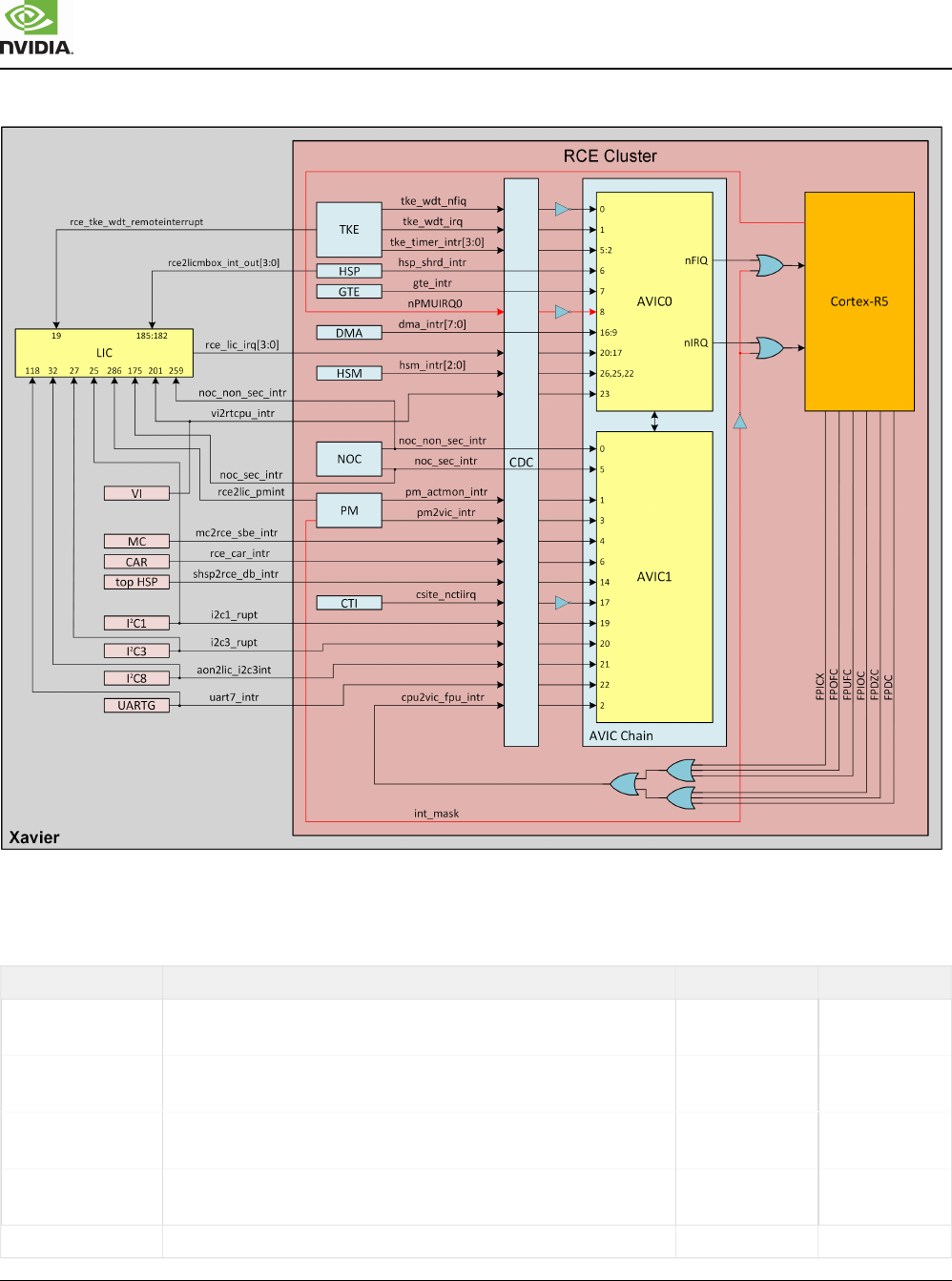
Xavier Series SoC Technical Reference Manual
XAVIER | TRM | DP-09253-002_v1.1 | SUBJECT TO CHANGE | www.nvidia.com Page of 5647 8287
Figure 8.5 RCE Cluster Interrupt Structure
All the RCE-related Interrupts are listed in the table below.
Table 8.7 RCE Interrupts Connection
Source Interrupt Name (Software Name) AVIC Connection LIC Connection
RCE - TKE tke_wdt_nfiq
( RCE_INTERRUPT_WDTFIQ )
0 - 0 none
RCE - TKE tke_wdt_irq
( RCE_INTERRUPT_WDTIRQ )
0 - 1 none
RCE - TKE tke_timer_intr[0]
( RCE_INTERRUPT_TIMER0 )
0 - 2 none
RCE - TKE tke_timer_intr[1]
( RCE_INTERRUPT_TIMER1 )
0 - 3 none
RCE - TKE
0 - 4
none

Xavier Series SoC Technical Reference Manual
XAVIER | TRM | DP-09253-002_v1.1 | SUBJECT TO CHANGE | www.nvidia.com Page of 5648 8287
Source Interrupt Name (Software Name) AVIC Connection LIC Connection
tke_timer_intr[2]
( RCE_INTERRUPT_TIMER2 )
RCE - TKE tke_timer_intr[3]
( RCE_INTERRUPT_TIMER3 )
0 - 5 none
RCE - TKE rce_tke_wdt_remoteinterrupt
( RCE_WDT_REMOTE )
none 19
RCE - HSP hsp_shrd_intr
( RCE_INTERRUPT_MBOX )
0 - 6 none
RCE - HSP rce2licmbox_int_out[0]
( RCE_MBOX_OUT_0 )
none 182
RCE - HSP rce2licmbox_int_out[1]
( RCE_MBOX_OUT_1 )
none 183
RCE - HSP rce2licmbox_int_out[2]
( RCE_MBOX_OUT_2 )
none 184
RCE - HSP rce2licmbox_int_out[3]
( RCE_MBOX_OUT_3 )
none 185
RCE - GTE gte_intr
( RCE_INTERRUPT_GTE )
0 - 7 none
RCE - R5 PMU nPMUIRQ0
( RCE_INTERRUPT_PMU )
0 - 8 none
RCE - DMA dma_intr[0]
( RCE_INTERRUPT_DMA0 )
0 - 9 none
RCE - DMA dma_intr[1]
( RCE_INTERRUPT_DMA1 )
0 - 10 none
RCE - DMA dma_intr[2]
( RCE_INTERRUPT_DMA2 )
0 - 11 none
RCE - DMA dma_intr[3]
( RCE_INTERRUPT_DMA3 )
0 - 12 none
RCE - DMA dma_intr[4]
( RCE_INTERRUPT_DMA4 )
0 - 13 none
RCE - DMA dma_intr[5]
( RCE_INTERRUPT_DMA5 )
0 - 14 none
RCE - DMA dma_intr[6]
( RCE_INTERRUPT_DMA6 )
0 - 15 none
RCE - DMA dma_intr[7]
( RCE_INTERRUPT_DMA7 )
0 - 16 none
LIC rce_lic_irq[0]
( RCE_INTERRUPT_LIC0 )
0 - 17 none
LIC rce_lic_irq[1]
( RCE_INTERRUPT_LIC1 )
0 - 18 none

Xavier Series SoC Technical Reference Manual
XAVIER | TRM | DP-09253-002_v1.1 | SUBJECT TO CHANGE | www.nvidia.com Page of 5649 8287
Source Interrupt Name (Software Name) AVIC Connection LIC Connection
LIC rce_lic_irq[2]
( RCE_INTERRUPT_LIC2 )
0 - 19 none
LIC rce_lic_irq[3]
( RCE_INTERRUPT_LIC3 )
0 - 20 none
RCE - HSM hsm_intr[0]
( RCE_INTERRUPT_HSM_CRITICAL_ERR )
0 - 22 none
VI vi2rtcpu_intr
( RCE_INTERRUPT_VI_HP (AVIC) / VI_THI (LIC) )
0 - 23 201
RCE - HSM hsm_intr[1]
( RCE_INTERRUPT_HSM_HP )
0 - 25 none
RCE - HSM hsm_intr[2]
( RCE_INTERRUPT_HSM_LP )
0 - 26 none
RCE - NOC noc_non_sec_intr (AVIC) / noc_non_sec_intr (LIC)
( RCE_INTERRUPT_NOC_NON_SECURE (AVIC) / RCE_FABRIC
(LIC) )
1 - 0 259
RCE - PM pm_actmon_intr
( RCE_INTERRUPT_ACTMON )
1 - 1 none
RCE - R5 FPU cpu2vic_fpu_intr
( RCE_INTERRUPT_FPUINT )
1 - 2 none
RCE - PM pm2vic_intr
( RCE_INTERRUPT_PM )
1 - 3 none
MC - SBE mc2rce_sbe_intr
( RCE_INTERRUPT_MC_SBE )
1 - 4 none
RCE - NOC noc_sec_intr (AVIC) / noc_sec_intr (LIC)
( RCE_INTERRUPT_NOC_SECURE ( AVIC / SECURE_RCE_FABRIC
(LIC) )
1 - 5 175
RCE - PM rce2lic_pmint
( RCE_PM )
none 286
CAR rce_car_intr
( RCE_INTERRUPT_CAR )
1 - 6 none
HSP shsp2rce_db_intr
( RCE_INTERRUPT_TOP0_HSP_DB )
1 - 14 none
RCE - CTI csite_nctiirq
( RCE_INTERRUPT_CTIIRQ )
1 - 17 none
I2C1 i2c1_intr (AVIC) / i2c1_rupt (LIC)
( RCE_INTERRUPT_I2C1 (AVIC) / I2C1 (LIC) )
1 - 19 25
I2C3 i2c3_intr (AVIC) / i2c3_rupt (LIC)
( RCE_INTERRUPT_I2C3 (AVIC) / I2C3 (LIC) )
1 - 20 27
AON - I2C8 i2c8_intr (AVIC) / aon2lic_i2c3int (LIC)
( RCE_INTERRUPT_I2C8 (AVIC) / I2C8 (LIC) )
1 - 21 32
AON - UARTG
1 - 22
118
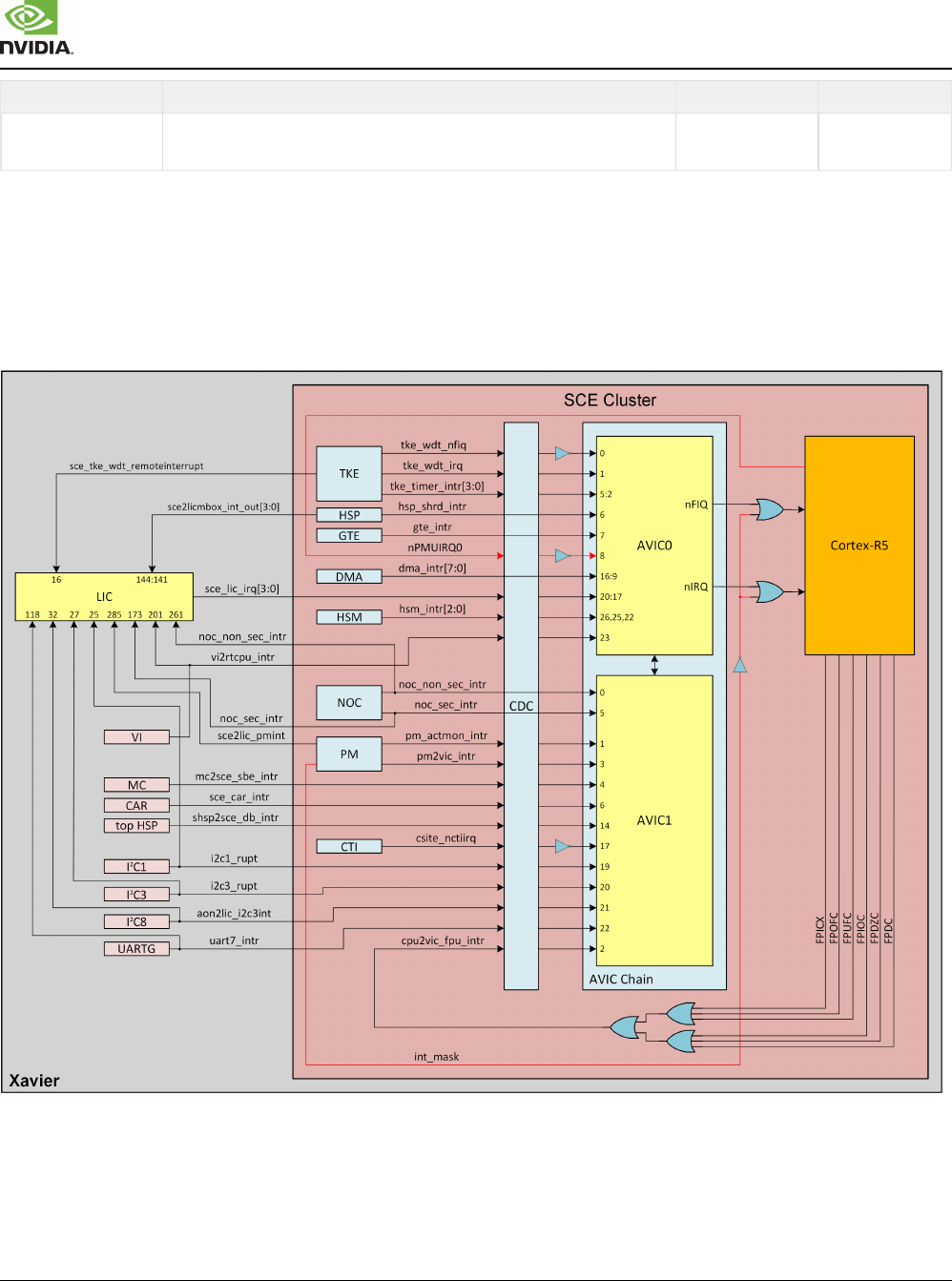
Xavier Series SoC Technical Reference Manual
XAVIER | TRM | DP-09253-002_v1.1 | SUBJECT TO CHANGE | www.nvidia.com Page of 5650 8287
Source Interrupt Name (Software Name) AVIC Connection LIC Connection
uart7_intr
(RCE_INTERRUPT_UART7 (AVIC) / UARTG (LIC))
For further information of the RCE Cluster Interrupt controller, refer to the RCE chapter of this TRM.
SCE Cluster Interrupt Controller
The SCE Cluster Interrupt controller with its AVIC Chain is shown in the diagram below.
Figure 8.6 SCE Cluster Interrupt Structure
All the SCE-related Interrupts are listed in the table below.

Xavier Series SoC Technical Reference Manual
XAVIER | TRM | DP-09253-002_v1.1 | SUBJECT TO CHANGE | www.nvidia.com Page of 5651 8287
Table 8.8 SCE Interrupts Connection
Source Interrupt Name (Software Name) AVIC Connection LIC Connection
SCE - TKE tke_wdt_nfiq
( SCE_INTERRUPT_WDTFIQ )
0 - 0 none
SCE - TKE tke_wdt_irq
(SCE_INTERRUPT_WDTIRQ )
0 - 1 none
SCE - TKE tke_timer_intr[0]
( SCE_INTERRUPT_TIMER0 )
0 - 2 none
SCE - TKE tke_timer_intr[1]
( SCE_INTERRUPT_TIMER1 )
0 - 3 none
SCE - TKE tke_timer_intr[2]
( SCE_INTERRUPT_TIMER2 )
0 - 4 none
SCE - TKE tke_timer_intr[3]
( SCE_INTERRUPT_TIMER3 )
0 - 5 none
SCE - TKE sce_tke_wdt_remoteinterrupt
( SCE_WDT_REMOTE )
none 16
SCE - HSP hsp_shrd_intr
( SCE_INTERRUPT_MBOX )
0 - 6 none
SCE - HSP sce2licmbox_int_out[0]
( SCE_MBOX_OUT_0 )
none 141
SCE - HSP sce2licmbox_int_out[1]
( SCE_MBOX_OUT_1 )
none 142
SCE - HSP sce2licmbox_int_out[2]
( SCE_MBOX_OUT_2 )
none 143
SCE - HSP sce2licmbox_int_out[3]
( SCE_MBOX_OUT_3 )
none 144
SCE - GTE gte_intr
( SCE_INTERRUPT_GTE )
0 - 7 none
SCE - R5 PMU nPMUIRQ0
( SCE_INTERRUPT_PMU )
0 - 8 none
SCE - DMA dma_intr[0]
( SCE_INTERRUPT_DMA0 )
0 - 9 none
SCE - DMA dma_intr[1]
( SCE_INTERRUPT_DMA1 )
0 - 10 none
SCE - DMA dma_intr[2]
( SCE_INTERRUPT_DMA2 )
0 - 11 none
SCE - DMA dma_intr[3]
( SCE_INTERRUPT_DMA3 )
0 - 12 none
SCE - DMA dma_intr[4]
( SCE_INTERRUPT_DMA4 )
0 - 13 none
SCE - DMA
0 - 14
none

Xavier Series SoC Technical Reference Manual
XAVIER | TRM | DP-09253-002_v1.1 | SUBJECT TO CHANGE | www.nvidia.com Page of 5652 8287
Source Interrupt Name (Software Name) AVIC Connection LIC Connection
dma_intr[5]
( SCE_INTERRUPT_DMA5 )
SCE - DMA dma_intr[6]
( SCE_INTERRUPT_DMA6)
0 - 15 none
SCE - DMA dma_intr[7]
( SCE_INTERRUPT_DMA7 )
0 - 16 none
LIC sce_lic_irq[0]
( SCE_INTERRUPT_LIC0 )
0 - 17 none
LIC sce_lic_irq[1]
( SCE_INTERRUPT_LIC1 )
0 - 18 none
LIC sce_lic_irq[2]
( SCE_INTERRUPT_LIC2 )
0 - 19 none
LIC sce_lic_irq[3]
( SCE_INTERRUPT_LIC3 )
0 - 20 none
SCE - HSM hsm_intr[0]
( SCE_INTERRUPT_HSM_CRITICAL_ERR )
0 - 22 none
VI vi2rtcpu_intr
( SCE_INTERRUPT_VI_HP (AVIC) / VI_THI (LIC) )
0 - 23 201
SCE - HSM hsm_intr[1]
( SCE_INTERRUPT_HSM_HP )
0 - 25 none
SCE - HSM hsm_intr[2]
( SCE_INTERRUPT_HSM_LP )
0 - 26 none
SCE - NOC noc_non_sec_intr (AVIC) / noc_non_sec_intr (LIC)
( SCE_INTERRUPT_NOC_NON_SECURE (AVIC) / SCE_FABRIC
(LIC) )
1 - 0 261
SCE - PM pm_actmon_intr
( SCE_INTERRUPT_ACTMON )
1 - 1 none
SCE - R5 FPU cpu2vic_fpu_intr
( SCE_INTERRUPT_FPUINT )
1 - 2 none
SCE - PM pm2vic_intr
( SCE_INTERRUPT_PM )
1 - 3 none
MC - SBE mc2sce_sbe_intr
( SCE_INTERRUPT_MC_SBE )
1 - 4 none
SCE - NOC noc_sec_intr (AVIC) / noc_sec_intr (LIC)
( SCE_INTERRUPT_NOC_SECURE (AVIC) / SECURE_SCE_FABRIC
(LIC) )
1 - 5 173
SCE - PM sce2lic_pmint
( SCE_PM )
none 285
CAR sce_car_intr
( SCE_INTERRUPT_CAR )
1 - 6 none
HSP
1 - 14
none

Xavier Series SoC Technical Reference Manual
XAVIER | TRM | DP-09253-002_v1.1 | SUBJECT TO CHANGE | www.nvidia.com Page of 5653 8287
Source Interrupt Name (Software Name) AVIC Connection LIC Connection
shsp2sce_db_intr
( SCE_INTERRUPT_TOP0_HSP_DB )
SCE - CTI csite_nctiirq
( SCE_INTERRUPT_CTIIRQ )
1 - 17 none
I2C1 i2c1_intr (AVIC) / i2c1_rupt (LIC)
( SCE_INTERRUPT_I2C1 (AVIC) / I2C1 (LIC) )
1 - 19 25
I2C3 i2c3_intr (AVIC) / i2c3_rupt (LIC)
( SCE_INTERRUPT_I2C3 (AVIC) / I2C3 (LIC) )
1 - 20 27
AON - I2C8 i2c8_intr (AVIC) / aon2lic_i2c3int (LIC)
( SCE_INTERRUPT_I2C8 (AVIC) / I2C8 (LIC) )
1 - 21 32
AON - UARTG uart7_intr
( SCE_INTERRUPT_UART7 (AVIC) / UARTG (LIC) )
1 - 22 118
For further information of the SCE Cluster Interrupt controller, refer to the Safety Cluster Engine (SCE) chapter
of this TRM.
APE Interrupt Controller
The APE Interrupt controllers together with Interrupt signals routing are shown in the diagram below.
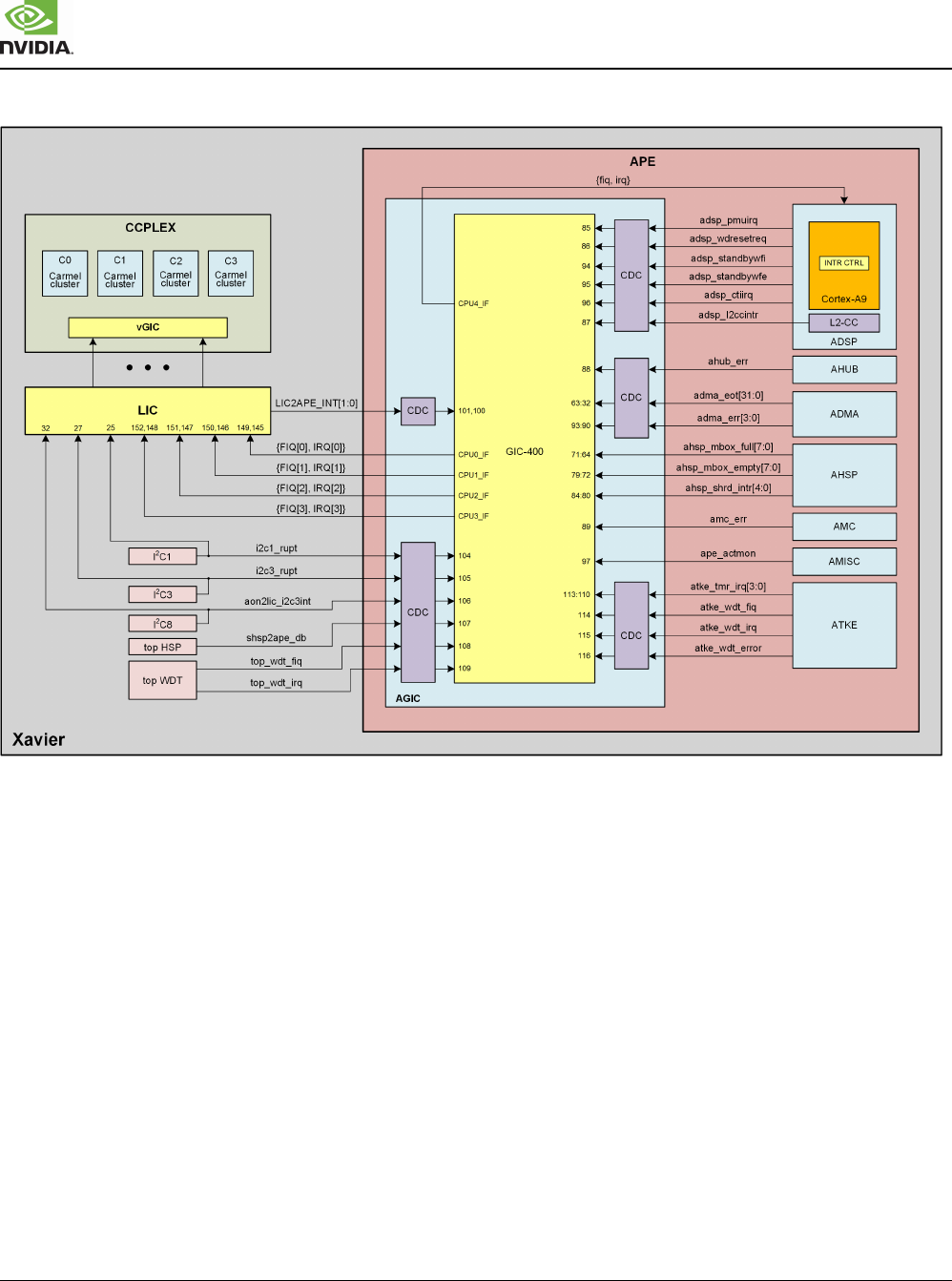
Xavier Series SoC Technical Reference Manual
XAVIER | TRM | DP-09253-002_v1.1 | SUBJECT TO CHANGE | www.nvidia.com Page of 5654 8287
Figure 8.7 APE Interrupts
There are two Interrupt controllers in the APE, the local Interrupt controller in ADSP and the APE Generic
Interrupt controller (AGIC). The APE Interrupts are routed to AGIC then aggregated to irq and fiq that get sent to
the ADSP local Interrupt controller's IRQ/FIQ input. The signals are configured as legacy mode, i.e. IRQ as PPI
(4) and FIQ as PPI(1). Other Interrupts in the ADSP local Interrupt controller are global timer PPI(0), private
timer PPI(1), and watchdog timer PPI(3). The ADSP local Interrupt controller does not have any SGI or SPI
Interrupts configured.
ADSP Interrupt Handling
ADSP's global timer PPI(0), private timer PPI(1), and watchdog timer PPI(3) Interrupts are not sent to the AGIC
or CCPLEX. To service these Interrupts, the ADSP only needs to access the registers within the local Interrupt
controller.
ADSP IRQ/FIQ Interrupts involve two Interrupt controllers, the ADSP local Interrupt controller and AGIC. ADSP
reads from its local Interrupt controller then from AGIC to determine the Interrupt source. If the Interrupt source
can be identified as from AGIC Interrupt acknowledge register, ADSP starts servicing the Interrupt. Some

Xavier Series SoC Technical Reference Manual
XAVIER | TRM | DP-09253-002_v1.1 | SUBJECT TO CHANGE | www.nvidia.com Page of 5655 8287
Interrupts, such as AHUB error Interrupt, require more Interrupt status access before the source can be
identified. After servicing the Interrupts, ADSP writes end of Interrupt to AGIC and the local Interrupt controller
to signal the completion of an Interrupt.
CCPLEX Interrupt Handling
There are four sets of AVIC-aggregated IRQ and FIQ Interrupt signals (IRQ[3:0] and FIQ[3:0]) from APE to
CCPLEX. While the CCPLEX has no access to the ADSP local Interrupt controller, the Interrupt service by the
Carmel processors (in CCPLEX) Interrupt service is similar to the ADSP's Interrupt handling, with the exception
that they first read from the vGIC in CCPLEX and LIC to determine if a particular Interrupt is coming from APE.
All the APE-related Interrupts are listed in the table below.
Table 8.9 APE Interrupts Connection
Source Interrupt Name GIC Connection LIC Connection
Processors in Xavier for Software-Generated Interrupts (SGI) 0 ~ 15 none
APE - ADMA adma_eot[0] 32 none
APE - ADMA adma_eot[1] 33 none
APE - ADMA adma_eot[2] 34 none
APE - ADMA adma_eot[3] 35 none
APE - ADMA adma_eot[4] 36 none
APE - ADMA adma_eot[5] 37 none
APE - ADMA adma_eot[6] 38 none
APE - ADMA adma_eot[7] 39 none
APE - ADMA adma_eot[8] 40 none
APE - ADMA adma_eot[9] 41 none
APE - ADMA adma_eot[10] 42 none
APE - ADMA adma_eot[11] 43 none
APE - ADMA adma_eot[12] 44 none
APE - ADMA adma_eot[13] 45 none
APE - ADMA adma_eot[14] 46 none
APE - ADMA adma_eot[15] 47 none
APE - ADMA adma_eot[16] 48 none
APE - ADMA adma_eot[17] 49 none
APE - ADMA adma_eot[18] 50 none
APE - ADMA adma_eot[19] 51 none
APE - ADMA adma_eot[20] 52 none
APE - ADMA adma_eot[21] 53 none

Xavier Series SoC Technical Reference Manual
XAVIER | TRM | DP-09253-002_v1.1 | SUBJECT TO CHANGE | www.nvidia.com Page of 5656 8287
Source Interrupt Name GIC Connection LIC Connection
APE - ADMA adma_eot[22] 54 none
APE - ADMA adma_eot[23] 55 none
APE - ADMA adma_eot[24] 56 none
APE - ADMA adma_eot[25] 57 none
APE - ADMA adma_eot[26] 58 none
APE - ADMA adma_eot[27] 59 none
APE - ADMA adma_eot[28] 60 none
APE - ADMA adma_eot[29] 61 none
APE - ADMA adma_eot[30] 62 none
APE - ADMA adma_eot[31] 63 none
APE - AHSP ahsp_mbox_full[0] 64 none
APE - AHSP ahsp_mbox_full[1] 65 none
APE - AHSP ahsp_mbox_full[2] 66 none
APE - AHSP ahsp_mbox_full[3] 67 none
APE - AHSP ahsp_mbox_full[4] 68 none
APE - AHSP ahsp_mbox_full[5] 69 none
APE - AHSP ahsp_mbox_full[6] 70 none
APE - AHSP ahsp_mbox_full[7] 71 none
APE - AHSP ahsp_mbox_empty[0] 72 none
APE - AHSP ahsp_mbox_empty[1] 73 none
APE - AHSP ahsp_mbox_empty[2] 74 none
APE - AHSP ahsp_mbox_empty[3] 75 none
APE - AHSP ahsp_mbox_empty[4] 76 none
APE - AHSP ahsp_mbox_empty[5] 77 none
APE - AHSP ahsp_mbox_empty[6] 78 none
APE - AHSP ahsp_mbox_empty[7] 79 none
APE - AHSP ashp_shrd_intr[0] 80 none
APE - AHSP ashp_shrd_intr[1] 81 none
APE - AHSP ashp_shrd_intr[2] 82 none
APE - AHSP ashp_shrd_intr[3] 83 none
APE - AHSP ashp_shrd_intr[4] 84 none
APE - ADSP adsp_pmuirq 85 none
APE - ADSP adsp_wdresetreq 86 none
APE - ADSP L2CC adsp_l2ccintr 87 none
APE - AHUB ahub_err 88 none

Xavier Series SoC Technical Reference Manual
XAVIER | TRM | DP-09253-002_v1.1 | SUBJECT TO CHANGE | www.nvidia.com Page of 5657 8287
Source Interrupt Name GIC Connection LIC Connection
APE - AMC amc_err 89 none
APE - ADMA adma_err[0] 90 none
APE - ADMA adma_err[1] 91 none
APE - ADMA adma_err[2] 92 none
APE - ADMA adma_err[3] 93 none
APE - ADSP adsp_standbywfi 94 none
APE - ADSP adsp_standbywfe 95 none
APE - ADSP adsp_ctiirq 96 none
APE - AMISC ape_actmon 97 none
LIC Lic2ape_int[0] 100 none
LIC Lic2ape_int[1] 101 none
I2C1 i2c1_rupt 104 25
I2C3 i2c3_rupt 105 27
AON - I2C8 aon2lic_i2c3int 106 32
top HSP shsp2ape_db 107 none
top WDT top_wdt_fiq 108 none
top WDT top_wdt_irq 109 none
APE - ATKE atke_tmr_irq[0] 110 none
APE - ATKE atke_tmr_irq[1] 111 none
APE - ATKE atke_tmr_irq[2] 112 none
APE - ATKE atke_tmr_irq[3] 113 none
APE - ATKE atke_wdt_fiq 114 201
APE - ATKE atke_wdt_irq 115 none
APE - ATKE atke_wdt_error 116 none
APE - AGIC IRQ[0] none 145
APE - AGIC IRQ[1] none 146
APE - AGIC IRQ[2] none 147
APE - AGIC IRQ[3] none 148
APE - AGIC FIQ[0] none 149
APE - AGIC FIQ[1] none 150
APE - AGIC FIQ[2] none 151
APE - AGIC FIQ[3] none 152
For further information of the APE Interrupt controllers, refer to the Audio Processing Engine (APE) chapter of
this TRM.

Xavier Series SoC Technical Reference Manual
XAVIER | TRM | DP-09253-002_v1.1 | SUBJECT TO CHANGE | www.nvidia.com Page of 5658 8287
8.2.3 Interrupt Registers
LIC Registers
Note: The Interrupt controller register descriptions do not follow the standard register table protocol described in
"Reading Register Tables" in the Introduction chapter. Each register's relative offset, access type, and power-on
reset value are listed in the table below.
There are eleven slices numbered 0 to 10, each with eight channels numbered from 0 to 7. In particular, the
slice <s> is associated with the Interrupts numbered between <s>*32 and <s>*32 + 31. And each slice has:
Eight sets of 10 registers with names using the form < >_ < >_0, where
CHANNEL <SLICE>_ FUNCTION
< > (= 0, 1, ..., 7) specifies which of the eight ( 0, 1, ..., 7) channels.
CHANNEL
< > (= 0, 1, ..., 10) specifies which of the eleven (0, 1, ..., 10) slices.
SLICE
< > is the name of the register. In particular,
FUNCTION
VIRQ and VFIQ: indicate the Valid status, as an IRQ or FIQ, respectively, for this channel.
IER (Interrupt Enable Register): indicates that the corresponding Interrupt is enabled for the channel.
IER_SET and IER_CLR: to control IER, bits equal to 1 are set or cleared, respectively, in the IER
register. The use of SET and CLR registers avoids the need for a Read-Modify-Write operation.
IEP_CLASS: Interrupt Enable Priority Class. A bit set to 0 indicates IRQ, and a bit set to 1 indicates FIQ.
ISR: indicates the current value of the inputs to the channel after IDR.
IDR (Interrupt Disable Register): indicates that the corresponding Interrupt is disabled for the channel.
IDR_SET and IDR_CLR: to control IDR, bits equal to 1 are set or cleared, respectively, in the IDR
register. The use of SET and CLR registers avoids the need for a Read-Modify-Write operation.
Seven additional registers with names COMMON_< >_< >_0, where
SLICE FUNCTION
< > specifies which of the eleven (0, 1, ..., 10) slices.
SLICE
< > is the name of the register. In particular,
FUNCTION
GISR (Global Interrupt Status Register): indicates the status of the shared Interrupt inputs as they enter
the LIC.
FIR: indicates Force Interrupt
FIR_SET and FIR_CLR: to control FIR, bits set to 1 are set or cleared, respectively, in the FIR. The use
of SET and CLR registers avoids the need for a Read-Modify-Write operation.
CIDR (CCPLEX Interrupt Disable Register): indicates which shared Interrupts do not propagate towards
the CCPLEX.
CIDR_SET and CIDR_CLR: to control CIDR, bits set to 1 are set or cleared, respectively, in the CIDR.
The use of SET and CLR registers avoids the need for a Read-Modify-Write operation.
Common Registers per Slice and Channel
The table below summarizes each < >/< > register set in its base offset and Interrupt mapping
SLICE CHANNEL
reference.

Xavier Series SoC Technical Reference Manual
XAVIER | TRM | DP-09253-002_v1.1 | SUBJECT TO CHANGE | www.nvidia.com Page of 5659 8287
Table 8.10 < > > Mapping
CHANNEL /<SLICE
CHANNEL SLICE
Base Offset Mapping (Interrupt Number)
0 0 0x0000 0 to 31
1 0x0040 32 to 63 (60, 61, 63 reserved)
2 0x0080 64 to 95 (67 reserved)
3 0x00c0 96 to 127 (108, 109, 110, 111 reserved)
4 0x0100 128 to 159
5 0x0140 160 to 191 (179, 180, 181 reserved)
6 0x0180 192 to 223
7 0x01c0 224 to 255 (225 reserved)
8 0x0200 256 to 287 (256, 257, 258, 287 reserved)
9 0x0240 288 to 319
10 0x0280 320 to 351
1 0 0x0800 0 to 31
1 0x0840 32 to 63 (60, 61, 63 reserved)
2 0x0880 64 to 95 (67 reserved)
3 0x08c0 96 to 127 (108, 109, 110, 111 reserved)
4 0x0900 128 to 159
5 0x0940 160 to 191 (179, 180, 181 reserved)
6 0x0980 192 to 223
7 0x09c0 224 to 255 (225 reserved)
8 0x0a00 256 to 287 (256, 257, 258, 287 reserved)
9 0x0a40 288 to 319
10 0x0a80 320 to 351
2 0 0x1000 0 to 31
1 0x1040 32 to 63 (60, 61, 63 reserved)
2 0x1080 64 to 95 (67 reserved)
3 0x10c0 96 to 127 (108, 109, 110, 111 reserved)
4 0x1100 128 to 159
5 0x1140 160 to 191 (179, 180, 181 reserved)
6 0x1180 192 to 223
7 0x11c0 224 to 255 (225 reserved)
8 0x1200 256 to 287 (256, 257, 258, 287 reserved)
9 0x1240 288 to 319
10 0x1280 320 to 351
3
0
0x1800
0 to 31

Xavier Series SoC Technical Reference Manual
XAVIER | TRM | DP-09253-002_v1.1 | SUBJECT TO CHANGE | www.nvidia.com Page of 5660 8287
CHANNEL SLICE
Base Offset Mapping (Interrupt Number)
1 0x1840 32 to 63 (60, 61, 63 reserved)
2 0x1880 64 to 95 (67 reserved)
3 0x18c0 96 to 127 (108, 109, 110, 111 reserved)
4 0x1900 128 to 159
5 0x1940 160 to 191 (179, 180, 181 reserved)
6 0x1980 192 to 223
7 0x19c0 224 to 255 (225 reserved)
8 0x2000 256 to 287 (256, 257, 258, 287 reserved)
9 0x2040 288 to 319
10 0x2080 320 to 351
4 0 0x2000 0 to 31
1 0x2040 32 to 63 (60, 61, 63 reserved)
2 0x2080 64 to 95 (67 reserved)
3 0x20c0 96 to 127 (108, 109, 110, 111 reserved)
4 0x2100 128 to 159
5 0x2140 160 to 191 (179, 180, 181 reserved)
6 0x2180 192 to 223
7 0x21c0 224 to 255 (225 reserved)
8 0x2200 256 to 287 (256, 257, 258, 287 reserved)
9 0x2240 288 to 319
10 0x2280 320 to 351
5 0 0x2800 0 to 31
1 0x2840 32 to 63 (60, 61, 63 reserved)
2 0x2880 64 to 95 (67 reserved)
3 0x28c0 96 to 127 (108, 109, 110, 111 reserved)
4 0x2900 128 to 159
5 0x2940 160 to 191 (179, 180, 181 reserved)
6 0x2980 192 to 223
7 0x29c0 224 to 255 (225 reserved)
8 0x2a00 256 to 287 (256, 257, 258, 287 reserved)
9 0x2a40 288 to 319
10 0x2a80 320 to 351
6
0
0x3000
0 to 31
1 0x3040 32 to 63 (60, 61, 63 reserved)
2 0x3080 64 to 95 (67 reserved)

Xavier Series SoC Technical Reference Manual
XAVIER | TRM | DP-09253-002_v1.1 | SUBJECT TO CHANGE | www.nvidia.com Page of 5661 8287
CHANNEL SLICE
Base Offset Mapping (Interrupt Number)
3 0x30c0 96 to 127 (108, 109, 110, 111 reserved)
4 0x3100 128 to 159
5 0x3140 160 to 191 (179, 180, 181 reserved)
6 0x3180 192 to 223
7 0x31c0 224 to 255 (225 reserved)
8 0x3200 256 to 287 (256, 257, 258, 287 reserved)
9 0x3240 288 to 319
10 0x3280 320 to 351
7 0 0x3800 0 to 31
1 0x3840 32 to 63 (60, 61, 63 reserved)
2 0x3880 64 to 95 (67 reserved)
3 0x38c0 96 to 127 (108, 109, 110, 111 reserved)
4 0x3900 128 to 159
5 0x3940 160 to 191 (179, 180, 181 reserved)
6 0x3980 192 to 223
7 0xc39c0 224 to 255 (225 reserved)
8 0x3a00 256 to 287 (256, 257, 258, 287 reserved)
9 0x3a40 288 to 319
10 0x3a80 320 to 351
The table below lists the 10 registers common to each < >/< > combination (i.e. the < >/<
SLICE CHANNEL SLICE
> register set).
CHANNEL
Note: The actual offset for each register is the Base Offset (from the table above) plus the Relative Offset in the
table below.
Table 8.11 Register Set per < >/< >
SLICE CHANNEL
Name Relative
Offset
RD/WR Reset SCR Protection Description
INTR_CTLR_<CHANNEL>_<SLICE>_VI
RQ_0
0x00
RO
x
<CHANNEL>_SC
RE_0
Valid Interrupt Request
Status Register
INTR_CTLR_<CHANNEL>_<SLICE>_VFI
Q_0
0x04 RO x FIQ Valid Interrupt Request
Status Register
INTR_CTLR_<CHANNEL>_<SLICE>_IE
R_0
0x08 RW 0 Interrupt Enable Register
INTR_CTLR_<CHANNEL>_<SLICE>_IE
R_SET_0
0x0c RW x Set Interrupt Enable Register
0x10
RW
x

Xavier Series SoC Technical Reference Manual
XAVIER | TRM | DP-09253-002_v1.1 | SUBJECT TO CHANGE | www.nvidia.com Page of 5662 8287
Name Relative
Offset
RD/WR Reset SCR Protection Description
INTR_CTLR_<CHANNEL>_<SLICE>_IE
R_CLR_0
Clear Interrupt Enable
Register
INTR_CTLR_<CHANNEL>_<SLICE>_IE
P_CLASS_0
0x14 RW 0 Interrupt Enable Priority
Class Register
INTR_CTLR_<CHANNEL>_<SLICE>_IS
R_0
0x18 RO 0 Interrupt Status Register
INTR_CTLR_<CHANNEL>_<SLICE>_ID
R_0
0x1c RW 0 <CHANNEL>_SC
RD_0
Interrupt Disable Register
INTR_CTLR_<CHANNEL>_<SLICE>_ID
R_SET_0
0x20 RW x Set Interrupt Disable Register
INTR_CTLR_<CHANNEL>_<SLICE>_ID
R_CLR_0
0x24 RW x Clear Interrupt Disable
Register
Common Registers per Slice
The table below summarizes each <SLICE> register set in its base offset and Interrupt mapping reference.
Table 8.12 Common < > Mapping
SLICE
SLICE
Base Offset Mapping (Interrupt Number)
0 0xf800 0 to 31
1 0xf840 32 to 63 (60, 61, 63 reserved)
2 0xf880 64 to 95 (67 reserved)
3 0xf8c0 96 to 127 (108, 109, 110, 111 reserved)
4 0xf900 128 to 159
5 0xf940 160 to 191 (179, 180, 181 reserved)
6 0xf980 192 to 223
7 0xf9c0 224 to 255 (225 reserved)
8 0xfa00 256 to 287 (256, 257, 258, 287 reserved)
9 0xfa40 288 to 319
10 0xfa80 320 to 351
The table below lists the seven common registers for each < >.
SLICE
Note: The actual offset for each register is the Base Offset (from the table above) plus the Relative Offset in the
table below.

Xavier Series SoC Technical Reference Manual
XAVIER | TRM | DP-09253-002_v1.1 | SUBJECT TO CHANGE | www.nvidia.com Page of 5663 8287
Table 8.13 Common Registers per < >
SLICE
Name Relative
Offset
RD/WR Reset SCR Protection Description
INTR_CTLR_COMMON_<SLICE>_GISR
_0
0x00 RO x
SCR_COMMON_
0
Global Interrupt Request
Status Register
INTR_CTLR_COMMON_<SLICE>_FIR_0 0x04 RW 0 Force Interrupt Register
INTR_CTLR_COMMON_<SLICE>_FIR_S
ET_0
0x08 RW x Set Force Interrupt Register
INTR_CTLR_COMMON_<SLICE>_FIR_
CLR_0
0x0c RW x Clear Force Interrupt
Register
INTR_CTLR_COMMON_<SLICE>_CIDR
_0
0x10 RW 0 CCPLEX Interrupt Disable
Register
INTR_CTLR_COMMON_<SLICE>_CIDR
_SET_0
0x14 RW x Set CCPLEX Interrupt
Disable Register
INTR_CTLR_COMMON_<SLICE>_CIDR
_CLR_0
0x18 RW x Clear CCPLEX Interrupt
Disable Register
8.2.4 Legacy Interrupt Controller (LIC) Registers
Refer to "Reading Register Tables" in the Introduction chapter for the register table protocol as well as
recommendations for accessing registers. The Base Addresses of the following registers are specified in the
Address Map section of the Xavier TRM.
INTR_CTLR_CHANNEL0_SLICE0_VIRQ_0
Offset: 0x0
Read/Write: RO
Parity Protection: N
SCR Protection: CHANNEL0_SCRE_0
Reset: 0xXXXXXXXX (0bxxxx,xxxx,xxxx,xxxx,xxxx,xxxx,xxxx,xxxx)
Bit Reset Description
31:0 X VIRQ
INTR_CTLR_CHANNEL0_SLICE0_VFIQ_0
Offset: 0x4
Read/Write: RO
Parity Protection: N
SCR Protection: CHANNEL0_SCRE_0
Reset: 0xXXXXXXXX (0bxxxx,xxxx,xxxx,xxxx,xxxx,xxxx,xxxx,xxxx)

Xavier Series SoC Technical Reference Manual
XAVIER | TRM | DP-09253-002_v1.1 | SUBJECT TO CHANGE | www.nvidia.com Page of 5664 8287
Bit Reset Description
31:0 X VFIQ
INTR_CTLR_CHANNEL0_SLICE0_IER_0
Offset: 0x8
Read/Write: RW
Parity Protection: N
SCR Protection: CHANNEL0_SCRE_0
Reset: 0x00000000 (0b0000,0000,0000,0000,0000,0000,0000,0000)
Bit Reset Description
31:0 0x0 IER
INTR_CTLR_CHANNEL0_SLICE0_IER_SET_0
Offset: 0xc
Read/Write: RW
Parity Protection: N
SCR Protection: CHANNEL0_SCRE_0
Reset: 0xXXXXXXXX (0bxxxx,xxxx,xxxx,xxxx,xxxx,xxxx,xxxx,xxxx)
Bit Reset Description
31:0 X IER_SET
INTR_CTLR_CHANNEL0_SLICE0_IER_CLR_0
Offset: 0x10
Read/Write: RW
Parity Protection: N
SCR Protection: CHANNEL0_SCRE_0
Reset: 0xXXXXXXXX (0bxxxx,xxxx,xxxx,xxxx,xxxx,xxxx,xxxx,xxxx)
Bit Reset Description
31:0 X IER_CLR
INTR_CTLR_CHANNEL0_SLICE0_IEP_CLASS_0
Offset: 0x14
Read/Write: RW
Parity Protection: N
SCR Protection: CHANNEL0_SCRE_0
Reset: 0x00000000 (0b0000,0000,0000,0000,0000,0000,0000,0000)

Xavier Series SoC Technical Reference Manual
XAVIER | TRM | DP-09253-002_v1.1 | SUBJECT TO CHANGE | www.nvidia.com Page of 5665 8287
Bit Reset Description
31:0 0x0 IEP_CLASS
INTR_CTLR_CHANNEL0_SLICE0_ISR_0
Offset: 0x18
Read/Write: RO
Parity Protection: N
SCR Protection: CHANNEL0_SCRE_0
Reset: 0x00000000 (0b0000,0000,0000,0000,0000,0000,0000,0000)
Bit Reset Description
31:0 0x0
ISR
INTR_CTLR_CHANNEL0_SLICE0_IDR_0
Offset: 0x1c
Read/Write: RW
Parity Protection: N
SCR Protection: CHANNEL0_SCRD_0
Reset: 0x00000000 (0b0000,0000,0000,0000,0000,0000,0000,0000)
Bit Reset Description
31:0 0x0 IDR
INTR_CTLR_CHANNEL0_SLICE0_IDR_SET_0
Offset: 0x20
Read/Write: RW
Parity Protection: N
SCR Protection: CHANNEL0_SCRD_0
Reset: 0xXXXXXXXX (0bxxxx,xxxx,xxxx,xxxx,xxxx,xxxx,xxxx,xxxx)
Bit Reset Description
31:0 X IDR_SET
INTR_CTLR_CHANNEL0_SLICE0_IDR_CLR_0
Offset: 0x24
Read/Write: RW
Parity Protection: N
SCR Protection: CHANNEL0_SCRD_0
Reset: 0xXXXXXXXX (0bxxxx,xxxx,xxxx,xxxx,xxxx,xxxx,xxxx,xxxx)

Xavier Series SoC Technical Reference Manual
XAVIER | TRM | DP-09253-002_v1.1 | SUBJECT TO CHANGE | www.nvidia.com Page of 5666 8287
Bit Reset Description
31:0 X IDR_CLR
INTR_CTLR_CHANNEL0_SLICE1_VIRQ_0
Offset: 0x40
Read/Write: RO
Parity Protection: N
SCR Protection: CHANNEL0_SCRE_0
Reset: 0xXXXXXXXX (0bxxxx,xxxx,xxxx,xxxx,xxxx,xxxx,xxxx,xxxx)
Bit Reset Description
31:0 X VIRQ
INTR_CTLR_CHANNEL0_SLICE1_VFIQ_0
Offset: 0x44
Read/Write: RO
Parity Protection: N
SCR Protection: CHANNEL0_SCRE_0
Reset: 0xXXXXXXXX (0bxxxx,xxxx,xxxx,xxxx,xxxx,xxxx,xxxx,xxxx)
Bit Reset Description
31:0 X
VFIQ
INTR_CTLR_CHANNEL0_SLICE1_IER_0
Offset: 0x48
Read/Write: RW
Parity Protection: N
SCR Protection: CHANNEL0_SCRE_0
Reset: 0x00000000 (0b0000,0000,0000,0000,0000,0000,0000,0000)
Bit Reset Description
31:0 0x0 IER
INTR_CTLR_CHANNEL0_SLICE1_IER_SET_0
Offset: 0x4c
Read/Write: RW
Parity Protection: N
SCR Protection: CHANNEL0_SCRE_0
Reset: 0xXXXXXXXX (0bxxxx,xxxx,xxxx,xxxx,xxxx,xxxx,xxxx,xxxx)

Xavier Series SoC Technical Reference Manual
XAVIER | TRM | DP-09253-002_v1.1 | SUBJECT TO CHANGE | www.nvidia.com Page of 5667 8287
Bit Reset Description
31:0 X IER_SET
INTR_CTLR_CHANNEL0_SLICE1_IER_CLR_0
Offset: 0x50
Read/Write: RW
Parity Protection: N
SCR Protection: CHANNEL0_SCRE_0
Reset: 0xXXXXXXXX (0bxxxx,xxxx,xxxx,xxxx,xxxx,xxxx,xxxx,xxxx)
Bit Reset Description
31:0 X IER_CLR
INTR_CTLR_CHANNEL0_SLICE1_IEP_CLASS_0
Offset: 0x54
Read/Write: RW
Parity Protection: N
SCR Protection: CHANNEL0_SCRE_0
Reset: 0x00000000 (0b0000,0000,0000,0000,0000,0000,0000,0000)
Bit Reset Description
31:0 0x0 IEP_CLASS
INTR_CTLR_CHANNEL0_SLICE1_ISR_0
Offset: 0x58
Read/Write: RO
Parity Protection: N
SCR Protection: CHANNEL0_SCRE_0
Reset: 0x00000000 (0b0000,0000,0000,0000,0000,0000,0000,0000)
Bit Reset Description
31:0 0x0
ISR
INTR_CTLR_CHANNEL0_SLICE1_IDR_0
Offset: 0x5c
Read/Write: RW
Parity Protection: N
SCR Protection: CHANNEL0_SCRD_0
Reset: 0x00000000 (0b0000,0000,0000,0000,0000,0000,0000,0000)

Xavier Series SoC Technical Reference Manual
XAVIER | TRM | DP-09253-002_v1.1 | SUBJECT TO CHANGE | www.nvidia.com Page of 5668 8287
Bit Reset Description
31:0 0x0
IDR
INTR_CTLR_CHANNEL0_SLICE1_IDR_SET_0
Offset: 0x60
Read/Write: RW
Parity Protection: N
SCR Protection: CHANNEL0_SCRD_0
Reset: 0xXXXXXXXX (0bxxxx,xxxx,xxxx,xxxx,xxxx,xxxx,xxxx,xxxx)
Bit Reset Description
31:0 X IDR_SET
INTR_CTLR_CHANNEL0_SLICE1_IDR_CLR_0
Offset: 0x64
Read/Write: RW
Parity Protection: N
SCR Protection: CHANNEL0_SCRD_0
Reset: 0xXXXXXXXX (0bxxxx,xxxx,xxxx,xxxx,xxxx,xxxx,xxxx,xxxx)
Bit Reset Description
31:0 X IDR_CLR
INTR_CTLR_CHANNEL0_SLICE2_VIRQ_0
Offset: 0x80
Read/Write: RO
Parity Protection: N
SCR Protection: CHANNEL0_SCRE_0
Reset: 0xXXXXXXXX (0bxxxx,xxxx,xxxx,xxxx,xxxx,xxxx,xxxx,xxxx)
Bit Reset Description
31:0 X VIRQ
INTR_CTLR_CHANNEL0_SLICE2_VFIQ_0
Offset: 0x84
Read/Write: RO
Parity Protection: N
SCR Protection: CHANNEL0_SCRE_0
Reset: 0xXXXXXXXX (0bxxxx,xxxx,xxxx,xxxx,xxxx,xxxx,xxxx,xxxx)

Xavier Series SoC Technical Reference Manual
XAVIER | TRM | DP-09253-002_v1.1 | SUBJECT TO CHANGE | www.nvidia.com Page of 5669 8287
Bit Reset Description
31:0 X VFIQ
INTR_CTLR_CHANNEL0_SLICE2_IER_0
Offset: 0x88
Read/Write: RW
Parity Protection: N
SCR Protection: CHANNEL0_SCRE_0
Reset: 0x00000000 (0b0000,0000,0000,0000,0000,0000,0000,0000)
Bit Reset Description
31:0 0x0
IER
INTR_CTLR_CHANNEL0_SLICE2_IER_SET_0
Offset: 0x8c
Read/Write: RW
Parity Protection: N
SCR Protection: CHANNEL0_SCRE_0
Reset: 0xXXXXXXXX (0bxxxx,xxxx,xxxx,xxxx,xxxx,xxxx,xxxx,xxxx)
Bit Reset Description
31:0 X IER_SET
INTR_CTLR_CHANNEL0_SLICE2_IER_CLR_0
Offset: 0x90
Read/Write: RW
Parity Protection: N
SCR Protection: CHANNEL0_SCRE_0
Reset: 0xXXXXXXXX (0bxxxx,xxxx,xxxx,xxxx,xxxx,xxxx,xxxx,xxxx)
Bit Reset Description
31:0 X IER_CLR
INTR_CTLR_CHANNEL0_SLICE2_IEP_CLASS_0
Offset: 0x94
Read/Write: RW
Parity Protection: N
SCR Protection: CHANNEL0_SCRE_0
Reset: 0x00000000 (0b0000,0000,0000,0000,0000,0000,0000,0000)

Xavier Series SoC Technical Reference Manual
XAVIER | TRM | DP-09253-002_v1.1 | SUBJECT TO CHANGE | www.nvidia.com Page of 5670 8287
Bit Reset Description
31:0 0x0 IEP_CLASS
INTR_CTLR_CHANNEL0_SLICE2_ISR_0
Offset: 0x98
Read/Write: RO
Parity Protection: N
SCR Protection: CHANNEL0_SCRE_0
Reset: 0x00000000 (0b0000,0000,0000,0000,0000,0000,0000,0000)
Bit Reset Description
31:0 0x0 ISR
INTR_CTLR_CHANNEL0_SLICE2_IDR_0
Offset: 0x9c
Read/Write: RW
Parity Protection: N
SCR Protection: CHANNEL0_SCRD_0
Reset: 0x00000000 (0b0000,0000,0000,0000,0000,0000,0000,0000)
Bit Reset Description
31:0 0x0
IDR
INTR_CTLR_CHANNEL0_SLICE2_IDR_SET_0
Offset: 0xa0
Read/Write: RW
Parity Protection: N
SCR Protection: CHANNEL0_SCRD_0
Reset: 0xXXXXXXXX (0bxxxx,xxxx,xxxx,xxxx,xxxx,xxxx,xxxx,xxxx)
Bit Reset Description
31:0 X IDR_SET
INTR_CTLR_CHANNEL0_SLICE2_IDR_CLR_0
Offset: 0xa4
Read/Write: RW
Parity Protection: N
SCR Protection: CHANNEL0_SCRD_0
Reset: 0xXXXXXXXX (0bxxxx,xxxx,xxxx,xxxx,xxxx,xxxx,xxxx,xxxx)

Xavier Series SoC Technical Reference Manual
XAVIER | TRM | DP-09253-002_v1.1 | SUBJECT TO CHANGE | www.nvidia.com Page of 5671 8287
Bit Reset Description
31:0 X IDR_CLR
INTR_CTLR_CHANNEL0_SLICE3_VIRQ_0
Offset: 0xc0
Read/Write: RO
Parity Protection: N
SCR Protection: CHANNEL0_SCRE_0
Reset: 0xXXXXXXXX (0bxxxx,xxxx,xxxx,xxxx,xxxx,xxxx,xxxx,xxxx)
Bit Reset Description
31:0 X VIRQ
INTR_CTLR_CHANNEL0_SLICE3_VFIQ_0
Offset: 0xc4
Read/Write: RO
Parity Protection: N
SCR Protection: CHANNEL0_SCRE_0
Reset: 0xXXXXXXXX (0bxxxx,xxxx,xxxx,xxxx,xxxx,xxxx,xxxx,xxxx)
Bit Reset Description
31:0 X VFIQ
INTR_CTLR_CHANNEL0_SLICE3_IER_0
Offset: 0xc8
Read/Write: RW
Parity Protection: N
SCR Protection: CHANNEL0_SCRE_0
Reset: 0x00000000 (0b0000,0000,0000,0000,0000,0000,0000,0000)
Bit Reset Description
31:0 0x0
IER
INTR_CTLR_CHANNEL0_SLICE3_IER_SET_0
Offset: 0xcc
Read/Write: RW
Parity Protection: N
SCR Protection: CHANNEL0_SCRE_0
Reset: 0xXXXXXXXX (0bxxxx,xxxx,xxxx,xxxx,xxxx,xxxx,xxxx,xxxx)

Xavier Series SoC Technical Reference Manual
XAVIER | TRM | DP-09253-002_v1.1 | SUBJECT TO CHANGE | www.nvidia.com Page of 5672 8287
Bit Reset Description
31:0 X
IER_SET
INTR_CTLR_CHANNEL0_SLICE3_IER_CLR_0
Offset: 0xd0
Read/Write: RW
Parity Protection: N
SCR Protection: CHANNEL0_SCRE_0
Reset: 0xXXXXXXXX (0bxxxx,xxxx,xxxx,xxxx,xxxx,xxxx,xxxx,xxxx)
Bit Reset Description
31:0 X IER_CLR
INTR_CTLR_CHANNEL0_SLICE3_IEP_CLASS_0
Offset: 0xd4
Read/Write: RW
Parity Protection: N
SCR Protection: CHANNEL0_SCRE_0
Reset: 0x00000000 (0b0000,0000,0000,0000,0000,0000,0000,0000)
Bit Reset Description
31:0 0x0 IEP_CLASS
INTR_CTLR_CHANNEL0_SLICE3_ISR_0
Offset: 0xd8
Read/Write: RO
Parity Protection: N
SCR Protection: CHANNEL0_SCRE_0
Reset: 0x00000000 (0b0000,0000,0000,0000,0000,0000,0000,0000)
Bit Reset Description
31:0 0x0 ISR
INTR_CTLR_CHANNEL0_SLICE3_IDR_0
Offset: 0xdc
Read/Write: RW
Parity Protection: N
SCR Protection: CHANNEL0_SCRD_0
Reset: 0x00000000 (0b0000,0000,0000,0000,0000,0000,0000,0000)

Xavier Series SoC Technical Reference Manual
XAVIER | TRM | DP-09253-002_v1.1 | SUBJECT TO CHANGE | www.nvidia.com Page of 5673 8287
Bit Reset Description
31:0 0x0 IDR
INTR_CTLR_CHANNEL0_SLICE3_IDR_SET_0
Offset: 0xe0
Read/Write: RW
Parity Protection: N
SCR Protection: CHANNEL0_SCRD_0
Reset: 0xXXXXXXXX (0bxxxx,xxxx,xxxx,xxxx,xxxx,xxxx,xxxx,xxxx)
Bit Reset Description
31:0 X
IDR_SET
INTR_CTLR_CHANNEL0_SLICE3_IDR_CLR_0
Offset: 0xe4
Read/Write: RW
Parity Protection: N
SCR Protection: CHANNEL0_SCRD_0
Reset: 0xXXXXXXXX (0bxxxx,xxxx,xxxx,xxxx,xxxx,xxxx,xxxx,xxxx)
Bit Reset Description
31:0 X IDR_CLR
INTR_CTLR_CHANNEL0_SLICE4_VIRQ_0
Offset: 0x100
Read/Write: RO
Parity Protection: N
SCR Protection: CHANNEL0_SCRE_0
Reset: 0xXXXXXXXX (0bxxxx,xxxx,xxxx,xxxx,xxxx,xxxx,xxxx,xxxx)
Bit Reset Description
31:0 X VIRQ
INTR_CTLR_CHANNEL0_SLICE4_VFIQ_0
Offset: 0x104
Read/Write: RO
Parity Protection: N
SCR Protection: CHANNEL0_SCRE_0
Reset: 0xXXXXXXXX (0bxxxx,xxxx,xxxx,xxxx,xxxx,xxxx,xxxx,xxxx)

Xavier Series SoC Technical Reference Manual
XAVIER | TRM | DP-09253-002_v1.1 | SUBJECT TO CHANGE | www.nvidia.com Page of 5674 8287
Bit Reset Description
31:0 X VFIQ
INTR_CTLR_CHANNEL0_SLICE4_IER_0
Offset: 0x108
Read/Write: RW
Parity Protection: N
SCR Protection: CHANNEL0_SCRE_0
Reset: 0x00000000 (0b0000,0000,0000,0000,0000,0000,0000,0000)
Bit Reset Description
31:0 0x0 IER
INTR_CTLR_CHANNEL0_SLICE4_IER_SET_0
Offset: 0x10c
Read/Write: RW
Parity Protection: N
SCR Protection: CHANNEL0_SCRE_0
Reset: 0xXXXXXXXX (0bxxxx,xxxx,xxxx,xxxx,xxxx,xxxx,xxxx,xxxx)
Bit Reset Description
31:0 X
IER_SET
INTR_CTLR_CHANNEL0_SLICE4_IER_CLR_0
Offset: 0x110
Read/Write: RW
Parity Protection: N
SCR Protection: CHANNEL0_SCRE_0
Reset: 0xXXXXXXXX (0bxxxx,xxxx,xxxx,xxxx,xxxx,xxxx,xxxx,xxxx)
Bit Reset Description
31:0 X IER_CLR
INTR_CTLR_CHANNEL0_SLICE4_IEP_CLASS_0
Offset: 0x114
Read/Write: RW
Parity Protection: N
SCR Protection: CHANNEL0_SCRE_0
Reset: 0x00000000 (0b0000,0000,0000,0000,0000,0000,0000,0000)

Xavier Series SoC Technical Reference Manual
XAVIER | TRM | DP-09253-002_v1.1 | SUBJECT TO CHANGE | www.nvidia.com Page of 5675 8287
Bit Reset Description
31:0 0x0 IEP_CLASS
INTR_CTLR_CHANNEL0_SLICE4_ISR_0
Offset: 0x118
Read/Write: RO
Parity Protection: N
SCR Protection: CHANNEL0_SCRE_0
Reset: 0x00000000 (0b0000,0000,0000,0000,0000,0000,0000,0000)
Bit Reset Description
31:0 0x0 ISR
INTR_CTLR_CHANNEL0_SLICE4_IDR_0
Offset: 0x11c
Read/Write: RW
Parity Protection: N
SCR Protection: CHANNEL0_SCRD_0
Reset: 0x00000000 (0b0000,0000,0000,0000,0000,0000,0000,0000)
Bit Reset Description
31:0 0x0 IDR
INTR_CTLR_CHANNEL0_SLICE4_IDR_SET_0
Offset: 0x120
Read/Write: RW
Parity Protection: N
SCR Protection: CHANNEL0_SCRD_0
Reset: 0xXXXXXXXX (0bxxxx,xxxx,xxxx,xxxx,xxxx,xxxx,xxxx,xxxx)
Bit Reset Description
31:0 X
IDR_SET
INTR_CTLR_CHANNEL0_SLICE4_IDR_CLR_0
Offset: 0x124
Read/Write: RW
Parity Protection: N
SCR Protection: CHANNEL0_SCRD_0
Reset: 0xXXXXXXXX (0bxxxx,xxxx,xxxx,xxxx,xxxx,xxxx,xxxx,xxxx)

Xavier Series SoC Technical Reference Manual
XAVIER | TRM | DP-09253-002_v1.1 | SUBJECT TO CHANGE | www.nvidia.com Page of 5676 8287
Bit Reset Description
31:0 X
IDR_CLR
INTR_CTLR_CHANNEL0_SLICE5_VIRQ_0
Offset: 0x140
Read/Write: RO
Parity Protection: N
SCR Protection: CHANNEL0_SCRE_0
Reset: 0xXXXXXXXX (0bxxxx,xxxx,xxxx,xxxx,xxxx,xxxx,xxxx,xxxx)
Bit Reset Description
31:0 X VIRQ
INTR_CTLR_CHANNEL0_SLICE5_VFIQ_0
Offset: 0x144
Read/Write: RO
Parity Protection: N
SCR Protection: CHANNEL0_SCRE_0
Reset: 0xXXXXXXXX (0bxxxx,xxxx,xxxx,xxxx,xxxx,xxxx,xxxx,xxxx)
Bit Reset Description
31:0 X VFIQ
INTR_CTLR_CHANNEL0_SLICE5_IER_0
Offset: 0x148
Read/Write: RW
Parity Protection: N
SCR Protection: CHANNEL0_SCRE_0
Reset: 0x00000000 (0b0000,0000,0000,0000,0000,0000,0000,0000)
Bit Reset Description
31:0 0x0 IER
INTR_CTLR_CHANNEL0_SLICE5_IER_SET_0
Offset: 0x14c
Read/Write: RW
Parity Protection: N
SCR Protection: CHANNEL0_SCRE_0
Reset: 0xXXXXXXXX (0bxxxx,xxxx,xxxx,xxxx,xxxx,xxxx,xxxx,xxxx)

Xavier Series SoC Technical Reference Manual
XAVIER | TRM | DP-09253-002_v1.1 | SUBJECT TO CHANGE | www.nvidia.com Page of 5677 8287
Bit Reset Description
31:0 X IER_SET
INTR_CTLR_CHANNEL0_SLICE5_IER_CLR_0
Offset: 0x150
Read/Write: RW
Parity Protection: N
SCR Protection: CHANNEL0_SCRE_0
Reset: 0xXXXXXXXX (0bxxxx,xxxx,xxxx,xxxx,xxxx,xxxx,xxxx,xxxx)
Bit Reset Description
31:0 X
IER_CLR
INTR_CTLR_CHANNEL0_SLICE5_IEP_CLASS_0
Offset: 0x154
Read/Write: RW
Parity Protection: N
SCR Protection: CHANNEL0_SCRE_0
Reset: 0x00000000 (0b0000,0000,0000,0000,0000,0000,0000,0000)
Bit Reset Description
31:0 0x0 IEP_CLASS
INTR_CTLR_CHANNEL0_SLICE5_ISR_0
Offset: 0x158
Read/Write: RO
Parity Protection: N
SCR Protection: CHANNEL0_SCRE_0
Reset: 0x00000000 (0b0000,0000,0000,0000,0000,0000,0000,0000)
Bit Reset Description
31:0 0x0 ISR
INTR_CTLR_CHANNEL0_SLICE5_IDR_0
Offset: 0x15c
Read/Write: RW
Parity Protection: N
SCR Protection: CHANNEL0_SCRD_0
Reset: 0x00000000 (0b0000,0000,0000,0000,0000,0000,0000,0000)

Xavier Series SoC Technical Reference Manual
XAVIER | TRM | DP-09253-002_v1.1 | SUBJECT TO CHANGE | www.nvidia.com Page of 5678 8287
Bit Reset Description
31:0 0x0 IDR
INTR_CTLR_CHANNEL0_SLICE5_IDR_SET_0
Offset: 0x160
Read/Write: RW
Parity Protection: N
SCR Protection: CHANNEL0_SCRD_0
Reset: 0xXXXXXXXX (0bxxxx,xxxx,xxxx,xxxx,xxxx,xxxx,xxxx,xxxx)
Bit Reset Description
31:0 X IDR_SET
INTR_CTLR_CHANNEL0_SLICE5_IDR_CLR_0
Offset: 0x164
Read/Write: RW
Parity Protection: N
SCR Protection: CHANNEL0_SCRD_0
Reset: 0xXXXXXXXX (0bxxxx,xxxx,xxxx,xxxx,xxxx,xxxx,xxxx,xxxx)
Bit Reset Description
31:0 X
IDR_CLR
INTR_CTLR_CHANNEL0_SLICE6_VIRQ_0
Offset: 0x180
Read/Write: RO
Parity Protection: N
SCR Protection: CHANNEL0_SCRE_0
Reset: 0xXXXXXXXX (0bxxxx,xxxx,xxxx,xxxx,xxxx,xxxx,xxxx,xxxx)
Bit Reset Description
31:0 X VIRQ
INTR_CTLR_CHANNEL0_SLICE6_VFIQ_0
Offset: 0x184
Read/Write: RO
Parity Protection: N
SCR Protection: CHANNEL0_SCRE_0
Reset: 0xXXXXXXXX (0bxxxx,xxxx,xxxx,xxxx,xxxx,xxxx,xxxx,xxxx)

Xavier Series SoC Technical Reference Manual
XAVIER | TRM | DP-09253-002_v1.1 | SUBJECT TO CHANGE | www.nvidia.com Page of 5679 8287
Bit Reset Description
31:0 X VFIQ
INTR_CTLR_CHANNEL0_SLICE6_IER_0
Offset: 0x188
Read/Write: RW
Parity Protection: N
SCR Protection: CHANNEL0_SCRE_0
Reset: 0x00000000 (0b0000,0000,0000,0000,0000,0000,0000,0000)
Bit Reset Description
31:0 0x0 IER
INTR_CTLR_CHANNEL0_SLICE6_IER_SET_0
Offset: 0x18c
Read/Write: RW
Parity Protection: N
SCR Protection: CHANNEL0_SCRE_0
Reset: 0xXXXXXXXX (0bxxxx,xxxx,xxxx,xxxx,xxxx,xxxx,xxxx,xxxx)
Bit Reset Description
31:0 X IER_SET
INTR_CTLR_CHANNEL0_SLICE6_IER_CLR_0
Offset: 0x190
Read/Write: RW
Parity Protection: N
SCR Protection: CHANNEL0_SCRE_0
Reset: 0xXXXXXXXX (0bxxxx,xxxx,xxxx,xxxx,xxxx,xxxx,xxxx,xxxx)
Bit Reset Description
31:0 X
IER_CLR
INTR_CTLR_CHANNEL0_SLICE6_IEP_CLASS_0
Offset: 0x194
Read/Write: RW
Parity Protection: N
SCR Protection: CHANNEL0_SCRE_0
Reset: 0x00000000 (0b0000,0000,0000,0000,0000,0000,0000,0000)

Xavier Series SoC Technical Reference Manual
XAVIER | TRM | DP-09253-002_v1.1 | SUBJECT TO CHANGE | www.nvidia.com Page of 5680 8287
Bit Reset Description
31:0 0x0
IEP_CLASS
INTR_CTLR_CHANNEL0_SLICE6_ISR_0
Offset: 0x198
Read/Write: RO
Parity Protection: N
SCR Protection: CHANNEL0_SCRE_0
Reset: 0x00000000 (0b0000,0000,0000,0000,0000,0000,0000,0000)
Bit Reset Description
31:0 0x0 ISR
INTR_CTLR_CHANNEL0_SLICE6_IDR_0
Offset: 0x19c
Read/Write: RW
Parity Protection: N
SCR Protection: CHANNEL0_SCRD_0
Reset: 0x00000000 (0b0000,0000,0000,0000,0000,0000,0000,0000)
Bit Reset Description
31:0 0x0 IDR
INTR_CTLR_CHANNEL0_SLICE6_IDR_SET_0
Offset: 0x1a0
Read/Write: RW
Parity Protection: N
SCR Protection: CHANNEL0_SCRD_0
Reset: 0xXXXXXXXX (0bxxxx,xxxx,xxxx,xxxx,xxxx,xxxx,xxxx,xxxx)
Bit Reset Description
31:0 X IDR_SET
INTR_CTLR_CHANNEL0_SLICE6_IDR_CLR_0
Offset: 0x1a4
Read/Write: RW
Parity Protection: N
SCR Protection: CHANNEL0_SCRD_0
Reset: 0xXXXXXXXX (0bxxxx,xxxx,xxxx,xxxx,xxxx,xxxx,xxxx,xxxx)

Xavier Series SoC Technical Reference Manual
XAVIER | TRM | DP-09253-002_v1.1 | SUBJECT TO CHANGE | www.nvidia.com Page of 5681 8287
Bit Reset Description
31:0 X IDR_CLR
INTR_CTLR_CHANNEL0_SLICE7_VIRQ_0
Offset: 0x1c0
Read/Write: RO
Parity Protection: N
SCR Protection: CHANNEL0_SCRE_0
Reset: 0xXXXXXXXX (0bxxxx,xxxx,xxxx,xxxx,xxxx,xxxx,xxxx,xxxx)
Bit Reset Description
31:0 X
VIRQ
INTR_CTLR_CHANNEL0_SLICE7_VFIQ_0
Offset: 0x1c4
Read/Write: RO
Parity Protection: N
SCR Protection: CHANNEL0_SCRE_0
Reset: 0xXXXXXXXX (0bxxxx,xxxx,xxxx,xxxx,xxxx,xxxx,xxxx,xxxx)
Bit Reset Description
31:0 X VFIQ
INTR_CTLR_CHANNEL0_SLICE7_IER_0
Offset: 0x1c8
Read/Write: RW
Parity Protection: N
SCR Protection: CHANNEL0_SCRE_0
Reset: 0x00000000 (0b0000,0000,0000,0000,0000,0000,0000,0000)
Bit Reset Description
31:0 0x0 IER
INTR_CTLR_CHANNEL0_SLICE7_IER_SET_0
Offset: 0x1cc
Read/Write: RW
Parity Protection: N
SCR Protection: CHANNEL0_SCRE_0
Reset: 0xXXXXXXXX (0bxxxx,xxxx,xxxx,xxxx,xxxx,xxxx,xxxx,xxxx)

Xavier Series SoC Technical Reference Manual
XAVIER | TRM | DP-09253-002_v1.1 | SUBJECT TO CHANGE | www.nvidia.com Page of 5682 8287
Bit Reset Description
31:0 X IER_SET
INTR_CTLR_CHANNEL0_SLICE7_IER_CLR_0
Offset: 0x1d0
Read/Write: RW
Parity Protection: N
SCR Protection: CHANNEL0_SCRE_0
Reset: 0xXXXXXXXX (0bxxxx,xxxx,xxxx,xxxx,xxxx,xxxx,xxxx,xxxx)
Bit Reset Description
31:0 X IER_CLR
INTR_CTLR_CHANNEL0_SLICE7_IEP_CLASS_0
Offset: 0x1d4
Read/Write: RW
Parity Protection: N
SCR Protection: CHANNEL0_SCRE_0
Reset: 0x00000000 (0b0000,0000,0000,0000,0000,0000,0000,0000)
Bit Reset Description
31:0 0x0
IEP_CLASS
INTR_CTLR_CHANNEL0_SLICE7_ISR_0
Offset: 0x1d8
Read/Write: RO
Parity Protection: N
SCR Protection: CHANNEL0_SCRE_0
Reset: 0x00000000 (0b0000,0000,0000,0000,0000,0000,0000,0000)
Bit Reset Description
31:0 0x0 ISR
INTR_CTLR_CHANNEL0_SLICE7_IDR_0
Offset: 0x1dc
Read/Write: RW
Parity Protection: N
SCR Protection: CHANNEL0_SCRD_0
Reset: 0x00000000 (0b0000,0000,0000,0000,0000,0000,0000,0000)

Xavier Series SoC Technical Reference Manual
XAVIER | TRM | DP-09253-002_v1.1 | SUBJECT TO CHANGE | www.nvidia.com Page of 5683 8287
Bit Reset Description
31:0 0x0 IDR
INTR_CTLR_CHANNEL0_SLICE7_IDR_SET_0
Offset: 0x1e0
Read/Write: RW
Parity Protection: N
SCR Protection: CHANNEL0_SCRD_0
Reset: 0xXXXXXXXX (0bxxxx,xxxx,xxxx,xxxx,xxxx,xxxx,xxxx,xxxx)
Bit Reset Description
31:0 X IDR_SET
INTR_CTLR_CHANNEL0_SLICE7_IDR_CLR_0
Offset: 0x1e4
Read/Write: RW
Parity Protection: N
SCR Protection: CHANNEL0_SCRD_0
Reset: 0xXXXXXXXX (0bxxxx,xxxx,xxxx,xxxx,xxxx,xxxx,xxxx,xxxx)
Bit Reset Description
31:0 X IDR_CLR
INTR_CTLR_CHANNEL0_SLICE8_VIRQ_0
Offset: 0x200
Read/Write: RO
Parity Protection: N
SCR Protection: CHANNEL0_SCRE_0
Reset: 0xXXXXXXXX (0bxxxx,xxxx,xxxx,xxxx,xxxx,xxxx,xxxx,xxxx)
Bit Reset Description
31:0 X
VIRQ
INTR_CTLR_CHANNEL0_SLICE8_VFIQ_0
Offset: 0x204
Read/Write: RO
Parity Protection: N
SCR Protection: CHANNEL0_SCRE_0
Reset: 0xXXXXXXXX (0bxxxx,xxxx,xxxx,xxxx,xxxx,xxxx,xxxx,xxxx)

Xavier Series SoC Technical Reference Manual
XAVIER | TRM | DP-09253-002_v1.1 | SUBJECT TO CHANGE | www.nvidia.com Page of 5684 8287
Bit Reset Description
31:0 X
VFIQ
INTR_CTLR_CHANNEL0_SLICE8_IER_0
Offset: 0x208
Read/Write: RW
Parity Protection: N
SCR Protection: CHANNEL0_SCRE_0
Reset: 0x00000000 (0b0000,0000,0000,0000,0000,0000,0000,0000)
Bit Reset Description
31:0 0x0 IER
INTR_CTLR_CHANNEL0_SLICE8_IER_SET_0
Offset: 0x20c
Read/Write: RW
Parity Protection: N
SCR Protection: CHANNEL0_SCRE_0
Reset: 0xXXXXXXXX (0bxxxx,xxxx,xxxx,xxxx,xxxx,xxxx,xxxx,xxxx)
Bit Reset Description
31:0 X IER_SET
INTR_CTLR_CHANNEL0_SLICE8_IER_CLR_0
Offset: 0x210
Read/Write: RW
Parity Protection: N
SCR Protection: CHANNEL0_SCRE_0
Reset: 0xXXXXXXXX (0bxxxx,xxxx,xxxx,xxxx,xxxx,xxxx,xxxx,xxxx)
Bit Reset Description
31:0 X IER_CLR
INTR_CTLR_CHANNEL0_SLICE8_IEP_CLASS_0
Offset: 0x214
Read/Write: RW
Parity Protection: N
SCR Protection: CHANNEL0_SCRE_0
Reset: 0x00000000 (0b0000,0000,0000,0000,0000,0000,0000,0000)

Xavier Series SoC Technical Reference Manual
XAVIER | TRM | DP-09253-002_v1.1 | SUBJECT TO CHANGE | www.nvidia.com Page of 5685 8287
Bit Reset Description
31:0 0x0 IEP_CLASS
INTR_CTLR_CHANNEL0_SLICE8_ISR_0
Offset: 0x218
Read/Write: RO
Parity Protection: N
SCR Protection: CHANNEL0_SCRE_0
Reset: 0x00000000 (0b0000,0000,0000,0000,0000,0000,0000,0000)
Bit Reset Description
31:0 0x0
ISR
INTR_CTLR_CHANNEL0_SLICE8_IDR_0
Offset: 0x21c
Read/Write: RW
Parity Protection: N
SCR Protection: CHANNEL0_SCRD_0
Reset: 0x00000000 (0b0000,0000,0000,0000,0000,0000,0000,0000)
Bit Reset Description
31:0 0x0 IDR
INTR_CTLR_CHANNEL0_SLICE8_IDR_SET_0
Offset: 0x220
Read/Write: RW
Parity Protection: N
SCR Protection: CHANNEL0_SCRD_0
Reset: 0xXXXXXXXX (0bxxxx,xxxx,xxxx,xxxx,xxxx,xxxx,xxxx,xxxx)
Bit Reset Description
31:0 X IDR_SET
INTR_CTLR_CHANNEL0_SLICE8_IDR_CLR_0
Offset: 0x224
Read/Write: RW
Parity Protection: N
SCR Protection: CHANNEL0_SCRD_0
Reset: 0xXXXXXXXX (0bxxxx,xxxx,xxxx,xxxx,xxxx,xxxx,xxxx,xxxx)

Xavier Series SoC Technical Reference Manual
XAVIER | TRM | DP-09253-002_v1.1 | SUBJECT TO CHANGE | www.nvidia.com Page of 5686 8287
Bit Reset Description
31:0 X IDR_CLR
INTR_CTLR_CHANNEL0_SLICE9_VIRQ_0
Offset: 0x240
Read/Write: RO
Parity Protection: N
SCR Protection: CHANNEL0_SCRE_0
Reset: 0xXXXXXXXX (0bxxxx,xxxx,xxxx,xxxx,xxxx,xxxx,xxxx,xxxx)
Bit Reset Description
31:0 X VIRQ
INTR_CTLR_CHANNEL0_SLICE9_VFIQ_0
Offset: 0x244
Read/Write: RO
Parity Protection: N
SCR Protection: CHANNEL0_SCRE_0
Reset: 0xXXXXXXXX (0bxxxx,xxxx,xxxx,xxxx,xxxx,xxxx,xxxx,xxxx)
Bit Reset Description
31:0 X
VFIQ
INTR_CTLR_CHANNEL0_SLICE9_IER_0
Offset: 0x248
Read/Write: RW
Parity Protection: N
SCR Protection: CHANNEL0_SCRE_0
Reset: 0x00000000 (0b0000,0000,0000,0000,0000,0000,0000,0000)
Bit Reset Description
31:0 0x0 IER
INTR_CTLR_CHANNEL0_SLICE9_IER_SET_0
Offset: 0x24c
Read/Write: RW
Parity Protection: N
SCR Protection: CHANNEL0_SCRE_0
Reset: 0xXXXXXXXX (0bxxxx,xxxx,xxxx,xxxx,xxxx,xxxx,xxxx,xxxx)

Xavier Series SoC Technical Reference Manual
XAVIER | TRM | DP-09253-002_v1.1 | SUBJECT TO CHANGE | www.nvidia.com Page of 5687 8287
Bit Reset Description
31:0 X IER_SET
INTR_CTLR_CHANNEL0_SLICE9_IER_CLR_0
Offset: 0x250
Read/Write: RW
Parity Protection: N
SCR Protection: CHANNEL0_SCRE_0
Reset: 0xXXXXXXXX (0bxxxx,xxxx,xxxx,xxxx,xxxx,xxxx,xxxx,xxxx)
Bit Reset Description
31:0 X IER_CLR
INTR_CTLR_CHANNEL0_SLICE9_IEP_CLASS_0
Offset: 0x254
Read/Write: RW
Parity Protection: N
SCR Protection: CHANNEL0_SCRE_0
Reset: 0x00000000 (0b0000,0000,0000,0000,0000,0000,0000,0000)
Bit Reset Description
31:0 0x0 IEP_CLASS
INTR_CTLR_CHANNEL0_SLICE9_ISR_0
Offset: 0x258
Read/Write: RO
Parity Protection: N
SCR Protection: CHANNEL0_SCRE_0
Reset: 0x00000000 (0b0000,0000,0000,0000,0000,0000,0000,0000)
Bit Reset Description
31:0 0x0
ISR
INTR_CTLR_CHANNEL0_SLICE9_IDR_0
Offset: 0x25c
Read/Write: RW
Parity Protection: N
SCR Protection: CHANNEL0_SCRD_0
Reset: 0x00000000 (0b0000,0000,0000,0000,0000,0000,0000,0000)

Xavier Series SoC Technical Reference Manual
XAVIER | TRM | DP-09253-002_v1.1 | SUBJECT TO CHANGE | www.nvidia.com Page of 5688 8287
Bit Reset Description
31:0 0x0
IDR
INTR_CTLR_CHANNEL0_SLICE9_IDR_SET_0
Offset: 0x260
Read/Write: RW
Parity Protection: N
SCR Protection: CHANNEL0_SCRD_0
Reset: 0xXXXXXXXX (0bxxxx,xxxx,xxxx,xxxx,xxxx,xxxx,xxxx,xxxx)
Bit Reset Description
31:0 X IDR_SET
INTR_CTLR_CHANNEL0_SLICE9_IDR_CLR_0
Offset: 0x264
Read/Write: RW
Parity Protection: N
SCR Protection: CHANNEL0_SCRD_0
Reset: 0xXXXXXXXX (0bxxxx,xxxx,xxxx,xxxx,xxxx,xxxx,xxxx,xxxx)
Bit Reset Description
31:0 X IDR_CLR
INTR_CTLR_CHANNEL0_SLICE10_VIRQ_0
Offset: 0x280
Read/Write: RO
Parity Protection: N
SCR Protection: CHANNEL0_SCRE_0
Reset: 0xXXXXXXXX (0bxxxx,xxxx,xxxx,xxxx,xxxx,xxxx,xxxx,xxxx)
Bit Reset Description
31:0 X VIRQ
INTR_CTLR_CHANNEL0_SLICE10_VFIQ_0
Offset: 0x284
Read/Write: RO
Parity Protection: N
SCR Protection: CHANNEL0_SCRE_0
Reset: 0xXXXXXXXX (0bxxxx,xxxx,xxxx,xxxx,xxxx,xxxx,xxxx,xxxx)

Xavier Series SoC Technical Reference Manual
XAVIER | TRM | DP-09253-002_v1.1 | SUBJECT TO CHANGE | www.nvidia.com Page of 5689 8287
Bit Reset Description
31:0 X VFIQ
INTR_CTLR_CHANNEL0_SLICE10_IER_0
Offset: 0x288
Read/Write: RW
Parity Protection: N
SCR Protection: CHANNEL0_SCRE_0
Reset: 0x00000000 (0b0000,0000,0000,0000,0000,0000,0000,0000)
Bit Reset Description
31:0 0x0
IER
INTR_CTLR_CHANNEL0_SLICE10_IER_SET_0
Offset: 0x28c
Read/Write: RW
Parity Protection: N
SCR Protection: CHANNEL0_SCRE_0
Reset: 0xXXXXXXXX (0bxxxx,xxxx,xxxx,xxxx,xxxx,xxxx,xxxx,xxxx)
Bit Reset Description
31:0 X IER_SET
INTR_CTLR_CHANNEL0_SLICE10_IER_CLR_0
Offset: 0x290
Read/Write: RW
Parity Protection: N
SCR Protection: CHANNEL0_SCRE_0
Reset: 0xXXXXXXXX (0bxxxx,xxxx,xxxx,xxxx,xxxx,xxxx,xxxx,xxxx)
Bit Reset Description
31:0 X IER_CLR
INTR_CTLR_CHANNEL0_SLICE10_IEP_CLASS_0
Offset: 0x294
Read/Write: RW
Parity Protection: N
SCR Protection: CHANNEL0_SCRE_0
Reset: 0x00000000 (0b0000,0000,0000,0000,0000,0000,0000,0000)

Xavier Series SoC Technical Reference Manual
XAVIER | TRM | DP-09253-002_v1.1 | SUBJECT TO CHANGE | www.nvidia.com Page of 5690 8287
Bit Reset Description
31:0 0x0 IEP_CLASS
INTR_CTLR_CHANNEL0_SLICE10_ISR_0
Offset: 0x298
Read/Write: RO
Parity Protection: N
SCR Protection: CHANNEL0_SCRE_0
Reset: 0x00000000 (0b0000,0000,0000,0000,0000,0000,0000,0000)
Bit Reset Description
31:0 0x0 ISR
INTR_CTLR_CHANNEL0_SLICE10_IDR_0
Offset: 0x29c
Read/Write: RW
Parity Protection: N
SCR Protection: CHANNEL0_SCRD_0
Reset: 0x00000000 (0b0000,0000,0000,0000,0000,0000,0000,0000)
Bit Reset Description
31:0 0x0
IDR
INTR_CTLR_CHANNEL0_SLICE10_IDR_SET_0
Offset: 0x2a0
Read/Write: RW
Parity Protection: N
SCR Protection: CHANNEL0_SCRD_0
Reset: 0xXXXXXXXX (0bxxxx,xxxx,xxxx,xxxx,xxxx,xxxx,xxxx,xxxx)
Bit Reset Description
31:0 X IDR_SET
INTR_CTLR_CHANNEL0_SLICE10_IDR_CLR_0
Offset: 0x2a4
Read/Write: RW
Parity Protection: N
SCR Protection: CHANNEL0_SCRD_0
Reset: 0xXXXXXXXX (0bxxxx,xxxx,xxxx,xxxx,xxxx,xxxx,xxxx,xxxx)

Xavier Series SoC Technical Reference Manual
XAVIER | TRM | DP-09253-002_v1.1 | SUBJECT TO CHANGE | www.nvidia.com Page of 5691 8287
Bit Reset Description
31:0 X IDR_CLR
INTR_CTLR_CHANNEL1_SLICE0_VIRQ_0
Offset: 0x800
Read/Write: RO
Parity Protection: N
SCR Protection: CHANNEL1_SCRE_0
Reset: 0xXXXXXXXX (0bxxxx,xxxx,xxxx,xxxx,xxxx,xxxx,xxxx,xxxx)
Bit Reset Description
31:0 X VIRQ
INTR_CTLR_CHANNEL1_SLICE0_VFIQ_0
Offset: 0x804
Read/Write: RO
Parity Protection: N
SCR Protection: CHANNEL1_SCRE_0
Reset: 0xXXXXXXXX (0bxxxx,xxxx,xxxx,xxxx,xxxx,xxxx,xxxx,xxxx)
Bit Reset Description
31:0 X VFIQ
INTR_CTLR_CHANNEL1_SLICE0_IER_0
Offset: 0x808
Read/Write: RW
Parity Protection: N
SCR Protection: CHANNEL1_SCRE_0
Reset: 0x00000000 (0b0000,0000,0000,0000,0000,0000,0000,0000)
Bit Reset Description
31:0 0x0
IER
INTR_CTLR_CHANNEL1_SLICE0_IER_SET_0
Offset: 0x80c
Read/Write: RW
Parity Protection: N
SCR Protection: CHANNEL1_SCRE_0
Reset: 0xXXXXXXXX (0bxxxx,xxxx,xxxx,xxxx,xxxx,xxxx,xxxx,xxxx)

Xavier Series SoC Technical Reference Manual
XAVIER | TRM | DP-09253-002_v1.1 | SUBJECT TO CHANGE | www.nvidia.com Page of 5692 8287
Bit Reset Description
31:0 X
IER_SET
INTR_CTLR_CHANNEL1_SLICE0_IER_CLR_0
Offset: 0x810
Read/Write: RW
Parity Protection: N
SCR Protection: CHANNEL1_SCRE_0
Reset: 0xXXXXXXXX (0bxxxx,xxxx,xxxx,xxxx,xxxx,xxxx,xxxx,xxxx)
Bit Reset Description
31:0 X IER_CLR
INTR_CTLR_CHANNEL1_SLICE0_IEP_CLASS_0
Offset: 0x814
Read/Write: RW
Parity Protection: N
SCR Protection: CHANNEL1_SCRE_0
Reset: 0x00000000 (0b0000,0000,0000,0000,0000,0000,0000,0000)
Bit Reset Description
31:0 0x0 IEP_CLASS
INTR_CTLR_CHANNEL1_SLICE0_ISR_0
Offset: 0x818
Read/Write: RO
Parity Protection: N
SCR Protection: CHANNEL1_SCRE_0
Reset: 0x00000000 (0b0000,0000,0000,0000,0000,0000,0000,0000)
Bit Reset Description
31:0 0x0 ISR
INTR_CTLR_CHANNEL1_SLICE0_IDR_0
Offset: 0x81c
Read/Write: RW
Parity Protection: N
SCR Protection: CHANNEL1_SCRD_0
Reset: 0x00000000 (0b0000,0000,0000,0000,0000,0000,0000,0000)

Xavier Series SoC Technical Reference Manual
XAVIER | TRM | DP-09253-002_v1.1 | SUBJECT TO CHANGE | www.nvidia.com Page of 5693 8287
Bit Reset Description
31:0 0x0 IDR
INTR_CTLR_CHANNEL1_SLICE0_IDR_SET_0
Offset: 0x820
Read/Write: RW
Parity Protection: N
SCR Protection: CHANNEL1_SCRD_0
Reset: 0xXXXXXXXX (0bxxxx,xxxx,xxxx,xxxx,xxxx,xxxx,xxxx,xxxx)
Bit Reset Description
31:0 X
IDR_SET
INTR_CTLR_CHANNEL1_SLICE0_IDR_CLR_0
Offset: 0x824
Read/Write: RW
Parity Protection: N
SCR Protection: CHANNEL1_SCRD_0
Reset: 0xXXXXXXXX (0bxxxx,xxxx,xxxx,xxxx,xxxx,xxxx,xxxx,xxxx)
Bit Reset Description
31:0 X IDR_CLR
INTR_CTLR_CHANNEL1_SLICE1_VIRQ_0
Offset: 0x840
Read/Write: RO
Parity Protection: N
SCR Protection: CHANNEL1_SCRE_0
Reset: 0xXXXXXXXX (0bxxxx,xxxx,xxxx,xxxx,xxxx,xxxx,xxxx,xxxx)
Bit Reset Description
31:0 X VIRQ
INTR_CTLR_CHANNEL1_SLICE1_VFIQ_0
Offset: 0x844
Read/Write: RO
Parity Protection: N
SCR Protection: CHANNEL1_SCRE_0
Reset: 0xXXXXXXXX (0bxxxx,xxxx,xxxx,xxxx,xxxx,xxxx,xxxx,xxxx)

Xavier Series SoC Technical Reference Manual
XAVIER | TRM | DP-09253-002_v1.1 | SUBJECT TO CHANGE | www.nvidia.com Page of 5694 8287
Bit Reset Description
31:0 X VFIQ
INTR_CTLR_CHANNEL1_SLICE1_IER_0
Offset: 0x848
Read/Write: RW
Parity Protection: N
SCR Protection: CHANNEL1_SCRE_0
Reset: 0x00000000 (0b0000,0000,0000,0000,0000,0000,0000,0000)
Bit Reset Description
31:0 0x0 IER
INTR_CTLR_CHANNEL1_SLICE1_IER_SET_0
Offset: 0x84c
Read/Write: RW
Parity Protection: N
SCR Protection: CHANNEL1_SCRE_0
Reset: 0xXXXXXXXX (0bxxxx,xxxx,xxxx,xxxx,xxxx,xxxx,xxxx,xxxx)
Bit Reset Description
31:0 X
IER_SET
INTR_CTLR_CHANNEL1_SLICE1_IER_CLR_0
Offset: 0x850
Read/Write: RW
Parity Protection: N
SCR Protection: CHANNEL1_SCRE_0
Reset: 0xXXXXXXXX (0bxxxx,xxxx,xxxx,xxxx,xxxx,xxxx,xxxx,xxxx)
Bit Reset Description
31:0 X IER_CLR
INTR_CTLR_CHANNEL1_SLICE1_IEP_CLASS_0
Offset: 0x854
Read/Write: RW
Parity Protection: N
SCR Protection: CHANNEL1_SCRE_0
Reset: 0x00000000 (0b0000,0000,0000,0000,0000,0000,0000,0000)

Xavier Series SoC Technical Reference Manual
XAVIER | TRM | DP-09253-002_v1.1 | SUBJECT TO CHANGE | www.nvidia.com Page of 5695 8287
Bit Reset Description
31:0 0x0 IEP_CLASS
INTR_CTLR_CHANNEL1_SLICE1_ISR_0
Offset: 0x858
Read/Write: RO
Parity Protection: N
SCR Protection: CHANNEL1_SCRE_0
Reset: 0x00000000 (0b0000,0000,0000,0000,0000,0000,0000,0000)
Bit Reset Description
31:0 0x0 ISR
INTR_CTLR_CHANNEL1_SLICE1_IDR_0
Offset: 0x85c
Read/Write: RW
Parity Protection: N
SCR Protection: CHANNEL1_SCRD_0
Reset: 0x00000000 (0b0000,0000,0000,0000,0000,0000,0000,0000)
Bit Reset Description
31:0 0x0 IDR
INTR_CTLR_CHANNEL1_SLICE1_IDR_SET_0
Offset: 0x860
Read/Write: RW
Parity Protection: N
SCR Protection: CHANNEL1_SCRD_0
Reset: 0xXXXXXXXX (0bxxxx,xxxx,xxxx,xxxx,xxxx,xxxx,xxxx,xxxx)
Bit Reset Description
31:0 X
IDR_SET
INTR_CTLR_CHANNEL1_SLICE1_IDR_CLR_0
Offset: 0x864
Read/Write: RW
Parity Protection: N
SCR Protection: CHANNEL1_SCRD_0
Reset: 0xXXXXXXXX (0bxxxx,xxxx,xxxx,xxxx,xxxx,xxxx,xxxx,xxxx)

Xavier Series SoC Technical Reference Manual
XAVIER | TRM | DP-09253-002_v1.1 | SUBJECT TO CHANGE | www.nvidia.com Page of 5696 8287
Bit Reset Description
31:0 X
IDR_CLR
INTR_CTLR_CHANNEL1_SLICE2_VIRQ_0
Offset: 0x880
Read/Write: RO
Parity Protection: N
SCR Protection: CHANNEL1_SCRE_0
Reset: 0xXXXXXXXX (0bxxxx,xxxx,xxxx,xxxx,xxxx,xxxx,xxxx,xxxx)
Bit Reset Description
31:0 X VIRQ
INTR_CTLR_CHANNEL1_SLICE2_VFIQ_0
Offset: 0x884
Read/Write: RO
Parity Protection: N
SCR Protection: CHANNEL1_SCRE_0
Reset: 0xXXXXXXXX (0bxxxx,xxxx,xxxx,xxxx,xxxx,xxxx,xxxx,xxxx)
Bit Reset Description
31:0 X VFIQ
INTR_CTLR_CHANNEL1_SLICE2_IER_0
Offset: 0x888
Read/Write: RW
Parity Protection: N
SCR Protection: CHANNEL1_SCRE_0
Reset: 0x00000000 (0b0000,0000,0000,0000,0000,0000,0000,0000)
Bit Reset Description
31:0 0x0 IER
INTR_CTLR_CHANNEL1_SLICE2_IER_SET_0
Offset: 0x88c
Read/Write: RW
Parity Protection: N
SCR Protection: CHANNEL1_SCRE_0
Reset: 0xXXXXXXXX (0bxxxx,xxxx,xxxx,xxxx,xxxx,xxxx,xxxx,xxxx)

Xavier Series SoC Technical Reference Manual
XAVIER | TRM | DP-09253-002_v1.1 | SUBJECT TO CHANGE | www.nvidia.com Page of 5697 8287
Bit Reset Description
31:0 X IER_SET
INTR_CTLR_CHANNEL1_SLICE2_IER_CLR_0
Offset: 0x890
Read/Write: RW
Parity Protection: N
SCR Protection: CHANNEL1_SCRE_0
Reset: 0xXXXXXXXX (0bxxxx,xxxx,xxxx,xxxx,xxxx,xxxx,xxxx,xxxx)
Bit Reset Description
31:0 X
IER_CLR
INTR_CTLR_CHANNEL1_SLICE2_IEP_CLASS_0
Offset: 0x894
Read/Write: RW
Parity Protection: N
SCR Protection: CHANNEL1_SCRE_0
Reset: 0x00000000 (0b0000,0000,0000,0000,0000,0000,0000,0000)
Bit Reset Description
31:0 0x0 IEP_CLASS
INTR_CTLR_CHANNEL1_SLICE2_ISR_0
Offset: 0x898
Read/Write: RO
Parity Protection: N
SCR Protection: CHANNEL1_SCRE_0
Reset: 0x00000000 (0b0000,0000,0000,0000,0000,0000,0000,0000)
Bit Reset Description
31:0 0x0 ISR
INTR_CTLR_CHANNEL1_SLICE2_IDR_0
Offset: 0x89c
Read/Write: RW
Parity Protection: N
SCR Protection: CHANNEL1_SCRD_0
Reset: 0x00000000 (0b0000,0000,0000,0000,0000,0000,0000,0000)

Xavier Series SoC Technical Reference Manual
XAVIER | TRM | DP-09253-002_v1.1 | SUBJECT TO CHANGE | www.nvidia.com Page of 5698 8287
Bit Reset Description
31:0 0x0 IDR
INTR_CTLR_CHANNEL1_SLICE2_IDR_SET_0
Offset: 0x8a0
Read/Write: RW
Parity Protection: N
SCR Protection: CHANNEL1_SCRD_0
Reset: 0xXXXXXXXX (0bxxxx,xxxx,xxxx,xxxx,xxxx,xxxx,xxxx,xxxx)
Bit Reset Description
31:0 X IDR_SET
INTR_CTLR_CHANNEL1_SLICE2_IDR_CLR_0
Offset: 0x8a4
Read/Write: RW
Parity Protection: N
SCR Protection: CHANNEL1_SCRD_0
Reset: 0xXXXXXXXX (0bxxxx,xxxx,xxxx,xxxx,xxxx,xxxx,xxxx,xxxx)
Bit Reset Description
31:0 X
IDR_CLR
INTR_CTLR_CHANNEL1_SLICE3_VIRQ_0
Offset: 0x8c0
Read/Write: RO
Parity Protection: N
SCR Protection: CHANNEL1_SCRE_0
Reset: 0xXXXXXXXX (0bxxxx,xxxx,xxxx,xxxx,xxxx,xxxx,xxxx,xxxx)
Bit Reset Description
31:0 X VIRQ
INTR_CTLR_CHANNEL1_SLICE3_VFIQ_0
Offset: 0x8c4
Read/Write: RO
Parity Protection: N
SCR Protection: CHANNEL1_SCRE_0
Reset: 0xXXXXXXXX (0bxxxx,xxxx,xxxx,xxxx,xxxx,xxxx,xxxx,xxxx)

Xavier Series SoC Technical Reference Manual
XAVIER | TRM | DP-09253-002_v1.1 | SUBJECT TO CHANGE | www.nvidia.com Page of 5699 8287
Bit Reset Description
31:0 X VFIQ
INTR_CTLR_CHANNEL1_SLICE3_IER_0
Offset: 0x8c8
Read/Write: RW
Parity Protection: N
SCR Protection: CHANNEL1_SCRE_0
Reset: 0x00000000 (0b0000,0000,0000,0000,0000,0000,0000,0000)
Bit Reset Description
31:0 0x0 IER
INTR_CTLR_CHANNEL1_SLICE3_IER_SET_0
Offset: 0x8cc
Read/Write: RW
Parity Protection: N
SCR Protection: CHANNEL1_SCRE_0
Reset: 0xXXXXXXXX (0bxxxx,xxxx,xxxx,xxxx,xxxx,xxxx,xxxx,xxxx)
Bit Reset Description
31:0 X IER_SET
INTR_CTLR_CHANNEL1_SLICE3_IER_CLR_0
Offset: 0x8d0
Read/Write: RW
Parity Protection: N
SCR Protection: CHANNEL1_SCRE_0
Reset: 0xXXXXXXXX (0bxxxx,xxxx,xxxx,xxxx,xxxx,xxxx,xxxx,xxxx)
Bit Reset Description
31:0 X
IER_CLR
INTR_CTLR_CHANNEL1_SLICE3_IEP_CLASS_0
Offset: 0x8d4
Read/Write: RW
Parity Protection: N
SCR Protection: CHANNEL1_SCRE_0
Reset: 0x00000000 (0b0000,0000,0000,0000,0000,0000,0000,0000)

Xavier Series SoC Technical Reference Manual
XAVIER | TRM | DP-09253-002_v1.1 | SUBJECT TO CHANGE | www.nvidia.com Page of 5700 8287
Bit Reset Description
31:0 0x0
IEP_CLASS
INTR_CTLR_CHANNEL1_SLICE3_ISR_0
Offset: 0x8d8
Read/Write: RO
Parity Protection: N
SCR Protection: CHANNEL1_SCRE_0
Reset: 0x00000000 (0b0000,0000,0000,0000,0000,0000,0000,0000)
Bit Reset Description
31:0 0x0 ISR
INTR_CTLR_CHANNEL1_SLICE3_IDR_0
Offset: 0x8dc
Read/Write: RW
Parity Protection: N
SCR Protection: CHANNEL1_SCRD_0
Reset: 0x00000000 (0b0000,0000,0000,0000,0000,0000,0000,0000)
Bit Reset Description
31:0 0x0 IDR
INTR_CTLR_CHANNEL1_SLICE3_IDR_SET_0
Offset: 0x8e0
Read/Write: RW
Parity Protection: N
SCR Protection: CHANNEL1_SCRD_0
Reset: 0xXXXXXXXX (0bxxxx,xxxx,xxxx,xxxx,xxxx,xxxx,xxxx,xxxx)
Bit Reset Description
31:0 X IDR_SET
INTR_CTLR_CHANNEL1_SLICE3_IDR_CLR_0
Offset: 0x8e4
Read/Write: RW
Parity Protection: N
SCR Protection: CHANNEL1_SCRD_0
Reset: 0xXXXXXXXX (0bxxxx,xxxx,xxxx,xxxx,xxxx,xxxx,xxxx,xxxx)

Xavier Series SoC Technical Reference Manual
XAVIER | TRM | DP-09253-002_v1.1 | SUBJECT TO CHANGE | www.nvidia.com Page of 5701 8287
Bit Reset Description
31:0 X IDR_CLR
INTR_CTLR_CHANNEL1_SLICE4_VIRQ_0
Offset: 0x900
Read/Write: RO
Parity Protection: N
SCR Protection: CHANNEL1_SCRE_0
Reset: 0xXXXXXXXX (0bxxxx,xxxx,xxxx,xxxx,xxxx,xxxx,xxxx,xxxx)
Bit Reset Description
31:0 X
VIRQ
INTR_CTLR_CHANNEL1_SLICE4_VFIQ_0
Offset: 0x904
Read/Write: RO
Parity Protection: N
SCR Protection: CHANNEL1_SCRE_0
Reset: 0xXXXXXXXX (0bxxxx,xxxx,xxxx,xxxx,xxxx,xxxx,xxxx,xxxx)
Bit Reset Description
31:0 X VFIQ
INTR_CTLR_CHANNEL1_SLICE4_IER_0
Offset: 0x908
Read/Write: RW
Parity Protection: N
SCR Protection: CHANNEL1_SCRE_0
Reset: 0x00000000 (0b0000,0000,0000,0000,0000,0000,0000,0000)
Bit Reset Description
31:0 0x0 IER
INTR_CTLR_CHANNEL1_SLICE4_IER_SET_0
Offset: 0x90c
Read/Write: RW
Parity Protection: N
SCR Protection: CHANNEL1_SCRE_0
Reset: 0xXXXXXXXX (0bxxxx,xxxx,xxxx,xxxx,xxxx,xxxx,xxxx,xxxx)

Xavier Series SoC Technical Reference Manual
XAVIER | TRM | DP-09253-002_v1.1 | SUBJECT TO CHANGE | www.nvidia.com Page of 5702 8287
Bit Reset Description
31:0 X IER_SET
INTR_CTLR_CHANNEL1_SLICE4_IER_CLR_0
Offset: 0x910
Read/Write: RW
Parity Protection: N
SCR Protection: CHANNEL1_SCRE_0
Reset: 0xXXXXXXXX (0bxxxx,xxxx,xxxx,xxxx,xxxx,xxxx,xxxx,xxxx)
Bit Reset Description
31:0 X IER_CLR
INTR_CTLR_CHANNEL1_SLICE4_IEP_CLASS_0
Offset: 0x914
Read/Write: RW
Parity Protection: N
SCR Protection: CHANNEL1_SCRE_0
Reset: 0x00000000 (0b0000,0000,0000,0000,0000,0000,0000,0000)
Bit Reset Description
31:0 0x0
IEP_CLASS
INTR_CTLR_CHANNEL1_SLICE4_ISR_0
Offset: 0x918
Read/Write: RO
Parity Protection: N
SCR Protection: CHANNEL1_SCRE_0
Reset: 0x00000000 (0b0000,0000,0000,0000,0000,0000,0000,0000)
Bit Reset Description
31:0 0x0 ISR
INTR_CTLR_CHANNEL1_SLICE4_IDR_0
Offset: 0x91c
Read/Write: RW
Parity Protection: N
SCR Protection: CHANNEL1_SCRD_0
Reset: 0x00000000 (0b0000,0000,0000,0000,0000,0000,0000,0000)

Xavier Series SoC Technical Reference Manual
XAVIER | TRM | DP-09253-002_v1.1 | SUBJECT TO CHANGE | www.nvidia.com Page of 5703 8287
Bit Reset Description
31:0 0x0 IDR
INTR_CTLR_CHANNEL1_SLICE4_IDR_SET_0
Offset: 0x920
Read/Write: RW
Parity Protection: N
SCR Protection: CHANNEL1_SCRD_0
Reset: 0xXXXXXXXX (0bxxxx,xxxx,xxxx,xxxx,xxxx,xxxx,xxxx,xxxx)
Bit Reset Description
31:0 X IDR_SET
INTR_CTLR_CHANNEL1_SLICE4_IDR_CLR_0
Offset: 0x924
Read/Write: RW
Parity Protection: N
SCR Protection: CHANNEL1_SCRD_0
Reset: 0xXXXXXXXX (0bxxxx,xxxx,xxxx,xxxx,xxxx,xxxx,xxxx,xxxx)
Bit Reset Description
31:0 X IDR_CLR
INTR_CTLR_CHANNEL1_SLICE5_VIRQ_0
Offset: 0x940
Read/Write: RO
Parity Protection: N
SCR Protection: CHANNEL1_SCRE_0
Reset: 0xXXXXXXXX (0bxxxx,xxxx,xxxx,xxxx,xxxx,xxxx,xxxx,xxxx)
Bit Reset Description
31:0 X
VIRQ
INTR_CTLR_CHANNEL1_SLICE5_VFIQ_0
Offset: 0x944
Read/Write: RO
Parity Protection: N
SCR Protection: CHANNEL1_SCRE_0
Reset: 0xXXXXXXXX (0bxxxx,xxxx,xxxx,xxxx,xxxx,xxxx,xxxx,xxxx)

Xavier Series SoC Technical Reference Manual
XAVIER | TRM | DP-09253-002_v1.1 | SUBJECT TO CHANGE | www.nvidia.com Page of 5704 8287
Bit Reset Description
31:0 X
VFIQ
INTR_CTLR_CHANNEL1_SLICE5_IER_0
Offset: 0x948
Read/Write: RW
Parity Protection: N
SCR Protection: CHANNEL1_SCRE_0
Reset: 0x00000000 (0b0000,0000,0000,0000,0000,0000,0000,0000)
Bit Reset Description
31:0 0x0 IER
INTR_CTLR_CHANNEL1_SLICE5_IER_SET_0
Offset: 0x94c
Read/Write: RW
Parity Protection: N
SCR Protection: CHANNEL1_SCRE_0
Reset: 0xXXXXXXXX (0bxxxx,xxxx,xxxx,xxxx,xxxx,xxxx,xxxx,xxxx)
Bit Reset Description
31:0 X IER_SET
INTR_CTLR_CHANNEL1_SLICE5_IER_CLR_0
Offset: 0x950
Read/Write: RW
Parity Protection: N
SCR Protection: CHANNEL1_SCRE_0
Reset: 0xXXXXXXXX (0bxxxx,xxxx,xxxx,xxxx,xxxx,xxxx,xxxx,xxxx)
Bit Reset Description
31:0 X IER_CLR
INTR_CTLR_CHANNEL1_SLICE5_IEP_CLASS_0
Offset: 0x954
Read/Write: RW
Parity Protection: N
SCR Protection: CHANNEL1_SCRE_0
Reset: 0x00000000 (0b0000,0000,0000,0000,0000,0000,0000,0000)

Xavier Series SoC Technical Reference Manual
XAVIER | TRM | DP-09253-002_v1.1 | SUBJECT TO CHANGE | www.nvidia.com Page of 5705 8287
Bit Reset Description
31:0 0x0 IEP_CLASS
INTR_CTLR_CHANNEL1_SLICE5_ISR_0
Offset: 0x958
Read/Write: RO
Parity Protection: N
SCR Protection: CHANNEL1_SCRE_0
Reset: 0x00000000 (0b0000,0000,0000,0000,0000,0000,0000,0000)
Bit Reset Description
31:0 0x0
ISR
INTR_CTLR_CHANNEL1_SLICE5_IDR_0
Offset: 0x95c
Read/Write: RW
Parity Protection: N
SCR Protection: CHANNEL1_SCRD_0
Reset: 0x00000000 (0b0000,0000,0000,0000,0000,0000,0000,0000)
Bit Reset Description
31:0 0x0 IDR
INTR_CTLR_CHANNEL1_SLICE5_IDR_SET_0
Offset: 0x960
Read/Write: RW
Parity Protection: N
SCR Protection: CHANNEL1_SCRD_0
Reset: 0xXXXXXXXX (0bxxxx,xxxx,xxxx,xxxx,xxxx,xxxx,xxxx,xxxx)
Bit Reset Description
31:0 X IDR_SET
INTR_CTLR_CHANNEL1_SLICE5_IDR_CLR_0
Offset: 0x964
Read/Write: RW
Parity Protection: N
SCR Protection: CHANNEL1_SCRD_0
Reset: 0xXXXXXXXX (0bxxxx,xxxx,xxxx,xxxx,xxxx,xxxx,xxxx,xxxx)

Xavier Series SoC Technical Reference Manual
XAVIER | TRM | DP-09253-002_v1.1 | SUBJECT TO CHANGE | www.nvidia.com Page of 5706 8287
Bit Reset Description
31:0 X IDR_CLR
INTR_CTLR_CHANNEL1_SLICE6_VIRQ_0
Offset: 0x980
Read/Write: RO
Parity Protection: N
SCR Protection: CHANNEL1_SCRE_0
Reset: 0xXXXXXXXX (0bxxxx,xxxx,xxxx,xxxx,xxxx,xxxx,xxxx,xxxx)
Bit Reset Description
31:0 X VIRQ
INTR_CTLR_CHANNEL1_SLICE6_VFIQ_0
Offset: 0x984
Read/Write: RO
Parity Protection: N
SCR Protection: CHANNEL1_SCRE_0
Reset: 0xXXXXXXXX (0bxxxx,xxxx,xxxx,xxxx,xxxx,xxxx,xxxx,xxxx)
Bit Reset Description
31:0 X
VFIQ
INTR_CTLR_CHANNEL1_SLICE6_IER_0
Offset: 0x988
Read/Write: RW
Parity Protection: N
SCR Protection: CHANNEL1_SCRE_0
Reset: 0x00000000 (0b0000,0000,0000,0000,0000,0000,0000,0000)
Bit Reset Description
31:0 0x0 IER
INTR_CTLR_CHANNEL1_SLICE6_IER_SET_0
Offset: 0x98c
Read/Write: RW
Parity Protection: N
SCR Protection: CHANNEL1_SCRE_0
Reset: 0xXXXXXXXX (0bxxxx,xxxx,xxxx,xxxx,xxxx,xxxx,xxxx,xxxx)

Xavier Series SoC Technical Reference Manual
XAVIER | TRM | DP-09253-002_v1.1 | SUBJECT TO CHANGE | www.nvidia.com Page of 5707 8287
Bit Reset Description
31:0 X IER_SET
INTR_CTLR_CHANNEL1_SLICE6_IER_CLR_0
Offset: 0x990
Read/Write: RW
Parity Protection: N
SCR Protection: CHANNEL1_SCRE_0
Reset: 0xXXXXXXXX (0bxxxx,xxxx,xxxx,xxxx,xxxx,xxxx,xxxx,xxxx)
Bit Reset Description
31:0 X IER_CLR
INTR_CTLR_CHANNEL1_SLICE6_IEP_CLASS_0
Offset: 0x994
Read/Write: RW
Parity Protection: N
SCR Protection: CHANNEL1_SCRE_0
Reset: 0x00000000 (0b0000,0000,0000,0000,0000,0000,0000,0000)
Bit Reset Description
31:0 0x0 IEP_CLASS
INTR_CTLR_CHANNEL1_SLICE6_ISR_0
Offset: 0x998
Read/Write: RO
Parity Protection: N
SCR Protection: CHANNEL1_SCRE_0
Reset: 0x00000000 (0b0000,0000,0000,0000,0000,0000,0000,0000)
Bit Reset Description
31:0 0x0
ISR
INTR_CTLR_CHANNEL1_SLICE6_IDR_0
Offset: 0x99c
Read/Write: RW
Parity Protection: N
SCR Protection: CHANNEL1_SCRD_0
Reset: 0x00000000 (0b0000,0000,0000,0000,0000,0000,0000,0000)

Xavier Series SoC Technical Reference Manual
XAVIER | TRM | DP-09253-002_v1.1 | SUBJECT TO CHANGE | www.nvidia.com Page of 5708 8287
Bit Reset Description
31:0 0x0
IDR
INTR_CTLR_CHANNEL1_SLICE6_IDR_SET_0
Offset: 0x9a0
Read/Write: RW
Parity Protection: N
SCR Protection: CHANNEL1_SCRD_0
Reset: 0xXXXXXXXX (0bxxxx,xxxx,xxxx,xxxx,xxxx,xxxx,xxxx,xxxx)
Bit Reset Description
31:0 X IDR_SET
INTR_CTLR_CHANNEL1_SLICE6_IDR_CLR_0
Offset: 0x9a4
Read/Write: RW
Parity Protection: N
SCR Protection: CHANNEL1_SCRD_0
Reset: 0xXXXXXXXX (0bxxxx,xxxx,xxxx,xxxx,xxxx,xxxx,xxxx,xxxx)
Bit Reset Description
31:0 X IDR_CLR
INTR_CTLR_CHANNEL1_SLICE7_VIRQ_0
Offset: 0x9c0
Read/Write: RO
Parity Protection: N
SCR Protection: CHANNEL1_SCRE_0
Reset: 0xXXXXXXXX (0bxxxx,xxxx,xxxx,xxxx,xxxx,xxxx,xxxx,xxxx)
Bit Reset Description
31:0 X VIRQ
INTR_CTLR_CHANNEL1_SLICE7_VFIQ_0
Offset: 0x9c4
Read/Write: RO
Parity Protection: N
SCR Protection: CHANNEL1_SCRE_0
Reset: 0xXXXXXXXX (0bxxxx,xxxx,xxxx,xxxx,xxxx,xxxx,xxxx,xxxx)

Xavier Series SoC Technical Reference Manual
XAVIER | TRM | DP-09253-002_v1.1 | SUBJECT TO CHANGE | www.nvidia.com Page of 5709 8287
Bit Reset Description
31:0 X VFIQ
INTR_CTLR_CHANNEL1_SLICE7_IER_0
Offset: 0x9c8
Read/Write: RW
Parity Protection: N
SCR Protection: CHANNEL1_SCRE_0
Reset: 0x00000000 (0b0000,0000,0000,0000,0000,0000,0000,0000)
Bit Reset Description
31:0 0x0
IER
INTR_CTLR_CHANNEL1_SLICE7_IER_SET_0
Offset: 0x9cc
Read/Write: RW
Parity Protection: N
SCR Protection: CHANNEL1_SCRE_0
Reset: 0xXXXXXXXX (0bxxxx,xxxx,xxxx,xxxx,xxxx,xxxx,xxxx,xxxx)
Bit Reset Description
31:0 X IER_SET
INTR_CTLR_CHANNEL1_SLICE7_IER_CLR_0
Offset: 0x9d0
Read/Write: RW
Parity Protection: N
SCR Protection: CHANNEL1_SCRE_0
Reset: 0xXXXXXXXX (0bxxxx,xxxx,xxxx,xxxx,xxxx,xxxx,xxxx,xxxx)
Bit Reset Description
31:0 X IER_CLR
INTR_CTLR_CHANNEL1_SLICE7_IEP_CLASS_0
Offset: 0x9d4
Read/Write: RW
Parity Protection: N
SCR Protection: CHANNEL1_SCRE_0
Reset: 0x00000000 (0b0000,0000,0000,0000,0000,0000,0000,0000)

Xavier Series SoC Technical Reference Manual
XAVIER | TRM | DP-09253-002_v1.1 | SUBJECT TO CHANGE | www.nvidia.com Page of 5710 8287
Bit Reset Description
31:0 0x0 IEP_CLASS
INTR_CTLR_CHANNEL1_SLICE7_ISR_0
Offset: 0x9d8
Read/Write: RO
Parity Protection: N
SCR Protection: CHANNEL1_SCRE_0
Reset: 0x00000000 (0b0000,0000,0000,0000,0000,0000,0000,0000)
Bit Reset Description
31:0 0x0 ISR
INTR_CTLR_CHANNEL1_SLICE7_IDR_0
Offset: 0x9dc
Read/Write: RW
Parity Protection: N
SCR Protection: CHANNEL1_SCRD_0
Reset: 0x00000000 (0b0000,0000,0000,0000,0000,0000,0000,0000)
Bit Reset Description
31:0 0x0
IDR
INTR_CTLR_CHANNEL1_SLICE7_IDR_SET_0
Offset: 0x9e0
Read/Write: RW
Parity Protection: N
SCR Protection: CHANNEL1_SCRD_0
Reset: 0xXXXXXXXX (0bxxxx,xxxx,xxxx,xxxx,xxxx,xxxx,xxxx,xxxx)
Bit Reset Description
31:0 X IDR_SET
INTR_CTLR_CHANNEL1_SLICE7_IDR_CLR_0
Offset: 0x9e4
Read/Write: RW
Parity Protection: N
SCR Protection: CHANNEL1_SCRD_0
Reset: 0xXXXXXXXX (0bxxxx,xxxx,xxxx,xxxx,xxxx,xxxx,xxxx,xxxx)

Xavier Series SoC Technical Reference Manual
XAVIER | TRM | DP-09253-002_v1.1 | SUBJECT TO CHANGE | www.nvidia.com Page of 5711 8287
Bit Reset Description
31:0 X IDR_CLR
INTR_CTLR_CHANNEL1_SLICE8_VIRQ_0
Offset: 0xa00
Read/Write: RO
Parity Protection: N
SCR Protection: CHANNEL1_SCRE_0
Reset: 0xXXXXXXXX (0bxxxx,xxxx,xxxx,xxxx,xxxx,xxxx,xxxx,xxxx)
Bit Reset Description
31:0 X VIRQ
INTR_CTLR_CHANNEL1_SLICE8_VFIQ_0
Offset: 0xa04
Read/Write: RO
Parity Protection: N
SCR Protection: CHANNEL1_SCRE_0
Reset: 0xXXXXXXXX (0bxxxx,xxxx,xxxx,xxxx,xxxx,xxxx,xxxx,xxxx)
Bit Reset Description
31:0 X VFIQ
INTR_CTLR_CHANNEL1_SLICE8_IER_0
Offset: 0xa08
Read/Write: RW
Parity Protection: N
SCR Protection: CHANNEL1_SCRE_0
Reset: 0x00000000 (0b0000,0000,0000,0000,0000,0000,0000,0000)
Bit Reset Description
31:0 0x0
IER
INTR_CTLR_CHANNEL1_SLICE8_IER_SET_0
Offset: 0xa0c
Read/Write: RW
Parity Protection: N
SCR Protection: CHANNEL1_SCRE_0
Reset: 0xXXXXXXXX (0bxxxx,xxxx,xxxx,xxxx,xxxx,xxxx,xxxx,xxxx)

Xavier Series SoC Technical Reference Manual
XAVIER | TRM | DP-09253-002_v1.1 | SUBJECT TO CHANGE | www.nvidia.com Page of 5712 8287
Bit Reset Description
31:0 X
IER_SET
INTR_CTLR_CHANNEL1_SLICE8_IER_CLR_0
Offset: 0xa10
Read/Write: RW
Parity Protection: N
SCR Protection: CHANNEL1_SCRE_0
Reset: 0xXXXXXXXX (0bxxxx,xxxx,xxxx,xxxx,xxxx,xxxx,xxxx,xxxx)
Bit Reset Description
31:0 X IER_CLR
INTR_CTLR_CHANNEL1_SLICE8_IEP_CLASS_0
Offset: 0xa14
Read/Write: RW
Parity Protection: N
SCR Protection: CHANNEL1_SCRE_0
Reset: 0x00000000 (0b0000,0000,0000,0000,0000,0000,0000,0000)
Bit Reset Description
31:0 0x0 IEP_CLASS
INTR_CTLR_CHANNEL1_SLICE8_ISR_0
Offset: 0xa18
Read/Write: RO
Parity Protection: N
SCR Protection: CHANNEL1_SCRE_0
Reset: 0x00000000 (0b0000,0000,0000,0000,0000,0000,0000,0000)
Bit Reset Description
31:0 0x0 ISR
INTR_CTLR_CHANNEL1_SLICE8_IDR_0
Offset: 0xa1c
Read/Write: RW
Parity Protection: N
SCR Protection: CHANNEL1_SCRD_0
Reset: 0x00000000 (0b0000,0000,0000,0000,0000,0000,0000,0000)

Xavier Series SoC Technical Reference Manual
XAVIER | TRM | DP-09253-002_v1.1 | SUBJECT TO CHANGE | www.nvidia.com Page of 5713 8287
Bit Reset Description
31:0 0x0 IDR
INTR_CTLR_CHANNEL1_SLICE8_IDR_SET_0
Offset: 0xa20
Read/Write: RW
Parity Protection: N
SCR Protection: CHANNEL1_SCRD_0
Reset: 0xXXXXXXXX (0bxxxx,xxxx,xxxx,xxxx,xxxx,xxxx,xxxx,xxxx)
Bit Reset Description
31:0 X
IDR_SET
INTR_CTLR_CHANNEL1_SLICE8_IDR_CLR_0
Offset: 0xa24
Read/Write: RW
Parity Protection: N
SCR Protection: CHANNEL1_SCRD_0
Reset: 0xXXXXXXXX (0bxxxx,xxxx,xxxx,xxxx,xxxx,xxxx,xxxx,xxxx)
Bit Reset Description
31:0 X IDR_CLR
INTR_CTLR_CHANNEL1_SLICE9_VIRQ_0
Offset: 0xa40
Read/Write: RO
Parity Protection: N
SCR Protection: CHANNEL1_SCRE_0
Reset: 0xXXXXXXXX (0bxxxx,xxxx,xxxx,xxxx,xxxx,xxxx,xxxx,xxxx)
Bit Reset Description
31:0 X VIRQ
INTR_CTLR_CHANNEL1_SLICE9_VFIQ_0
Offset: 0xa44
Read/Write: RO
Parity Protection: N
SCR Protection: CHANNEL1_SCRE_0
Reset: 0xXXXXXXXX (0bxxxx,xxxx,xxxx,xxxx,xxxx,xxxx,xxxx,xxxx)

Xavier Series SoC Technical Reference Manual
XAVIER | TRM | DP-09253-002_v1.1 | SUBJECT TO CHANGE | www.nvidia.com Page of 5714 8287
Bit Reset Description
31:0 X VFIQ
INTR_CTLR_CHANNEL1_SLICE9_IER_0
Offset: 0xa48
Read/Write: RW
Parity Protection: N
SCR Protection: CHANNEL1_SCRE_0
Reset: 0x00000000 (0b0000,0000,0000,0000,0000,0000,0000,0000)
Bit Reset Description
31:0 0x0 IER
INTR_CTLR_CHANNEL1_SLICE9_IER_SET_0
Offset: 0xa4c
Read/Write: RW
Parity Protection: N
SCR Protection: CHANNEL1_SCRE_0
Reset: 0xXXXXXXXX (0bxxxx,xxxx,xxxx,xxxx,xxxx,xxxx,xxxx,xxxx)
Bit Reset Description
31:0 X
IER_SET
INTR_CTLR_CHANNEL1_SLICE9_IER_CLR_0
Offset: 0xa50
Read/Write: RW
Parity Protection: N
SCR Protection: CHANNEL1_SCRE_0
Reset: 0xXXXXXXXX (0bxxxx,xxxx,xxxx,xxxx,xxxx,xxxx,xxxx,xxxx)
Bit Reset Description
31:0 X IER_CLR
INTR_CTLR_CHANNEL1_SLICE9_IEP_CLASS_0
Offset: 0xa54
Read/Write: RW
Parity Protection: N
SCR Protection: CHANNEL1_SCRE_0
Reset: 0x00000000 (0b0000,0000,0000,0000,0000,0000,0000,0000)

Xavier Series SoC Technical Reference Manual
XAVIER | TRM | DP-09253-002_v1.1 | SUBJECT TO CHANGE | www.nvidia.com Page of 5715 8287
Bit Reset Description
31:0 0x0 IEP_CLASS
INTR_CTLR_CHANNEL1_SLICE9_ISR_0
Offset: 0xa58
Read/Write: RO
Parity Protection: N
SCR Protection: CHANNEL1_SCRE_0
Reset: 0x00000000 (0b0000,0000,0000,0000,0000,0000,0000,0000)
Bit Reset Description
31:0 0x0 ISR
INTR_CTLR_CHANNEL1_SLICE9_IDR_0
Offset: 0xa5c
Read/Write: RW
Parity Protection: N
SCR Protection: CHANNEL1_SCRD_0
Reset: 0x00000000 (0b0000,0000,0000,0000,0000,0000,0000,0000)
Bit Reset Description
31:0 0x0 IDR
INTR_CTLR_CHANNEL1_SLICE9_IDR_SET_0
Offset: 0xa60
Read/Write: RW
Parity Protection: N
SCR Protection: CHANNEL1_SCRD_0
Reset: 0xXXXXXXXX (0bxxxx,xxxx,xxxx,xxxx,xxxx,xxxx,xxxx,xxxx)
Bit Reset Description
31:0 X
IDR_SET
INTR_CTLR_CHANNEL1_SLICE9_IDR_CLR_0
Offset: 0xa64
Read/Write: RW
Parity Protection: N
SCR Protection: CHANNEL1_SCRD_0
Reset: 0xXXXXXXXX (0bxxxx,xxxx,xxxx,xxxx,xxxx,xxxx,xxxx,xxxx)

Xavier Series SoC Technical Reference Manual
XAVIER | TRM | DP-09253-002_v1.1 | SUBJECT TO CHANGE | www.nvidia.com Page of 5716 8287
Bit Reset Description
31:0 X
IDR_CLR
INTR_CTLR_CHANNEL1_SLICE10_VIRQ_0
Offset: 0xa80
Read/Write: RO
Parity Protection: N
SCR Protection: CHANNEL1_SCRE_0
Reset: 0xXXXXXXXX (0bxxxx,xxxx,xxxx,xxxx,xxxx,xxxx,xxxx,xxxx)
Bit Reset Description
31:0 X VIRQ
INTR_CTLR_CHANNEL1_SLICE10_VFIQ_0
Offset: 0xa84
Read/Write: RO
Parity Protection: N
SCR Protection: CHANNEL1_SCRE_0
Reset: 0xXXXXXXXX (0bxxxx,xxxx,xxxx,xxxx,xxxx,xxxx,xxxx,xxxx)
Bit Reset Description
31:0 X VFIQ
INTR_CTLR_CHANNEL1_SLICE10_IER_0
Offset: 0xa88
Read/Write: RW
Parity Protection: N
SCR Protection: CHANNEL1_SCRE_0
Reset: 0x00000000 (0b0000,0000,0000,0000,0000,0000,0000,0000)
Bit Reset Description
31:0 0x0 IER
INTR_CTLR_CHANNEL1_SLICE10_IER_SET_0
Offset: 0xa8c
Read/Write: RW
Parity Protection: N
SCR Protection: CHANNEL1_SCRE_0
Reset: 0xXXXXXXXX (0bxxxx,xxxx,xxxx,xxxx,xxxx,xxxx,xxxx,xxxx)

Xavier Series SoC Technical Reference Manual
XAVIER | TRM | DP-09253-002_v1.1 | SUBJECT TO CHANGE | www.nvidia.com Page of 5717 8287
Bit Reset Description
31:0 X IER_SET
INTR_CTLR_CHANNEL1_SLICE10_IER_CLR_0
Offset: 0xa90
Read/Write: RW
Parity Protection: N
SCR Protection: CHANNEL1_SCRE_0
Reset: 0xXXXXXXXX (0bxxxx,xxxx,xxxx,xxxx,xxxx,xxxx,xxxx,xxxx)
Bit Reset Description
31:0 X
IER_CLR
INTR_CTLR_CHANNEL1_SLICE10_IEP_CLASS_0
Offset: 0xa94
Read/Write: RW
Parity Protection: N
SCR Protection: CHANNEL1_SCRE_0
Reset: 0x00000000 (0b0000,0000,0000,0000,0000,0000,0000,0000)
Bit Reset Description
31:0 0x0 IEP_CLASS
INTR_CTLR_CHANNEL1_SLICE10_ISR_0
Offset: 0xa98
Read/Write: RO
Parity Protection: N
SCR Protection: CHANNEL1_SCRE_0
Reset: 0x00000000 (0b0000,0000,0000,0000,0000,0000,0000,0000)
Bit Reset Description
31:0 0x0 ISR
INTR_CTLR_CHANNEL1_SLICE10_IDR_0
Offset: 0xa9c
Read/Write: RW
Parity Protection: N
SCR Protection: CHANNEL1_SCRD_0
Reset: 0x00000000 (0b0000,0000,0000,0000,0000,0000,0000,0000)

Xavier Series SoC Technical Reference Manual
XAVIER | TRM | DP-09253-002_v1.1 | SUBJECT TO CHANGE | www.nvidia.com Page of 5718 8287
Bit Reset Description
31:0 0x0 IDR
INTR_CTLR_CHANNEL1_SLICE10_IDR_SET_0
Offset: 0xaa0
Read/Write: RW
Parity Protection: N
SCR Protection: CHANNEL1_SCRD_0
Reset: 0xXXXXXXXX (0bxxxx,xxxx,xxxx,xxxx,xxxx,xxxx,xxxx,xxxx)
Bit Reset Description
31:0 X IDR_SET
INTR_CTLR_CHANNEL1_SLICE10_IDR_CLR_0
Offset: 0xaa4
Read/Write: RW
Parity Protection: N
SCR Protection: CHANNEL1_SCRD_0
Reset: 0xXXXXXXXX (0bxxxx,xxxx,xxxx,xxxx,xxxx,xxxx,xxxx,xxxx)
Bit Reset Description
31:0 X
IDR_CLR
INTR_CTLR_CHANNEL2_SLICE0_VIRQ_0
Offset: 0x1000
Read/Write: RO
Parity Protection: N
SCR Protection: CHANNEL2_SCRE_0
Reset: 0xXXXXXXXX (0bxxxx,xxxx,xxxx,xxxx,xxxx,xxxx,xxxx,xxxx)
Bit Reset Description
31:0 X VIRQ
INTR_CTLR_CHANNEL2_SLICE0_VFIQ_0
Offset: 0x1004
Read/Write: RO
Parity Protection: N
SCR Protection: CHANNEL2_SCRE_0
Reset: 0xXXXXXXXX (0bxxxx,xxxx,xxxx,xxxx,xxxx,xxxx,xxxx,xxxx)

Xavier Series SoC Technical Reference Manual
XAVIER | TRM | DP-09253-002_v1.1 | SUBJECT TO CHANGE | www.nvidia.com Page of 5719 8287
Bit Reset Description
31:0 X VFIQ
INTR_CTLR_CHANNEL2_SLICE0_IER_0
Offset: 0x1008
Read/Write: RW
Parity Protection: N
SCR Protection: CHANNEL2_SCRE_0
Reset: 0x00000000 (0b0000,0000,0000,0000,0000,0000,0000,0000)
Bit Reset Description
31:0 0x0 IER
INTR_CTLR_CHANNEL2_SLICE0_IER_SET_0
Offset: 0x100c
Read/Write: RW
Parity Protection: N
SCR Protection: CHANNEL2_SCRE_0
Reset: 0xXXXXXXXX (0bxxxx,xxxx,xxxx,xxxx,xxxx,xxxx,xxxx,xxxx)
Bit Reset Description
31:0 X IER_SET
INTR_CTLR_CHANNEL2_SLICE0_IER_CLR_0
Offset: 0x1010
Read/Write: RW
Parity Protection: N
SCR Protection: CHANNEL2_SCRE_0
Reset: 0xXXXXXXXX (0bxxxx,xxxx,xxxx,xxxx,xxxx,xxxx,xxxx,xxxx)
Bit Reset Description
31:0 X
IER_CLR
INTR_CTLR_CHANNEL2_SLICE0_IEP_CLASS_0
Offset: 0x1014
Read/Write: RW
Parity Protection: N
SCR Protection: CHANNEL2_SCRE_0
Reset: 0x00000000 (0b0000,0000,0000,0000,0000,0000,0000,0000)

Xavier Series SoC Technical Reference Manual
XAVIER | TRM | DP-09253-002_v1.1 | SUBJECT TO CHANGE | www.nvidia.com Page of 5720 8287
Bit Reset Description
31:0 0x0
IEP_CLASS
INTR_CTLR_CHANNEL2_SLICE0_ISR_0
Offset: 0x1018
Read/Write: RO
Parity Protection: N
SCR Protection: CHANNEL2_SCRE_0
Reset: 0x00000000 (0b0000,0000,0000,0000,0000,0000,0000,0000)
Bit Reset Description
31:0 0x0 ISR
INTR_CTLR_CHANNEL2_SLICE0_IDR_0
Offset: 0x101c
Read/Write: RW
Parity Protection: N
SCR Protection: CHANNEL2_SCRD_0
Reset: 0x00000000 (0b0000,0000,0000,0000,0000,0000,0000,0000)
Bit Reset Description
31:0 0x0 IDR
INTR_CTLR_CHANNEL2_SLICE0_IDR_SET_0
Offset: 0x1020
Read/Write: RW
Parity Protection: N
SCR Protection: CHANNEL2_SCRD_0
Reset: 0xXXXXXXXX (0bxxxx,xxxx,xxxx,xxxx,xxxx,xxxx,xxxx,xxxx)
Bit Reset Description
31:0 X IDR_SET
INTR_CTLR_CHANNEL2_SLICE0_IDR_CLR_0
Offset: 0x1024
Read/Write: RW
Parity Protection: N
SCR Protection: CHANNEL2_SCRD_0
Reset: 0xXXXXXXXX (0bxxxx,xxxx,xxxx,xxxx,xxxx,xxxx,xxxx,xxxx)

Xavier Series SoC Technical Reference Manual
XAVIER | TRM | DP-09253-002_v1.1 | SUBJECT TO CHANGE | www.nvidia.com Page of 5721 8287
Bit Reset Description
31:0 X IDR_CLR
INTR_CTLR_CHANNEL2_SLICE1_VIRQ_0
Offset: 0x1040
Read/Write: RO
Parity Protection: N
SCR Protection: CHANNEL2_SCRE_0
Reset: 0xXXXXXXXX (0bxxxx,xxxx,xxxx,xxxx,xxxx,xxxx,xxxx,xxxx)
Bit Reset Description
31:0 X
VIRQ
INTR_CTLR_CHANNEL2_SLICE1_VFIQ_0
Offset: 0x1044
Read/Write: RO
Parity Protection: N
SCR Protection: CHANNEL2_SCRE_0
Reset: 0xXXXXXXXX (0bxxxx,xxxx,xxxx,xxxx,xxxx,xxxx,xxxx,xxxx)
Bit Reset Description
31:0 X VFIQ
INTR_CTLR_CHANNEL2_SLICE1_IER_0
Offset: 0x1048
Read/Write: RW
Parity Protection: N
SCR Protection: CHANNEL2_SCRE_0
Reset: 0x00000000 (0b0000,0000,0000,0000,0000,0000,0000,0000)
Bit Reset Description
31:0 0x0 IER
INTR_CTLR_CHANNEL2_SLICE1_IER_SET_0
Offset: 0x104c
Read/Write: RW
Parity Protection: N
SCR Protection: CHANNEL2_SCRE_0
Reset: 0xXXXXXXXX (0bxxxx,xxxx,xxxx,xxxx,xxxx,xxxx,xxxx,xxxx)

Xavier Series SoC Technical Reference Manual
XAVIER | TRM | DP-09253-002_v1.1 | SUBJECT TO CHANGE | www.nvidia.com Page of 5722 8287
Bit Reset Description
31:0 X IER_SET
INTR_CTLR_CHANNEL2_SLICE1_IER_CLR_0
Offset: 0x1050
Read/Write: RW
Parity Protection: N
SCR Protection: CHANNEL2_SCRE_0
Reset: 0xXXXXXXXX (0bxxxx,xxxx,xxxx,xxxx,xxxx,xxxx,xxxx,xxxx)
Bit Reset Description
31:0 X IER_CLR
INTR_CTLR_CHANNEL2_SLICE1_IEP_CLASS_0
Offset: 0x1054
Read/Write: RW
Parity Protection: N
SCR Protection: CHANNEL2_SCRE_0
Reset: 0x00000000 (0b0000,0000,0000,0000,0000,0000,0000,0000)
Bit Reset Description
31:0 0x0
IEP_CLASS
INTR_CTLR_CHANNEL2_SLICE1_ISR_0
Offset: 0x1058
Read/Write: RO
Parity Protection: N
SCR Protection: CHANNEL2_SCRE_0
Reset: 0x00000000 (0b0000,0000,0000,0000,0000,0000,0000,0000)
Bit Reset Description
31:0 0x0 ISR
INTR_CTLR_CHANNEL2_SLICE1_IDR_0
Offset: 0x105c
Read/Write: RW
Parity Protection: N
SCR Protection: CHANNEL2_SCRD_0
Reset: 0x00000000 (0b0000,0000,0000,0000,0000,0000,0000,0000)

Xavier Series SoC Technical Reference Manual
XAVIER | TRM | DP-09253-002_v1.1 | SUBJECT TO CHANGE | www.nvidia.com Page of 5723 8287
Bit Reset Description
31:0 0x0 IDR
INTR_CTLR_CHANNEL2_SLICE1_IDR_SET_0
Offset: 0x1060
Read/Write: RW
Parity Protection: N
SCR Protection: CHANNEL2_SCRD_0
Reset: 0xXXXXXXXX (0bxxxx,xxxx,xxxx,xxxx,xxxx,xxxx,xxxx,xxxx)
Bit Reset Description
31:0 X IDR_SET
INTR_CTLR_CHANNEL2_SLICE1_IDR_CLR_0
Offset: 0x1064
Read/Write: RW
Parity Protection: N
SCR Protection: CHANNEL2_SCRD_0
Reset: 0xXXXXXXXX (0bxxxx,xxxx,xxxx,xxxx,xxxx,xxxx,xxxx,xxxx)
Bit Reset Description
31:0 X IDR_CLR
INTR_CTLR_CHANNEL2_SLICE2_VIRQ_0
Offset: 0x1080
Read/Write: RO
Parity Protection: N
SCR Protection: CHANNEL2_SCRE_0
Reset: 0xXXXXXXXX (0bxxxx,xxxx,xxxx,xxxx,xxxx,xxxx,xxxx,xxxx)
Bit Reset Description
31:0 X
VIRQ
INTR_CTLR_CHANNEL2_SLICE2_VFIQ_0
Offset: 0x1084
Read/Write: RO
Parity Protection: N
SCR Protection: CHANNEL2_SCRE_0
Reset: 0xXXXXXXXX (0bxxxx,xxxx,xxxx,xxxx,xxxx,xxxx,xxxx,xxxx)

Xavier Series SoC Technical Reference Manual
XAVIER | TRM | DP-09253-002_v1.1 | SUBJECT TO CHANGE | www.nvidia.com Page of 5724 8287
Bit Reset Description
31:0 X
VFIQ
INTR_CTLR_CHANNEL2_SLICE2_IER_0
Offset: 0x1088
Read/Write: RW
Parity Protection: N
SCR Protection: CHANNEL2_SCRE_0
Reset: 0x00000000 (0b0000,0000,0000,0000,0000,0000,0000,0000)
Bit Reset Description
31:0 0x0 IER
INTR_CTLR_CHANNEL2_SLICE2_IER_SET_0
Offset: 0x108c
Read/Write: RW
Parity Protection: N
SCR Protection: CHANNEL2_SCRE_0
Reset: 0xXXXXXXXX (0bxxxx,xxxx,xxxx,xxxx,xxxx,xxxx,xxxx,xxxx)
Bit Reset Description
31:0 X IER_SET
INTR_CTLR_CHANNEL2_SLICE2_IER_CLR_0
Offset: 0x1090
Read/Write: RW
Parity Protection: N
SCR Protection: CHANNEL2_SCRE_0
Reset: 0xXXXXXXXX (0bxxxx,xxxx,xxxx,xxxx,xxxx,xxxx,xxxx,xxxx)
Bit Reset Description
31:0 X IER_CLR
INTR_CTLR_CHANNEL2_SLICE2_IEP_CLASS_0
Offset: 0x1094
Read/Write: RW
Parity Protection: N
SCR Protection: CHANNEL2_SCRE_0
Reset: 0x00000000 (0b0000,0000,0000,0000,0000,0000,0000,0000)

Xavier Series SoC Technical Reference Manual
XAVIER | TRM | DP-09253-002_v1.1 | SUBJECT TO CHANGE | www.nvidia.com Page of 5725 8287
Bit Reset Description
31:0 0x0 IEP_CLASS
INTR_CTLR_CHANNEL2_SLICE2_ISR_0
Offset: 0x1098
Read/Write: RO
Parity Protection: N
SCR Protection: CHANNEL2_SCRE_0
Reset: 0x00000000 (0b0000,0000,0000,0000,0000,0000,0000,0000)
Bit Reset Description
31:0 0x0
ISR
INTR_CTLR_CHANNEL2_SLICE2_IDR_0
Offset: 0x109c
Read/Write: RW
Parity Protection: N
SCR Protection: CHANNEL2_SCRD_0
Reset: 0x00000000 (0b0000,0000,0000,0000,0000,0000,0000,0000)
Bit Reset Description
31:0 0x0 IDR
INTR_CTLR_CHANNEL2_SLICE2_IDR_SET_0
Offset: 0x10a0
Read/Write: RW
Parity Protection: N
SCR Protection: CHANNEL2_SCRD_0
Reset: 0xXXXXXXXX (0bxxxx,xxxx,xxxx,xxxx,xxxx,xxxx,xxxx,xxxx)
Bit Reset Description
31:0 X IDR_SET
INTR_CTLR_CHANNEL2_SLICE2_IDR_CLR_0
Offset: 0x10a4
Read/Write: RW
Parity Protection: N
SCR Protection: CHANNEL2_SCRD_0
Reset: 0xXXXXXXXX (0bxxxx,xxxx,xxxx,xxxx,xxxx,xxxx,xxxx,xxxx)

Xavier Series SoC Technical Reference Manual
XAVIER | TRM | DP-09253-002_v1.1 | SUBJECT TO CHANGE | www.nvidia.com Page of 5726 8287
Bit Reset Description
31:0 X IDR_CLR
INTR_CTLR_CHANNEL2_SLICE3_VIRQ_0
Offset: 0x10c0
Read/Write: RO
Parity Protection: N
SCR Protection: CHANNEL2_SCRE_0
Reset: 0xXXXXXXXX (0bxxxx,xxxx,xxxx,xxxx,xxxx,xxxx,xxxx,xxxx)
Bit Reset Description
31:0 X VIRQ
INTR_CTLR_CHANNEL2_SLICE3_VFIQ_0
Offset: 0x10c4
Read/Write: RO
Parity Protection: N
SCR Protection: CHANNEL2_SCRE_0
Reset: 0xXXXXXXXX (0bxxxx,xxxx,xxxx,xxxx,xxxx,xxxx,xxxx,xxxx)
Bit Reset Description
31:0 X
VFIQ
INTR_CTLR_CHANNEL2_SLICE3_IER_0
Offset: 0x10c8
Read/Write: RW
Parity Protection: N
SCR Protection: CHANNEL2_SCRE_0
Reset: 0x00000000 (0b0000,0000,0000,0000,0000,0000,0000,0000)
Bit Reset Description
31:0 0x0 IER
INTR_CTLR_CHANNEL2_SLICE3_IER_SET_0
Offset: 0x10cc
Read/Write: RW
Parity Protection: N
SCR Protection: CHANNEL2_SCRE_0
Reset: 0xXXXXXXXX (0bxxxx,xxxx,xxxx,xxxx,xxxx,xxxx,xxxx,xxxx)

Xavier Series SoC Technical Reference Manual
XAVIER | TRM | DP-09253-002_v1.1 | SUBJECT TO CHANGE | www.nvidia.com Page of 5727 8287
Bit Reset Description
31:0 X IER_SET
INTR_CTLR_CHANNEL2_SLICE3_IER_CLR_0
Offset: 0x10d0
Read/Write: RW
Parity Protection: N
SCR Protection: CHANNEL2_SCRE_0
Reset: 0xXXXXXXXX (0bxxxx,xxxx,xxxx,xxxx,xxxx,xxxx,xxxx,xxxx)
Bit Reset Description
31:0 X IER_CLR
INTR_CTLR_CHANNEL2_SLICE3_IEP_CLASS_0
Offset: 0x10d4
Read/Write: RW
Parity Protection: N
SCR Protection: CHANNEL2_SCRE_0
Reset: 0x00000000 (0b0000,0000,0000,0000,0000,0000,0000,0000)
Bit Reset Description
31:0 0x0 IEP_CLASS
INTR_CTLR_CHANNEL2_SLICE3_ISR_0
Offset: 0x10d8
Read/Write: RO
Parity Protection: N
SCR Protection: CHANNEL2_SCRE_0
Reset: 0x00000000 (0b0000,0000,0000,0000,0000,0000,0000,0000)
Bit Reset Description
31:0 0x0
ISR
INTR_CTLR_CHANNEL2_SLICE3_IDR_0
Offset: 0x10dc
Read/Write: RW
Parity Protection: N
SCR Protection: CHANNEL2_SCRD_0
Reset: 0x00000000 (0b0000,0000,0000,0000,0000,0000,0000,0000)

Xavier Series SoC Technical Reference Manual
XAVIER | TRM | DP-09253-002_v1.1 | SUBJECT TO CHANGE | www.nvidia.com Page of 5728 8287
Bit Reset Description
31:0 0x0
IDR
INTR_CTLR_CHANNEL2_SLICE3_IDR_SET_0
Offset: 0x10e0
Read/Write: RW
Parity Protection: N
SCR Protection: CHANNEL2_SCRD_0
Reset: 0xXXXXXXXX (0bxxxx,xxxx,xxxx,xxxx,xxxx,xxxx,xxxx,xxxx)
Bit Reset Description
31:0 X IDR_SET
INTR_CTLR_CHANNEL2_SLICE3_IDR_CLR_0
Offset: 0x10e4
Read/Write: RW
Parity Protection: N
SCR Protection: CHANNEL2_SCRD_0
Reset: 0xXXXXXXXX (0bxxxx,xxxx,xxxx,xxxx,xxxx,xxxx,xxxx,xxxx)
Bit Reset Description
31:0 X IDR_CLR
INTR_CTLR_CHANNEL2_SLICE4_VIRQ_0
Offset: 0x1100
Read/Write: RO
Parity Protection: N
SCR Protection: CHANNEL2_SCRE_0
Reset: 0xXXXXXXXX (0bxxxx,xxxx,xxxx,xxxx,xxxx,xxxx,xxxx,xxxx)
Bit Reset Description
31:0 X VIRQ
INTR_CTLR_CHANNEL2_SLICE4_VFIQ_0
Offset: 0x1104
Read/Write: RO
Parity Protection: N
SCR Protection: CHANNEL2_SCRE_0
Reset: 0xXXXXXXXX (0bxxxx,xxxx,xxxx,xxxx,xxxx,xxxx,xxxx,xxxx)

Xavier Series SoC Technical Reference Manual
XAVIER | TRM | DP-09253-002_v1.1 | SUBJECT TO CHANGE | www.nvidia.com Page of 5729 8287
Bit Reset Description
31:0 X VFIQ
INTR_CTLR_CHANNEL2_SLICE4_IER_0
Offset: 0x1108
Read/Write: RW
Parity Protection: N
SCR Protection: CHANNEL2_SCRE_0
Reset: 0x00000000 (0b0000,0000,0000,0000,0000,0000,0000,0000)
Bit Reset Description
31:0 0x0
IER
INTR_CTLR_CHANNEL2_SLICE4_IER_SET_0
Offset: 0x110c
Read/Write: RW
Parity Protection: N
SCR Protection: CHANNEL2_SCRE_0
Reset: 0xXXXXXXXX (0bxxxx,xxxx,xxxx,xxxx,xxxx,xxxx,xxxx,xxxx)
Bit Reset Description
31:0 X IER_SET
INTR_CTLR_CHANNEL2_SLICE4_IER_CLR_0
Offset: 0x1110
Read/Write: RW
Parity Protection: N
SCR Protection: CHANNEL2_SCRE_0
Reset: 0xXXXXXXXX (0bxxxx,xxxx,xxxx,xxxx,xxxx,xxxx,xxxx,xxxx)
Bit Reset Description
31:0 X IER_CLR
INTR_CTLR_CHANNEL2_SLICE4_IEP_CLASS_0
Offset: 0x1114
Read/Write: RW
Parity Protection: N
SCR Protection: CHANNEL2_SCRE_0
Reset: 0x00000000 (0b0000,0000,0000,0000,0000,0000,0000,0000)

Xavier Series SoC Technical Reference Manual
XAVIER | TRM | DP-09253-002_v1.1 | SUBJECT TO CHANGE | www.nvidia.com Page of 5730 8287
Bit Reset Description
31:0 0x0 IEP_CLASS
INTR_CTLR_CHANNEL2_SLICE4_ISR_0
Offset: 0x1118
Read/Write: RO
Parity Protection: N
SCR Protection: CHANNEL2_SCRE_0
Reset: 0x00000000 (0b0000,0000,0000,0000,0000,0000,0000,0000)
Bit Reset Description
31:0 0x0 ISR
INTR_CTLR_CHANNEL2_SLICE4_IDR_0
Offset: 0x111c
Read/Write: RW
Parity Protection: N
SCR Protection: CHANNEL2_SCRD_0
Reset: 0x00000000 (0b0000,0000,0000,0000,0000,0000,0000,0000)
Bit Reset Description
31:0 0x0
IDR
INTR_CTLR_CHANNEL2_SLICE4_IDR_SET_0
Offset: 0x1120
Read/Write: RW
Parity Protection: N
SCR Protection: CHANNEL2_SCRD_0
Reset: 0xXXXXXXXX (0bxxxx,xxxx,xxxx,xxxx,xxxx,xxxx,xxxx,xxxx)
Bit Reset Description
31:0 X IDR_SET
INTR_CTLR_CHANNEL2_SLICE4_IDR_CLR_0
Offset: 0x1124
Read/Write: RW
Parity Protection: N
SCR Protection: CHANNEL2_SCRD_0
Reset: 0xXXXXXXXX (0bxxxx,xxxx,xxxx,xxxx,xxxx,xxxx,xxxx,xxxx)

Xavier Series SoC Technical Reference Manual
XAVIER | TRM | DP-09253-002_v1.1 | SUBJECT TO CHANGE | www.nvidia.com Page of 5731 8287
Bit Reset Description
31:0 X IDR_CLR
INTR_CTLR_CHANNEL2_SLICE5_VIRQ_0
Offset: 0x1140
Read/Write: RO
Parity Protection: N
SCR Protection: CHANNEL2_SCRE_0
Reset: 0xXXXXXXXX (0bxxxx,xxxx,xxxx,xxxx,xxxx,xxxx,xxxx,xxxx)
Bit Reset Description
31:0 X VIRQ
INTR_CTLR_CHANNEL2_SLICE5_VFIQ_0
Offset: 0x1144
Read/Write: RO
Parity Protection: N
SCR Protection: CHANNEL2_SCRE_0
Reset: 0xXXXXXXXX (0bxxxx,xxxx,xxxx,xxxx,xxxx,xxxx,xxxx,xxxx)
Bit Reset Description
31:0 X VFIQ
INTR_CTLR_CHANNEL2_SLICE5_IER_0
Offset: 0x1148
Read/Write: RW
Parity Protection: N
SCR Protection: CHANNEL2_SCRE_0
Reset: 0x00000000 (0b0000,0000,0000,0000,0000,0000,0000,0000)
Bit Reset Description
31:0 0x0
IER
INTR_CTLR_CHANNEL2_SLICE5_IER_SET_0
Offset: 0x114c
Read/Write: RW
Parity Protection: N
SCR Protection: CHANNEL2_SCRE_0
Reset: 0xXXXXXXXX (0bxxxx,xxxx,xxxx,xxxx,xxxx,xxxx,xxxx,xxxx)

Xavier Series SoC Technical Reference Manual
XAVIER | TRM | DP-09253-002_v1.1 | SUBJECT TO CHANGE | www.nvidia.com Page of 5732 8287
Bit Reset Description
31:0 X
IER_SET
INTR_CTLR_CHANNEL2_SLICE5_IER_CLR_0
Offset: 0x1150
Read/Write: RW
Parity Protection: N
SCR Protection: CHANNEL2_SCRE_0
Reset: 0xXXXXXXXX (0bxxxx,xxxx,xxxx,xxxx,xxxx,xxxx,xxxx,xxxx)
Bit Reset Description
31:0 X IER_CLR
INTR_CTLR_CHANNEL2_SLICE5_IEP_CLASS_0
Offset: 0x1154
Read/Write: RW
Parity Protection: N
SCR Protection: CHANNEL2_SCRE_0
Reset: 0x00000000 (0b0000,0000,0000,0000,0000,0000,0000,0000)
Bit Reset Description
31:0 0x0 IEP_CLASS
INTR_CTLR_CHANNEL2_SLICE5_ISR_0
Offset: 0x1158
Read/Write: RO
Parity Protection: N
SCR Protection: CHANNEL2_SCRE_0
Reset: 0x00000000 (0b0000,0000,0000,0000,0000,0000,0000,0000)
Bit Reset Description
31:0 0x0 ISR
INTR_CTLR_CHANNEL2_SLICE5_IDR_0
Offset: 0x115c
Read/Write: RW
Parity Protection: N
SCR Protection: CHANNEL2_SCRD_0
Reset: 0x00000000 (0b0000,0000,0000,0000,0000,0000,0000,0000)

Xavier Series SoC Technical Reference Manual
XAVIER | TRM | DP-09253-002_v1.1 | SUBJECT TO CHANGE | www.nvidia.com Page of 5733 8287
Bit Reset Description
31:0 0x0 IDR
INTR_CTLR_CHANNEL2_SLICE5_IDR_SET_0
Offset: 0x1160
Read/Write: RW
Parity Protection: N
SCR Protection: CHANNEL2_SCRD_0
Reset: 0xXXXXXXXX (0bxxxx,xxxx,xxxx,xxxx,xxxx,xxxx,xxxx,xxxx)
Bit Reset Description
31:0 X
IDR_SET
INTR_CTLR_CHANNEL2_SLICE5_IDR_CLR_0
Offset: 0x1164
Read/Write: RW
Parity Protection: N
SCR Protection: CHANNEL2_SCRD_0
Reset: 0xXXXXXXXX (0bxxxx,xxxx,xxxx,xxxx,xxxx,xxxx,xxxx,xxxx)
Bit Reset Description
31:0 X IDR_CLR
INTR_CTLR_CHANNEL2_SLICE6_VIRQ_0
Offset: 0x1180
Read/Write: RO
Parity Protection: N
SCR Protection: CHANNEL2_SCRE_0
Reset: 0xXXXXXXXX (0bxxxx,xxxx,xxxx,xxxx,xxxx,xxxx,xxxx,xxxx)
Bit Reset Description
31:0 X VIRQ
INTR_CTLR_CHANNEL2_SLICE6_VFIQ_0
Offset: 0x1184
Read/Write: RO
Parity Protection: N
SCR Protection: CHANNEL2_SCRE_0
Reset: 0xXXXXXXXX (0bxxxx,xxxx,xxxx,xxxx,xxxx,xxxx,xxxx,xxxx)

Xavier Series SoC Technical Reference Manual
XAVIER | TRM | DP-09253-002_v1.1 | SUBJECT TO CHANGE | www.nvidia.com Page of 5734 8287
Bit Reset Description
31:0 X VFIQ
INTR_CTLR_CHANNEL2_SLICE6_IER_0
Offset: 0x1188
Read/Write: RW
Parity Protection: N
SCR Protection: CHANNEL2_SCRE_0
Reset: 0x00000000 (0b0000,0000,0000,0000,0000,0000,0000,0000)
Bit Reset Description
31:0 0x0 IER
INTR_CTLR_CHANNEL2_SLICE6_IER_SET_0
Offset: 0x118c
Read/Write: RW
Parity Protection: N
SCR Protection: CHANNEL2_SCRE_0
Reset: 0xXXXXXXXX (0bxxxx,xxxx,xxxx,xxxx,xxxx,xxxx,xxxx,xxxx)
Bit Reset Description
31:0 X
IER_SET
INTR_CTLR_CHANNEL2_SLICE6_IER_CLR_0
Offset: 0x1190
Read/Write: RW
Parity Protection: N
SCR Protection: CHANNEL2_SCRE_0
Reset: 0xXXXXXXXX (0bxxxx,xxxx,xxxx,xxxx,xxxx,xxxx,xxxx,xxxx)
Bit Reset Description
31:0 X IER_CLR
INTR_CTLR_CHANNEL2_SLICE6_IEP_CLASS_0
Offset: 0x1194
Read/Write: RW
Parity Protection: N
SCR Protection: CHANNEL2_SCRE_0
Reset: 0x00000000 (0b0000,0000,0000,0000,0000,0000,0000,0000)

Xavier Series SoC Technical Reference Manual
XAVIER | TRM | DP-09253-002_v1.1 | SUBJECT TO CHANGE | www.nvidia.com Page of 5735 8287
Bit Reset Description
31:0 0x0 IEP_CLASS
INTR_CTLR_CHANNEL2_SLICE6_ISR_0
Offset: 0x1198
Read/Write: RO
Parity Protection: N
SCR Protection: CHANNEL2_SCRE_0
Reset: 0x00000000 (0b0000,0000,0000,0000,0000,0000,0000,0000)
Bit Reset Description
31:0 0x0 ISR
INTR_CTLR_CHANNEL2_SLICE6_IDR_0
Offset: 0x119c
Read/Write: RW
Parity Protection: N
SCR Protection: CHANNEL2_SCRD_0
Reset: 0x00000000 (0b0000,0000,0000,0000,0000,0000,0000,0000)
Bit Reset Description
31:0 0x0 IDR
INTR_CTLR_CHANNEL2_SLICE6_IDR_SET_0
Offset: 0x11a0
Read/Write: RW
Parity Protection: N
SCR Protection: CHANNEL2_SCRD_0
Reset: 0xXXXXXXXX (0bxxxx,xxxx,xxxx,xxxx,xxxx,xxxx,xxxx,xxxx)
Bit Reset Description
31:0 X
IDR_SET
INTR_CTLR_CHANNEL2_SLICE6_IDR_CLR_0
Offset: 0x11a4
Read/Write: RW
Parity Protection: N
SCR Protection: CHANNEL2_SCRD_0
Reset: 0xXXXXXXXX (0bxxxx,xxxx,xxxx,xxxx,xxxx,xxxx,xxxx,xxxx)

Xavier Series SoC Technical Reference Manual
XAVIER | TRM | DP-09253-002_v1.1 | SUBJECT TO CHANGE | www.nvidia.com Page of 5736 8287
Bit Reset Description
31:0 X
IDR_CLR
INTR_CTLR_CHANNEL2_SLICE7_VIRQ_0
Offset: 0x11c0
Read/Write: RO
Parity Protection: N
SCR Protection: CHANNEL2_SCRE_0
Reset: 0xXXXXXXXX (0bxxxx,xxxx,xxxx,xxxx,xxxx,xxxx,xxxx,xxxx)
Bit Reset Description
31:0 X VIRQ
INTR_CTLR_CHANNEL2_SLICE7_VFIQ_0
Offset: 0x11c4
Read/Write: RO
Parity Protection: N
SCR Protection: CHANNEL2_SCRE_0
Reset: 0xXXXXXXXX (0bxxxx,xxxx,xxxx,xxxx,xxxx,xxxx,xxxx,xxxx)
Bit Reset Description
31:0 X VFIQ
INTR_CTLR_CHANNEL2_SLICE7_IER_0
Offset: 0x11c8
Read/Write: RW
Parity Protection: N
SCR Protection: CHANNEL2_SCRE_0
Reset: 0x00000000 (0b0000,0000,0000,0000,0000,0000,0000,0000)
Bit Reset Description
31:0 0x0 IER
INTR_CTLR_CHANNEL2_SLICE7_IER_SET_0
Offset: 0x11cc
Read/Write: RW
Parity Protection: N
SCR Protection: CHANNEL2_SCRE_0
Reset: 0xXXXXXXXX (0bxxxx,xxxx,xxxx,xxxx,xxxx,xxxx,xxxx,xxxx)

Xavier Series SoC Technical Reference Manual
XAVIER | TRM | DP-09253-002_v1.1 | SUBJECT TO CHANGE | www.nvidia.com Page of 5737 8287
Bit Reset Description
31:0 X IER_SET
INTR_CTLR_CHANNEL2_SLICE7_IER_CLR_0
Offset: 0x11d0
Read/Write: RW
Parity Protection: N
SCR Protection: CHANNEL2_SCRE_0
Reset: 0xXXXXXXXX (0bxxxx,xxxx,xxxx,xxxx,xxxx,xxxx,xxxx,xxxx)
Bit Reset Description
31:0 X
IER_CLR
INTR_CTLR_CHANNEL2_SLICE7_IEP_CLASS_0
Offset: 0x11d4
Read/Write: RW
Parity Protection: N
SCR Protection: CHANNEL2_SCRE_0
Reset: 0x00000000 (0b0000,0000,0000,0000,0000,0000,0000,0000)
Bit Reset Description
31:0 0x0 IEP_CLASS
INTR_CTLR_CHANNEL2_SLICE7_ISR_0
Offset: 0x11d8
Read/Write: RO
Parity Protection: N
SCR Protection: CHANNEL2_SCRE_0
Reset: 0x00000000 (0b0000,0000,0000,0000,0000,0000,0000,0000)
Bit Reset Description
31:0 0x0 ISR
INTR_CTLR_CHANNEL2_SLICE7_IDR_0
Offset: 0x11dc
Read/Write: RW
Parity Protection: N
SCR Protection: CHANNEL2_SCRD_0
Reset: 0x00000000 (0b0000,0000,0000,0000,0000,0000,0000,0000)

Xavier Series SoC Technical Reference Manual
XAVIER | TRM | DP-09253-002_v1.1 | SUBJECT TO CHANGE | www.nvidia.com Page of 5738 8287
Bit Reset Description
31:0 0x0 IDR
INTR_CTLR_CHANNEL2_SLICE7_IDR_SET_0
Offset: 0x11e0
Read/Write: RW
Parity Protection: N
SCR Protection: CHANNEL2_SCRD_0
Reset: 0xXXXXXXXX (0bxxxx,xxxx,xxxx,xxxx,xxxx,xxxx,xxxx,xxxx)
Bit Reset Description
31:0 X IDR_SET
INTR_CTLR_CHANNEL2_SLICE7_IDR_CLR_0
Offset: 0x11e4
Read/Write: RW
Parity Protection: N
SCR Protection: CHANNEL2_SCRD_0
Reset: 0xXXXXXXXX (0bxxxx,xxxx,xxxx,xxxx,xxxx,xxxx,xxxx,xxxx)
Bit Reset Description
31:0 X
IDR_CLR
INTR_CTLR_CHANNEL2_SLICE8_VIRQ_0
Offset: 0x1200
Read/Write: RO
Parity Protection: N
SCR Protection: CHANNEL2_SCRE_0
Reset: 0xXXXXXXXX (0bxxxx,xxxx,xxxx,xxxx,xxxx,xxxx,xxxx,xxxx)
Bit Reset Description
31:0 X VIRQ
INTR_CTLR_CHANNEL2_SLICE8_VFIQ_0
Offset: 0x1204
Read/Write: RO
Parity Protection: N
SCR Protection: CHANNEL2_SCRE_0
Reset: 0xXXXXXXXX (0bxxxx,xxxx,xxxx,xxxx,xxxx,xxxx,xxxx,xxxx)

Xavier Series SoC Technical Reference Manual
XAVIER | TRM | DP-09253-002_v1.1 | SUBJECT TO CHANGE | www.nvidia.com Page of 5739 8287
Bit Reset Description
31:0 X VFIQ
INTR_CTLR_CHANNEL2_SLICE8_IER_0
Offset: 0x1208
Read/Write: RW
Parity Protection: N
SCR Protection: CHANNEL2_SCRE_0
Reset: 0x00000000 (0b0000,0000,0000,0000,0000,0000,0000,0000)
Bit Reset Description
31:0 0x0 IER
INTR_CTLR_CHANNEL2_SLICE8_IER_SET_0
Offset: 0x120c
Read/Write: RW
Parity Protection: N
SCR Protection: CHANNEL2_SCRE_0
Reset: 0xXXXXXXXX (0bxxxx,xxxx,xxxx,xxxx,xxxx,xxxx,xxxx,xxxx)
Bit Reset Description
31:0 X IER_SET
INTR_CTLR_CHANNEL2_SLICE8_IER_CLR_0
Offset: 0x1210
Read/Write: RW
Parity Protection: N
SCR Protection: CHANNEL2_SCRE_0
Reset: 0xXXXXXXXX (0bxxxx,xxxx,xxxx,xxxx,xxxx,xxxx,xxxx,xxxx)
Bit Reset Description
31:0 X
IER_CLR
INTR_CTLR_CHANNEL2_SLICE8_IEP_CLASS_0
Offset: 0x1214
Read/Write: RW
Parity Protection: N
SCR Protection: CHANNEL2_SCRE_0
Reset: 0x00000000 (0b0000,0000,0000,0000,0000,0000,0000,0000)

Xavier Series SoC Technical Reference Manual
XAVIER | TRM | DP-09253-002_v1.1 | SUBJECT TO CHANGE | www.nvidia.com Page of 5740 8287
Bit Reset Description
31:0 0x0
IEP_CLASS
INTR_CTLR_CHANNEL2_SLICE8_ISR_0
Offset: 0x1218
Read/Write: RO
Parity Protection: N
SCR Protection: CHANNEL2_SCRE_0
Reset: 0x00000000 (0b0000,0000,0000,0000,0000,0000,0000,0000)
Bit Reset Description
31:0 0x0 ISR
INTR_CTLR_CHANNEL2_SLICE8_IDR_0
Offset: 0x121c
Read/Write: RW
Parity Protection: N
SCR Protection: CHANNEL2_SCRD_0
Reset: 0x00000000 (0b0000,0000,0000,0000,0000,0000,0000,0000)
Bit Reset Description
31:0 0x0 IDR
INTR_CTLR_CHANNEL2_SLICE8_IDR_SET_0
Offset: 0x1220
Read/Write: RW
Parity Protection: N
SCR Protection: CHANNEL2_SCRD_0
Reset: 0xXXXXXXXX (0bxxxx,xxxx,xxxx,xxxx,xxxx,xxxx,xxxx,xxxx)
Bit Reset Description
31:0 X IDR_SET
INTR_CTLR_CHANNEL2_SLICE8_IDR_CLR_0
Offset: 0x1224
Read/Write: RW
Parity Protection: N
SCR Protection: CHANNEL2_SCRD_0
Reset: 0xXXXXXXXX (0bxxxx,xxxx,xxxx,xxxx,xxxx,xxxx,xxxx,xxxx)

Xavier Series SoC Technical Reference Manual
XAVIER | TRM | DP-09253-002_v1.1 | SUBJECT TO CHANGE | www.nvidia.com Page of 5741 8287
Bit Reset Description
31:0 X IDR_CLR
INTR_CTLR_CHANNEL2_SLICE9_VIRQ_0
Offset: 0x1240
Read/Write: RO
Parity Protection: N
SCR Protection: CHANNEL2_SCRE_0
Reset: 0xXXXXXXXX (0bxxxx,xxxx,xxxx,xxxx,xxxx,xxxx,xxxx,xxxx)
Bit Reset Description
31:0 X
VIRQ
INTR_CTLR_CHANNEL2_SLICE9_VFIQ_0
Offset: 0x1244
Read/Write: RO
Parity Protection: N
SCR Protection: CHANNEL2_SCRE_0
Reset: 0xXXXXXXXX (0bxxxx,xxxx,xxxx,xxxx,xxxx,xxxx,xxxx,xxxx)
Bit Reset Description
31:0 X VFIQ
INTR_CTLR_CHANNEL2_SLICE9_IER_0
Offset: 0x1248
Read/Write: RW
Parity Protection: N
SCR Protection: CHANNEL2_SCRE_0
Reset: 0x00000000 (0b0000,0000,0000,0000,0000,0000,0000,0000)
Bit Reset Description
31:0 0x0 IER
INTR_CTLR_CHANNEL2_SLICE9_IER_SET_0
Offset: 0x124c
Read/Write: RW
Parity Protection: N
SCR Protection: CHANNEL2_SCRE_0
Reset: 0xXXXXXXXX (0bxxxx,xxxx,xxxx,xxxx,xxxx,xxxx,xxxx,xxxx)

Xavier Series SoC Technical Reference Manual
XAVIER | TRM | DP-09253-002_v1.1 | SUBJECT TO CHANGE | www.nvidia.com Page of 5742 8287
Bit Reset Description
31:0 X IER_SET
INTR_CTLR_CHANNEL2_SLICE9_IER_CLR_0
Offset: 0x1250
Read/Write: RW
Parity Protection: N
SCR Protection: CHANNEL2_SCRE_0
Reset: 0xXXXXXXXX (0bxxxx,xxxx,xxxx,xxxx,xxxx,xxxx,xxxx,xxxx)
Bit Reset Description
31:0 X IER_CLR
INTR_CTLR_CHANNEL2_SLICE9_IEP_CLASS_0
Offset: 0x1254
Read/Write: RW
Parity Protection: N
SCR Protection: CHANNEL2_SCRE_0
Reset: 0x00000000 (0b0000,0000,0000,0000,0000,0000,0000,0000)
Bit Reset Description
31:0 0x0
IEP_CLASS
INTR_CTLR_CHANNEL2_SLICE9_ISR_0
Offset: 0x1258
Read/Write: RO
Parity Protection: N
SCR Protection: CHANNEL2_SCRE_0
Reset: 0x00000000 (0b0000,0000,0000,0000,0000,0000,0000,0000)
Bit Reset Description
31:0 0x0 ISR
INTR_CTLR_CHANNEL2_SLICE9_IDR_0
Offset: 0x125c
Read/Write: RW
Parity Protection: N
SCR Protection: CHANNEL2_SCRD_0
Reset: 0x00000000 (0b0000,0000,0000,0000,0000,0000,0000,0000)

Xavier Series SoC Technical Reference Manual
XAVIER | TRM | DP-09253-002_v1.1 | SUBJECT TO CHANGE | www.nvidia.com Page of 5743 8287
Bit Reset Description
31:0 0x0 IDR
INTR_CTLR_CHANNEL2_SLICE9_IDR_SET_0
Offset: 0x1260
Read/Write: RW
Parity Protection: N
SCR Protection: CHANNEL2_SCRD_0
Reset: 0xXXXXXXXX (0bxxxx,xxxx,xxxx,xxxx,xxxx,xxxx,xxxx,xxxx)
Bit Reset Description
31:0 X IDR_SET
INTR_CTLR_CHANNEL2_SLICE9_IDR_CLR_0
Offset: 0x1264
Read/Write: RW
Parity Protection: N
SCR Protection: CHANNEL2_SCRD_0
Reset: 0xXXXXXXXX (0bxxxx,xxxx,xxxx,xxxx,xxxx,xxxx,xxxx,xxxx)
Bit Reset Description
31:0 X IDR_CLR
INTR_CTLR_CHANNEL2_SLICE10_VIRQ_0
Offset: 0x1280
Read/Write: RO
Parity Protection: N
SCR Protection: CHANNEL2_SCRE_0
Reset: 0xXXXXXXXX (0bxxxx,xxxx,xxxx,xxxx,xxxx,xxxx,xxxx,xxxx)
Bit Reset Description
31:0 X
VIRQ
INTR_CTLR_CHANNEL2_SLICE10_VFIQ_0
Offset: 0x1284
Read/Write: RO
Parity Protection: N
SCR Protection: CHANNEL2_SCRE_0
Reset: 0xXXXXXXXX (0bxxxx,xxxx,xxxx,xxxx,xxxx,xxxx,xxxx,xxxx)

Xavier Series SoC Technical Reference Manual
XAVIER | TRM | DP-09253-002_v1.1 | SUBJECT TO CHANGE | www.nvidia.com Page of 5744 8287
Bit Reset Description
31:0 X
VFIQ
INTR_CTLR_CHANNEL2_SLICE10_IER_0
Offset: 0x1288
Read/Write: RW
Parity Protection: N
SCR Protection: CHANNEL2_SCRE_0
Reset: 0x00000000 (0b0000,0000,0000,0000,0000,0000,0000,0000)
Bit Reset Description
31:0 0x0 IER
INTR_CTLR_CHANNEL2_SLICE10_IER_SET_0
Offset: 0x128c
Read/Write: RW
Parity Protection: N
SCR Protection: CHANNEL2_SCRE_0
Reset: 0xXXXXXXXX (0bxxxx,xxxx,xxxx,xxxx,xxxx,xxxx,xxxx,xxxx)
Bit Reset Description
31:0 X IER_SET
INTR_CTLR_CHANNEL2_SLICE10_IER_CLR_0
Offset: 0x1290
Read/Write: RW
Parity Protection: N
SCR Protection: CHANNEL2_SCRE_0
Reset: 0xXXXXXXXX (0bxxxx,xxxx,xxxx,xxxx,xxxx,xxxx,xxxx,xxxx)
Bit Reset Description
31:0 X IER_CLR
INTR_CTLR_CHANNEL2_SLICE10_IEP_CLASS_0
Offset: 0x1294
Read/Write: RW
Parity Protection: N
SCR Protection: CHANNEL2_SCRE_0
Reset: 0x00000000 (0b0000,0000,0000,0000,0000,0000,0000,0000)

Xavier Series SoC Technical Reference Manual
XAVIER | TRM | DP-09253-002_v1.1 | SUBJECT TO CHANGE | www.nvidia.com Page of 5745 8287
Bit Reset Description
31:0 0x0 IEP_CLASS
INTR_CTLR_CHANNEL2_SLICE10_ISR_0
Offset: 0x1298
Read/Write: RO
Parity Protection: N
SCR Protection: CHANNEL2_SCRE_0
Reset: 0x00000000 (0b0000,0000,0000,0000,0000,0000,0000,0000)
Bit Reset Description
31:0 0x0
ISR
INTR_CTLR_CHANNEL2_SLICE10_IDR_0
Offset: 0x129c
Read/Write: RW
Parity Protection: N
SCR Protection: CHANNEL2_SCRD_0
Reset: 0x00000000 (0b0000,0000,0000,0000,0000,0000,0000,0000)
Bit Reset Description
31:0 0x0 IDR
INTR_CTLR_CHANNEL2_SLICE10_IDR_SET_0
Offset: 0x12a0
Read/Write: RW
Parity Protection: N
SCR Protection: CHANNEL2_SCRD_0
Reset: 0xXXXXXXXX (0bxxxx,xxxx,xxxx,xxxx,xxxx,xxxx,xxxx,xxxx)
Bit Reset Description
31:0 X IDR_SET
INTR_CTLR_CHANNEL2_SLICE10_IDR_CLR_0
Offset: 0x12a4
Read/Write: RW
Parity Protection: N
SCR Protection: CHANNEL2_SCRD_0
Reset: 0xXXXXXXXX (0bxxxx,xxxx,xxxx,xxxx,xxxx,xxxx,xxxx,xxxx)

Xavier Series SoC Technical Reference Manual
XAVIER | TRM | DP-09253-002_v1.1 | SUBJECT TO CHANGE | www.nvidia.com Page of 5746 8287
Bit Reset Description
31:0 X IDR_CLR
INTR_CTLR_CHANNEL3_SLICE0_VIRQ_0
Offset: 0x1800
Read/Write: RO
Parity Protection: N
SCR Protection: CHANNEL3_SCRE_0
Reset: 0xXXXXXXXX (0bxxxx,xxxx,xxxx,xxxx,xxxx,xxxx,xxxx,xxxx)
Bit Reset Description
31:0 X VIRQ
INTR_CTLR_CHANNEL3_SLICE0_VFIQ_0
Offset: 0x1804
Read/Write: RO
Parity Protection: N
SCR Protection: CHANNEL3_SCRE_0
Reset: 0xXXXXXXXX (0bxxxx,xxxx,xxxx,xxxx,xxxx,xxxx,xxxx,xxxx)
Bit Reset Description
31:0 X
VFIQ
INTR_CTLR_CHANNEL3_SLICE0_IER_0
Offset: 0x1808
Read/Write: RW
Parity Protection: N
SCR Protection: CHANNEL3_SCRE_0
Reset: 0x00000000 (0b0000,0000,0000,0000,0000,0000,0000,0000)
Bit Reset Description
31:0 0x0 IER
INTR_CTLR_CHANNEL3_SLICE0_IER_SET_0
Offset: 0x180c
Read/Write: RW
Parity Protection: N
SCR Protection: CHANNEL3_SCRE_0
Reset: 0xXXXXXXXX (0bxxxx,xxxx,xxxx,xxxx,xxxx,xxxx,xxxx,xxxx)

Xavier Series SoC Technical Reference Manual
XAVIER | TRM | DP-09253-002_v1.1 | SUBJECT TO CHANGE | www.nvidia.com Page of 5747 8287
Bit Reset Description
31:0 X IER_SET
INTR_CTLR_CHANNEL3_SLICE0_IER_CLR_0
Offset: 0x1810
Read/Write: RW
Parity Protection: N
SCR Protection: CHANNEL3_SCRE_0
Reset: 0xXXXXXXXX (0bxxxx,xxxx,xxxx,xxxx,xxxx,xxxx,xxxx,xxxx)
Bit Reset Description
31:0 X IER_CLR
INTR_CTLR_CHANNEL3_SLICE0_IEP_CLASS_0
Offset: 0x1814
Read/Write: RW
Parity Protection: N
SCR Protection: CHANNEL3_SCRE_0
Reset: 0x00000000 (0b0000,0000,0000,0000,0000,0000,0000,0000)
Bit Reset Description
31:0 0x0 IEP_CLASS
INTR_CTLR_CHANNEL3_SLICE0_ISR_0
Offset: 0x1818
Read/Write: RO
Parity Protection: N
SCR Protection: CHANNEL3_SCRE_0
Reset: 0x00000000 (0b0000,0000,0000,0000,0000,0000,0000,0000)
Bit Reset Description
31:0 0x0
ISR
INTR_CTLR_CHANNEL3_SLICE0_IDR_0
Offset: 0x181c
Read/Write: RW
Parity Protection: N
SCR Protection: CHANNEL3_SCRD_0
Reset: 0x00000000 (0b0000,0000,0000,0000,0000,0000,0000,0000)

Xavier Series SoC Technical Reference Manual
XAVIER | TRM | DP-09253-002_v1.1 | SUBJECT TO CHANGE | www.nvidia.com Page of 5748 8287
Bit Reset Description
31:0 0x0
IDR
INTR_CTLR_CHANNEL3_SLICE0_IDR_SET_0
Offset: 0x1820
Read/Write: RW
Parity Protection: N
SCR Protection: CHANNEL3_SCRD_0
Reset: 0xXXXXXXXX (0bxxxx,xxxx,xxxx,xxxx,xxxx,xxxx,xxxx,xxxx)
Bit Reset Description
31:0 X IDR_SET
INTR_CTLR_CHANNEL3_SLICE0_IDR_CLR_0
Offset: 0x1824
Read/Write: RW
Parity Protection: N
SCR Protection: CHANNEL3_SCRD_0
Reset: 0xXXXXXXXX (0bxxxx,xxxx,xxxx,xxxx,xxxx,xxxx,xxxx,xxxx)
Bit Reset Description
31:0 X IDR_CLR
INTR_CTLR_CHANNEL3_SLICE1_VIRQ_0
Offset: 0x1840
Read/Write: RO
Parity Protection: N
SCR Protection: CHANNEL3_SCRE_0
Reset: 0xXXXXXXXX (0bxxxx,xxxx,xxxx,xxxx,xxxx,xxxx,xxxx,xxxx)
Bit Reset Description
31:0 X VIRQ
INTR_CTLR_CHANNEL3_SLICE1_VFIQ_0
Offset: 0x1844
Read/Write: RO
Parity Protection: N
SCR Protection: CHANNEL3_SCRE_0
Reset: 0xXXXXXXXX (0bxxxx,xxxx,xxxx,xxxx,xxxx,xxxx,xxxx,xxxx)

Xavier Series SoC Technical Reference Manual
XAVIER | TRM | DP-09253-002_v1.1 | SUBJECT TO CHANGE | www.nvidia.com Page of 5749 8287
Bit Reset Description
31:0 X VFIQ
INTR_CTLR_CHANNEL3_SLICE1_IER_0
Offset: 0x1848
Read/Write: RW
Parity Protection: N
SCR Protection: CHANNEL3_SCRE_0
Reset: 0x00000000 (0b0000,0000,0000,0000,0000,0000,0000,0000)
Bit Reset Description
31:0 0x0
IER
INTR_CTLR_CHANNEL3_SLICE1_IER_SET_0
Offset: 0x184c
Read/Write: RW
Parity Protection: N
SCR Protection: CHANNEL3_SCRE_0
Reset: 0xXXXXXXXX (0bxxxx,xxxx,xxxx,xxxx,xxxx,xxxx,xxxx,xxxx)
Bit Reset Description
31:0 X IER_SET
INTR_CTLR_CHANNEL3_SLICE1_IER_CLR_0
Offset: 0x1850
Read/Write: RW
Parity Protection: N
SCR Protection: CHANNEL3_SCRE_0
Reset: 0xXXXXXXXX (0bxxxx,xxxx,xxxx,xxxx,xxxx,xxxx,xxxx,xxxx)
Bit Reset Description
31:0 X IER_CLR
INTR_CTLR_CHANNEL3_SLICE1_IEP_CLASS_0
Offset: 0x1854
Read/Write: RW
Parity Protection: N
SCR Protection: CHANNEL3_SCRE_0
Reset: 0x00000000 (0b0000,0000,0000,0000,0000,0000,0000,0000)

Xavier Series SoC Technical Reference Manual
XAVIER | TRM | DP-09253-002_v1.1 | SUBJECT TO CHANGE | www.nvidia.com Page of 5750 8287
Bit Reset Description
31:0 0x0 IEP_CLASS
INTR_CTLR_CHANNEL3_SLICE1_ISR_0
Offset: 0x1858
Read/Write: RO
Parity Protection: N
SCR Protection: CHANNEL3_SCRE_0
Reset: 0x00000000 (0b0000,0000,0000,0000,0000,0000,0000,0000)
Bit Reset Description
31:0 0x0 ISR
INTR_CTLR_CHANNEL3_SLICE1_IDR_0
Offset: 0x185c
Read/Write: RW
Parity Protection: N
SCR Protection: CHANNEL3_SCRD_0
Reset: 0x00000000 (0b0000,0000,0000,0000,0000,0000,0000,0000)
Bit Reset Description
31:0 0x0
IDR
INTR_CTLR_CHANNEL3_SLICE1_IDR_SET_0
Offset: 0x1860
Read/Write: RW
Parity Protection: N
SCR Protection: CHANNEL3_SCRD_0
Reset: 0xXXXXXXXX (0bxxxx,xxxx,xxxx,xxxx,xxxx,xxxx,xxxx,xxxx)
Bit Reset Description
31:0 X IDR_SET
INTR_CTLR_CHANNEL3_SLICE1_IDR_CLR_0
Offset: 0x1864
Read/Write: RW
Parity Protection: N
SCR Protection: CHANNEL3_SCRD_0
Reset: 0xXXXXXXXX (0bxxxx,xxxx,xxxx,xxxx,xxxx,xxxx,xxxx,xxxx)

Xavier Series SoC Technical Reference Manual
XAVIER | TRM | DP-09253-002_v1.1 | SUBJECT TO CHANGE | www.nvidia.com Page of 5751 8287
Bit Reset Description
31:0 X IDR_CLR
INTR_CTLR_CHANNEL3_SLICE2_VIRQ_0
Offset: 0x1880
Read/Write: RO
Parity Protection: N
SCR Protection: CHANNEL3_SCRE_0
Reset: 0xXXXXXXXX (0bxxxx,xxxx,xxxx,xxxx,xxxx,xxxx,xxxx,xxxx)
Bit Reset Description
31:0 X VIRQ
INTR_CTLR_CHANNEL3_SLICE2_VFIQ_0
Offset: 0x1884
Read/Write: RO
Parity Protection: N
SCR Protection: CHANNEL3_SCRE_0
Reset: 0xXXXXXXXX (0bxxxx,xxxx,xxxx,xxxx,xxxx,xxxx,xxxx,xxxx)
Bit Reset Description
31:0 X VFIQ
INTR_CTLR_CHANNEL3_SLICE2_IER_0
Offset: 0x1888
Read/Write: RW
Parity Protection: N
SCR Protection: CHANNEL3_SCRE_0
Reset: 0x00000000 (0b0000,0000,0000,0000,0000,0000,0000,0000)
Bit Reset Description
31:0 0x0
IER
INTR_CTLR_CHANNEL3_SLICE2_IER_SET_0
Offset: 0x188c
Read/Write: RW
Parity Protection: N
SCR Protection: CHANNEL3_SCRE_0
Reset: 0xXXXXXXXX (0bxxxx,xxxx,xxxx,xxxx,xxxx,xxxx,xxxx,xxxx)

Xavier Series SoC Technical Reference Manual
XAVIER | TRM | DP-09253-002_v1.1 | SUBJECT TO CHANGE | www.nvidia.com Page of 5752 8287
Bit Reset Description
31:0 X
IER_SET
INTR_CTLR_CHANNEL3_SLICE2_IER_CLR_0
Offset: 0x1890
Read/Write: RW
Parity Protection: N
SCR Protection: CHANNEL3_SCRE_0
Reset: 0xXXXXXXXX (0bxxxx,xxxx,xxxx,xxxx,xxxx,xxxx,xxxx,xxxx)
Bit Reset Description
31:0 X IER_CLR
INTR_CTLR_CHANNEL3_SLICE2_IEP_CLASS_0
Offset: 0x1894
Read/Write: RW
Parity Protection: N
SCR Protection: CHANNEL3_SCRE_0
Reset: 0x00000000 (0b0000,0000,0000,0000,0000,0000,0000,0000)
Bit Reset Description
31:0 0x0 IEP_CLASS
INTR_CTLR_CHANNEL3_SLICE2_ISR_0
Offset: 0x1898
Read/Write: RO
Parity Protection: N
SCR Protection: CHANNEL3_SCRE_0
Reset: 0x00000000 (0b0000,0000,0000,0000,0000,0000,0000,0000)
Bit Reset Description
31:0 0x0 ISR
INTR_CTLR_CHANNEL3_SLICE2_IDR_0
Offset: 0x189c
Read/Write: RW
Parity Protection: N
SCR Protection: CHANNEL3_SCRD_0
Reset: 0x00000000 (0b0000,0000,0000,0000,0000,0000,0000,0000)

Xavier Series SoC Technical Reference Manual
XAVIER | TRM | DP-09253-002_v1.1 | SUBJECT TO CHANGE | www.nvidia.com Page of 5753 8287
Bit Reset Description
31:0 0x0 IDR
INTR_CTLR_CHANNEL3_SLICE2_IDR_SET_0
Offset: 0x18a0
Read/Write: RW
Parity Protection: N
SCR Protection: CHANNEL3_SCRD_0
Reset: 0xXXXXXXXX (0bxxxx,xxxx,xxxx,xxxx,xxxx,xxxx,xxxx,xxxx)
Bit Reset Description
31:0 X
IDR_SET
INTR_CTLR_CHANNEL3_SLICE2_IDR_CLR_0
Offset: 0x18a4
Read/Write: RW
Parity Protection: N
SCR Protection: CHANNEL3_SCRD_0
Reset: 0xXXXXXXXX (0bxxxx,xxxx,xxxx,xxxx,xxxx,xxxx,xxxx,xxxx)
Bit Reset Description
31:0 X IDR_CLR
INTR_CTLR_CHANNEL3_SLICE3_VIRQ_0
Offset: 0x18c0
Read/Write: RO
Parity Protection: N
SCR Protection: CHANNEL3_SCRE_0
Reset: 0xXXXXXXXX (0bxxxx,xxxx,xxxx,xxxx,xxxx,xxxx,xxxx,xxxx)
Bit Reset Description
31:0 X VIRQ
INTR_CTLR_CHANNEL3_SLICE3_VFIQ_0
Offset: 0x18c4
Read/Write: RO
Parity Protection: N
SCR Protection: CHANNEL3_SCRE_0
Reset: 0xXXXXXXXX (0bxxxx,xxxx,xxxx,xxxx,xxxx,xxxx,xxxx,xxxx)

Xavier Series SoC Technical Reference Manual
XAVIER | TRM | DP-09253-002_v1.1 | SUBJECT TO CHANGE | www.nvidia.com Page of 5754 8287
Bit Reset Description
31:0 X VFIQ
INTR_CTLR_CHANNEL3_SLICE3_IER_0
Offset: 0x18c8
Read/Write: RW
Parity Protection: N
SCR Protection: CHANNEL3_SCRE_0
Reset: 0x00000000 (0b0000,0000,0000,0000,0000,0000,0000,0000)
Bit Reset Description
31:0 0x0 IER
INTR_CTLR_CHANNEL3_SLICE3_IER_SET_0
Offset: 0x18cc
Read/Write: RW
Parity Protection: N
SCR Protection: CHANNEL3_SCRE_0
Reset: 0xXXXXXXXX (0bxxxx,xxxx,xxxx,xxxx,xxxx,xxxx,xxxx,xxxx)
Bit Reset Description
31:0 X
IER_SET
INTR_CTLR_CHANNEL3_SLICE3_IER_CLR_0
Offset: 0x18d0
Read/Write: RW
Parity Protection: N
SCR Protection: CHANNEL3_SCRE_0
Reset: 0xXXXXXXXX (0bxxxx,xxxx,xxxx,xxxx,xxxx,xxxx,xxxx,xxxx)
Bit Reset Description
31:0 X IER_CLR
INTR_CTLR_CHANNEL3_SLICE3_IEP_CLASS_0
Offset: 0x18d4
Read/Write: RW
Parity Protection: N
SCR Protection: CHANNEL3_SCRE_0
Reset: 0x00000000 (0b0000,0000,0000,0000,0000,0000,0000,0000)

Xavier Series SoC Technical Reference Manual
XAVIER | TRM | DP-09253-002_v1.1 | SUBJECT TO CHANGE | www.nvidia.com Page of 5755 8287
Bit Reset Description
31:0 0x0 IEP_CLASS
INTR_CTLR_CHANNEL3_SLICE3_ISR_0
Offset: 0x18d8
Read/Write: RO
Parity Protection: N
SCR Protection: CHANNEL3_SCRE_0
Reset: 0x00000000 (0b0000,0000,0000,0000,0000,0000,0000,0000)
Bit Reset Description
31:0 0x0 ISR
INTR_CTLR_CHANNEL3_SLICE3_IDR_0
Offset: 0x18dc
Read/Write: RW
Parity Protection: N
SCR Protection: CHANNEL3_SCRD_0
Reset: 0x00000000 (0b0000,0000,0000,0000,0000,0000,0000,0000)
Bit Reset Description
31:0 0x0 IDR
INTR_CTLR_CHANNEL3_SLICE3_IDR_SET_0
Offset: 0x18e0
Read/Write: RW
Parity Protection: N
SCR Protection: CHANNEL3_SCRD_0
Reset: 0xXXXXXXXX (0bxxxx,xxxx,xxxx,xxxx,xxxx,xxxx,xxxx,xxxx)
Bit Reset Description
31:0 X
IDR_SET
INTR_CTLR_CHANNEL3_SLICE3_IDR_CLR_0
Offset: 0x18e4
Read/Write: RW
Parity Protection: N
SCR Protection: CHANNEL3_SCRD_0
Reset: 0xXXXXXXXX (0bxxxx,xxxx,xxxx,xxxx,xxxx,xxxx,xxxx,xxxx)

Xavier Series SoC Technical Reference Manual
XAVIER | TRM | DP-09253-002_v1.1 | SUBJECT TO CHANGE | www.nvidia.com Page of 5756 8287
Bit Reset Description
31:0 X
IDR_CLR
INTR_CTLR_CHANNEL3_SLICE4_VIRQ_0
Offset: 0x1900
Read/Write: RO
Parity Protection: N
SCR Protection: CHANNEL3_SCRE_0
Reset: 0xXXXXXXXX (0bxxxx,xxxx,xxxx,xxxx,xxxx,xxxx,xxxx,xxxx)
Bit Reset Description
31:0 X VIRQ
INTR_CTLR_CHANNEL3_SLICE4_VFIQ_0
Offset: 0x1904
Read/Write: RO
Parity Protection: N
SCR Protection: CHANNEL3_SCRE_0
Reset: 0xXXXXXXXX (0bxxxx,xxxx,xxxx,xxxx,xxxx,xxxx,xxxx,xxxx)
Bit Reset Description
31:0 X VFIQ
INTR_CTLR_CHANNEL3_SLICE4_IER_0
Offset: 0x1908
Read/Write: RW
Parity Protection: N
SCR Protection: CHANNEL3_SCRE_0
Reset: 0x00000000 (0b0000,0000,0000,0000,0000,0000,0000,0000)
Bit Reset Description
31:0 0x0 IER
INTR_CTLR_CHANNEL3_SLICE4_IER_SET_0
Offset: 0x190c
Read/Write: RW
Parity Protection: N
SCR Protection: CHANNEL3_SCRE_0
Reset: 0xXXXXXXXX (0bxxxx,xxxx,xxxx,xxxx,xxxx,xxxx,xxxx,xxxx)

Xavier Series SoC Technical Reference Manual
XAVIER | TRM | DP-09253-002_v1.1 | SUBJECT TO CHANGE | www.nvidia.com Page of 5757 8287
Bit Reset Description
31:0 X IER_SET
INTR_CTLR_CHANNEL3_SLICE4_IER_CLR_0
Offset: 0x1910
Read/Write: RW
Parity Protection: N
SCR Protection: CHANNEL3_SCRE_0
Reset: 0xXXXXXXXX (0bxxxx,xxxx,xxxx,xxxx,xxxx,xxxx,xxxx,xxxx)
Bit Reset Description
31:0 X
IER_CLR
INTR_CTLR_CHANNEL3_SLICE4_IEP_CLASS_0
Offset: 0x1914
Read/Write: RW
Parity Protection: N
SCR Protection: CHANNEL3_SCRE_0
Reset: 0x00000000 (0b0000,0000,0000,0000,0000,0000,0000,0000)
Bit Reset Description
31:0 0x0 IEP_CLASS
INTR_CTLR_CHANNEL3_SLICE4_ISR_0
Offset: 0x1918
Read/Write: RO
Parity Protection: N
SCR Protection: CHANNEL3_SCRE_0
Reset: 0x00000000 (0b0000,0000,0000,0000,0000,0000,0000,0000)
Bit Reset Description
31:0 0x0 ISR
INTR_CTLR_CHANNEL3_SLICE4_IDR_0
Offset: 0x191c
Read/Write: RW
Parity Protection: N
SCR Protection: CHANNEL3_SCRD_0
Reset: 0x00000000 (0b0000,0000,0000,0000,0000,0000,0000,0000)

Xavier Series SoC Technical Reference Manual
XAVIER | TRM | DP-09253-002_v1.1 | SUBJECT TO CHANGE | www.nvidia.com Page of 5758 8287
Bit Reset Description
31:0 0x0 IDR
INTR_CTLR_CHANNEL3_SLICE4_IDR_SET_0
Offset: 0x1920
Read/Write: RW
Parity Protection: N
SCR Protection: CHANNEL3_SCRD_0
Reset: 0xXXXXXXXX (0bxxxx,xxxx,xxxx,xxxx,xxxx,xxxx,xxxx,xxxx)
Bit Reset Description
31:0 X IDR_SET
INTR_CTLR_CHANNEL3_SLICE4_IDR_CLR_0
Offset: 0x1924
Read/Write: RW
Parity Protection: N
SCR Protection: CHANNEL3_SCRD_0
Reset: 0xXXXXXXXX (0bxxxx,xxxx,xxxx,xxxx,xxxx,xxxx,xxxx,xxxx)
Bit Reset Description
31:0 X
IDR_CLR
INTR_CTLR_CHANNEL3_SLICE5_VIRQ_0
Offset: 0x1940
Read/Write: RO
Parity Protection: N
SCR Protection: CHANNEL3_SCRE_0
Reset: 0xXXXXXXXX (0bxxxx,xxxx,xxxx,xxxx,xxxx,xxxx,xxxx,xxxx)
Bit Reset Description
31:0 X VIRQ
INTR_CTLR_CHANNEL3_SLICE5_VFIQ_0
Offset: 0x1944
Read/Write: RO
Parity Protection: N
SCR Protection: CHANNEL3_SCRE_0
Reset: 0xXXXXXXXX (0bxxxx,xxxx,xxxx,xxxx,xxxx,xxxx,xxxx,xxxx)

Xavier Series SoC Technical Reference Manual
XAVIER | TRM | DP-09253-002_v1.1 | SUBJECT TO CHANGE | www.nvidia.com Page of 5759 8287
Bit Reset Description
31:0 X VFIQ
INTR_CTLR_CHANNEL3_SLICE5_IER_0
Offset: 0x1948
Read/Write: RW
Parity Protection: N
SCR Protection: CHANNEL3_SCRE_0
Reset: 0x00000000 (0b0000,0000,0000,0000,0000,0000,0000,0000)
Bit Reset Description
31:0 0x0 IER
INTR_CTLR_CHANNEL3_SLICE5_IER_SET_0
Offset: 0x194c
Read/Write: RW
Parity Protection: N
SCR Protection: CHANNEL3_SCRE_0
Reset: 0xXXXXXXXX (0bxxxx,xxxx,xxxx,xxxx,xxxx,xxxx,xxxx,xxxx)
Bit Reset Description
31:0 X IER_SET
INTR_CTLR_CHANNEL3_SLICE5_IER_CLR_0
Offset: 0x1950
Read/Write: RW
Parity Protection: N
SCR Protection: CHANNEL3_SCRE_0
Reset: 0xXXXXXXXX (0bxxxx,xxxx,xxxx,xxxx,xxxx,xxxx,xxxx,xxxx)
Bit Reset Description
31:0 X
IER_CLR
INTR_CTLR_CHANNEL3_SLICE5_IEP_CLASS_0
Offset: 0x1954
Read/Write: RW
Parity Protection: N
SCR Protection: CHANNEL3_SCRE_0
Reset: 0x00000000 (0b0000,0000,0000,0000,0000,0000,0000,0000)

Xavier Series SoC Technical Reference Manual
XAVIER | TRM | DP-09253-002_v1.1 | SUBJECT TO CHANGE | www.nvidia.com Page of 5760 8287
Bit Reset Description
31:0 0x0
IEP_CLASS
INTR_CTLR_CHANNEL3_SLICE5_ISR_0
Offset: 0x1958
Read/Write: RO
Parity Protection: N
SCR Protection: CHANNEL3_SCRE_0
Reset: 0x00000000 (0b0000,0000,0000,0000,0000,0000,0000,0000)
Bit Reset Description
31:0 0x0 ISR
INTR_CTLR_CHANNEL3_SLICE5_IDR_0
Offset: 0x195c
Read/Write: RW
Parity Protection: N
SCR Protection: CHANNEL3_SCRD_0
Reset: 0x00000000 (0b0000,0000,0000,0000,0000,0000,0000,0000)
Bit Reset Description
31:0 0x0 IDR
INTR_CTLR_CHANNEL3_SLICE5_IDR_SET_0
Offset: 0x1960
Read/Write: RW
Parity Protection: N
SCR Protection: CHANNEL3_SCRD_0
Reset: 0xXXXXXXXX (0bxxxx,xxxx,xxxx,xxxx,xxxx,xxxx,xxxx,xxxx)
Bit Reset Description
31:0 X IDR_SET
INTR_CTLR_CHANNEL3_SLICE5_IDR_CLR_0
Offset: 0x1964
Read/Write: RW
Parity Protection: N
SCR Protection: CHANNEL3_SCRD_0
Reset: 0xXXXXXXXX (0bxxxx,xxxx,xxxx,xxxx,xxxx,xxxx,xxxx,xxxx)

Xavier Series SoC Technical Reference Manual
XAVIER | TRM | DP-09253-002_v1.1 | SUBJECT TO CHANGE | www.nvidia.com Page of 5761 8287
Bit Reset Description
31:0 X IDR_CLR
INTR_CTLR_CHANNEL3_SLICE6_VIRQ_0
Offset: 0x1980
Read/Write: RO
Parity Protection: N
SCR Protection: CHANNEL3_SCRE_0
Reset: 0xXXXXXXXX (0bxxxx,xxxx,xxxx,xxxx,xxxx,xxxx,xxxx,xxxx)
Bit Reset Description
31:0 X
VIRQ
INTR_CTLR_CHANNEL3_SLICE6_VFIQ_0
Offset: 0x1984
Read/Write: RO
Parity Protection: N
SCR Protection: CHANNEL3_SCRE_0
Reset: 0xXXXXXXXX (0bxxxx,xxxx,xxxx,xxxx,xxxx,xxxx,xxxx,xxxx)
Bit Reset Description
31:0 X VFIQ
INTR_CTLR_CHANNEL3_SLICE6_IER_0
Offset: 0x1988
Read/Write: RW
Parity Protection: N
SCR Protection: CHANNEL3_SCRE_0
Reset: 0x00000000 (0b0000,0000,0000,0000,0000,0000,0000,0000)
Bit Reset Description
31:0 0x0 IER
INTR_CTLR_CHANNEL3_SLICE6_IER_SET_0
Offset: 0x198c
Read/Write: RW
Parity Protection: N
SCR Protection: CHANNEL3_SCRE_0
Reset: 0xXXXXXXXX (0bxxxx,xxxx,xxxx,xxxx,xxxx,xxxx,xxxx,xxxx)

Xavier Series SoC Technical Reference Manual
XAVIER | TRM | DP-09253-002_v1.1 | SUBJECT TO CHANGE | www.nvidia.com Page of 5762 8287
Bit Reset Description
31:0 X IER_SET
INTR_CTLR_CHANNEL3_SLICE6_IER_CLR_0
Offset: 0x1990
Read/Write: RW
Parity Protection: N
SCR Protection: CHANNEL3_SCRE_0
Reset: 0xXXXXXXXX (0bxxxx,xxxx,xxxx,xxxx,xxxx,xxxx,xxxx,xxxx)
Bit Reset Description
31:0 X IER_CLR
INTR_CTLR_CHANNEL3_SLICE6_IEP_CLASS_0
Offset: 0x1994
Read/Write: RW
Parity Protection: N
SCR Protection: CHANNEL3_SCRE_0
Reset: 0x00000000 (0b0000,0000,0000,0000,0000,0000,0000,0000)
Bit Reset Description
31:0 0x0
IEP_CLASS
INTR_CTLR_CHANNEL3_SLICE6_ISR_0
Offset: 0x1998
Read/Write: RO
Parity Protection: N
SCR Protection: CHANNEL3_SCRE_0
Reset: 0x00000000 (0b0000,0000,0000,0000,0000,0000,0000,0000)
Bit Reset Description
31:0 0x0 ISR
INTR_CTLR_CHANNEL3_SLICE6_IDR_0
Offset: 0x199c
Read/Write: RW
Parity Protection: N
SCR Protection: CHANNEL3_SCRD_0
Reset: 0x00000000 (0b0000,0000,0000,0000,0000,0000,0000,0000)

Xavier Series SoC Technical Reference Manual
XAVIER | TRM | DP-09253-002_v1.1 | SUBJECT TO CHANGE | www.nvidia.com Page of 5763 8287
Bit Reset Description
31:0 0x0 IDR
INTR_CTLR_CHANNEL3_SLICE6_IDR_SET_0
Offset: 0x19a0
Read/Write: RW
Parity Protection: N
SCR Protection: CHANNEL3_SCRD_0
Reset: 0xXXXXXXXX (0bxxxx,xxxx,xxxx,xxxx,xxxx,xxxx,xxxx,xxxx)
Bit Reset Description
31:0 X IDR_SET
INTR_CTLR_CHANNEL3_SLICE6_IDR_CLR_0
Offset: 0x19a4
Read/Write: RW
Parity Protection: N
SCR Protection: CHANNEL3_SCRD_0
Reset: 0xXXXXXXXX (0bxxxx,xxxx,xxxx,xxxx,xxxx,xxxx,xxxx,xxxx)
Bit Reset Description
31:0 X IDR_CLR
INTR_CTLR_CHANNEL3_SLICE7_VIRQ_0
Offset: 0x19c0
Read/Write: RO
Parity Protection: N
SCR Protection: CHANNEL3_SCRE_0
Reset: 0xXXXXXXXX (0bxxxx,xxxx,xxxx,xxxx,xxxx,xxxx,xxxx,xxxx)
Bit Reset Description
31:0 X
VIRQ
INTR_CTLR_CHANNEL3_SLICE7_VFIQ_0
Offset: 0x19c4
Read/Write: RO
Parity Protection: N
SCR Protection: CHANNEL3_SCRE_0
Reset: 0xXXXXXXXX (0bxxxx,xxxx,xxxx,xxxx,xxxx,xxxx,xxxx,xxxx)

Xavier Series SoC Technical Reference Manual
XAVIER | TRM | DP-09253-002_v1.1 | SUBJECT TO CHANGE | www.nvidia.com Page of 5764 8287
Bit Reset Description
31:0 X
VFIQ
INTR_CTLR_CHANNEL3_SLICE7_IER_0
Offset: 0x19c8
Read/Write: RW
Parity Protection: N
SCR Protection: CHANNEL3_SCRE_0
Reset: 0x00000000 (0b0000,0000,0000,0000,0000,0000,0000,0000)
Bit Reset Description
31:0 0x0 IER
INTR_CTLR_CHANNEL3_SLICE7_IER_SET_0
Offset: 0x19cc
Read/Write: RW
Parity Protection: N
SCR Protection: CHANNEL3_SCRE_0
Reset: 0xXXXXXXXX (0bxxxx,xxxx,xxxx,xxxx,xxxx,xxxx,xxxx,xxxx)
Bit Reset Description
31:0 X IER_SET
INTR_CTLR_CHANNEL3_SLICE7_IER_CLR_0
Offset: 0x19d0
Read/Write: RW
Parity Protection: N
SCR Protection: CHANNEL3_SCRE_0
Reset: 0xXXXXXXXX (0bxxxx,xxxx,xxxx,xxxx,xxxx,xxxx,xxxx,xxxx)
Bit Reset Description
31:0 X IER_CLR
INTR_CTLR_CHANNEL3_SLICE7_IEP_CLASS_0
Offset: 0x19d4
Read/Write: RW
Parity Protection: N
SCR Protection: CHANNEL3_SCRE_0
Reset: 0x00000000 (0b0000,0000,0000,0000,0000,0000,0000,0000)

Xavier Series SoC Technical Reference Manual
XAVIER | TRM | DP-09253-002_v1.1 | SUBJECT TO CHANGE | www.nvidia.com Page of 5765 8287
Bit Reset Description
31:0 0x0 IEP_CLASS
INTR_CTLR_CHANNEL3_SLICE7_ISR_0
Offset: 0x19d8
Read/Write: RO
Parity Protection: N
SCR Protection: CHANNEL3_SCRE_0
Reset: 0x00000000 (0b0000,0000,0000,0000,0000,0000,0000,0000)
Bit Reset Description
31:0 0x0
ISR
INTR_CTLR_CHANNEL3_SLICE7_IDR_0
Offset: 0x19dc
Read/Write: RW
Parity Protection: N
SCR Protection: CHANNEL3_SCRD_0
Reset: 0x00000000 (0b0000,0000,0000,0000,0000,0000,0000,0000)
Bit Reset Description
31:0 0x0 IDR
INTR_CTLR_CHANNEL3_SLICE7_IDR_SET_0
Offset: 0x19e0
Read/Write: RW
Parity Protection: N
SCR Protection: CHANNEL3_SCRD_0
Reset: 0xXXXXXXXX (0bxxxx,xxxx,xxxx,xxxx,xxxx,xxxx,xxxx,xxxx)
Bit Reset Description
31:0 X IDR_SET
INTR_CTLR_CHANNEL3_SLICE7_IDR_CLR_0
Offset: 0x19e4
Read/Write: RW
Parity Protection: N
SCR Protection: CHANNEL3_SCRD_0
Reset: 0xXXXXXXXX (0bxxxx,xxxx,xxxx,xxxx,xxxx,xxxx,xxxx,xxxx)

Xavier Series SoC Technical Reference Manual
XAVIER | TRM | DP-09253-002_v1.1 | SUBJECT TO CHANGE | www.nvidia.com Page of 5766 8287
Bit Reset Description
31:0 X IDR_CLR
INTR_CTLR_CHANNEL3_SLICE8_VIRQ_0
Offset: 0x1a00
Read/Write: RO
Parity Protection: N
SCR Protection: CHANNEL3_SCRE_0
Reset: 0xXXXXXXXX (0bxxxx,xxxx,xxxx,xxxx,xxxx,xxxx,xxxx,xxxx)
Bit Reset Description
31:0 X VIRQ
INTR_CTLR_CHANNEL3_SLICE8_VFIQ_0
Offset: 0x1a04
Read/Write: RO
Parity Protection: N
SCR Protection: CHANNEL3_SCRE_0
Reset: 0xXXXXXXXX (0bxxxx,xxxx,xxxx,xxxx,xxxx,xxxx,xxxx,xxxx)
Bit Reset Description
31:0 X
VFIQ
INTR_CTLR_CHANNEL3_SLICE8_IER_0
Offset: 0x1a08
Read/Write: RW
Parity Protection: N
SCR Protection: CHANNEL3_SCRE_0
Reset: 0x00000000 (0b0000,0000,0000,0000,0000,0000,0000,0000)
Bit Reset Description
31:0 0x0 IER
INTR_CTLR_CHANNEL3_SLICE8_IER_SET_0
Offset: 0x1a0c
Read/Write: RW
Parity Protection: N
SCR Protection: CHANNEL3_SCRE_0
Reset: 0xXXXXXXXX (0bxxxx,xxxx,xxxx,xxxx,xxxx,xxxx,xxxx,xxxx)

Xavier Series SoC Technical Reference Manual
XAVIER | TRM | DP-09253-002_v1.1 | SUBJECT TO CHANGE | www.nvidia.com Page of 5767 8287
Bit Reset Description
31:0 X IER_SET
INTR_CTLR_CHANNEL3_SLICE8_IER_CLR_0
Offset: 0x1a10
Read/Write: RW
Parity Protection: N
SCR Protection: CHANNEL3_SCRE_0
Reset: 0xXXXXXXXX (0bxxxx,xxxx,xxxx,xxxx,xxxx,xxxx,xxxx,xxxx)
Bit Reset Description
31:0 X IER_CLR
INTR_CTLR_CHANNEL3_SLICE8_IEP_CLASS_0
Offset: 0x1a14
Read/Write: RW
Parity Protection: N
SCR Protection: CHANNEL3_SCRE_0
Reset: 0x00000000 (0b0000,0000,0000,0000,0000,0000,0000,0000)
Bit Reset Description
31:0 0x0 IEP_CLASS
INTR_CTLR_CHANNEL3_SLICE8_ISR_0
Offset: 0x1a18
Read/Write: RO
Parity Protection: N
SCR Protection: CHANNEL3_SCRE_0
Reset: 0x00000000 (0b0000,0000,0000,0000,0000,0000,0000,0000)
Bit Reset Description
31:0 0x0
ISR
INTR_CTLR_CHANNEL3_SLICE8_IDR_0
Offset: 0x1a1c
Read/Write: RW
Parity Protection: N
SCR Protection: CHANNEL3_SCRD_0
Reset: 0x00000000 (0b0000,0000,0000,0000,0000,0000,0000,0000)

Xavier Series SoC Technical Reference Manual
XAVIER | TRM | DP-09253-002_v1.1 | SUBJECT TO CHANGE | www.nvidia.com Page of 5768 8287
Bit Reset Description
31:0 0x0
IDR
INTR_CTLR_CHANNEL3_SLICE8_IDR_SET_0
Offset: 0x1a20
Read/Write: RW
Parity Protection: N
SCR Protection: CHANNEL3_SCRD_0
Reset: 0xXXXXXXXX (0bxxxx,xxxx,xxxx,xxxx,xxxx,xxxx,xxxx,xxxx)
Bit Reset Description
31:0 X IDR_SET
INTR_CTLR_CHANNEL3_SLICE8_IDR_CLR_0
Offset: 0x1a24
Read/Write: RW
Parity Protection: N
SCR Protection: CHANNEL3_SCRD_0
Reset: 0xXXXXXXXX (0bxxxx,xxxx,xxxx,xxxx,xxxx,xxxx,xxxx,xxxx)
Bit Reset Description
31:0 X IDR_CLR
INTR_CTLR_CHANNEL3_SLICE9_VIRQ_0
Offset: 0x1a40
Read/Write: RO
Parity Protection: N
SCR Protection: CHANNEL3_SCRE_0
Reset: 0xXXXXXXXX (0bxxxx,xxxx,xxxx,xxxx,xxxx,xxxx,xxxx,xxxx)
Bit Reset Description
31:0 X VIRQ
INTR_CTLR_CHANNEL3_SLICE9_VFIQ_0
Offset: 0x1a44
Read/Write: RO
Parity Protection: N
SCR Protection: CHANNEL3_SCRE_0
Reset: 0xXXXXXXXX (0bxxxx,xxxx,xxxx,xxxx,xxxx,xxxx,xxxx,xxxx)

Xavier Series SoC Technical Reference Manual
XAVIER | TRM | DP-09253-002_v1.1 | SUBJECT TO CHANGE | www.nvidia.com Page of 5769 8287
Bit Reset Description
31:0 X VFIQ
INTR_CTLR_CHANNEL3_SLICE9_IER_0
Offset: 0x1a48
Read/Write: RW
Parity Protection: N
SCR Protection: CHANNEL3_SCRE_0
Reset: 0x00000000 (0b0000,0000,0000,0000,0000,0000,0000,0000)
Bit Reset Description
31:0 0x0
IER
INTR_CTLR_CHANNEL3_SLICE9_IER_SET_0
Offset: 0x1a4c
Read/Write: RW
Parity Protection: N
SCR Protection: CHANNEL3_SCRE_0
Reset: 0xXXXXXXXX (0bxxxx,xxxx,xxxx,xxxx,xxxx,xxxx,xxxx,xxxx)
Bit Reset Description
31:0 X IER_SET
INTR_CTLR_CHANNEL3_SLICE9_IER_CLR_0
Offset: 0x1a50
Read/Write: RW
Parity Protection: N
SCR Protection: CHANNEL3_SCRE_0
Reset: 0xXXXXXXXX (0bxxxx,xxxx,xxxx,xxxx,xxxx,xxxx,xxxx,xxxx)
Bit Reset Description
31:0 X IER_CLR
INTR_CTLR_CHANNEL3_SLICE9_IEP_CLASS_0
Offset: 0x1a54
Read/Write: RW
Parity Protection: N
SCR Protection: CHANNEL3_SCRE_0
Reset: 0x00000000 (0b0000,0000,0000,0000,0000,0000,0000,0000)

Xavier Series SoC Technical Reference Manual
XAVIER | TRM | DP-09253-002_v1.1 | SUBJECT TO CHANGE | www.nvidia.com Page of 5770 8287
Bit Reset Description
31:0 0x0 IEP_CLASS
INTR_CTLR_CHANNEL3_SLICE9_ISR_0
Offset: 0x1a58
Read/Write: RO
Parity Protection: N
SCR Protection: CHANNEL3_SCRE_0
Reset: 0x00000000 (0b0000,0000,0000,0000,0000,0000,0000,0000)
Bit Reset Description
31:0 0x0 ISR
INTR_CTLR_CHANNEL3_SLICE9_IDR_0
Offset: 0x1a5c
Read/Write: RW
Parity Protection: N
SCR Protection: CHANNEL3_SCRD_0
Reset: 0x00000000 (0b0000,0000,0000,0000,0000,0000,0000,0000)
Bit Reset Description
31:0 0x0
IDR
INTR_CTLR_CHANNEL3_SLICE9_IDR_SET_0
Offset: 0x1a60
Read/Write: RW
Parity Protection: N
SCR Protection: CHANNEL3_SCRD_0
Reset: 0xXXXXXXXX (0bxxxx,xxxx,xxxx,xxxx,xxxx,xxxx,xxxx,xxxx)
Bit Reset Description
31:0 X IDR_SET
INTR_CTLR_CHANNEL3_SLICE9_IDR_CLR_0
Offset: 0x1a64
Read/Write: RW
Parity Protection: N
SCR Protection: CHANNEL3_SCRD_0
Reset: 0xXXXXXXXX (0bxxxx,xxxx,xxxx,xxxx,xxxx,xxxx,xxxx,xxxx)

Xavier Series SoC Technical Reference Manual
XAVIER | TRM | DP-09253-002_v1.1 | SUBJECT TO CHANGE | www.nvidia.com Page of 5771 8287
Bit Reset Description
31:0 X IDR_CLR
INTR_CTLR_CHANNEL3_SLICE10_VIRQ_0
Offset: 0x1a80
Read/Write: RO
Parity Protection: N
SCR Protection: CHANNEL3_SCRE_0
Reset: 0xXXXXXXXX (0bxxxx,xxxx,xxxx,xxxx,xxxx,xxxx,xxxx,xxxx)
Bit Reset Description
31:0 X VIRQ
INTR_CTLR_CHANNEL3_SLICE10_VFIQ_0
Offset: 0x1a84
Read/Write: RO
Parity Protection: N
SCR Protection: CHANNEL3_SCRE_0
Reset: 0xXXXXXXXX (0bxxxx,xxxx,xxxx,xxxx,xxxx,xxxx,xxxx,xxxx)
Bit Reset Description
31:0 X VFIQ
INTR_CTLR_CHANNEL3_SLICE10_IER_0
Offset: 0x1a88
Read/Write: RW
Parity Protection: N
SCR Protection: CHANNEL3_SCRE_0
Reset: 0x00000000 (0b0000,0000,0000,0000,0000,0000,0000,0000)
Bit Reset Description
31:0 0x0
IER
INTR_CTLR_CHANNEL3_SLICE10_IER_SET_0
Offset: 0x1a8c
Read/Write: RW
Parity Protection: N
SCR Protection: CHANNEL3_SCRE_0
Reset: 0xXXXXXXXX (0bxxxx,xxxx,xxxx,xxxx,xxxx,xxxx,xxxx,xxxx)

Xavier Series SoC Technical Reference Manual
XAVIER | TRM | DP-09253-002_v1.1 | SUBJECT TO CHANGE | www.nvidia.com Page of 5772 8287
Bit Reset Description
31:0 X
IER_SET
INTR_CTLR_CHANNEL3_SLICE10_IER_CLR_0
Offset: 0x1a90
Read/Write: RW
Parity Protection: N
SCR Protection: CHANNEL3_SCRE_0
Reset: 0xXXXXXXXX (0bxxxx,xxxx,xxxx,xxxx,xxxx,xxxx,xxxx,xxxx)
Bit Reset Description
31:0 X IER_CLR
INTR_CTLR_CHANNEL3_SLICE10_IEP_CLASS_0
Offset: 0x1a94
Read/Write: RW
Parity Protection: N
SCR Protection: CHANNEL3_SCRE_0
Reset: 0x00000000 (0b0000,0000,0000,0000,0000,0000,0000,0000)
Bit Reset Description
31:0 0x0 IEP_CLASS
INTR_CTLR_CHANNEL3_SLICE10_ISR_0
Offset: 0x1a98
Read/Write: RO
Parity Protection: N
SCR Protection: CHANNEL3_SCRE_0
Reset: 0x00000000 (0b0000,0000,0000,0000,0000,0000,0000,0000)
Bit Reset Description
31:0 0x0 ISR
INTR_CTLR_CHANNEL3_SLICE10_IDR_0
Offset: 0x1a9c
Read/Write: RW
Parity Protection: N
SCR Protection: CHANNEL3_SCRD_0
Reset: 0x00000000 (0b0000,0000,0000,0000,0000,0000,0000,0000)

Xavier Series SoC Technical Reference Manual
XAVIER | TRM | DP-09253-002_v1.1 | SUBJECT TO CHANGE | www.nvidia.com Page of 5773 8287
Bit Reset Description
31:0 0x0 IDR
INTR_CTLR_CHANNEL3_SLICE10_IDR_SET_0
Offset: 0x1aa0
Read/Write: RW
Parity Protection: N
SCR Protection: CHANNEL3_SCRD_0
Reset: 0xXXXXXXXX (0bxxxx,xxxx,xxxx,xxxx,xxxx,xxxx,xxxx,xxxx)
Bit Reset Description
31:0 X
IDR_SET
INTR_CTLR_CHANNEL3_SLICE10_IDR_CLR_0
Offset: 0x1aa4
Read/Write: RW
Parity Protection: N
SCR Protection: CHANNEL3_SCRD_0
Reset: 0xXXXXXXXX (0bxxxx,xxxx,xxxx,xxxx,xxxx,xxxx,xxxx,xxxx)
Bit Reset Description
31:0 X IDR_CLR
INTR_CTLR_CHANNEL4_SLICE0_VIRQ_0
Offset: 0x2000
Read/Write: RO
Parity Protection: N
SCR Protection: CHANNEL4_SCRE_0
Reset: 0xXXXXXXXX (0bxxxx,xxxx,xxxx,xxxx,xxxx,xxxx,xxxx,xxxx)
Bit Reset Description
31:0 X VIRQ
INTR_CTLR_CHANNEL4_SLICE0_VFIQ_0
Offset: 0x2004
Read/Write: RO
Parity Protection: N
SCR Protection: CHANNEL4_SCRE_0
Reset: 0xXXXXXXXX (0bxxxx,xxxx,xxxx,xxxx,xxxx,xxxx,xxxx,xxxx)

Xavier Series SoC Technical Reference Manual
XAVIER | TRM | DP-09253-002_v1.1 | SUBJECT TO CHANGE | www.nvidia.com Page of 5774 8287
Bit Reset Description
31:0 X VFIQ
INTR_CTLR_CHANNEL4_SLICE0_IER_0
Offset: 0x2008
Read/Write: RW
Parity Protection: N
SCR Protection: CHANNEL4_SCRE_0
Reset: 0x00000000 (0b0000,0000,0000,0000,0000,0000,0000,0000)
Bit Reset Description
31:0 0x0 IER
INTR_CTLR_CHANNEL4_SLICE0_IER_SET_0
Offset: 0x200c
Read/Write: RW
Parity Protection: N
SCR Protection: CHANNEL4_SCRE_0
Reset: 0xXXXXXXXX (0bxxxx,xxxx,xxxx,xxxx,xxxx,xxxx,xxxx,xxxx)
Bit Reset Description
31:0 X
IER_SET
INTR_CTLR_CHANNEL4_SLICE0_IER_CLR_0
Offset: 0x2010
Read/Write: RW
Parity Protection: N
SCR Protection: CHANNEL4_SCRE_0
Reset: 0xXXXXXXXX (0bxxxx,xxxx,xxxx,xxxx,xxxx,xxxx,xxxx,xxxx)
Bit Reset Description
31:0 X IER_CLR
INTR_CTLR_CHANNEL4_SLICE0_IEP_CLASS_0
Offset: 0x2014
Read/Write: RW
Parity Protection: N
SCR Protection: CHANNEL4_SCRE_0
Reset: 0x00000000 (0b0000,0000,0000,0000,0000,0000,0000,0000)

Xavier Series SoC Technical Reference Manual
XAVIER | TRM | DP-09253-002_v1.1 | SUBJECT TO CHANGE | www.nvidia.com Page of 5775 8287
Bit Reset Description
31:0 0x0 IEP_CLASS
INTR_CTLR_CHANNEL4_SLICE0_ISR_0
Offset: 0x2018
Read/Write: RO
Parity Protection: N
SCR Protection: CHANNEL4_SCRE_0
Reset: 0x00000000 (0b0000,0000,0000,0000,0000,0000,0000,0000)
Bit Reset Description
31:0 0x0 ISR
INTR_CTLR_CHANNEL4_SLICE0_IDR_0
Offset: 0x201c
Read/Write: RW
Parity Protection: N
SCR Protection: CHANNEL4_SCRD_0
Reset: 0x00000000 (0b0000,0000,0000,0000,0000,0000,0000,0000)
Bit Reset Description
31:0 0x0 IDR
INTR_CTLR_CHANNEL4_SLICE0_IDR_SET_0
Offset: 0x2020
Read/Write: RW
Parity Protection: N
SCR Protection: CHANNEL4_SCRD_0
Reset: 0xXXXXXXXX (0bxxxx,xxxx,xxxx,xxxx,xxxx,xxxx,xxxx,xxxx)
Bit Reset Description
31:0 X
IDR_SET
INTR_CTLR_CHANNEL4_SLICE0_IDR_CLR_0
Offset: 0x2024
Read/Write: RW
Parity Protection: N
SCR Protection: CHANNEL4_SCRD_0
Reset: 0xXXXXXXXX (0bxxxx,xxxx,xxxx,xxxx,xxxx,xxxx,xxxx,xxxx)

Xavier Series SoC Technical Reference Manual
XAVIER | TRM | DP-09253-002_v1.1 | SUBJECT TO CHANGE | www.nvidia.com Page of 5776 8287
Bit Reset Description
31:0 X
IDR_CLR
INTR_CTLR_CHANNEL4_SLICE1_VIRQ_0
Offset: 0x2040
Read/Write: RO
Parity Protection: N
SCR Protection: CHANNEL4_SCRE_0
Reset: 0xXXXXXXXX (0bxxxx,xxxx,xxxx,xxxx,xxxx,xxxx,xxxx,xxxx)
Bit Reset Description
31:0 X VIRQ
INTR_CTLR_CHANNEL4_SLICE1_VFIQ_0
Offset: 0x2044
Read/Write: RO
Parity Protection: N
SCR Protection: CHANNEL4_SCRE_0
Reset: 0xXXXXXXXX (0bxxxx,xxxx,xxxx,xxxx,xxxx,xxxx,xxxx,xxxx)
Bit Reset Description
31:0 X VFIQ
INTR_CTLR_CHANNEL4_SLICE1_IER_0
Offset: 0x2048
Read/Write: RW
Parity Protection: N
SCR Protection: CHANNEL4_SCRE_0
Reset: 0x00000000 (0b0000,0000,0000,0000,0000,0000,0000,0000)
Bit Reset Description
31:0 0x0 IER
INTR_CTLR_CHANNEL4_SLICE1_IER_SET_0
Offset: 0x204c
Read/Write: RW
Parity Protection: N
SCR Protection: CHANNEL4_SCRE_0
Reset: 0xXXXXXXXX (0bxxxx,xxxx,xxxx,xxxx,xxxx,xxxx,xxxx,xxxx)

Xavier Series SoC Technical Reference Manual
XAVIER | TRM | DP-09253-002_v1.1 | SUBJECT TO CHANGE | www.nvidia.com Page of 5777 8287
Bit Reset Description
31:0 X IER_SET
INTR_CTLR_CHANNEL4_SLICE1_IER_CLR_0
Offset: 0x2050
Read/Write: RW
Parity Protection: N
SCR Protection: CHANNEL4_SCRE_0
Reset: 0xXXXXXXXX (0bxxxx,xxxx,xxxx,xxxx,xxxx,xxxx,xxxx,xxxx)
Bit Reset Description
31:0 X
IER_CLR
INTR_CTLR_CHANNEL4_SLICE1_IEP_CLASS_0
Offset: 0x2054
Read/Write: RW
Parity Protection: N
SCR Protection: CHANNEL4_SCRE_0
Reset: 0x00000000 (0b0000,0000,0000,0000,0000,0000,0000,0000)
Bit Reset Description
31:0 0x0 IEP_CLASS
INTR_CTLR_CHANNEL4_SLICE1_ISR_0
Offset: 0x2058
Read/Write: RO
Parity Protection: N
SCR Protection: CHANNEL4_SCRE_0
Reset: 0x00000000 (0b0000,0000,0000,0000,0000,0000,0000,0000)
Bit Reset Description
31:0 0x0 ISR
INTR_CTLR_CHANNEL4_SLICE1_IDR_0
Offset: 0x205c
Read/Write: RW
Parity Protection: N
SCR Protection: CHANNEL4_SCRD_0
Reset: 0x00000000 (0b0000,0000,0000,0000,0000,0000,0000,0000)

Xavier Series SoC Technical Reference Manual
XAVIER | TRM | DP-09253-002_v1.1 | SUBJECT TO CHANGE | www.nvidia.com Page of 5778 8287
Bit Reset Description
31:0 0x0 IDR
INTR_CTLR_CHANNEL4_SLICE1_IDR_SET_0
Offset: 0x2060
Read/Write: RW
Parity Protection: N
SCR Protection: CHANNEL4_SCRD_0
Reset: 0xXXXXXXXX (0bxxxx,xxxx,xxxx,xxxx,xxxx,xxxx,xxxx,xxxx)
Bit Reset Description
31:0 X IDR_SET
INTR_CTLR_CHANNEL4_SLICE1_IDR_CLR_0
Offset: 0x2064
Read/Write: RW
Parity Protection: N
SCR Protection: CHANNEL4_SCRD_0
Reset: 0xXXXXXXXX (0bxxxx,xxxx,xxxx,xxxx,xxxx,xxxx,xxxx,xxxx)
Bit Reset Description
31:0 X
IDR_CLR
INTR_CTLR_CHANNEL4_SLICE2_VIRQ_0
Offset: 0x2080
Read/Write: RO
Parity Protection: N
SCR Protection: CHANNEL4_SCRE_0
Reset: 0xXXXXXXXX (0bxxxx,xxxx,xxxx,xxxx,xxxx,xxxx,xxxx,xxxx)
Bit Reset Description
31:0 X VIRQ
INTR_CTLR_CHANNEL4_SLICE2_VFIQ_0
Offset: 0x2084
Read/Write: RO
Parity Protection: N
SCR Protection: CHANNEL4_SCRE_0
Reset: 0xXXXXXXXX (0bxxxx,xxxx,xxxx,xxxx,xxxx,xxxx,xxxx,xxxx)

Xavier Series SoC Technical Reference Manual
XAVIER | TRM | DP-09253-002_v1.1 | SUBJECT TO CHANGE | www.nvidia.com Page of 5779 8287
Bit Reset Description
31:0 X VFIQ
INTR_CTLR_CHANNEL4_SLICE2_IER_0
Offset: 0x2088
Read/Write: RW
Parity Protection: N
SCR Protection: CHANNEL4_SCRE_0
Reset: 0x00000000 (0b0000,0000,0000,0000,0000,0000,0000,0000)
Bit Reset Description
31:0 0x0 IER
INTR_CTLR_CHANNEL4_SLICE2_IER_SET_0
Offset: 0x208c
Read/Write: RW
Parity Protection: N
SCR Protection: CHANNEL4_SCRE_0
Reset: 0xXXXXXXXX (0bxxxx,xxxx,xxxx,xxxx,xxxx,xxxx,xxxx,xxxx)
Bit Reset Description
31:0 X IER_SET
INTR_CTLR_CHANNEL4_SLICE2_IER_CLR_0
Offset: 0x2090
Read/Write: RW
Parity Protection: N
SCR Protection: CHANNEL4_SCRE_0
Reset: 0xXXXXXXXX (0bxxxx,xxxx,xxxx,xxxx,xxxx,xxxx,xxxx,xxxx)
Bit Reset Description
31:0 X
IER_CLR
INTR_CTLR_CHANNEL4_SLICE2_IEP_CLASS_0
Offset: 0x2094
Read/Write: RW
Parity Protection: N
SCR Protection: CHANNEL4_SCRE_0
Reset: 0x00000000 (0b0000,0000,0000,0000,0000,0000,0000,0000)

Xavier Series SoC Technical Reference Manual
XAVIER | TRM | DP-09253-002_v1.1 | SUBJECT TO CHANGE | www.nvidia.com Page of 5780 8287
Bit Reset Description
31:0 0x0
IEP_CLASS
INTR_CTLR_CHANNEL4_SLICE2_ISR_0
Offset: 0x2098
Read/Write: RO
Parity Protection: N
SCR Protection: CHANNEL4_SCRE_0
Reset: 0x00000000 (0b0000,0000,0000,0000,0000,0000,0000,0000)
Bit Reset Description
31:0 0x0 ISR
INTR_CTLR_CHANNEL4_SLICE2_IDR_0
Offset: 0x209c
Read/Write: RW
Parity Protection: N
SCR Protection: CHANNEL4_SCRD_0
Reset: 0x00000000 (0b0000,0000,0000,0000,0000,0000,0000,0000)
Bit Reset Description
31:0 0x0 IDR
INTR_CTLR_CHANNEL4_SLICE2_IDR_SET_0
Offset: 0x20a0
Read/Write: RW
Parity Protection: N
SCR Protection: CHANNEL4_SCRD_0
Reset: 0xXXXXXXXX (0bxxxx,xxxx,xxxx,xxxx,xxxx,xxxx,xxxx,xxxx)
Bit Reset Description
31:0 X IDR_SET
INTR_CTLR_CHANNEL4_SLICE2_IDR_CLR_0
Offset: 0x20a4
Read/Write: RW
Parity Protection: N
SCR Protection: CHANNEL4_SCRD_0
Reset: 0xXXXXXXXX (0bxxxx,xxxx,xxxx,xxxx,xxxx,xxxx,xxxx,xxxx)

Xavier Series SoC Technical Reference Manual
XAVIER | TRM | DP-09253-002_v1.1 | SUBJECT TO CHANGE | www.nvidia.com Page of 5781 8287
Bit Reset Description
31:0 X IDR_CLR
INTR_CTLR_CHANNEL4_SLICE3_VIRQ_0
Offset: 0x20c0
Read/Write: RO
Parity Protection: N
SCR Protection: CHANNEL4_SCRE_0
Reset: 0xXXXXXXXX (0bxxxx,xxxx,xxxx,xxxx,xxxx,xxxx,xxxx,xxxx)
Bit Reset Description
31:0 X
VIRQ
INTR_CTLR_CHANNEL4_SLICE3_VFIQ_0
Offset: 0x20c4
Read/Write: RO
Parity Protection: N
SCR Protection: CHANNEL4_SCRE_0
Reset: 0xXXXXXXXX (0bxxxx,xxxx,xxxx,xxxx,xxxx,xxxx,xxxx,xxxx)
Bit Reset Description
31:0 X VFIQ
INTR_CTLR_CHANNEL4_SLICE3_IER_0
Offset: 0x20c8
Read/Write: RW
Parity Protection: N
SCR Protection: CHANNEL4_SCRE_0
Reset: 0x00000000 (0b0000,0000,0000,0000,0000,0000,0000,0000)
Bit Reset Description
31:0 0x0 IER
INTR_CTLR_CHANNEL4_SLICE3_IER_SET_0
Offset: 0x20cc
Read/Write: RW
Parity Protection: N
SCR Protection: CHANNEL4_SCRE_0
Reset: 0xXXXXXXXX (0bxxxx,xxxx,xxxx,xxxx,xxxx,xxxx,xxxx,xxxx)

Xavier Series SoC Technical Reference Manual
XAVIER | TRM | DP-09253-002_v1.1 | SUBJECT TO CHANGE | www.nvidia.com Page of 5782 8287
Bit Reset Description
31:0 X IER_SET
INTR_CTLR_CHANNEL4_SLICE3_IER_CLR_0
Offset: 0x20d0
Read/Write: RW
Parity Protection: N
SCR Protection: CHANNEL4_SCRE_0
Reset: 0xXXXXXXXX (0bxxxx,xxxx,xxxx,xxxx,xxxx,xxxx,xxxx,xxxx)
Bit Reset Description
31:0 X IER_CLR
INTR_CTLR_CHANNEL4_SLICE3_IEP_CLASS_0
Offset: 0x20d4
Read/Write: RW
Parity Protection: N
SCR Protection: CHANNEL4_SCRE_0
Reset: 0x00000000 (0b0000,0000,0000,0000,0000,0000,0000,0000)
Bit Reset Description
31:0 0x0
IEP_CLASS
INTR_CTLR_CHANNEL4_SLICE3_ISR_0
Offset: 0x20d8
Read/Write: RO
Parity Protection: N
SCR Protection: CHANNEL4_SCRE_0
Reset: 0x00000000 (0b0000,0000,0000,0000,0000,0000,0000,0000)
Bit Reset Description
31:0 0x0 ISR
INTR_CTLR_CHANNEL4_SLICE3_IDR_0
Offset: 0x20dc
Read/Write: RW
Parity Protection: N
SCR Protection: CHANNEL4_SCRD_0
Reset: 0x00000000 (0b0000,0000,0000,0000,0000,0000,0000,0000)

Xavier Series SoC Technical Reference Manual
XAVIER | TRM | DP-09253-002_v1.1 | SUBJECT TO CHANGE | www.nvidia.com Page of 5783 8287
Bit Reset Description
31:0 0x0 IDR
INTR_CTLR_CHANNEL4_SLICE3_IDR_SET_0
Offset: 0x20e0
Read/Write: RW
Parity Protection: N
SCR Protection: CHANNEL4_SCRD_0
Reset: 0xXXXXXXXX (0bxxxx,xxxx,xxxx,xxxx,xxxx,xxxx,xxxx,xxxx)
Bit Reset Description
31:0 X IDR_SET
INTR_CTLR_CHANNEL4_SLICE3_IDR_CLR_0
Offset: 0x20e4
Read/Write: RW
Parity Protection: N
SCR Protection: CHANNEL4_SCRD_0
Reset: 0xXXXXXXXX (0bxxxx,xxxx,xxxx,xxxx,xxxx,xxxx,xxxx,xxxx)
Bit Reset Description
31:0 X IDR_CLR
INTR_CTLR_CHANNEL4_SLICE4_VIRQ_0
Offset: 0x2100
Read/Write: RO
Parity Protection: N
SCR Protection: CHANNEL4_SCRE_0
Reset: 0xXXXXXXXX (0bxxxx,xxxx,xxxx,xxxx,xxxx,xxxx,xxxx,xxxx)
Bit Reset Description
31:0 X
VIRQ
INTR_CTLR_CHANNEL4_SLICE4_VFIQ_0
Offset: 0x2104
Read/Write: RO
Parity Protection: N
SCR Protection: CHANNEL4_SCRE_0
Reset: 0xXXXXXXXX (0bxxxx,xxxx,xxxx,xxxx,xxxx,xxxx,xxxx,xxxx)

Xavier Series SoC Technical Reference Manual
XAVIER | TRM | DP-09253-002_v1.1 | SUBJECT TO CHANGE | www.nvidia.com Page of 5784 8287
Bit Reset Description
31:0 X
VFIQ
INTR_CTLR_CHANNEL4_SLICE4_IER_0
Offset: 0x2108
Read/Write: RW
Parity Protection: N
SCR Protection: CHANNEL4_SCRE_0
Reset: 0x00000000 (0b0000,0000,0000,0000,0000,0000,0000,0000)
Bit Reset Description
31:0 0x0 IER
INTR_CTLR_CHANNEL4_SLICE4_IER_SET_0
Offset: 0x210c
Read/Write: RW
Parity Protection: N
SCR Protection: CHANNEL4_SCRE_0
Reset: 0xXXXXXXXX (0bxxxx,xxxx,xxxx,xxxx,xxxx,xxxx,xxxx,xxxx)
Bit Reset Description
31:0 X IER_SET
INTR_CTLR_CHANNEL4_SLICE4_IER_CLR_0
Offset: 0x2110
Read/Write: RW
Parity Protection: N
SCR Protection: CHANNEL4_SCRE_0
Reset: 0xXXXXXXXX (0bxxxx,xxxx,xxxx,xxxx,xxxx,xxxx,xxxx,xxxx)
Bit Reset Description
31:0 X IER_CLR
INTR_CTLR_CHANNEL4_SLICE4_IEP_CLASS_0
Offset: 0x2114
Read/Write: RW
Parity Protection: N
SCR Protection: CHANNEL4_SCRE_0
Reset: 0x00000000 (0b0000,0000,0000,0000,0000,0000,0000,0000)

Xavier Series SoC Technical Reference Manual
XAVIER | TRM | DP-09253-002_v1.1 | SUBJECT TO CHANGE | www.nvidia.com Page of 5785 8287
Bit Reset Description
31:0 0x0 IEP_CLASS
INTR_CTLR_CHANNEL4_SLICE4_ISR_0
Offset: 0x2118
Read/Write: RO
Parity Protection: N
SCR Protection: CHANNEL4_SCRE_0
Reset: 0x00000000 (0b0000,0000,0000,0000,0000,0000,0000,0000)
Bit Reset Description
31:0 0x0
ISR
INTR_CTLR_CHANNEL4_SLICE4_IDR_0
Offset: 0x211c
Read/Write: RW
Parity Protection: N
SCR Protection: CHANNEL4_SCRD_0
Reset: 0x00000000 (0b0000,0000,0000,0000,0000,0000,0000,0000)
Bit Reset Description
31:0 0x0 IDR
INTR_CTLR_CHANNEL4_SLICE4_IDR_SET_0
Offset: 0x2120
Read/Write: RW
Parity Protection: N
SCR Protection: CHANNEL4_SCRD_0
Reset: 0xXXXXXXXX (0bxxxx,xxxx,xxxx,xxxx,xxxx,xxxx,xxxx,xxxx)
Bit Reset Description
31:0 X IDR_SET
INTR_CTLR_CHANNEL4_SLICE4_IDR_CLR_0
Offset: 0x2124
Read/Write: RW
Parity Protection: N
SCR Protection: CHANNEL4_SCRD_0
Reset: 0xXXXXXXXX (0bxxxx,xxxx,xxxx,xxxx,xxxx,xxxx,xxxx,xxxx)

Xavier Series SoC Technical Reference Manual
XAVIER | TRM | DP-09253-002_v1.1 | SUBJECT TO CHANGE | www.nvidia.com Page of 5786 8287
Bit Reset Description
31:0 X IDR_CLR
INTR_CTLR_CHANNEL4_SLICE5_VIRQ_0
Offset: 0x2140
Read/Write: RO
Parity Protection: N
SCR Protection: CHANNEL4_SCRE_0
Reset: 0xXXXXXXXX (0bxxxx,xxxx,xxxx,xxxx,xxxx,xxxx,xxxx,xxxx)
Bit Reset Description
31:0 X VIRQ
INTR_CTLR_CHANNEL4_SLICE5_VFIQ_0
Offset: 0x2144
Read/Write: RO
Parity Protection: N
SCR Protection: CHANNEL4_SCRE_0
Reset: 0xXXXXXXXX (0bxxxx,xxxx,xxxx,xxxx,xxxx,xxxx,xxxx,xxxx)
Bit Reset Description
31:0 X
VFIQ
INTR_CTLR_CHANNEL4_SLICE5_IER_0
Offset: 0x2148
Read/Write: RW
Parity Protection: N
SCR Protection: CHANNEL4_SCRE_0
Reset: 0x00000000 (0b0000,0000,0000,0000,0000,0000,0000,0000)
Bit Reset Description
31:0 0x0 IER
INTR_CTLR_CHANNEL4_SLICE5_IER_SET_0
Offset: 0x214c
Read/Write: RW
Parity Protection: N
SCR Protection: CHANNEL4_SCRE_0
Reset: 0xXXXXXXXX (0bxxxx,xxxx,xxxx,xxxx,xxxx,xxxx,xxxx,xxxx)

Xavier Series SoC Technical Reference Manual
XAVIER | TRM | DP-09253-002_v1.1 | SUBJECT TO CHANGE | www.nvidia.com Page of 5787 8287
Bit Reset Description
31:0 X IER_SET
INTR_CTLR_CHANNEL4_SLICE5_IER_CLR_0
Offset: 0x2150
Read/Write: RW
Parity Protection: N
SCR Protection: CHANNEL4_SCRE_0
Reset: 0xXXXXXXXX (0bxxxx,xxxx,xxxx,xxxx,xxxx,xxxx,xxxx,xxxx)
Bit Reset Description
31:0 X IER_CLR
INTR_CTLR_CHANNEL4_SLICE5_IEP_CLASS_0
Offset: 0x2154
Read/Write: RW
Parity Protection: N
SCR Protection: CHANNEL4_SCRE_0
Reset: 0x00000000 (0b0000,0000,0000,0000,0000,0000,0000,0000)
Bit Reset Description
31:0 0x0 IEP_CLASS
INTR_CTLR_CHANNEL4_SLICE5_ISR_0
Offset: 0x2158
Read/Write: RO
Parity Protection: N
SCR Protection: CHANNEL4_SCRE_0
Reset: 0x00000000 (0b0000,0000,0000,0000,0000,0000,0000,0000)
Bit Reset Description
31:0 0x0
ISR
INTR_CTLR_CHANNEL4_SLICE5_IDR_0
Offset: 0x215c
Read/Write: RW
Parity Protection: N
SCR Protection: CHANNEL4_SCRD_0
Reset: 0x00000000 (0b0000,0000,0000,0000,0000,0000,0000,0000)

Xavier Series SoC Technical Reference Manual
XAVIER | TRM | DP-09253-002_v1.1 | SUBJECT TO CHANGE | www.nvidia.com Page of 5788 8287
Bit Reset Description
31:0 0x0
IDR
INTR_CTLR_CHANNEL4_SLICE5_IDR_SET_0
Offset: 0x2160
Read/Write: RW
Parity Protection: N
SCR Protection: CHANNEL4_SCRD_0
Reset: 0xXXXXXXXX (0bxxxx,xxxx,xxxx,xxxx,xxxx,xxxx,xxxx,xxxx)
Bit Reset Description
31:0 X IDR_SET
INTR_CTLR_CHANNEL4_SLICE5_IDR_CLR_0
Offset: 0x2164
Read/Write: RW
Parity Protection: N
SCR Protection: CHANNEL4_SCRD_0
Reset: 0xXXXXXXXX (0bxxxx,xxxx,xxxx,xxxx,xxxx,xxxx,xxxx,xxxx)
Bit Reset Description
31:0 X IDR_CLR
INTR_CTLR_CHANNEL4_SLICE6_VIRQ_0
Offset: 0x2180
Read/Write: RO
Parity Protection: N
SCR Protection: CHANNEL4_SCRE_0
Reset: 0xXXXXXXXX (0bxxxx,xxxx,xxxx,xxxx,xxxx,xxxx,xxxx,xxxx)
Bit Reset Description
31:0 X VIRQ
INTR_CTLR_CHANNEL4_SLICE6_VFIQ_0
Offset: 0x2184
Read/Write: RO
Parity Protection: N
SCR Protection: CHANNEL4_SCRE_0
Reset: 0xXXXXXXXX (0bxxxx,xxxx,xxxx,xxxx,xxxx,xxxx,xxxx,xxxx)

Xavier Series SoC Technical Reference Manual
XAVIER | TRM | DP-09253-002_v1.1 | SUBJECT TO CHANGE | www.nvidia.com Page of 5789 8287
Bit Reset Description
31:0 X VFIQ
INTR_CTLR_CHANNEL4_SLICE6_IER_0
Offset: 0x2188
Read/Write: RW
Parity Protection: N
SCR Protection: CHANNEL4_SCRE_0
Reset: 0x00000000 (0b0000,0000,0000,0000,0000,0000,0000,0000)
Bit Reset Description
31:0 0x0
IER
INTR_CTLR_CHANNEL4_SLICE6_IER_SET_0
Offset: 0x218c
Read/Write: RW
Parity Protection: N
SCR Protection: CHANNEL4_SCRE_0
Reset: 0xXXXXXXXX (0bxxxx,xxxx,xxxx,xxxx,xxxx,xxxx,xxxx,xxxx)
Bit Reset Description
31:0 X IER_SET
INTR_CTLR_CHANNEL4_SLICE6_IER_CLR_0
Offset: 0x2190
Read/Write: RW
Parity Protection: N
SCR Protection: CHANNEL4_SCRE_0
Reset: 0xXXXXXXXX (0bxxxx,xxxx,xxxx,xxxx,xxxx,xxxx,xxxx,xxxx)
Bit Reset Description
31:0 X IER_CLR
INTR_CTLR_CHANNEL4_SLICE6_IEP_CLASS_0
Offset: 0x2194
Read/Write: RW
Parity Protection: N
SCR Protection: CHANNEL4_SCRE_0
Reset: 0x00000000 (0b0000,0000,0000,0000,0000,0000,0000,0000)

Xavier Series SoC Technical Reference Manual
XAVIER | TRM | DP-09253-002_v1.1 | SUBJECT TO CHANGE | www.nvidia.com Page of 5790 8287
Bit Reset Description
31:0 0x0 IEP_CLASS
INTR_CTLR_CHANNEL4_SLICE6_ISR_0
Offset: 0x2198
Read/Write: RO
Parity Protection: N
SCR Protection: CHANNEL4_SCRE_0
Reset: 0x00000000 (0b0000,0000,0000,0000,0000,0000,0000,0000)
Bit Reset Description
31:0 0x0 ISR
INTR_CTLR_CHANNEL4_SLICE6_IDR_0
Offset: 0x219c
Read/Write: RW
Parity Protection: N
SCR Protection: CHANNEL4_SCRD_0
Reset: 0x00000000 (0b0000,0000,0000,0000,0000,0000,0000,0000)
Bit Reset Description
31:0 0x0
IDR
INTR_CTLR_CHANNEL4_SLICE6_IDR_SET_0
Offset: 0x21a0
Read/Write: RW
Parity Protection: N
SCR Protection: CHANNEL4_SCRD_0
Reset: 0xXXXXXXXX (0bxxxx,xxxx,xxxx,xxxx,xxxx,xxxx,xxxx,xxxx)
Bit Reset Description
31:0 X IDR_SET
INTR_CTLR_CHANNEL4_SLICE6_IDR_CLR_0
Offset: 0x21a4
Read/Write: RW
Parity Protection: N
SCR Protection: CHANNEL4_SCRD_0
Reset: 0xXXXXXXXX (0bxxxx,xxxx,xxxx,xxxx,xxxx,xxxx,xxxx,xxxx)

Xavier Series SoC Technical Reference Manual
XAVIER | TRM | DP-09253-002_v1.1 | SUBJECT TO CHANGE | www.nvidia.com Page of 5791 8287
Bit Reset Description
31:0 X IDR_CLR
INTR_CTLR_CHANNEL4_SLICE7_VIRQ_0
Offset: 0x21c0
Read/Write: RO
Parity Protection: N
SCR Protection: CHANNEL4_SCRE_0
Reset: 0xXXXXXXXX (0bxxxx,xxxx,xxxx,xxxx,xxxx,xxxx,xxxx,xxxx)
Bit Reset Description
31:0 X VIRQ
INTR_CTLR_CHANNEL4_SLICE7_VFIQ_0
Offset: 0x21c4
Read/Write: RO
Parity Protection: N
SCR Protection: CHANNEL4_SCRE_0
Reset: 0xXXXXXXXX (0bxxxx,xxxx,xxxx,xxxx,xxxx,xxxx,xxxx,xxxx)
Bit Reset Description
31:0 X VFIQ
INTR_CTLR_CHANNEL4_SLICE7_IER_0
Offset: 0x21c8
Read/Write: RW
Parity Protection: N
SCR Protection: CHANNEL4_SCRE_0
Reset: 0x00000000 (0b0000,0000,0000,0000,0000,0000,0000,0000)
Bit Reset Description
31:0 0x0
IER
INTR_CTLR_CHANNEL4_SLICE7_IER_SET_0
Offset: 0x21cc
Read/Write: RW
Parity Protection: N
SCR Protection: CHANNEL4_SCRE_0
Reset: 0xXXXXXXXX (0bxxxx,xxxx,xxxx,xxxx,xxxx,xxxx,xxxx,xxxx)

Xavier Series SoC Technical Reference Manual
XAVIER | TRM | DP-09253-002_v1.1 | SUBJECT TO CHANGE | www.nvidia.com Page of 5792 8287
Bit Reset Description
31:0 X
IER_SET
INTR_CTLR_CHANNEL4_SLICE7_IER_CLR_0
Offset: 0x21d0
Read/Write: RW
Parity Protection: N
SCR Protection: CHANNEL4_SCRE_0
Reset: 0xXXXXXXXX (0bxxxx,xxxx,xxxx,xxxx,xxxx,xxxx,xxxx,xxxx)
Bit Reset Description
31:0 X IER_CLR
INTR_CTLR_CHANNEL4_SLICE7_IEP_CLASS_0
Offset: 0x21d4
Read/Write: RW
Parity Protection: N
SCR Protection: CHANNEL4_SCRE_0
Reset: 0x00000000 (0b0000,0000,0000,0000,0000,0000,0000,0000)
Bit Reset Description
31:0 0x0 IEP_CLASS
INTR_CTLR_CHANNEL4_SLICE7_ISR_0
Offset: 0x21d8
Read/Write: RO
Parity Protection: N
SCR Protection: CHANNEL4_SCRE_0
Reset: 0x00000000 (0b0000,0000,0000,0000,0000,0000,0000,0000)
Bit Reset Description
31:0 0x0 ISR
INTR_CTLR_CHANNEL4_SLICE7_IDR_0
Offset: 0x21dc
Read/Write: RW
Parity Protection: N
SCR Protection: CHANNEL4_SCRD_0
Reset: 0x00000000 (0b0000,0000,0000,0000,0000,0000,0000,0000)

Xavier Series SoC Technical Reference Manual
XAVIER | TRM | DP-09253-002_v1.1 | SUBJECT TO CHANGE | www.nvidia.com Page of 5793 8287
Bit Reset Description
31:0 0x0 IDR
INTR_CTLR_CHANNEL4_SLICE7_IDR_SET_0
Offset: 0x21e0
Read/Write: RW
Parity Protection: N
SCR Protection: CHANNEL4_SCRD_0
Reset: 0xXXXXXXXX (0bxxxx,xxxx,xxxx,xxxx,xxxx,xxxx,xxxx,xxxx)
Bit Reset Description
31:0 X
IDR_SET
INTR_CTLR_CHANNEL4_SLICE7_IDR_CLR_0
Offset: 0x21e4
Read/Write: RW
Parity Protection: N
SCR Protection: CHANNEL4_SCRD_0
Reset: 0xXXXXXXXX (0bxxxx,xxxx,xxxx,xxxx,xxxx,xxxx,xxxx,xxxx)
Bit Reset Description
31:0 X IDR_CLR
INTR_CTLR_CHANNEL4_SLICE8_VIRQ_0
Offset: 0x2200
Read/Write: RO
Parity Protection: N
SCR Protection: CHANNEL4_SCRE_0
Reset: 0xXXXXXXXX (0bxxxx,xxxx,xxxx,xxxx,xxxx,xxxx,xxxx,xxxx)
Bit Reset Description
31:0 X VIRQ
INTR_CTLR_CHANNEL4_SLICE8_VFIQ_0
Offset: 0x2204
Read/Write: RO
Parity Protection: N
SCR Protection: CHANNEL4_SCRE_0
Reset: 0xXXXXXXXX (0bxxxx,xxxx,xxxx,xxxx,xxxx,xxxx,xxxx,xxxx)

Xavier Series SoC Technical Reference Manual
XAVIER | TRM | DP-09253-002_v1.1 | SUBJECT TO CHANGE | www.nvidia.com Page of 5794 8287
Bit Reset Description
31:0 X VFIQ
INTR_CTLR_CHANNEL4_SLICE8_IER_0
Offset: 0x2208
Read/Write: RW
Parity Protection: N
SCR Protection: CHANNEL4_SCRE_0
Reset: 0x00000000 (0b0000,0000,0000,0000,0000,0000,0000,0000)
Bit Reset Description
31:0 0x0 IER
INTR_CTLR_CHANNEL4_SLICE8_IER_SET_0
Offset: 0x220c
Read/Write: RW
Parity Protection: N
SCR Protection: CHANNEL4_SCRE_0
Reset: 0xXXXXXXXX (0bxxxx,xxxx,xxxx,xxxx,xxxx,xxxx,xxxx,xxxx)
Bit Reset Description
31:0 X
IER_SET
INTR_CTLR_CHANNEL4_SLICE8_IER_CLR_0
Offset: 0x2210
Read/Write: RW
Parity Protection: N
SCR Protection: CHANNEL4_SCRE_0
Reset: 0xXXXXXXXX (0bxxxx,xxxx,xxxx,xxxx,xxxx,xxxx,xxxx,xxxx)
Bit Reset Description
31:0 X IER_CLR
INTR_CTLR_CHANNEL4_SLICE8_IEP_CLASS_0
Offset: 0x2214
Read/Write: RW
Parity Protection: N
SCR Protection: CHANNEL4_SCRE_0
Reset: 0x00000000 (0b0000,0000,0000,0000,0000,0000,0000,0000)

Xavier Series SoC Technical Reference Manual
XAVIER | TRM | DP-09253-002_v1.1 | SUBJECT TO CHANGE | www.nvidia.com Page of 5795 8287
Bit Reset Description
31:0 0x0 IEP_CLASS
INTR_CTLR_CHANNEL4_SLICE8_ISR_0
Offset: 0x2218
Read/Write: RO
Parity Protection: N
SCR Protection: CHANNEL4_SCRE_0
Reset: 0x00000000 (0b0000,0000,0000,0000,0000,0000,0000,0000)
Bit Reset Description
31:0 0x0 ISR
INTR_CTLR_CHANNEL4_SLICE8_IDR_0
Offset: 0x221c
Read/Write: RW
Parity Protection: N
SCR Protection: CHANNEL4_SCRD_0
Reset: 0x00000000 (0b0000,0000,0000,0000,0000,0000,0000,0000)
Bit Reset Description
31:0 0x0 IDR
INTR_CTLR_CHANNEL4_SLICE8_IDR_SET_0
Offset: 0x2220
Read/Write: RW
Parity Protection: N
SCR Protection: CHANNEL4_SCRD_0
Reset: 0xXXXXXXXX (0bxxxx,xxxx,xxxx,xxxx,xxxx,xxxx,xxxx,xxxx)
Bit Reset Description
31:0 X
IDR_SET
INTR_CTLR_CHANNEL4_SLICE8_IDR_CLR_0
Offset: 0x2224
Read/Write: RW
Parity Protection: N
SCR Protection: CHANNEL4_SCRD_0
Reset: 0xXXXXXXXX (0bxxxx,xxxx,xxxx,xxxx,xxxx,xxxx,xxxx,xxxx)

Xavier Series SoC Technical Reference Manual
XAVIER | TRM | DP-09253-002_v1.1 | SUBJECT TO CHANGE | www.nvidia.com Page of 5796 8287
Bit Reset Description
31:0 X
IDR_CLR
INTR_CTLR_CHANNEL4_SLICE9_VIRQ_0
Offset: 0x2240
Read/Write: RO
Parity Protection: N
SCR Protection: CHANNEL4_SCRE_0
Reset: 0xXXXXXXXX (0bxxxx,xxxx,xxxx,xxxx,xxxx,xxxx,xxxx,xxxx)
Bit Reset Description
31:0 X VIRQ
INTR_CTLR_CHANNEL4_SLICE9_VFIQ_0
Offset: 0x2244
Read/Write: RO
Parity Protection: N
SCR Protection: CHANNEL4_SCRE_0
Reset: 0xXXXXXXXX (0bxxxx,xxxx,xxxx,xxxx,xxxx,xxxx,xxxx,xxxx)
Bit Reset Description
31:0 X VFIQ
INTR_CTLR_CHANNEL4_SLICE9_IER_0
Offset: 0x2248
Read/Write: RW
Parity Protection: N
SCR Protection: CHANNEL4_SCRE_0
Reset: 0x00000000 (0b0000,0000,0000,0000,0000,0000,0000,0000)
Bit Reset Description
31:0 0x0 IER
INTR_CTLR_CHANNEL4_SLICE9_IER_SET_0
Offset: 0x224c
Read/Write: RW
Parity Protection: N
SCR Protection: CHANNEL4_SCRE_0
Reset: 0xXXXXXXXX (0bxxxx,xxxx,xxxx,xxxx,xxxx,xxxx,xxxx,xxxx)

Xavier Series SoC Technical Reference Manual
XAVIER | TRM | DP-09253-002_v1.1 | SUBJECT TO CHANGE | www.nvidia.com Page of 5797 8287
Bit Reset Description
31:0 X IER_SET
INTR_CTLR_CHANNEL4_SLICE9_IER_CLR_0
Offset: 0x2250
Read/Write: RW
Parity Protection: N
SCR Protection: CHANNEL4_SCRE_0
Reset: 0xXXXXXXXX (0bxxxx,xxxx,xxxx,xxxx,xxxx,xxxx,xxxx,xxxx)
Bit Reset Description
31:0 X
IER_CLR
INTR_CTLR_CHANNEL4_SLICE9_IEP_CLASS_0
Offset: 0x2254
Read/Write: RW
Parity Protection: N
SCR Protection: CHANNEL4_SCRE_0
Reset: 0x00000000 (0b0000,0000,0000,0000,0000,0000,0000,0000)
Bit Reset Description
31:0 0x0 IEP_CLASS
INTR_CTLR_CHANNEL4_SLICE9_ISR_0
Offset: 0x2258
Read/Write: RO
Parity Protection: N
SCR Protection: CHANNEL4_SCRE_0
Reset: 0x00000000 (0b0000,0000,0000,0000,0000,0000,0000,0000)
Bit Reset Description
31:0 0x0 ISR
INTR_CTLR_CHANNEL4_SLICE9_IDR_0
Offset: 0x225c
Read/Write: RW
Parity Protection: N
SCR Protection: CHANNEL4_SCRD_0
Reset: 0x00000000 (0b0000,0000,0000,0000,0000,0000,0000,0000)

Xavier Series SoC Technical Reference Manual
XAVIER | TRM | DP-09253-002_v1.1 | SUBJECT TO CHANGE | www.nvidia.com Page of 5798 8287
Bit Reset Description
31:0 0x0 IDR
INTR_CTLR_CHANNEL4_SLICE9_IDR_SET_0
Offset: 0x2260
Read/Write: RW
Parity Protection: N
SCR Protection: CHANNEL4_SCRD_0
Reset: 0xXXXXXXXX (0bxxxx,xxxx,xxxx,xxxx,xxxx,xxxx,xxxx,xxxx)
Bit Reset Description
31:0 X IDR_SET
INTR_CTLR_CHANNEL4_SLICE9_IDR_CLR_0
Offset: 0x2264
Read/Write: RW
Parity Protection: N
SCR Protection: CHANNEL4_SCRD_0
Reset: 0xXXXXXXXX (0bxxxx,xxxx,xxxx,xxxx,xxxx,xxxx,xxxx,xxxx)
Bit Reset Description
31:0 X
IDR_CLR
INTR_CTLR_CHANNEL4_SLICE10_VIRQ_0
Offset: 0x2280
Read/Write: RO
Parity Protection: N
SCR Protection: CHANNEL4_SCRE_0
Reset: 0xXXXXXXXX (0bxxxx,xxxx,xxxx,xxxx,xxxx,xxxx,xxxx,xxxx)
Bit Reset Description
31:0 X VIRQ
INTR_CTLR_CHANNEL4_SLICE10_VFIQ_0
Offset: 0x2284
Read/Write: RO
Parity Protection: N
SCR Protection: CHANNEL4_SCRE_0
Reset: 0xXXXXXXXX (0bxxxx,xxxx,xxxx,xxxx,xxxx,xxxx,xxxx,xxxx)

Xavier Series SoC Technical Reference Manual
XAVIER | TRM | DP-09253-002_v1.1 | SUBJECT TO CHANGE | www.nvidia.com Page of 5799 8287
Bit Reset Description
31:0 X VFIQ
INTR_CTLR_CHANNEL4_SLICE10_IER_0
Offset: 0x2288
Read/Write: RW
Parity Protection: N
SCR Protection: CHANNEL4_SCRE_0
Reset: 0x00000000 (0b0000,0000,0000,0000,0000,0000,0000,0000)
Bit Reset Description
31:0 0x0 IER
INTR_CTLR_CHANNEL4_SLICE10_IER_SET_0
Offset: 0x228c
Read/Write: RW
Parity Protection: N
SCR Protection: CHANNEL4_SCRE_0
Reset: 0xXXXXXXXX (0bxxxx,xxxx,xxxx,xxxx,xxxx,xxxx,xxxx,xxxx)
Bit Reset Description
31:0 X IER_SET
INTR_CTLR_CHANNEL4_SLICE10_IER_CLR_0
Offset: 0x2290
Read/Write: RW
Parity Protection: N
SCR Protection: CHANNEL4_SCRE_0
Reset: 0xXXXXXXXX (0bxxxx,xxxx,xxxx,xxxx,xxxx,xxxx,xxxx,xxxx)
Bit Reset Description
31:0 X
IER_CLR
INTR_CTLR_CHANNEL4_SLICE10_IEP_CLASS_0
Offset: 0x2294
Read/Write: RW
Parity Protection: N
SCR Protection: CHANNEL4_SCRE_0
Reset: 0x00000000 (0b0000,0000,0000,0000,0000,0000,0000,0000)

Xavier Series SoC Technical Reference Manual
XAVIER | TRM | DP-09253-002_v1.1 | SUBJECT TO CHANGE | www.nvidia.com Page of 5800 8287
Bit Reset Description
31:0 0x0
IEP_CLASS
INTR_CTLR_CHANNEL4_SLICE10_ISR_0
Offset: 0x2298
Read/Write: RO
Parity Protection: N
SCR Protection: CHANNEL4_SCRE_0
Reset: 0x00000000 (0b0000,0000,0000,0000,0000,0000,0000,0000)
Bit Reset Description
31:0 0x0 ISR
INTR_CTLR_CHANNEL4_SLICE10_IDR_0
Offset: 0x229c
Read/Write: RW
Parity Protection: N
SCR Protection: CHANNEL4_SCRD_0
Reset: 0x00000000 (0b0000,0000,0000,0000,0000,0000,0000,0000)
Bit Reset Description
31:0 0x0 IDR
INTR_CTLR_CHANNEL4_SLICE10_IDR_SET_0
Offset: 0x22a0
Read/Write: RW
Parity Protection: N
SCR Protection: CHANNEL4_SCRD_0
Reset: 0xXXXXXXXX (0bxxxx,xxxx,xxxx,xxxx,xxxx,xxxx,xxxx,xxxx)
Bit Reset Description
31:0 X IDR_SET
INTR_CTLR_CHANNEL4_SLICE10_IDR_CLR_0
Offset: 0x22a4
Read/Write: RW
Parity Protection: N
SCR Protection: CHANNEL4_SCRD_0
Reset: 0xXXXXXXXX (0bxxxx,xxxx,xxxx,xxxx,xxxx,xxxx,xxxx,xxxx)

Xavier Series SoC Technical Reference Manual
XAVIER | TRM | DP-09253-002_v1.1 | SUBJECT TO CHANGE | www.nvidia.com Page of 5801 8287
Bit Reset Description
31:0 X IDR_CLR
INTR_CTLR_CHANNEL5_SLICE0_VIRQ_0
Offset: 0x2800
Read/Write: RO
Parity Protection: N
SCR Protection: CHANNEL5_SCRE_0
Reset: 0xXXXXXXXX (0bxxxx,xxxx,xxxx,xxxx,xxxx,xxxx,xxxx,xxxx)
Bit Reset Description
31:0 X
VIRQ
INTR_CTLR_CHANNEL5_SLICE0_VFIQ_0
Offset: 0x2804
Read/Write: RO
Parity Protection: N
SCR Protection: CHANNEL5_SCRE_0
Reset: 0xXXXXXXXX (0bxxxx,xxxx,xxxx,xxxx,xxxx,xxxx,xxxx,xxxx)
Bit Reset Description
31:0 X VFIQ
INTR_CTLR_CHANNEL5_SLICE0_IER_0
Offset: 0x2808
Read/Write: RW
Parity Protection: N
SCR Protection: CHANNEL5_SCRE_0
Reset: 0x00000000 (0b0000,0000,0000,0000,0000,0000,0000,0000)
Bit Reset Description
31:0 0x0 IER
INTR_CTLR_CHANNEL5_SLICE0_IER_SET_0
Offset: 0x280c
Read/Write: RW
Parity Protection: N
SCR Protection: CHANNEL5_SCRE_0
Reset: 0xXXXXXXXX (0bxxxx,xxxx,xxxx,xxxx,xxxx,xxxx,xxxx,xxxx)

Xavier Series SoC Technical Reference Manual
XAVIER | TRM | DP-09253-002_v1.1 | SUBJECT TO CHANGE | www.nvidia.com Page of 5802 8287
Bit Reset Description
31:0 X IER_SET
INTR_CTLR_CHANNEL5_SLICE0_IER_CLR_0
Offset: 0x2810
Read/Write: RW
Parity Protection: N
SCR Protection: CHANNEL5_SCRE_0
Reset: 0xXXXXXXXX (0bxxxx,xxxx,xxxx,xxxx,xxxx,xxxx,xxxx,xxxx)
Bit Reset Description
31:0 X IER_CLR
INTR_CTLR_CHANNEL5_SLICE0_IEP_CLASS_0
Offset: 0x2814
Read/Write: RW
Parity Protection: N
SCR Protection: CHANNEL5_SCRE_0
Reset: 0x00000000 (0b0000,0000,0000,0000,0000,0000,0000,0000)
Bit Reset Description
31:0 0x0
IEP_CLASS
INTR_CTLR_CHANNEL5_SLICE0_ISR_0
Offset: 0x2818
Read/Write: RO
Parity Protection: N
SCR Protection: CHANNEL5_SCRE_0
Reset: 0x00000000 (0b0000,0000,0000,0000,0000,0000,0000,0000)
Bit Reset Description
31:0 0x0 ISR
INTR_CTLR_CHANNEL5_SLICE0_IDR_0
Offset: 0x281c
Read/Write: RW
Parity Protection: N
SCR Protection: CHANNEL5_SCRD_0
Reset: 0x00000000 (0b0000,0000,0000,0000,0000,0000,0000,0000)

Xavier Series SoC Technical Reference Manual
XAVIER | TRM | DP-09253-002_v1.1 | SUBJECT TO CHANGE | www.nvidia.com Page of 5803 8287
Bit Reset Description
31:0 0x0 IDR
INTR_CTLR_CHANNEL5_SLICE0_IDR_SET_0
Offset: 0x2820
Read/Write: RW
Parity Protection: N
SCR Protection: CHANNEL5_SCRD_0
Reset: 0xXXXXXXXX (0bxxxx,xxxx,xxxx,xxxx,xxxx,xxxx,xxxx,xxxx)
Bit Reset Description
31:0 X IDR_SET
INTR_CTLR_CHANNEL5_SLICE0_IDR_CLR_0
Offset: 0x2824
Read/Write: RW
Parity Protection: N
SCR Protection: CHANNEL5_SCRD_0
Reset: 0xXXXXXXXX (0bxxxx,xxxx,xxxx,xxxx,xxxx,xxxx,xxxx,xxxx)
Bit Reset Description
31:0 X IDR_CLR
INTR_CTLR_CHANNEL5_SLICE1_VIRQ_0
Offset: 0x2840
Read/Write: RO
Parity Protection: N
SCR Protection: CHANNEL5_SCRE_0
Reset: 0xXXXXXXXX (0bxxxx,xxxx,xxxx,xxxx,xxxx,xxxx,xxxx,xxxx)
Bit Reset Description
31:0 X
VIRQ
INTR_CTLR_CHANNEL5_SLICE1_VFIQ_0
Offset: 0x2844
Read/Write: RO
Parity Protection: N
SCR Protection: CHANNEL5_SCRE_0
Reset: 0xXXXXXXXX (0bxxxx,xxxx,xxxx,xxxx,xxxx,xxxx,xxxx,xxxx)

Xavier Series SoC Technical Reference Manual
XAVIER | TRM | DP-09253-002_v1.1 | SUBJECT TO CHANGE | www.nvidia.com Page of 5804 8287
Bit Reset Description
31:0 X
VFIQ
INTR_CTLR_CHANNEL5_SLICE1_IER_0
Offset: 0x2848
Read/Write: RW
Parity Protection: N
SCR Protection: CHANNEL5_SCRE_0
Reset: 0x00000000 (0b0000,0000,0000,0000,0000,0000,0000,0000)
Bit Reset Description
31:0 0x0 IER
INTR_CTLR_CHANNEL5_SLICE1_IER_SET_0
Offset: 0x284c
Read/Write: RW
Parity Protection: N
SCR Protection: CHANNEL5_SCRE_0
Reset: 0xXXXXXXXX (0bxxxx,xxxx,xxxx,xxxx,xxxx,xxxx,xxxx,xxxx)
Bit Reset Description
31:0 X IER_SET
INTR_CTLR_CHANNEL5_SLICE1_IER_CLR_0
Offset: 0x2850
Read/Write: RW
Parity Protection: N
SCR Protection: CHANNEL5_SCRE_0
Reset: 0xXXXXXXXX (0bxxxx,xxxx,xxxx,xxxx,xxxx,xxxx,xxxx,xxxx)
Bit Reset Description
31:0 X IER_CLR
INTR_CTLR_CHANNEL5_SLICE1_IEP_CLASS_0
Offset: 0x2854
Read/Write: RW
Parity Protection: N
SCR Protection: CHANNEL5_SCRE_0
Reset: 0x00000000 (0b0000,0000,0000,0000,0000,0000,0000,0000)

Xavier Series SoC Technical Reference Manual
XAVIER | TRM | DP-09253-002_v1.1 | SUBJECT TO CHANGE | www.nvidia.com Page of 5805 8287
Bit Reset Description
31:0 0x0 IEP_CLASS
INTR_CTLR_CHANNEL5_SLICE1_ISR_0
Offset: 0x2858
Read/Write: RO
Parity Protection: N
SCR Protection: CHANNEL5_SCRE_0
Reset: 0x00000000 (0b0000,0000,0000,0000,0000,0000,0000,0000)
Bit Reset Description
31:0 0x0
ISR
INTR_CTLR_CHANNEL5_SLICE1_IDR_0
Offset: 0x285c
Read/Write: RW
Parity Protection: N
SCR Protection: CHANNEL5_SCRD_0
Reset: 0x00000000 (0b0000,0000,0000,0000,0000,0000,0000,0000)
Bit Reset Description
31:0 0x0 IDR
INTR_CTLR_CHANNEL5_SLICE1_IDR_SET_0
Offset: 0x2860
Read/Write: RW
Parity Protection: N
SCR Protection: CHANNEL5_SCRD_0
Reset: 0xXXXXXXXX (0bxxxx,xxxx,xxxx,xxxx,xxxx,xxxx,xxxx,xxxx)
Bit Reset Description
31:0 X IDR_SET
INTR_CTLR_CHANNEL5_SLICE1_IDR_CLR_0
Offset: 0x2864
Read/Write: RW
Parity Protection: N
SCR Protection: CHANNEL5_SCRD_0
Reset: 0xXXXXXXXX (0bxxxx,xxxx,xxxx,xxxx,xxxx,xxxx,xxxx,xxxx)

Xavier Series SoC Technical Reference Manual
XAVIER | TRM | DP-09253-002_v1.1 | SUBJECT TO CHANGE | www.nvidia.com Page of 5806 8287
Bit Reset Description
31:0 X IDR_CLR
INTR_CTLR_CHANNEL5_SLICE2_VIRQ_0
Offset: 0x2880
Read/Write: RO
Parity Protection: N
SCR Protection: CHANNEL5_SCRE_0
Reset: 0xXXXXXXXX (0bxxxx,xxxx,xxxx,xxxx,xxxx,xxxx,xxxx,xxxx)
Bit Reset Description
31:0 X VIRQ
INTR_CTLR_CHANNEL5_SLICE2_VFIQ_0
Offset: 0x2884
Read/Write: RO
Parity Protection: N
SCR Protection: CHANNEL5_SCRE_0
Reset: 0xXXXXXXXX (0bxxxx,xxxx,xxxx,xxxx,xxxx,xxxx,xxxx,xxxx)
Bit Reset Description
31:0 X
VFIQ
INTR_CTLR_CHANNEL5_SLICE2_IER_0
Offset: 0x2888
Read/Write: RW
Parity Protection: N
SCR Protection: CHANNEL5_SCRE_0
Reset: 0x00000000 (0b0000,0000,0000,0000,0000,0000,0000,0000)
Bit Reset Description
31:0 0x0 IER
INTR_CTLR_CHANNEL5_SLICE2_IER_SET_0
Offset: 0x288c
Read/Write: RW
Parity Protection: N
SCR Protection: CHANNEL5_SCRE_0
Reset: 0xXXXXXXXX (0bxxxx,xxxx,xxxx,xxxx,xxxx,xxxx,xxxx,xxxx)

Xavier Series SoC Technical Reference Manual
XAVIER | TRM | DP-09253-002_v1.1 | SUBJECT TO CHANGE | www.nvidia.com Page of 5807 8287
Bit Reset Description
31:0 X IER_SET
INTR_CTLR_CHANNEL5_SLICE2_IER_CLR_0
Offset: 0x2890
Read/Write: RW
Parity Protection: N
SCR Protection: CHANNEL5_SCRE_0
Reset: 0xXXXXXXXX (0bxxxx,xxxx,xxxx,xxxx,xxxx,xxxx,xxxx,xxxx)
Bit Reset Description
31:0 X IER_CLR
INTR_CTLR_CHANNEL5_SLICE2_IEP_CLASS_0
Offset: 0x2894
Read/Write: RW
Parity Protection: N
SCR Protection: CHANNEL5_SCRE_0
Reset: 0x00000000 (0b0000,0000,0000,0000,0000,0000,0000,0000)
Bit Reset Description
31:0 0x0 IEP_CLASS
INTR_CTLR_CHANNEL5_SLICE2_ISR_0
Offset: 0x2898
Read/Write: RO
Parity Protection: N
SCR Protection: CHANNEL5_SCRE_0
Reset: 0x00000000 (0b0000,0000,0000,0000,0000,0000,0000,0000)
Bit Reset Description
31:0 0x0
ISR
INTR_CTLR_CHANNEL5_SLICE2_IDR_0
Offset: 0x289c
Read/Write: RW
Parity Protection: N
SCR Protection: CHANNEL5_SCRD_0
Reset: 0x00000000 (0b0000,0000,0000,0000,0000,0000,0000,0000)

Xavier Series SoC Technical Reference Manual
XAVIER | TRM | DP-09253-002_v1.1 | SUBJECT TO CHANGE | www.nvidia.com Page of 5808 8287
Bit Reset Description
31:0 0x0
IDR
INTR_CTLR_CHANNEL5_SLICE2_IDR_SET_0
Offset: 0x28a0
Read/Write: RW
Parity Protection: N
SCR Protection: CHANNEL5_SCRD_0
Reset: 0xXXXXXXXX (0bxxxx,xxxx,xxxx,xxxx,xxxx,xxxx,xxxx,xxxx)
Bit Reset Description
31:0 X IDR_SET
INTR_CTLR_CHANNEL5_SLICE2_IDR_CLR_0
Offset: 0x28a4
Read/Write: RW
Parity Protection: N
SCR Protection: CHANNEL5_SCRD_0
Reset: 0xXXXXXXXX (0bxxxx,xxxx,xxxx,xxxx,xxxx,xxxx,xxxx,xxxx)
Bit Reset Description
31:0 X IDR_CLR
INTR_CTLR_CHANNEL5_SLICE3_VIRQ_0
Offset: 0x28c0
Read/Write: RO
Parity Protection: N
SCR Protection: CHANNEL5_SCRE_0
Reset: 0xXXXXXXXX (0bxxxx,xxxx,xxxx,xxxx,xxxx,xxxx,xxxx,xxxx)
Bit Reset Description
31:0 X VIRQ
INTR_CTLR_CHANNEL5_SLICE3_VFIQ_0
Offset: 0x28c4
Read/Write: RO
Parity Protection: N
SCR Protection: CHANNEL5_SCRE_0
Reset: 0xXXXXXXXX (0bxxxx,xxxx,xxxx,xxxx,xxxx,xxxx,xxxx,xxxx)

Xavier Series SoC Technical Reference Manual
XAVIER | TRM | DP-09253-002_v1.1 | SUBJECT TO CHANGE | www.nvidia.com Page of 5809 8287
Bit Reset Description
31:0 X VFIQ
INTR_CTLR_CHANNEL5_SLICE3_IER_0
Offset: 0x28c8
Read/Write: RW
Parity Protection: N
SCR Protection: CHANNEL5_SCRE_0
Reset: 0x00000000 (0b0000,0000,0000,0000,0000,0000,0000,0000)
Bit Reset Description
31:0 0x0
IER
INTR_CTLR_CHANNEL5_SLICE3_IER_SET_0
Offset: 0x28cc
Read/Write: RW
Parity Protection: N
SCR Protection: CHANNEL5_SCRE_0
Reset: 0xXXXXXXXX (0bxxxx,xxxx,xxxx,xxxx,xxxx,xxxx,xxxx,xxxx)
Bit Reset Description
31:0 X IER_SET
INTR_CTLR_CHANNEL5_SLICE3_IER_CLR_0
Offset: 0x28d0
Read/Write: RW
Parity Protection: N
SCR Protection: CHANNEL5_SCRE_0
Reset: 0xXXXXXXXX (0bxxxx,xxxx,xxxx,xxxx,xxxx,xxxx,xxxx,xxxx)
Bit Reset Description
31:0 X IER_CLR
INTR_CTLR_CHANNEL5_SLICE3_IEP_CLASS_0
Offset: 0x28d4
Read/Write: RW
Parity Protection: N
SCR Protection: CHANNEL5_SCRE_0
Reset: 0x00000000 (0b0000,0000,0000,0000,0000,0000,0000,0000)

Xavier Series SoC Technical Reference Manual
XAVIER | TRM | DP-09253-002_v1.1 | SUBJECT TO CHANGE | www.nvidia.com Page of 5810 8287
Bit Reset Description
31:0 0x0 IEP_CLASS
INTR_CTLR_CHANNEL5_SLICE3_ISR_0
Offset: 0x28d8
Read/Write: RO
Parity Protection: N
SCR Protection: CHANNEL5_SCRE_0
Reset: 0x00000000 (0b0000,0000,0000,0000,0000,0000,0000,0000)
Bit Reset Description
31:0 0x0 ISR
INTR_CTLR_CHANNEL5_SLICE3_IDR_0
Offset: 0x28dc
Read/Write: RW
Parity Protection: N
SCR Protection: CHANNEL5_SCRD_0
Reset: 0x00000000 (0b0000,0000,0000,0000,0000,0000,0000,0000)
Bit Reset Description
31:0 0x0
IDR
INTR_CTLR_CHANNEL5_SLICE3_IDR_SET_0
Offset: 0x28e0
Read/Write: RW
Parity Protection: N
SCR Protection: CHANNEL5_SCRD_0
Reset: 0xXXXXXXXX (0bxxxx,xxxx,xxxx,xxxx,xxxx,xxxx,xxxx,xxxx)
Bit Reset Description
31:0 X IDR_SET
INTR_CTLR_CHANNEL5_SLICE3_IDR_CLR_0
Offset: 0x28e4
Read/Write: RW
Parity Protection: N
SCR Protection: CHANNEL5_SCRD_0
Reset: 0xXXXXXXXX (0bxxxx,xxxx,xxxx,xxxx,xxxx,xxxx,xxxx,xxxx)

Xavier Series SoC Technical Reference Manual
XAVIER | TRM | DP-09253-002_v1.1 | SUBJECT TO CHANGE | www.nvidia.com Page of 5811 8287
Bit Reset Description
31:0 X IDR_CLR
INTR_CTLR_CHANNEL5_SLICE4_VIRQ_0
Offset: 0x2900
Read/Write: RO
Parity Protection: N
SCR Protection: CHANNEL5_SCRE_0
Reset: 0xXXXXXXXX (0bxxxx,xxxx,xxxx,xxxx,xxxx,xxxx,xxxx,xxxx)
Bit Reset Description
31:0 X VIRQ
INTR_CTLR_CHANNEL5_SLICE4_VFIQ_0
Offset: 0x2904
Read/Write: RO
Parity Protection: N
SCR Protection: CHANNEL5_SCRE_0
Reset: 0xXXXXXXXX (0bxxxx,xxxx,xxxx,xxxx,xxxx,xxxx,xxxx,xxxx)
Bit Reset Description
31:0 X VFIQ
INTR_CTLR_CHANNEL5_SLICE4_IER_0
Offset: 0x2908
Read/Write: RW
Parity Protection: N
SCR Protection: CHANNEL5_SCRE_0
Reset: 0x00000000 (0b0000,0000,0000,0000,0000,0000,0000,0000)
Bit Reset Description
31:0 0x0
IER
INTR_CTLR_CHANNEL5_SLICE4_IER_SET_0
Offset: 0x290c
Read/Write: RW
Parity Protection: N
SCR Protection: CHANNEL5_SCRE_0
Reset: 0xXXXXXXXX (0bxxxx,xxxx,xxxx,xxxx,xxxx,xxxx,xxxx,xxxx)

Xavier Series SoC Technical Reference Manual
XAVIER | TRM | DP-09253-002_v1.1 | SUBJECT TO CHANGE | www.nvidia.com Page of 5812 8287
Bit Reset Description
31:0 X
IER_SET
INTR_CTLR_CHANNEL5_SLICE4_IER_CLR_0
Offset: 0x2910
Read/Write: RW
Parity Protection: N
SCR Protection: CHANNEL5_SCRE_0
Reset: 0xXXXXXXXX (0bxxxx,xxxx,xxxx,xxxx,xxxx,xxxx,xxxx,xxxx)
Bit Reset Description
31:0 X IER_CLR
INTR_CTLR_CHANNEL5_SLICE4_IEP_CLASS_0
Offset: 0x2914
Read/Write: RW
Parity Protection: N
SCR Protection: CHANNEL5_SCRE_0
Reset: 0x00000000 (0b0000,0000,0000,0000,0000,0000,0000,0000)
Bit Reset Description
31:0 0x0 IEP_CLASS
INTR_CTLR_CHANNEL5_SLICE4_ISR_0
Offset: 0x2918
Read/Write: RO
Parity Protection: N
SCR Protection: CHANNEL5_SCRE_0
Reset: 0x00000000 (0b0000,0000,0000,0000,0000,0000,0000,0000)
Bit Reset Description
31:0 0x0 ISR
INTR_CTLR_CHANNEL5_SLICE4_IDR_0
Offset: 0x291c
Read/Write: RW
Parity Protection: N
SCR Protection: CHANNEL5_SCRD_0
Reset: 0x00000000 (0b0000,0000,0000,0000,0000,0000,0000,0000)

Xavier Series SoC Technical Reference Manual
XAVIER | TRM | DP-09253-002_v1.1 | SUBJECT TO CHANGE | www.nvidia.com Page of 5813 8287
Bit Reset Description
31:0 0x0 IDR
INTR_CTLR_CHANNEL5_SLICE4_IDR_SET_0
Offset: 0x2920
Read/Write: RW
Parity Protection: N
SCR Protection: CHANNEL5_SCRD_0
Reset: 0xXXXXXXXX (0bxxxx,xxxx,xxxx,xxxx,xxxx,xxxx,xxxx,xxxx)
Bit Reset Description
31:0 X
IDR_SET
INTR_CTLR_CHANNEL5_SLICE4_IDR_CLR_0
Offset: 0x2924
Read/Write: RW
Parity Protection: N
SCR Protection: CHANNEL5_SCRD_0
Reset: 0xXXXXXXXX (0bxxxx,xxxx,xxxx,xxxx,xxxx,xxxx,xxxx,xxxx)
Bit Reset Description
31:0 X IDR_CLR
INTR_CTLR_CHANNEL5_SLICE5_VIRQ_0
Offset: 0x2940
Read/Write: RO
Parity Protection: N
SCR Protection: CHANNEL5_SCRE_0
Reset: 0xXXXXXXXX (0bxxxx,xxxx,xxxx,xxxx,xxxx,xxxx,xxxx,xxxx)
Bit Reset Description
31:0 X VIRQ
INTR_CTLR_CHANNEL5_SLICE5_VFIQ_0
Offset: 0x2944
Read/Write: RO
Parity Protection: N
SCR Protection: CHANNEL5_SCRE_0
Reset: 0xXXXXXXXX (0bxxxx,xxxx,xxxx,xxxx,xxxx,xxxx,xxxx,xxxx)

Xavier Series SoC Technical Reference Manual
XAVIER | TRM | DP-09253-002_v1.1 | SUBJECT TO CHANGE | www.nvidia.com Page of 5814 8287
Bit Reset Description
31:0 X VFIQ
INTR_CTLR_CHANNEL5_SLICE5_IER_0
Offset: 0x2948
Read/Write: RW
Parity Protection: N
SCR Protection: CHANNEL5_SCRE_0
Reset: 0x00000000 (0b0000,0000,0000,0000,0000,0000,0000,0000)
Bit Reset Description
31:0 0x0 IER
INTR_CTLR_CHANNEL5_SLICE5_IER_SET_0
Offset: 0x294c
Read/Write: RW
Parity Protection: N
SCR Protection: CHANNEL5_SCRE_0
Reset: 0xXXXXXXXX (0bxxxx,xxxx,xxxx,xxxx,xxxx,xxxx,xxxx,xxxx)
Bit Reset Description
31:0 X
IER_SET
INTR_CTLR_CHANNEL5_SLICE5_IER_CLR_0
Offset: 0x2950
Read/Write: RW
Parity Protection: N
SCR Protection: CHANNEL5_SCRE_0
Reset: 0xXXXXXXXX (0bxxxx,xxxx,xxxx,xxxx,xxxx,xxxx,xxxx,xxxx)
Bit Reset Description
31:0 X IER_CLR
INTR_CTLR_CHANNEL5_SLICE5_IEP_CLASS_0
Offset: 0x2954
Read/Write: RW
Parity Protection: N
SCR Protection: CHANNEL5_SCRE_0
Reset: 0x00000000 (0b0000,0000,0000,0000,0000,0000,0000,0000)

Xavier Series SoC Technical Reference Manual
XAVIER | TRM | DP-09253-002_v1.1 | SUBJECT TO CHANGE | www.nvidia.com Page of 5815 8287
Bit Reset Description
31:0 0x0 IEP_CLASS
INTR_CTLR_CHANNEL5_SLICE5_ISR_0
Offset: 0x2958
Read/Write: RO
Parity Protection: N
SCR Protection: CHANNEL5_SCRE_0
Reset: 0x00000000 (0b0000,0000,0000,0000,0000,0000,0000,0000)
Bit Reset Description
31:0 0x0 ISR
INTR_CTLR_CHANNEL5_SLICE5_IDR_0
Offset: 0x295c
Read/Write: RW
Parity Protection: N
SCR Protection: CHANNEL5_SCRD_0
Reset: 0x00000000 (0b0000,0000,0000,0000,0000,0000,0000,0000)
Bit Reset Description
31:0 0x0 IDR
INTR_CTLR_CHANNEL5_SLICE5_IDR_SET_0
Offset: 0x2960
Read/Write: RW
Parity Protection: N
SCR Protection: CHANNEL5_SCRD_0
Reset: 0xXXXXXXXX (0bxxxx,xxxx,xxxx,xxxx,xxxx,xxxx,xxxx,xxxx)
Bit Reset Description
31:0 X
IDR_SET
INTR_CTLR_CHANNEL5_SLICE5_IDR_CLR_0
Offset: 0x2964
Read/Write: RW
Parity Protection: N
SCR Protection: CHANNEL5_SCRD_0
Reset: 0xXXXXXXXX (0bxxxx,xxxx,xxxx,xxxx,xxxx,xxxx,xxxx,xxxx)

Xavier Series SoC Technical Reference Manual
XAVIER | TRM | DP-09253-002_v1.1 | SUBJECT TO CHANGE | www.nvidia.com Page of 5816 8287
Bit Reset Description
31:0 X
IDR_CLR
INTR_CTLR_CHANNEL5_SLICE6_VIRQ_0
Offset: 0x2980
Read/Write: RO
Parity Protection: N
SCR Protection: CHANNEL5_SCRE_0
Reset: 0xXXXXXXXX (0bxxxx,xxxx,xxxx,xxxx,xxxx,xxxx,xxxx,xxxx)
Bit Reset Description
31:0 X VIRQ
INTR_CTLR_CHANNEL5_SLICE6_VFIQ_0
Offset: 0x2984
Read/Write: RO
Parity Protection: N
SCR Protection: CHANNEL5_SCRE_0
Reset: 0xXXXXXXXX (0bxxxx,xxxx,xxxx,xxxx,xxxx,xxxx,xxxx,xxxx)
Bit Reset Description
31:0 X VFIQ
INTR_CTLR_CHANNEL5_SLICE6_IER_0
Offset: 0x2988
Read/Write: RW
Parity Protection: N
SCR Protection: CHANNEL5_SCRE_0
Reset: 0x00000000 (0b0000,0000,0000,0000,0000,0000,0000,0000)
Bit Reset Description
31:0 0x0 IER
INTR_CTLR_CHANNEL5_SLICE6_IER_SET_0
Offset: 0x298c
Read/Write: RW
Parity Protection: N
SCR Protection: CHANNEL5_SCRE_0
Reset: 0xXXXXXXXX (0bxxxx,xxxx,xxxx,xxxx,xxxx,xxxx,xxxx,xxxx)

Xavier Series SoC Technical Reference Manual
XAVIER | TRM | DP-09253-002_v1.1 | SUBJECT TO CHANGE | www.nvidia.com Page of 5817 8287
Bit Reset Description
31:0 X IER_SET
INTR_CTLR_CHANNEL5_SLICE6_IER_CLR_0
Offset: 0x2990
Read/Write: RW
Parity Protection: N
SCR Protection: CHANNEL5_SCRE_0
Reset: 0xXXXXXXXX (0bxxxx,xxxx,xxxx,xxxx,xxxx,xxxx,xxxx,xxxx)
Bit Reset Description
31:0 X
IER_CLR
INTR_CTLR_CHANNEL5_SLICE6_IEP_CLASS_0
Offset: 0x2994
Read/Write: RW
Parity Protection: N
SCR Protection: CHANNEL5_SCRE_0
Reset: 0x00000000 (0b0000,0000,0000,0000,0000,0000,0000,0000)
Bit Reset Description
31:0 0x0 IEP_CLASS
INTR_CTLR_CHANNEL5_SLICE6_ISR_0
Offset: 0x2998
Read/Write: RO
Parity Protection: N
SCR Protection: CHANNEL5_SCRE_0
Reset: 0x00000000 (0b0000,0000,0000,0000,0000,0000,0000,0000)
Bit Reset Description
31:0 0x0 ISR
INTR_CTLR_CHANNEL5_SLICE6_IDR_0
Offset: 0x299c
Read/Write: RW
Parity Protection: N
SCR Protection: CHANNEL5_SCRD_0
Reset: 0x00000000 (0b0000,0000,0000,0000,0000,0000,0000,0000)

Xavier Series SoC Technical Reference Manual
XAVIER | TRM | DP-09253-002_v1.1 | SUBJECT TO CHANGE | www.nvidia.com Page of 5818 8287
Bit Reset Description
31:0 0x0 IDR
INTR_CTLR_CHANNEL5_SLICE6_IDR_SET_0
Offset: 0x29a0
Read/Write: RW
Parity Protection: N
SCR Protection: CHANNEL5_SCRD_0
Reset: 0xXXXXXXXX (0bxxxx,xxxx,xxxx,xxxx,xxxx,xxxx,xxxx,xxxx)
Bit Reset Description
31:0 X IDR_SET
INTR_CTLR_CHANNEL5_SLICE6_IDR_CLR_0
Offset: 0x29a4
Read/Write: RW
Parity Protection: N
SCR Protection: CHANNEL5_SCRD_0
Reset: 0xXXXXXXXX (0bxxxx,xxxx,xxxx,xxxx,xxxx,xxxx,xxxx,xxxx)
Bit Reset Description
31:0 X
IDR_CLR
INTR_CTLR_CHANNEL5_SLICE7_VIRQ_0
Offset: 0x29c0
Read/Write: RO
Parity Protection: N
SCR Protection: CHANNEL5_SCRE_0
Reset: 0xXXXXXXXX (0bxxxx,xxxx,xxxx,xxxx,xxxx,xxxx,xxxx,xxxx)
Bit Reset Description
31:0 X VIRQ
INTR_CTLR_CHANNEL5_SLICE7_VFIQ_0
Offset: 0x29c4
Read/Write: RO
Parity Protection: N
SCR Protection: CHANNEL5_SCRE_0
Reset: 0xXXXXXXXX (0bxxxx,xxxx,xxxx,xxxx,xxxx,xxxx,xxxx,xxxx)

Xavier Series SoC Technical Reference Manual
XAVIER | TRM | DP-09253-002_v1.1 | SUBJECT TO CHANGE | www.nvidia.com Page of 5819 8287
Bit Reset Description
31:0 X VFIQ
INTR_CTLR_CHANNEL5_SLICE7_IER_0
Offset: 0x29c8
Read/Write: RW
Parity Protection: N
SCR Protection: CHANNEL5_SCRE_0
Reset: 0x00000000 (0b0000,0000,0000,0000,0000,0000,0000,0000)
Bit Reset Description
31:0 0x0 IER
INTR_CTLR_CHANNEL5_SLICE7_IER_SET_0
Offset: 0x29cc
Read/Write: RW
Parity Protection: N
SCR Protection: CHANNEL5_SCRE_0
Reset: 0xXXXXXXXX (0bxxxx,xxxx,xxxx,xxxx,xxxx,xxxx,xxxx,xxxx)
Bit Reset Description
31:0 X IER_SET
INTR_CTLR_CHANNEL5_SLICE7_IER_CLR_0
Offset: 0x29d0
Read/Write: RW
Parity Protection: N
SCR Protection: CHANNEL5_SCRE_0
Reset: 0xXXXXXXXX (0bxxxx,xxxx,xxxx,xxxx,xxxx,xxxx,xxxx,xxxx)
Bit Reset Description
31:0 X
IER_CLR
INTR_CTLR_CHANNEL5_SLICE7_IEP_CLASS_0
Offset: 0x29d4
Read/Write: RW
Parity Protection: N
SCR Protection: CHANNEL5_SCRE_0
Reset: 0x00000000 (0b0000,0000,0000,0000,0000,0000,0000,0000)

Xavier Series SoC Technical Reference Manual
XAVIER | TRM | DP-09253-002_v1.1 | SUBJECT TO CHANGE | www.nvidia.com Page of 5820 8287
Bit Reset Description
31:0 0x0
IEP_CLASS
INTR_CTLR_CHANNEL5_SLICE7_ISR_0
Offset: 0x29d8
Read/Write: RO
Parity Protection: N
SCR Protection: CHANNEL5_SCRE_0
Reset: 0x00000000 (0b0000,0000,0000,0000,0000,0000,0000,0000)
Bit Reset Description
31:0 0x0 ISR
INTR_CTLR_CHANNEL5_SLICE7_IDR_0
Offset: 0x29dc
Read/Write: RW
Parity Protection: N
SCR Protection: CHANNEL5_SCRD_0
Reset: 0x00000000 (0b0000,0000,0000,0000,0000,0000,0000,0000)
Bit Reset Description
31:0 0x0 IDR
INTR_CTLR_CHANNEL5_SLICE7_IDR_SET_0
Offset: 0x29e0
Read/Write: RW
Parity Protection: N
SCR Protection: CHANNEL5_SCRD_0
Reset: 0xXXXXXXXX (0bxxxx,xxxx,xxxx,xxxx,xxxx,xxxx,xxxx,xxxx)
Bit Reset Description
31:0 X IDR_SET
INTR_CTLR_CHANNEL5_SLICE7_IDR_CLR_0
Offset: 0x29e4
Read/Write: RW
Parity Protection: N
SCR Protection: CHANNEL5_SCRD_0
Reset: 0xXXXXXXXX (0bxxxx,xxxx,xxxx,xxxx,xxxx,xxxx,xxxx,xxxx)

Xavier Series SoC Technical Reference Manual
XAVIER | TRM | DP-09253-002_v1.1 | SUBJECT TO CHANGE | www.nvidia.com Page of 5821 8287
Bit Reset Description
31:0 X IDR_CLR
INTR_CTLR_CHANNEL5_SLICE8_VIRQ_0
Offset: 0x2a00
Read/Write: RO
Parity Protection: N
SCR Protection: CHANNEL5_SCRE_0
Reset: 0xXXXXXXXX (0bxxxx,xxxx,xxxx,xxxx,xxxx,xxxx,xxxx,xxxx)
Bit Reset Description
31:0 X
VIRQ
INTR_CTLR_CHANNEL5_SLICE8_VFIQ_0
Offset: 0x2a04
Read/Write: RO
Parity Protection: N
SCR Protection: CHANNEL5_SCRE_0
Reset: 0xXXXXXXXX (0bxxxx,xxxx,xxxx,xxxx,xxxx,xxxx,xxxx,xxxx)
Bit Reset Description
31:0 X VFIQ
INTR_CTLR_CHANNEL5_SLICE8_IER_0
Offset: 0x2a08
Read/Write: RW
Parity Protection: N
SCR Protection: CHANNEL5_SCRE_0
Reset: 0x00000000 (0b0000,0000,0000,0000,0000,0000,0000,0000)
Bit Reset Description
31:0 0x0 IER
INTR_CTLR_CHANNEL5_SLICE8_IER_SET_0
Offset: 0x2a0c
Read/Write: RW
Parity Protection: N
SCR Protection: CHANNEL5_SCRE_0
Reset: 0xXXXXXXXX (0bxxxx,xxxx,xxxx,xxxx,xxxx,xxxx,xxxx,xxxx)

Xavier Series SoC Technical Reference Manual
XAVIER | TRM | DP-09253-002_v1.1 | SUBJECT TO CHANGE | www.nvidia.com Page of 5822 8287
Bit Reset Description
31:0 X IER_SET
INTR_CTLR_CHANNEL5_SLICE8_IER_CLR_0
Offset: 0x2a10
Read/Write: RW
Parity Protection: N
SCR Protection: CHANNEL5_SCRE_0
Reset: 0xXXXXXXXX (0bxxxx,xxxx,xxxx,xxxx,xxxx,xxxx,xxxx,xxxx)
Bit Reset Description
31:0 X IER_CLR
INTR_CTLR_CHANNEL5_SLICE8_IEP_CLASS_0
Offset: 0x2a14
Read/Write: RW
Parity Protection: N
SCR Protection: CHANNEL5_SCRE_0
Reset: 0x00000000 (0b0000,0000,0000,0000,0000,0000,0000,0000)
Bit Reset Description
31:0 0x0
IEP_CLASS
INTR_CTLR_CHANNEL5_SLICE8_ISR_0
Offset: 0x2a18
Read/Write: RO
Parity Protection: N
SCR Protection: CHANNEL5_SCRE_0
Reset: 0x00000000 (0b0000,0000,0000,0000,0000,0000,0000,0000)
Bit Reset Description
31:0 0x0 ISR
INTR_CTLR_CHANNEL5_SLICE8_IDR_0
Offset: 0x2a1c
Read/Write: RW
Parity Protection: N
SCR Protection: CHANNEL5_SCRD_0
Reset: 0x00000000 (0b0000,0000,0000,0000,0000,0000,0000,0000)

Xavier Series SoC Technical Reference Manual
XAVIER | TRM | DP-09253-002_v1.1 | SUBJECT TO CHANGE | www.nvidia.com Page of 5823 8287
Bit Reset Description
31:0 0x0 IDR
INTR_CTLR_CHANNEL5_SLICE8_IDR_SET_0
Offset: 0x2a20
Read/Write: RW
Parity Protection: N
SCR Protection: CHANNEL5_SCRD_0
Reset: 0xXXXXXXXX (0bxxxx,xxxx,xxxx,xxxx,xxxx,xxxx,xxxx,xxxx)
Bit Reset Description
31:0 X IDR_SET
INTR_CTLR_CHANNEL5_SLICE8_IDR_CLR_0
Offset: 0x2a24
Read/Write: RW
Parity Protection: N
SCR Protection: CHANNEL5_SCRD_0
Reset: 0xXXXXXXXX (0bxxxx,xxxx,xxxx,xxxx,xxxx,xxxx,xxxx,xxxx)
Bit Reset Description
31:0 X IDR_CLR
INTR_CTLR_CHANNEL5_SLICE9_VIRQ_0
Offset: 0x2a40
Read/Write: RO
Parity Protection: N
SCR Protection: CHANNEL5_SCRE_0
Reset: 0xXXXXXXXX (0bxxxx,xxxx,xxxx,xxxx,xxxx,xxxx,xxxx,xxxx)
Bit Reset Description
31:0 X
VIRQ
INTR_CTLR_CHANNEL5_SLICE9_VFIQ_0
Offset: 0x2a44
Read/Write: RO
Parity Protection: N
SCR Protection: CHANNEL5_SCRE_0
Reset: 0xXXXXXXXX (0bxxxx,xxxx,xxxx,xxxx,xxxx,xxxx,xxxx,xxxx)

Xavier Series SoC Technical Reference Manual
XAVIER | TRM | DP-09253-002_v1.1 | SUBJECT TO CHANGE | www.nvidia.com Page of 5824 8287
Bit Reset Description
31:0 X
VFIQ
INTR_CTLR_CHANNEL5_SLICE9_IER_0
Offset: 0x2a48
Read/Write: RW
Parity Protection: N
SCR Protection: CHANNEL5_SCRE_0
Reset: 0x00000000 (0b0000,0000,0000,0000,0000,0000,0000,0000)
Bit Reset Description
31:0 0x0 IER
INTR_CTLR_CHANNEL5_SLICE9_IER_SET_0
Offset: 0x2a4c
Read/Write: RW
Parity Protection: N
SCR Protection: CHANNEL5_SCRE_0
Reset: 0xXXXXXXXX (0bxxxx,xxxx,xxxx,xxxx,xxxx,xxxx,xxxx,xxxx)
Bit Reset Description
31:0 X IER_SET
INTR_CTLR_CHANNEL5_SLICE9_IER_CLR_0
Offset: 0x2a50
Read/Write: RW
Parity Protection: N
SCR Protection: CHANNEL5_SCRE_0
Reset: 0xXXXXXXXX (0bxxxx,xxxx,xxxx,xxxx,xxxx,xxxx,xxxx,xxxx)
Bit Reset Description
31:0 X IER_CLR
INTR_CTLR_CHANNEL5_SLICE9_IEP_CLASS_0
Offset: 0x2a54
Read/Write: RW
Parity Protection: N
SCR Protection: CHANNEL5_SCRE_0
Reset: 0x00000000 (0b0000,0000,0000,0000,0000,0000,0000,0000)

Xavier Series SoC Technical Reference Manual
XAVIER | TRM | DP-09253-002_v1.1 | SUBJECT TO CHANGE | www.nvidia.com Page of 5825 8287
Bit Reset Description
31:0 0x0 IEP_CLASS
INTR_CTLR_CHANNEL5_SLICE9_ISR_0
Offset: 0x2a58
Read/Write: RO
Parity Protection: N
SCR Protection: CHANNEL5_SCRE_0
Reset: 0x00000000 (0b0000,0000,0000,0000,0000,0000,0000,0000)
Bit Reset Description
31:0 0x0
ISR
INTR_CTLR_CHANNEL5_SLICE9_IDR_0
Offset: 0x2a5c
Read/Write: RW
Parity Protection: N
SCR Protection: CHANNEL5_SCRD_0
Reset: 0x00000000 (0b0000,0000,0000,0000,0000,0000,0000,0000)
Bit Reset Description
31:0 0x0 IDR
INTR_CTLR_CHANNEL5_SLICE9_IDR_SET_0
Offset: 0x2a60
Read/Write: RW
Parity Protection: N
SCR Protection: CHANNEL5_SCRD_0
Reset: 0xXXXXXXXX (0bxxxx,xxxx,xxxx,xxxx,xxxx,xxxx,xxxx,xxxx)
Bit Reset Description
31:0 X IDR_SET
INTR_CTLR_CHANNEL5_SLICE9_IDR_CLR_0
Offset: 0x2a64
Read/Write: RW
Parity Protection: N
SCR Protection: CHANNEL5_SCRD_0
Reset: 0xXXXXXXXX (0bxxxx,xxxx,xxxx,xxxx,xxxx,xxxx,xxxx,xxxx)

Xavier Series SoC Technical Reference Manual
XAVIER | TRM | DP-09253-002_v1.1 | SUBJECT TO CHANGE | www.nvidia.com Page of 5826 8287
Bit Reset Description
31:0 X IDR_CLR
INTR_CTLR_CHANNEL5_SLICE10_VIRQ_0
Offset: 0x2a80
Read/Write: RO
Parity Protection: N
SCR Protection: CHANNEL5_SCRE_0
Reset: 0xXXXXXXXX (0bxxxx,xxxx,xxxx,xxxx,xxxx,xxxx,xxxx,xxxx)
Bit Reset Description
31:0 X VIRQ
INTR_CTLR_CHANNEL5_SLICE10_VFIQ_0
Offset: 0x2a84
Read/Write: RO
Parity Protection: N
SCR Protection: CHANNEL5_SCRE_0
Reset: 0xXXXXXXXX (0bxxxx,xxxx,xxxx,xxxx,xxxx,xxxx,xxxx,xxxx)
Bit Reset Description
31:0 X
VFIQ
INTR_CTLR_CHANNEL5_SLICE10_IER_0
Offset: 0x2a88
Read/Write: RW
Parity Protection: N
SCR Protection: CHANNEL5_SCRE_0
Reset: 0x00000000 (0b0000,0000,0000,0000,0000,0000,0000,0000)
Bit Reset Description
31:0 0x0 IER
INTR_CTLR_CHANNEL5_SLICE10_IER_SET_0
Offset: 0x2a8c
Read/Write: RW
Parity Protection: N
SCR Protection: CHANNEL5_SCRE_0
Reset: 0xXXXXXXXX (0bxxxx,xxxx,xxxx,xxxx,xxxx,xxxx,xxxx,xxxx)

Xavier Series SoC Technical Reference Manual
XAVIER | TRM | DP-09253-002_v1.1 | SUBJECT TO CHANGE | www.nvidia.com Page of 5827 8287
Bit Reset Description
31:0 X IER_SET
INTR_CTLR_CHANNEL5_SLICE10_IER_CLR_0
Offset: 0x2a90
Read/Write: RW
Parity Protection: N
SCR Protection: CHANNEL5_SCRE_0
Reset: 0xXXXXXXXX (0bxxxx,xxxx,xxxx,xxxx,xxxx,xxxx,xxxx,xxxx)
Bit Reset Description
31:0 X IER_CLR
INTR_CTLR_CHANNEL5_SLICE10_IEP_CLASS_0
Offset: 0x2a94
Read/Write: RW
Parity Protection: N
SCR Protection: CHANNEL5_SCRE_0
Reset: 0x00000000 (0b0000,0000,0000,0000,0000,0000,0000,0000)
Bit Reset Description
31:0 0x0 IEP_CLASS
INTR_CTLR_CHANNEL5_SLICE10_ISR_0
Offset: 0x2a98
Read/Write: RO
Parity Protection: N
SCR Protection: CHANNEL5_SCRE_0
Reset: 0x00000000 (0b0000,0000,0000,0000,0000,0000,0000,0000)
Bit Reset Description
31:0 0x0
ISR
INTR_CTLR_CHANNEL5_SLICE10_IDR_0
Offset: 0x2a9c
Read/Write: RW
Parity Protection: N
SCR Protection: CHANNEL5_SCRD_0
Reset: 0x00000000 (0b0000,0000,0000,0000,0000,0000,0000,0000)

Xavier Series SoC Technical Reference Manual
XAVIER | TRM | DP-09253-002_v1.1 | SUBJECT TO CHANGE | www.nvidia.com Page of 5828 8287
Bit Reset Description
31:0 0x0
IDR
INTR_CTLR_CHANNEL5_SLICE10_IDR_SET_0
Offset: 0x2aa0
Read/Write: RW
Parity Protection: N
SCR Protection: CHANNEL5_SCRD_0
Reset: 0xXXXXXXXX (0bxxxx,xxxx,xxxx,xxxx,xxxx,xxxx,xxxx,xxxx)
Bit Reset Description
31:0 X IDR_SET
INTR_CTLR_CHANNEL5_SLICE10_IDR_CLR_0
Offset: 0x2aa4
Read/Write: RW
Parity Protection: N
SCR Protection: CHANNEL5_SCRD_0
Reset: 0xXXXXXXXX (0bxxxx,xxxx,xxxx,xxxx,xxxx,xxxx,xxxx,xxxx)
Bit Reset Description
31:0 X IDR_CLR
INTR_CTLR_CHANNEL6_SLICE0_VIRQ_0
Offset: 0x3000
Read/Write: RO
Parity Protection: N
SCR Protection: CHANNEL6_SCRE_0
Reset: 0xXXXXXXXX (0bxxxx,xxxx,xxxx,xxxx,xxxx,xxxx,xxxx,xxxx)
Bit Reset Description
31:0 X VIRQ
INTR_CTLR_CHANNEL6_SLICE0_VFIQ_0
Offset: 0x3004
Read/Write: RO
Parity Protection: N
SCR Protection: CHANNEL6_SCRE_0
Reset: 0xXXXXXXXX (0bxxxx,xxxx,xxxx,xxxx,xxxx,xxxx,xxxx,xxxx)

Xavier Series SoC Technical Reference Manual
XAVIER | TRM | DP-09253-002_v1.1 | SUBJECT TO CHANGE | www.nvidia.com Page of 5829 8287
Bit Reset Description
31:0 X VFIQ
INTR_CTLR_CHANNEL6_SLICE0_IER_0
Offset: 0x3008
Read/Write: RW
Parity Protection: N
SCR Protection: CHANNEL6_SCRE_0
Reset: 0x00000000 (0b0000,0000,0000,0000,0000,0000,0000,0000)
Bit Reset Description
31:0 0x0
IER
INTR_CTLR_CHANNEL6_SLICE0_IER_SET_0
Offset: 0x300c
Read/Write: RW
Parity Protection: N
SCR Protection: CHANNEL6_SCRE_0
Reset: 0xXXXXXXXX (0bxxxx,xxxx,xxxx,xxxx,xxxx,xxxx,xxxx,xxxx)
Bit Reset Description
31:0 X IER_SET
INTR_CTLR_CHANNEL6_SLICE0_IER_CLR_0
Offset: 0x3010
Read/Write: RW
Parity Protection: N
SCR Protection: CHANNEL6_SCRE_0
Reset: 0xXXXXXXXX (0bxxxx,xxxx,xxxx,xxxx,xxxx,xxxx,xxxx,xxxx)
Bit Reset Description
31:0 X IER_CLR
INTR_CTLR_CHANNEL6_SLICE0_IEP_CLASS_0
Offset: 0x3014
Read/Write: RW
Parity Protection: N
SCR Protection: CHANNEL6_SCRE_0
Reset: 0x00000000 (0b0000,0000,0000,0000,0000,0000,0000,0000)

Xavier Series SoC Technical Reference Manual
XAVIER | TRM | DP-09253-002_v1.1 | SUBJECT TO CHANGE | www.nvidia.com Page of 5830 8287
Bit Reset Description
31:0 0x0 IEP_CLASS
INTR_CTLR_CHANNEL6_SLICE0_ISR_0
Offset: 0x3018
Read/Write: RO
Parity Protection: N
SCR Protection: CHANNEL6_SCRE_0
Reset: 0x00000000 (0b0000,0000,0000,0000,0000,0000,0000,0000)
Bit Reset Description
31:0 0x0 ISR
INTR_CTLR_CHANNEL6_SLICE0_IDR_0
Offset: 0x301c
Read/Write: RW
Parity Protection: N
SCR Protection: CHANNEL6_SCRD_0
Reset: 0x00000000 (0b0000,0000,0000,0000,0000,0000,0000,0000)
Bit Reset Description
31:0 0x0
IDR
INTR_CTLR_CHANNEL6_SLICE0_IDR_SET_0
Offset: 0x3020
Read/Write: RW
Parity Protection: N
SCR Protection: CHANNEL6_SCRD_0
Reset: 0xXXXXXXXX (0bxxxx,xxxx,xxxx,xxxx,xxxx,xxxx,xxxx,xxxx)
Bit Reset Description
31:0 X IDR_SET
INTR_CTLR_CHANNEL6_SLICE0_IDR_CLR_0
Offset: 0x3024
Read/Write: RW
Parity Protection: N
SCR Protection: CHANNEL6_SCRD_0
Reset: 0xXXXXXXXX (0bxxxx,xxxx,xxxx,xxxx,xxxx,xxxx,xxxx,xxxx)

Xavier Series SoC Technical Reference Manual
XAVIER | TRM | DP-09253-002_v1.1 | SUBJECT TO CHANGE | www.nvidia.com Page of 5831 8287
Bit Reset Description
31:0 X IDR_CLR
INTR_CTLR_CHANNEL6_SLICE1_VIRQ_0
Offset: 0x3040
Read/Write: RO
Parity Protection: N
SCR Protection: CHANNEL6_SCRE_0
Reset: 0xXXXXXXXX (0bxxxx,xxxx,xxxx,xxxx,xxxx,xxxx,xxxx,xxxx)
Bit Reset Description
31:0 X VIRQ
INTR_CTLR_CHANNEL6_SLICE1_VFIQ_0
Offset: 0x3044
Read/Write: RO
Parity Protection: N
SCR Protection: CHANNEL6_SCRE_0
Reset: 0xXXXXXXXX (0bxxxx,xxxx,xxxx,xxxx,xxxx,xxxx,xxxx,xxxx)
Bit Reset Description
31:0 X VFIQ
INTR_CTLR_CHANNEL6_SLICE1_IER_0
Offset: 0x3048
Read/Write: RW
Parity Protection: N
SCR Protection: CHANNEL6_SCRE_0
Reset: 0x00000000 (0b0000,0000,0000,0000,0000,0000,0000,0000)
Bit Reset Description
31:0 0x0
IER
INTR_CTLR_CHANNEL6_SLICE1_IER_SET_0
Offset: 0x304c
Read/Write: RW
Parity Protection: N
SCR Protection: CHANNEL6_SCRE_0
Reset: 0xXXXXXXXX (0bxxxx,xxxx,xxxx,xxxx,xxxx,xxxx,xxxx,xxxx)

Xavier Series SoC Technical Reference Manual
XAVIER | TRM | DP-09253-002_v1.1 | SUBJECT TO CHANGE | www.nvidia.com Page of 5832 8287
Bit Reset Description
31:0 X
IER_SET
INTR_CTLR_CHANNEL6_SLICE1_IER_CLR_0
Offset: 0x3050
Read/Write: RW
Parity Protection: N
SCR Protection: CHANNEL6_SCRE_0
Reset: 0xXXXXXXXX (0bxxxx,xxxx,xxxx,xxxx,xxxx,xxxx,xxxx,xxxx)
Bit Reset Description
31:0 X IER_CLR
INTR_CTLR_CHANNEL6_SLICE1_IEP_CLASS_0
Offset: 0x3054
Read/Write: RW
Parity Protection: N
SCR Protection: CHANNEL6_SCRE_0
Reset: 0x00000000 (0b0000,0000,0000,0000,0000,0000,0000,0000)
Bit Reset Description
31:0 0x0 IEP_CLASS
INTR_CTLR_CHANNEL6_SLICE1_ISR_0
Offset: 0x3058
Read/Write: RO
Parity Protection: N
SCR Protection: CHANNEL6_SCRE_0
Reset: 0x00000000 (0b0000,0000,0000,0000,0000,0000,0000,0000)
Bit Reset Description
31:0 0x0 ISR
INTR_CTLR_CHANNEL6_SLICE1_IDR_0
Offset: 0x305c
Read/Write: RW
Parity Protection: N
SCR Protection: CHANNEL6_SCRD_0
Reset: 0x00000000 (0b0000,0000,0000,0000,0000,0000,0000,0000)

Xavier Series SoC Technical Reference Manual
XAVIER | TRM | DP-09253-002_v1.1 | SUBJECT TO CHANGE | www.nvidia.com Page of 5833 8287
Bit Reset Description
31:0 0x0 IDR
INTR_CTLR_CHANNEL6_SLICE1_IDR_SET_0
Offset: 0x3060
Read/Write: RW
Parity Protection: N
SCR Protection: CHANNEL6_SCRD_0
Reset: 0xXXXXXXXX (0bxxxx,xxxx,xxxx,xxxx,xxxx,xxxx,xxxx,xxxx)
Bit Reset Description
31:0 X
IDR_SET
INTR_CTLR_CHANNEL6_SLICE1_IDR_CLR_0
Offset: 0x3064
Read/Write: RW
Parity Protection: N
SCR Protection: CHANNEL6_SCRD_0
Reset: 0xXXXXXXXX (0bxxxx,xxxx,xxxx,xxxx,xxxx,xxxx,xxxx,xxxx)
Bit Reset Description
31:0 X IDR_CLR
INTR_CTLR_CHANNEL6_SLICE2_VIRQ_0
Offset: 0x3080
Read/Write: RO
Parity Protection: N
SCR Protection: CHANNEL6_SCRE_0
Reset: 0xXXXXXXXX (0bxxxx,xxxx,xxxx,xxxx,xxxx,xxxx,xxxx,xxxx)
Bit Reset Description
31:0 X VIRQ
INTR_CTLR_CHANNEL6_SLICE2_VFIQ_0
Offset: 0x3084
Read/Write: RO
Parity Protection: N
SCR Protection: CHANNEL6_SCRE_0
Reset: 0xXXXXXXXX (0bxxxx,xxxx,xxxx,xxxx,xxxx,xxxx,xxxx,xxxx)

Xavier Series SoC Technical Reference Manual
XAVIER | TRM | DP-09253-002_v1.1 | SUBJECT TO CHANGE | www.nvidia.com Page of 5834 8287
Bit Reset Description
31:0 X VFIQ
INTR_CTLR_CHANNEL6_SLICE2_IER_0
Offset: 0x3088
Read/Write: RW
Parity Protection: N
SCR Protection: CHANNEL6_SCRE_0
Reset: 0x00000000 (0b0000,0000,0000,0000,0000,0000,0000,0000)
Bit Reset Description
31:0 0x0 IER
INTR_CTLR_CHANNEL6_SLICE2_IER_SET_0
Offset: 0x308c
Read/Write: RW
Parity Protection: N
SCR Protection: CHANNEL6_SCRE_0
Reset: 0xXXXXXXXX (0bxxxx,xxxx,xxxx,xxxx,xxxx,xxxx,xxxx,xxxx)
Bit Reset Description
31:0 X
IER_SET
INTR_CTLR_CHANNEL6_SLICE2_IER_CLR_0
Offset: 0x3090
Read/Write: RW
Parity Protection: N
SCR Protection: CHANNEL6_SCRE_0
Reset: 0xXXXXXXXX (0bxxxx,xxxx,xxxx,xxxx,xxxx,xxxx,xxxx,xxxx)
Bit Reset Description
31:0 X IER_CLR
INTR_CTLR_CHANNEL6_SLICE2_IEP_CLASS_0
Offset: 0x3094
Read/Write: RW
Parity Protection: N
SCR Protection: CHANNEL6_SCRE_0
Reset: 0x00000000 (0b0000,0000,0000,0000,0000,0000,0000,0000)

Xavier Series SoC Technical Reference Manual
XAVIER | TRM | DP-09253-002_v1.1 | SUBJECT TO CHANGE | www.nvidia.com Page of 5835 8287
Bit Reset Description
31:0 0x0 IEP_CLASS
INTR_CTLR_CHANNEL6_SLICE2_ISR_0
Offset: 0x3098
Read/Write: RO
Parity Protection: N
SCR Protection: CHANNEL6_SCRE_0
Reset: 0x00000000 (0b0000,0000,0000,0000,0000,0000,0000,0000)
Bit Reset Description
31:0 0x0 ISR
INTR_CTLR_CHANNEL6_SLICE2_IDR_0
Offset: 0x309c
Read/Write: RW
Parity Protection: N
SCR Protection: CHANNEL6_SCRD_0
Reset: 0x00000000 (0b0000,0000,0000,0000,0000,0000,0000,0000)
Bit Reset Description
31:0 0x0 IDR
INTR_CTLR_CHANNEL6_SLICE2_IDR_SET_0
Offset: 0x30a0
Read/Write: RW
Parity Protection: N
SCR Protection: CHANNEL6_SCRD_0
Reset: 0xXXXXXXXX (0bxxxx,xxxx,xxxx,xxxx,xxxx,xxxx,xxxx,xxxx)
Bit Reset Description
31:0 X
IDR_SET
INTR_CTLR_CHANNEL6_SLICE2_IDR_CLR_0
Offset: 0x30a4
Read/Write: RW
Parity Protection: N
SCR Protection: CHANNEL6_SCRD_0
Reset: 0xXXXXXXXX (0bxxxx,xxxx,xxxx,xxxx,xxxx,xxxx,xxxx,xxxx)

Xavier Series SoC Technical Reference Manual
XAVIER | TRM | DP-09253-002_v1.1 | SUBJECT TO CHANGE | www.nvidia.com Page of 5836 8287
Bit Reset Description
31:0 X
IDR_CLR
INTR_CTLR_CHANNEL6_SLICE3_VIRQ_0
Offset: 0x30c0
Read/Write: RO
Parity Protection: N
SCR Protection: CHANNEL6_SCRE_0
Reset: 0xXXXXXXXX (0bxxxx,xxxx,xxxx,xxxx,xxxx,xxxx,xxxx,xxxx)
Bit Reset Description
31:0 X VIRQ
INTR_CTLR_CHANNEL6_SLICE3_VFIQ_0
Offset: 0x30c4
Read/Write: RO
Parity Protection: N
SCR Protection: CHANNEL6_SCRE_0
Reset: 0xXXXXXXXX (0bxxxx,xxxx,xxxx,xxxx,xxxx,xxxx,xxxx,xxxx)
Bit Reset Description
31:0 X VFIQ
INTR_CTLR_CHANNEL6_SLICE3_IER_0
Offset: 0x30c8
Read/Write: RW
Parity Protection: N
SCR Protection: CHANNEL6_SCRE_0
Reset: 0x00000000 (0b0000,0000,0000,0000,0000,0000,0000,0000)
Bit Reset Description
31:0 0x0 IER
INTR_CTLR_CHANNEL6_SLICE3_IER_SET_0
Offset: 0x30cc
Read/Write: RW
Parity Protection: N
SCR Protection: CHANNEL6_SCRE_0
Reset: 0xXXXXXXXX (0bxxxx,xxxx,xxxx,xxxx,xxxx,xxxx,xxxx,xxxx)

Xavier Series SoC Technical Reference Manual
XAVIER | TRM | DP-09253-002_v1.1 | SUBJECT TO CHANGE | www.nvidia.com Page of 5837 8287
Bit Reset Description
31:0 X IER_SET
INTR_CTLR_CHANNEL6_SLICE3_IER_CLR_0
Offset: 0x30d0
Read/Write: RW
Parity Protection: N
SCR Protection: CHANNEL6_SCRE_0
Reset: 0xXXXXXXXX (0bxxxx,xxxx,xxxx,xxxx,xxxx,xxxx,xxxx,xxxx)
Bit Reset Description
31:0 X
IER_CLR
INTR_CTLR_CHANNEL6_SLICE3_IEP_CLASS_0
Offset: 0x30d4
Read/Write: RW
Parity Protection: N
SCR Protection: CHANNEL6_SCRE_0
Reset: 0x00000000 (0b0000,0000,0000,0000,0000,0000,0000,0000)
Bit Reset Description
31:0 0x0 IEP_CLASS
INTR_CTLR_CHANNEL6_SLICE3_ISR_0
Offset: 0x30d8
Read/Write: RO
Parity Protection: N
SCR Protection: CHANNEL6_SCRE_0
Reset: 0x00000000 (0b0000,0000,0000,0000,0000,0000,0000,0000)
Bit Reset Description
31:0 0x0 ISR
INTR_CTLR_CHANNEL6_SLICE3_IDR_0
Offset: 0x30dc
Read/Write: RW
Parity Protection: N
SCR Protection: CHANNEL6_SCRD_0
Reset: 0x00000000 (0b0000,0000,0000,0000,0000,0000,0000,0000)

Xavier Series SoC Technical Reference Manual
XAVIER | TRM | DP-09253-002_v1.1 | SUBJECT TO CHANGE | www.nvidia.com Page of 5838 8287
Bit Reset Description
31:0 0x0 IDR
INTR_CTLR_CHANNEL6_SLICE3_IDR_SET_0
Offset: 0x30e0
Read/Write: RW
Parity Protection: N
SCR Protection: CHANNEL6_SCRD_0
Reset: 0xXXXXXXXX (0bxxxx,xxxx,xxxx,xxxx,xxxx,xxxx,xxxx,xxxx)
Bit Reset Description
31:0 X IDR_SET
INTR_CTLR_CHANNEL6_SLICE3_IDR_CLR_0
Offset: 0x30e4
Read/Write: RW
Parity Protection: N
SCR Protection: CHANNEL6_SCRD_0
Reset: 0xXXXXXXXX (0bxxxx,xxxx,xxxx,xxxx,xxxx,xxxx,xxxx,xxxx)
Bit Reset Description
31:0 X
IDR_CLR
INTR_CTLR_CHANNEL6_SLICE4_VIRQ_0
Offset: 0x3100
Read/Write: RO
Parity Protection: N
SCR Protection: CHANNEL6_SCRE_0
Reset: 0xXXXXXXXX (0bxxxx,xxxx,xxxx,xxxx,xxxx,xxxx,xxxx,xxxx)
Bit Reset Description
31:0 X VIRQ
INTR_CTLR_CHANNEL6_SLICE4_VFIQ_0
Offset: 0x3104
Read/Write: RO
Parity Protection: N
SCR Protection: CHANNEL6_SCRE_0
Reset: 0xXXXXXXXX (0bxxxx,xxxx,xxxx,xxxx,xxxx,xxxx,xxxx,xxxx)

Xavier Series SoC Technical Reference Manual
XAVIER | TRM | DP-09253-002_v1.1 | SUBJECT TO CHANGE | www.nvidia.com Page of 5839 8287
Bit Reset Description
31:0 X VFIQ
INTR_CTLR_CHANNEL6_SLICE4_IER_0
Offset: 0x3108
Read/Write: RW
Parity Protection: N
SCR Protection: CHANNEL6_SCRE_0
Reset: 0x00000000 (0b0000,0000,0000,0000,0000,0000,0000,0000)
Bit Reset Description
31:0 0x0 IER
INTR_CTLR_CHANNEL6_SLICE4_IER_SET_0
Offset: 0x310c
Read/Write: RW
Parity Protection: N
SCR Protection: CHANNEL6_SCRE_0
Reset: 0xXXXXXXXX (0bxxxx,xxxx,xxxx,xxxx,xxxx,xxxx,xxxx,xxxx)
Bit Reset Description
31:0 X IER_SET
INTR_CTLR_CHANNEL6_SLICE4_IER_CLR_0
Offset: 0x3110
Read/Write: RW
Parity Protection: N
SCR Protection: CHANNEL6_SCRE_0
Reset: 0xXXXXXXXX (0bxxxx,xxxx,xxxx,xxxx,xxxx,xxxx,xxxx,xxxx)
Bit Reset Description
31:0 X
IER_CLR
INTR_CTLR_CHANNEL6_SLICE4_IEP_CLASS_0
Offset: 0x3114
Read/Write: RW
Parity Protection: N
SCR Protection: CHANNEL6_SCRE_0
Reset: 0x00000000 (0b0000,0000,0000,0000,0000,0000,0000,0000)

Xavier Series SoC Technical Reference Manual
XAVIER | TRM | DP-09253-002_v1.1 | SUBJECT TO CHANGE | www.nvidia.com Page of 5840 8287
Bit Reset Description
31:0 0x0
IEP_CLASS
INTR_CTLR_CHANNEL6_SLICE4_ISR_0
Offset: 0x3118
Read/Write: RO
Parity Protection: N
SCR Protection: CHANNEL6_SCRE_0
Reset: 0x00000000 (0b0000,0000,0000,0000,0000,0000,0000,0000)
Bit Reset Description
31:0 0x0 ISR
INTR_CTLR_CHANNEL6_SLICE4_IDR_0
Offset: 0x311c
Read/Write: RW
Parity Protection: N
SCR Protection: CHANNEL6_SCRD_0
Reset: 0x00000000 (0b0000,0000,0000,0000,0000,0000,0000,0000)
Bit Reset Description
31:0 0x0 IDR
INTR_CTLR_CHANNEL6_SLICE4_IDR_SET_0
Offset: 0x3120
Read/Write: RW
Parity Protection: N
SCR Protection: CHANNEL6_SCRD_0
Reset: 0xXXXXXXXX (0bxxxx,xxxx,xxxx,xxxx,xxxx,xxxx,xxxx,xxxx)
Bit Reset Description
31:0 X IDR_SET
INTR_CTLR_CHANNEL6_SLICE4_IDR_CLR_0
Offset: 0x3124
Read/Write: RW
Parity Protection: N
SCR Protection: CHANNEL6_SCRD_0
Reset: 0xXXXXXXXX (0bxxxx,xxxx,xxxx,xxxx,xxxx,xxxx,xxxx,xxxx)

Xavier Series SoC Technical Reference Manual
XAVIER | TRM | DP-09253-002_v1.1 | SUBJECT TO CHANGE | www.nvidia.com Page of 5841 8287
Bit Reset Description
31:0 X IDR_CLR
INTR_CTLR_CHANNEL6_SLICE5_VIRQ_0
Offset: 0x3140
Read/Write: RO
Parity Protection: N
SCR Protection: CHANNEL6_SCRE_0
Reset: 0xXXXXXXXX (0bxxxx,xxxx,xxxx,xxxx,xxxx,xxxx,xxxx,xxxx)
Bit Reset Description
31:0 X
VIRQ
INTR_CTLR_CHANNEL6_SLICE5_VFIQ_0
Offset: 0x3144
Read/Write: RO
Parity Protection: N
SCR Protection: CHANNEL6_SCRE_0
Reset: 0xXXXXXXXX (0bxxxx,xxxx,xxxx,xxxx,xxxx,xxxx,xxxx,xxxx)
Bit Reset Description
31:0 X VFIQ
INTR_CTLR_CHANNEL6_SLICE5_IER_0
Offset: 0x3148
Read/Write: RW
Parity Protection: N
SCR Protection: CHANNEL6_SCRE_0
Reset: 0x00000000 (0b0000,0000,0000,0000,0000,0000,0000,0000)
Bit Reset Description
31:0 0x0 IER
INTR_CTLR_CHANNEL6_SLICE5_IER_SET_0
Offset: 0x314c
Read/Write: RW
Parity Protection: N
SCR Protection: CHANNEL6_SCRE_0
Reset: 0xXXXXXXXX (0bxxxx,xxxx,xxxx,xxxx,xxxx,xxxx,xxxx,xxxx)

Xavier Series SoC Technical Reference Manual
XAVIER | TRM | DP-09253-002_v1.1 | SUBJECT TO CHANGE | www.nvidia.com Page of 5842 8287
Bit Reset Description
31:0 X IER_SET
INTR_CTLR_CHANNEL6_SLICE5_IER_CLR_0
Offset: 0x3150
Read/Write: RW
Parity Protection: N
SCR Protection: CHANNEL6_SCRE_0
Reset: 0xXXXXXXXX (0bxxxx,xxxx,xxxx,xxxx,xxxx,xxxx,xxxx,xxxx)
Bit Reset Description
31:0 X IER_CLR
INTR_CTLR_CHANNEL6_SLICE5_IEP_CLASS_0
Offset: 0x3154
Read/Write: RW
Parity Protection: N
SCR Protection: CHANNEL6_SCRE_0
Reset: 0x00000000 (0b0000,0000,0000,0000,0000,0000,0000,0000)
Bit Reset Description
31:0 0x0
IEP_CLASS
INTR_CTLR_CHANNEL6_SLICE5_ISR_0
Offset: 0x3158
Read/Write: RO
Parity Protection: N
SCR Protection: CHANNEL6_SCRE_0
Reset: 0x00000000 (0b0000,0000,0000,0000,0000,0000,0000,0000)
Bit Reset Description
31:0 0x0 ISR
INTR_CTLR_CHANNEL6_SLICE5_IDR_0
Offset: 0x315c
Read/Write: RW
Parity Protection: N
SCR Protection: CHANNEL6_SCRD_0
Reset: 0x00000000 (0b0000,0000,0000,0000,0000,0000,0000,0000)

Xavier Series SoC Technical Reference Manual
XAVIER | TRM | DP-09253-002_v1.1 | SUBJECT TO CHANGE | www.nvidia.com Page of 5843 8287
Bit Reset Description
31:0 0x0 IDR
INTR_CTLR_CHANNEL6_SLICE5_IDR_SET_0
Offset: 0x3160
Read/Write: RW
Parity Protection: N
SCR Protection: CHANNEL6_SCRD_0
Reset: 0xXXXXXXXX (0bxxxx,xxxx,xxxx,xxxx,xxxx,xxxx,xxxx,xxxx)
Bit Reset Description
31:0 X IDR_SET
INTR_CTLR_CHANNEL6_SLICE5_IDR_CLR_0
Offset: 0x3164
Read/Write: RW
Parity Protection: N
SCR Protection: CHANNEL6_SCRD_0
Reset: 0xXXXXXXXX (0bxxxx,xxxx,xxxx,xxxx,xxxx,xxxx,xxxx,xxxx)
Bit Reset Description
31:0 X IDR_CLR
INTR_CTLR_CHANNEL6_SLICE6_VIRQ_0
Offset: 0x3180
Read/Write: RO
Parity Protection: N
SCR Protection: CHANNEL6_SCRE_0
Reset: 0xXXXXXXXX (0bxxxx,xxxx,xxxx,xxxx,xxxx,xxxx,xxxx,xxxx)
Bit Reset Description
31:0 X
VIRQ
INTR_CTLR_CHANNEL6_SLICE6_VFIQ_0
Offset: 0x3184
Read/Write: RO
Parity Protection: N
SCR Protection: CHANNEL6_SCRE_0
Reset: 0xXXXXXXXX (0bxxxx,xxxx,xxxx,xxxx,xxxx,xxxx,xxxx,xxxx)

Xavier Series SoC Technical Reference Manual
XAVIER | TRM | DP-09253-002_v1.1 | SUBJECT TO CHANGE | www.nvidia.com Page of 5844 8287
Bit Reset Description
31:0 X
VFIQ
INTR_CTLR_CHANNEL6_SLICE6_IER_0
Offset: 0x3188
Read/Write: RW
Parity Protection: N
SCR Protection: CHANNEL6_SCRE_0
Reset: 0x00000000 (0b0000,0000,0000,0000,0000,0000,0000,0000)
Bit Reset Description
31:0 0x0 IER
INTR_CTLR_CHANNEL6_SLICE6_IER_SET_0
Offset: 0x318c
Read/Write: RW
Parity Protection: N
SCR Protection: CHANNEL6_SCRE_0
Reset: 0xXXXXXXXX (0bxxxx,xxxx,xxxx,xxxx,xxxx,xxxx,xxxx,xxxx)
Bit Reset Description
31:0 X IER_SET
INTR_CTLR_CHANNEL6_SLICE6_IER_CLR_0
Offset: 0x3190
Read/Write: RW
Parity Protection: N
SCR Protection: CHANNEL6_SCRE_0
Reset: 0xXXXXXXXX (0bxxxx,xxxx,xxxx,xxxx,xxxx,xxxx,xxxx,xxxx)
Bit Reset Description
31:0 X IER_CLR
INTR_CTLR_CHANNEL6_SLICE6_IEP_CLASS_0
Offset: 0x3194
Read/Write: RW
Parity Protection: N
SCR Protection: CHANNEL6_SCRE_0
Reset: 0x00000000 (0b0000,0000,0000,0000,0000,0000,0000,0000)

Xavier Series SoC Technical Reference Manual
XAVIER | TRM | DP-09253-002_v1.1 | SUBJECT TO CHANGE | www.nvidia.com Page of 5845 8287
Bit Reset Description
31:0 0x0 IEP_CLASS
INTR_CTLR_CHANNEL6_SLICE6_ISR_0
Offset: 0x3198
Read/Write: RO
Parity Protection: N
SCR Protection: CHANNEL6_SCRE_0
Reset: 0x00000000 (0b0000,0000,0000,0000,0000,0000,0000,0000)
Bit Reset Description
31:0 0x0
ISR
INTR_CTLR_CHANNEL6_SLICE6_IDR_0
Offset: 0x319c
Read/Write: RW
Parity Protection: N
SCR Protection: CHANNEL6_SCRD_0
Reset: 0x00000000 (0b0000,0000,0000,0000,0000,0000,0000,0000)
Bit Reset Description
31:0 0x0 IDR
INTR_CTLR_CHANNEL6_SLICE6_IDR_SET_0
Offset: 0x31a0
Read/Write: RW
Parity Protection: N
SCR Protection: CHANNEL6_SCRD_0
Reset: 0xXXXXXXXX (0bxxxx,xxxx,xxxx,xxxx,xxxx,xxxx,xxxx,xxxx)
Bit Reset Description
31:0 X IDR_SET
INTR_CTLR_CHANNEL6_SLICE6_IDR_CLR_0
Offset: 0x31a4
Read/Write: RW
Parity Protection: N
SCR Protection: CHANNEL6_SCRD_0
Reset: 0xXXXXXXXX (0bxxxx,xxxx,xxxx,xxxx,xxxx,xxxx,xxxx,xxxx)

Xavier Series SoC Technical Reference Manual
XAVIER | TRM | DP-09253-002_v1.1 | SUBJECT TO CHANGE | www.nvidia.com Page of 5846 8287
Bit Reset Description
31:0 X IDR_CLR
INTR_CTLR_CHANNEL6_SLICE7_VIRQ_0
Offset: 0x31c0
Read/Write: RO
Parity Protection: N
SCR Protection: CHANNEL6_SCRE_0
Reset: 0xXXXXXXXX (0bxxxx,xxxx,xxxx,xxxx,xxxx,xxxx,xxxx,xxxx)
Bit Reset Description
31:0 X VIRQ
INTR_CTLR_CHANNEL6_SLICE7_VFIQ_0
Offset: 0x31c4
Read/Write: RO
Parity Protection: N
SCR Protection: CHANNEL6_SCRE_0
Reset: 0xXXXXXXXX (0bxxxx,xxxx,xxxx,xxxx,xxxx,xxxx,xxxx,xxxx)
Bit Reset Description
31:0 X
VFIQ
INTR_CTLR_CHANNEL6_SLICE7_IER_0
Offset: 0x31c8
Read/Write: RW
Parity Protection: N
SCR Protection: CHANNEL6_SCRE_0
Reset: 0x00000000 (0b0000,0000,0000,0000,0000,0000,0000,0000)
Bit Reset Description
31:0 0x0 IER
INTR_CTLR_CHANNEL6_SLICE7_IER_SET_0
Offset: 0x31cc
Read/Write: RW
Parity Protection: N
SCR Protection: CHANNEL6_SCRE_0
Reset: 0xXXXXXXXX (0bxxxx,xxxx,xxxx,xxxx,xxxx,xxxx,xxxx,xxxx)

Xavier Series SoC Technical Reference Manual
XAVIER | TRM | DP-09253-002_v1.1 | SUBJECT TO CHANGE | www.nvidia.com Page of 5847 8287
Bit Reset Description
31:0 X IER_SET
INTR_CTLR_CHANNEL6_SLICE7_IER_CLR_0
Offset: 0x31d0
Read/Write: RW
Parity Protection: N
SCR Protection: CHANNEL6_SCRE_0
Reset: 0xXXXXXXXX (0bxxxx,xxxx,xxxx,xxxx,xxxx,xxxx,xxxx,xxxx)
Bit Reset Description
31:0 X IER_CLR
INTR_CTLR_CHANNEL6_SLICE7_IEP_CLASS_0
Offset: 0x31d4
Read/Write: RW
Parity Protection: N
SCR Protection: CHANNEL6_SCRE_0
Reset: 0x00000000 (0b0000,0000,0000,0000,0000,0000,0000,0000)
Bit Reset Description
31:0 0x0 IEP_CLASS
INTR_CTLR_CHANNEL6_SLICE7_ISR_0
Offset: 0x31d8
Read/Write: RO
Parity Protection: N
SCR Protection: CHANNEL6_SCRE_0
Reset: 0x00000000 (0b0000,0000,0000,0000,0000,0000,0000,0000)
Bit Reset Description
31:0 0x0
ISR
INTR_CTLR_CHANNEL6_SLICE7_IDR_0
Offset: 0x31dc
Read/Write: RW
Parity Protection: N
SCR Protection: CHANNEL6_SCRD_0
Reset: 0x00000000 (0b0000,0000,0000,0000,0000,0000,0000,0000)

Xavier Series SoC Technical Reference Manual
XAVIER | TRM | DP-09253-002_v1.1 | SUBJECT TO CHANGE | www.nvidia.com Page of 5848 8287
Bit Reset Description
31:0 0x0
IDR
INTR_CTLR_CHANNEL6_SLICE7_IDR_SET_0
Offset: 0x31e0
Read/Write: RW
Parity Protection: N
SCR Protection: CHANNEL6_SCRD_0
Reset: 0xXXXXXXXX (0bxxxx,xxxx,xxxx,xxxx,xxxx,xxxx,xxxx,xxxx)
Bit Reset Description
31:0 X IDR_SET
INTR_CTLR_CHANNEL6_SLICE7_IDR_CLR_0
Offset: 0x31e4
Read/Write: RW
Parity Protection: N
SCR Protection: CHANNEL6_SCRD_0
Reset: 0xXXXXXXXX (0bxxxx,xxxx,xxxx,xxxx,xxxx,xxxx,xxxx,xxxx)
Bit Reset Description
31:0 X IDR_CLR
INTR_CTLR_CHANNEL6_SLICE8_VIRQ_0
Offset: 0x3200
Read/Write: RO
Parity Protection: N
SCR Protection: CHANNEL6_SCRE_0
Reset: 0xXXXXXXXX (0bxxxx,xxxx,xxxx,xxxx,xxxx,xxxx,xxxx,xxxx)
Bit Reset Description
31:0 X VIRQ
INTR_CTLR_CHANNEL6_SLICE8_VFIQ_0
Offset: 0x3204
Read/Write: RO
Parity Protection: N
SCR Protection: CHANNEL6_SCRE_0
Reset: 0xXXXXXXXX (0bxxxx,xxxx,xxxx,xxxx,xxxx,xxxx,xxxx,xxxx)

Xavier Series SoC Technical Reference Manual
XAVIER | TRM | DP-09253-002_v1.1 | SUBJECT TO CHANGE | www.nvidia.com Page of 5849 8287
Bit Reset Description
31:0 X VFIQ
INTR_CTLR_CHANNEL6_SLICE8_IER_0
Offset: 0x3208
Read/Write: RW
Parity Protection: N
SCR Protection: CHANNEL6_SCRE_0
Reset: 0x00000000 (0b0000,0000,0000,0000,0000,0000,0000,0000)
Bit Reset Description
31:0 0x0
IER
INTR_CTLR_CHANNEL6_SLICE8_IER_SET_0
Offset: 0x320c
Read/Write: RW
Parity Protection: N
SCR Protection: CHANNEL6_SCRE_0
Reset: 0xXXXXXXXX (0bxxxx,xxxx,xxxx,xxxx,xxxx,xxxx,xxxx,xxxx)
Bit Reset Description
31:0 X IER_SET
INTR_CTLR_CHANNEL6_SLICE8_IER_CLR_0
Offset: 0x3210
Read/Write: RW
Parity Protection: N
SCR Protection: CHANNEL6_SCRE_0
Reset: 0xXXXXXXXX (0bxxxx,xxxx,xxxx,xxxx,xxxx,xxxx,xxxx,xxxx)
Bit Reset Description
31:0 X IER_CLR
INTR_CTLR_CHANNEL6_SLICE8_IEP_CLASS_0
Offset: 0x3214
Read/Write: RW
Parity Protection: N
SCR Protection: CHANNEL6_SCRE_0
Reset: 0x00000000 (0b0000,0000,0000,0000,0000,0000,0000,0000)

Xavier Series SoC Technical Reference Manual
XAVIER | TRM | DP-09253-002_v1.1 | SUBJECT TO CHANGE | www.nvidia.com Page of 5850 8287
Bit Reset Description
31:0 0x0 IEP_CLASS
INTR_CTLR_CHANNEL6_SLICE8_ISR_0
Offset: 0x3218
Read/Write: RO
Parity Protection: N
SCR Protection: CHANNEL6_SCRE_0
Reset: 0x00000000 (0b0000,0000,0000,0000,0000,0000,0000,0000)
Bit Reset Description
31:0 0x0 ISR
INTR_CTLR_CHANNEL6_SLICE8_IDR_0
Offset: 0x321c
Read/Write: RW
Parity Protection: N
SCR Protection: CHANNEL6_SCRD_0
Reset: 0x00000000 (0b0000,0000,0000,0000,0000,0000,0000,0000)
Bit Reset Description
31:0 0x0
IDR
INTR_CTLR_CHANNEL6_SLICE8_IDR_SET_0
Offset: 0x3220
Read/Write: RW
Parity Protection: N
SCR Protection: CHANNEL6_SCRD_0
Reset: 0xXXXXXXXX (0bxxxx,xxxx,xxxx,xxxx,xxxx,xxxx,xxxx,xxxx)
Bit Reset Description
31:0 X IDR_SET
INTR_CTLR_CHANNEL6_SLICE8_IDR_CLR_0
Offset: 0x3224
Read/Write: RW
Parity Protection: N
SCR Protection: CHANNEL6_SCRD_0
Reset: 0xXXXXXXXX (0bxxxx,xxxx,xxxx,xxxx,xxxx,xxxx,xxxx,xxxx)

Xavier Series SoC Technical Reference Manual
XAVIER | TRM | DP-09253-002_v1.1 | SUBJECT TO CHANGE | www.nvidia.com Page of 5851 8287
Bit Reset Description
31:0 X IDR_CLR
INTR_CTLR_CHANNEL6_SLICE9_VIRQ_0
Offset: 0x3240
Read/Write: RO
Parity Protection: N
SCR Protection: CHANNEL6_SCRE_0
Reset: 0xXXXXXXXX (0bxxxx,xxxx,xxxx,xxxx,xxxx,xxxx,xxxx,xxxx)
Bit Reset Description
31:0 X VIRQ
INTR_CTLR_CHANNEL6_SLICE9_VFIQ_0
Offset: 0x3244
Read/Write: RO
Parity Protection: N
SCR Protection: CHANNEL6_SCRE_0
Reset: 0xXXXXXXXX (0bxxxx,xxxx,xxxx,xxxx,xxxx,xxxx,xxxx,xxxx)
Bit Reset Description
31:0 X VFIQ
INTR_CTLR_CHANNEL6_SLICE9_IER_0
Offset: 0x3248
Read/Write: RW
Parity Protection: N
SCR Protection: CHANNEL6_SCRE_0
Reset: 0x00000000 (0b0000,0000,0000,0000,0000,0000,0000,0000)
Bit Reset Description
31:0 0x0
IER
INTR_CTLR_CHANNEL6_SLICE9_IER_SET_0
Offset: 0x324c
Read/Write: RW
Parity Protection: N
SCR Protection: CHANNEL6_SCRE_0
Reset: 0xXXXXXXXX (0bxxxx,xxxx,xxxx,xxxx,xxxx,xxxx,xxxx,xxxx)

Xavier Series SoC Technical Reference Manual
XAVIER | TRM | DP-09253-002_v1.1 | SUBJECT TO CHANGE | www.nvidia.com Page of 5852 8287
Bit Reset Description
31:0 X
IER_SET
INTR_CTLR_CHANNEL6_SLICE9_IER_CLR_0
Offset: 0x3250
Read/Write: RW
Parity Protection: N
SCR Protection: CHANNEL6_SCRE_0
Reset: 0xXXXXXXXX (0bxxxx,xxxx,xxxx,xxxx,xxxx,xxxx,xxxx,xxxx)
Bit Reset Description
31:0 X IER_CLR
INTR_CTLR_CHANNEL6_SLICE9_IEP_CLASS_0
Offset: 0x3254
Read/Write: RW
Parity Protection: N
SCR Protection: CHANNEL6_SCRE_0
Reset: 0x00000000 (0b0000,0000,0000,0000,0000,0000,0000,0000)
Bit Reset Description
31:0 0x0 IEP_CLASS
INTR_CTLR_CHANNEL6_SLICE9_ISR_0
Offset: 0x3258
Read/Write: RO
Parity Protection: N
SCR Protection: CHANNEL6_SCRE_0
Reset: 0x00000000 (0b0000,0000,0000,0000,0000,0000,0000,0000)
Bit Reset Description
31:0 0x0 ISR
INTR_CTLR_CHANNEL6_SLICE9_IDR_0
Offset: 0x325c
Read/Write: RW
Parity Protection: N
SCR Protection: CHANNEL6_SCRD_0
Reset: 0x00000000 (0b0000,0000,0000,0000,0000,0000,0000,0000)

Xavier Series SoC Technical Reference Manual
XAVIER | TRM | DP-09253-002_v1.1 | SUBJECT TO CHANGE | www.nvidia.com Page of 5853 8287
Bit Reset Description
31:0 0x0 IDR
INTR_CTLR_CHANNEL6_SLICE9_IDR_SET_0
Offset: 0x3260
Read/Write: RW
Parity Protection: N
SCR Protection: CHANNEL6_SCRD_0
Reset: 0xXXXXXXXX (0bxxxx,xxxx,xxxx,xxxx,xxxx,xxxx,xxxx,xxxx)
Bit Reset Description
31:0 X
IDR_SET
INTR_CTLR_CHANNEL6_SLICE9_IDR_CLR_0
Offset: 0x3264
Read/Write: RW
Parity Protection: N
SCR Protection: CHANNEL6_SCRD_0
Reset: 0xXXXXXXXX (0bxxxx,xxxx,xxxx,xxxx,xxxx,xxxx,xxxx,xxxx)
Bit Reset Description
31:0 X IDR_CLR
INTR_CTLR_CHANNEL6_SLICE10_VIRQ_0
Offset: 0x3280
Read/Write: RO
Parity Protection: N
SCR Protection: CHANNEL6_SCRE_0
Reset: 0xXXXXXXXX (0bxxxx,xxxx,xxxx,xxxx,xxxx,xxxx,xxxx,xxxx)
Bit Reset Description
31:0 X VIRQ
INTR_CTLR_CHANNEL6_SLICE10_VFIQ_0
Offset: 0x3284
Read/Write: RO
Parity Protection: N
SCR Protection: CHANNEL6_SCRE_0
Reset: 0xXXXXXXXX (0bxxxx,xxxx,xxxx,xxxx,xxxx,xxxx,xxxx,xxxx)

Xavier Series SoC Technical Reference Manual
XAVIER | TRM | DP-09253-002_v1.1 | SUBJECT TO CHANGE | www.nvidia.com Page of 5854 8287
Bit Reset Description
31:0 X VFIQ
INTR_CTLR_CHANNEL6_SLICE10_IER_0
Offset: 0x3288
Read/Write: RW
Parity Protection: N
SCR Protection: CHANNEL6_SCRE_0
Reset: 0x00000000 (0b0000,0000,0000,0000,0000,0000,0000,0000)
Bit Reset Description
31:0 0x0 IER
INTR_CTLR_CHANNEL6_SLICE10_IER_SET_0
Offset: 0x328c
Read/Write: RW
Parity Protection: N
SCR Protection: CHANNEL6_SCRE_0
Reset: 0xXXXXXXXX (0bxxxx,xxxx,xxxx,xxxx,xxxx,xxxx,xxxx,xxxx)
Bit Reset Description
31:0 X
IER_SET
INTR_CTLR_CHANNEL6_SLICE10_IER_CLR_0
Offset: 0x3290
Read/Write: RW
Parity Protection: N
SCR Protection: CHANNEL6_SCRE_0
Reset: 0xXXXXXXXX (0bxxxx,xxxx,xxxx,xxxx,xxxx,xxxx,xxxx,xxxx)
Bit Reset Description
31:0 X IER_CLR
INTR_CTLR_CHANNEL6_SLICE10_IEP_CLASS_0
Offset: 0x3294
Read/Write: RW
Parity Protection: N
SCR Protection: CHANNEL6_SCRE_0
Reset: 0x00000000 (0b0000,0000,0000,0000,0000,0000,0000,0000)

Xavier Series SoC Technical Reference Manual
XAVIER | TRM | DP-09253-002_v1.1 | SUBJECT TO CHANGE | www.nvidia.com Page of 5855 8287
Bit Reset Description
31:0 0x0 IEP_CLASS
INTR_CTLR_CHANNEL6_SLICE10_ISR_0
Offset: 0x3298
Read/Write: RO
Parity Protection: N
SCR Protection: CHANNEL6_SCRE_0
Reset: 0x00000000 (0b0000,0000,0000,0000,0000,0000,0000,0000)
Bit Reset Description
31:0 0x0 ISR
INTR_CTLR_CHANNEL6_SLICE10_IDR_0
Offset: 0x329c
Read/Write: RW
Parity Protection: N
SCR Protection: CHANNEL6_SCRD_0
Reset: 0x00000000 (0b0000,0000,0000,0000,0000,0000,0000,0000)
Bit Reset Description
31:0 0x0 IDR
INTR_CTLR_CHANNEL6_SLICE10_IDR_SET_0
Offset: 0x32a0
Read/Write: RW
Parity Protection: N
SCR Protection: CHANNEL6_SCRD_0
Reset: 0xXXXXXXXX (0bxxxx,xxxx,xxxx,xxxx,xxxx,xxxx,xxxx,xxxx)
Bit Reset Description
31:0 X
IDR_SET
INTR_CTLR_CHANNEL6_SLICE10_IDR_CLR_0
Offset: 0x32a4
Read/Write: RW
Parity Protection: N
SCR Protection: CHANNEL6_SCRD_0
Reset: 0xXXXXXXXX (0bxxxx,xxxx,xxxx,xxxx,xxxx,xxxx,xxxx,xxxx)

Xavier Series SoC Technical Reference Manual
XAVIER | TRM | DP-09253-002_v1.1 | SUBJECT TO CHANGE | www.nvidia.com Page of 5856 8287
Bit Reset Description
31:0 X
IDR_CLR
INTR_CTLR_CHANNEL7_SLICE0_VIRQ_0
Offset: 0x3800
Read/Write: RO
Parity Protection: N
SCR Protection: CHANNEL7_SCRE_0
Reset: 0xXXXXXXXX (0bxxxx,xxxx,xxxx,xxxx,xxxx,xxxx,xxxx,xxxx)
Bit Reset Description
31:0 X VIRQ
INTR_CTLR_CHANNEL7_SLICE0_VFIQ_0
Offset: 0x3804
Read/Write: RO
Parity Protection: N
SCR Protection: CHANNEL7_SCRE_0
Reset: 0xXXXXXXXX (0bxxxx,xxxx,xxxx,xxxx,xxxx,xxxx,xxxx,xxxx)
Bit Reset Description
31:0 X VFIQ
INTR_CTLR_CHANNEL7_SLICE0_IER_0
Offset: 0x3808
Read/Write: RW
Parity Protection: N
SCR Protection: CHANNEL7_SCRE_0
Reset: 0x00000000 (0b0000,0000,0000,0000,0000,0000,0000,0000)
Bit Reset Description
31:0 0x0 IER
INTR_CTLR_CHANNEL7_SLICE0_IER_SET_0
Offset: 0x380c
Read/Write: RW
Parity Protection: N
SCR Protection: CHANNEL7_SCRE_0
Reset: 0xXXXXXXXX (0bxxxx,xxxx,xxxx,xxxx,xxxx,xxxx,xxxx,xxxx)

Xavier Series SoC Technical Reference Manual
XAVIER | TRM | DP-09253-002_v1.1 | SUBJECT TO CHANGE | www.nvidia.com Page of 5857 8287
Bit Reset Description
31:0 X IER_SET
INTR_CTLR_CHANNEL7_SLICE0_IER_CLR_0
Offset: 0x3810
Read/Write: RW
Parity Protection: N
SCR Protection: CHANNEL7_SCRE_0
Reset: 0xXXXXXXXX (0bxxxx,xxxx,xxxx,xxxx,xxxx,xxxx,xxxx,xxxx)
Bit Reset Description
31:0 X
IER_CLR
INTR_CTLR_CHANNEL7_SLICE0_IEP_CLASS_0
Offset: 0x3814
Read/Write: RW
Parity Protection: N
SCR Protection: CHANNEL7_SCRE_0
Reset: 0x00000000 (0b0000,0000,0000,0000,0000,0000,0000,0000)
Bit Reset Description
31:0 0x0 IEP_CLASS
INTR_CTLR_CHANNEL7_SLICE0_ISR_0
Offset: 0x3818
Read/Write: RO
Parity Protection: N
SCR Protection: CHANNEL7_SCRE_0
Reset: 0x00000000 (0b0000,0000,0000,0000,0000,0000,0000,0000)
Bit Reset Description
31:0 0x0 ISR
INTR_CTLR_CHANNEL7_SLICE0_IDR_0
Offset: 0x381c
Read/Write: RW
Parity Protection: N
SCR Protection: CHANNEL7_SCRD_0
Reset: 0x00000000 (0b0000,0000,0000,0000,0000,0000,0000,0000)

Xavier Series SoC Technical Reference Manual
XAVIER | TRM | DP-09253-002_v1.1 | SUBJECT TO CHANGE | www.nvidia.com Page of 5858 8287
Bit Reset Description
31:0 0x0 IDR
INTR_CTLR_CHANNEL7_SLICE0_IDR_SET_0
Offset: 0x3820
Read/Write: RW
Parity Protection: N
SCR Protection: CHANNEL7_SCRD_0
Reset: 0xXXXXXXXX (0bxxxx,xxxx,xxxx,xxxx,xxxx,xxxx,xxxx,xxxx)
Bit Reset Description
31:0 X IDR_SET
INTR_CTLR_CHANNEL7_SLICE0_IDR_CLR_0
Offset: 0x3824
Read/Write: RW
Parity Protection: N
SCR Protection: CHANNEL7_SCRD_0
Reset: 0xXXXXXXXX (0bxxxx,xxxx,xxxx,xxxx,xxxx,xxxx,xxxx,xxxx)
Bit Reset Description
31:0 X
IDR_CLR
INTR_CTLR_CHANNEL7_SLICE1_VIRQ_0
Offset: 0x3840
Read/Write: RO
Parity Protection: N
SCR Protection: CHANNEL7_SCRE_0
Reset: 0xXXXXXXXX (0bxxxx,xxxx,xxxx,xxxx,xxxx,xxxx,xxxx,xxxx)
Bit Reset Description
31:0 X VIRQ
INTR_CTLR_CHANNEL7_SLICE1_VFIQ_0
Offset: 0x3844
Read/Write: RO
Parity Protection: N
SCR Protection: CHANNEL7_SCRE_0
Reset: 0xXXXXXXXX (0bxxxx,xxxx,xxxx,xxxx,xxxx,xxxx,xxxx,xxxx)

Xavier Series SoC Technical Reference Manual
XAVIER | TRM | DP-09253-002_v1.1 | SUBJECT TO CHANGE | www.nvidia.com Page of 5859 8287
Bit Reset Description
31:0 X VFIQ
INTR_CTLR_CHANNEL7_SLICE1_IER_0
Offset: 0x3848
Read/Write: RW
Parity Protection: N
SCR Protection: CHANNEL7_SCRE_0
Reset: 0x00000000 (0b0000,0000,0000,0000,0000,0000,0000,0000)
Bit Reset Description
31:0 0x0 IER
INTR_CTLR_CHANNEL7_SLICE1_IER_SET_0
Offset: 0x384c
Read/Write: RW
Parity Protection: N
SCR Protection: CHANNEL7_SCRE_0
Reset: 0xXXXXXXXX (0bxxxx,xxxx,xxxx,xxxx,xxxx,xxxx,xxxx,xxxx)
Bit Reset Description
31:0 X IER_SET
INTR_CTLR_CHANNEL7_SLICE1_IER_CLR_0
Offset: 0x3850
Read/Write: RW
Parity Protection: N
SCR Protection: CHANNEL7_SCRE_0
Reset: 0xXXXXXXXX (0bxxxx,xxxx,xxxx,xxxx,xxxx,xxxx,xxxx,xxxx)
Bit Reset Description
31:0 X
IER_CLR
INTR_CTLR_CHANNEL7_SLICE1_IEP_CLASS_0
Offset: 0x3854
Read/Write: RW
Parity Protection: N
SCR Protection: CHANNEL7_SCRE_0
Reset: 0x00000000 (0b0000,0000,0000,0000,0000,0000,0000,0000)

Xavier Series SoC Technical Reference Manual
XAVIER | TRM | DP-09253-002_v1.1 | SUBJECT TO CHANGE | www.nvidia.com Page of 5860 8287
Bit Reset Description
31:0 0x0
IEP_CLASS
INTR_CTLR_CHANNEL7_SLICE1_ISR_0
Offset: 0x3858
Read/Write: RO
Parity Protection: N
SCR Protection: CHANNEL7_SCRE_0
Reset: 0x00000000 (0b0000,0000,0000,0000,0000,0000,0000,0000)
Bit Reset Description
31:0 0x0 ISR
INTR_CTLR_CHANNEL7_SLICE1_IDR_0
Offset: 0x385c
Read/Write: RW
Parity Protection: N
SCR Protection: CHANNEL7_SCRD_0
Reset: 0x00000000 (0b0000,0000,0000,0000,0000,0000,0000,0000)
Bit Reset Description
31:0 0x0 IDR
INTR_CTLR_CHANNEL7_SLICE1_IDR_SET_0
Offset: 0x3860
Read/Write: RW
Parity Protection: N
SCR Protection: CHANNEL7_SCRD_0
Reset: 0xXXXXXXXX (0bxxxx,xxxx,xxxx,xxxx,xxxx,xxxx,xxxx,xxxx)
Bit Reset Description
31:0 X IDR_SET
INTR_CTLR_CHANNEL7_SLICE1_IDR_CLR_0
Offset: 0x3864
Read/Write: RW
Parity Protection: N
SCR Protection: CHANNEL7_SCRD_0
Reset: 0xXXXXXXXX (0bxxxx,xxxx,xxxx,xxxx,xxxx,xxxx,xxxx,xxxx)

Xavier Series SoC Technical Reference Manual
XAVIER | TRM | DP-09253-002_v1.1 | SUBJECT TO CHANGE | www.nvidia.com Page of 5861 8287
Bit Reset Description
31:0 X IDR_CLR
INTR_CTLR_CHANNEL7_SLICE2_VIRQ_0
Offset: 0x3880
Read/Write: RO
Parity Protection: N
SCR Protection: CHANNEL7_SCRE_0
Reset: 0xXXXXXXXX (0bxxxx,xxxx,xxxx,xxxx,xxxx,xxxx,xxxx,xxxx)
Bit Reset Description
31:0 X
VIRQ
INTR_CTLR_CHANNEL7_SLICE2_VFIQ_0
Offset: 0x3884
Read/Write: RO
Parity Protection: N
SCR Protection: CHANNEL7_SCRE_0
Reset: 0xXXXXXXXX (0bxxxx,xxxx,xxxx,xxxx,xxxx,xxxx,xxxx,xxxx)
Bit Reset Description
31:0 X VFIQ
INTR_CTLR_CHANNEL7_SLICE2_IER_0
Offset: 0x3888
Read/Write: RW
Parity Protection: N
SCR Protection: CHANNEL7_SCRE_0
Reset: 0x00000000 (0b0000,0000,0000,0000,0000,0000,0000,0000)
Bit Reset Description
31:0 0x0 IER
INTR_CTLR_CHANNEL7_SLICE2_IER_SET_0
Offset: 0x388c
Read/Write: RW
Parity Protection: N
SCR Protection: CHANNEL7_SCRE_0
Reset: 0xXXXXXXXX (0bxxxx,xxxx,xxxx,xxxx,xxxx,xxxx,xxxx,xxxx)

Xavier Series SoC Technical Reference Manual
XAVIER | TRM | DP-09253-002_v1.1 | SUBJECT TO CHANGE | www.nvidia.com Page of 5862 8287
Bit Reset Description
31:0 X IER_SET
INTR_CTLR_CHANNEL7_SLICE2_IER_CLR_0
Offset: 0x3890
Read/Write: RW
Parity Protection: N
SCR Protection: CHANNEL7_SCRE_0
Reset: 0xXXXXXXXX (0bxxxx,xxxx,xxxx,xxxx,xxxx,xxxx,xxxx,xxxx)
Bit Reset Description
31:0 X IER_CLR
INTR_CTLR_CHANNEL7_SLICE2_IEP_CLASS_0
Offset: 0x3894
Read/Write: RW
Parity Protection: N
SCR Protection: CHANNEL7_SCRE_0
Reset: 0x00000000 (0b0000,0000,0000,0000,0000,0000,0000,0000)
Bit Reset Description
31:0 0x0
IEP_CLASS
INTR_CTLR_CHANNEL7_SLICE2_ISR_0
Offset: 0x3898
Read/Write: RO
Parity Protection: N
SCR Protection: CHANNEL7_SCRE_0
Reset: 0x00000000 (0b0000,0000,0000,0000,0000,0000,0000,0000)
Bit Reset Description
31:0 0x0 ISR
INTR_CTLR_CHANNEL7_SLICE2_IDR_0
Offset: 0x389c
Read/Write: RW
Parity Protection: N
SCR Protection: CHANNEL7_SCRD_0
Reset: 0x00000000 (0b0000,0000,0000,0000,0000,0000,0000,0000)

Xavier Series SoC Technical Reference Manual
XAVIER | TRM | DP-09253-002_v1.1 | SUBJECT TO CHANGE | www.nvidia.com Page of 5863 8287
Bit Reset Description
31:0 0x0 IDR
INTR_CTLR_CHANNEL7_SLICE2_IDR_SET_0
Offset: 0x38a0
Read/Write: RW
Parity Protection: N
SCR Protection: CHANNEL7_SCRD_0
Reset: 0xXXXXXXXX (0bxxxx,xxxx,xxxx,xxxx,xxxx,xxxx,xxxx,xxxx)
Bit Reset Description
31:0 X IDR_SET
INTR_CTLR_CHANNEL7_SLICE2_IDR_CLR_0
Offset: 0x38a4
Read/Write: RW
Parity Protection: N
SCR Protection: CHANNEL7_SCRD_0
Reset: 0xXXXXXXXX (0bxxxx,xxxx,xxxx,xxxx,xxxx,xxxx,xxxx,xxxx)
Bit Reset Description
31:0 X IDR_CLR
INTR_CTLR_CHANNEL7_SLICE3_VIRQ_0
Offset: 0x38c0
Read/Write: RO
Parity Protection: N
SCR Protection: CHANNEL7_SCRE_0
Reset: 0xXXXXXXXX (0bxxxx,xxxx,xxxx,xxxx,xxxx,xxxx,xxxx,xxxx)
Bit Reset Description
31:0 X
VIRQ
INTR_CTLR_CHANNEL7_SLICE3_VFIQ_0
Offset: 0x38c4
Read/Write: RO
Parity Protection: N
SCR Protection: CHANNEL7_SCRE_0
Reset: 0xXXXXXXXX (0bxxxx,xxxx,xxxx,xxxx,xxxx,xxxx,xxxx,xxxx)

Xavier Series SoC Technical Reference Manual
XAVIER | TRM | DP-09253-002_v1.1 | SUBJECT TO CHANGE | www.nvidia.com Page of 5864 8287
Bit Reset Description
31:0 X
VFIQ
INTR_CTLR_CHANNEL7_SLICE3_IER_0
Offset: 0x38c8
Read/Write: RW
Parity Protection: N
SCR Protection: CHANNEL7_SCRE_0
Reset: 0x00000000 (0b0000,0000,0000,0000,0000,0000,0000,0000)
Bit Reset Description
31:0 0x0 IER
INTR_CTLR_CHANNEL7_SLICE3_IER_SET_0
Offset: 0x38cc
Read/Write: RW
Parity Protection: N
SCR Protection: CHANNEL7_SCRE_0
Reset: 0xXXXXXXXX (0bxxxx,xxxx,xxxx,xxxx,xxxx,xxxx,xxxx,xxxx)
Bit Reset Description
31:0 X IER_SET
INTR_CTLR_CHANNEL7_SLICE3_IER_CLR_0
Offset: 0x38d0
Read/Write: RW
Parity Protection: N
SCR Protection: CHANNEL7_SCRE_0
Reset: 0xXXXXXXXX (0bxxxx,xxxx,xxxx,xxxx,xxxx,xxxx,xxxx,xxxx)
Bit Reset Description
31:0 X IER_CLR
INTR_CTLR_CHANNEL7_SLICE3_IEP_CLASS_0
Offset: 0x38d4
Read/Write: RW
Parity Protection: N
SCR Protection: CHANNEL7_SCRE_0
Reset: 0x00000000 (0b0000,0000,0000,0000,0000,0000,0000,0000)

Xavier Series SoC Technical Reference Manual
XAVIER | TRM | DP-09253-002_v1.1 | SUBJECT TO CHANGE | www.nvidia.com Page of 5865 8287
Bit Reset Description
31:0 0x0 IEP_CLASS
INTR_CTLR_CHANNEL7_SLICE3_ISR_0
Offset: 0x38d8
Read/Write: RO
Parity Protection: N
SCR Protection: CHANNEL7_SCRE_0
Reset: 0x00000000 (0b0000,0000,0000,0000,0000,0000,0000,0000)
Bit Reset Description
31:0 0x0
ISR
INTR_CTLR_CHANNEL7_SLICE3_IDR_0
Offset: 0x38dc
Read/Write: RW
Parity Protection: N
SCR Protection: CHANNEL7_SCRD_0
Reset: 0x00000000 (0b0000,0000,0000,0000,0000,0000,0000,0000)
Bit Reset Description
31:0 0x0 IDR
INTR_CTLR_CHANNEL7_SLICE3_IDR_SET_0
Offset: 0x38e0
Read/Write: RW
Parity Protection: N
SCR Protection: CHANNEL7_SCRD_0
Reset: 0xXXXXXXXX (0bxxxx,xxxx,xxxx,xxxx,xxxx,xxxx,xxxx,xxxx)
Bit Reset Description
31:0 X IDR_SET
INTR_CTLR_CHANNEL7_SLICE3_IDR_CLR_0
Offset: 0x38e4
Read/Write: RW
Parity Protection: N
SCR Protection: CHANNEL7_SCRD_0
Reset: 0xXXXXXXXX (0bxxxx,xxxx,xxxx,xxxx,xxxx,xxxx,xxxx,xxxx)

Xavier Series SoC Technical Reference Manual
XAVIER | TRM | DP-09253-002_v1.1 | SUBJECT TO CHANGE | www.nvidia.com Page of 5866 8287
Bit Reset Description
31:0 X IDR_CLR
INTR_CTLR_CHANNEL7_SLICE4_VIRQ_0
Offset: 0x3900
Read/Write: RO
Parity Protection: N
SCR Protection: CHANNEL7_SCRE_0
Reset: 0xXXXXXXXX (0bxxxx,xxxx,xxxx,xxxx,xxxx,xxxx,xxxx,xxxx)
Bit Reset Description
31:0 X VIRQ
INTR_CTLR_CHANNEL7_SLICE4_VFIQ_0
Offset: 0x3904
Read/Write: RO
Parity Protection: N
SCR Protection: CHANNEL7_SCRE_0
Reset: 0xXXXXXXXX (0bxxxx,xxxx,xxxx,xxxx,xxxx,xxxx,xxxx,xxxx)
Bit Reset Description
31:0 X
VFIQ
INTR_CTLR_CHANNEL7_SLICE4_IER_0
Offset: 0x3908
Read/Write: RW
Parity Protection: N
SCR Protection: CHANNEL7_SCRE_0
Reset: 0x00000000 (0b0000,0000,0000,0000,0000,0000,0000,0000)
Bit Reset Description
31:0 0x0 IER
INTR_CTLR_CHANNEL7_SLICE4_IER_SET_0
Offset: 0x390c
Read/Write: RW
Parity Protection: N
SCR Protection: CHANNEL7_SCRE_0
Reset: 0xXXXXXXXX (0bxxxx,xxxx,xxxx,xxxx,xxxx,xxxx,xxxx,xxxx)

Xavier Series SoC Technical Reference Manual
XAVIER | TRM | DP-09253-002_v1.1 | SUBJECT TO CHANGE | www.nvidia.com Page of 5867 8287
Bit Reset Description
31:0 X IER_SET
INTR_CTLR_CHANNEL7_SLICE4_IER_CLR_0
Offset: 0x3910
Read/Write: RW
Parity Protection: N
SCR Protection: CHANNEL7_SCRE_0
Reset: 0xXXXXXXXX (0bxxxx,xxxx,xxxx,xxxx,xxxx,xxxx,xxxx,xxxx)
Bit Reset Description
31:0 X IER_CLR
INTR_CTLR_CHANNEL7_SLICE4_IEP_CLASS_0
Offset: 0x3914
Read/Write: RW
Parity Protection: N
SCR Protection: CHANNEL7_SCRE_0
Reset: 0x00000000 (0b0000,0000,0000,0000,0000,0000,0000,0000)
Bit Reset Description
31:0 0x0 IEP_CLASS
INTR_CTLR_CHANNEL7_SLICE4_ISR_0
Offset: 0x3918
Read/Write: RO
Parity Protection: N
SCR Protection: CHANNEL7_SCRE_0
Reset: 0x00000000 (0b0000,0000,0000,0000,0000,0000,0000,0000)
Bit Reset Description
31:0 0x0
ISR
INTR_CTLR_CHANNEL7_SLICE4_IDR_0
Offset: 0x391c
Read/Write: RW
Parity Protection: N
SCR Protection: CHANNEL7_SCRD_0
Reset: 0x00000000 (0b0000,0000,0000,0000,0000,0000,0000,0000)

Xavier Series SoC Technical Reference Manual
XAVIER | TRM | DP-09253-002_v1.1 | SUBJECT TO CHANGE | www.nvidia.com Page of 5868 8287
Bit Reset Description
31:0 0x0
IDR
INTR_CTLR_CHANNEL7_SLICE4_IDR_SET_0
Offset: 0x3920
Read/Write: RW
Parity Protection: N
SCR Protection: CHANNEL7_SCRD_0
Reset: 0xXXXXXXXX (0bxxxx,xxxx,xxxx,xxxx,xxxx,xxxx,xxxx,xxxx)
Bit Reset Description
31:0 X IDR_SET
INTR_CTLR_CHANNEL7_SLICE4_IDR_CLR_0
Offset: 0x3924
Read/Write: RW
Parity Protection: N
SCR Protection: CHANNEL7_SCRD_0
Reset: 0xXXXXXXXX (0bxxxx,xxxx,xxxx,xxxx,xxxx,xxxx,xxxx,xxxx)
Bit Reset Description
31:0 X IDR_CLR
INTR_CTLR_CHANNEL7_SLICE5_VIRQ_0
Offset: 0x3940
Read/Write: RO
Parity Protection: N
SCR Protection: CHANNEL7_SCRE_0
Reset: 0xXXXXXXXX (0bxxxx,xxxx,xxxx,xxxx,xxxx,xxxx,xxxx,xxxx)
Bit Reset Description
31:0 X VIRQ
INTR_CTLR_CHANNEL7_SLICE5_VFIQ_0
Offset: 0x3944
Read/Write: RO
Parity Protection: N
SCR Protection: CHANNEL7_SCRE_0
Reset: 0xXXXXXXXX (0bxxxx,xxxx,xxxx,xxxx,xxxx,xxxx,xxxx,xxxx)

Xavier Series SoC Technical Reference Manual
XAVIER | TRM | DP-09253-002_v1.1 | SUBJECT TO CHANGE | www.nvidia.com Page of 5869 8287
Bit Reset Description
31:0 X VFIQ
INTR_CTLR_CHANNEL7_SLICE5_IER_0
Offset: 0x3948
Read/Write: RW
Parity Protection: N
SCR Protection: CHANNEL7_SCRE_0
Reset: 0x00000000 (0b0000,0000,0000,0000,0000,0000,0000,0000)
Bit Reset Description
31:0 0x0
IER
INTR_CTLR_CHANNEL7_SLICE5_IER_SET_0
Offset: 0x394c
Read/Write: RW
Parity Protection: N
SCR Protection: CHANNEL7_SCRE_0
Reset: 0xXXXXXXXX (0bxxxx,xxxx,xxxx,xxxx,xxxx,xxxx,xxxx,xxxx)
Bit Reset Description
31:0 X IER_SET
INTR_CTLR_CHANNEL7_SLICE5_IER_CLR_0
Offset: 0x3950
Read/Write: RW
Parity Protection: N
SCR Protection: CHANNEL7_SCRE_0
Reset: 0xXXXXXXXX (0bxxxx,xxxx,xxxx,xxxx,xxxx,xxxx,xxxx,xxxx)
Bit Reset Description
31:0 X IER_CLR
INTR_CTLR_CHANNEL7_SLICE5_IEP_CLASS_0
Offset: 0x3954
Read/Write: RW
Parity Protection: N
SCR Protection: CHANNEL7_SCRE_0
Reset: 0x00000000 (0b0000,0000,0000,0000,0000,0000,0000,0000)

Xavier Series SoC Technical Reference Manual
XAVIER | TRM | DP-09253-002_v1.1 | SUBJECT TO CHANGE | www.nvidia.com Page of 5870 8287
Bit Reset Description
31:0 0x0 IEP_CLASS
INTR_CTLR_CHANNEL7_SLICE5_ISR_0
Offset: 0x3958
Read/Write: RO
Parity Protection: N
SCR Protection: CHANNEL7_SCRE_0
Reset: 0x00000000 (0b0000,0000,0000,0000,0000,0000,0000,0000)
Bit Reset Description
31:0 0x0 ISR
INTR_CTLR_CHANNEL7_SLICE5_IDR_0
Offset: 0x395c
Read/Write: RW
Parity Protection: N
SCR Protection: CHANNEL7_SCRD_0
Reset: 0x00000000 (0b0000,0000,0000,0000,0000,0000,0000,0000)
Bit Reset Description
31:0 0x0
IDR
INTR_CTLR_CHANNEL7_SLICE5_IDR_SET_0
Offset: 0x3960
Read/Write: RW
Parity Protection: N
SCR Protection: CHANNEL7_SCRD_0
Reset: 0xXXXXXXXX (0bxxxx,xxxx,xxxx,xxxx,xxxx,xxxx,xxxx,xxxx)
Bit Reset Description
31:0 X IDR_SET
INTR_CTLR_CHANNEL7_SLICE5_IDR_CLR_0
Offset: 0x3964
Read/Write: RW
Parity Protection: N
SCR Protection: CHANNEL7_SCRD_0
Reset: 0xXXXXXXXX (0bxxxx,xxxx,xxxx,xxxx,xxxx,xxxx,xxxx,xxxx)

Xavier Series SoC Technical Reference Manual
XAVIER | TRM | DP-09253-002_v1.1 | SUBJECT TO CHANGE | www.nvidia.com Page of 5871 8287
Bit Reset Description
31:0 X IDR_CLR
INTR_CTLR_CHANNEL7_SLICE6_VIRQ_0
Offset: 0x3980
Read/Write: RO
Parity Protection: N
SCR Protection: CHANNEL7_SCRE_0
Reset: 0xXXXXXXXX (0bxxxx,xxxx,xxxx,xxxx,xxxx,xxxx,xxxx,xxxx)
Bit Reset Description
31:0 X VIRQ
INTR_CTLR_CHANNEL7_SLICE6_VFIQ_0
Offset: 0x3984
Read/Write: RO
Parity Protection: N
SCR Protection: CHANNEL7_SCRE_0
Reset: 0xXXXXXXXX (0bxxxx,xxxx,xxxx,xxxx,xxxx,xxxx,xxxx,xxxx)
Bit Reset Description
31:0 X VFIQ
INTR_CTLR_CHANNEL7_SLICE6_IER_0
Offset: 0x3988
Read/Write: RW
Parity Protection: N
SCR Protection: CHANNEL7_SCRE_0
Reset: 0x00000000 (0b0000,0000,0000,0000,0000,0000,0000,0000)
Bit Reset Description
31:0 0x0
IER
INTR_CTLR_CHANNEL7_SLICE6_IER_SET_0
Offset: 0x398c
Read/Write: RW
Parity Protection: N
SCR Protection: CHANNEL7_SCRE_0
Reset: 0xXXXXXXXX (0bxxxx,xxxx,xxxx,xxxx,xxxx,xxxx,xxxx,xxxx)

Xavier Series SoC Technical Reference Manual
XAVIER | TRM | DP-09253-002_v1.1 | SUBJECT TO CHANGE | www.nvidia.com Page of 5872 8287
Bit Reset Description
31:0 X
IER_SET
INTR_CTLR_CHANNEL7_SLICE6_IER_CLR_0
Offset: 0x3990
Read/Write: RW
Parity Protection: N
SCR Protection: CHANNEL7_SCRE_0
Reset: 0xXXXXXXXX (0bxxxx,xxxx,xxxx,xxxx,xxxx,xxxx,xxxx,xxxx)
Bit Reset Description
31:0 X IER_CLR
INTR_CTLR_CHANNEL7_SLICE6_IEP_CLASS_0
Offset: 0x3994
Read/Write: RW
Parity Protection: N
SCR Protection: CHANNEL7_SCRE_0
Reset: 0x00000000 (0b0000,0000,0000,0000,0000,0000,0000,0000)
Bit Reset Description
31:0 0x0 IEP_CLASS
INTR_CTLR_CHANNEL7_SLICE6_ISR_0
Offset: 0x3998
Read/Write: RO
Parity Protection: N
SCR Protection: CHANNEL7_SCRE_0
Reset: 0x00000000 (0b0000,0000,0000,0000,0000,0000,0000,0000)
Bit Reset Description
31:0 0x0 ISR
INTR_CTLR_CHANNEL7_SLICE6_IDR_0
Offset: 0x399c
Read/Write: RW
Parity Protection: N
SCR Protection: CHANNEL7_SCRD_0
Reset: 0x00000000 (0b0000,0000,0000,0000,0000,0000,0000,0000)

Xavier Series SoC Technical Reference Manual
XAVIER | TRM | DP-09253-002_v1.1 | SUBJECT TO CHANGE | www.nvidia.com Page of 5873 8287
Bit Reset Description
31:0 0x0 IDR
INTR_CTLR_CHANNEL7_SLICE6_IDR_SET_0
Offset: 0x39a0
Read/Write: RW
Parity Protection: N
SCR Protection: CHANNEL7_SCRD_0
Reset: 0xXXXXXXXX (0bxxxx,xxxx,xxxx,xxxx,xxxx,xxxx,xxxx,xxxx)
Bit Reset Description
31:0 X
IDR_SET
INTR_CTLR_CHANNEL7_SLICE6_IDR_CLR_0
Offset: 0x39a4
Read/Write: RW
Parity Protection: N
SCR Protection: CHANNEL7_SCRD_0
Reset: 0xXXXXXXXX (0bxxxx,xxxx,xxxx,xxxx,xxxx,xxxx,xxxx,xxxx)
Bit Reset Description
31:0 X IDR_CLR
INTR_CTLR_CHANNEL7_SLICE7_VIRQ_0
Offset: 0x39c0
Read/Write: RO
Parity Protection: N
SCR Protection: CHANNEL7_SCRE_0
Reset: 0xXXXXXXXX (0bxxxx,xxxx,xxxx,xxxx,xxxx,xxxx,xxxx,xxxx)
Bit Reset Description
31:0 X VIRQ
INTR_CTLR_CHANNEL7_SLICE7_VFIQ_0
Offset: 0x39c4
Read/Write: RO
Parity Protection: N
SCR Protection: CHANNEL7_SCRE_0
Reset: 0xXXXXXXXX (0bxxxx,xxxx,xxxx,xxxx,xxxx,xxxx,xxxx,xxxx)

Xavier Series SoC Technical Reference Manual
XAVIER | TRM | DP-09253-002_v1.1 | SUBJECT TO CHANGE | www.nvidia.com Page of 5874 8287
Bit Reset Description
31:0 X VFIQ
INTR_CTLR_CHANNEL7_SLICE7_IER_0
Offset: 0x39c8
Read/Write: RW
Parity Protection: N
SCR Protection: CHANNEL7_SCRE_0
Reset: 0x00000000 (0b0000,0000,0000,0000,0000,0000,0000,0000)
Bit Reset Description
31:0 0x0 IER
INTR_CTLR_CHANNEL7_SLICE7_IER_SET_0
Offset: 0x39cc
Read/Write: RW
Parity Protection: N
SCR Protection: CHANNEL7_SCRE_0
Reset: 0xXXXXXXXX (0bxxxx,xxxx,xxxx,xxxx,xxxx,xxxx,xxxx,xxxx)
Bit Reset Description
31:0 X
IER_SET
INTR_CTLR_CHANNEL7_SLICE7_IER_CLR_0
Offset: 0x39d0
Read/Write: RW
Parity Protection: N
SCR Protection: CHANNEL7_SCRE_0
Reset: 0xXXXXXXXX (0bxxxx,xxxx,xxxx,xxxx,xxxx,xxxx,xxxx,xxxx)
Bit Reset Description
31:0 X IER_CLR
INTR_CTLR_CHANNEL7_SLICE7_IEP_CLASS_0
Offset: 0x39d4
Read/Write: RW
Parity Protection: N
SCR Protection: CHANNEL7_SCRE_0
Reset: 0x00000000 (0b0000,0000,0000,0000,0000,0000,0000,0000)

Xavier Series SoC Technical Reference Manual
XAVIER | TRM | DP-09253-002_v1.1 | SUBJECT TO CHANGE | www.nvidia.com Page of 5875 8287
Bit Reset Description
31:0 0x0 IEP_CLASS
INTR_CTLR_CHANNEL7_SLICE7_ISR_0
Offset: 0x39d8
Read/Write: RO
Parity Protection: N
SCR Protection: CHANNEL7_SCRE_0
Reset: 0x00000000 (0b0000,0000,0000,0000,0000,0000,0000,0000)
Bit Reset Description
31:0 0x0 ISR
INTR_CTLR_CHANNEL7_SLICE7_IDR_0
Offset: 0x39dc
Read/Write: RW
Parity Protection: N
SCR Protection: CHANNEL7_SCRD_0
Reset: 0x00000000 (0b0000,0000,0000,0000,0000,0000,0000,0000)
Bit Reset Description
31:0 0x0 IDR
INTR_CTLR_CHANNEL7_SLICE7_IDR_SET_0
Offset: 0x39e0
Read/Write: RW
Parity Protection: N
SCR Protection: CHANNEL7_SCRD_0
Reset: 0xXXXXXXXX (0bxxxx,xxxx,xxxx,xxxx,xxxx,xxxx,xxxx,xxxx)
Bit Reset Description
31:0 X
IDR_SET
INTR_CTLR_CHANNEL7_SLICE7_IDR_CLR_0
Offset: 0x39e4
Read/Write: RW
Parity Protection: N
SCR Protection: CHANNEL7_SCRD_0
Reset: 0xXXXXXXXX (0bxxxx,xxxx,xxxx,xxxx,xxxx,xxxx,xxxx,xxxx)

Xavier Series SoC Technical Reference Manual
XAVIER | TRM | DP-09253-002_v1.1 | SUBJECT TO CHANGE | www.nvidia.com Page of 5876 8287
Bit Reset Description
31:0 X
IDR_CLR
INTR_CTLR_CHANNEL7_SLICE8_VIRQ_0
Offset: 0x3a00
Read/Write: RO
Parity Protection: N
SCR Protection: CHANNEL7_SCRE_0
Reset: 0xXXXXXXXX (0bxxxx,xxxx,xxxx,xxxx,xxxx,xxxx,xxxx,xxxx)
Bit Reset Description
31:0 X VIRQ
INTR_CTLR_CHANNEL7_SLICE8_VFIQ_0
Offset: 0x3a04
Read/Write: RO
Parity Protection: N
SCR Protection: CHANNEL7_SCRE_0
Reset: 0xXXXXXXXX (0bxxxx,xxxx,xxxx,xxxx,xxxx,xxxx,xxxx,xxxx)
Bit Reset Description
31:0 X VFIQ
INTR_CTLR_CHANNEL7_SLICE8_IER_0
Offset: 0x3a08
Read/Write: RW
Parity Protection: N
SCR Protection: CHANNEL7_SCRE_0
Reset: 0x00000000 (0b0000,0000,0000,0000,0000,0000,0000,0000)
Bit Reset Description
31:0 0x0 IER
INTR_CTLR_CHANNEL7_SLICE8_IER_SET_0
Offset: 0x3a0c
Read/Write: RW
Parity Protection: N
SCR Protection: CHANNEL7_SCRE_0
Reset: 0xXXXXXXXX (0bxxxx,xxxx,xxxx,xxxx,xxxx,xxxx,xxxx,xxxx)

Xavier Series SoC Technical Reference Manual
XAVIER | TRM | DP-09253-002_v1.1 | SUBJECT TO CHANGE | www.nvidia.com Page of 5877 8287
Bit Reset Description
31:0 X IER_SET
INTR_CTLR_CHANNEL7_SLICE8_IER_CLR_0
Offset: 0x3a10
Read/Write: RW
Parity Protection: N
SCR Protection: CHANNEL7_SCRE_0
Reset: 0xXXXXXXXX (0bxxxx,xxxx,xxxx,xxxx,xxxx,xxxx,xxxx,xxxx)
Bit Reset Description
31:0 X
IER_CLR
INTR_CTLR_CHANNEL7_SLICE8_IEP_CLASS_0
Offset: 0x3a14
Read/Write: RW
Parity Protection: N
SCR Protection: CHANNEL7_SCRE_0
Reset: 0x00000000 (0b0000,0000,0000,0000,0000,0000,0000,0000)
Bit Reset Description
31:0 0x0 IEP_CLASS
INTR_CTLR_CHANNEL7_SLICE8_ISR_0
Offset: 0x3a18
Read/Write: RO
Parity Protection: N
SCR Protection: CHANNEL7_SCRE_0
Reset: 0x00000000 (0b0000,0000,0000,0000,0000,0000,0000,0000)
Bit Reset Description
31:0 0x0 ISR
INTR_CTLR_CHANNEL7_SLICE8_IDR_0
Offset: 0x3a1c
Read/Write: RW
Parity Protection: N
SCR Protection: CHANNEL7_SCRD_0
Reset: 0x00000000 (0b0000,0000,0000,0000,0000,0000,0000,0000)

Xavier Series SoC Technical Reference Manual
XAVIER | TRM | DP-09253-002_v1.1 | SUBJECT TO CHANGE | www.nvidia.com Page of 5878 8287
Bit Reset Description
31:0 0x0 IDR
INTR_CTLR_CHANNEL7_SLICE8_IDR_SET_0
Offset: 0x3a20
Read/Write: RW
Parity Protection: N
SCR Protection: CHANNEL7_SCRD_0
Reset: 0xXXXXXXXX (0bxxxx,xxxx,xxxx,xxxx,xxxx,xxxx,xxxx,xxxx)
Bit Reset Description
31:0 X IDR_SET
INTR_CTLR_CHANNEL7_SLICE8_IDR_CLR_0
Offset: 0x3a24
Read/Write: RW
Parity Protection: N
SCR Protection: CHANNEL7_SCRD_0
Reset: 0xXXXXXXXX (0bxxxx,xxxx,xxxx,xxxx,xxxx,xxxx,xxxx,xxxx)
Bit Reset Description
31:0 X
IDR_CLR
INTR_CTLR_CHANNEL7_SLICE9_VIRQ_0
Offset: 0x3a40
Read/Write: RO
Parity Protection: N
SCR Protection: CHANNEL7_SCRE_0
Reset: 0xXXXXXXXX (0bxxxx,xxxx,xxxx,xxxx,xxxx,xxxx,xxxx,xxxx)
Bit Reset Description
31:0 X VIRQ
INTR_CTLR_CHANNEL7_SLICE9_VFIQ_0
Offset: 0x3a44
Read/Write: RO
Parity Protection: N
SCR Protection: CHANNEL7_SCRE_0
Reset: 0xXXXXXXXX (0bxxxx,xxxx,xxxx,xxxx,xxxx,xxxx,xxxx,xxxx)

Xavier Series SoC Technical Reference Manual
XAVIER | TRM | DP-09253-002_v1.1 | SUBJECT TO CHANGE | www.nvidia.com Page of 5879 8287
Bit Reset Description
31:0 X VFIQ
INTR_CTLR_CHANNEL7_SLICE9_IER_0
Offset: 0x3a48
Read/Write: RW
Parity Protection: N
SCR Protection: CHANNEL7_SCRE_0
Reset: 0x00000000 (0b0000,0000,0000,0000,0000,0000,0000,0000)
Bit Reset Description
31:0 0x0 IER
INTR_CTLR_CHANNEL7_SLICE9_IER_SET_0
Offset: 0x3a4c
Read/Write: RW
Parity Protection: N
SCR Protection: CHANNEL7_SCRE_0
Reset: 0xXXXXXXXX (0bxxxx,xxxx,xxxx,xxxx,xxxx,xxxx,xxxx,xxxx)
Bit Reset Description
31:0 X IER_SET
INTR_CTLR_CHANNEL7_SLICE9_IER_CLR_0
Offset: 0x3a50
Read/Write: RW
Parity Protection: N
SCR Protection: CHANNEL7_SCRE_0
Reset: 0xXXXXXXXX (0bxxxx,xxxx,xxxx,xxxx,xxxx,xxxx,xxxx,xxxx)
Bit Reset Description
31:0 X
IER_CLR
INTR_CTLR_CHANNEL7_SLICE9_IEP_CLASS_0
Offset: 0x3a54
Read/Write: RW
Parity Protection: N
SCR Protection: CHANNEL7_SCRE_0
Reset: 0x00000000 (0b0000,0000,0000,0000,0000,0000,0000,0000)

Xavier Series SoC Technical Reference Manual
XAVIER | TRM | DP-09253-002_v1.1 | SUBJECT TO CHANGE | www.nvidia.com Page of 5880 8287
Bit Reset Description
31:0 0x0
IEP_CLASS
INTR_CTLR_CHANNEL7_SLICE9_ISR_0
Offset: 0x3a58
Read/Write: RO
Parity Protection: N
SCR Protection: CHANNEL7_SCRE_0
Reset: 0x00000000 (0b0000,0000,0000,0000,0000,0000,0000,0000)
Bit Reset Description
31:0 0x0 ISR
INTR_CTLR_CHANNEL7_SLICE9_IDR_0
Offset: 0x3a5c
Read/Write: RW
Parity Protection: N
SCR Protection: CHANNEL7_SCRD_0
Reset: 0x00000000 (0b0000,0000,0000,0000,0000,0000,0000,0000)
Bit Reset Description
31:0 0x0 IDR
INTR_CTLR_CHANNEL7_SLICE9_IDR_SET_0
Offset: 0x3a60
Read/Write: RW
Parity Protection: N
SCR Protection: CHANNEL7_SCRD_0
Reset: 0xXXXXXXXX (0bxxxx,xxxx,xxxx,xxxx,xxxx,xxxx,xxxx,xxxx)
Bit Reset Description
31:0 X IDR_SET
INTR_CTLR_CHANNEL7_SLICE9_IDR_CLR_0
Offset: 0x3a64
Read/Write: RW
Parity Protection: N
SCR Protection: CHANNEL7_SCRD_0
Reset: 0xXXXXXXXX (0bxxxx,xxxx,xxxx,xxxx,xxxx,xxxx,xxxx,xxxx)

Xavier Series SoC Technical Reference Manual
XAVIER | TRM | DP-09253-002_v1.1 | SUBJECT TO CHANGE | www.nvidia.com Page of 5881 8287
Bit Reset Description
31:0 X IDR_CLR
INTR_CTLR_CHANNEL7_SLICE10_VIRQ_0
Offset: 0x3a80
Read/Write: RO
Parity Protection: N
SCR Protection: CHANNEL7_SCRE_0
Reset: 0xXXXXXXXX (0bxxxx,xxxx,xxxx,xxxx,xxxx,xxxx,xxxx,xxxx)
Bit Reset Description
31:0 X
VIRQ
INTR_CTLR_CHANNEL7_SLICE10_VFIQ_0
Offset: 0x3a84
Read/Write: RO
Parity Protection: N
SCR Protection: CHANNEL7_SCRE_0
Reset: 0xXXXXXXXX (0bxxxx,xxxx,xxxx,xxxx,xxxx,xxxx,xxxx,xxxx)
Bit Reset Description
31:0 X VFIQ
INTR_CTLR_CHANNEL7_SLICE10_IER_0
Offset: 0x3a88
Read/Write: RW
Parity Protection: N
SCR Protection: CHANNEL7_SCRE_0
Reset: 0x00000000 (0b0000,0000,0000,0000,0000,0000,0000,0000)
Bit Reset Description
31:0 0x0 IER
INTR_CTLR_CHANNEL7_SLICE10_IER_SET_0
Offset: 0x3a8c
Read/Write: RW
Parity Protection: N
SCR Protection: CHANNEL7_SCRE_0
Reset: 0xXXXXXXXX (0bxxxx,xxxx,xxxx,xxxx,xxxx,xxxx,xxxx,xxxx)

Xavier Series SoC Technical Reference Manual
XAVIER | TRM | DP-09253-002_v1.1 | SUBJECT TO CHANGE | www.nvidia.com Page of 5882 8287
Bit Reset Description
31:0 X IER_SET
INTR_CTLR_CHANNEL7_SLICE10_IER_CLR_0
Offset: 0x3a90
Read/Write: RW
Parity Protection: N
SCR Protection: CHANNEL7_SCRE_0
Reset: 0xXXXXXXXX (0bxxxx,xxxx,xxxx,xxxx,xxxx,xxxx,xxxx,xxxx)
Bit Reset Description
31:0 X IER_CLR
INTR_CTLR_CHANNEL7_SLICE10_IEP_CLASS_0
Offset: 0x3a94
Read/Write: RW
Parity Protection: N
SCR Protection: CHANNEL7_SCRE_0
Reset: 0x00000000 (0b0000,0000,0000,0000,0000,0000,0000,0000)
Bit Reset Description
31:0 0x0
IEP_CLASS
INTR_CTLR_CHANNEL7_SLICE10_ISR_0
Offset: 0x3a98
Read/Write: RO
Parity Protection: N
SCR Protection: CHANNEL7_SCRE_0
Reset: 0x00000000 (0b0000,0000,0000,0000,0000,0000,0000,0000)
Bit Reset Description
31:0 0x0 ISR
INTR_CTLR_CHANNEL7_SLICE10_IDR_0
Offset: 0x3a9c
Read/Write: RW
Parity Protection: N
SCR Protection: CHANNEL7_SCRD_0
Reset: 0x00000000 (0b0000,0000,0000,0000,0000,0000,0000,0000)

Xavier Series SoC Technical Reference Manual
XAVIER | TRM | DP-09253-002_v1.1 | SUBJECT TO CHANGE | www.nvidia.com Page of 5883 8287
Bit Reset Description
31:0 0x0 IDR
INTR_CTLR_CHANNEL7_SLICE10_IDR_SET_0
Offset: 0x3aa0
Read/Write: RW
Parity Protection: N
SCR Protection: CHANNEL7_SCRD_0
Reset: 0xXXXXXXXX (0bxxxx,xxxx,xxxx,xxxx,xxxx,xxxx,xxxx,xxxx)
Bit Reset Description
31:0 X IDR_SET
INTR_CTLR_CHANNEL7_SLICE10_IDR_CLR_0
Offset: 0x3aa4
Read/Write: RW
Parity Protection: N
SCR Protection: CHANNEL7_SCRD_0
Reset: 0xXXXXXXXX (0bxxxx,xxxx,xxxx,xxxx,xxxx,xxxx,xxxx,xxxx)
Bit Reset Description
31:0 X IDR_CLR
INTR_CTLR_COMMON_SLICE0_GISR_0
Offset: 0xf800
Read/Write: RO
Parity Protection: N
SCR Protection: SCR_COMMON_0
Reset: 0xXXXXXXXX (0bxxxx,xxxx,xxxx,xxxx,xxxx,xxxx,xxxx,xxxx)
Bit Reset Description
31:0 X
GISR
INTR_CTLR_COMMON_SLICE0_FIR_0
Offset: 0xf804
Read/Write: RW
Parity Protection: N
SCR Protection: SCR_COMMON_0
Reset: 0x00000000 (0b0000,0000,0000,0000,0000,0000,0000,0000)

Xavier Series SoC Technical Reference Manual
XAVIER | TRM | DP-09253-002_v1.1 | SUBJECT TO CHANGE | www.nvidia.com Page of 5884 8287
Bit Reset Description
31:0 0x0
FIR
INTR_CTLR_COMMON_SLICE0_FIR_SET_0
Offset: 0xf808
Read/Write: RW
Parity Protection: N
SCR Protection: SCR_COMMON_0
Reset: 0xXXXXXXXX (0bxxxx,xxxx,xxxx,xxxx,xxxx,xxxx,xxxx,xxxx)
Bit Reset Description
31:0 X FIR_SET
INTR_CTLR_COMMON_SLICE0_FIR_CLR_0
Offset: 0xf80c
Read/Write: RW
Parity Protection: N
SCR Protection: SCR_COMMON_0
Reset: 0xXXXXXXXX (0bxxxx,xxxx,xxxx,xxxx,xxxx,xxxx,xxxx,xxxx)
Bit Reset Description
31:0 X FIR_CLR
INTR_CTLR_COMMON_SLICE0_CIDR_0
Offset: 0xf810
Read/Write: RW
Parity Protection: N
SCR Protection: SCR_COMMON_0
Reset: 0x00000000 (0b0000,0000,0000,0000,0000,0000,0000,0000)
Bit Reset Description
31:0 0x0 CIDR
INTR_CTLR_COMMON_SLICE0_CIDR_SET_0
Offset: 0xf814
Read/Write: RW
Parity Protection: N
SCR Protection: SCR_COMMON_0
Reset: 0xXXXXXXXX (0bxxxx,xxxx,xxxx,xxxx,xxxx,xxxx,xxxx,xxxx)

Xavier Series SoC Technical Reference Manual
XAVIER | TRM | DP-09253-002_v1.1 | SUBJECT TO CHANGE | www.nvidia.com Page of 5885 8287
Bit Reset Description
31:0 X CIDR_SET
INTR_CTLR_COMMON_SLICE0_CIDR_CLR_0
Offset: 0xf818
Read/Write: RW
Parity Protection: N
SCR Protection: SCR_COMMON_0
Reset: 0xXXXXXXXX (0bxxxx,xxxx,xxxx,xxxx,xxxx,xxxx,xxxx,xxxx)
Bit Reset Description
31:0 X
CIDR_CLR
INTR_CTLR_COMMON_SLICE1_GISR_0
Offset: 0xf840
Read/Write: RO
Parity Protection: N
SCR Protection: SCR_COMMON_0
Reset: 0xXXXXXXXX (0bxxxx,xxxx,xxxx,xxxx,xxxx,xxxx,xxxx,xxxx)
Bit Reset Description
31:0 X GISR
INTR_CTLR_COMMON_SLICE1_FIR_0
Offset: 0xf844
Read/Write: RW
Parity Protection: N
SCR Protection: SCR_COMMON_0
Reset: 0x00000000 (0b0000,0000,0000,0000,0000,0000,0000,0000)
Bit Reset Description
31:0 0x0 FIR
INTR_CTLR_COMMON_SLICE1_FIR_SET_0
Offset: 0xf848
Read/Write: RW
Parity Protection: N
SCR Protection: SCR_COMMON_0
Reset: 0xXXXXXXXX (0bxxxx,xxxx,xxxx,xxxx,xxxx,xxxx,xxxx,xxxx)

Xavier Series SoC Technical Reference Manual
XAVIER | TRM | DP-09253-002_v1.1 | SUBJECT TO CHANGE | www.nvidia.com Page of 5886 8287
Bit Reset Description
31:0 X FIR_SET
INTR_CTLR_COMMON_SLICE1_FIR_CLR_0
Offset: 0xf84c
Read/Write: RW
Parity Protection: N
SCR Protection: SCR_COMMON_0
Reset: 0xXXXXXXXX (0bxxxx,xxxx,xxxx,xxxx,xxxx,xxxx,xxxx,xxxx)
Bit Reset Description
31:0 X FIR_CLR
INTR_CTLR_COMMON_SLICE1_CIDR_0
Offset: 0xf850
Read/Write: RW
Parity Protection: N
SCR Protection: SCR_COMMON_0
Reset: 0x00000000 (0b0000,0000,0000,0000,0000,0000,0000,0000)
Bit Reset Description
31:0 0x0
CIDR
INTR_CTLR_COMMON_SLICE1_CIDR_SET_0
Offset: 0xf854
Read/Write: RW
Parity Protection: N
SCR Protection: SCR_COMMON_0
Reset: 0xXXXXXXXX (0bxxxx,xxxx,xxxx,xxxx,xxxx,xxxx,xxxx,xxxx)
Bit Reset Description
31:0 X CIDR_SET
INTR_CTLR_COMMON_SLICE1_CIDR_CLR_0
Offset: 0xf858
Read/Write: RW
Parity Protection: N
SCR Protection: SCR_COMMON_0
Reset: 0xXXXXXXXX (0bxxxx,xxxx,xxxx,xxxx,xxxx,xxxx,xxxx,xxxx)

Xavier Series SoC Technical Reference Manual
XAVIER | TRM | DP-09253-002_v1.1 | SUBJECT TO CHANGE | www.nvidia.com Page of 5887 8287
Bit Reset Description
31:0 X CIDR_CLR
INTR_CTLR_COMMON_SLICE2_GISR_0
Offset: 0xf880
Read/Write: RO
Parity Protection: N
SCR Protection: SCR_COMMON_0
Reset: 0xXXXXXXXX (0bxxxx,xxxx,xxxx,xxxx,xxxx,xxxx,xxxx,xxxx)
Bit Reset Description
31:0 X GISR
INTR_CTLR_COMMON_SLICE2_FIR_0
Offset: 0xf884
Read/Write: RW
Parity Protection: N
SCR Protection: SCR_COMMON_0
Reset: 0x00000000 (0b0000,0000,0000,0000,0000,0000,0000,0000)
Bit Reset Description
31:0 0x0 FIR
INTR_CTLR_COMMON_SLICE2_FIR_SET_0
Offset: 0xf888
Read/Write: RW
Parity Protection: N
SCR Protection: SCR_COMMON_0
Reset: 0xXXXXXXXX (0bxxxx,xxxx,xxxx,xxxx,xxxx,xxxx,xxxx,xxxx)
Bit Reset Description
31:0 X
FIR_SET
INTR_CTLR_COMMON_SLICE2_FIR_CLR_0
Offset: 0xf88c
Read/Write: RW
Parity Protection: N
SCR Protection: SCR_COMMON_0
Reset: 0xXXXXXXXX (0bxxxx,xxxx,xxxx,xxxx,xxxx,xxxx,xxxx,xxxx)

Xavier Series SoC Technical Reference Manual
XAVIER | TRM | DP-09253-002_v1.1 | SUBJECT TO CHANGE | www.nvidia.com Page of 5888 8287
Bit Reset Description
31:0 X
FIR_CLR
INTR_CTLR_COMMON_SLICE2_CIDR_0
Offset: 0xf890
Read/Write: RW
Parity Protection: N
SCR Protection: SCR_COMMON_0
Reset: 0x00000000 (0b0000,0000,0000,0000,0000,0000,0000,0000)
Bit Reset Description
31:0 0x0 CIDR
INTR_CTLR_COMMON_SLICE2_CIDR_SET_0
Offset: 0xf894
Read/Write: RW
Parity Protection: N
SCR Protection: SCR_COMMON_0
Reset: 0xXXXXXXXX (0bxxxx,xxxx,xxxx,xxxx,xxxx,xxxx,xxxx,xxxx)
Bit Reset Description
31:0 X CIDR_SET
INTR_CTLR_COMMON_SLICE2_CIDR_CLR_0
Offset: 0xf898
Read/Write: RW
Parity Protection: N
SCR Protection: SCR_COMMON_0
Reset: 0xXXXXXXXX (0bxxxx,xxxx,xxxx,xxxx,xxxx,xxxx,xxxx,xxxx)
Bit Reset Description
31:0 X CIDR_CLR
INTR_CTLR_COMMON_SLICE3_GISR_0
Offset: 0xf8c0
Read/Write: RO
Parity Protection: N
SCR Protection: SCR_COMMON_0
Reset: 0xXXXXXXXX (0bxxxx,xxxx,xxxx,xxxx,xxxx,xxxx,xxxx,xxxx)

Xavier Series SoC Technical Reference Manual
XAVIER | TRM | DP-09253-002_v1.1 | SUBJECT TO CHANGE | www.nvidia.com Page of 5889 8287
Bit Reset Description
31:0 X GISR
INTR_CTLR_COMMON_SLICE3_FIR_0
Offset: 0xf8c4
Read/Write: RW
Parity Protection: N
SCR Protection: SCR_COMMON_0
Reset: 0x00000000 (0b0000,0000,0000,0000,0000,0000,0000,0000)
Bit Reset Description
31:0 0x0
FIR
INTR_CTLR_COMMON_SLICE3_FIR_SET_0
Offset: 0xf8c8
Read/Write: RW
Parity Protection: N
SCR Protection: SCR_COMMON_0
Reset: 0xXXXXXXXX (0bxxxx,xxxx,xxxx,xxxx,xxxx,xxxx,xxxx,xxxx)
Bit Reset Description
31:0 X FIR_SET
INTR_CTLR_COMMON_SLICE3_FIR_CLR_0
Offset: 0xf8cc
Read/Write: RW
Parity Protection: N
SCR Protection: SCR_COMMON_0
Reset: 0xXXXXXXXX (0bxxxx,xxxx,xxxx,xxxx,xxxx,xxxx,xxxx,xxxx)
Bit Reset Description
31:0 X FIR_CLR
INTR_CTLR_COMMON_SLICE3_CIDR_0
Offset: 0xf8d0
Read/Write: RW
Parity Protection: N
SCR Protection: SCR_COMMON_0
Reset: 0x00000000 (0b0000,0000,0000,0000,0000,0000,0000,0000)

Xavier Series SoC Technical Reference Manual
XAVIER | TRM | DP-09253-002_v1.1 | SUBJECT TO CHANGE | www.nvidia.com Page of 5890 8287
Bit Reset Description
31:0 0x0 CIDR
INTR_CTLR_COMMON_SLICE3_CIDR_SET_0
Offset: 0xf8d4
Read/Write: RW
Parity Protection: N
SCR Protection: SCR_COMMON_0
Reset: 0xXXXXXXXX (0bxxxx,xxxx,xxxx,xxxx,xxxx,xxxx,xxxx,xxxx)
Bit Reset Description
31:0 X CIDR_SET
INTR_CTLR_COMMON_SLICE3_CIDR_CLR_0
Offset: 0xf8d8
Read/Write: RW
Parity Protection: N
SCR Protection: SCR_COMMON_0
Reset: 0xXXXXXXXX (0bxxxx,xxxx,xxxx,xxxx,xxxx,xxxx,xxxx,xxxx)
Bit Reset Description
31:0 X
CIDR_CLR
INTR_CTLR_COMMON_SLICE4_GISR_0
Offset: 0xf900
Read/Write: RO
Parity Protection: N
SCR Protection: SCR_COMMON_0
Reset: 0xXXXXXXXX (0bxxxx,xxxx,xxxx,xxxx,xxxx,xxxx,xxxx,xxxx)
Bit Reset Description
31:0 X GISR
INTR_CTLR_COMMON_SLICE4_FIR_0
Offset: 0xf904
Read/Write: RW
Parity Protection: N
SCR Protection: SCR_COMMON_0
Reset: 0x00000000 (0b0000,0000,0000,0000,0000,0000,0000,0000)

Xavier Series SoC Technical Reference Manual
XAVIER | TRM | DP-09253-002_v1.1 | SUBJECT TO CHANGE | www.nvidia.com Page of 5891 8287
Bit Reset Description
31:0 0x0 FIR
INTR_CTLR_COMMON_SLICE4_FIR_SET_0
Offset: 0xf908
Read/Write: RW
Parity Protection: N
SCR Protection: SCR_COMMON_0
Reset: 0xXXXXXXXX (0bxxxx,xxxx,xxxx,xxxx,xxxx,xxxx,xxxx,xxxx)
Bit Reset Description
31:0 X FIR_SET
INTR_CTLR_COMMON_SLICE4_FIR_CLR_0
Offset: 0xf90c
Read/Write: RW
Parity Protection: N
SCR Protection: SCR_COMMON_0
Reset: 0xXXXXXXXX (0bxxxx,xxxx,xxxx,xxxx,xxxx,xxxx,xxxx,xxxx)
Bit Reset Description
31:0 X FIR_CLR
INTR_CTLR_COMMON_SLICE4_CIDR_0
Offset: 0xf910
Read/Write: RW
Parity Protection: N
SCR Protection: SCR_COMMON_0
Reset: 0x00000000 (0b0000,0000,0000,0000,0000,0000,0000,0000)
Bit Reset Description
31:0 0x0
CIDR
INTR_CTLR_COMMON_SLICE4_CIDR_SET_0
Offset: 0xf914
Read/Write: RW
Parity Protection: N
SCR Protection: SCR_COMMON_0
Reset: 0xXXXXXXXX (0bxxxx,xxxx,xxxx,xxxx,xxxx,xxxx,xxxx,xxxx)

Xavier Series SoC Technical Reference Manual
XAVIER | TRM | DP-09253-002_v1.1 | SUBJECT TO CHANGE | www.nvidia.com Page of 5892 8287
Bit Reset Description
31:0 X
CIDR_SET
INTR_CTLR_COMMON_SLICE4_CIDR_CLR_0
Offset: 0xf918
Read/Write: RW
Parity Protection: N
SCR Protection: SCR_COMMON_0
Reset: 0xXXXXXXXX (0bxxxx,xxxx,xxxx,xxxx,xxxx,xxxx,xxxx,xxxx)
Bit Reset Description
31:0 X CIDR_CLR
INTR_CTLR_COMMON_SLICE5_GISR_0
Offset: 0xf940
Read/Write: RO
Parity Protection: N
SCR Protection: SCR_COMMON_0
Reset: 0xXXXXXXXX (0bxxxx,xxxx,xxxx,xxxx,xxxx,xxxx,xxxx,xxxx)
Bit Reset Description
31:0 X GISR
INTR_CTLR_COMMON_SLICE5_FIR_0
Offset: 0xf944
Read/Write: RW
Parity Protection: N
SCR Protection: SCR_COMMON_0
Reset: 0x00000000 (0b0000,0000,0000,0000,0000,0000,0000,0000)
Bit Reset Description
31:0 0x0 FIR
INTR_CTLR_COMMON_SLICE5_FIR_SET_0
Offset: 0xf948
Read/Write: RW
Parity Protection: N
SCR Protection: SCR_COMMON_0
Reset: 0xXXXXXXXX (0bxxxx,xxxx,xxxx,xxxx,xxxx,xxxx,xxxx,xxxx)

Xavier Series SoC Technical Reference Manual
XAVIER | TRM | DP-09253-002_v1.1 | SUBJECT TO CHANGE | www.nvidia.com Page of 5893 8287
Bit Reset Description
31:0 X FIR_SET
INTR_CTLR_COMMON_SLICE5_FIR_CLR_0
Offset: 0xf94c
Read/Write: RW
Parity Protection: N
SCR Protection: SCR_COMMON_0
Reset: 0xXXXXXXXX (0bxxxx,xxxx,xxxx,xxxx,xxxx,xxxx,xxxx,xxxx)
Bit Reset Description
31:0 X
FIR_CLR
INTR_CTLR_COMMON_SLICE5_CIDR_0
Offset: 0xf950
Read/Write: RW
Parity Protection: N
SCR Protection: SCR_COMMON_0
Reset: 0x00000000 (0b0000,0000,0000,0000,0000,0000,0000,0000)
Bit Reset Description
31:0 0x0 CIDR
INTR_CTLR_COMMON_SLICE5_CIDR_SET_0
Offset: 0xf954
Read/Write: RW
Parity Protection: N
SCR Protection: SCR_COMMON_0
Reset: 0xXXXXXXXX (0bxxxx,xxxx,xxxx,xxxx,xxxx,xxxx,xxxx,xxxx)
Bit Reset Description
31:0 X CIDR_SET
INTR_CTLR_COMMON_SLICE5_CIDR_CLR_0
Offset: 0xf958
Read/Write: RW
Parity Protection: N
SCR Protection: SCR_COMMON_0
Reset: 0xXXXXXXXX (0bxxxx,xxxx,xxxx,xxxx,xxxx,xxxx,xxxx,xxxx)

Xavier Series SoC Technical Reference Manual
XAVIER | TRM | DP-09253-002_v1.1 | SUBJECT TO CHANGE | www.nvidia.com Page of 5894 8287
Bit Reset Description
31:0 X CIDR_CLR
INTR_CTLR_COMMON_SLICE6_GISR_0
Offset: 0xf980
Read/Write: RO
Parity Protection: N
SCR Protection: SCR_COMMON_0
Reset: 0xXXXXXXXX (0bxxxx,xxxx,xxxx,xxxx,xxxx,xxxx,xxxx,xxxx)
Bit Reset Description
31:0 X GISR
INTR_CTLR_COMMON_SLICE6_FIR_0
Offset: 0xf984
Read/Write: RW
Parity Protection: N
SCR Protection: SCR_COMMON_0
Reset: 0x00000000 (0b0000,0000,0000,0000,0000,0000,0000,0000)
Bit Reset Description
31:0 0x0
FIR
INTR_CTLR_COMMON_SLICE6_FIR_SET_0
Offset: 0xf988
Read/Write: RW
Parity Protection: N
SCR Protection: SCR_COMMON_0
Reset: 0xXXXXXXXX (0bxxxx,xxxx,xxxx,xxxx,xxxx,xxxx,xxxx,xxxx)
Bit Reset Description
31:0 X FIR_SET
INTR_CTLR_COMMON_SLICE6_FIR_CLR_0
Offset: 0xf98c
Read/Write: RW
Parity Protection: N
SCR Protection: SCR_COMMON_0
Reset: 0xXXXXXXXX (0bxxxx,xxxx,xxxx,xxxx,xxxx,xxxx,xxxx,xxxx)

Xavier Series SoC Technical Reference Manual
XAVIER | TRM | DP-09253-002_v1.1 | SUBJECT TO CHANGE | www.nvidia.com Page of 5895 8287
Bit Reset Description
31:0 X FIR_CLR
INTR_CTLR_COMMON_SLICE6_CIDR_0
Offset: 0xf990
Read/Write: RW
Parity Protection: N
SCR Protection: SCR_COMMON_0
Reset: 0x00000000 (0b0000,0000,0000,0000,0000,0000,0000,0000)
Bit Reset Description
31:0 0x0 CIDR
INTR_CTLR_COMMON_SLICE6_CIDR_SET_0
Offset: 0xf994
Read/Write: RW
Parity Protection: N
SCR Protection: SCR_COMMON_0
Reset: 0xXXXXXXXX (0bxxxx,xxxx,xxxx,xxxx,xxxx,xxxx,xxxx,xxxx)
Bit Reset Description
31:0 X CIDR_SET
INTR_CTLR_COMMON_SLICE6_CIDR_CLR_0
Offset: 0xf998
Read/Write: RW
Parity Protection: N
SCR Protection: SCR_COMMON_0
Reset: 0xXXXXXXXX (0bxxxx,xxxx,xxxx,xxxx,xxxx,xxxx,xxxx,xxxx)
Bit Reset Description
31:0 X
CIDR_CLR
INTR_CTLR_COMMON_SLICE7_GISR_0
Offset: 0xf9c0
Read/Write: RO
Parity Protection: N
SCR Protection: SCR_COMMON_0
Reset: 0xXXXXXXXX (0bxxxx,xxxx,xxxx,xxxx,xxxx,xxxx,xxxx,xxxx)

Xavier Series SoC Technical Reference Manual
XAVIER | TRM | DP-09253-002_v1.1 | SUBJECT TO CHANGE | www.nvidia.com Page of 5896 8287
Bit Reset Description
31:0 X
GISR
INTR_CTLR_COMMON_SLICE7_FIR_0
Offset: 0xf9c4
Read/Write: RW
Parity Protection: N
SCR Protection: SCR_COMMON_0
Reset: 0x00000000 (0b0000,0000,0000,0000,0000,0000,0000,0000)
Bit Reset Description
31:0 0x0 FIR
INTR_CTLR_COMMON_SLICE7_FIR_SET_0
Offset: 0xf9c8
Read/Write: RW
Parity Protection: N
SCR Protection: SCR_COMMON_0
Reset: 0xXXXXXXXX (0bxxxx,xxxx,xxxx,xxxx,xxxx,xxxx,xxxx,xxxx)
Bit Reset Description
31:0 X FIR_SET
INTR_CTLR_COMMON_SLICE7_FIR_CLR_0
Offset: 0xf9cc
Read/Write: RW
Parity Protection: N
SCR Protection: SCR_COMMON_0
Reset: 0xXXXXXXXX (0bxxxx,xxxx,xxxx,xxxx,xxxx,xxxx,xxxx,xxxx)
Bit Reset Description
31:0 X FIR_CLR
INTR_CTLR_COMMON_SLICE7_CIDR_0
Offset: 0xf9d0
Read/Write: RW
Parity Protection: N
SCR Protection: SCR_COMMON_0
Reset: 0x00000000 (0b0000,0000,0000,0000,0000,0000,0000,0000)

Xavier Series SoC Technical Reference Manual
XAVIER | TRM | DP-09253-002_v1.1 | SUBJECT TO CHANGE | www.nvidia.com Page of 5897 8287
Bit Reset Description
31:0 0x0 CIDR
INTR_CTLR_COMMON_SLICE7_CIDR_SET_0
Offset: 0xf9d4
Read/Write: RW
Parity Protection: N
SCR Protection: SCR_COMMON_0
Reset: 0xXXXXXXXX (0bxxxx,xxxx,xxxx,xxxx,xxxx,xxxx,xxxx,xxxx)
Bit Reset Description
31:0 X
CIDR_SET
INTR_CTLR_COMMON_SLICE7_CIDR_CLR_0
Offset: 0xf9d8
Read/Write: RW
Parity Protection: N
SCR Protection: SCR_COMMON_0
Reset: 0xXXXXXXXX (0bxxxx,xxxx,xxxx,xxxx,xxxx,xxxx,xxxx,xxxx)
Bit Reset Description
31:0 X CIDR_CLR
INTR_CTLR_COMMON_SLICE8_GISR_0
Offset: 0xfa00
Read/Write: RO
Parity Protection: N
SCR Protection: SCR_COMMON_0
Reset: 0xXXXXXXXX (0bxxxx,xxxx,xxxx,xxxx,xxxx,xxxx,xxxx,xxxx)
Bit Reset Description
31:0 X GISR
INTR_CTLR_COMMON_SLICE8_FIR_0
Offset: 0xfa04
Read/Write: RW
Parity Protection: N
SCR Protection: SCR_COMMON_0
Reset: 0x00000000 (0b0000,0000,0000,0000,0000,0000,0000,0000)

Xavier Series SoC Technical Reference Manual
XAVIER | TRM | DP-09253-002_v1.1 | SUBJECT TO CHANGE | www.nvidia.com Page of 5898 8287
Bit Reset Description
31:0 0x0 FIR
INTR_CTLR_COMMON_SLICE8_FIR_SET_0
Offset: 0xfa08
Read/Write: RW
Parity Protection: N
SCR Protection: SCR_COMMON_0
Reset: 0xXXXXXXXX (0bxxxx,xxxx,xxxx,xxxx,xxxx,xxxx,xxxx,xxxx)
Bit Reset Description
31:0 X FIR_SET
INTR_CTLR_COMMON_SLICE8_FIR_CLR_0
Offset: 0xfa0c
Read/Write: RW
Parity Protection: N
SCR Protection: SCR_COMMON_0
Reset: 0xXXXXXXXX (0bxxxx,xxxx,xxxx,xxxx,xxxx,xxxx,xxxx,xxxx)
Bit Reset Description
31:0 X
FIR_CLR
INTR_CTLR_COMMON_SLICE8_CIDR_0
Offset: 0xfa10
Read/Write: RW
Parity Protection: N
SCR Protection: SCR_COMMON_0
Reset: 0x00000000 (0b0000,0000,0000,0000,0000,0000,0000,0000)
Bit Reset Description
31:0 0x0 CIDR
INTR_CTLR_COMMON_SLICE8_CIDR_SET_0
Offset: 0xfa14
Read/Write: RW
Parity Protection: N
SCR Protection: SCR_COMMON_0
Reset: 0xXXXXXXXX (0bxxxx,xxxx,xxxx,xxxx,xxxx,xxxx,xxxx,xxxx)

Xavier Series SoC Technical Reference Manual
XAVIER | TRM | DP-09253-002_v1.1 | SUBJECT TO CHANGE | www.nvidia.com Page of 5899 8287
Bit Reset Description
31:0 X CIDR_SET
INTR_CTLR_COMMON_SLICE8_CIDR_CLR_0
Offset: 0xfa18
Read/Write: RW
Parity Protection: N
SCR Protection: SCR_COMMON_0
Reset: 0xXXXXXXXX (0bxxxx,xxxx,xxxx,xxxx,xxxx,xxxx,xxxx,xxxx)
Bit Reset Description
31:0 X CIDR_CLR
INTR_CTLR_COMMON_SLICE9_GISR_0
Offset: 0xfa40
Read/Write: RO
Parity Protection: N
SCR Protection: SCR_COMMON_0
Reset: 0xXXXXXXXX (0bxxxx,xxxx,xxxx,xxxx,xxxx,xxxx,xxxx,xxxx)
Bit Reset Description
31:0 X GISR
INTR_CTLR_COMMON_SLICE9_FIR_0
Offset: 0xfa44
Read/Write: RW
Parity Protection: N
SCR Protection: SCR_COMMON_0
Reset: 0x00000000 (0b0000,0000,0000,0000,0000,0000,0000,0000)
Bit Reset Description
31:0 0x0
FIR
INTR_CTLR_COMMON_SLICE9_FIR_SET_0
Offset: 0xfa48
Read/Write: RW
Parity Protection: N
SCR Protection: SCR_COMMON_0
Reset: 0xXXXXXXXX (0bxxxx,xxxx,xxxx,xxxx,xxxx,xxxx,xxxx,xxxx)

Xavier Series SoC Technical Reference Manual
XAVIER | TRM | DP-09253-002_v1.1 | SUBJECT TO CHANGE | www.nvidia.com Page of 5900 8287
Bit Reset Description
31:0 X
FIR_SET
INTR_CTLR_COMMON_SLICE9_FIR_CLR_0
Offset: 0xfa4c
Read/Write: RW
Parity Protection: N
SCR Protection: SCR_COMMON_0
Reset: 0xXXXXXXXX (0bxxxx,xxxx,xxxx,xxxx,xxxx,xxxx,xxxx,xxxx)
Bit Reset Description
31:0 X FIR_CLR
INTR_CTLR_COMMON_SLICE9_CIDR_0
Offset: 0xfa50
Read/Write: RW
Parity Protection: N
SCR Protection: SCR_COMMON_0
Reset: 0x00000000 (0b0000,0000,0000,0000,0000,0000,0000,0000)
Bit Reset Description
31:0 0x0 CIDR
INTR_CTLR_COMMON_SLICE9_CIDR_SET_0
Offset: 0xfa54
Read/Write: RW
Parity Protection: N
SCR Protection: SCR_COMMON_0
Reset: 0xXXXXXXXX (0bxxxx,xxxx,xxxx,xxxx,xxxx,xxxx,xxxx,xxxx)
Bit Reset Description
31:0 X CIDR_SET
INTR_CTLR_COMMON_SLICE9_CIDR_CLR_0
Offset: 0xfa58
Read/Write: RW
Parity Protection: N
SCR Protection: SCR_COMMON_0
Reset: 0xXXXXXXXX (0bxxxx,xxxx,xxxx,xxxx,xxxx,xxxx,xxxx,xxxx)

Xavier Series SoC Technical Reference Manual
XAVIER | TRM | DP-09253-002_v1.1 | SUBJECT TO CHANGE | www.nvidia.com Page of 5901 8287
Bit Reset Description
31:0 X CIDR_CLR
INTR_CTLR_COMMON_SLICE10_GISR_0
Offset: 0xfa80
Read/Write: RO
Parity Protection: N
SCR Protection: SCR_COMMON_0
Reset: 0xXXXXXXXX (0bxxxx,xxxx,xxxx,xxxx,xxxx,xxxx,xxxx,xxxx)
Bit Reset Description
31:0 X
GISR
INTR_CTLR_COMMON_SLICE10_FIR_0
Offset: 0xfa84
Read/Write: RW
Parity Protection: N
SCR Protection: SCR_COMMON_0
Reset: 0x00000000 (0b0000,0000,0000,0000,0000,0000,0000,0000)
Bit Reset Description
31:0 0x0 FIR
INTR_CTLR_COMMON_SLICE10_FIR_SET_0
Offset: 0xfa88
Read/Write: RW
Parity Protection: N
SCR Protection: SCR_COMMON_0
Reset: 0xXXXXXXXX (0bxxxx,xxxx,xxxx,xxxx,xxxx,xxxx,xxxx,xxxx)
Bit Reset Description
31:0 X FIR_SET
INTR_CTLR_COMMON_SLICE10_FIR_CLR_0
Offset: 0xfa8c
Read/Write: RW
Parity Protection: N
SCR Protection: SCR_COMMON_0
Reset: 0xXXXXXXXX (0bxxxx,xxxx,xxxx,xxxx,xxxx,xxxx,xxxx,xxxx)

Xavier Series SoC Technical Reference Manual
XAVIER | TRM | DP-09253-002_v1.1 | SUBJECT TO CHANGE | www.nvidia.com Page of 5902 8287
Bit Reset Description
31:0 X FIR_CLR
INTR_CTLR_COMMON_SLICE10_CIDR_0
Offset: 0xfa90
Read/Write: RW
Parity Protection: N
SCR Protection: SCR_COMMON_0
Reset: 0x00000000 (0b0000,0000,0000,0000,0000,0000,0000,0000)
Bit Reset Description
31:0 0x0 CIDR
INTR_CTLR_COMMON_SLICE10_CIDR_SET_0
Offset: 0xfa94
Read/Write: RW
Parity Protection: N
SCR Protection: SCR_COMMON_0
Reset: 0xXXXXXXXX (0bxxxx,xxxx,xxxx,xxxx,xxxx,xxxx,xxxx,xxxx)
Bit Reset Description
31:0 X
CIDR_SET
INTR_CTLR_COMMON_SLICE10_CIDR_CLR_0
Offset: 0xfa98
Read/Write: RW
Parity Protection: N
SCR Protection: SCR_COMMON_0
Reset: 0xXXXXXXXX (0bxxxx,xxxx,xxxx,xxxx,xxxx,xxxx,xxxx,xxxx)
Bit Reset Description
31:0 X CIDR_CLR
INTR_CTLR_COMMON_CTRL_0
Offset: 0xffc0
Read/Write: RW
Parity Protection: N
SCR Protection: SCR_COMMON_0
Reset: 0x00000000 (0bxxxx,xxxx,xxxx,xxxx,xxxx,xxxx,xxxx,xxx0)

Xavier Series SoC Technical Reference Manual
XAVIER | TRM | DP-09253-002_v1.1 | SUBJECT TO CHANGE | www.nvidia.com Page of 5903 8287
Bit Reset Description
0 0x0 ENABLE_TIMESTAMPING:
Global enable for timestamping, used to control the EnableTsc signal. When 0b, the TSC terminal node is
disabled to reduce power consumption.
8.3 Timers
8.3.1 Overview
This chapter documents the various timers available to software in a Xavier Series SoC system. The following
table summarizes the different types of timer elements.
Table 8.14 List of Time-Keeping Elements
Name Primary Use
Interrupt
(1)
Security Frequency
Range
Notes
RTC Wall Clock RTC Configurab
le
1 kHz Seconds counter lockable
AOWDT SC7 watchdog AOWDT Configurab
le
1 kHz Part of RTC, last resort internal watchdog
USEC Real-time source - Configurab
le
1 MHz Also generates time reference pulses
TMR NV Generic TMR0-9 Local Configurab
le
1 MHz Only the ones at top named here, local timers exist
in some blocks
WDT Top and local
watchdog timers
WDT2-0 Local Configurab
le
1 MHz Only the ones at top named here, local WDT exist
in some blocks
TSC Reference for GT - TrustZone/
Configurab
le
30 MHz Counter value can only be updated in secure mode.
GT ARM Generic
PPI
(2)
TrustZone TSC These timers use TSC as reference.
A9T
Cortex -A9 Timers
®
PPI TrustZone SCU Problematic for DVFS
(1) See the Interrupt Controller chapter for the authoritative mapping of RTC/TMR/WDT interrupts.
(2) PPIs are per CPU Private Peripheral Interrupts.
All timer modules support fine grain access rights. The security model is TrustZone for modules coming from
®
ARM or following the ARM architecture prescriptions: TSC, GT, and A9T are the configurable NV security
models based on Security Control Register (SCR) for all other modules, including the NV-specific TSC
implementation registers.
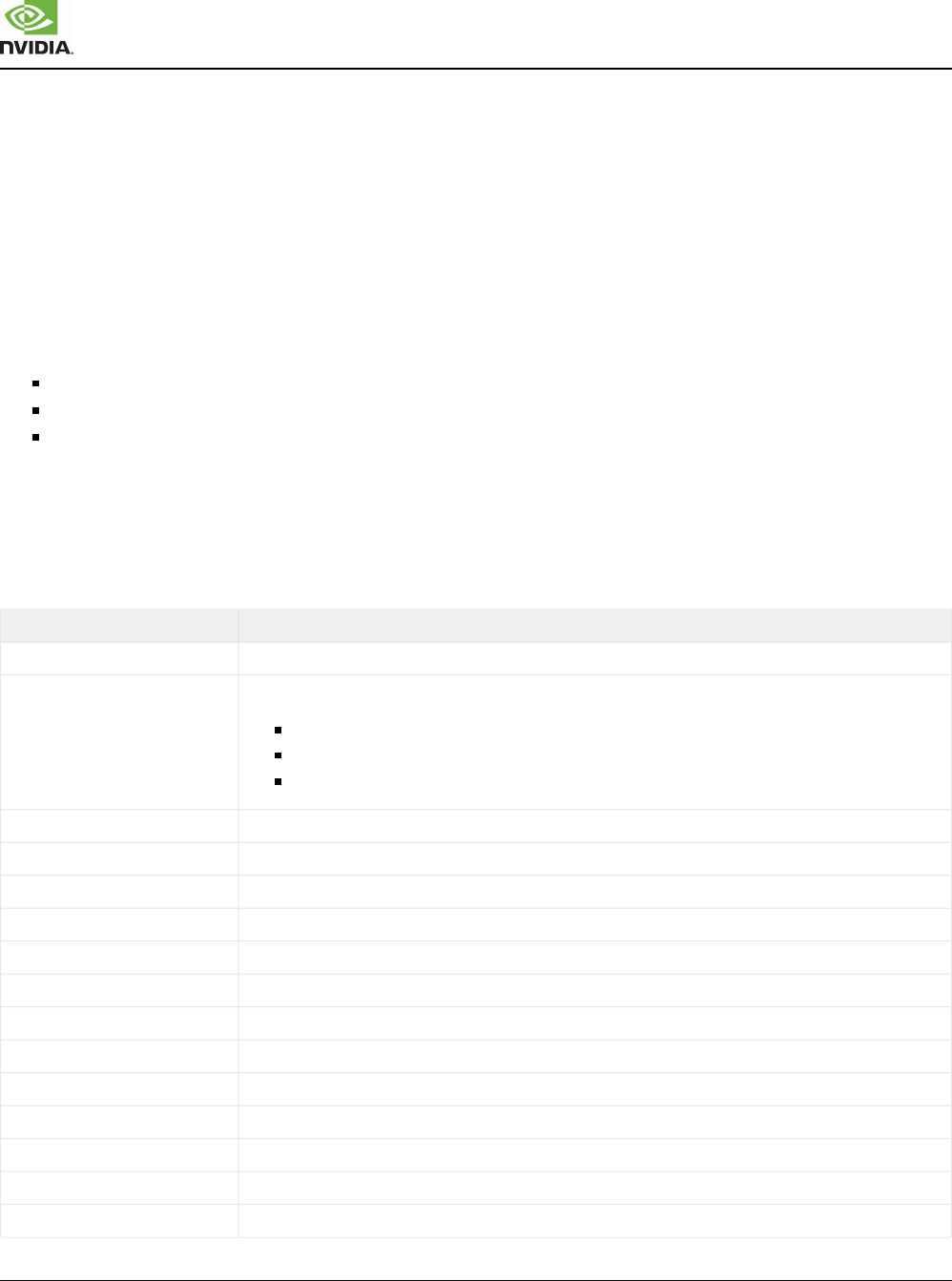
Xavier Series SoC Technical Reference Manual
XAVIER | TRM | DP-09253-002_v1.1 | SUBJECT TO CHANGE | www.nvidia.com Page of 5904 8287
All time-keeping modules can be configured to stop during debug. This is useful to suspend the operation of
WDT (to avoid resetting the chip) and the CCPLEX GT (suspending the OS tick). The only exception is the
safety reference counter in RTC.
Conventions of Units
This TRM chapter follows the IEEE and NIST conventions for multiplying prefixes.
Among other things, this convention uses an 'i' to indicate the binary convention, and its absence to indicate
decimal. So, 1 KiB is 2 or 1,024 bytes, and 1 KB is 10 or 1,000 bytes. Similarly it uses:
10 3
Mi for 2 and M for 10
20 6
Gi for 2 and G for 10
30 9
Ti for 2 and T for 10
40 12
Glossary and Acronyms
Note that different names may end up in the same acronym when the entire Xavier TRM is put in perspective.
The acronyms listed here are within the context of the Timers chapter.
Term Definition
AO Always On
ARM Processor Complex ARM processor core itself plus some closely associated peripherals, including
CCPLEX, the main CPU complex of eight Carmel cores
Multiple Cortex-R5 clusters
The Cortex-A9 ADSP inside APE
AVIC ARM Vectored Interrupt Controller
GT Generic Timer
GTE Generic Timestamping Engine
LFSR Linear Feedback Shift Register
LIC Legacy Interrupt Controller
LNCO Lockable NCO
MTSC Master TSC
NCO Numerically Controlled Oscillator
OSC Oscillator
PCR Present Count value Register
PTV Present Trigger Value, the value loaded at start into an NV timer
RTC Real-Time Clock
SMP Symmetrical Multi-Processing
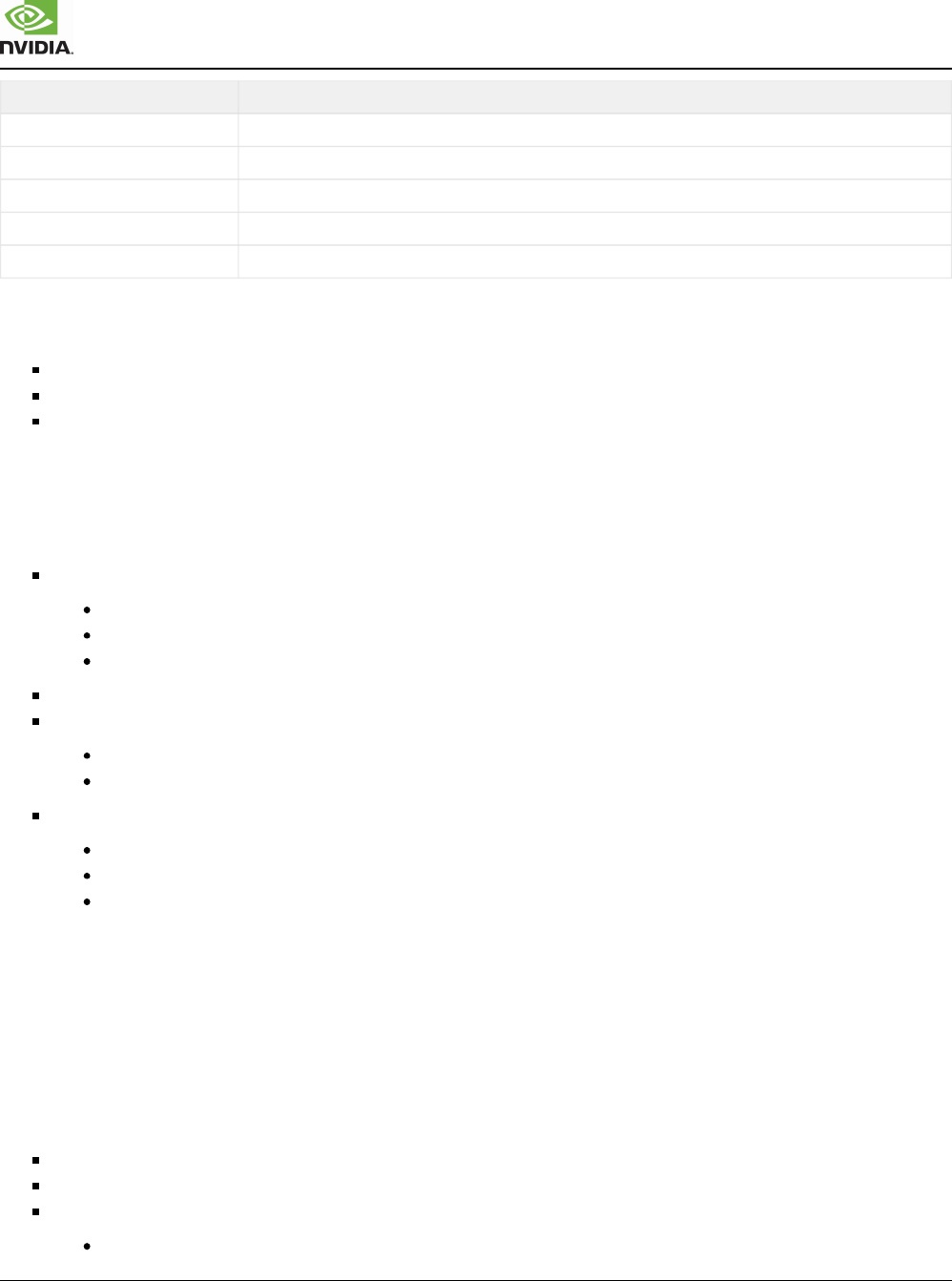
Xavier Series SoC Technical Reference Manual
XAVIER | TRM | DP-09253-002_v1.1 | SUBJECT TO CHANGE | www.nvidia.com Page of 5905 8287
Term Definition
SPE Sensor Processing Engine
TKE Time-Keeping Element, the module instantiating NV timers and WDTs
TMR TMR refers to NV timers
TSC Timer’s System Counter, also known as TimeStamp Counter
WDT WatchDog Timer
Relevant Chapters in the TRM
Address Map
Clock Controller and Reset (CAR)
Hardware Safety Manager (HSM)
Address Map
The address spaces (in 64 KiB pages) assigned to the different timers modules are as follows:
Each TKE
One page for shared registers
One page per NV Timer, nT of them where nT is a configuration parameter
One page per WDT, nW of them where nW is a configuration parameter
Each GTE requires one page
The RTC requires two pages:
One page for the RTC proper
One page for the AOWDT
The TSC requires four pages total
One page for each of the two ARM specified frames
One page for the TSC implementation registers
One page for the microsecond (µs) counter
Clocks
The TSC RefClk (aka tsc_ref_clk) is specific to timers and generated inside CAR using dedicated circuitry. The
base logic is a fractional divider, but with an additional adjust signal to allow for fine control of the generated
frequency. The fractional divider is part of CAR with the adjust signal coming from TSC.
TKE uses the following clocks:
APB clock
TSC RefClk, used for the TSC input and for general operation
TKE also uses one of these two clocks
OSC for the TKE instance inside the Always On partition
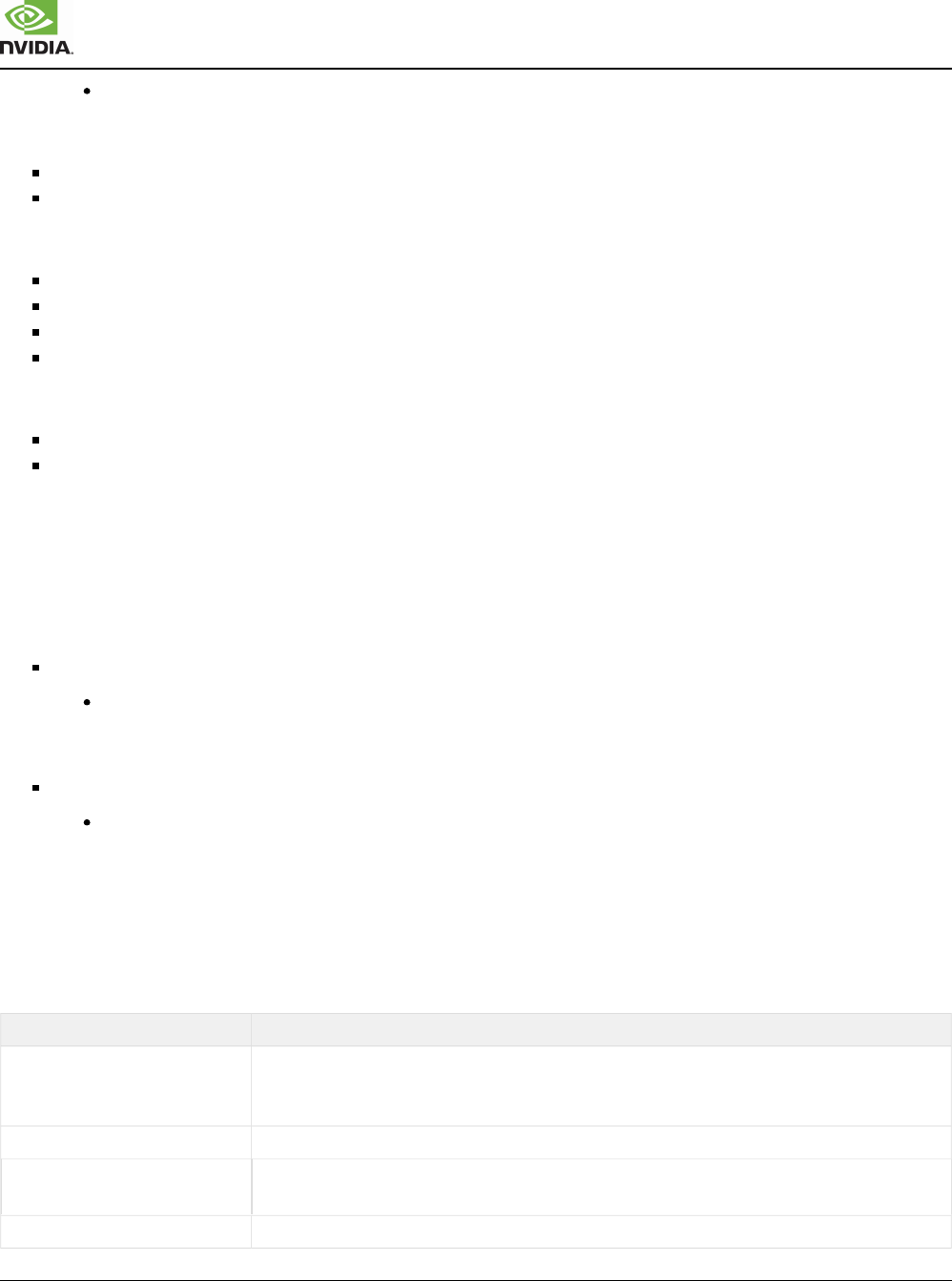
Xavier Series SoC Technical Reference Manual
XAVIER | TRM | DP-09253-002_v1.1 | SUBJECT TO CHANGE | www.nvidia.com Page of 5906 8287
clk_m for all other TKE instances
RTC uses the following clocks:
APB clock
The 32,768 Hz reference clock
TSC uses the following clocks:
APB clock
The 32,768 Hz reference clock
TSC RefClk
OSC clock (for the microsecond and reference pulse generation)
GTE uses the following clocks:
APB clock
TSC RefClk
Resets
Most modules have an associated software reset control in CAR.
The following time-related modules do not have a software reset:
TSC and RTC
As they maintain the notion of secure time and may be used to generate corresponding secure interrupts, their
operations should not be impeded by non-secure software. This requirement applies to the microsecond
counter (USEC) inside TSC as well.
TOP TKE
TOP TKE can also be used to expose secure time, so has no software reset. Other TKEs, however, still have
software resets.
The TSC terminal nodes are always associated with a logic block that consumes the TSC value. The TSC
terminal node may share their reset with other logic block it is tightly coupled with. The following table
summarizes the TSC terminal nodes and their reset logic.
Table 8.15 Terminal Nodes Reset Logic
Terminal node Reset logic
In AON (used for AON TKE) By software reset, CLK_RST_CONTROLLER_RST_DEV_TSCTNAON;
must be enabled by software at boot time for cold boot.
Disabled and restarted by software when terminal node is power gated.
ADSP and ADMA TSC in APE On same reset as ADSP and ADMA, no special action needed.
BPMP, SCE and RCE By software reset, CLK_RST_CONTROLLER_RST_DEV_TSCTN<BPMP, SCE, RCE>;
must be enabled by software during respectively BPMP, SCE and RCE startup sequence.
GPU On same reset as GPU, no special action needed.

Xavier Series SoC Technical Reference Manual
XAVIER | TRM | DP-09253-002_v1.1 | SUBJECT TO CHANGE | www.nvidia.com Page of 5907 8287
Terminal node Reset logic
CCPLEX On ROC reset, no special action needed.
Backbone (top TKE and GTE) On system reset, no special action needed.
Coresight and iLA On same reset as Coresight and iLA, no special action needed.
VI By software reset, CLK_RST_CONTROLLER_RST_DEV_TSCTNVI;
must be enabled by software during VI startup sequence.
PVA{0,1} By software reset, CLK_RST_CONTROLLER_RST_DEV_PVA<0,1>_TSCTN;
must be enabled by software during PVA startup sequence.
Falcon On same reset as falcon, no special action needed.
8.3.2 Functional Description
In Xavier, the common reference for all timers is a frequency corrected version of the 32,768 Hz input clock.
When operated in locked mode, the timers operate as a hierarchy shown below. When locking is not enabled,
the different timers operate independently.
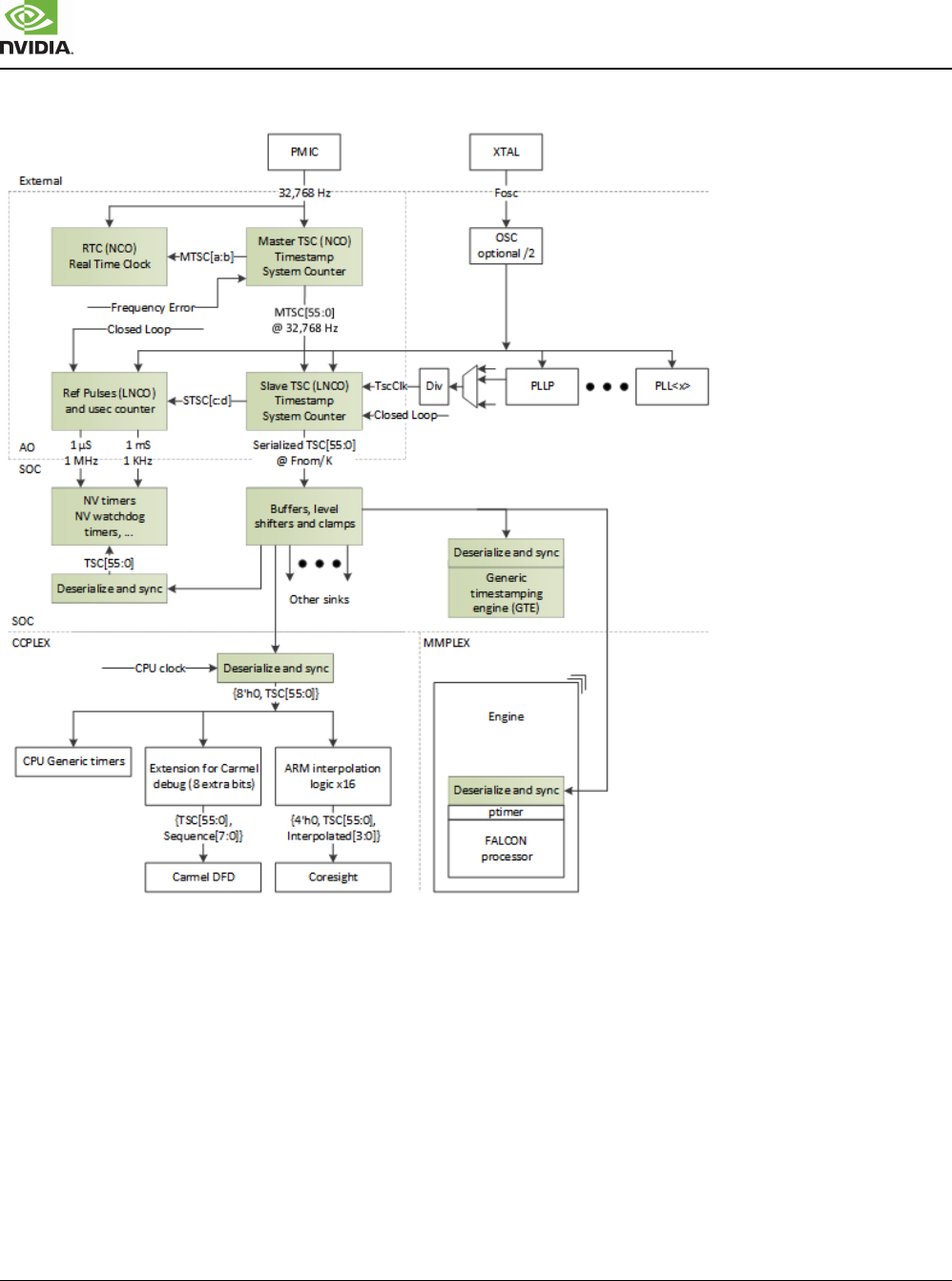
Xavier Series SoC Technical Reference Manual
XAVIER | TRM | DP-09253-002_v1.1 | SUBJECT TO CHANGE | www.nvidia.com Page of 5908 8287
Figure 8.8 Timer Hierarchy
All Time-Keeping Elements (TKEs) in Xavier can be traced to the OSC or 32,768 Hz clocks. All TKEs, except
TSC, can optionally take TSC as their timing reference to ensure a universal timebase. This, however, is not a
mandatory mode of operation (see figure above).
Locking the reference happens via a Numerically Controlled Oscillator (NCO), i.e., a phase accumulator. An
NCO can be coupled with a very simple loop filter to lock its frequency to a reference (i.e., as very simple DPLL,
denoted LNCO for lockable NCO in this document).
Hierarchical Grouping
For ease of use, some TKE's are provided in a packaged module called Time-Keeping Element ( ) TKE
centered around the NV timers.
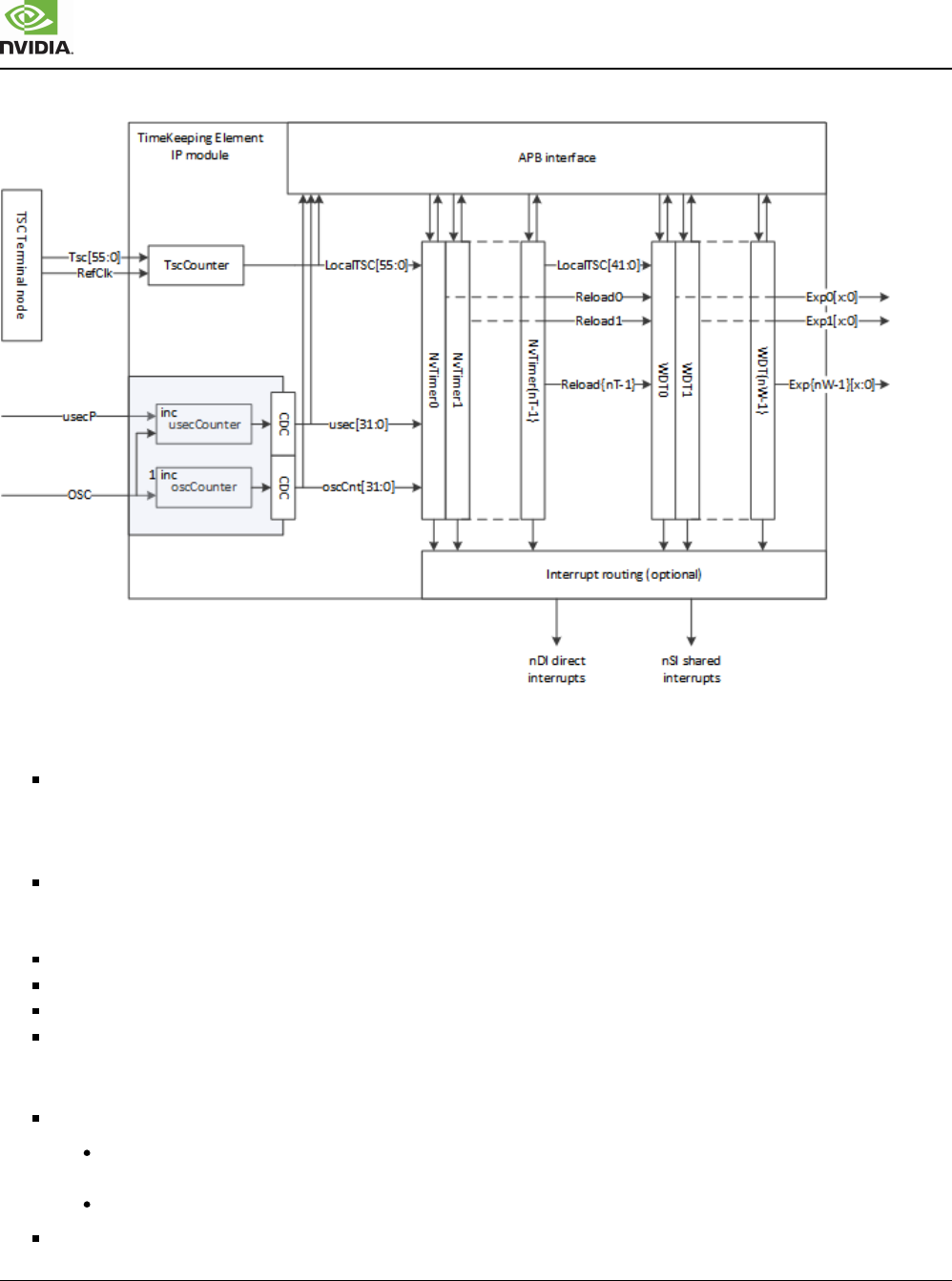
Xavier Series SoC Technical Reference Manual
XAVIER | TRM | DP-09253-002_v1.1 | SUBJECT TO CHANGE | www.nvidia.com Page of 5909 8287
Figure 8.9 Timekeeping Element IP Module
A TKE contains the following elements:
A TSC value synchronized to the TKE clock. The TSC value is used both for the operation of the timers inside the
TKE and exposed in software readable registers (providing a low-latency path for TSC access by a local processor).
The TSC value comes in parallel format, normally from a TSC terminal node. The terminal node could be used by
other blocks and is not instantiated inside the TKE itself.
Local microsecond and OSC counters, also synchronized to the TKE clock. These counters are used for the
operation of the timers and exposed in software readable registers. Contrary to the TSC, the microsecond and OSC
counters in different TKE modules are not aligned to a common master via hardware mechanisms.
A programmable number of NV timers, nT, at maximum 16.
A programmable number of watchdog timers, nW, at maximum 4.
An optional interrupt routing block, with nSI shared interrupts
An APB interface
A TKE module exposes as outputs:
A set of interrupts
The complete set of raw interrupts are always present. But only a smaller number, nDI, may be connected to
an interrupt controller
A set of aggregated and routed interrupts when the interrupt routing block is present
A set of WDT reset request interface signals, connected only when required.
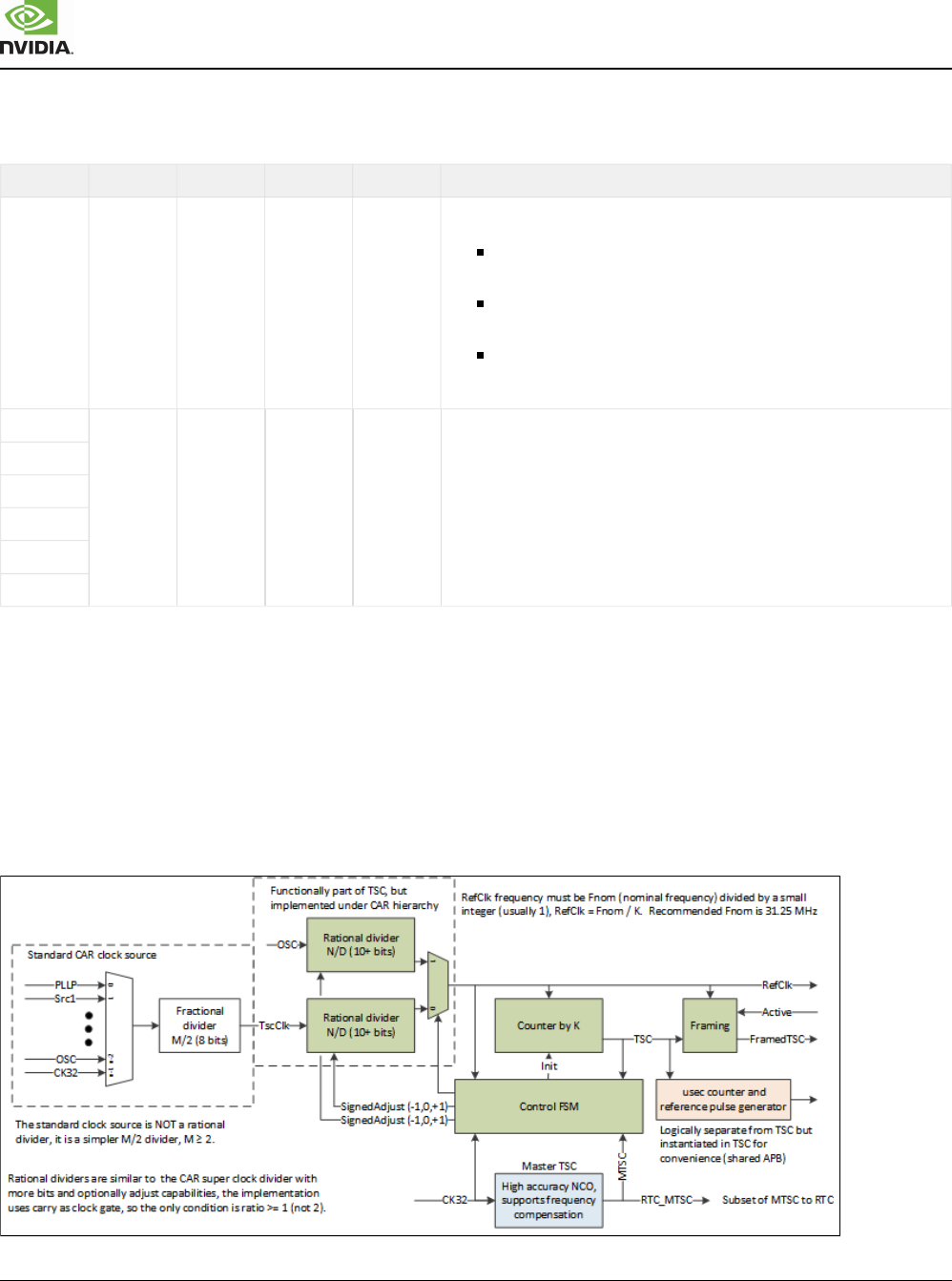
Xavier Series SoC Technical Reference Manual
XAVIER | TRM | DP-09253-002_v1.1 | SUBJECT TO CHANGE | www.nvidia.com Page of 5910 8287
The next table shows the characteristics of the different TKE instances.
Table 8.16 TKE Instances
Module nT nW nDI nSI Remark
Top 10 3 14 10 System-level use cases, direct interrupts are from the WDTs only
WDT0 directly connected to CCPLEX (IRQ/FIQ), system
WDT
WDT1 used as redundant to WDT0 or for software-
defined use, IRQ/FIQ not connected
WDT2 being the APE WDT for legacy reasons, IRQ/FIQ
not connected
SPE
4 1 7 0 Local timekeeping, direct interrupts connected to local interrupt
controller except remote WDT interrupt.
SCE
BPMP
APE
PVA
RCE
Care must be taken to make sure that the SPE instance can still operate correctly when VDD_CORE is off and
OSC is present, possibly only for a subset of internal configurations. All instances of TKE, including SPE, do not
operate correctly when the OSC is off and only the 32,768 Hz clock is active.
TSC
The TSC logic operates in the AO domain for expediency.
Figure 8.10 TSC Generation
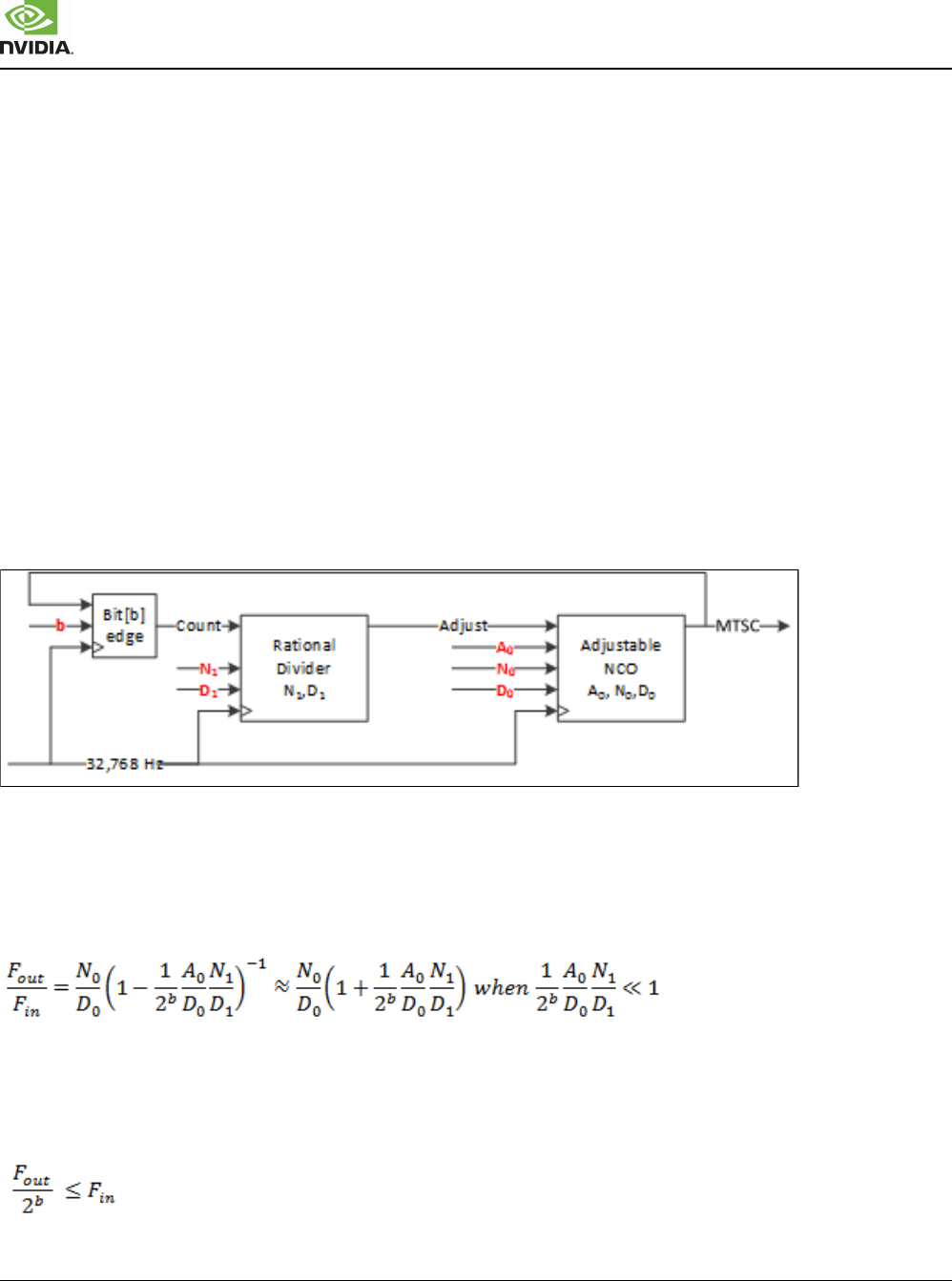
Xavier Series SoC Technical Reference Manual
XAVIER | TRM | DP-09253-002_v1.1 | SUBJECT TO CHANGE | www.nvidia.com Page of 5911 8287
A subset of MTSC is sent to RTC, allowing RTC to be optionally locked in frequency with TSC.
For convenience, the microsecond counter with associated reference pulses generation (see TKE Module,
) is instantiated inside the TSC logic, to share the same APB Including NVIDIA Timers and Watchdog Timers
interface.
Master TSC Generation
The master TSC is a high accuracy NCO operating on the 32,768 Hz clock. It supports frequency error
correction by allowing the master TSC operation to track an accurate external reference if wanted. As the
external reference is not hardware visible at the master TSC boundary, the tracking loop needs to be done in
software.
To support a very fine granularity for the frequency error correction, the master TSC uses a programmable bit of
the MTSC as the count enable for the rational divider controlling the adjust signal, this is equivalent to scaling
the divider by powers of 2.
Figure 8.11 Master TSC Generation
The master TSC's nominal frequency is programmable. The recommended value is 31.25 MHz so that the
period (32 nS) is a power of 2.
The MTSC nominal frequency is given by the formula below
The selected bit of MTSC must be correctly sampled (no frequency aliasing), bit[b] of MTSC can be interpreted
as a square wave with frequency ( / 2 ) sampled by the 32,768 Hz clock. Correct detection of the edges
F
out
b+1
require the sampling frequency to be at least twice the frequency of the sampled square wave, so:
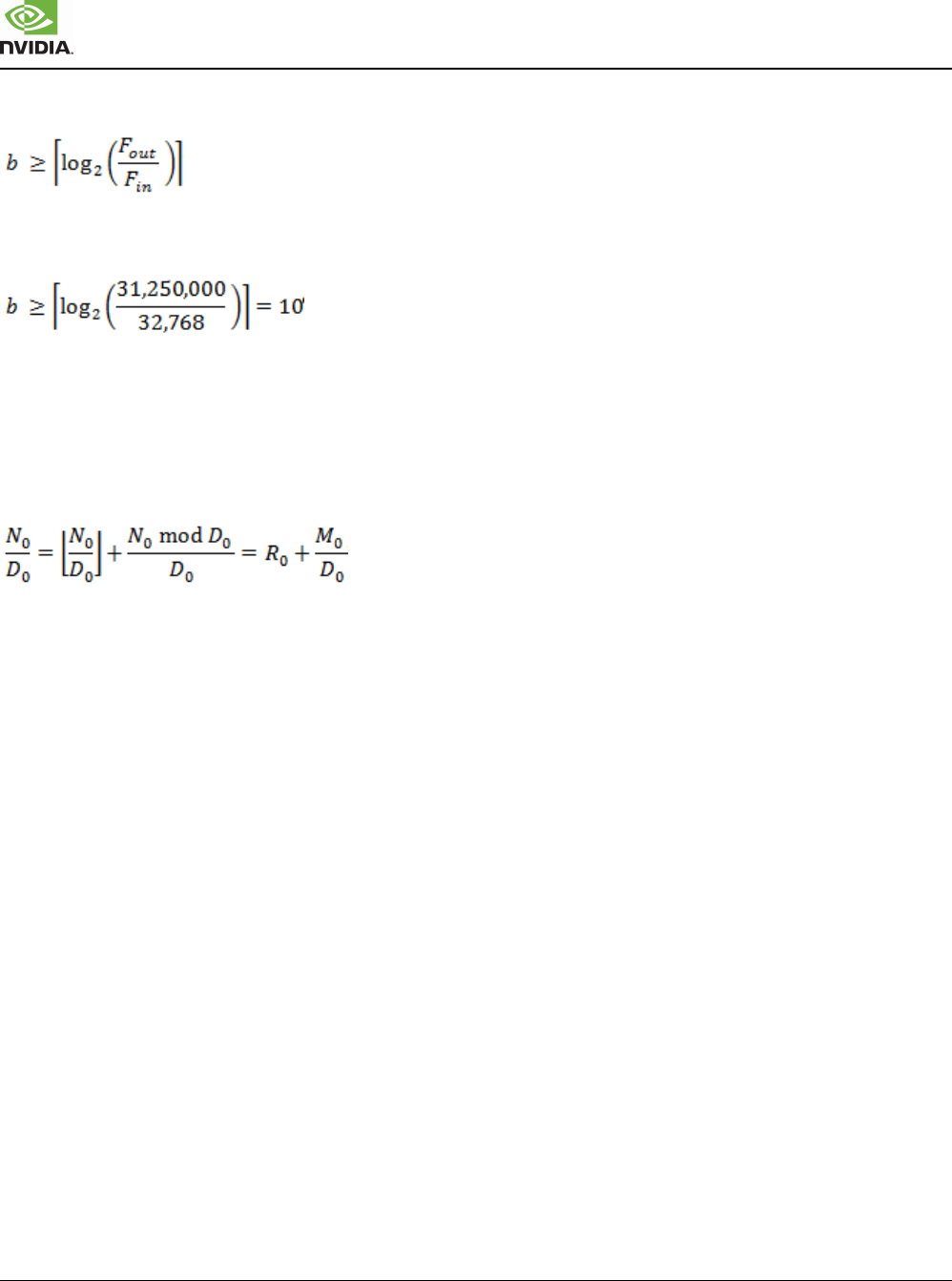
Xavier Series SoC Technical Reference Manual
XAVIER | TRM | DP-09253-002_v1.1 | SUBJECT TO CHANGE | www.nvidia.com Page of 5912 8287
This can be solved for the value of b:
Using the recommended target frequency of 31.25 MHz and the 32,768 Hz input clock frequency gives:
The supported range for b is [9,16].
The width of the parameters of the adjustable rational divider with some extra margin, giving 24 bits for N and
0
12 bits for D , but the exact structure of the NCO needs to take into account the fact that the ratio is larger than
0
1. The corresponding structure splits the ratio into an integer and fractional part, that is:
The hardware directly uses R , D and M , with software responsible to calculate their correct value.
0 0 0
The corresponding structure of the NCO is shown below, including the adjust capability, with a total of four
software controlled parameters. The implementation further restricts A to be +1 or -1, A is the direction of the
0 0
frequency correction while the magnitude of the correction is controlled by the parameters of the rational divider
controlling the adjust frequency: N , D and b.
1 1
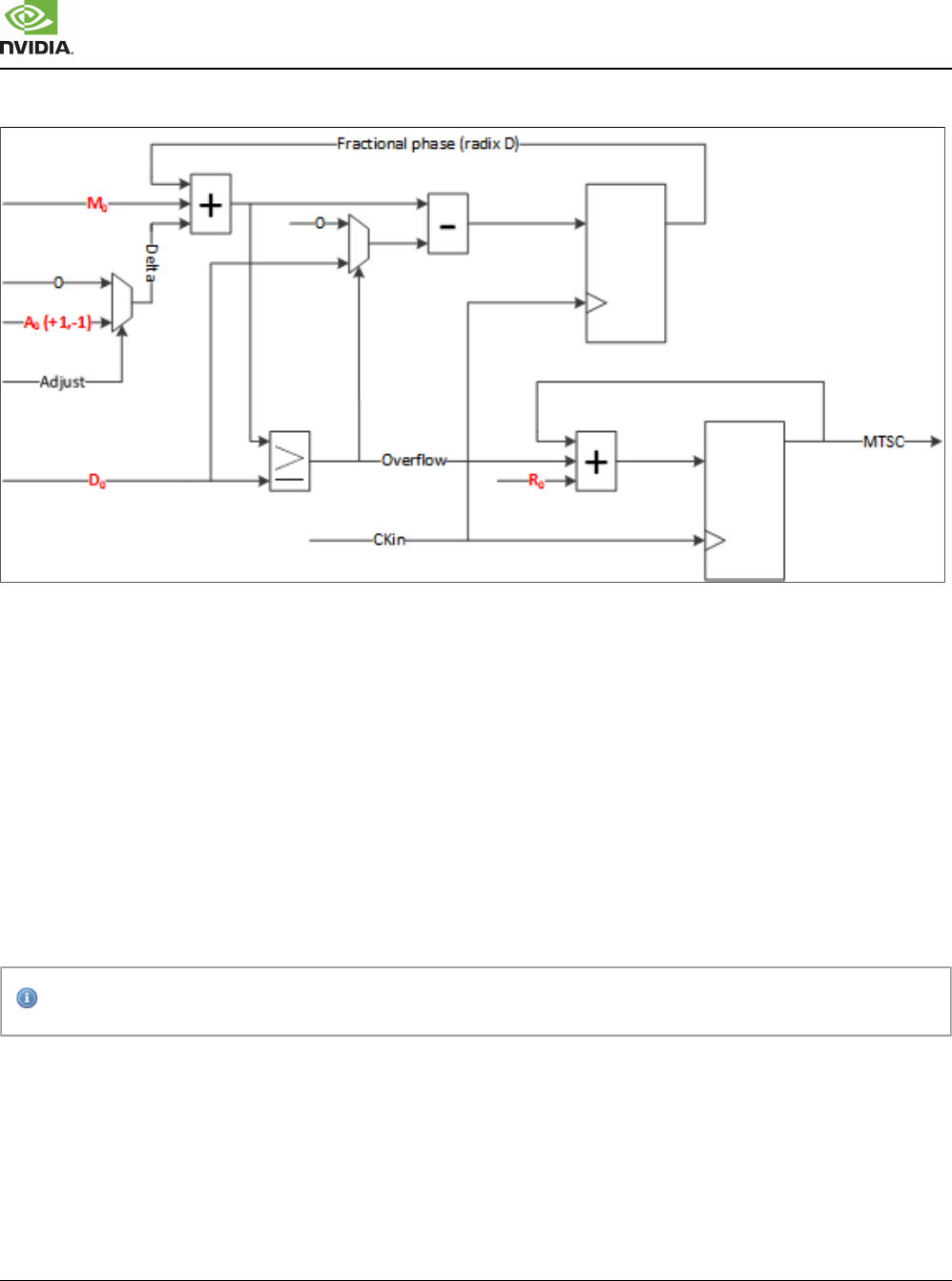
Xavier Series SoC Technical Reference Manual
XAVIER | TRM | DP-09253-002_v1.1 | SUBJECT TO CHANGE | www.nvidia.com Page of 5913 8287
Figure 8.12 NCO Structure for MTSC Generation
Slave TSC
In Xavier, only OSC at 38.4 MHz with K = 1 is supported.
The slave TSC is essentially a rational divider with adjust capabilities followed by a counter. In the normal
operation, the counter simply increments by one for each rising edge of the divided clock, similar to previous
chips, but can count by K instead to support low power modes where PLLs are stopped and only OSC is
available and operates at a frequency below the nominal TSC update frequency.
The slave TSC always takes its initial value from the master TSC and can optionally be dynamically locked on
it, this is achieved by adjusting the rational divider based on the deviation between the master and slave TSC
values.
Note that this function is not supported and must be disabled.
TSC Distribution Logic
The TSC distribution logic operates by replicating the TSC value at terminal nodes. This is achieved by
broadcasting both RefClk and serialized synchronization messages to all terminal nodes, plus a Halt indication
used to stop TSC during debug. This is transparent to software except for the need to enable the distribution
function.

Xavier Series SoC Technical Reference Manual
XAVIER | TRM | DP-09253-002_v1.1 | SUBJECT TO CHANGE | www.nvidia.com Page of 5914 8287
Generic Timestamping Engine
The generic timestamping engine (GTE) is an IP block that can be instantiated where timestamping is
performed by hardware instead of software. GTEs across the chip snoop a subset of signals:
Interrupts, either close to LIC or close to AVIC inside a Cortex-R5 processor complex
GPIO signals, especially for the sensor signals used by the SPE
The generic timestamping engine snoops a configurable set of signals, timestamps any change on them and
presents the timestamped events to software via FIFOs and an APB interface. Specific care is taken to make
the timestamping engine secure, i.e., to avoid security attacks through the use of timestamping.
The generic timestamping engine is built from a configurable number (nTS) of timestamping slices, each slice
built from a configurable number (nC) of capture slices, each capture slice able to snoop up to 32 signals, and
an arbitration stage when there are more than one capture slice per timestamping slice. Each timestamping
slice is normally associated with a different master in the SoC in particular, to provide differentiated security. All
timestamping slices share a common APB interface.
The capture slice continuously monitors the set of enabled and not disabled inputs, if the current value is
different from the last captured value and there is place in the capture FIFO:
The captured value is updated to be the current value
The current and last captured value is placed in the FIFO together with the slice ID and enough LSB of the TSC to
allow a correct disambiguation of the timestamp later on.
If multiple capture slices are present, an arbitration stage merges the different capture slices into a common
output FIFO.
Each output slice then presents the timestamping records to software via a set of access registers. Each
timestamping slice has its own set of access registers to allow for differentiated security, but all timestamping
slices share a common APB interface. Each timestamping slice can also generate an interrupt based on the
FIFO occupancy; that interrupt may or not be connected to an interrupt controller.
The access registers can present the capture records either in raw form or as a set of individual bit changes.
Encoded Form for Captured Information
The raw information contains the current and previously captured value of the signals in the slice as a bitmap.
Encoding transforms that into a sequence of changes. This is done by:
XORing the previous and current values to calculate a change bitmap
Iterating a procedure that:
Finds the lowest index of a bit at 1 in the change bitmap, providing the index and the value of the bit in a
register, plus the slice number.
Clears the corresponding bit from the change bit map until the change bitmap is zero.

Xavier Series SoC Technical Reference Manual
XAVIER | TRM | DP-09253-002_v1.1 | SUBJECT TO CHANGE | www.nvidia.com Page of 5915 8287
The index provides the full information about the signal captured; the register fields are defined so that the
combination (slice number, bit index) gives the interrupt number.
General Structure of GTE
The general structure of the GTE is shown in the figure below.
Figure 8.13 Generic Timestamping Engine
There are multiple instances of the GTE. Each instance has a width defined by a number of 32-bit slices (nS).
Some instances are paired to support multiple levels of security.
Table 8.17 GTE Instances
Module Paired nS Remark
LIC Yes TBD A pair of GTE for interrupt timestamping between LIC and GIC. Note that local GIC interrupts
are not timestamped.
BPMP No
2 Timestamping the local interrupts, i.e., the inputs to the AVIC.
SCE No
PVA No
RCE No
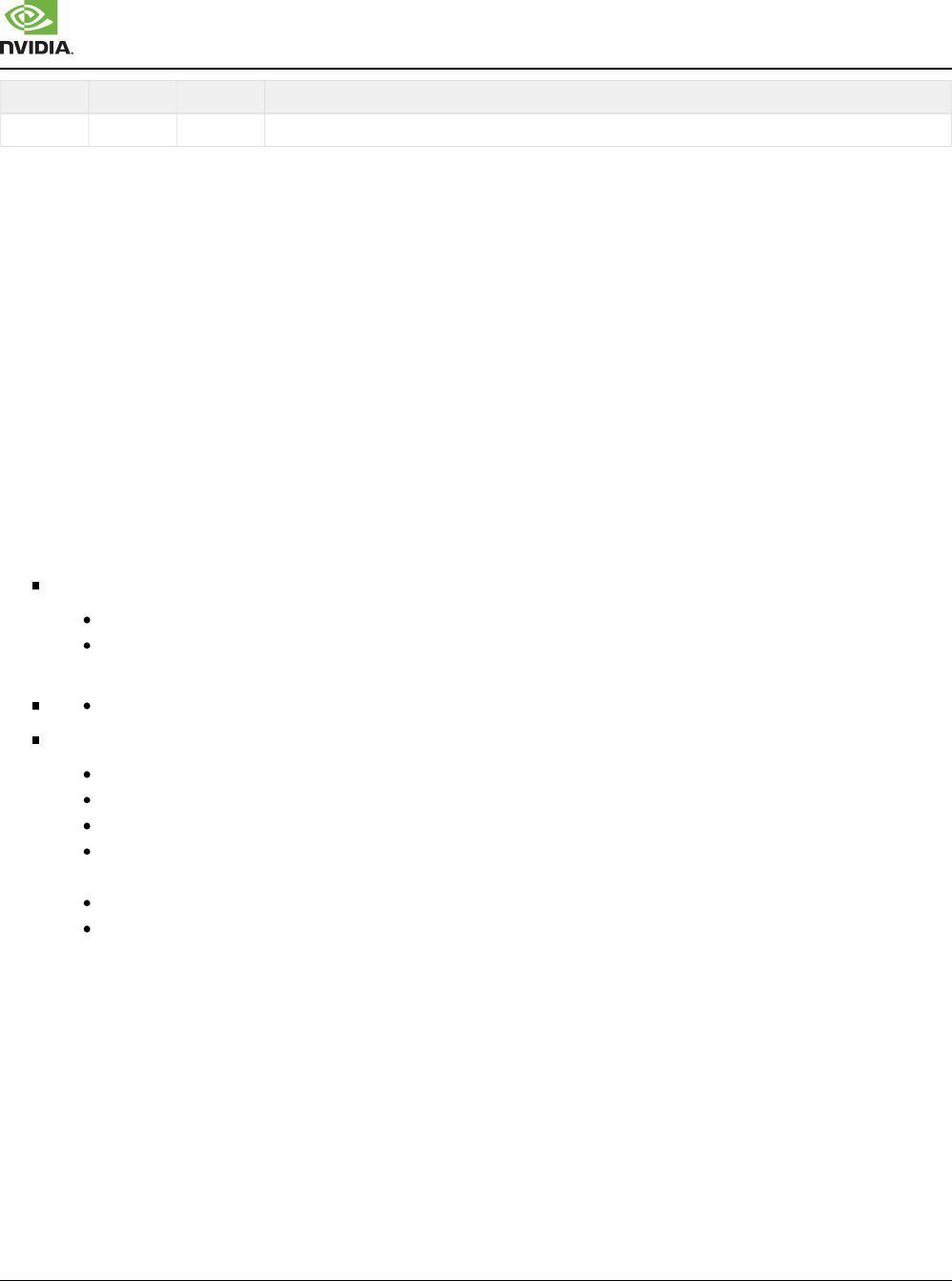
Xavier Series SoC Technical Reference Manual
XAVIER | TRM | DP-09253-002_v1.1 | SUBJECT TO CHANGE | www.nvidia.com Page of 5916 8287
Module Paired nS Remark
SPE No 3 Timestamping the local interrupts, i.e., the inputs to the VIC, plus a small subset of GPIOs.
RefClk Source Change Logic
The recommended usage model is to always use OSC (at 38.4 MHz) and with K=1 always.
Power Management
The TSC logic is not power gated but implements clock gating. Note that as it provides an SoC-wide timing
reference, TSC is normally always enabled.
s The slave TSC and TSC distribution logic can not work when the OSC is disabled, as RefClk i not available
then. OSC is disabled in some of the deep sleep states, with only 32,768 Hz present. This is true for some
variants of SC7. The transitions to and from the deep sleep states that disable the OSC circuitry are controlled
by the PMC logic. The PMC logic handshakes with TSC, to allow for a clean shutdown and restart of the slave
TSC as well as TSC distribution in case OSC is stopped in the target power state.
Entering a deep sleep mode where OSC is to be stopped
PMC asserts a deep sleep request signal while OSC and RefClk are still running
TSC stops the slave TSC and the distribution logic, then assert a deep sleep status signal to PMC
Stopping is logically equivalent to disabling these blocks via the software control bits
PMC can now stop OSC and indirectly stops RefClk
Exiting a deep sleep mode where OSC already stopped
PMC restarts OSC and indirectly restarts RefClk, and waits until OSC is stable
PMC deasserts the deep sleep request signal
TSC restarts the slave TSC and the TSC distribution logic if their respective software enable bits is set
Restarting the slave TSC requires an initialization, the master TSC value is copied to the slave TSC counter at
the next edge of the 32,768 Hz clock
Restarting the TSC distribution preferably includes sending a synchronization message as soon as possible
TSC deasserts the deep sleep status signal to PMC
The whole sequence is similar to the sequence used for ARM processors. The handshake must also work even
when TSC itself is disabled, to avoid blocking the forward progress of the PMC state machine. This may require
providing a non-gateable clock to the handshake logic.
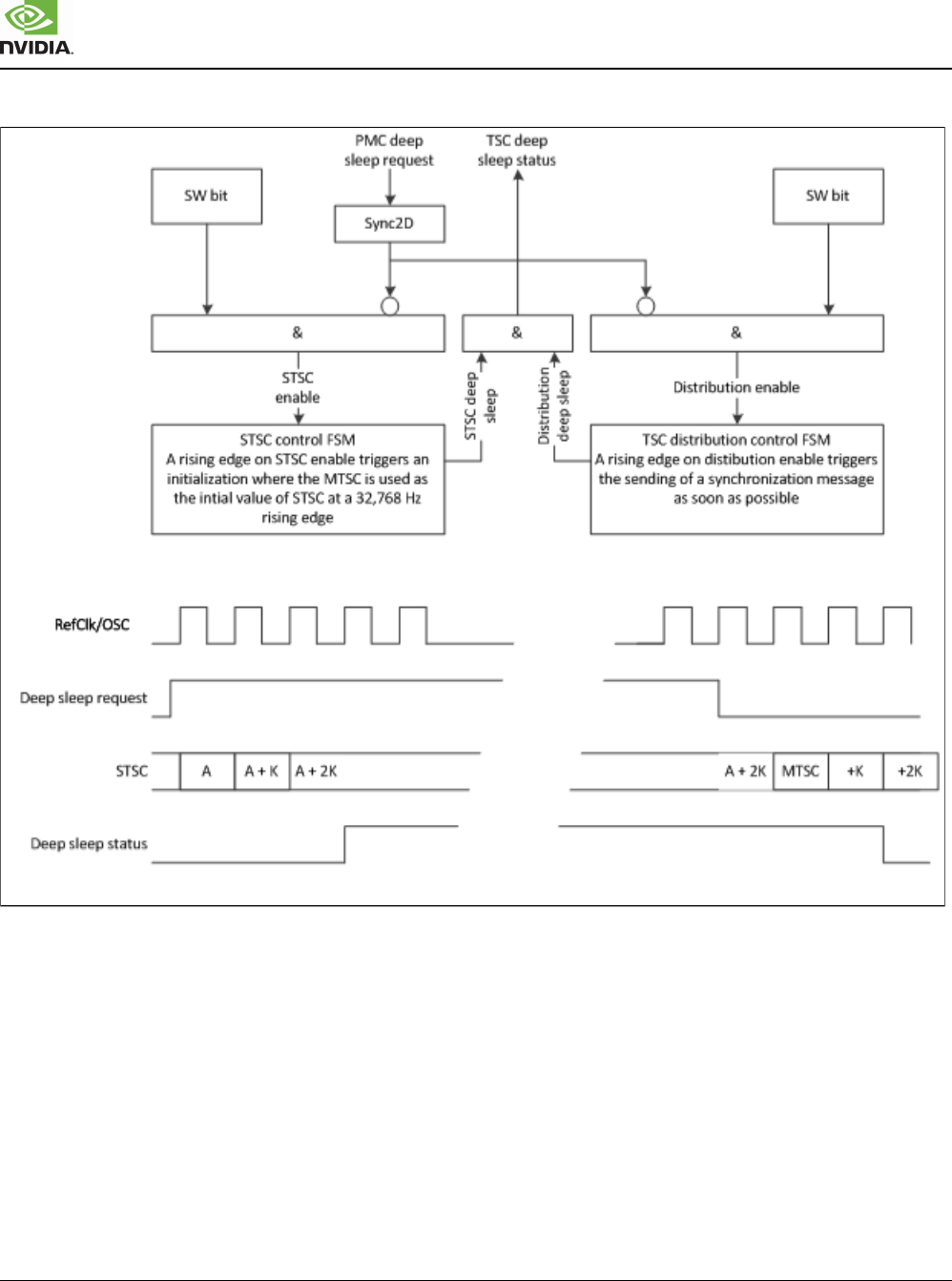
Xavier Series SoC Technical Reference Manual
XAVIER | TRM | DP-09253-002_v1.1 | SUBJECT TO CHANGE | www.nvidia.com Page of 5917 8287
Figure 8.14 Deep Sleep Handshake with PMC
Real Time Clock
The internal RTC (or simply RTC) is a real-time clock in the AO partition that measures elapsed time since the
last cold boot, and is not affected by SC7 entry/exit transitions. Note that the PMIC also generally provides an
external RTC with better robustness (not affected by the cold boot of Xavier).
The RTC accumulates real time in a mixed radix format of seconds (32 bits) and milliseconds (10 bits), it
operates on the 32,768 Hz clock and can take its reference from the 32,768 Hz clock itself or TSC.
The seconds counter can be updated by software to provide an initial offset different from zero at initialization,
and later updates sticky disabled for security.
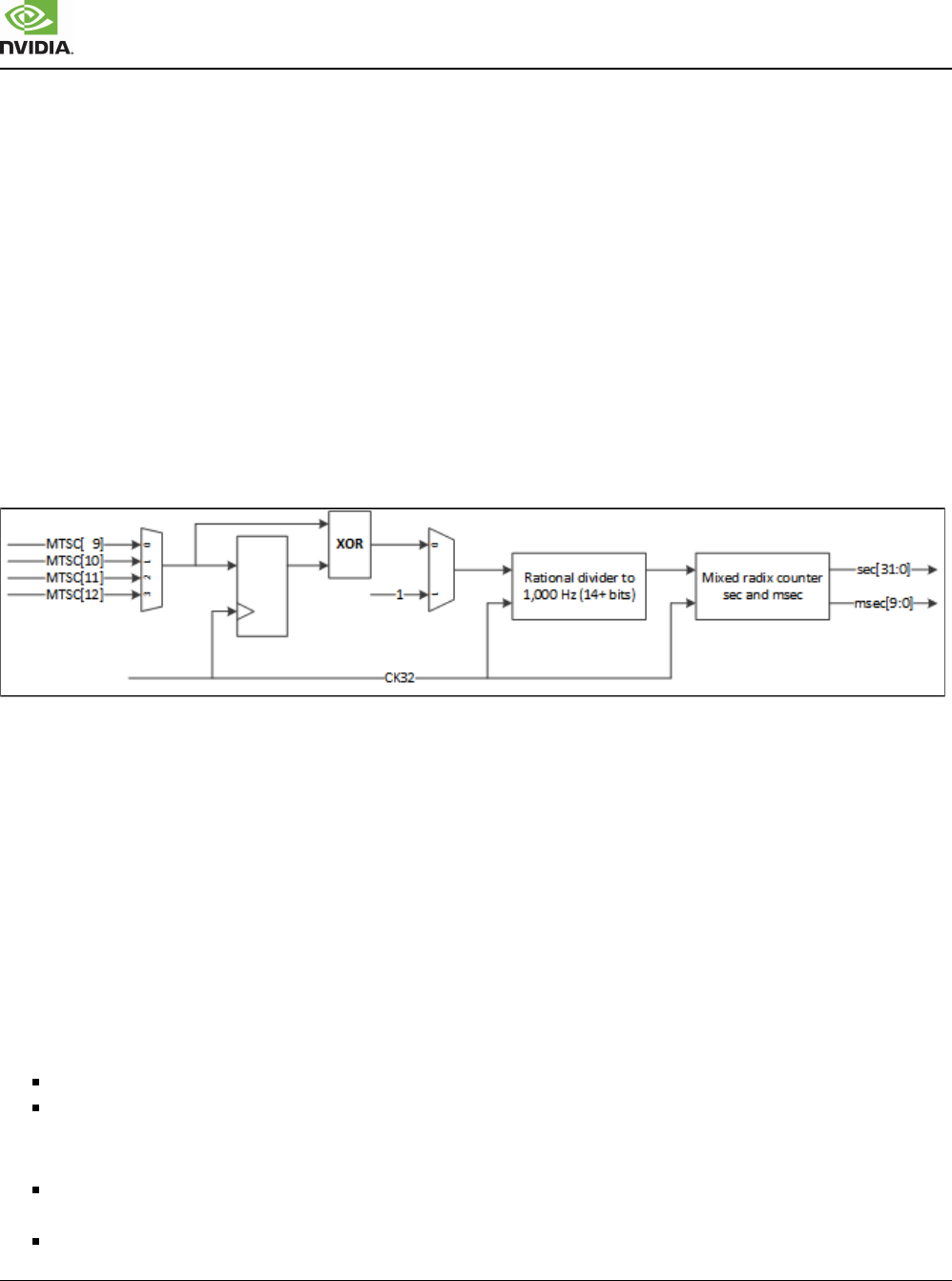
Xavier Series SoC Technical Reference Manual
XAVIER | TRM | DP-09253-002_v1.1 | SUBJECT TO CHANGE | www.nvidia.com Page of 5918 8287
The RTC provides different alarms that can be used as interrupts or SC7 wake signals. The RTC also provides
a safety reference counter, with no configuration whatsoever that can be used to check the correct operating
frequency of other TKEs.
RTC logic operates in the 32,768 Hz clock domain, and software must take into account when accessing RTC
registers. In particular, the RTC module maintains a ‘busy’ status register bit which is set (1’b1) while a register
write is being transferred. Software must not send a write when this bit is set (this requires write accesses to the
RTC to be protected by a resource semaphore if more than two agents are allowed to access the RTC) .
The RTC maintains a count of seconds and milliseconds since the last cold reset. It can select between the
32,768 Hz clock and MTSC as time base. The only difference is the first NCO stage, the rest of the logic is
independent of the selected reference.
The logic itself always operates at the 32,768 Hz clock.
Figure 8.15 RTC Generation
The RTC block also contains alarms implemented by comparison between a target value and the current RTC
value. The RTC value is exported to SPE where it is used to generate local alarms on top of the alarms
supported in RTC itself.
For safety related purposes, the RTC also provides a reference counter, always enabled, that simply
increments at each rising edge of the 32,768 Hz clock. This can be used as a safety reference to assess the
health of other timing elements. This reference counter is never halted, especially it is not stopped during debug
and has no configuration.
Always On WatchDog Timer
Xavier provides a watchdog timer (WDT) in the Always On power domain, with the following rationale:(AO)
Its operation is not dependent on OSC; it only requires the 32,768 Hz clock to be active.
The timer can be used to detect and flag SC7 related issues, such as an inability to wake up.
The AO WDT requirements are only slightly different from a standard WDT:
Opernates on the 32,768 Hz clock, so that it can operate continuously, including during power states where OSC is
OFF when WDT operation is suspended.
The actions associated with some expiration levels are redefined as wake events:
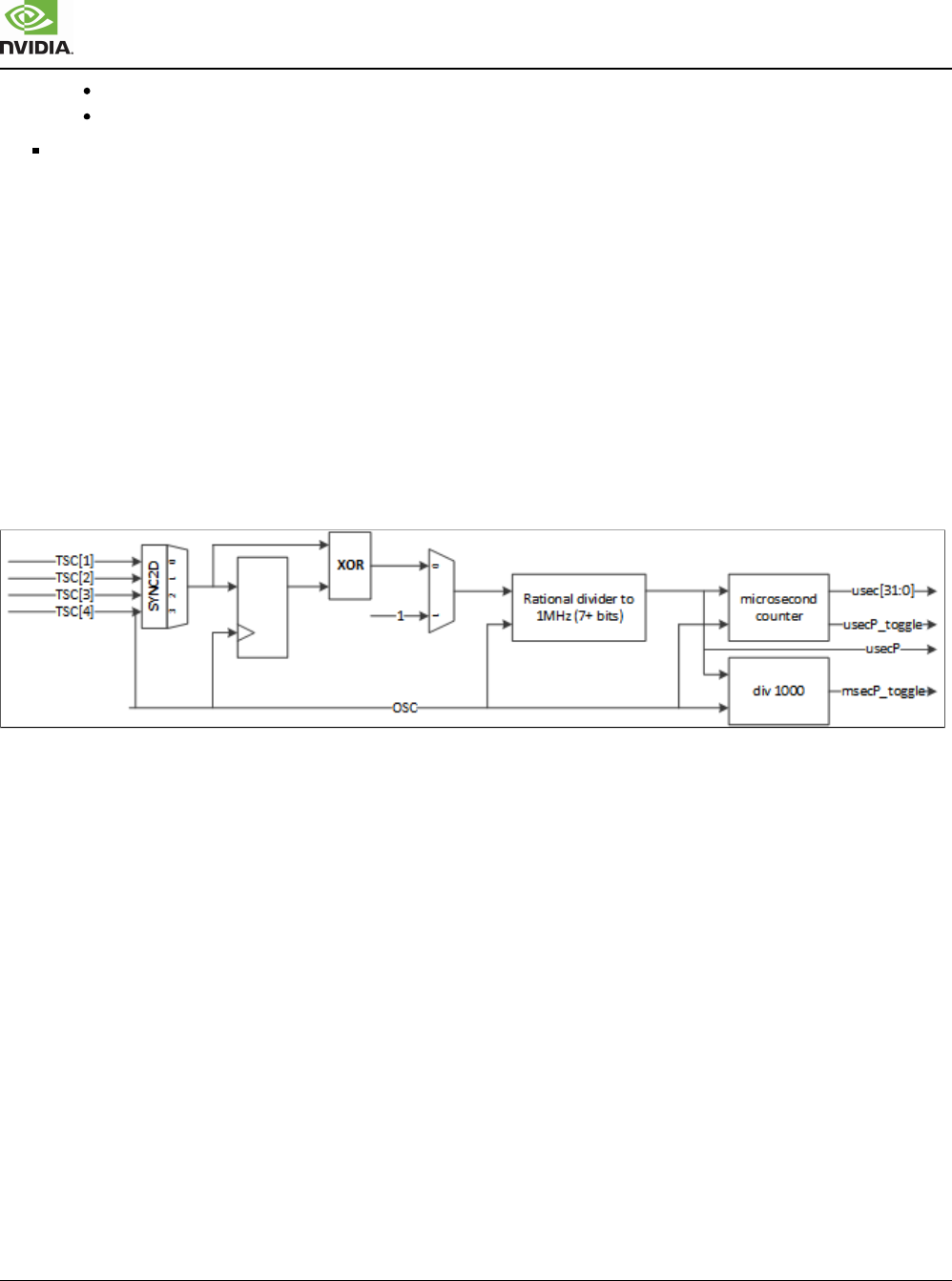
Xavier Series SoC Technical Reference Manual
XAVIER | TRM | DP-09253-002_v1.1 | SUBJECT TO CHANGE | www.nvidia.com Page of 5919 8287
Expiration level 2 asserts a standard wake signal.
Expiration level 3 asserts a wake signal that also clears the PMC scratch register info indicating warm boot.
The debug reset associated with expiration level 4, while connected, must not be used.
The AO WDT reuses the implementation of the TKE WDT, including the register interface; the only changes are
in the inputs and outputs connected to it, especially the operating clock.
Microsecond Counter and Time Reference Pulses Generation
The USEC module broadcasts periodic pulses with 1 microsecond and 1 millisecond periods, allowing time to
be measured in a platform-independent way. USEC operates on OSC to allow operation when no PLL is active.
The time base can be OSC itself or TSC, and USEC also maintains a counter of elapsed microseconds.
While USEC operates in the AO partition, it relies on OSC for its operation and so may be suspended in some
power states where RTC keeps counting, and so USEC and RTC are complementary, not redundant.
Figure 8.16 Reference Pulse Generation and Microsecond Counter
8.3.3 TKE Module
NV Timers (TMRs) and Watchdog Timers (WDTs) are instantiated as part of a TKE module. There are nT
timers and nW watchdog timers per TKE. The register interface constraints the dimensioning to a maximum of
16 timers and four watchdog timers.
Each TKE also includes registers to make different measures of time available: OSC, microsecond counter, and
TSC. This access is low latency to the local processor.
Finally, each TKE can optionally contain an interrupt routing function, this is only present for the TKE
instantiated at the top level to limit the number of top-level interrupts.
For debug purposes, the TKE operation can optionally be halted during debug. This is especially important to
suspend the operation of enabled WDTs that could otherwise reset the system while debug is in progress.
NV Timer
Each NV timer is a general-purpose timer with the following characteristics:
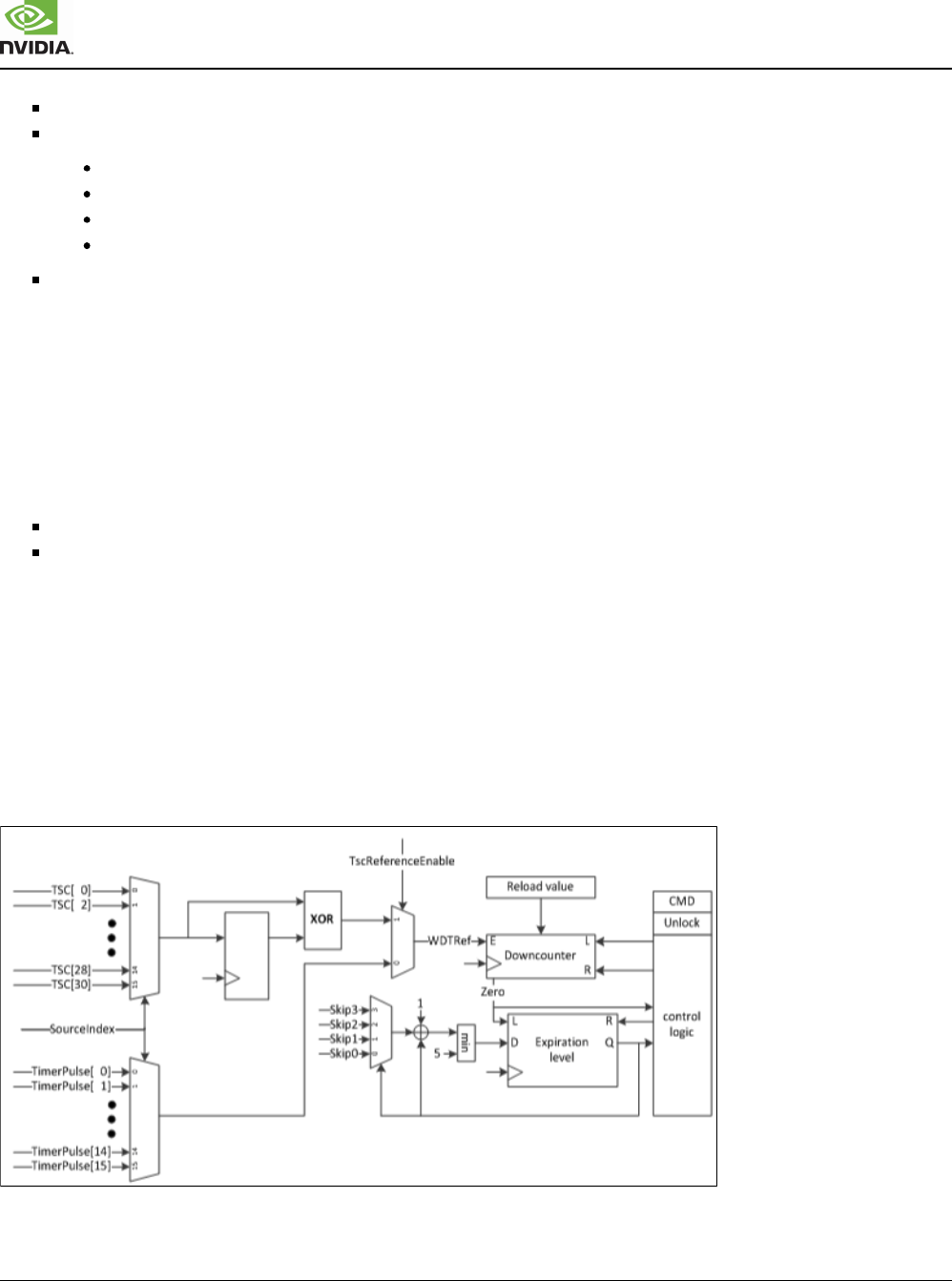
Xavier Series SoC Technical Reference Manual
XAVIER | TRM | DP-09253-002_v1.1 | SUBJECT TO CHANGE | www.nvidia.com Page of 5920 8287
Downcounter of 29 bits generating an interrupt when reaching zero
The decrement rate is on a configurable reference:
At 1 MHz, as defined by the 1 MHz reference pulse
At OSC rate
On any edge of TSC[0], so normally at the recommended 31.25 MHz TSC update rate
On any edge of TSC[12], so normally at 31.25 MHz / 4096, about 7.63 kHz
Optionally operates in periodic mode, i.e. automatically reload the start value when reaching zero
Optional Interrupt Routing
The interrupt routing block takes the set of interrupts present in the TKE and aggregates them in a configurable
fashion into nSI shared interrupts. This is only present for the top-level TKE and the shared interrupts are
hooked to the LIC in that case.
The number of (internal) interrupts inside a TKE is dependent on the number of NV timers and WDT:
Each NV timer has one associated interrupt, set when the downcounter reaches 0
Each WDT has three associated interrupts, one for each of the three first expirations of the WDT
The interrupt logic uses nSI masks, each containing (nT + 3 * nW) bits. Each mask selects which local interrupt
are included in the corresponding shared interrupt. The interrupt logic also exposes interrupt status registers to
software.
Watchdog Timer
A general view of the WDT logic is shown below.
Figure 8.17 WDT Structure
The watchdog mechanism operates in the following way:

Xavier Series SoC Technical Reference Manual
XAVIER | TRM | DP-09253-002_v1.1 | SUBJECT TO CHANGE | www.nvidia.com Page of 5921 8287
Each ARM processor complex is associated with one WDT. For the CCPLEX, all cores are in the same coherency
domain and are considered as one SMP processor for software purposes; i.e., all cores inside CCPLEX are
associated with the same WDT (WDT0 in the top TKE).
Select as reference time base either:
Any of the timer zero pulses
A transition on any bit in a defined subset of the bits of the local TSC counter
Implements a periodic downcounter decrementing at the selected rate. The downcounter generates an expiration
event when it reaches zero.
At each expiration, the WDT increases the expiration level, saturating at level 5
The increase may be larger than 1, the exact increase is configurable per expiration level
The WDT logic can assert specific output signals based on the current expiration
For the first three expiration levels, the WDT can assert a corresponding interrupt, each with a specific use:
If the expiration level is 1 or more, a normal priority interrupt (IRQ) directly routed to the associated
processor complex. This may be used to restart the timer inside an interrupt handler in non-safety
critical applications.
If the expiration level is 2 or more, a high priority interrupt (FIQ) directly routed to the associated
processor complex. This interrupt can also be made visible to other processor by using a shared
interrupt line if supported by the specific TKE. In Android, the corresponding interrupt handler assumes
the system is in a bad state and captures some state information for a potential post mortem analysis.
The interrupt handler may not attempt to correct the problem.
If the expiration level is 3 or more, a normal interrupt (IRQ) routed to the LIC and from there routed to a
set of processors, this is meant to trigger system wide actions, in particular recovery actions of the
processor associated with the WDT. This is also known as a remote interrupt.
If the expiration level transitions from a value strictly below 4 to a value above or equal to 4, the WDT can assert a
system wide debug reset. When debug is allowed, this reset can be intercepted by debug logic, and specific actions
taken to preserve information about the state of the system before reset assertion clears them, allowing for post-
mortem debug analysis. In particular, DFD logic attempts to flush the processor caches and local memories to DRAM,
save processor state, and put the DRAM in self-refresh before allowing the reset to take effect. WDT and CAR logic
uses a four phase handshake to communicate the WDT debug reset request.
If the expiration level is 5, the WDT can assert a system wide reset, equivalent to a Power On Reset, this reset can
optionally include a PMIC power cycling depending on the configuration in PMC. This is the last safety net for
recovery purposes, attempting to bring the system to a working state without any specific attempt at preserving
information.
Each WDT signals an error to the Hardware Safety Manager (HSM) when its expiration level is greater or equal than
a programmable threshold.
The watchdog timer features are disabled by default for backwards compatibility.
The counter can only be optionally restarted in defined windows of time instead of at any time
The granularity of the window mechanism in Xavier has been improved from its predecessor.
The counter can only be optionally restarted or disabled using a Challenge/Response pair (also known as Question
/Answer, QA).
The windowing operation works like this:
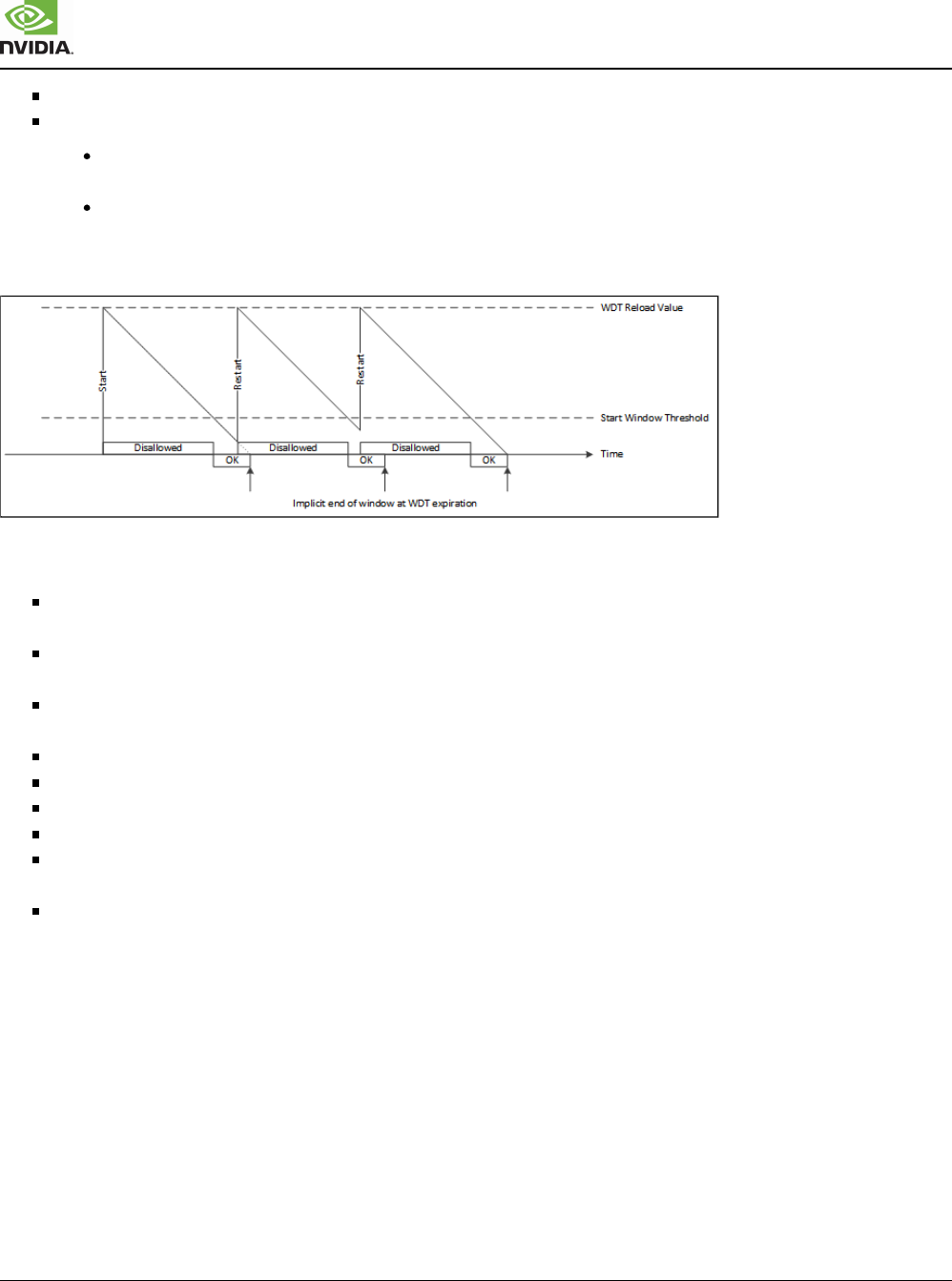
Xavier Series SoC Technical Reference Manual
XAVIER | TRM | DP-09253-002_v1.1 | SUBJECT TO CHANGE | www.nvidia.com Page of 5922 8287
Optionally enabled, normal operation is windowless and the WDT can be restarted at any time.
When enabled, a restart of the timer is disabled:
for a programmable set of expiration levels. This is achieved by disabling writes to the COMMAND register
based on a bitmap of disallowed expiration levels.
when outside an allowed window as measured by the combination of expiration level and downcounter as
shown in the figure below
Figure 8.18 Fine-Grained WDT Windowing Mechanism
The Challenge/Response works like this:
Optionally enabled, normal operation does not use Challenge/Response, unlocking is done by writing using a known
fixed pattern to the unlock register address.
When enabled, a restart is achieved only after unlocking via a Challenge/Response. This replaces the simpler unlock
mechanism used at other times to protect against disabling the counter.
The Challenge is that an LFSR value, present in the Unlock register and reading the Unlock register, is mandatory as
the implementation is allowed to use the read to alter internal state.
The Response is the next value of the LFSR that needs to be written in the Unlock register.
The LFSR is (re)initialized with the value written to the Unlock register.
Note that this is equivalent to advancing the LFSR if the unlock was successful.
0 is an allowed value that can be used for testing, the successor of 0 is 0.
The LFSR uses the classic CRC-32 polynomial operating in shift right (reversed) direction, that is to say
the next value is calculated as LFSR = (LFSR >> 1) ^ ((LFSR & 0x1) ? 0xEDB88320 : 0).
When locked, the Command register cannot be written.
An incorrect restart attempt can optionally result in an immediate jump in the expiration level. This is normally
used to immediately trigger a reset condition when the WDT is used as a safety-critical WDT.
Xavier provides a sticky enable, making it impossible to disable the WDT.
There is a watchdog timer in the Always On partition, that AO WDT is only reset by an external hardware Power
On Reset. The AO WDT has the same structure as the TKE WDTs but with different wiring of some inputs and
outputs. WDT operation may also be suspended when one or more of the TKE clocks is suspended. This can
happen for a standard WDT during some low-power states where OSC is stopped; for example, AO WDT is
specifically present to continue working during these power states.
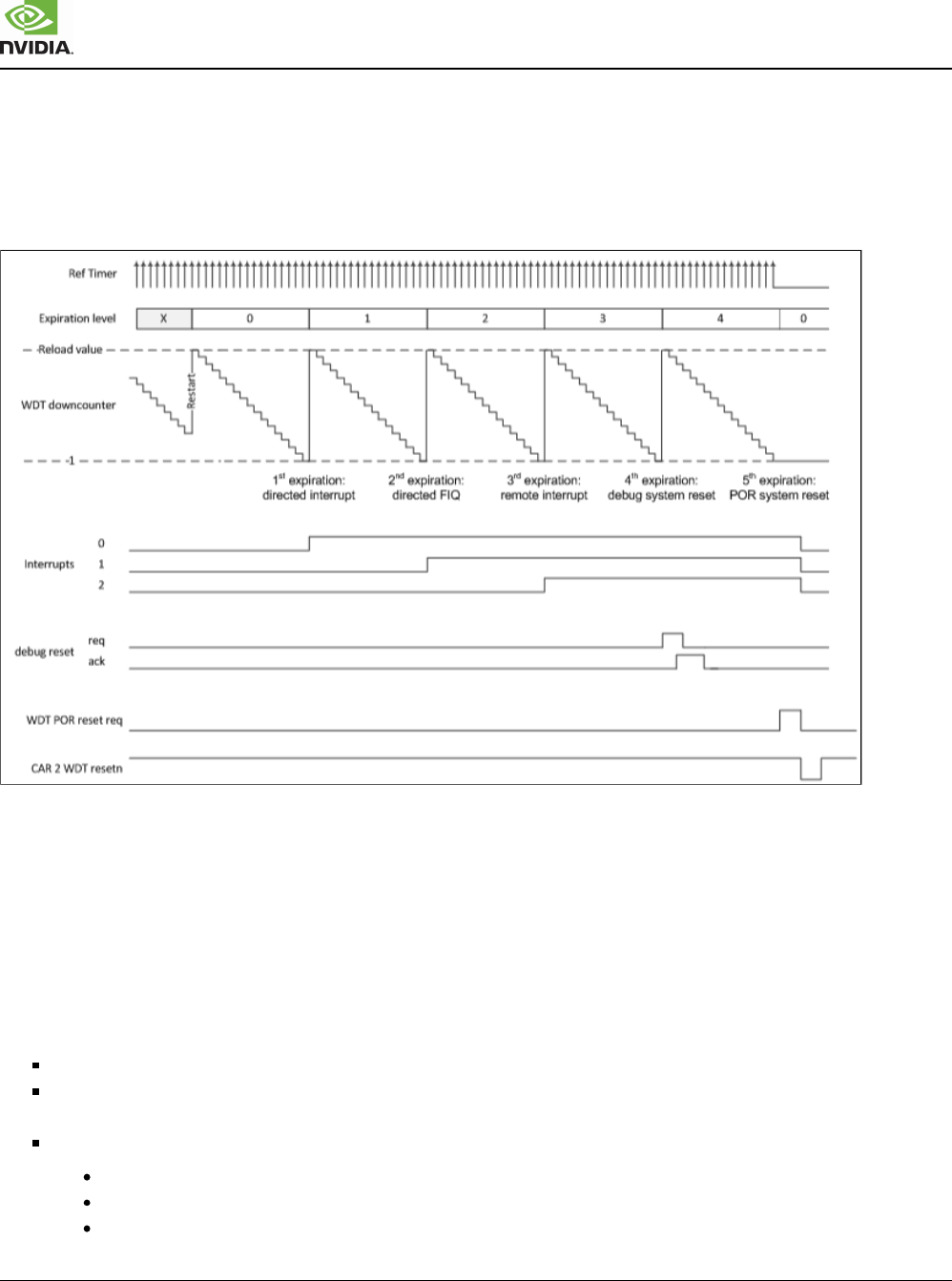
Xavier Series SoC Technical Reference Manual
XAVIER | TRM | DP-09253-002_v1.1 | SUBJECT TO CHANGE | www.nvidia.com Page of 5923 8287
There is also a mechanism to stop all WDTs, similar to the ability to stop all timers. The request comes on a
wire broadcast to all TKEs (and AOWDTs). Each WDT adds a configuration bit to allow/disallow stopping the
WDT. Allowed after reset but can be switched to disallow for safety use cases. Each WDT also includes a
status bit indicating if it is currently frozen.
Figure 8.19 Example Timeline for Watchdog Operation
Generic Timers
ARM Generic Timer (GT) architecture defines timers to be used by ARM CPUs. This architecture uses the
system wide timing reference called Timestamp System Counter (TSC) that increases at a constant rate. This
allows the Generic Timers inside a CPU cluster to operate correctly without reconfiguration when the CPU
frequency changes.
The ARM Generic Timer includes the following features:
Physical counter that contains the count value of the system-counter.
Virtual counter that indicates virtual time. The virtual counter contains the value of the physical counter minus a 64-bit
virtual offset.
Set of four timers per CPU:
Secure Physical Timer
Non-Secure Physical Timer
Hypervisor Timer
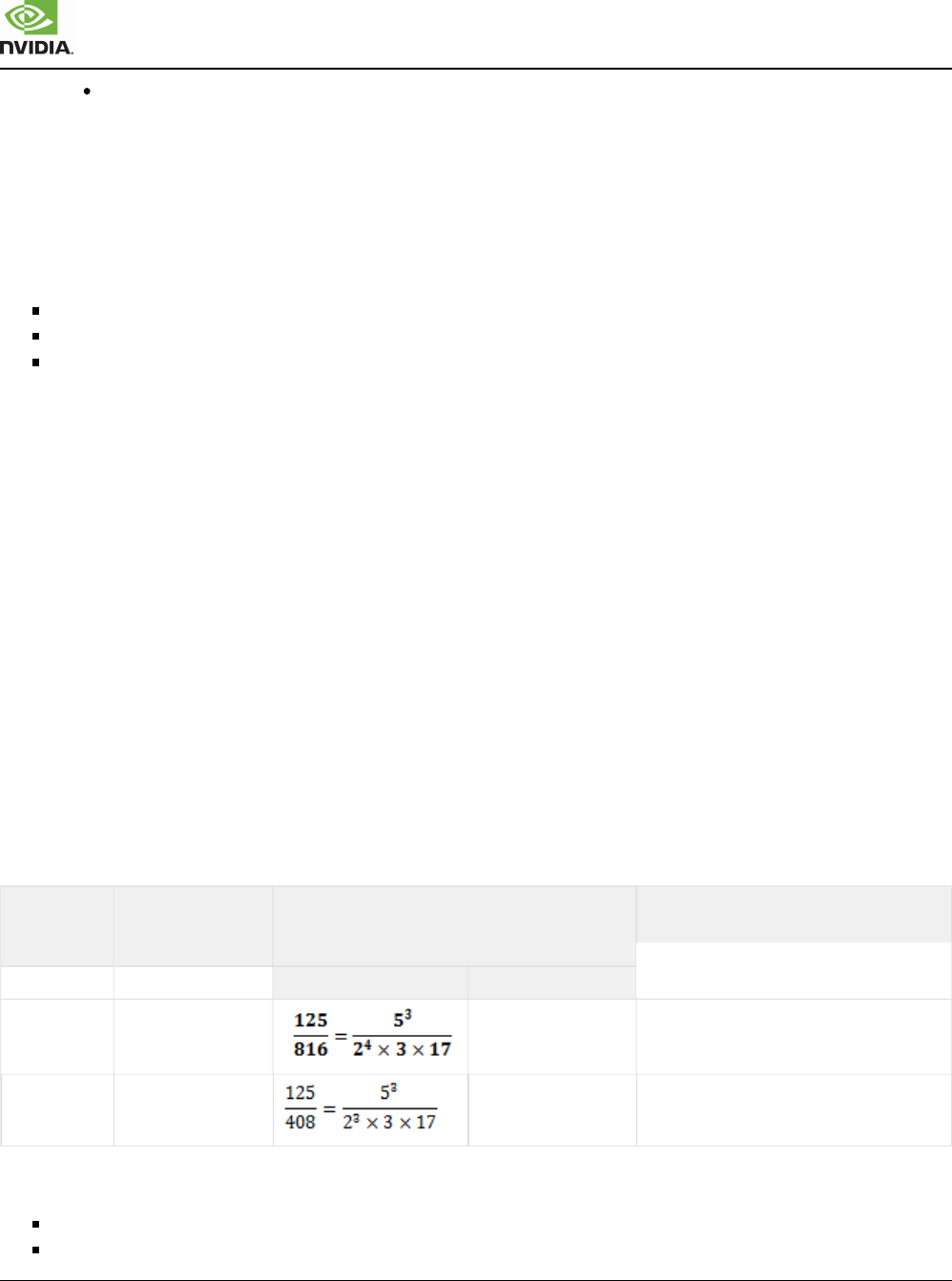
Xavier Series SoC Technical Reference Manual
XAVIER | TRM | DP-09253-002_v1.1 | SUBJECT TO CHANGE | www.nvidia.com Page of 5924 8287
Virtual Timer
Full details about the operation of the Generic Timers were introduced in different ARM documents and are now
part of the .
ARM Architecture Reference Manual
Cortex-A9 Timers
The Cortex-A9 complex inside the APE contains an instance of a Cortex-A9 timer block, including the following:
Global timer, a 64-bit incrementing counter
Per CPU core private timer, a 32-bit decrementing counter with optional prescaler
Per CPU core watchdog timer. It has the same structure as a private timer augmented with watchdog capabilities, and
can be used as a second private timer. The Cortex-A9 WDT reset request signal is not connected.
All these timers operate on the Cortex-A9 clock, making them difficult to use for real-time purposes when the
Cortex-A9 clock is subject to DVFS. The APE cluster includes a TKE (not affected by DVFS) and APE software
usually do not use at all the Cortex-A9 timers.
TSC Update Frequency
The recommended frequency is 31.25 MHz to match the GPU ptimer requirement for a power-of-2 period (in
nS).
TSC Update Frequency Starting from PLLP
The cardinality of the operands, Numerator (N) and Denominator (D), for the slave TSC rational divider in path 0
is dependent on the division performed in the CAR divider. The ratio is the product of the CAR divider ratio
times the rational divider ratio. At least a factor of two is mandatory, whereas the divide-by-2 case is preferred
but the by-4 case is also allowed.
Configurationd to Generate 31.25 MHz
CAR Divider CAR Frequency
(MHz)
CAR Frequency/31.25 MHz
CAR Period, also Induced Jitter (ns)
Ratio # of Bits (N,D)
2 204 (7,10) 4.902
4 102 (7,9) 9.804
The (N,D) of the table above are held in
CLK_RST_CONTROLLER_TSC_HS_SUPER_CLK_DIVIDER_0.SUPER_TSC_HS_DIV_DIVIDEND (N)
CLK_RST_CONTROLLER_TSC_HS_SUPER_CLK_DIVIDER_0.SUPER_TSC_HS_DIV_DIVISOR (D)
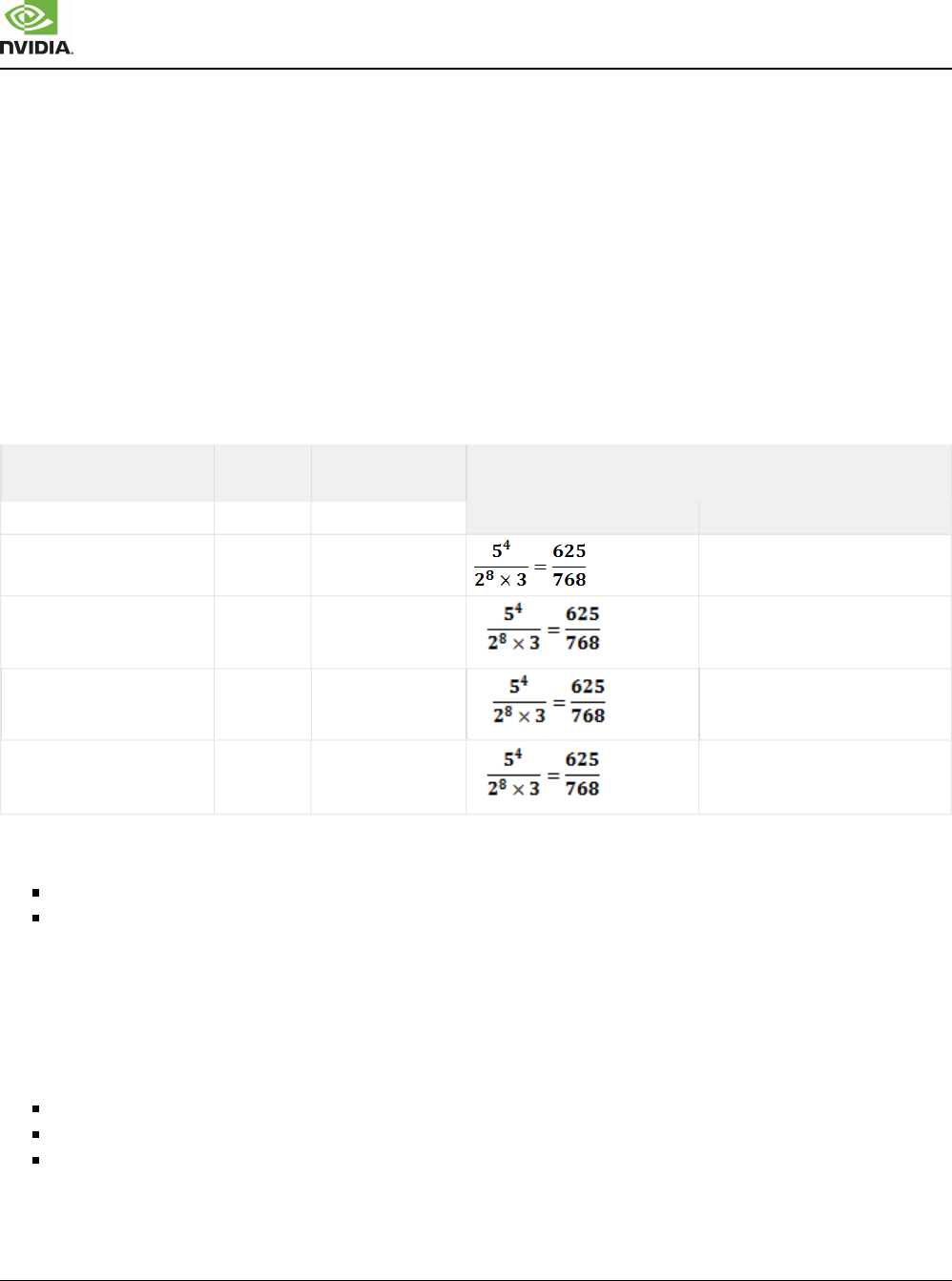
Xavier Series SoC Technical Reference Manual
XAVIER | TRM | DP-09253-002_v1.1 | SUBJECT TO CHANGE | www.nvidia.com Page of 5925 8287
1.
2.
See Clock Controller and Reset (CAR) chapter for details.
TSC Update Frequency Starting from OSC
The cardinality of the operands, for the slave TSC rational divider in path 1 Numerator (N) and Denominator (D),
is constrained by the required support for a set of possible OSC frequencies. The table below lists different
input frequencies OSC_DIV (OSC frequency, 38.4 MHz, divided by 1, 2, 3, and 4) and their corresponding
Rational Divider Parameters for the Update Frequency 31.25 MHz (F) that are calculated in the following steps:
Find K that is the minimum for F/K to be lower than the OSC_DIV frequency (38.4 MHz).
Calculate the ratio of (F/K) and OSC_DIV.
Table 8.18 TSC Rational Divider Parameters ((F/K) / OSC_Div) at 38.4 MHz OSC Frequency and 31.25
MHz (F) Update Frequency
OSC_Div (MHz) K F/K
(F/K) / OSC_Div
Ratio # of Bits (N,D)
9.6 (38.4 / 4) 4 7.8125 (10,10)
12.8 (38.4 / 3) 3 10.416 (10,10)
19.2 (38.4 / 2) 2 15.625 (10,10)
38.4 (38.4 / 1) 1 31.25 (10,10)
The (N,D) of the table above are held in
CLK_RST_CONTROLLER_TSC_ _SUPER_CLK_DIVIDER_0.SUPER_TSC_OSC_DIV_DIVIDEND (N)OSC
CLK_RST_CONTROLLER_TSC_OSC_SUPER_CLK_DIVIDER_0.SUPER_TSC_OSC_DIV_DIVISOR (D)
See Clock Controller and Reset (CAR) chapter for details.
Safety Mechanism
The following blocks support register parity and send the parity error signals to an error collator:
RTC
TSC
USEC
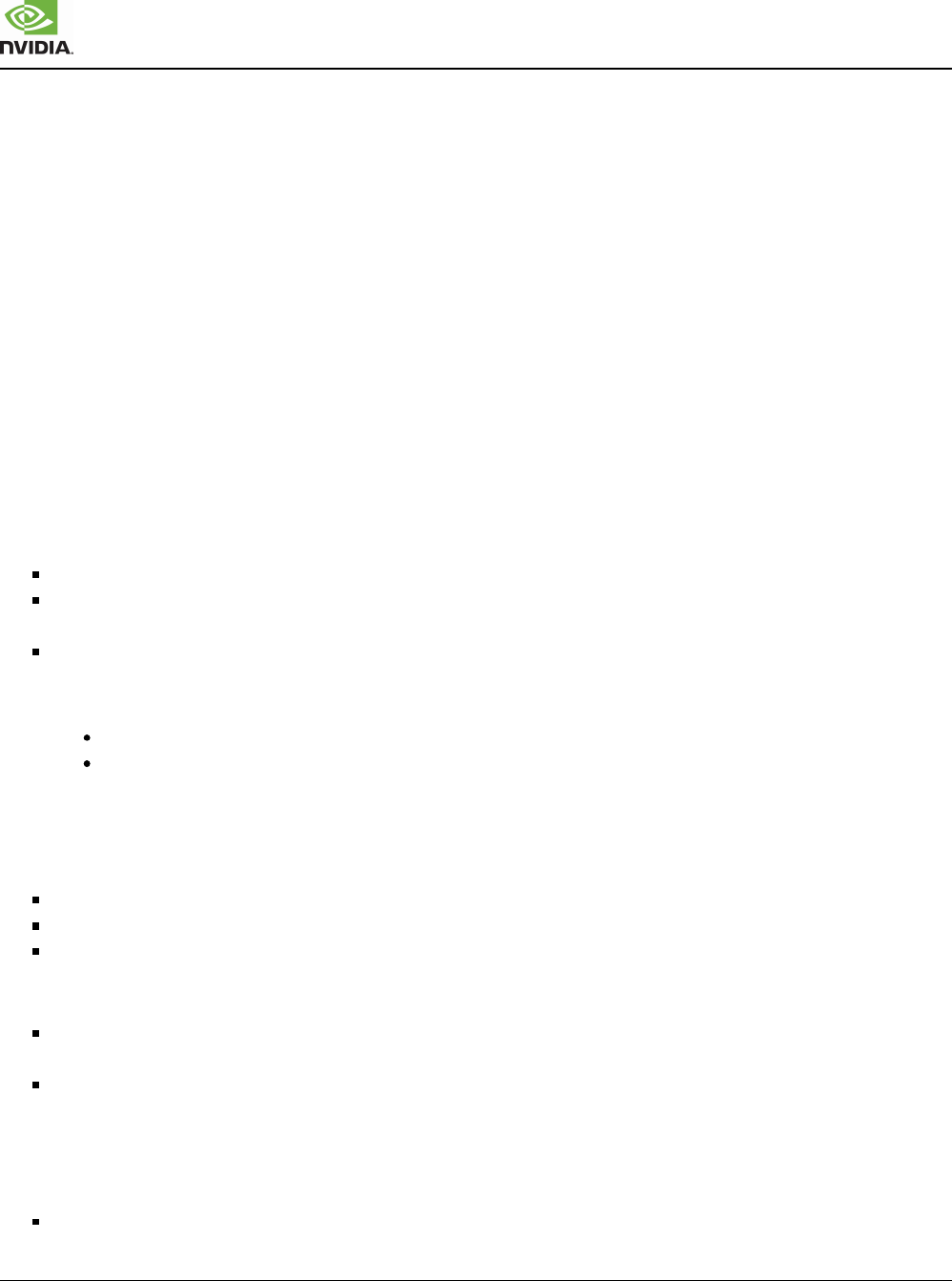
Xavier Series SoC Technical Reference Manual
XAVIER | TRM | DP-09253-002_v1.1 | SUBJECT TO CHANGE | www.nvidia.com Page of 5926 8287
The are all inside the Always-On cluster and share the the Always-On cluster error collator with similar modules.
The Always-On cluster error collator forwards an aggregated error signal to the Hardware Safety manager
(HSM).
All hardware watchdog timers also generate an error signal when their expiration level is above a programmed
threshold. This error signal is directly connected to the HSM without going through an error collator.
8.3.4 Programming Guidelines
The following subsection provides guidance on the exact usage of the registers, especially when the sequence
of accesses is important.
Context Save and Restore Across Power State Transitions
Power state transitions require the affected modules to be restarted after the power state transition, with SC7
entry/exit the most important power state transition. There are a few canonical ways to handle this:
Do nothing, the reset value of the register is correct.
Registers are restored to a statically defined value. The register does not need to be fully static, but the initial value
after the power state transition is not dependent on the previous history.
Registers are restored based on their (dynamic) state prior to the power state transition. This requires to save a
relevant context, normally in external memory, and later to use the saved context to restore registers. Note that
preserving the context can be done either:
During SC7 entry
When the register is modified, this may be required for registers that are not accessible to the SC7 exit
process, generally because the SC7 entry process does not have sufficient access rights.
This section provides guidance for the registers, in particular detailing all special cases where the software
sequence may be more complex than simply writing back the stored value, including:
Security aspects linked to the new security model.
Registers that are have special access rules like indirection or lockable.
Registers that require some adaptation between save and restore.
The SC7 restore proceeds in two steps to reduce the latency associated with power state transitions:
A small set of registers, including the SCR are restored first by a secure software process. This set should be small
for performance reason. Note that in many cases, the SCR have static values, so they do not require to be saved.
Most of the registers protected by the SCR, especially most of the TrustZone secure registers are ideally restored
later, while some unrelated non secure software processes may already be active before full restoration takes place.
This specific way of handling SC7 requires checking if the default value of registers presents a security
exposure. This section classifies the different registers in three categories:
R0: Registers that must be restored in the first step to avoid a security exposure.

Xavier Series SoC Technical Reference Manual
XAVIER | TRM | DP-09253-002_v1.1 | SUBJECT TO CHANGE | www.nvidia.com Page of 5927 8287
R1: Registers that may be restored in the first step for a fully clean solution. These registers must be so that
information leakage can be fully averted if context restoration proceeds in a specific sequence. However not following
the ideal sequence only allows non secure software to observe TrustZone events that otherwise would be hidden, but
without compromising security itself.
R2: Restored registers with no specific security requirements.
NR: Registers that don’t need to be restored
The tables below list the registers and the associated guidance and are extensions of the corresponding
summary tables.
Table 8.19 Guidance for SC7 Handling of ARM TSC Control Registers
Register Name Category Remark
CNTCR
NR In Always On partition, not affected by SC7.
CNTSR
CNTCV0
CNTCV1
CNTFID0
CNTFID1
CounterID4
CounterID{5:7}
CounterID{0:3}
CounterID{8:11}
Table 8.20 Guidance for SC7 Handling of ARM TSC Status Registers
Register Name Category Remark
CNTCV0
NR In Always On partition, not affected by SC7.
CNTCV1
CounterID4
CounterID{5:7}
CounterID{0:3}
CounterID{8:
11}
Table 8.21 Guidance for SC7 Handling of TSC Implementation Registers
Register Name Category Remark
MTSCACR
MTSCADR
MTSCANNR
MTSCANDR

Xavier Series SoC Technical Reference Manual
XAVIER | TRM | DP-09253-002_v1.1 | SUBJECT TO CHANGE | www.nvidia.com Page of 5928 8287
Register Name Category Remark
NR
In Always On partition, not affected by SC7. Note however that a portion of the TSC logic
depends on OSC or PLLP being active, so there are specific requirements to handle SC7, but the
sequence depicted there does not impact the registers.
MTSCCNTCV0
MTSCCNTCV1
STSCCR
STSCRSR
STSCIR{0,1}
STSCSR
TSCDCR
TSCSCR
Table 8.22 Guidance for SC7 Handling of TSC CAR Registers
Register Name Category Remark
CSTSCR0 R0
These are marked R0 because it is assumed they provide the reference for (secure) time, and so
should probably restored quickly. There are no associated security requirements. The values
restored are static for a given platform, so not clear if this requires a saving step.
TSCDIVR0 R0
TSCDIVR1 R0
Table 8.23 Guidance for SC7 Handling of Common GTE Registers, when Outside of AO Partition
Register Name Category Remark
TECTRL{t} R2 Generic TimeStamp Engine Control
TETSCH{t} NR 24 MSBs of the TSC associated with a timestamped event
TETSCL{t} NR 32 LSBs of the TSC associated with a timestamped event
TECCV{t} NR Current captured value of bitmap for timestamped event
TEPVV{t} NR Previous captured value of bitmap for timestamped event
TESRC{t} NR Identifies the source of the timestamped event
TEENCV{t} NR Encoded version of TECV{t} and TEPV{t}, with explicit valid
TECMD{t} NR Command register, especially to pop the FIFO
TESTATUS{t} NR Status register
TESCR{t} R0 Access rights control register for timestamp engine {t}.
TEDSCR{t} R0 Specific security domain for disable bits for timestamp engine {t}.
Table 8.24 Guidance for SC7 Handling of per Slice GTE Registers, when Outside of AO Partition
Register Name Category Remark
TETEN{t}{s} R2
TETDN{t}{s} R1 If not restored in step 1, non-secure software can observe the timing and occurrence of secure
events. This can be avoided by restoring this register before enabling the event source. As only
observation is possible if the sequence above is not followed, security is not directly compromised,
allowing R1.

Xavier Series SoC Technical Reference Manual
XAVIER | TRM | DP-09253-002_v1.1 | SUBJECT TO CHANGE | www.nvidia.com Page of 5929 8287
Table 8.25 Guidance for SC7 Handling of RTC Registers
Register Name Category Remark
RTCCR
NR In Always On partition, not affected by SC7.
RTCBR
RTCSCR
RTCSSCR
RTCMCR
RTCSAR{0,1}
RTCMAR
RTCSCAR
RTCMCAR
RTCIER
RTCISR
RTCIVR
RTCFIR
RTCRSR
RTCDR
RTCSCR
AOWDTCR
AOWDTSR
AOWDTCMDR
AOWDTUR
AOWDTSCOR
AOWDTSCR
Table 8.26 Guidance for SC7 Handling of USEC Registers
Register Name Category Remark
USECCVR
NR In Always On partition, not affected by SC7.
USECCCR
USECCRSR
USECCFR
USECSCR
Table 8.27 Guidance for SC7 Handling of TKE Registers, when outside of AO partition
Register Name Category Remark
TKETSC{0,1} NR

Xavier Series SoC Technical Reference Manual
XAVIER | TRM | DP-09253-002_v1.1 | SUBJECT TO CHANGE | www.nvidia.com Page of 5930 8287
Register Name Category Remark
TKEUSEC NR
TKEOSC NR
TKECR R2
TKEIE{i} R2
TKEIV NR
TKEIR NR
TKESCR R0
TMRCR{t} R2
Restoring the state of a timer may require compensating for the amount of time the power state
consumed.
TMRSR{t} NR (but saved)
TMRCSSR{t} R2
TMRSCR{t} R0
WDTCR{w} R2 WDT cannot compensate for the amount of time the power of state consumed, they can only be
restarted from scratch.
WDTSR{w} NR
WDTCMDR{w} NR
WDTUR{w} NR
WDTSCOR{w} R2
WDTSCR{w} R0
Restoring a TKE timer needs to consider a few special cases when trying to compensate for the amount of time
consumed by the power state:
For a one off timer
The timer may have expired during the power state, the restore code can perform either of the following:
Insert an (fake) event into the handler.
Program the timer to its shortest possible duration, resulting in the raising of the corresponding interrupt
as usual.
If the timer has not expired, the compensation can be done by performing any of the following:
Restore without compensation, the timer is linked to the amount of time elapsed in the active state, not
real time.
Restore in absolute fashion, if the timer targets a known real time deadline, the timer delay can be
computed by target time minus current time. This has the advantage that errors don’t accumulate if the
timer is suspended multiple times. This requires to save the calculated expiration time, not the TMRSR
{T} itself.
Restore in relative fashion, calculate the timer delay as the timer value at SC7 entry minus the amount
of time consumed during SC7. This requires saving TMRSR{t}.PCV and to know the time spent in SC7.
Note that the TMRSR{t}.PCV value is restored on a calculated value not the saved value itself.
For a periodic timer:

Xavier Series SoC Technical Reference Manual
XAVIER | TRM | DP-09253-002_v1.1 | SUBJECT TO CHANGE | www.nvidia.com Page of 5931 8287
The timer may have expired a number of times during the power state. Then, it may need to insert
corresponding (fake) events into the handler.
A timer cannot be restarted at a value different than its period. Then the restore may need to proceed in two
phases if the phase of the timer is important.
Restart the timer as a one off for the remainder of the period, using the same time of calculation for one-
off timer.
At the first expiration after the power state transition, restarts the timer in periodic mode.
If the phase of the periodic timer is not important, but only its period, then simply restart it immediately.
A final requirement is to assert/deassert the reset to terminal nodes located in a power-gated partition if the
reset is software controlled.
8.3.5 Timer Registers
Refer to "Reading Register Tables" in the Introduction chapter for the register table protocol as well as
recommendations for accessing registers.
The register descriptions below give the offset of each register within the Timers' address range. The Base
Addresses of these registers are specified in the Address Map section of the Xavier TRM.
Timer Keeping Element Shared Registers
TKE_AON_SHARED_TKETSC0_0
Value of Local TSC counter, synchronized across SOC
Offset: 0x0
Read/Write: RO
Parity Protection: N
SCR Protection: TKESCR_0
Reset: 0x00000000 (0b0000,0000,0000,0000,0000,0000,0000,0000)
Bit Reset Description
31:0 0x0
CV:
Current value of TSC, TSC[31:0]
TKE_AON_SHARED_TKETSC1_0
Value of Master TSC counter, synchronized across SOC
Offset: 0x4
Read/Write: RO

Xavier Series SoC Technical Reference Manual
XAVIER | TRM | DP-09253-002_v1.1 | SUBJECT TO CHANGE | www.nvidia.com Page of 5932 8287
Parity Protection: N
SCR Protection: TKESCR_0
Reset: 0x00000000 (0b0000,0000,0000,0000,0000,0000,0000,0000)
Bit Reset Description
31:0 0x0 CV:
8h0 followed by Master TSC[55:32]
TKE_AON_SHARED_TKEUSEC_0
Value of Local USEC counter, not synchronized across SOC
Offset: 0x8
Read/Write: RO
Parity Protection: N
SCR Protection: TKESCR_0
Reset: 0x00000000 (0b0000,0000,0000,0000,0000,0000,0000,0000)
Bit Reset Description
31:0 0x0 CV:
Current value of microsecond counter
TKE_AON_SHARED_TKEOSC_0
Value of Local OSC counter, not synchronized across SOC
Offset: 0xc
Read/Write: RO
Parity Protection: N
SCR Protection: TKESCR_0
Reset: 0x00000000 (0b0000,0000,0000,0000,0000,0000,0000,0000)
Bit Reset Description
31:0 0x0
CV:
Current value of osccilator counter
TKE_AON_SHARED_TKECR_0
TKE Control register
Offset: 0x10
Read/Write: R/W
Parity Protection: N
SCR Protection: TKESCR_0
Reset: 0x00000000 (0bxxxx,xxxx,xxxx,xxxx,xxxx,xxxx,xxxx,0000)

Xavier Series SoC Technical Reference Manual
XAVIER | TRM | DP-09253-002_v1.1 | SUBJECT TO CHANGE | www.nvidia.com Page of 5933 8287
Bit Reset Description
3 0x0
HDBG:
Halt-on-debug. Controls whether a Halt-on-debug signal halts TKE logic
0: TKE ignores Halt-on-debug.
1: Asserted Halt-on-debug signal halts TKE logic, by disabling the update of the reference counters and
reference timing signals for all timers and all WDTs
2 0x0 OSC_DIS:
Disable the local OSC counter - Can be used to decrease the power consumption if OSC is not required
either by HW as a reference clock or by SW
1 0x0
USEC_DIS:
Disable the local USEC counter - Can be used to decrease the power consumption if usec is not required
either by HW as a reference clock or by SW
0 0x0 TSC_DIS:
Disable the local TSC - Can be used to decrease the power consumption if TSC is not required either by HW
as a reference clock or by SW
TKE_AON_SHARED_CLK_OVR_ON_0
Offset: 0x14
Read/Write: R/W
Parity Protection: N
SCR Protection: TKESCR_0
Reset: 0x00000000 (0bxxxx,xxxx,xxxx,xxxx,xxxx,xxxx,xxxx,xxx0)
Bit Reset Description
0 0x0
OSC:
SLCG override bit
= DISABLE0
= ENABLE1
====================================================
Time Keeping Element: NV_Timers Master Spec
====================================================
TKE_AON_TIMER_TMR0_TMRCR_0
Register name Offset Description
TMRCR{t} BT + P*{t} + 0 Timer Configuration Register
TMRSR{t} BT + P*{t} + 4 Timer Status Register
TMRCSSR{t} BT + P*{t} + 8 Timer Clock Source Selection Register
TMRATR{t} BT + P*{t} + 12 Timer Absolute Target Register
Timer Configuration Register

Xavier Series SoC Technical Reference Manual
XAVIER | TRM | DP-09253-002_v1.1 | SUBJECT TO CHANGE | www.nvidia.com Page of 5934 8287
Offset: 0x10000
Read/Write: R/W
Parity Protection: N
SCR Protection: TMRSCR0_0
Reset: 0x40000000 (0b01x0,0000,0000,0000,0000,0000,0000,0000)
Bit Reset Description
31 0x0 EN:
Enable, when set, enables the countdown process.
30 0x1
PER:
Periodic, when set, the internal counter is automatically reloaded after reaching 0
28:0 0x0
PTV:
Timer Present Trigger Value. When TMRCR is written and EN is 1b, the internal counter
is loaded with PTV+1 and starts counting down at each timing reference pulse. An interrupt
is set when the internal counter reaches 0. Note that writing TMRCR with EN=1 while
EN was already 1 restarts the counter.
Once the timer is started, TARGET can be used to either
- observe the value of the reference counter when the next interrupt is generated (read)
- select the exact reference counter value at which the next interrupt is generated (write)
TKE_AON_TIMER_TMR0_TMRSR_0
Timer Status Register
Offset: 0x10004
Read/Write: See table below
Parity Protection: N
SCR Protection: TMRSCR0_0
Reset: 0x00000000 (0bx0x0,0000,0000,0000,0000,0000,0000,0000)
Bit R/W Reset Description
30 RW 0x0 INTR_CLR:
Clears the interrupt when written as 1b, read always returns 0
28:0 RO 0x0 PCV:
Current counter value, writing to this field has no effect
TKE_AON_TIMER_TMR0_TMRCSSR_0
Timer Clock Source Selection Register
Offset: 0x10008
Read/Write: R/W
Parity Protection: N
SCR Protection: TMRSCR0_0
Reset: 0x00000000 (0bxxxx,xxxx,xxxx,xxxx,xxxx,xxxx,xxxx,xx00)

Xavier Series SoC Technical Reference Manual
XAVIER | TRM | DP-09253-002_v1.1 | SUBJECT TO CHANGE | www.nvidia.com Page of 5935 8287
Bit Reset Description
1:0 0x0
SRC_ID:
Select Count reference
2'b11 - TSC [41:12]
2'b10 - TSC [29:0]
2'b01 - oscCnt [29:0]
2'b00 - usecCnt [29:0]
The implementation of each timer uses comparison against counters incrementing
at the selected rate.
= SRC_USECCNT0
= SRC_OSCCNT1
= SRC_TSCCNT_29_02
= SRC_TSCCNT_41_123
TKE_AON_TIMER_TMR0_TMRATR_0
Timer Absolute Target Register
Offset: 0x1000c
Read/Write: R/W
Parity Protection: N
SCR Protection: TMRSCR0_0
Reset: 0x00000000 (0bxx00,0000,0000,0000,0000,0000,0000,0000)
Bit Reset Description
29:0 0x0 TARGET:
Target value of the selected reference counter, i.e. when value of the selected reference
equals target value, the interrupt is generated. The difference between TARGET and the
current value must be positive when interpreting TARGET and the 29 LSB of the selected
reference counter as signed integers, otherwise the interrupt triggers immediately.
TKE_AON_TIMER_TMR1_TMRCR_0
Register name Offset Description
TMRCR{t} BT + P*{t} + 0 Timer Configuration Register
TMRSR{t} BT + P*{t} + 4 Timer Status Register
TMRCSSR{t} BT + P*{t} + 8 Timer Clock Source Selection Register
TMRATR{t} BT + P*{t} + 12 Timer Absolute Target Register
Timer Configuration Register
Offset: 0x20000
Read/Write: R/W
Parity Protection: N
SCR Protection: TMRSCR1_0
Reset: 0x40000000 (0b01x0,0000,0000,0000,0000,0000,0000,0000)

Xavier Series SoC Technical Reference Manual
XAVIER | TRM | DP-09253-002_v1.1 | SUBJECT TO CHANGE | www.nvidia.com Page of 5936 8287
Bit Reset Description
31 0x0 EN:
Enable, when set, enables the countdown process.
30 0x1 PER:
Periodic, when set, the internal counter is automatically reloaded after reaching 0
28:0 0x0 PTV:
Timer Present Trigger Value. When TMRCR is written and EN is 1b, the internal counter
is loaded with PTV+1 and starts counting down at each timing reference pulse. An interrupt
is set when the internal counter reaches 0. Note that writing TMRCR with EN=1 while
EN was already 1 restarts the counter.
Once the timer is started, TARGET can be used to either
- observe the value of the reference counter when the next interrupt is generated (read)
- select the exact reference counter value at which the next interrupt is generated (write)
TKE_AON_TIMER_TMR1_TMRSR_0
Timer Status Register
Offset: 0x20004
Read/Write: See table below
Parity Protection: N
SCR Protection: TMRSCR1_0
Reset: 0x00000000 (0bx0x0,0000,0000,0000,0000,0000,0000,0000)
Bit R/W Reset Description
30 RW 0x0 INTR_CLR:
Clears the interrupt when written as 1b, read always returns 0
28:0 RO 0x0 PCV:
Current counter value, writing to this field has no effect
TKE_AON_TIMER_TMR1_TMRCSSR_0
Timer Clock Source Selection Register
Offset: 0x20008
Read/Write: R/W
Parity Protection: N
SCR Protection: TMRSCR1_0
Reset: 0x00000000 (0bxxxx,xxxx,xxxx,xxxx,xxxx,xxxx,xxxx,xx00)
Bit Reset Description
1:0
0x0
SRC_ID:
Select Count reference
2'b11 - TSC [41:12]

Xavier Series SoC Technical Reference Manual
XAVIER | TRM | DP-09253-002_v1.1 | SUBJECT TO CHANGE | www.nvidia.com Page of 5937 8287
Bit Reset Description
2'b10 - TSC [29:0]
2'b01 - oscCnt [29:0]
2'b00 - usecCnt [29:0]
The implementation of each timer uses comparison against counters incrementing
at the selected rate.
= SRC_USECCNT0
= SRC_OSCCNT1
= SRC_TSCCNT_29_02
= SRC_TSCCNT_41_123
TKE_AON_TIMER_TMR1_TMRATR_0
Timer Absolute Target Register
Offset: 0x2000c
Read/Write: R/W
Parity Protection: N
SCR Protection: TMRSCR1_0
Reset: 0x00000000 (0bxx00,0000,0000,0000,0000,0000,0000,0000)
Bit Reset Description
29:0 0x0 TARGET:
Target value of the selected reference counter, i.e. when value of the selected reference
equals target value, the interrupt is generated. The difference between TARGET and the
current value must be positive when interpreting TARGET and the 29 LSB of the selected
reference counter as signed integers, otherwise the interrupt triggers immediately.
TKE_AON_TIMER_TMR2_TMRCR_0
Register name Offset Description
TMRCR{t} BT + P*{t} + 0 Timer Configuration Register
TMRSR{t} BT + P*{t} + 4 Timer Status Register
TMRCSSR{t} BT + P*{t} + 8 Timer Clock Source Selection Register
TMRATR{t} BT + P*{t} + 12 Timer Absolute Target Register
Timer Configuration Register
Offset: 0x30000
Read/Write: R/W
Parity Protection: N
SCR Protection: TMRSCR2_0
Reset: 0x40000000 (0b01x0,0000,0000,0000,0000,0000,0000,0000)
Bit Reset Description
31
0x0

Xavier Series SoC Technical Reference Manual
XAVIER | TRM | DP-09253-002_v1.1 | SUBJECT TO CHANGE | www.nvidia.com Page of 5938 8287
Bit Reset Description
EN:
Enable, when set, enables the countdown process.
30 0x1
PER:
Periodic, when set, the internal counter is automatically reloaded after reaching 0
28:0 0x0
PTV:
Timer Present Trigger Value. When TMRCR is written and EN is 1b, the internal counter
is loaded with PTV+1 and starts counting down at each timing reference pulse. An interrupt
is set when the internal counter reaches 0. Note that writing TMRCR with EN=1 while
EN was already 1 restarts the counter.
Once the timer is started, TARGET can be used to either
- observe the value of the reference counter when the next interrupt is generated (read)
- select the exact reference counter value at which the next interrupt is generated (write)
TKE_AON_TIMER_TMR2_TMRSR_0
Timer Status Register
Offset: 0x30004
Read/Write: See table below
Parity Protection: N
SCR Protection: TMRSCR2_0
Reset: 0x00000000 (0bx0x0,0000,0000,0000,0000,0000,0000,0000)
Bit R/W Reset Description
30 RW 0x0 INTR_CLR:
Clears the interrupt when written as 1b, read always returns 0
28:0 RO 0x0 PCV:
Current counter value, writing to this field has no effect
TKE_AON_TIMER_TMR2_TMRCSSR_0
Timer Clock Source Selection Register
Offset: 0x30008
Read/Write: R/W
Parity Protection: N
SCR Protection: TMRSCR2_0
Reset: 0x00000000 (0bxxxx,xxxx,xxxx,xxxx,xxxx,xxxx,xxxx,xx00)
Bit Reset Description
1:0
0x0
SRC_ID:
Select Count reference
2'b11 - TSC [41:12]
2'b10 - TSC [29:0]

Xavier Series SoC Technical Reference Manual
XAVIER | TRM | DP-09253-002_v1.1 | SUBJECT TO CHANGE | www.nvidia.com Page of 5939 8287
Bit Reset Description
2'b01 - oscCnt [29:0]
2'b00 - usecCnt [29:0]
The implementation of each timer uses comparison against counters incrementing
at the selected rate.
= SRC_USECCNT0
= SRC_OSCCNT1
= SRC_TSCCNT_29_02
= SRC_TSCCNT_41_123
TKE_AON_TIMER_TMR2_TMRATR_0
Timer Absolute Target Register
Offset: 0x3000c
Read/Write: R/W
Parity Protection: N
SCR Protection: TMRSCR2_0
Reset: 0x00000000 (0bxx00,0000,0000,0000,0000,0000,0000,0000)
Bit Reset Description
29:0 0x0
TARGET:
Target value of the selected reference counter, i.e. when value of the selected reference
equals target value, the interrupt is generated. The difference between TARGET and the
current value must be positive when interpreting TARGET and the 29 LSB of the selected
reference counter as signed integers, otherwise the interrupt triggers immediately.
TKE_AON_TIMER_TMR3_TMRCR_0
Register name Offset Description
TMRCR{t} BT + P*{t} + 0 Timer Configuration Register
TMRSR{t} BT + P*{t} + 4 Timer Status Register
TMRCSSR{t} BT + P*{t} + 8 Timer Clock Source Selection Register
TMRATR{t} BT + P*{t} + 12 Timer Absolute Target Register
Timer Configuration Register
Offset: 0x40000
Read/Write: R/W
Parity Protection: N
SCR Protection: TMRSCR3_0
Reset: 0x40000000 (0b01x0,0000,0000,0000,0000,0000,0000,0000)
Bit Reset Description
31 0x0
EN:
Enable, when set, enables the countdown process.

Xavier Series SoC Technical Reference Manual
XAVIER | TRM | DP-09253-002_v1.1 | SUBJECT TO CHANGE | www.nvidia.com Page of 5940 8287
Bit Reset Description
30 0x1
PER:
Periodic, when set, the internal counter is automatically reloaded after reaching 0
28:0 0x0
PTV:
Timer Present Trigger Value. When TMRCR is written and EN is 1b, the internal counter
is loaded with PTV+1 and starts counting down at each timing reference pulse. An interrupt
is set when the internal counter reaches 0. Note that writing TMRCR with EN=1 while
EN was already 1 restarts the counter.
Once the timer is started, TARGET can be used to either
- observe the value of the reference counter when the next interrupt is generated (read)
- select the exact reference counter value at which the next interrupt is generated (write)
TKE_AON_TIMER_TMR3_TMRSR_0
Timer Status Register
Offset: 0x40004
Read/Write: See table below
Parity Protection: N
SCR Protection: TMRSCR3_0
Reset: 0x00000000 (0bx0x0,0000,0000,0000,0000,0000,0000,0000)
Bit R/W Reset Description
30 RW 0x0 INTR_CLR:
Clears the interrupt when written as 1b, read always returns 0
28:0 RO 0x0 PCV:
Current counter value, writing to this field has no effect
TKE_AON_TIMER_TMR3_TMRCSSR_0
Timer Clock Source Selection Register
Offset: 0x40008
Read/Write: R/W
Parity Protection: N
SCR Protection: TMRSCR3_0
Reset: 0x00000000 (0bxxxx,xxxx,xxxx,xxxx,xxxx,xxxx,xxxx,xx00)
Bit Reset Description
1:0
0x0
SRC_ID:
Select Count reference
2'b11 - TSC [41:12]
2'b10 - TSC [29:0]
2'b01 - oscCnt [29:0]
2'b00 - usecCnt [29:0]
The implementation of each timer uses comparison against counters incrementing

Xavier Series SoC Technical Reference Manual
XAVIER | TRM | DP-09253-002_v1.1 | SUBJECT TO CHANGE | www.nvidia.com Page of 5941 8287
Bit Reset Description
at the selected rate.
= SRC_USECCNT0
= SRC_OSCCNT1
= SRC_TSCCNT_29_02
= SRC_TSCCNT_41_123
TKE_AON_TIMER_TMR3_TMRATR_0
Timer Absolute Target Register
Offset: 0x4000c
Read/Write: R/W
Parity Protection: N
SCR Protection: TMRSCR3_0
Reset: 0x00000000 (0bxx00,0000,0000,0000,0000,0000,0000,0000)
Bit Reset Description
29:0 0x0
TARGET:
Target value of the selected reference counter, i.e. when value of the selected reference
equals target value, the interrupt is generated. The difference between TARGET and the
current value must be positive when interpreting TARGET and the 29 LSB of the selected
reference counter as signed integers, otherwise the interrupt triggers immediately.
====================================================
Time Keeping Element: WatchDog Timers Master Spec
====================================================
TKE_AON_WDT0_WDTCR_0
WDTCR{w} BW + P*{w} + 0 RW Watchdog Timer Configuration Register
WDTSR{w} BW + P*{w} + 4 RO Watchdog Timer Status Register
WDTCMDR{w} BW + P*{w} + 8 WO Watchdog Timer Command Register
WDTUR{w} BW + P*{w} + 12 RW Watchdog Timer Unlock Register
Watchdog Timer Configuration Register
Offset: 0x50000
Read/Write: R/W
Parity Protection: N
SCR Protection: WDTSCR0_0
Reset: 0x00700000 (0b0000,xx00,0111,0000,0000,0000,0000,0000)
Bit Reset Description
31:28
0x0

Xavier Series SoC Technical Reference Manual
XAVIER | TRM | DP-09253-002_v1.1 | SUBJECT TO CHANGE | www.nvidia.com Page of 5942 8287
Bit Reset Description
WindowedRestartDisableMap:
When WindowedOperationEnable is 1b, restart commands attempted when expiration level has value b are
rejected
if bit b equals 1b in this field
25 0x0 DisallowWDTFreeze:
When 1b, the signal watchdog_freeze_request has no effect
When 0b, when the signal watchdog_freeze_request is asserted, the WDT stops decrementing CurrentCount
if the WDT is enabled
24:23 0x0
RestartErrorAction:
If a restart action is attempted but fails, indicate which of 4 actions should be taken
0x0: do nothing, silently ignore the restart
0x1: immediately jump to expiration level 4 and reload the downcounter
0x2: immediately jump to expiration level 5 and reload the downcounter
0x3: immediately request a system power on reset
When jumping levels, the normal actions configured per level must take place
= NOP0
= JUMP_TO_41
= JUMP_TO_52
= POR_RESET3
22:20 0x7 ErrorThreshold:
The WDT logic asserts an error signal to HSM when ExpirationLevel >= ErrorThreshold.
19 0x0 TscReferenceEnable:
Select as timing reference transitions on a configured TSC bit.
18 0x0 ChallengeResponseEnable:
Enable the Challenge Response mode of operation. When 1b, the Unlock register operates as a Challenge
Response register.
17 0x0
WindowedOperationEnable:
Enable the windowed mode of operation. When 1b a restart command is rejected when the current expiration
level
is identified as disallowed in the WindowedRestartDisableMap or the current time is below the window
threshold.
The rejection is either silent or perform a reset based on RestartErrorAction
16 0x0
SystemPOResetEnable:
Enable internal full system reset at fifth expiration of the counter.
This reset cannot be intercepted and acts as a Power On Reset
15 0x0 SystemDebugResetEnable:
Enable system wide reset assertion at fourth expiration of the counter.
This reset can be intercepted by debug logic, e.g. to preserve information
14 0x0
RemoteInterruptEnable:
Enable normal priority interrupt assertion at third expiration of the counter,
connected to LIC for system wide visibility
13
0x0

Xavier Series SoC Technical Reference Manual
XAVIER | TRM | DP-09253-002_v1.1 | SUBJECT TO CHANGE | www.nvidia.com Page of 5943 8287
Bit Reset Description
LocalFIQEnable:
Enable high priority interrupt (FIQ) assertion at second expiration of the counter,
connected to local interrupt controller
12 0x0 LocalInterruptEnable:
Enable normal priority interrupt assertion at first expiration of the counter,
connected to local interrupt controller
11:4 0x0
Period:
Measured in periods of the timer selected as source, this is the reload value, so 0 is treated as maximum
period
3:0 0x0 TimerSource:
The timer source interpretation is dependent on the value of TscReferenceEnable:
TscReferenceEnable = 0b: timer<TimerSource> is the timing reference
TscReferenceEnable = 1b: a transition of TSC[2*TimerSource] is the timing reference
TKE_AON_WDT0_WDTSR_0
Watchdog Timer Status Register
Offset: 0x50004
Read/Write: RO
Parity Protection: N
SCR Protection: WDTSCR0_0
Reset: 0x00000000 (0bxxxx,xxxx,xxxx,0000,x000,0000,0000,0000)
Bit Reset Description
19 0x0 Frozen:
1b indicates that the WDT is frozen because of the assertion of the global WDT freeze request
(when allowed) or because of the assertion of the global timer freeze request
18 0x0
ErrorForced:
1b indicates that the error reported to HSM is forced active for testing purpose
17 0x0
StickyEnabled:
1b when the counter is enabled and cannot be disabled, set by StickyStart command, cleared by reset only.
16 0x0 CurrentError:
Current error reported to HSM, this is the output after combining the functional and forced error paths
14:12 0x0 CurrentExpirationCount:
Current count of expiration since last start operation, cleared by Start command, saturating at 5.
11:4 0x0 CurrentCount:
Current value of the downcounter, reloaded with Period by Start command.
3 0x0 RemoteInterruptStatus:
Current status of remote interrupt, cleared by Start command
2 0x0 LocalFIQStatus:
Current status of FIQ, cleared by Start command.

Xavier Series SoC Technical Reference Manual
XAVIER | TRM | DP-09253-002_v1.1 | SUBJECT TO CHANGE | www.nvidia.com Page of 5944 8287
Bit Reset Description
1 0x0
LocalInterruptStatus:
Current status of local interrupt, cleared by Start command.
0 0x0
Enabled:
1b when the counter is active. When Enabled is 1b, the configuration of the WDT is frozen by silently
ignoring write attempts to the configuration registers: WDTCR, WDTSCR and WDTFWCR. Set by Start or
StickyStart commands,
cleared by Disable when StickyEnabled is 0b.
TKE_AON_WDT0_WDTCMDR_0
Watchdog Timer Command Register
Offset: 0x50008
Read/Write: R/W
Parity Protection: N
SCR Protection: WDTSCR0_0
Reset: 0x00000000 (0bxxxx,xxxx,xxxx,xxxx,xxxx,xxxx,xxxx,0000)
Bit Reset Description
3 0x0 ForceError:
Only working if the Command register is unlocked. 1b sets an internal flop that is ORED with the
functional error signal (based on threshold), 0b clears the bit. The state of the flop is shown
in the status register.
2 0x0
StickyStart:
Qualifies the StartCounter bit, if both bits are 1b, the counter is enabled in permanent fashion, i.e.
it remains enabled until the next reset, and a disable counter operation has no effect. Ignored if StartCounter
is 0b
1 0x0 DisableCounter:
Only working if the unlock register (WDTUR{w}) has been programmed before with the correct pattern.
Writing to the command register always clears the unlock register. If written to 1b, while StartCounter
is 0b and the unlock register contains the unlock pattern, the watchdog transitions back to disabled.
0 0x0 StartCounter:
When written to 1b, enable the counter operation,load the counter with Period and starts downcounting,
resets the expiration count to 0 and clears all status flags. Enabled is always 1b after this.
This is also used as Restart. Writing to StartCounter requires unlocking when ChallengeResponseEnable
is 1b, and writing to StartCounter is also restricted to windows of time given by WindowedRestartDisableMap
when WindowedOperationEnable is 1b.
TKE_AON_WDT0_WDTUR_0
Watchdog Timer Unlock Register
Offset: 0x5000c
Read/Write: R/W
Parity Protection: N

Xavier Series SoC Technical Reference Manual
XAVIER | TRM | DP-09253-002_v1.1 | SUBJECT TO CHANGE | www.nvidia.com Page of 5945 8287
SCR Protection: WDTSCR0_0
Reset: 0x00000000 (0b0000,0000,0000,0000,0000,0000,0000,0000)
Bit Reset Description
31:0 0x0
UnlockPattern:
The behavior of the Unlock pattern is dependent on the ChallengeResponseEnable configuration bit
When ChallengeResponseEnable is 0b, Unlock must be written with value 0x0000_C45A to allow a write to
DisableCounter to take effect. The UnlockPattern is reset at each write to the Command register.
When ChallengeResponseEnable is 1b, a write to the Command register is only allowed after reading the
Unlock pattern to get the current value of a LFSR, followed by writing the next value of the LFSR to the
UnlockPattern.
If the two values match, the unlock is successful, in all cases the LFSR gets (re)initialized with the written
value.
TKE_AON_WDT0_WDTSCR_0
Watchdog Timer Skip Configuration Register
Offset: 0x50010
Read/Write: R/W
Parity Protection: N
SCR Protection: WDTSCR0_0
Reset: 0x00000000 (0bxxxx,xxxx,xxxx,xxxx,x000,x000,x000,x000)
Bit Reset Description
14:12 0x0 Skip3:
Skip Value at Expiration count 3
At a Downcounter expiration, the expiration level changes as ExpC <= ExpC + 1 + Skip(ExpC), saturating at
5
10:8 0x0
Skip2:
Skip Value at Expiration count 2
6:4 0x0 Skip1:
Skip Value at Expiration count 1
2:0 0x0 Skip0:
Skip Value at Expiration count 0
TKE_AON_WDT0_WDTFWCR_0
Watchdog Timer Fine Window Configuration Register
Offset: 0x50014
Read/Write: R/W
Parity Protection: N
SCR Protection: WDTSCR0_0
Reset: 0x00000000 (0bxxxx,xxxx,xxxx,x000,xxxx,xxxx,0000,0000)

Xavier Series SoC Technical Reference Manual
XAVIER | TRM | DP-09253-002_v1.1 | SUBJECT TO CHANGE | www.nvidia.com Page of 5946 8287
Bit Reset Description
18:16 0x0 StartLevel:
If restart (i.e. start while WDT is already enabled) is attempted and windowing operation is enabled,
restart is rejected if current expiration < StartLevel
7:0 0x0
StartCount:
If restart (i.e. start while WDT is already enabled) is attempted and windowing operation is enabled and
current expiration level == StartLevel, restart is rejected if current downcounter > (Period - StartCount).
StartCount is the number of cycles where rejection takes place at the start of that level.
Time Keeping Element: TOP Registers
TKE_TOP_SHARED_TKETSC0_0
Value of Local TSC counter, synchronized across SOC
Offset: 0x0
Read/Write: RO
Parity Protection: N
SCR Protection: TKESCR_0
Reset: 0x00000000 (0b0000,0000,0000,0000,0000,0000,0000,0000)
Bit Reset Description
31:0 0x0 CV:
Current value of TSC, TSC[31:0]
TKE_TOP_SHARED_TKETSC1_0
Value of Master TSC counter, synchronized across SOC
Offset: 0x4
Read/Write: RO
Parity Protection: N
SCR Protection: TKESCR_0
Reset: 0x00000000 (0b0000,0000,0000,0000,0000,0000,0000,0000)
Bit Reset Description
31:0 0x0
CV:
8h0 followed by Master TSC[55:32]
TKE_TOP_SHARED_TKEUSEC_0
Value of Local USEC counter, not synchronized across SOC

Xavier Series SoC Technical Reference Manual
XAVIER | TRM | DP-09253-002_v1.1 | SUBJECT TO CHANGE | www.nvidia.com Page of 5947 8287
Offset: 0x8
Read/Write: RO
Parity Protection: N
SCR Protection: TKESCR_0
Reset: 0x00000000 (0b0000,0000,0000,0000,0000,0000,0000,0000)
Bit Reset Description
31:0 0x0 CV:
Current value of microsecond counter
TKE_TOP_SHARED_TKEOSC_0
Value of Local OSC counter, not synchronized across SOC
Offset: 0xc
Read/Write: RO
Parity Protection: N
SCR Protection: TKESCR_0
Reset: 0x00000000 (0b0000,0000,0000,0000,0000,0000,0000,0000)
Bit Reset Description
31:0 0x0
CV:
Current value of osccilator counter
TKE_TOP_SHARED_TKECR_0
TKE Control register
Offset: 0x10
Read/Write: R/W
Parity Protection: N
SCR Protection: TKESCR_0
Reset: 0x00000000 (0bxxxx,xxxx,xxxx,xxxx,xxxx,xxxx,xxxx,0000)
Bit Reset Description
3 0x0
HDBG:
Halt-on-debug. Controls whether a Halt-on-debug signal halts TKE logic
0: TKE ignores Halt-on-debug.
1: Asserted Halt-on-debug signal halts TKE logic, by disabling the update of the reference counters and
reference timing signals for all timers and all WDTs
2 0x0 OSC_DIS:
Disable the local OSC counter - Can be used to decrease the power consumption if OSC is not required
either by HW as a reference clock or by SW
1
0x0

Xavier Series SoC Technical Reference Manual
XAVIER | TRM | DP-09253-002_v1.1 | SUBJECT TO CHANGE | www.nvidia.com Page of 5948 8287
Bit Reset Description
USEC_DIS:
Disable the local USEC counter - Can be used to decrease the power consumption if usec is not required
either by HW as a reference clock or by SW
0 0x0 TSC_DIS:
Disable the local TSC - Can be used to decrease the power consumption if TSC is not required either by HW
as a reference clock or by SW
TKE_TOP_SHARED_CLK_OVR_ON_0
Offset: 0x14
Read/Write: R/W
Parity Protection: N
SCR Protection: TKESCR_0
Reset: 0x00000000 (0bxxxx,xxxx,xxxx,xxxx,xxxx,xxxx,xxxx,xxx0)
Bit Reset Description
0 0x0 OSC:
SLCG override bit
= DISABLE0
= ENABLE1
TKE_TOP_SHARED_TKEIE0_0
================================================================================================
Optional, controls the routing of shared interrupt {i}: 0 to 9
BITMAPPING:
15:0 of register TKEIE{i} = Timer Single Interrupt, for Timers 15 - 0.
18:16 of register TKEIE{i} = Watch-Dog Timer 0 internal interrupt status
19:19 of register TKEIE{i} = Reserved
22:20 of register TKEIE{i} = Watch-Dog Timer 1 internal interrupt status
23:23 of register TKEIE{i} = Reserved
26:24 of register TKEIE{i} = Watch-Dog Timer 2 internal interrupt status
27:27 of register TKEIE{i} = Reserved
30:28 of register TKEIE{i} = Watch-Dog Timer 3 internal interrupt status
31:31 of register TKEIE{i} = Reserved
================================================================================================
Offset: 0x100
Read/Write: R/W
Parity Protection: N
SCR Protection: TKESCR_0
Reset: 0x00000000 (0b0000,0000,0000,0000,0000,0000,0000,0000)

Xavier Series SoC Technical Reference Manual
XAVIER | TRM | DP-09253-002_v1.1 | SUBJECT TO CHANGE | www.nvidia.com Page of 5949 8287
Bit Reset Description
31:0 0x0 EnableMap:
Register for Shared interrupt 0, routing control
TKE_TOP_SHARED_TKEIE1_0
Offset: 0x104
Read/Write: R/W
Parity Protection: N
SCR Protection: TKESCR_0
Reset: 0x00000000 (0b0000,0000,0000,0000,0000,0000,0000,0000)
Bit Reset Description
31:0 0x0
EnableMap:
Register for Shared interrupt 1, routing control
TKE_TOP_SHARED_TKEIE2_0
Offset: 0x108
Read/Write: R/W
Parity Protection: N
SCR Protection: TKESCR_0
Reset: 0x00000000 (0b0000,0000,0000,0000,0000,0000,0000,0000)
Bit Reset Description
31:0 0x0
EnableMap:
Register for Shared interrupt 2, routing control
TKE_TOP_SHARED_TKEIE3_0
Offset: 0x10c
Read/Write: R/W
Parity Protection: N
SCR Protection: TKESCR_0
Reset: 0x00000000 (0b0000,0000,0000,0000,0000,0000,0000,0000)
Bit Reset Description
31:0 0x0
EnableMap:
Register for Shared interrupt 3, routing control
TKE_TOP_SHARED_TKEIE4_0

Xavier Series SoC Technical Reference Manual
XAVIER | TRM | DP-09253-002_v1.1 | SUBJECT TO CHANGE | www.nvidia.com Page of 5950 8287
Offset: 0x110
Read/Write: R/W
Parity Protection: N
SCR Protection: TKESCR_0
Reset: 0x00000000 (0b0000,0000,0000,0000,0000,0000,0000,0000)
Bit Reset Description
31:0 0x0 EnableMap:
Register for Shared interrupt 4, routing control
TKE_TOP_SHARED_TKEIE5_0
Offset: 0x114
Read/Write: R/W
Parity Protection: N
SCR Protection: TKESCR_0
Reset: 0x00000000 (0b0000,0000,0000,0000,0000,0000,0000,0000)
Bit Reset Description
31:0 0x0
EnableMap:
Register for Shared interrupt 5, routing control
TKE_TOP_SHARED_TKEIE6_0
Offset: 0x118
Read/Write: R/W
Parity Protection: N
SCR Protection: TKESCR_0
Reset: 0x00000000 (0b0000,0000,0000,0000,0000,0000,0000,0000)
Bit Reset Description
31:0 0x0
EnableMap:
Register for Shared interrupt 6, routing control
TKE_TOP_SHARED_TKEIE7_0
Offset: 0x11c
Read/Write: R/W
Parity Protection: N
SCR Protection: TKESCR_0
Reset: 0x00000000 (0b0000,0000,0000,0000,0000,0000,0000,0000)

Xavier Series SoC Technical Reference Manual
XAVIER | TRM | DP-09253-002_v1.1 | SUBJECT TO CHANGE | www.nvidia.com Page of 5951 8287
Bit Reset Description
31:0 0x0 EnableMap:
Register for Shared interrupt 7, routing control
TKE_TOP_SHARED_TKEIE8_0
Offset: 0x120
Read/Write: R/W
Parity Protection: N
SCR Protection: TKESCR_0
Reset: 0x00000000 (0b0000,0000,0000,0000,0000,0000,0000,0000)
Bit Reset Description
31:0 0x0 EnableMap:
Register for Shared interrupt 8, routing control
TKE_TOP_SHARED_TKEIE9_0
Offset: 0x124
Read/Write: R/W
Parity Protection: N
SCR Protection: TKESCR_0
Reset: 0x00000000 (0b0000,0000,0000,0000,0000,0000,0000,0000)
Bit Reset Description
31:0 0x0
EnableMap:
Register for Shared interrupt 9, routing control
TKE_TOP_SHARED_TKEIV_0
==================================================================
Indicates which shared interrupts are currently asserted
BITMAPPING:
0:0 - Current Status of external interrupt 0
1:1 - Current Status of external interrupt 1
2:2 - Current Status of external interrupt 2
3:3 - Current Status of external interrupt 3
4:4 - Current Status of external interrupt 4
5:5 - Current Status of external interrupt 5
6:6 - Current Status of external interrupt 6
7:7 - Current Status of external interrupt 7
8:8 - Current Status of external interrupt 8
9:9 - Current Status of external interrupt 9
==================================================================

Xavier Series SoC Technical Reference Manual
XAVIER | TRM | DP-09253-002_v1.1 | SUBJECT TO CHANGE | www.nvidia.com Page of 5952 8287
Offset: 0x200
Read/Write: RO
Parity Protection: N
SCR Protection: TKESCR_0
Reset: 0x00000000 (0bxxxx,xxxx,xxxx,xxxx,xxxx,xx00,0000,0000)
Bit Reset Description
9:0 0x0
ValidMap:
Currently enabled interrupts
TKE_TOP_SHARED_TKEIR_0
Which internal interrupts are currently asserted, before applying the TKEIE masks?
Offset: 0x204
Read/Write: RO
Parity Protection: N
SCR Protection: TKESCR_0
Reset: 0x00000000 (0b0000,0000,0000,0000,0000,0000,0000,0000)
Bit Reset Description
31:0 0x0 RawMap:
Currently asserted internal interrupts
The mapping of the Internal Interrupts is defined as follows:
Bits[00 + [nT-1:0]] are the interrupts of the nT instantiated timers
Bits[16 + {w} * 4 + [2:0]] are the sets of three interrupts of the nW instantiated watchdog timers
====================================================
Time Keeping Element: NV_Timers Master Spec
====================================================
TKE_TOP_TIMER_TMR0_TMRCR_0
Register name Offset Description
TMRCR{t} BT + P*{t} + 0 Timer Configuration Register
TMRSR{t} BT + P*{t} + 4 Timer Status Register
TMRCSSR{t} BT + P*{t} + 8 Timer Clock Source Selection Register
TMRATR{t} BT + P*{t} + 12 Timer Absolute Target Register
Timer Configuration Register
Offset: 0x10000
Read/Write: R/W
Parity Protection: N
SCR Protection: TMRSCR0_0
Reset: 0x40000000 (0b01x0,0000,0000,0000,0000,0000,0000,0000)

Xavier Series SoC Technical Reference Manual
XAVIER | TRM | DP-09253-002_v1.1 | SUBJECT TO CHANGE | www.nvidia.com Page of 5953 8287
Bit Reset Description
31 0x0 EN:
Enable, when set, enables the countdown process.
30 0x1 PER:
Periodic, when set, the internal counter is automatically reloaded after reaching 0
28:0 0x0 PTV:
Timer Present Trigger Value. When TMRCR is written and EN is 1b, the internal counter
is loaded with PTV+1 and starts counting down at each timing reference pulse. An interrupt
is set when the internal counter reaches 0. Note that writing TMRCR with EN=1 while
EN was already 1 restarts the counter.
Once the timer is started, TARGET can be used to either
- observe the value of the reference counter when the next interrupt will be generated (read)
- select the exact reference counter value at which the next interrupt will be generated (write)
TKE_TOP_TIMER_TMR0_TMRSR_0
Timer Status Register
Offset: 0x10004
Read/Write: See table below
Parity Protection: N
SCR Protection: TMRSCR0_0
Reset: 0x00000000 (0bx0x0,0000,0000,0000,0000,0000,0000,0000)
Bit R/W Reset Description
30 RW 0x0
INTR_CLR:
Clears the interrupt when written as 1b, read always returns 0
28:0 RO 0x0 PCV:
Current counter value, writing to this field has no effect
TKE_TOP_TIMER_TMR0_TMRCSSR_0
Timer Clock Source Selection Register
Offset: 0x10008
Read/Write: R/W
Parity Protection: N
SCR Protection: TMRSCR0_0
Reset: 0x00000000 (0bxxxx,xxxx,xxxx,xxxx,xxxx,xxxx,xxxx,xx00)
Bit Reset Description
1:0
0x0
SRC_ID:
Select Count reference
2'b11 - TSC [41:12]
2'b10 - TSC [29:0]

Xavier Series SoC Technical Reference Manual
XAVIER | TRM | DP-09253-002_v1.1 | SUBJECT TO CHANGE | www.nvidia.com Page of 5954 8287
Bit Reset Description
2'b01 - oscCnt [29:0]
2'b00 - usecCnt [29:0]
The implementation of each timer uses comparison against counters incrementing
at the selected rate.
= SRC_USECCNT0
= SRC_OSCCNT1
= SRC_TSCCNT_29_02
= SRC_TSCCNT_41_123
TKE_TOP_TIMER_TMR0_TMRATR_0
Timer Absolute Target Register
Offset: 0x1000c
Read/Write: R/W
Parity Protection: N
SCR Protection: TMRSCR0_0
Reset: 0x00000000 (0bxx00,0000,0000,0000,0000,0000,0000,0000)
Bit Reset Description
29:0 0x0 TARGET:
Target value of the selected reference counter, i.e. when value of the selected reference
equals target value, the interrupt is generated. The difference between TARGET and the
current value must be positive when interpreting TARGET and the 29 LSB of the selected
reference counter as signed integers, otherwise the interrupt triggers immediately.
TKE_TOP_TIMER_TMR1_TMRCR_0
Register name Offset Description
TMRCR{t} BT + P*{t} + 0 Timer Configuration Register
TMRSR{t} BT + P*{t} + 4 Timer Status Register
TMRCSSR{t} BT + P*{t} + 8 Timer Clock Source Selection Register
TMRATR{t} BT + P*{t} + 12 Timer Absolute Target Register
Timer Configuration Register
Offset: 0x20000
Read/Write: R/W
Parity Protection: N
SCR Protection: TMRSCR1_0
Reset: 0x40000000 (0b01x0,0000,0000,0000,0000,0000,0000,0000)
Bit Reset Description
31
0x0

Xavier Series SoC Technical Reference Manual
XAVIER | TRM | DP-09253-002_v1.1 | SUBJECT TO CHANGE | www.nvidia.com Page of 5955 8287
Bit Reset Description
EN:
Enable, when set, enables the countdown process.
30 0x1 PER:
Periodic, when set, the internal counter is automatically reloaded after reaching 0
28:0 0x0 PTV:
Timer Present Trigger Value. When TMRCR is written and EN is 1b, the internal counter
is loaded with PTV+1 and starts counting down at each timing reference pulse. An interrupt
is set when the internal counter reaches 0. Note that writing TMRCR with EN=1 while
EN was already 1 restarts the counter.
Once the timer is started, TARGET can be used to either
- observe the value of the reference counter when the next interrupt will be generated (read)
- select the exact reference counter value at which the next interrupt will be generated (write)
TKE_TOP_TIMER_TMR1_TMRSR_0
Timer Status Register
Offset: 0x20004
Read/Write: See table below
Parity Protection: N
SCR Protection: TMRSCR1_0
Reset: 0x00000000 (0bx0x0,0000,0000,0000,0000,0000,0000,0000)
Bit R/W Reset Description
30 RW 0x0
INTR_CLR:
Clears the interrupt when written as 1b, read always returns 0
28:0 RO 0x0
PCV:
Current counter value, writing to this field has no effect
TKE_TOP_TIMER_TMR1_TMRCSSR_0
Timer Clock Source Selection Register
Offset: 0x20008
Read/Write: R/W
Parity Protection: N
SCR Protection: TMRSCR1_0
Reset: 0x00000000 (0bxxxx,xxxx,xxxx,xxxx,xxxx,xxxx,xxxx,xx00)
Bit Reset Description
1:0
0x0
SRC_ID:
Select Count reference
2'b11 - TSC [41:12]
2'b10 - TSC [29:0]

Xavier Series SoC Technical Reference Manual
XAVIER | TRM | DP-09253-002_v1.1 | SUBJECT TO CHANGE | www.nvidia.com Page of 5956 8287
Bit Reset Description
2'b01 - oscCnt [29:0]
2'b00 - usecCnt [29:0]
The implementation of each timer uses comparison against counters incrementing
at the selected rate.
= SRC_USECCNT0
= SRC_OSCCNT1
= SRC_TSCCNT_29_02
= SRC_TSCCNT_41_123
TKE_TOP_TIMER_TMR1_TMRATR_0
Timer Absolute Target Register
Offset: 0x2000c
Read/Write: R/W
Parity Protection: N
SCR Protection: TMRSCR1_0
Reset: 0x00000000 (0bxx00,0000,0000,0000,0000,0000,0000,0000)
Bit Reset Description
29:0 0x0 TARGET:
Target value of the selected reference counter, i.e. when value of the selected reference
equals target value, the interrupt is generated. The difference between TARGET and the
current value must be positive when interpreting TARGET and the 29 LSB of the selected
reference counter as signed integers, otherwise the interrupt triggers immediately.
TKE_TOP_TIMER_TMR2_TMRCR_0
Register name Offset Description
TMRCR{t} BT + P*{t} + 0 Timer Configuration Register
TMRSR{t} BT + P*{t} + 4 Timer Status Register
TMRCSSR{t} BT + P*{t} + 8 Timer Clock Source Selection Register
TMRATR{t} BT + P*{t} + 12 Timer Absolute Target Register
Timer Configuration Register
Offset: 0x30000
Read/Write: R/W
Parity Protection: N
SCR Protection: TMRSCR2_0
Reset: 0x40000000 (0b01x0,0000,0000,0000,0000,0000,0000,0000)
Bit Reset Description
31
0x0

Xavier Series SoC Technical Reference Manual
XAVIER | TRM | DP-09253-002_v1.1 | SUBJECT TO CHANGE | www.nvidia.com Page of 5957 8287
Bit Reset Description
EN:
Enable, when set, enables the countdown process.
30 0x1 PER:
Periodic, when set, the internal counter is automatically reloaded after reaching 0
28:0 0x0 PTV:
Timer Present Trigger Value. When TMRCR is written and EN is 1b, the internal counter
is loaded with PTV+1 and starts counting down at each timing reference pulse. An interrupt
is set when the internal counter reaches 0. Note that writing TMRCR with EN=1 while
EN was already 1 restarts the counter.
Once the timer is started, TARGET can be used to either
- observe the value of the reference counter when the next interrupt will be generated (read)
- select the exact reference counter value at which the next interrupt will be generated (write)
TKE_TOP_TIMER_TMR2_TMRSR_0
Timer Status Register
Offset: 0x30004
Read/Write: See table below
Parity Protection: N
SCR Protection: TMRSCR2_0
Reset: 0x00000000 (0bx0x0,0000,0000,0000,0000,0000,0000,0000)
Bit R/W Reset Description
30 RW 0x0 INTR_CLR:
Clears the interrupt when written as 1b, read always returns 0
28:0 RO 0x0
PCV:
Current counter value, writing to this field has no effect
TKE_TOP_TIMER_TMR2_TMRCSSR_0
Timer Clock Source Selection Register
Offset: 0x30008
Read/Write: R/W
Parity Protection: N
SCR Protection: TMRSCR2_0
Reset: 0x00000000 (0bxxxx,xxxx,xxxx,xxxx,xxxx,xxxx,xxxx,xx00)
Bit Reset Description
1:0
0x0
SRC_ID:
Select Count reference
2'b11 - TSC [41:12]
2'b10 - TSC [29:0]

Xavier Series SoC Technical Reference Manual
XAVIER | TRM | DP-09253-002_v1.1 | SUBJECT TO CHANGE | www.nvidia.com Page of 5958 8287
Bit Reset Description
2'b01 - oscCnt [29:0]
2'b00 - usecCnt [29:0]
The implementation of each timer uses comparison against counters incrementing
at the selected rate.
= SRC_USECCNT0
= SRC_OSCCNT1
= SRC_TSCCNT_29_02
= SRC_TSCCNT_41_123
TKE_TOP_TIMER_TMR2_TMRATR_0
Timer Absolute Target Register
Offset: 0x3000c
Read/Write: R/W
Parity Protection: N
SCR Protection: TMRSCR2_0
Reset: 0x00000000 (0bxx00,0000,0000,0000,0000,0000,0000,0000)
Bit Reset Description
29:0 0x0 TARGET:
Target value of the selected reference counter, i.e. when value of the selected reference
equals target value, the interrupt is generated. The difference between TARGET and the
current value must be positive when interpreting TARGET and the 29 LSB of the selected
reference counter as signed integers, otherwise the interrupt triggers immediately.
TKE_TOP_TIMER_TMR3_TMRCR_0
Register name Offset Description
TMRCR{t} BT + P*{t} + 0 Timer Configuration Register
TMRSR{t} BT + P*{t} + 4 Timer Status Register
TMRCSSR{t} BT + P*{t} + 8 Timer Clock Source Selection Register
TMRATR{t} BT + P*{t} + 12 Timer Absolute Target Register
Timer Configuration Register
Offset: 0x40000
Read/Write: R/W
Parity Protection: N
SCR Protection: TMRSCR3_0
Reset: 0x40000000 (0b01x0,0000,0000,0000,0000,0000,0000,0000)
Bit Reset Description
31
0x0

Xavier Series SoC Technical Reference Manual
XAVIER | TRM | DP-09253-002_v1.1 | SUBJECT TO CHANGE | www.nvidia.com Page of 5959 8287
Bit Reset Description
EN:
Enable, when set, enables the countdown process.
30 0x1 PER:
Periodic, when set, the internal counter is automatically reloaded after reaching 0
28:0 0x0 PTV:
Timer Present Trigger Value. When TMRCR is written and EN is 1b, the internal counter
is loaded with PTV+1 and starts counting down at each timing reference pulse. An interrupt
is set when the internal counter reaches 0. Note that writing TMRCR with EN=1 while
EN was already 1 restarts the counter.
Once the timer is started, TARGET can be used to either
- observe the value of the reference counter when the next interrupt will be generated (read)
- select the exact reference counter value at which the next interrupt will be generated (write)
TKE_TOP_TIMER_TMR3_TMRSR_0
Timer Status Register
Offset: 0x40004
Read/Write: See table below
Parity Protection: N
SCR Protection: TMRSCR3_0
Reset: 0x00000000 (0bx0x0,0000,0000,0000,0000,0000,0000,0000)
Bit R/W Reset Description
30 RW 0x0
INTR_CLR:
Clears the interrupt when written as 1b, read always returns 0
28:0 RO 0x0
PCV:
Current counter value, writing to this field has no effect
TKE_TOP_TIMER_TMR3_TMRCSSR_0
Timer Clock Source Selection Register
Offset: 0x40008
Read/Write: R/W
Parity Protection: N
SCR Protection: TMRSCR3_0
Reset: 0x00000000 (0bxxxx,xxxx,xxxx,xxxx,xxxx,xxxx,xxxx,xx00)
Bit Reset Description
1:0
0x0
SRC_ID:
Select Count reference
2'b11 - TSC [41:12]
2'b10 - TSC [29:0]

Xavier Series SoC Technical Reference Manual
XAVIER | TRM | DP-09253-002_v1.1 | SUBJECT TO CHANGE | www.nvidia.com Page of 5960 8287
Bit Reset Description
2'b01 - oscCnt [29:0]
2'b00 - usecCnt [29:0]
The implementation of each timer uses comparison against counters incrementing
at the selected rate.
= SRC_USECCNT0
= SRC_OSCCNT1
= SRC_TSCCNT_29_02
= SRC_TSCCNT_41_123
TKE_TOP_TIMER_TMR3_TMRATR_0
Timer Absolute Target Register
Offset: 0x4000c
Read/Write: R/W
Parity Protection: N
SCR Protection: TMRSCR3_0
Reset: 0x00000000 (0bxx00,0000,0000,0000,0000,0000,0000,0000)
Bit Reset Description
29:0 0x0 TARGET:
Target value of the selected reference counter, i.e. when value of the selected reference
equals target value, the interrupt is generated. The difference between TARGET and the
current value must be positive when interpreting TARGET and the 29 LSB of the selected
reference counter as signed integers, otherwise the interrupt triggers immediately.
TKE_TOP_TIMER_TMR4_TMRCR_0
Register name Offset Description
TMRCR{t} BT + P*{t} + 0 Timer Configuration Register
TMRSR{t} BT + P*{t} + 4 Timer Status Register
TMRCSSR{t} BT + P*{t} + 8 Timer Clock Source Selection Register
TMRATR{t} BT + P*{t} + 12 Timer Absolute Target Register
Timer Configuration Register
Offset: 0x50000
Read/Write: R/W
Parity Protection: N
SCR Protection: TMRSCR4_0
Reset: 0x40000000 (0b01x0,0000,0000,0000,0000,0000,0000,0000)
Bit Reset Description
31
0x0

Xavier Series SoC Technical Reference Manual
XAVIER | TRM | DP-09253-002_v1.1 | SUBJECT TO CHANGE | www.nvidia.com Page of 5961 8287
Bit Reset Description
EN:
Enable, when set, enables the countdown process.
30 0x1 PER:
Periodic, when set, the internal counter is automatically reloaded after reaching 0
28:0 0x0 PTV:
Timer Present Trigger Value. When TMRCR is written and EN is 1b, the internal counter
is loaded with PTV+1 and starts counting down at each timing reference pulse. An interrupt
is set when the internal counter reaches 0. Note that writing TMRCR with EN=1 while
EN was already 1 restarts the counter.
Once the timer is started, TARGET can be used to either
- observe the value of the reference counter when the next interrupt will be generated (read)
- select the exact reference counter value at which the next interrupt will be generated (write)
TKE_TOP_TIMER_TMR4_TMRSR_0
Timer Status Register
Offset: 0x50004
Read/Write: See table below
Parity Protection: N
SCR Protection: TMRSCR4_0
Reset: 0x00000000 (0bx0x0,0000,0000,0000,0000,0000,0000,0000)
Bit R/W Reset Description
30 RW 0x0 INTR_CLR:
Clears the interrupt when written as 1b, read always returns 0
28:0 RO 0x0
PCV:
Current counter value, writing to this field has no effect
TKE_TOP_TIMER_TMR4_TMRCSSR_0
Timer Clock Source Selection Register
Offset: 0x50008
Read/Write: R/W
Parity Protection: N
SCR Protection: TMRSCR4_0
Reset: 0x00000000 (0bxxxx,xxxx,xxxx,xxxx,xxxx,xxxx,xxxx,xx00)
Bit Reset Description
1:0
0x0
SRC_ID:
Select Count reference
2'b11 - TSC [41:12]
2'b10 - TSC [29:0]

Xavier Series SoC Technical Reference Manual
XAVIER | TRM | DP-09253-002_v1.1 | SUBJECT TO CHANGE | www.nvidia.com Page of 5962 8287
Bit Reset Description
2'b01 - oscCnt [29:0]
2'b00 - usecCnt [29:0]
The implementation of each timer uses comparison against counters incrementing
at the selected rate.
= SRC_USECCNT0
= SRC_OSCCNT1
= SRC_TSCCNT_29_02
= SRC_TSCCNT_41_123
TKE_TOP_TIMER_TMR4_TMRATR_0
Timer Absolute Target Register
Offset: 0x5000c
Read/Write: R/W
Parity Protection: N
SCR Protection: TMRSCR4_0
Reset: 0x00000000 (0bxx00,0000,0000,0000,0000,0000,0000,0000)
Bit Reset Description
29:0 0x0 TARGET:
Target value of the selected reference counter, i.e. when value of the selected reference
equals target value, the interrupt is generated. The difference between TARGET and the
current value must be positive when interpreting TARGET and the 29 LSB of the selected
reference counter as signed integers, otherwise the interrupt triggers immediately.
TKE_TOP_TIMER_TMR5_TMRCR_0
Register name Offset Description
TMRCR{t} BT + P*{t} + 0 Timer Configuration Register
TMRSR{t} BT + P*{t} + 4 Timer Status Register
TMRCSSR{t} BT + P*{t} + 8 Timer Clock Source Selection Register
TMRATR{t} BT + P*{t} + 12 Timer Absolute Target Register
Timer Configuration Register
Offset: 0x60000
Read/Write: R/W
Parity Protection: N
SCR Protection: TMRSCR5_0
Reset: 0x40000000 (0b01x0,0000,0000,0000,0000,0000,0000,0000)
Bit Reset Description
31
0x0

Xavier Series SoC Technical Reference Manual
XAVIER | TRM | DP-09253-002_v1.1 | SUBJECT TO CHANGE | www.nvidia.com Page of 5963 8287
Bit Reset Description
EN:
Enable, when set, enables the countdown process.
30 0x1 PER:
Periodic, when set, the internal counter is automatically reloaded after reaching 0
28:0 0x0 PTV:
Timer Present Trigger Value. When TMRCR is written and EN is 1b, the internal counter
is loaded with PTV+1 and starts counting down at each timing reference pulse. An interrupt
is set when the internal counter reaches 0. Note that writing TMRCR with EN=1 while
EN was already 1 restarts the counter.
Once the timer is started, TARGET can be used to either
- observe the value of the reference counter when the next interrupt will be generated (read)
- select the exact reference counter value at which the next interrupt will be generated (write)
TKE_TOP_TIMER_TMR5_TMRSR_0
Timer Status Register
Offset: 0x60004
Read/Write: See table below
Parity Protection: N
SCR Protection: TMRSCR5_0
Reset: 0x00000000 (0bx0x0,0000,0000,0000,0000,0000,0000,0000)
Bit R/W Reset Description
30 RW 0x0
INTR_CLR:
Clears the interrupt when written as 1b, read always returns 0
28:0 RO 0x0
PCV:
Current counter value, writing to this field has no effect
TKE_TOP_TIMER_TMR5_TMRCSSR_0
Timer Clock Source Selection Register
Offset: 0x60008
Read/Write: R/W
Parity Protection: N
SCR Protection: TMRSCR5_0
Reset: 0x00000000 (0bxxxx,xxxx,xxxx,xxxx,xxxx,xxxx,xxxx,xx00)
Bit Reset Description
1:0
0x0
SRC_ID:
Select Count reference
2'b11 - TSC [41:12]
2'b10 - TSC [29:0]

Xavier Series SoC Technical Reference Manual
XAVIER | TRM | DP-09253-002_v1.1 | SUBJECT TO CHANGE | www.nvidia.com Page of 5964 8287
Bit Reset Description
2'b01 - oscCnt [29:0]
2'b00 - usecCnt [29:0]
The implementation of each timer uses comparison against counters incrementing
at the selected rate.
= SRC_USECCNT0
= SRC_OSCCNT1
= SRC_TSCCNT_29_02
= SRC_TSCCNT_41_123
TKE_TOP_TIMER_TMR5_TMRATR_0
Timer Absolute Target Register
Offset: 0x6000c
Read/Write: R/W
Parity Protection: N
SCR Protection: TMRSCR5_0
Reset: 0x00000000 (0bxx00,0000,0000,0000,0000,0000,0000,0000)
Bit Reset Description
29:0 0x0 TARGET:
Target value of the selected reference counter, i.e. when value of the selected reference
equals target value, the interrupt is generated. The difference between TARGET and the
current value must be positive when interpreting TARGET and the 29 LSB of the selected
reference counter as signed integers, otherwise the interrupt triggers immediately.
TKE_TOP_TIMER_TMR6_TMRCR_0
Register name Offset Description
TMRCR{t} BT + P*{t} + 0 Timer Configuration Register
TMRSR{t} BT + P*{t} + 4 Timer Status Register
TMRCSSR{t} BT + P*{t} + 8 Timer Clock Source Selection Register
TMRATR{t} BT + P*{t} + 12 Timer Absolute Target Register
Timer Configuration Register
Offset: 0x70000
Read/Write: R/W
Parity Protection: N
SCR Protection: TMRSCR6_0
Reset: 0x40000000 (0b01x0,0000,0000,0000,0000,0000,0000,0000)
Bit Reset Description
31 0x0 EN:
Enable, when set, enables the countdown process.

Xavier Series SoC Technical Reference Manual
XAVIER | TRM | DP-09253-002_v1.1 | SUBJECT TO CHANGE | www.nvidia.com Page of 5965 8287
Bit Reset Description
30 0x1 PER:
Periodic, when set, the internal counter is automatically reloaded after reaching 0
28:0 0x0 PTV:
Timer Present Trigger Value. When TMRCR is written and EN is 1b, the internal counter
is loaded with PTV+1 and starts counting down at each timing reference pulse. An interrupt
is set when the internal counter reaches 0. Note that writing TMRCR with EN=1 while
EN was already 1 restarts the counter.
Once the timer is started, TARGET can be used to either
- observe the value of the reference counter when the next interrupt will be generated (read)
- select the exact reference counter value at which the next interrupt will be generated (write)
TKE_TOP_TIMER_TMR6_TMRSR_0
Timer Status Register
Offset: 0x70004
Read/Write: See table below
Parity Protection: N
SCR Protection: TMRSCR6_0
Reset: 0x00000000 (0bx0x0,0000,0000,0000,0000,0000,0000,0000)
Bit R/W Reset Description
30 RW 0x0 INTR_CLR:
Clears the interrupt when written as 1b, read always returns 0
28:0 RO 0x0 PCV:
Current counter value, writing to this field has no effect
TKE_TOP_TIMER_TMR6_TMRCSSR_0
Timer Clock Source Selection Register
Offset: 0x70008
Read/Write: R/W
Parity Protection: N
SCR Protection: TMRSCR6_0
Reset: 0x00000000 (0bxxxx,xxxx,xxxx,xxxx,xxxx,xxxx,xxxx,xx00)
Bit Reset Description
1:0
0x0
SRC_ID:
Select Count reference
2'b11 - TSC [41:12]
2'b10 - TSC [29:0]
2'b01 - oscCnt [29:0]
2'b00 - usecCnt [29:0]
The implementation of each timer uses comparison against counters incrementing

Xavier Series SoC Technical Reference Manual
XAVIER | TRM | DP-09253-002_v1.1 | SUBJECT TO CHANGE | www.nvidia.com Page of 5966 8287
Bit Reset Description
at the selected rate.
= SRC_USECCNT0
= SRC_OSCCNT1
= SRC_TSCCNT_29_02
= SRC_TSCCNT_41_123
TKE_TOP_TIMER_TMR6_TMRATR_0
Timer Absolute Target Register
Offset: 0x7000c
Read/Write: R/W
Parity Protection: N
SCR Protection: TMRSCR6_0
Reset: 0x00000000 (0bxx00,0000,0000,0000,0000,0000,0000,0000)
Bit Reset Description
29:0 0x0 TARGET:
Target value of the selected reference counter, i.e. when value of the selected reference
equals target value, the interrupt is generated. The difference between TARGET and the
current value must be positive when interpreting TARGET and the 29 LSB of the selected
reference counter as signed integers, otherwise the interrupt triggers immediately.
TKE_TOP_TIMER_TMR7_TMRCR_0
Register name Offset Description
TMRCR{t} BT + P*{t} + 0 Timer Configuration Register
TMRSR{t} BT + P*{t} + 4 Timer Status Register
TMRCSSR{t} BT + P*{t} + 8 Timer Clock Source Selection Register
TMRATR{t} BT + P*{t} + 12 Timer Absolute Target Register
Timer Configuration Register
Offset: 0x80000
Read/Write: R/W
Parity Protection: N
SCR Protection: TMRSCR7_0
Reset: 0x40000000 (0b01x0,0000,0000,0000,0000,0000,0000,0000)
Bit Reset Description
31 0x0 EN:
Enable, when set, enables the countdown process.
30 0x1
PER:
Periodic, when set, the internal counter is automatically reloaded after reaching 0

Xavier Series SoC Technical Reference Manual
XAVIER | TRM | DP-09253-002_v1.1 | SUBJECT TO CHANGE | www.nvidia.com Page of 5967 8287
Bit Reset Description
28:0 0x0 PTV:
Timer Present Trigger Value. When TMRCR is written and EN is 1b, the internal counter
is loaded with PTV+1 and starts counting down at each timing reference pulse. An interrupt
is set when the internal counter reaches 0. Note that writing TMRCR with EN=1 while
EN was already 1 restarts the counter.
Once the timer is started, TARGET can be used to either
- observe the value of the reference counter when the next interrupt will be generated (read)
- select the exact reference counter value at which the next interrupt will be generated (write)
TKE_TOP_TIMER_TMR7_TMRSR_0
Timer Status Register
Offset: 0x80004
Read/Write: See table below
Parity Protection: N
SCR Protection: TMRSCR7_0
Reset: 0x00000000 (0bx0x0,0000,0000,0000,0000,0000,0000,0000)
Bit R/W Reset Description
30 RW 0x0 INTR_CLR:
Clears the interrupt when written as 1b, read always returns 0
28:0 RO 0x0 PCV:
Current counter value, writing to this field has no effect
TKE_TOP_TIMER_TMR7_TMRCSSR_0
Timer Clock Source Selection Register
Offset: 0x80008
Read/Write: R/W
Parity Protection: N
SCR Protection: TMRSCR7_0
Reset: 0x00000000 (0bxxxx,xxxx,xxxx,xxxx,xxxx,xxxx,xxxx,xx00)
Bit Reset Description
1:0
0x0
SRC_ID:
Select Count reference
2'b11 - TSC [41:12]
2'b10 - TSC [29:0]
2'b01 - oscCnt [29:0]
2'b00 - usecCnt [29:0]
The implementation of each timer uses comparison against counters incrementing
at the selected rate.

Xavier Series SoC Technical Reference Manual
XAVIER | TRM | DP-09253-002_v1.1 | SUBJECT TO CHANGE | www.nvidia.com Page of 5968 8287
Bit Reset Description
= SRC_USECCNT0
= SRC_OSCCNT1
= SRC_TSCCNT_29_02
= SRC_TSCCNT_41_123
TKE_TOP_TIMER_TMR7_TMRATR_0
Timer Absolute Target Register
Offset: 0x8000c
Read/Write: R/W
Parity Protection: N
SCR Protection: TMRSCR7_0
Reset: 0x00000000 (0bxx00,0000,0000,0000,0000,0000,0000,0000)
Bit Reset Description
29:0 0x0
TARGET:
Target value of the selected reference counter, i.e. when value of the selected reference
equals target value, the interrupt is generated. The difference between TARGET and the
current value must be positive when interpreting TARGET and the 29 LSB of the selected
reference counter as signed integers, otherwise the interrupt triggers immediately.
TKE_TOP_TIMER_TMR8_TMRCR_0
Register name Offset Description
TMRCR{t} BT + P*{t} + 0 Timer Configuration Register
TMRSR{t} BT + P*{t} + 4 Timer Status Register
TMRCSSR{t} BT + P*{t} + 8 Timer Clock Source Selection Register
TMRATR{t} BT + P*{t} + 12 Timer Absolute Target Register
Timer Configuration Register
Offset: 0x90000
Read/Write: R/W
Parity Protection: N
SCR Protection: TMRSCR8_0
Reset: 0x40000000 (0b01x0,0000,0000,0000,0000,0000,0000,0000)
Bit Reset Description
31 0x0 EN:
Enable, when set, enables the countdown process.
30 0x1 PER:
Periodic, when set, the internal counter is automatically reloaded after reaching 0
28:0
0x0

Xavier Series SoC Technical Reference Manual
XAVIER | TRM | DP-09253-002_v1.1 | SUBJECT TO CHANGE | www.nvidia.com Page of 5969 8287
Bit Reset Description
PTV:
Timer Present Trigger Value. When TMRCR is written and EN is 1b, the internal counter
is loaded with PTV+1 and starts counting down at each timing reference pulse. An interrupt
is set when the internal counter reaches 0. Note that writing TMRCR with EN=1 while
EN was already 1 restarts the counter.
Once the timer is started, TARGET can be used to either
- observe the value of the reference counter when the next interrupt will be generated (read)
- select the exact reference counter value at which the next interrupt will be generated (write)
TKE_TOP_TIMER_TMR8_TMRSR_0
Timer Status Register
Offset: 0x90004
Read/Write: See table below
Parity Protection: N
SCR Protection: TMRSCR8_0
Reset: 0x00000000 (0bx0x0,0000,0000,0000,0000,0000,0000,0000)
Bit R/W Reset Description
30 RW 0x0 INTR_CLR:
Clears the interrupt when written as 1b, read always returns 0
28:0 RO 0x0 PCV:
Current counter value, writing to this field has no effect
TKE_TOP_TIMER_TMR8_TMRCSSR_0
Timer Clock Source Selection Register
Offset: 0x90008
Read/Write: R/W
Parity Protection: N
SCR Protection: TMRSCR8_0
Reset: 0x00000000 (0bxxxx,xxxx,xxxx,xxxx,xxxx,xxxx,xxxx,xx00)
Bit Reset Description
1:0
0x0
SRC_ID:
Select Count reference
2'b11 - TSC [41:12]
2'b10 - TSC [29:0]
2'b01 - oscCnt [29:0]
2'b00 - usecCnt [29:0]
The implementation of each timer uses comparison against counters incrementing
at the selected rate.

Xavier Series SoC Technical Reference Manual
XAVIER | TRM | DP-09253-002_v1.1 | SUBJECT TO CHANGE | www.nvidia.com Page of 5970 8287
Bit Reset Description
= SRC_USECCNT0
= SRC_OSCCNT1
= SRC_TSCCNT_29_02
= SRC_TSCCNT_41_123
TKE_TOP_TIMER_TMR8_TMRATR_0
Timer Absolute Target Register
Offset: 0x9000c
Read/Write: R/W
Parity Protection: N
SCR Protection: TMRSCR8_0
Reset: 0x00000000 (0bxx00,0000,0000,0000,0000,0000,0000,0000)
Bit Reset Description
29:0 0x0 TARGET:
Target value of the selected reference counter, i.e. when value of the selected reference
equals target value, the interrupt is generated. The difference between TARGET and the
current value must be positive when interpreting TARGET and the 29 LSB of the selected
reference counter as signed integers, otherwise the interrupt triggers immediately.
TKE_TOP_TIMER_TMR9_TMRCR_0
Register name Offset Description
TMRCR{t} BT + P*{t} + 0 Timer Configuration Register
TMRSR{t} BT + P*{t} + 4 Timer Status Register
TMRCSSR{t} BT + P*{t} + 8 Timer Clock Source Selection Register
TMRATR{t} BT + P*{t} + 12 Timer Absolute Target Register
Timer Configuration Register
Offset: 0xa0000
Read/Write: R/W
Parity Protection: N
SCR Protection: TMRSCR9_0
Reset: 0x40000000 (0b01x0,0000,0000,0000,0000,0000,0000,0000)
Bit Reset Description
31 0x0 EN:
Enable, when set, enables the countdown process.
30 0x1 PER:
Periodic, when set, the internal counter is automatically reloaded after reaching 0
28:0
0x0

Xavier Series SoC Technical Reference Manual
XAVIER | TRM | DP-09253-002_v1.1 | SUBJECT TO CHANGE | www.nvidia.com Page of 5971 8287
Bit Reset Description
PTV:
Timer Present Trigger Value. When TMRCR is written and EN is 1b, the internal counter
is loaded with PTV+1 and starts counting down at each timing reference pulse. An interrupt
is set when the internal counter reaches 0. Note that writing TMRCR with EN=1 while
EN was already 1 restarts the counter.
Once the timer is started, TARGET can be used to either
- observe the value of the reference counter when the next interrupt will be generated (read)
- select the exact reference counter value at which the next interrupt will be generated (write)
TKE_TOP_TIMER_TMR9_TMRSR_0
Timer Status Register
Offset: 0xa0004
Read/Write: See table below
Parity Protection: N
SCR Protection: TMRSCR9_0
Reset: 0x00000000 (0bx0x0,0000,0000,0000,0000,0000,0000,0000)
Bit R/W Reset Description
30 RW 0x0 INTR_CLR:
Clears the interrupt when written as 1b, read always returns 0
28:0 RO 0x0 PCV:
Current counter value, writing to this field has no effect
TKE_TOP_TIMER_TMR9_TMRCSSR_0
Timer Clock Source Selection Register
Offset: 0xa0008
Read/Write: R/W
Parity Protection: N
SCR Protection: TMRSCR9_0
Reset: 0x00000000 (0bxxxx,xxxx,xxxx,xxxx,xxxx,xxxx,xxxx,xx00)
Bit Reset Description
1:0
0x0
SRC_ID:
Select Count reference
2'b11 - TSC [41:12]
2'b10 - TSC [29:0]
2'b01 - oscCnt [29:0]
2'b00 - usecCnt [29:0]
The implementation of each timer uses comparison against counters incrementing
at the selected rate.

Xavier Series SoC Technical Reference Manual
XAVIER | TRM | DP-09253-002_v1.1 | SUBJECT TO CHANGE | www.nvidia.com Page of 5972 8287
Bit Reset Description
= SRC_USECCNT0
= SRC_OSCCNT1
= SRC_TSCCNT_29_02
= SRC_TSCCNT_41_123
TKE_TOP_TIMER_TMR9_TMRATR_0
Timer Absolute Target Register
Offset: 0xa000c
Read/Write: R/W
Parity Protection: N
SCR Protection: TMRSCR9_0
Reset: 0x00000000 (0bxx00,0000,0000,0000,0000,0000,0000,0000)
Bit Reset Description
29:0 0x0
TARGET:
Target value of the selected reference counter, i.e. when value of the selected reference
equals target value, the interrupt is generated. The difference between TARGET and the
current value must be positive when interpreting TARGET and the 29 LSB of the selected
reference counter as signed integers, otherwise the interrupt triggers immediately.
====================================================
Time Keeping Element: WatchDog Timers Master Spec
====================================================
TKE_TOP_WDT0_WDTCR_0
WDTCR{w} BW + P*{w} + 0 RW Watchdog Timer Configuration Register
WDTSR{w} BW + P*{w} + 4 RO Watchdog Timer Status Register
WDTCMDR{w} BW + P*{w} + 8 WO Watchdog Timer Command Register
WDTUR{w} BW + P*{w} + 12 RW Watchdog Timer Unlock Register
Watchdog Timer Configuration Register
Offset: 0xb0000
Read/Write: R/W
Parity Protection: N
SCR Protection: WDTSCR0_0
Reset: 0x00700000 (0b0000,xx00,0111,0000,0000,0000,0000,0000)
Bit Reset Description
31:28 0x0
WindowedRestartDisableMap:
When WindowedOperationEnable is 1b, restart commands attempted when expiration level has value b are
rejected
if bit b equals 1b in this field

Xavier Series SoC Technical Reference Manual
XAVIER | TRM | DP-09253-002_v1.1 | SUBJECT TO CHANGE | www.nvidia.com Page of 5973 8287
Bit Reset Description
25 0x0 DisallowWDTFreeze:
When 1b, the signal watchdog_freeze_request has no effect
When 0b, when the signal watchdog_freeze_request is asserted, the WDT stops decrementing CurrentCount
if the WDT is enabled
24:23 0x0
RestartErrorAction:
If a restart action is attempted but fails, indicate which of 4 actions should be taken
0x0: do nothing, silently ignore the restart
0x1: immediately jump to expiration level 4 and reload the downcounter
0x2: immediately jump to expiration level 5 and reload the downcounter
0x3: immediately request a system power on reset
When jumping levels, the normal actions configured per level must take place
= NOP0
= JUMP_TO_41
= JUMP_TO_52
= POR_RESET3
22:20 0x7 ErrorThreshold:
The WDT logic asserts an error signal to HSM when ExpirationLevel >= ErrorThreshold.
19 0x0 TscReferenceEnable:
Select as timing reference transitions on a configured TSC bit.
18 0x0 ChallengeResponseEnable:
Enable the Challenge Response mode of operation. When 1b, the Unlock register operates as a Challenge
Response register.
17 0x0
WindowedOperationEnable:
Enable the windowed mode of operation. When 1b a restart command is rejected when the current expiration
level
is identified as disallowed in the WindowedRestartDisableMap or the current time is below the window
threshold.
The rejection is either silent or perform a reset based on RestartErrorAction
16 0x0
SystemPOResetEnable:
Enable internal full system reset at fifth expiration of the counter.
This reset cannot be intercepted and acts as a Power On Reset
15 0x0 SystemDebugResetEnable:
Enable system wide reset assertion at fourth expiration of the counter.
This reset can be intercepted by debug logic, e.g. to preserve information
14 0x0 RemoteInterruptEnable:
Enable normal priority interrupt assertion at third expiration of the counter,
connected to LIC for system wide visibility
13 0x0
LocalFIQEnable:
Enable high priority interrupt (FIQ) assertion at second expiration of the counter,
connected to local interrupt controller
12
0x0

Xavier Series SoC Technical Reference Manual
XAVIER | TRM | DP-09253-002_v1.1 | SUBJECT TO CHANGE | www.nvidia.com Page of 5974 8287
Bit Reset Description
LocalInterruptEnable:
Enable normal priority interrupt assertion at first expiration of the counter,
connected to local interrupt controller
11:4 0x0
Period:
Measured in periods of the timer selected as source, this is the reload value, so 0 is treated as maximum
period
3:0 0x0 TimerSource:
The timer source interpretation is dependent on the value of TscReferenceEnable:
TscReferenceEnable = 0b: timer<TimerSource> is the timing reference
TscReferenceEnable = 1b: a transition of TSC[2*TimerSource] is the timing reference
TKE_TOP_WDT0_WDTSR_0
Watchdog Timer Status Register
Offset: 0xb0004
Read/Write: RO
Parity Protection: N
SCR Protection: WDTSCR0_0
Reset: 0x00000000 (0bxxxx,xxxx,xxxx,0000,x000,0000,0000,0000)
Bit Reset Description
19 0x0
Frozen:
1b indicates that the WDT is frozen because of the assertion of the global WDT freeze request
(when allowed) or because of the assertion of the global timer freeze request
18 0x0 ErrorForced:
1b indicates that the error reported to HSM is forced active for testing purpose
17 0x0 StickyEnabled:
1b when the counter is enabled and cannot be disabled, set by StickyStart command, cleared by reset only.
16 0x0 CurrentError:
Current error reported to HSM, this is the output after combining the functional and forced error paths
14:12 0x0 CurrentExpirationCount:
Current count of expiration since last start operation, cleared by Start command, saturating at 5.
11:4 0x0 CurrentCount:
Current value of the downcounter, reloaded with Period by Start command.
3 0x0
RemoteInterruptStatus:
Current status of remote interrupt, cleared by Start command
2 0x0
LocalFIQStatus:
Current status of FIQ, cleared by Start command.
1 0x0
LocalInterruptStatus:
Current status of local interrupt, cleared by Start command.
0
0x0

Xavier Series SoC Technical Reference Manual
XAVIER | TRM | DP-09253-002_v1.1 | SUBJECT TO CHANGE | www.nvidia.com Page of 5975 8287
Bit Reset Description
Enabled:
1b when the counter is active. When Enabled is 1b, the configuration of the WDT is frozen by silently
ignoring write attempts to the configuration registers: WDTCR, WDTSCR and WDTFWCR. Set by Start or
StickyStart commands,
cleared by Disable when StickyEnabled is 0b.
TKE_TOP_WDT0_WDTCMDR_0
Watchdog Timer Command Register
Offset: 0xb0008
Read/Write: R/W
Parity Protection: N
SCR Protection: WDTSCR0_0
Reset: 0x00000000 (0bxxxx,xxxx,xxxx,xxxx,xxxx,xxxx,xxxx,0000)
Bit Reset Description
3 0x0
ForceError:
Only working if the Command register is unlocked. 1b sets an internal flop that is ORED with the
functional error signal (based on threshold), 0b clears the bit. The state of the flop is shown
in the status register.
2 0x0 StickyStart:
Qualifies the StartCounter bit, if both bits are 1b, the counter is enabled in permanent fashion, i.e.
it remains enabled until the next reset, and a disable counter operation has no effect. Ignored if StartCounter
is 0b
1 0x0
DisableCounter:
Only working if the unlock register (WDTUR{w}) has been programmed before with the correct pattern.
Writing to the command register always clears the unlock register. If written to 1b, while StartCounter
is 0b and the unlock register contains the unlock pattern, the watchdog transitions back to disabled.
0 0x0 StartCounter:
When written to 1b, enable the counter operation,load the counter with Period and starts downcounting,
resets the expiration count to 0 and clears all status flags. Enabled is always 1b after this.
This is also used as Restart. Writing to StartCounter requires unlocking when ChallengeResponseEnable
is 1b, and writing to StartCounter is also restricted to windows of time given by WindowedRestartDisableMap
when WindowedOperationEnable is 1b.
TKE_TOP_WDT0_WDTUR_0
Watchdog Timer Unlock Register
Offset: 0xb000c
Read/Write: R/W
Parity Protection: N
SCR Protection: WDTSCR0_0
Reset: 0x00000000 (0b0000,0000,0000,0000,0000,0000,0000,0000)

Xavier Series SoC Technical Reference Manual
XAVIER | TRM | DP-09253-002_v1.1 | SUBJECT TO CHANGE | www.nvidia.com Page of 5976 8287
Bit Reset Description
31:0 0x0 UnlockPattern:
The behavior of the Unlock pattern is dependent on the ChallengeResponseEnable configuration bit
When ChallengeResponseEnable is 0b, Unlock must be written with value 0x0000_C45A to allow a write to
DisableCounter to take effect. The UnlockPattern is reset at each write to the Command register.
When ChallengeResponseEnable is 1b, a write to the Command register is only allowed after reading the
Unlock pattern to get the current value of a LFSR, followed by writing the next value of the LFSR to the
UnlockPattern.
If the two values match, the unlock is successful, in all cases the LFSR gets (re)initialized with the written
value.
TKE_TOP_WDT0_WDTSCR_0
Watchdog Timer Skip Configuration Register
Offset: 0xb0010
Read/Write: R/W
Parity Protection: N
SCR Protection: WDTSCR0_0
Reset: 0x00000000 (0bxxxx,xxxx,xxxx,xxxx,x000,x000,x000,x000)
Bit Reset Description
14:12 0x0
Skip3:
Skip Value at Expiration count 3
At a Downcounter expiration, the expiration level changes as ExpC <= ExpC + 1 + Skip(ExpC), saturating at
5
10:8 0x0 Skip2:
Skip Value at Expiration count 2
6:4 0x0 Skip1:
Skip Value at Expiration count 1
2:0 0x0
Skip0:
Skip Value at Expiration count 0
TKE_TOP_WDT0_WDTFWCR_0
Watchdog Timer Fine Window Configuration Register
Offset: 0xb0014
Read/Write: R/W
Parity Protection: N
SCR Protection: WDTSCR0_0
Reset: 0x00000000 (0bxxxx,xxxx,xxxx,x000,xxxx,xxxx,0000,0000)
Bit Reset Description
18:16
0x0

Xavier Series SoC Technical Reference Manual
XAVIER | TRM | DP-09253-002_v1.1 | SUBJECT TO CHANGE | www.nvidia.com Page of 5977 8287
Bit Reset Description
StartLevel:
If restart (i.e. start while WDT is already enabled) is attempted and windowing operation is enabled,
restart is rejected if current expiration < StartLevel
7:0 0x0 StartCount:
If restart (i.e. start while WDT is already enabled) is attempted and windowing operation is enabled and
current expiration level == StartLevel, restart is rejected if current downcounter > (Period - StartCount).
StartCount is the number of cycles where rejection takes place at the start of that level.
TKE_TOP_WDT1_WDTCR_0
WDTCR{w} BW + P*{w} + 0 RW Watchdog Timer Configuration Register
WDTSR{w} BW + P*{w} + 4 RO Watchdog Timer Status Register
WDTCMDR{w} BW + P*{w} + 8 WO Watchdog Timer Command Register
WDTUR{w} BW + P*{w} + 12 RW Watchdog Timer Unlock Register
Watchdog Timer Configuration Register
Offset: 0xc0000
Read/Write: R/W
Parity Protection: N
SCR Protection: WDTSCR1_0
Reset: 0x00700000 (0b0000,xx00,0111,0000,0000,0000,0000,0000)
Bit Reset Description
31:28 0x0 WindowedRestartDisableMap:
When WindowedOperationEnable is 1b, restart commands attempted when expiration level has value b are
rejected
if bit b equals 1b in this field
25 0x0 DisallowWDTFreeze:
When 1b, the signal watchdog_freeze_request has no effect
When 0b, when the signal watchdog_freeze_request is asserted, the WDT stops decrementing CurrentCount
if the WDT is enabled
24:23 0x0
RestartErrorAction:
If a restart action is attempted but fails, indicate which of 4 actions should be taken
0x0: do nothing, silently ignore the restart
0x1: immediately jump to expiration level 4 and reload the downcounter
0x2: immediately jump to expiration level 5 and reload the downcounter
0x3: immediately request a system Power On Reset
When jumping levels, the normal actions configured per level must take place
= NOP0
= JUMP_TO_41
= JUMP_TO_52
= POR_RESET3
22:20
0x7

Xavier Series SoC Technical Reference Manual
XAVIER | TRM | DP-09253-002_v1.1 | SUBJECT TO CHANGE | www.nvidia.com Page of 5978 8287
Bit Reset Description
ErrorThreshold:
The WDT logic asserts an error signal to HSM when ExpirationLevel >= ErrorThreshold.
19 0x0
TscReferenceEnable:
Select as timing reference transitions on a configured TSC bit.
18 0x0
ChallengeResponseEnable:
Enable the Challenge Response mode of operation. When 1b, the Unlock register operates as a Challenge
Response register.
17 0x0 WindowedOperationEnable:
Enable the windowed mode of operation. When 1b a restart command is rejected when the current expiration
level
is identified as disallowed in the WindowedRestartDisableMap or the current time is below the window
threshold.
The rejection is either silent or perform a reset based on RestartErrorAction
16 0x0 SystemPOResetEnable:
Enable internal full system reset at fifth expiration of the counter.
This reset cannot be intercepted and acts as a Power On Reset
15 0x0
SystemDebugResetEnable:
Enable system wide reset assertion at fourth expiration of the counter.
This reset can be intercepted by debug logic, e.g. to preserve information
14 0x0 RemoteInterruptEnable:
Enable normal priority interrupt assertion at third expiration of the counter,
connected to LIC for system wide visibility
13 0x0 LocalFIQEnable:
Enable high priority interrupt (FIQ) assertion at second expiration of the counter,
connected to local interrupt controller
12 0x0
LocalInterruptEnable:
Enable normal priority interrupt assertion at first expiration of the counter,
connected to local interrupt controller
11:4 0x0 Period:
Measured in periods of the timer selected as source, this is the reload value, so 0 is treated as maximum
period
3:0 0x0
TimerSource:
The timer source interpretation is dependent on the value of TscReferenceEnable:
TscReferenceEnable = 0b: timer<TimerSource> is the timing reference
TscReferenceEnable = 1b: a transition of TSC[2*TimerSource] is the timing reference
TKE_TOP_WDT1_WDTSR_0
Watchdog Timer Status Register
Offset: 0xc0004
Read/Write: RO

Xavier Series SoC Technical Reference Manual
XAVIER | TRM | DP-09253-002_v1.1 | SUBJECT TO CHANGE | www.nvidia.com Page of 5979 8287
Parity Protection: N
SCR Protection: WDTSCR1_0
Reset: 0x00000000 (0bxxxx,xxxx,xxxx,0000,x000,0000,0000,0000)
Bit Reset Description
19 0x0
Frozen:
1b indicates that the WDT is frozen because of the assertion of the global WDT freeze request
(when allowed) or because of the assertion of the global timer freeze request
18 0x0 ErrorForced:
1b indicates that the error reported to HSM is forced active for testing purpose
17 0x0 StickyEnabled:
1b when the counter is enabled and cannot be disabled, set by StickyStart command, cleared by reset only.
16 0x0 CurrentError:
Current error reported to HSM, this is the output after combining the functional and forced error paths
14:12 0x0
CurrentExpirationCount:
Current count of expiration since last start operation, cleared by Start command, saturating at 5.
11:4 0x0
CurrentCount:
Current value of the downcounter, reloaded with Period by Start command.
3 0x0
RemoteInterruptStatus:
Current status of remote interrupt, cleared by Start command
2 0x0
LocalFIQStatus:
Current status of FIQ, cleared by Start command.
1 0x0 LocalInterruptStatus:
Current status of local interrupt, cleared by Start command.
0 0x0 Enabled:
1b when the counter is active. When Enabled is 1b, the configuration of the WDT is frozen by silently
ignoring write attempts to the configuration registers: WDTCR, WDTSCR and WDTFWCR. Set by Start or
StickyStart commands,
cleared by Disable when StickyEnabled is 0b.
TKE_TOP_WDT1_WDTCMDR_0
Watchdog Timer Command Register
Offset: 0xc0008
Read/Write: R/W
Parity Protection: N
SCR Protection: WDTSCR1_0
Reset: 0x00000000 (0bxxxx,xxxx,xxxx,xxxx,xxxx,xxxx,xxxx,0000)
Bit Reset Description
3
0x0

Xavier Series SoC Technical Reference Manual
XAVIER | TRM | DP-09253-002_v1.1 | SUBJECT TO CHANGE | www.nvidia.com Page of 5980 8287
Bit Reset Description
ForceError:
Only working if the Command register is unlocked. 1b sets an internal flop that is ORED with the
functional error signal (based on threshold), 0b clears the bit. The state of the flop is shown
in the status register.
2 0x0 StickyStart:
Qualifies the StartCounter bit, if both bits are 1b, the counter is enabled in permanent fashion, i.e.
it remains enabled until the next reset, and a disable counter operation has no effect. Ignored if StartCounter
is 0b
1 0x0
DisableCounter:
Only working if the unlock register (WDTUR{w}) has been programmed before with the correct pattern.
Writing to the command register always clears the unlock register. If written to 1b, while StartCounter
is 0b and the unlock register contains the unlock pattern, the watchdog transitions back to disabled.
0 0x0 StartCounter:
When written to 1b, enable the counter operation,load the counter with Period and starts downcounting,
resets the expiration count to 0 and clears all status flags. Enabled is always 1b after this.
This is also used as Restart. Writing to StartCounter requires unlocking when ChallengeResponseEnable
is 1b, and writing to StartCounter is also restricted to windows of time given by WindowedRestartDisableMap
when WindowedOperationEnable is 1b.
TKE_TOP_WDT1_WDTUR_0
Watchdog Timer Unlock Register
Offset: 0xc000c
Read/Write: R/W
Parity Protection: N
SCR Protection: WDTSCR1_0
Reset: 0x00000000 (0b0000,0000,0000,0000,0000,0000,0000,0000)
Bit Reset Description
31:0 0x0 UnlockPattern:
The behavior of the Unlock pattern is dependent on the ChallengeResponseEnable configuration bit
When ChallengeResponseEnable is 0b, Unlock must be written with value 0x0000_C45A to allow a write to
DisableCounter to take effect. The UnlockPattern is reset at each write to the Command register.
When ChallengeResponseEnable is 1b, a write to the Command register is only allowed after reading the
Unlock pattern to get the current value of a LFSR, followed by writing the next value of the LFSR to the
UnlockPattern.
If the two values match, the unlock is successful, in all cases the LFSR gets (re)initialized with the written
value.
TKE_TOP_WDT1_WDTSCR_0
Watchdog Timer Skip Configuration Register
Offset: 0xc0010
Read/Write: R/W

Xavier Series SoC Technical Reference Manual
XAVIER | TRM | DP-09253-002_v1.1 | SUBJECT TO CHANGE | www.nvidia.com Page of 5981 8287
Parity Protection: N
SCR Protection: WDTSCR1_0
Reset: 0x00000000 (0bxxxx,xxxx,xxxx,xxxx,x000,x000,x000,x000)
Bit Reset Description
14:12 0x0
Skip3:
Skip Value at Expiration count 3
At a Downcounter expiration, the expiration level changes as ExpC <= ExpC + 1 + Skip(ExpC), saturating at
5
10:8 0x0 Skip2:
Skip Value at Expiration count 2
6:4 0x0
Skip1:
Skip Value at Expiration count 1
2:0 0x0
Skip0:
Skip Value at Expiration count 0
TKE_TOP_WDT1_WDTFWCR_0
Watchdog Timer Fine Window Configuration Register
Offset: 0xc0014
Read/Write: R/W
Parity Protection: N
SCR Protection: WDTSCR1_0
Reset: 0x00000000 (0bxxxx,xxxx,xxxx,x000,xxxx,xxxx,0000,0000)
Bit Reset Description
18:16 0x0 StartLevel:
If restart (i.e. start while WDT is already enabled) is attempted and windowing operation is enabled,
restart is rejected if current expiration < StartLevel
7:0 0x0
StartCount:
If restart (i.e. start while WDT is already enabled) is attempted and windowing operation is enabled and
current expiration level == StartLevel, restart is rejected if current downcounter > (Period - StartCount).
StartCount is the number of cycles where rejection takes place at the start of that level.
TKE_TOP_WDT2_WDTCR_0
WDTCR{w} BW + P*{w} + 0 RW Watchdog Timer Configuration Register
WDTSR{w} BW + P*{w} + 4 RO Watchdog Timer Status Register
WDTCMDR{w} BW + P*{w} + 8 WO Watchdog Timer Command Register
WDTUR{w} BW + P*{w} + 12 RW Watchdog Timer Unlock Register
Watchdog Timer Configuration Register
Offset: 0xd0000
Read/Write: R/W

Xavier Series SoC Technical Reference Manual
XAVIER | TRM | DP-09253-002_v1.1 | SUBJECT TO CHANGE | www.nvidia.com Page of 5982 8287
Parity Protection: N
SCR Protection: WDTSCR2_0
Reset: 0x00700000 (0b0000,xx00,0111,0000,0000,0000,0000,0000)
Bit Reset Description
31:28 0x0 WindowedRestartDisableMap:
When WindowedOperationEnable is 1b, restart commands attempted when expiration level has value b are
rejected
if bit b equals 1b in this field
25 0x0 DisallowWDTFreeze:
When 1b, the signal watchdog_freeze_request has no effect
When 0b, when the signal watchdog_freeze_request is asserted, the WDT stops decrementing CurrentCount
if the WDT is enabled
24:23 0x0
RestartErrorAction:
If a restart action is attempted but fails, indicate which of 4 actions should be taken
0x0: do nothing, silently ignore the restart
0x1: immediately jump to expiration level 4 and reload the downcounter
0x2: immediately jump to expiration level 5 and reload the downcounter
0x3: immediately request a system Power On Reset
When jumping levels, the normal actions configured per level must take place
= NOP0
= JUMP_TO_41
= JUMP_TO_52
= POR_RESET3
22:20 0x7 ErrorThreshold:
The WDT logic asserts an error signal to HSM when ExpirationLevel >= ErrorThreshold.
19 0x0 TscReferenceEnable:
Select as timing reference transitions on a configured TSC bit.
18 0x0 ChallengeResponseEnable:
Enable the Challenge Response mode of operation. When 1b, the Unlock register operates as a Challenge
Response register.
17 0x0 WindowedOperationEnable:
Enable the windowed mode of operation. When 1b a restart command is rejected when the current expiration
level
is identified as disallowed in the WindowedRestartDisableMap or the current time is below the window
threshold.
The rejection is either silent or perform a reset based on RestartErrorAction
16 0x0
SystemPOResetEnable:
Enable internal full system reset at fifth expiration of the counter.
This reset cannot be intercepted and acts as a Power On Reset
15 0x0 SystemDebugResetEnable:
Enable system wide reset assertion at fourth expiration of the counter.
This reset can be intercepted by debug logic, e.g. to preserve information

Xavier Series SoC Technical Reference Manual
XAVIER | TRM | DP-09253-002_v1.1 | SUBJECT TO CHANGE | www.nvidia.com Page of 5983 8287
Bit Reset Description
14 0x0 RemoteInterruptEnable:
Enable normal priority interrupt assertion at third expiration of the counter,
connected to LIC for system wide visibility
13 0x0 LocalFIQEnable:
Enable high priority interrupt (FIQ) assertion at second expiration of the counter,
connected to local interrupt controller
12 0x0
LocalInterruptEnable:
Enable normal priority interrupt assertion at first expiration of the counter,
connected to local interrupt controller
11:4 0x0 Period:
Measured in periods of the timer selected as source, this is the reload value, so 0 is treated as maximum
period
3:0 0x0
TimerSource:
The timer source interpretation is dependent on the value of TscReferenceEnable:
TscReferenceEnable = 0b: timer<TimerSource> is the timing reference
TscReferenceEnable = 1b: a transition of TSC[2*TimerSource] is the timing reference
TKE_TOP_WDT2_WDTSR_0
Watchdog Timer Status Register
Offset: 0xd0004
Read/Write: RO
Parity Protection: N
SCR Protection: WDTSCR2_0
Reset: 0x00000000 (0bxxxx,xxxx,xxxx,0000,x000,0000,0000,0000)
Bit Reset Description
19 0x0
Frozen:
1b indicates that the WDT is frozen because of the assertion of the global WDT freeze request
(when allowed) or because of the assertion of the global timer freeze request
18 0x0 ErrorForced:
1b indicates that the error reported to HSM is forced active for testing purpose
17 0x0 StickyEnabled:
1b when the counter is enabled and cannot be disabled, set by StickyStart command, cleared by reset only.
16 0x0 CurrentError:
Current error reported to HSM, this is the output after combining the functional and forced error paths
14:12 0x0
CurrentExpirationCount:
Current count of expiration since last start operation, cleared by Start command, saturating at 5.
11:4 0x0
CurrentCount:
Current value of the downcounter, reloaded with Period by Start command.
3 0x0
RemoteInterruptStatus:
Current status of remote interrupt, cleared by Start command

Xavier Series SoC Technical Reference Manual
XAVIER | TRM | DP-09253-002_v1.1 | SUBJECT TO CHANGE | www.nvidia.com Page of 5984 8287
Bit Reset Description
2 0x0
LocalFIQStatus:
Current status of FIQ, cleared by Start command.
1 0x0
LocalInterruptStatus:
Current status of local interrupt, cleared by Start command.
0 0x0
Enabled:
1b when the counter is active. When Enabled is 1b, the configuration of the WDT is frozen by silently
ignoring write attempts to the configuration registers: WDTCR, WDTSCR and WDTFWCR. Set by Start or
StickyStart commands,
cleared by Disable when StickyEnabled is 0b.
TKE_TOP_WDT2_WDTCMDR_0
Watchdog Timer Command Register
Offset: 0xd0008
Read/Write: R/W
Parity Protection: N
SCR Protection: WDTSCR2_0
Reset: 0x00000000 (0bxxxx,xxxx,xxxx,xxxx,xxxx,xxxx,xxxx,0000)
Bit Reset Description
3 0x0 ForceError:
Only working if the Command register is unlocked. 1b sets an internal flop that is ORED with the
functional error signal (based on threshold), 0b clears the bit. The state of the flop is shown
in the status register.
2 0x0
StickyStart:
Qualifies the StartCounter bit, if both bits are 1b, the counter is enabled in permanent fashion, i.e.
it remains enabled until the next reset, and a disable counter operation has no effect. Ignored if StartCounter
is 0b
1 0x0 DisableCounter:
Only working if the unlock register (WDTUR{w}) has been programmed before with the correct pattern.
Writing to the command register always clears the unlock register. If written to 1b, while StartCounter
is 0b and the unlock register contains the unlock pattern, the watchdog transitions back to disabled.
0 0x0 StartCounter:
When written to 1b, enable the counter operation,load the counter with Period and starts downcounting,
resets the expiration count to 0 and clears all status flags. Enabled is always 1b after this.
This is also used as Restart. Writing to StartCounter requires unlocking when ChallengeResponseEnable
is 1b, and writing to StartCounter is also restricted to windows of time given by WindowedRestartDisableMap
when WindowedOperationEnable is 1b.
TKE_TOP_WDT2_WDTUR_0
Watchdog Timer Unlock Register

Xavier Series SoC Technical Reference Manual
XAVIER | TRM | DP-09253-002_v1.1 | SUBJECT TO CHANGE | www.nvidia.com Page of 5985 8287
Offset: 0xd000c
Read/Write: R/W
Parity Protection: N
SCR Protection: WDTSCR2_0
Reset: 0x00000000 (0b0000,0000,0000,0000,0000,0000,0000,0000)
Bit Reset Description
31:0 0x0 UnlockPattern:
The behavior of the Unlock pattern is dependent on the ChallengeResponseEnable configuration bit
When ChallengeResponseEnable is 0b, Unlock must be written with value 0x0000_C45A to allow a write to
DisableCounter to take effect. The UnlockPattern is reset at each write to the Command register.
When ChallengeResponseEnable is 1b, a write to the Command register is only allowed after reading the
Unlock pattern to get the current value of a LFSR, followed by writing the next value of the LFSR to the
UnlockPattern.
If the two values match, the unlock is successful, in all cases the LFSR gets (re)initialized with the written
value.
TKE_TOP_WDT2_WDTSCR_0
Watchdog Timer Skip Configuration Register
Offset: 0xd0010
Read/Write: R/W
Parity Protection: N
SCR Protection: WDTSCR2_0
Reset: 0x00000000 (0bxxxx,xxxx,xxxx,xxxx,x000,x000,x000,x000)
Bit Reset Description
14:12 0x0
Skip3:
Skip Value at Expiration count 3
At a Downcounter expiration, the expiration level changes as ExpC <= ExpC + 1 + Skip(ExpC), saturating at
5
10:8 0x0 Skip2:
Skip Value at Expiration count 2
6:4 0x0 Skip1:
Skip Value at Expiration count 1
2:0 0x0 Skip0:
Skip Value at Expiration count 0
TKE_TOP_WDT2_WDTFWCR_0
Watchdog Timer Fine Window Configuration Register
Offset: 0xd0014
Read/Write: R/W
Parity Protection: N

Xavier Series SoC Technical Reference Manual
XAVIER | TRM | DP-09253-002_v1.1 | SUBJECT TO CHANGE | www.nvidia.com Page of 5986 8287
SCR Protection: WDTSCR2_0
Reset: 0x00000000 (0bxxxx,xxxx,xxxx,x000,xxxx,xxxx,0000,0000)
Bit Reset Description
18:16 0x0 StartLevel:
If restart (i.e. start while WDT is already enabled) is attempted and windowing operation is enabled,
restart is rejected if current expiration < StartLevel
7:0 0x0 StartCount:
If restart (i.e. start while WDT is already enabled) is attempted and windowing operation is enabled and
current expiration level == StartLevel, restart is rejected if current downcounter > (Period - StartCount).
StartCount is the number of cycles where rejection takes place at the start of that level.
Real-Time Clock Registers
RTC2_RTCCR_0
RTC Control Register
Offset: 0x0
Read/Write: R/W
Parity Protection: Y
SCR Protection: CNTSCR_0
Reset: 0x00000000 (0bxxxx,xxxx,xxxx,xxxx,xxxx,xxxx,xxxx,xxx0)
Bit Reset Description
0 0x0 HDBG:
Halt-on-debug. Controls whether a Halt-on-debug signal halts the RTC
0 RTC ignores Halt-on-debug.
1 Asserted Halt-on-debug signal halts RTC.
= ON0
= OFF1
RTC2_RTCBR_0
RTC Busy Register
Offset: 0x4
Read/Write: RO
Parity Protection: N
SCR Protection: RTCSCR_0
Reset: 0x00000000 (0bxxxx,xxxx,xxxx,xxxx,xxxx,xxxx,xxxx,xxx0)
Bit Reset Description
0
0x0
STATUS:
When 1, this bit indicates that a write is being transferred to the 32,768 Hz clock domain. It is set when a

Xavier Series SoC Technical Reference Manual
XAVIER | TRM | DP-09253-002_v1.1 | SUBJECT TO CHANGE | www.nvidia.com Page of 5987 8287
Bit Reset Description
write targeting
a register in the 32,768 Hz clock domain is received on the APB interface and is cleared when the
write is fully transferred to the 32,768 Hz clock domain.
= FREE0
= BUSY1
RTC2_RTCSCR_0
RTC Second Counter Register
Offset: 0x8
Read/Write: R/W
Parity Protection: N
SCR Protection: CNTSCR_0
Reset: 0x00000000 (0b0000,0000,0000,0000,0000,0000,0000,0000)
Bit Reset Description
31:0 0x0
CNT:
Part of the time elapsed measured in seconds, read data comes from a register updated in the APB clock
domain every 8 32,768 Hz clock cycles.
RTC2_RTCSSCR_0
RTC Shadow Second Counter Register
Offset: 0xc
Read/Write: RO
Parity Protection: N
SCR Protection: RTCSCR_0
Reset: 0x00000000 (0b0000,0000,0000,0000,0000,0000,0000,0000)
Bit Reset Description
31:0 0x0
CNT:
Shadow seconds register is updated over to APB side whenever there is a read to milliseconds counter.
This allows SW to get a consistent full accuracy value by reading the milliseconds counter then the shadow
seconds counter.
RTC2_RTCMCR_0
RTC Millisecond Counter Register
Offset: 0x10
Read/Write: RO
Parity Protection: N

Xavier Series SoC Technical Reference Manual
XAVIER | TRM | DP-09253-002_v1.1 | SUBJECT TO CHANGE | www.nvidia.com Page of 5988 8287
SCR Protection: RTCSCR_0
Reset: 0x00000000 (0bxxxx,xxxx,xxxx,xxxx,xxxx,xx00,0000,0000)
Bit Reset Description
9:0 0x0 CNT:
Part of the time elapsed measured in milliseconds, read data comes from a register updated in the APB clock
domain
every 8 32,768 Hz clock cycles.
RTC2_RTCSAR0_0
RTC Second Alarm Register 0.
Offset: 0x14
Read/Write: R/W
Parity Protection: Y
SCR Protection: RTCSCR_0
Reset: 0x00000000 (0b0000,0000,0000,0000,0000,0000,0000,0000)
Bit Reset Description
31:0 0x0 VALUE:
Interrupt is triggered when the seconds counter matches the value in this register.
RTC2_RTCSAR1_0
RTC Second Alarm Register 1.
Offset: 0x18
Read/Write: R/W
Parity Protection: Y
SCR Protection: RTCSCR_0
Reset: 0x00000000 (0b0000,0000,0000,0000,0000,0000,0000,0000)
Bit Reset Description
31:0 0x0
VALUE:
Interrupt is triggered when the seconds counter matches the value in this register.
RTC2_RTCMAR_0
All register fields are parity protected.
RTC Millisecond Alarm Register
Offset: 0x1c
Read/Write: R/W

Xavier Series SoC Technical Reference Manual
XAVIER | TRM | DP-09253-002_v1.1 | SUBJECT TO CHANGE | www.nvidia.com Page of 5989 8287
Parity Protection: Y
SCR Protection: RTCSCR_0
Reset: 0x00000000 (0bxxxx,xxxx,xxxx,xxxx,xxxx,xx00,0000,0000)
Bit Reset Description
9:0 0x0
VALUE:
Interrupt is triggered when the milliseconds counter matches the value in this register.
RTC2_RTCSCAR_0
RTC Second Countdown Alarm Register
Offset: 0x20
Read/Write: R/W
Parity Protection: Y
SCR Protection: RTCSCR_0
Reset: 0x40000000 (0b0100,0000,0000,0000,0000,0000,0000,0000)
Bit Reset Description
31 0x0 EN:
Enable, when set, enables the countdown process.
30 0x1 PER:
Periodic, when set, the internal counter is automatically reloaded after reaching 0
29:0 0x0
PTV:
Timer Present Trigger Value, when enabled, an internal counter is loaded with this field and counted down
every second until it reaches 0. If enabled, an interrupt is then triggered when the count reaches zero.
RTC2_RTCMCAR_0
RTC Millisecond Countdown Alarm Register
Offset: 0x24
Read/Write: R/W
Parity Protection: Y
SCR Protection: RTCSCR_0
Reset: 0x40000000 (0b0100,0000,0000,0000,0000,0000,0000,0000)
Bit Reset Description
31 0x0
EN:
Enable, when set, enables the countdown process.
30 0x1
PER:
Periodic, when set, the internal counter is automatically reloaded after reaching 0
29:0
0x0

Xavier Series SoC Technical Reference Manual
XAVIER | TRM | DP-09253-002_v1.1 | SUBJECT TO CHANGE | www.nvidia.com Page of 5990 8287
Bit Reset Description
PTV:
Timer Present Trigger Value, when enabled, an internal counter is loaded with this field and counted down
every millisecond until it reaches 0. If enabled, an interrupt is then triggered when the count reaches zero.
RTC2_RTCIER_0
RTC Interrupt Enable Register
Offset: 0x28
Read/Write: R/W
Parity Protection: Y
SCR Protection: RTCSCR_0
Reset: 0x00000000 (0bxxxx,xxxx,xxxx,xxxx,xxxx,xxxx,xxx0,0000)
Bit Reset Description
4 0x0 MSEC_CDN_ALARM:
Enable bit for interrupt associated with the millisecond countdown alarm
3 0x0
SEC_CDN_ALARM:
Enable bit for interrupt associated with the second countdown alarm
2 0x0
MSEC_ALARM:
Enable bit for interrupt associated with the milliseconds alarm
1:0 0x0
SEC_ALARM:
Enable bitmap for interrupt associated with each of the second alarms
RTC2_RTCISR_0
RTC Interrupt Status Register
Offset: 0x2c
Read/Write: R/W
Parity Protection: N
SCR Protection: RTCSCR_0
Reset: 0x00000000 (0bxxxx,xxxx,xxxx,xxxx,xxxx,xxxx,xxx0,0000)
Bit Reset Description
4 0x0 MSEC_CDN_ALARM
3 0x0 SEC_CDN_ALARM
2 0x0 MSEC_ALARM
1:0
0x0
SEC_ALARM:
Same structure as the RTC Interrupt Enable register, shows the current status of the interrupts before

Xavier Series SoC Technical Reference Manual
XAVIER | TRM | DP-09253-002_v1.1 | SUBJECT TO CHANGE | www.nvidia.com Page of 5991 8287
Bit Reset Description
processing.
The register is RWC, writing a 1 clear the corresponding status bit. The status is taken before applying the
enable mask.
RTC2_RTCIVR_0
RTC Interrupt Valid Register
Offset: 0x30
Read/Write: RO
Parity Protection: N
SCR Protection: RTCSCR_0
Reset: 0x00000000 (0bxxxx,xxxx,xxxx,xxxx,xxxx,xxxx,xxx0,0000)
Bit Reset Description
4 0x0
MSEC_CDN_ALARM
3 0x0 SEC_CDN_ALARM
2 0x0 MSEC_ALARM
1:0 0x0 SEC_ALARM:
Same structure as the RTC Interrupt Enable register, shows the current status of the interrupts after the
enable mask.
The register is R only and simply returns Status & Enable.
RTC2_RTCFIR_0
RTC Force Interrupt Register
Offset: 0x34
Read/Write: R/W
Parity Protection: N
SCR Protection: RTCSCR_0
Reset: 0x00000000 (0bxxxx,xxxx,xxxx,xxxx,xxxx,xxxx,xxx0,0000)
Bit Reset Description
4 0x0 MSEC_CDN_ALARM
3 0x0 SEC_CDN_ALARM
2 0x0 MSEC_ALARM
1:0
0x0
SEC_ALARM:
Note that the semantic of the FIR is slightly different than in LIC.
In LIC the FIR register is ORed with the incoming interrupt signals, in RTC the force toggles the source bit
itself.
Also the FIR in RTC acts like the FIR SET register in LIC.

Xavier Series SoC Technical Reference Manual
XAVIER | TRM | DP-09253-002_v1.1 | SUBJECT TO CHANGE | www.nvidia.com Page of 5992 8287
Bit Reset Description
Same structure as the RTC Interrupt Enable register. Write only register for test purposes, force the
corresponding interrupt status bit to 1b.
RTC2_RTCRSR_0
RTC Reference Selection Register
Offset: 0x38
Read/Write: R/W
Parity Protection: Y
SCR Protection: CNTSCR_0
Reset: 0x00000001 (0bxxxx,xxxx,xxxx,xxxx,xxxx,xxxx,xx00,xxx1)
Bit Reset Description
5:4 0x0
MBS:
MTSC Bit Select, MTSC[9+MBS] edge used as reference when not free running.
0 0x1
FR:
Free Running , controls the RTC TSC lock behavior
When 0b RTC uses a selected bit of MTSC for reference, recommended mode
When 1b RTC counts on each 32,768 Hz clock edge
RTC2_RTCDR_0
The values are coded as real value - 1 (offset 1 encoding)
So the division ratio is (1+RTCDR.N) / (1+RTCDR.D) and must be selected
so that the reference frequency * Ratio = 1000 Hz
the reset value is correct for the (default) 32,768Hz clock
RTC Divider Register
Offset: 0x3c
Read/Write: R/W
Parity Protection: Y
SCR Protection: CNTSCR_0
Reset: 0x0fff007c (0b0000,1111,1111,1111,0000,0000,0111,1100)
Bit Reset Description
31:16 0xfff D:
Denominator
15:0 0x7c N:
Numerator
RTC2_RTCBRCR_0

Xavier Series SoC Technical Reference Manual
XAVIER | TRM | DP-09253-002_v1.1 | SUBJECT TO CHANGE | www.nvidia.com Page of 5993 8287
RTC Base Reference Counter Register
Offset: 0x40
Read/Write: RO
Parity Protection: N
Reset: 0x00000000 (0b0000,0000,0000,0000,0000,0000,0000,0000)
Bit Reset Description
31:0 0x0 CNT:
Counts rising edges of 32,768Hz clock, not sensitive to HDBG, i.e. never stops counting, and no
configuration
RTC2_AOWDTCR_0
====================== AO WDT Registers ======================
Always On Watchdog Timer Configuration Register
Offset: 0x100
Read/Write: R/W
Parity Protection: N
SCR Protection: AOWDTSCR_0
Reset: 0x00700000 (0b0000,xx00,0111,0000,0000,0000,0000,0000)
Bit Reset Description
31:28 0x0
WINDOWEDRESTARTDISABLEMAP:
When WindowedOperationEnable is 1b, restart commands attempted when expiration level has value l
become NOP
if bit b equals 1b.
25 0x0 DISALLOWWDTFREEZE:
When 1b, the signal watchdog_freeze_request has no effect
When 0b, when the signal watchdog_freeze_request is asserted, the WDT stops decrementing CurrentCount
if the WDT is enabled
24:23 0x0 RESTARTERRORACTION:
If a restart action is attempted but fails, indicate which of 4 actions should be taken
0x0: do nothing, silently ignore the restart
0x1: immediately jump to expiration level 4 and reload the downcounter
0x2: immediately jump to expiration level 5 and reload the downcounter
0x3: immediately request a system POR reset
When jumping levels, the normal actions configured per level must take place
22:20 0x7 ERRORTHRESHOLD:
The WDT logic asserts an error signal to HSM when ExpirationLevel > ErrorThreshold.
19 0x0
TSCREFERENCEENABLE:
Select as timing reference transitions on a configured TSC bit.
18
0x0

Xavier Series SoC Technical Reference Manual
XAVIER | TRM | DP-09253-002_v1.1 | SUBJECT TO CHANGE | www.nvidia.com Page of 5994 8287
Bit Reset Description
CHALLENGERESPONSEENABLE:
Enable the Challenge Response mode of operation.When 1b, the Unlock register operates as a Challenge
Response register.
17 0x0
WINDOWEDOPERATIONENABLE:
Enable the windowed mode of operation. When 1b a restart command is rejected when the current expiration
level is
identified as disallowed in the WindowedRestartDisableMap or the current time is below the window
threshold.
The rejection is either silent or perform a reset based on RestartErrorAction is identified
as disallowed in the WindowedRestartDisableMap.
16 0x0 SYSTEMPORRESETENABLE:
Enable full system reset at fifth expiration of the counter, mostly at the same level as the signal from
PMC asserted in case of a Power On Reset
15 0x0
SYSTEMDEBUGRESETENABLE:
Enable system wide reset assertion at fourth expiration of the counter.
This reset can be intercepted by debug logic, e.g. to preserve information.
Debug reset must not be enabled for AO WDT.
14 0x0 WAKECOLDENABLE:
Redefined, enable the generation of a SC7 wake event plus clearing of PMC scratch register 0 at third
expiration of
the counter.
This bit is RemoteInterruptEnable for a standard WDT
13 0x0 WAKEENABLE:
Redefined, enable the generation of a SC7 wake event at second expiration of the counter.
This bit is LocalFIQEnable for a standard WDT
12 0x0
LOCALINTERRUPTENABLE:
Enable normal priority interrupt assertion at first expiration of the counter, connected to local interrupt
controller
11:4 0x0 PERIOD:
Measured in periods of the timer selected as source, this is the reload value, so 0 is treated as maximum
period
3:0 0x0 TIMERSOURCE:
The timer source interpretation is dependent on the value of TscReferenceEnable-
TscReferenceEnable is 0b the timing reference is redefined as a transition on a RTC bit
If TimerSource is in 0 or 9, bit TimerSource in the Millisecond counter
If TimeSource is in 10 or 15, bit TimerSource-10 of the Second counter
TscReferenceEnable is 1b the timing reference is redefined as a transition on TSC[10+2*TimerSource]
RTC2_AOWDTSR_0
Always On Watchdog Timer Status Register
Offset: 0x104
Read/Write: RO

Xavier Series SoC Technical Reference Manual
XAVIER | TRM | DP-09253-002_v1.1 | SUBJECT TO CHANGE | www.nvidia.com Page of 5995 8287
Parity Protection: N
SCR Protection: AOWDTSCR_0
Reset: 0x00000000 (0bxxxx,xxxx,xxxx,0000,x000,0000,0000,0000)
Bit Reset Description
19 0x0
FROZEN:
1b indicates that the WDT is frozen because of the assertion of the global WDT freeze request
(when allowed) or because of the assertion of the global timer freeze request
18 0x0 ERRORFORCED:
1b indicates that the error reported to HSM is forced active for testing purpose
17 0x0 STICKYENABLED:
1b when the counter is enabled and cannot be disabled, set by StickyStart command, cleared by reset only.
16 0x0 CURRENTERROR:
Current error reported to HSM, this is the output after combining the functional and forced error paths
14:12 0x0
CURRENTEXPIRATIONCOUNT:
Current expiration level, cleared by Start command, saturating at 5.
11:4 0x0
CURRENTCOUNT:
Current value of the down counter, reloaded with Period by Start command.
3 0x0
WAKECOLDSTATUS:
Redefined as the status of the wake cold signal for the AO WDT, RemoteInterruptStatus for a standard WDT,
cleared by Start command
2 0x0 WAKESTATUS:
Redefined as the status of the wake signal for the AO WDT, LocalFIQStatus for a standard WDT,
cleared by Start command.
1 0x0 LOCALINTERRUPTSTATUS:
Current status of local interrupt, cleared by Start command.
0 0x0
ENABLED:
1b when the counter is active. When Enabled is 1b, the configuration of the WDT is frozen by silently
ignoring write attempts to the configuration registers: WDTCR, WDTSCR and WDTFWCR.
Set by Start or StickyStart commands, cleared by Disable when StickyEnabled is 0b.
Set by Start command, cleared by Disable.
RTC2_AOWDTCMDR_0
Always On Watchdog Timer Command Register
Offset: 0x108
Read/Write: R/W
Parity Protection: N
SCR Protection: AOWDTSCR_0
Reset: 0x00000000 (0bxxxx,xxxx,xxxx,xxxx,xxxx,xxxx,xxxx,0000)

Xavier Series SoC Technical Reference Manual
XAVIER | TRM | DP-09253-002_v1.1 | SUBJECT TO CHANGE | www.nvidia.com Page of 5996 8287
Bit Reset Description
3 0x0
FORCEERROR:
Only working if the Command register is unlocked. 1b sets an internal flop that is ORED with the
functional error signal (based on threshold), 0b clears the bit. The state of the flop is shown
in the status register.
2 0x0 STICKYSTART:
Qualifies the StartCounter bit, if both bits are 1b, the counter is enabled in permanent fashion, i.e.
it remains enabled until the next reset, and a disable counter operation has no effect.
Ignored if StartCounter is 0b
1 0x0
DISABLECOUNTER:
Only working if the disable unlock register has been programmed before with the correct pattern.
Writing to the command register always clears the disable unlock register. If written to 1b,
while StartCounter is 0b and the unlock register contains the unlock
pattern, the watchdog transitions back to disabled.
0 0x0
STARTCOUNTER:
When written to 1b, enable the counter operation, load the counter with Period and starts downcounting,
resets the expiration count to 0 and clears all status flags. Enabled is always 1b after this.
This is also used as Restart.
RTC2_AOWDTUR_0
Always On Watchdog Timer Unlock Register
Offset: 0x10c
Read/Write: R/W
Parity Protection: N
SCR Protection: AOWDTSCR_0
Reset: 0x00000000 (0b0000,0000,0000,0000,0000,0000,0000,0000)
Bit Reset Description
31:0 0x0 UNLOCKPATTERN:
When ChallengeResponseEnable is 0b, Unlock must be written with value 0x0000_C45A to allow a write to
DisableCounter to take effect.
The UnlockPattern is reset at each write to the Command register.
When ChallengeResponseEnable is 1b, read of the Unlock pattern returns the current value of a LFSR,
and writing the next value of the LFSR allows a write to the Command register.
RTC2_AOWDTSCOR_0
Always On Watchdog Timer Skip Configuration Register
Offset: 0x110
Read/Write: R/W

Xavier Series SoC Technical Reference Manual
XAVIER | TRM | DP-09253-002_v1.1 | SUBJECT TO CHANGE | www.nvidia.com Page of 5997 8287
Parity Protection: N
SCR Protection: AOWDTSCR_0
Reset: 0x00000000 (0bxxxx,xxxx,xxxx,xxxx,x000,x000,x000,x000)
Bit Reset Description
14:12 0x0
SKIP3:
Skip Value at Expiration count 3
10:8 0x0 SKIP2:
Skip Value at Expiration count 2
6:4 0x0 SKIP1:
Skip Value at Expiration count 1
2:0 0x0 SKIP0:
Skip Value at Expiration count 0
RTC2_AOWDTFWCR_0
Watchdog Timer Fine Window Configuration Register
Offset: 0x114
Read/Write: R/W
Parity Protection: N
SCR Protection: AOWDTSCR_0
Reset: 0x00000000 (0bxxxx,xxxx,xxxx,x000,xxxx,xxxx,0000,0000)
Bit Reset Description
18:16 0x0
STARTLEVEL:
If restart (i.e. start while WDT is already enabled) is attempted and windowing operation is enabled, restart is
rejected if current expiration < StartLevel
7:0 0x0 STARTCOUNT:
If restart (i.e. start while WDT is already enabled) is attempted and windowing operation is enabled and
current expiration level == StartLevel, restart is rejected if current downcounter > (Period - StartCount).
StartCount is the number of cycles where rejection takes place at the start of that level.
RTC2_CLK_OVR_ON_0
Offset: 0x118
Read/Write: R/W
Parity Protection: N
SCR Protection: RTCSCR_0
Reset: 0x00000000 (0bxxxx,xxxx,xxxx,xxxx,xxxx,xxxx,xxxx,xxx0)
Bit Reset Description
0
0x0
RTC:
SLCG override bit.

Xavier Series SoC Technical Reference Manual
XAVIER | TRM | DP-09253-002_v1.1 | SUBJECT TO CHANGE | www.nvidia.com Page of 5998 8287
Bit Reset Description
= DISABLE0
= ENABLE1
Time Stamp Counter System Control Registers
TSC_SYSCTR0_CNTCR_0
Counter Control Register
Offset: 0x0
Read/Write: See table below
Parity Protection: N
Secure: Trust Zone Protected
Reset: 0x00000000 (0bxxxx,xxxx,xxxx,xxxx,xxxx,xxx0,xxxx,xx00)
Bit R/W Reset Description
8 RO 0x0
FCREQ:
Requested frequency modes table entry.
This bit is not used since we only support one frequency for TSC.
1 RW 0x0 HDBG:
Halt-on-debug. Controls whether a Halt-on-debug signal halts the system counter
0: System counter ignores Halt-on-debug.
1: Asserted Halt-on-debug signal halts system counter update.
= DISABLE0
= ENABLE1
0 RW 0x0 EN:
Enables the timestamp system counter
0: System counter disabled
1: System counter enabled
When this bit changes from '0' to '1', the master TSC is loaded with the CNTCVx registers value,
and starts incrementing from that value. Slave TSC may also start counting depending on
STSCCR.DIS, a field in a TSC implementatin register, see artsc.h
When this bit is '0', master and slave TSC do not count and maintain their value.
= DISABLE0
= ENABLE1
TSC_SYSCTR0_CNTSR_0
Counter Status Register
Offset: 0x4
Read/Write: RO
Parity Protection: N

Xavier Series SoC Technical Reference Manual
XAVIER | TRM | DP-09253-002_v1.1 | SUBJECT TO CHANGE | www.nvidia.com Page of 5999 8287
Secure: Trust Zone Protected
Reset: 0x00000000 (0bxxxx,xxxx,xxxx,xxxx,xxxx,xxx0,xxxx,xx0x)
Bit Reset Description
8 0x0
FCACK:
Frequency change acknowledge
always 0 as only one frequency is exposed to the ARM architectural registers.
1 0x0 HDBG:
Indicates whether the counter is halted because the Halt-on-Debug signal is asserted:
0: Counter is not halted.
1: Counter is halted.
= DISABLE0
= ENABLE1
TSC_SYSCTR0_CNTCV0_0
Counter Count Value[31:0] Register
Offset: 0x8
Read/Write: R/W
Parity Protection: N
Secure: Trust Zone Protected
Reset: 0x00000000 (0b0000,0000,0000,0000,0000,0000,0000,0000)
Bit Reset Description
31:0 0x0
CV:
Counter value[31:0]
Read of this provides the slave TSC[31:0] value at the time of read.
When CNTCR[EN]=0, then write to this register is used to initialize the master TSC[31:0] value.
When CNTCR[EN]=1, then write to this register will have unpredictable behavior.
TSC_SYSCTR0_CNTCV1_0
Counter Count Value[63:32] Register
Offset: 0xc
Read/Write: R/W
Parity Protection: N
Secure: Trust Zone Protected
Reset: 0x00000000 (0b0000,0000,0000,0000,0000,0000,0000,0000)
Bit Reset Description
31:0
0x0
CV:
Counter value[63:32]

Xavier Series SoC Technical Reference Manual
XAVIER | TRM | DP-09253-002_v1.1 | SUBJECT TO CHANGE | www.nvidia.com Page of 6000 8287
Bit Reset Description
Read of this provides the slave TSC[63:32] value at the time of read.
When CNTCR[EN]=0, then write to this register is used to initialize the master TSC[63:32] value.
When CNTCR[EN]=1, then write to this register will have unpredictable behavior.
TSC_SYSCTR0_CNTFID0_0
Frequency table entry register
Offset: 0x20
Read/Write: R/W
Parity Protection: N
Reset: 0x01dcd650 (0b0000,0001,1101,1100,1101,0110,0101,0000)
Bit Reset Description
31:0 0x1dcd650
FV:
Counter frequency value in Hz. Default is set to 31.25Mhz.
Note this register can be written only once
TSC_SYSCTR0_CNTFID1_0
Frequency table end marker
Offset: 0x24
Read/Write: RO
Parity Protection: N
Reset: 0x00000000 (0b0000,0000,0000,0000,0000,0000,0000,0000)
Bit Reset Description
31:0 0x0
FV:
Counter frequency value end marker (all-0 read-only)
TSC_SYSCTR0_COUNTERID4_0
COUNTERID11-0 registers are read-only, but to be able to initialize them at boot (by ARM7 or main CPU)
they are defined as write once. This allows if wanted to emulate the ID as defined by ARM.
Offset: 0xfd0
Read/Write: R/W
Parity Protection: N
Reset: 0x00000000 (0bxxxx,xxxx,xxxx,xxxx,xxxx,xxxx,0000,0000)
Bit Reset Description
7:0 0x0 VALUE:
Peripheral ID value

Xavier Series SoC Technical Reference Manual
XAVIER | TRM | DP-09253-002_v1.1 | SUBJECT TO CHANGE | www.nvidia.com Page of 6001 8287
TSC_SYSCTR0_COUNTERID5_0
Offset: 0xfd4
Read/Write: RO
Parity Protection: N
Secure: Trust Zone Protected
Reset: 0x00000000 (0bxxxx,xxxx,xxxx,xxxx,xxxx,xxxx,0000,0000)
Bit Reset Description
7:0 0x0
RESERVED:
reserved, a read will give all '0's
TSC_SYSCTR0_COUNTERID6_0
Offset: 0xfd8
Read/Write: RO
Parity Protection: N
Secure: Trust Zone Protected
Reset: 0x00000000 (0bxxxx,xxxx,xxxx,xxxx,xxxx,xxxx,0000,0000)
Bit Reset Description
7:0 0x0 RESERVED:
reserved, a read will give all '0's
TSC_SYSCTR0_COUNTERID7_0
Offset: 0xfdc
Read/Write: RO
Parity Protection: N
Secure: Trust Zone Protected
Reset: 0x00000000 (0bxxxx,xxxx,xxxx,xxxx,xxxx,xxxx,0000,0000)
Bit Reset Description
7:0 0x0 RESERVED:
reserved, a read will give all '0's
TSC_SYSCTR0_COUNTERID0_0
Offset: 0xfe0
Read/Write: R/W
Parity Protection: N
Reset: 0x00000000 (0bxxxx,xxxx,xxxx,xxxx,xxxx,xxxx,0000,0000)

Xavier Series SoC Technical Reference Manual
XAVIER | TRM | DP-09253-002_v1.1 | SUBJECT TO CHANGE | www.nvidia.com Page of 6002 8287
Bit Reset Description
7:0 0x0 VALUE:
Peripheral ID value
TSC_SYSCTR0_COUNTERID1_0
Offset: 0xfe4
Read/Write: R/W
Parity Protection: N
Reset: 0x00000000 (0bxxxx,xxxx,xxxx,xxxx,xxxx,xxxx,0000,0000)
Bit Reset Description
7:0 0x0
VALUE:
Peripheral ID value
TSC_SYSCTR0_COUNTERID2_0
Offset: 0xfe8
Read/Write: R/W
Parity Protection: N
Reset: 0x00000000 (0bxxxx,xxxx,xxxx,xxxx,xxxx,xxxx,0000,0000)
Bit Reset Description
7:0 0x0 VALUE:
Peripheral ID value
TSC_SYSCTR0_COUNTERID3_0
Offset: 0xfec
Read/Write: R/W
Parity Protection: N
Reset: 0x00000000 (0bxxxx,xxxx,xxxx,xxxx,xxxx,xxxx,0000,0000)
Bit Reset Description
7:0 0x0
VALUE:
Peripheral ID value
TSC_SYSCTR0_COUNTERID8_0
Offset: 0xff0
Read/Write: R/W
Parity Protection: N
Reset: 0x00000000 (0bxxxx,xxxx,xxxx,xxxx,xxxx,xxxx,0000,0000)

Xavier Series SoC Technical Reference Manual
XAVIER | TRM | DP-09253-002_v1.1 | SUBJECT TO CHANGE | www.nvidia.com Page of 6003 8287
Bit Reset Description
7:0 0x0 VALUE:
Component ID value
TSC_SYSCTR0_COUNTERID9_0
Offset: 0xff4
Read/Write: R/W
Parity Protection: N
Reset: 0x00000000 (0bxxxx,xxxx,xxxx,xxxx,xxxx,xxxx,0000,0000)
Bit Reset Description
7:0 0x0 VALUE:
Component ID value
TSC_SYSCTR0_COUNTERID10_0
Offset: 0xff8
Read/Write: R/W
Parity Protection: N
Reset: 0x00000000 (0bxxxx,xxxx,xxxx,xxxx,xxxx,xxxx,0000,0000)
Bit Reset Description
7:0 0x0
VALUE:
Component ID value
TSC_SYSCTR0_COUNTERID11_0
Offset: 0xffc
Read/Write: R/W
Parity Protection: N
Reset: 0x00000000 (0bxxxx,xxxx,xxxx,xxxx,xxxx,xxxx,0000,0000)
Bit Reset Description
7:0 0x0 VALUE:
Component ID value
Time Stamp Counter System Control Registers Continued
The status registers are simply some of control registers readable via CNTReadBase base address by secure
or non-secure accesses.
These are the same physical registers which are described in control register section (tsc_sysctr0).

Xavier Series SoC Technical Reference Manual
XAVIER | TRM | DP-09253-002_v1.1 | SUBJECT TO CHANGE | www.nvidia.com Page of 6004 8287
TSC_SYSCTR1_CNTCV0_0
Counter Count Value[31:0] Register
Offset: 0x8
Read/Write: RO
Parity Protection: N
Reset: 0x00000000 (0b0000,0000,0000,0000,0000,0000,0000,0000)
Bit Reset Description
31:0 0x0 CV:
Counter value[31:0]
TSC_SYSCTR1_CNTCV1_0
Counter Count Value[63:32] Register
Offset: 0xc
Read/Write: RO
Parity Protection: N
Reset: 0x00000000 (0b0000,0000,0000,0000,0000,0000,0000,0000)
Bit Reset Description
31:0 0x0
CV:
Counter value[63:32]
TSC_SYSCTR1_COUNTERID4_0
Offset: 0xfd0
Read/Write: RO
Parity Protection: N
Reset: 0x00000000 (0bxxxx,xxxx,xxxx,xxxx,xxxx,xxxx,0000,0000)
Bit Reset Description
7:0 0x0 VALUE:
Peripheral ID value
TSC_SYSCTR1_COUNTERID5_0
Offset: 0xfd4
Read/Write: RO
Parity Protection: N
Reset: 0x00000000 (0bxxxx,xxxx,xxxx,xxxx,xxxx,xxxx,0000,0000)

Xavier Series SoC Technical Reference Manual
XAVIER | TRM | DP-09253-002_v1.1 | SUBJECT TO CHANGE | www.nvidia.com Page of 6005 8287
Bit Reset Description
7:0 0x0 RESERVED:
reserved, a read will give all '0's
TSC_SYSCTR1_COUNTERID6_0
Offset: 0xfd8
Read/Write: RO
Parity Protection: N
Reset: 0x00000000 (0bxxxx,xxxx,xxxx,xxxx,xxxx,xxxx,0000,0000)
Bit Reset Description
7:0 0x0 RESERVED:
reserved, a read will give all '0's
TSC_SYSCTR1_COUNTERID7_0
Offset: 0xfdc
Read/Write: RO
Parity Protection: N
Reset: 0x00000000 (0bxxxx,xxxx,xxxx,xxxx,xxxx,xxxx,0000,0000)
Bit Reset Description
7:0 0x0 RESERVED:
reserved, a read will give all '0's
TSC_SYSCTR1_COUNTERID0_0
Offset: 0xfe0
Read/Write: RO
Parity Protection: N
Reset: 0x00000000 (0bxxxx,xxxx,xxxx,xxxx,xxxx,xxxx,0000,0000)
Bit Reset Description
7:0 0x0 VALUE:
Peripheral ID value
TSC_SYSCTR1_COUNTERID1_0
Offset: 0xfe4
Read/Write: RO
Parity Protection: N
Reset: 0x00000000 (0bxxxx,xxxx,xxxx,xxxx,xxxx,xxxx,0000,0000)

Xavier Series SoC Technical Reference Manual
XAVIER | TRM | DP-09253-002_v1.1 | SUBJECT TO CHANGE | www.nvidia.com Page of 6006 8287
Bit Reset Description
7:0 0x0
VALUE:
Peripheral ID value
TSC_SYSCTR1_COUNTERID2_0
Offset: 0xfe8
Read/Write: RO
Parity Protection: N
Reset: 0x00000000 (0bxxxx,xxxx,xxxx,xxxx,xxxx,xxxx,0000,0000)
Bit Reset Description
7:0 0x0 VALUE:
Peripheral ID value
TSC_SYSCTR1_COUNTERID3_0
Offset: 0xfec
Read/Write: RO
Parity Protection: N
Reset: 0x00000000 (0bxxxx,xxxx,xxxx,xxxx,xxxx,xxxx,0000,0000)
Bit Reset Description
7:0 0x0 VALUE:
Peripheral ID value
TSC_SYSCTR1_COUNTERID8_0
Offset: 0xff0
Read/Write: RO
Parity Protection: N
Reset: 0x00000000 (0bxxxx,xxxx,xxxx,xxxx,xxxx,xxxx,0000,0000)
Bit Reset Description
7:0 0x0 VALUE:
Component ID value
TSC_SYSCTR1_COUNTERID9_0
Offset: 0xff4
Read/Write: RO
Parity Protection: N
Reset: 0x00000000 (0bxxxx,xxxx,xxxx,xxxx,xxxx,xxxx,0000,0000)

Xavier Series SoC Technical Reference Manual
XAVIER | TRM | DP-09253-002_v1.1 | SUBJECT TO CHANGE | www.nvidia.com Page of 6007 8287
Bit Reset Description
7:0 0x0 VALUE:
Component ID value
TSC_SYSCTR1_COUNTERID10_0
Offset: 0xff8
Read/Write: RO
Parity Protection: N
Reset: 0x00000000 (0bxxxx,xxxx,xxxx,xxxx,xxxx,xxxx,0000,0000)
Bit Reset Description
7:0 0x0 VALUE:
Component ID value
TSC_SYSCTR1_COUNTERID11_0
Offset: 0xffc
Read/Write: RO
Parity Protection: N
Reset: 0x00000000 (0bxxxx,xxxx,xxxx,xxxx,xxxx,xxxx,0000,0000)
Bit Reset Description
7:0 0x0 VALUE:
Component ID value
Time Stamp Counter Registers
TSC_MTSCACR_0
Offset: 0x0
Read/Write: R/W
Parity Protection: Y
SCR Protection: TSCSCR_0
Reset: 0x00000002 (0bxxxx,xxxx,xxxx,xxxx,xxxx,xxxx,0000,xx10)
Bit Reset Description
7:4 0x0 ABS:
Adjust Bit Select, an edge on MTSC[9+ABS] triggers one adjust operation
1 0x1 DIR:
Direction of the adjustment, 0 indicates A0 = -1, 1 indicates A0 = +1
0
0x0
EN:
Enables frequency error correction

Xavier Series SoC Technical Reference Manual
XAVIER | TRM | DP-09253-002_v1.1 | SUBJECT TO CHANGE | www.nvidia.com Page of 6008 8287
Bit Reset Description
= DISABLE0
= ENABLE1
TSC_MTSCADR_0
Offset: 0x4
Read/Write: R/W
Parity Protection: Y
SCR Protection: TSCSCR_0
Reset: 0x00000000 (0bxxxx,0000,0000,0000,xxxx,0000,0000,0000)
Bit Reset Description
27:16 0x0 D1:
Parameters defining the adjust frequency for the master TSC NCO
11:0 0x0 N1:
Parameters defining the adjust frequency for the master TSC NCO
TSC_MTSCANNR_0
Offset: 0x8
Read/Write: R/W
Parity Protection: Y
SCR Protection: TSCSCR_0
Reset: 0x056503b9 (0bxxxx,0101,0110,0101,xxxx,0011,1011,1001)
Bit Reset Description
27:16 0x565 M0:
Parameters defining the numerator of the master TSC NCO
11:0 0x3b9
R0:
Parameters defining the numerator of the master TSC NCO
TSC_MTSCANDR_0
Offset: 0xc
Read/Write: R/W
Parity Protection: Y
SCR Protection: TSCSCR_0
Reset: 0x00000800 (0bxxxx,xxxx,xxxx,xxxx,xxxx,1000,0000,0000)
Bit Reset Description
11:0 0x800
D0:
The denominator of the master TSC NCO.

Xavier Series SoC Technical Reference Manual
XAVIER | TRM | DP-09253-002_v1.1 | SUBJECT TO CHANGE | www.nvidia.com Page of 6009 8287
TSC_MTSCCNTCV0_0
Master TSC Counter Count Value Register
Offset: 0x10
Read/Write: RO
Parity Protection: N
SCR Protection: TSCSCR_0
Reset: 0x00000000 (0b0000,0000,0000,0000,0000,0000,0000,0000)
Bit Reset Description
31:0 0x0 CV:
Read of this register provides Master TSC[31:0] value at the time of read (after synchronization to APB
clock).
TSC_MTSCCNTCV1_0
Master TSC Counter Count Value Register
Offset: 0x14
Read/Write: RO
Parity Protection: N
SCR Protection: TSCSCR_0
Reset: 0x00000000 (0b0000,0000,0000,0000,0000,0000,0000,0000)
Bit Reset Description
31:0 0x0
CV:
Read of this register provides {8h0,Master TSC[55:32]} value at the time of read (after synchronization to
APB clock).
TSC_STSCCR_0
Slave TSC Control Register
Offset: 0x100
Read/Write: R/W
Parity Protection: See table below
SCR Protection: TSCSCR_0
Reset: 0x00000000 (0bxxxx,xxxx,xxxx,xxxx,xxxx,xxx0,xx0x,0000)
Bit Parity
Protection
Reset Description
8
N
0x0
FCREQ:
Frequency Change request, note that the bit with same name in the ARM registers is RO as the
notional TSC update frequency is constant.

Xavier Series SoC Technical Reference Manual
XAVIER | TRM | DP-09253-002_v1.1 | SUBJECT TO CHANGE | www.nvidia.com Page of 6010 8287
Bit Parity
Protection
Reset Description
When this bit changes value, it triggers the HW state machine that switches the clock paths,
normally resulting in a change of the frequency of RefClk.
The change is completed when STSCSR.FCACK returns the same value as STSCCR.FCREQ.
5 Y 0x0
FCREQ_DISABLE:
Do not trigger the HW state machine triggered at a change of STSCCR.FCREQ,
This allows for an alternate SW based clock change.
= DISABLE0
= ENABLE1
3 Y 0x0 SRC:
If FP is 1b, indicates which RefClk source path is selected.
2 Y 0x0 FP:
Force the source selection value for RefClk, overriding STSCCR.FCREQ, for debug purpose.
The selected path is controlled by the next field.
1 Y 0x0
DIS:
Disable, combined with the CNTCR.EN field, the slave TSC increments when CNTCR.EN is 1
and STSCCR.DIS is 0.
0 N 0x0 INIT:
Force the slave TSC to take its value from the master TSC. The transfer from master TSC to
slave TSC occurs once for each write of this bit to 1, the value returned is always 0.
SW must trigger INIT at least once before enabling the serial distribution of TSC (via TSCDCR.
EN),
at least 5 cycles of the 32,768Hz clock after enabling MTSC (i.e. enabling TSC itself) at cold
boot,
and at least 5 cycles of the reference clock after the reference is correctly configured.
TSC_STSCRSR_0
Slave TSC Reference Selection Register
Offset: 0x104
Read/Write: R/W
Parity Protection: Y
SCR Protection: TSCSCR_0
Reset: 0x00000000 (0bxxxx,xxxx,xxxx,xxxx,xxxx,xxxx,xxxx,xx00)
Bit Reset Description
1
0x0
RANGE:
Select between two lock ranges. used when FR == 0b. The lock range is proportional to the frequency of
adjust request:
When 0b, send adjust request at 32,768Hz, this does not work well with the recommended configuration, with
lock range about 1.4 ppm.
When 1b, send adjust request at TSC ref clk frequency divided by 8, lock range is about 160 ppm for

Xavier Series SoC Technical Reference Manual
XAVIER | TRM | DP-09253-002_v1.1 | SUBJECT TO CHANGE | www.nvidia.com Page of 6011 8287
Bit Reset Description
recommended configuration.
= SMALL0
= LARGE1
0 0x0
FR:
Free Running , controls the slave TSC dynamical lock behavior.
When 0b the Slave TSC locks itself on Master TSC, recommended mode.
When 1b the Slave TSC operates independently of Master TSC after initialization.
= LOCKEN0
= LOCKDIS1
TSC_STSCIR0_0
Slave TSC Increment Register0
Offset: 0x108
Read/Write: R/W
Parity Protection: Y
SCR Protection: TSCSCR_0
Reset: 0x00000001 (0bxxxx,xxxx,xxxx,xxxx,xxxx,xxxx,xxxx,0001)
Bit Reset Description
3:0 0x1 K:
TSC is incremented by K at each update clock edge, programming 0 is allowed and freeze the slave TSC
without stopping RefClk.
One register per path for the RefClk source. This is for osc clock path.
K values different than 1 are not valid.
TSC_STSCIR1_0
Slave TSC Increment Register1
Offset: 0x10c
Read/Write: R/W
Parity Protection: Y
SCR Protection: TSCSCR_0
Reset: 0x00000001 (0bxxxx,xxxx,xxxx,xxxx,xxxx,xxxx,xxxx,0001)
Bit Reset Description
3:0 0x1
K:
TSC is incremented by K at each update clock edge, programming 0 is allowed and freeze the slave TSC
without stopping RefClk.
One register per path for the RefClk source. This is for osc clock path.
K values different than 1 are not valid.
TSC_STSCSR_0

Xavier Series SoC Technical Reference Manual
XAVIER | TRM | DP-09253-002_v1.1 | SUBJECT TO CHANGE | www.nvidia.com Page of 6012 8287
Slave TSC Status Register
Offset: 0x110
Read/Write: RO
Parity Protection: N
SCR Protection: TSCSCR_0
Reset: 0x00000000 (0bxxxx,xxxx,xxxx,xxxx,xxxx,xxx0,0000,0000)
Bit Reset Description
8 0x0 RES:
Do not use.
7:0 0x0 OFS:
Offset, difference between master and slave TSC, measured at a change of master TSC.
This is calculated as MTSC[7:0] - STSC[7:0] with the result also on 8 bits to get circular arithmetic.
TSC_TSCDCR_0
TSC Distribution Control Register
Offset: 0x114
Read/Write: R/W
Parity Protection: See table below
SCR Protection: TSCSCR_0
Reset: 0x00000000 (0bxxxx,xxxx,xxxx,0000,xxxx,xx00,x000,0000)
Bit Parity
Protection
Reset Description
19:16 Y 0x0
SYNCEP:
Period between synchronization format in exponential notation, a periodic synchronization
message is sent when TSC[10+SYNCEP] toggles from 1 to 0. Note that all bits below the
selected bit also transition from 1 to 0 at the same time.
9:8 Y 0x0 RES:
Reserved bits inserted in all synchronization messages.
6 Y 0x0 DISABLE_PERIODIC:
Disable the sending of periodic messages, SW can still force the sending of synchronization
messages via the SYNC bit.
= DISABLE0
= ENABLE1
5 N 0x0 SYNC:
Force one synchronization message at each write of this bit to 1, the value returned is always 0.
4 Y 0x0 EN:
Enable the distribution network.
= DISABLE0
= ENABLE1
3:0
Y
0x0

Xavier Series SoC Technical Reference Manual
XAVIER | TRM | DP-09253-002_v1.1 | SUBJECT TO CHANGE | www.nvidia.com Page of 6013 8287
Bit Parity
Protection
Reset Description
K:
The K value inserted in SW triggered synchronization messages, in other cases the K value in
the synchronization message is the currently active K value, with special attention at RefClk
source change.
TSC_TSCDHCR_0
TSC Distribution Halt Configuration Register
The register bits are selected to allow future extensions into up to 16 groups
Offset: 0x118
Read/Write: R/W
Parity Protection: Y
SCR Protection: TSCSCR_0
Reset: 0x00000000 (0bxxxx,xxxx,xxxx,xxx0,xxxx,xxxx,xxxx,xxx0)
Bit Reset Description
16 0x0
STOP_CPU_TSC:
Unconditionally stop the CPU terminal nodes
0 0x0 HDBG_CPU:
Halt CPU terminal nodes in debug mode
TSC_CLK_OVR_ON_0
Offset: 0x11c
Read/Write: R/W
Parity Protection: Y
SCR Protection: TSCSCR_0
Reset: 0x00000000 (0bxxxx,xxxx,xxxx,xxxx,xxxx,xxxx,xxxx,xxx0)
Bit Reset Description
0 0x0 CK32K:
SLCG override bit
= DISABLE0
= ENABLE1
Microsecond Counter Registers
USEC_CNTR_USECCVR_0
USECCVR, Microsecond Counter Value Register

Xavier Series SoC Technical Reference Manual
XAVIER | TRM | DP-09253-002_v1.1 | SUBJECT TO CHANGE | www.nvidia.com Page of 6014 8287
Offset: 0x0
Read/Write: RO
Parity Protection: N
SCR Protection: USECSCR_0
Reset: 0x00000000 (0b0000,0000,0000,0000,0000,0000,0000,0000)
Bit Reset Description
31:0 0x0 CNT:
Number of µs pulses since last system reset
USEC_CNTR_USECCCR_0
USECCCR, Microsecond Counter Configuration Register
Offset: 0x4
Read/Write: R/W
Parity Protection: Y
SCR Protection: USECSCR_0
Reset: 0x000004bf (0bxxxx,xxxx,xxxx,xxxx,0000,0100,1011,1111)
Bit Reset Description
15:8 0x4 Dividend:
Numerator is Dividend + 1, aka N
7:0 0xbf Divisor:
Denominator is Divisor + 1, default value corresponds to 38.4 MHz OSC.
USEC_CNTR_USECCRSR_0
USECCRSR, Microsecond Counter Reference Selection Register
Offset: 0x10
Read/Write: R/W
Parity Protection: Y
SCR Protection: USECSCR_0
Reset: 0x00000001 (0bxxxx,xxxx,xxxx,xxxx,xxxx,xxxx,xx00,xxx1)
Bit Reset Description
5:4 0x0
MBS:
STSC Bit Select, STSC[1+MBS] edge used as reference when not free running.
0 0x1 FR:
Free Running, controls the microsecond counter TSC lock behavior
= the microsecond locks the µs reference pulse to a selected bit of STSC[4:1] using the adjust signal 0
(recommended mode).
= Usec Counter counts on each edge of OSC in free running fashion (legacy mode).1

Xavier Series SoC Technical Reference Manual
XAVIER | TRM | DP-09253-002_v1.1 | SUBJECT TO CHANGE | www.nvidia.com Page of 6015 8287
USEC_CNTR_USECCFR_0
USECCFR, Microsecond Counter Freeze Register
Offset: 0x3c
Read/Write: R/W
Parity Protection: Y
SCR Protection: USECSCR_0
Reset: 0x00000000 (0bxxxx,xxxx,xxxx,xxxx,xxxx,xxxx,xxxx,xxx0)
Bit Reset Description
0 0x0 HDBG:
Halt-on-debug. Controls whether a Halt-on-debug signal halts the microsecond and associated divider logic
= Microsecond counter ignores Halt-on-debug.0
= Asserted Halt-on-debug signal halts the ration divider, automatically stopping the microsecond counter 1
and the timing reference signals.
Care must be taken to ensure that timing reference signals are in the inactive state during halt.
USEC_CNTR_CLK_OVR_ON_0
Offset: 0x40
Read/Write: R/W
Parity Protection: Y
SCR Protection: USECSCR_0
Reset: 0x00000000 (0bxxxx,xxxx,xxxx,xxxx,xxxx,xxxx,xxxx,xxx0)
Bit Reset Description
0 0x0 OSC:
SLCG override bit.
= DISABLE0
= ENABLE1
Generic Timestamping Engine (GTE) APS Registers
GTE_APS_SLICE0_TETEN_0
Offset: 0x40
Read/Write: R/W
Parity Protection: N
SCR Protection: TESCR_0
Reset: 0x00000000 (0b0000,0000,0000,0000,0000,0000,0000,0000)
Bit Reset Description
31:0
0x0

Xavier Series SoC Technical Reference Manual
XAVIER | TRM | DP-09253-002_v1.1 | SUBJECT TO CHANGE | www.nvidia.com Page of 6016 8287
Bit Reset Description
MAP:
Represents the set of enabled events.
Enable map is under control of masters allowed to read the timestamp
GTE_APS_SLICE0_TETDIS_0
Offset: 0x44
Read/Write: R/W
Parity Protection: N
SCR Protection: TEDSCR_0
Reset: 0x00000000 (0b0000,0000,0000,0000,0000,0000,0000,0000)
Bit Reset Description
31:0 0x0 MAP:
Represents the set of disabled events
Disable map is assumed to be frozen during system configuration to enforce visibility rules, i.e. taking the
security model into account to hide certain signals from certain masters
GTE_APS_SLICE1_TETEN_0
Offset: 0x60
Read/Write: R/W
Parity Protection: N
SCR Protection: TESCR_0
Reset: 0x00000000 (0b0000,0000,0000,0000,0000,0000,0000,0000)
Bit Reset Description
31:0 0x0
MAP:
Represents the set of enabled events.
Enable map is under control of masters allowed to read the timestamp
GTE_APS_SLICE1_TETDIS_0
Offset: 0x64
Read/Write: R/W
Parity Protection: N
SCR Protection: TEDSCR_0
Reset: 0x00000000 (0b0000,0000,0000,0000,0000,0000,0000,0000)
Bit Reset Description
31:0
0x0

Xavier Series SoC Technical Reference Manual
XAVIER | TRM | DP-09253-002_v1.1 | SUBJECT TO CHANGE | www.nvidia.com Page of 6017 8287
Bit Reset Description
MAP:
Represents the set of disabled events
Disable map is assumed to be frozen during system configuration to enforce visibility rules, i.e., taking the
security model into account to hide certain signals from certain masters
Generic Timestamping Engine (GTE) GPIO Registers
GTE_GPIO_SLICE0_TETEN_0
Offset: 0x40
Read/Write: R/W
Parity Protection: N
SCR Protection: TESCR_0
Reset: 0x00000000 (0b0000,0000,0000,0000,0000,0000,0000,0000)
Bit Reset Description
31:0 0x0
MAP:
Represents the set of enabled events.
Enable map is under control of masters allowed to read the timestamp
GTE_GPIO_SLICE0_TETDIS_0
Offset: 0x44
Read/Write: R/W
Parity Protection: N
SCR Protection: TEDSCR_0
Reset: 0x00000000 (0b0000,0000,0000,0000,0000,0000,0000,0000)
Bit Reset Description
31:0 0x0 MAP:
Represents the set of disabled events
Disable map is assumed to be frozen during system configuration to enforce visibility rules, i.e., taking the
security model into account to hide certain signals from certain masters
GTE_GPIO_SLICE1_TETEN_0
Offset: 0x60
Read/Write: R/W
Parity Protection: N
SCR Protection: TESCR_0
Reset: 0x00000000 (0b0000,0000,0000,0000,0000,0000,0000,0000)

Xavier Series SoC Technical Reference Manual
XAVIER | TRM | DP-09253-002_v1.1 | SUBJECT TO CHANGE | www.nvidia.com Page of 6018 8287
Bit Reset Description
31:0 0x0 MAP:
Represents the set of enabled events.
Enable map is under control of masters allowed to read the timestamp
GTE_GPIO_SLICE1_TETDIS_0
Offset: 0x64
Read/Write: R/W
Parity Protection: N
SCR Protection: TEDSCR_0
Reset: 0x00000000 (0b0000,0000,0000,0000,0000,0000,0000,0000)
Bit Reset Description
31:0 0x0 MAP:
Represents the set of disabled events
Disable map is assumed to be frozen during system configuration to enforce visibility rules, i.e., taking the
security model into account to hide certain signals from certain masters
GTE_GPIO_SLICE2_TETEN_0
Offset: 0x80
Read/Write: R/W
Parity Protection: N
SCR Protection: TESCR_0
Reset: 0x00000000 (0b0000,0000,0000,0000,0000,0000,0000,0000)
Bit Reset Description
31:0 0x0 MAP:
Represents the set of enabled events.
Enable map is under control of masters allowed to read the timestamp
GTE_GPIO_SLICE2_TETDIS_0
Offset: 0x84
Read/Write: R/W
Parity Protection: N
SCR Protection: TEDSCR_0
Reset: 0x00000000 (0b0000,0000,0000,0000,0000,0000,0000,0000)
Bit Reset Description
31:0
0x0

Xavier Series SoC Technical Reference Manual
XAVIER | TRM | DP-09253-002_v1.1 | SUBJECT TO CHANGE | www.nvidia.com Page of 6019 8287
Bit Reset Description
MAP:
Represents the set of disabled events.
Disable map is assumed to be frozen during system configuration to enforce visibility rules, i.e., taking the
security model into account to hide certain signals from certain masters
Generic Timestamping Engine (GTE) Interrupt Controller Registers
GTE_INTR_CTLR_SLICE0_TETEN_0
Offset: 0x40
Read/Write: R/W
Parity Protection: N
SCR Protection: TESCR_0
Reset: 0x00000000 (0b0000,0000,0000,0000,0000,0000,0000,0000)
Bit Reset Description
31:0 0x0 MAP:
Represents the set of enabled events.
Enable map is under control of masters allowed to read the timestamp
GTE_INTR_CTLR_SLICE0_TETDIS_0
Offset: 0x44
Read/Write: R/W
Parity Protection: N
SCR Protection: TEDSCR_0
Reset: 0x00000000 (0b0000,0000,0000,0000,0000,0000,0000,0000)
Bit Reset Description
31:0 0x0
MAP:
Represents the set of disabled events
Disable map is assumed to be frozen during system configuration to enforce visibility rules, i.e. taking the
security model into account to hide certain signals from certain masters
GTE_INTR_CTLR_SLICE1_TETEN_0
Offset: 0x60
Read/Write: R/W
Parity Protection: N
SCR Protection: TESCR_0
Reset: 0x00000000 (0b0000,0000,0000,0000,0000,0000,0000,0000)

Xavier Series SoC Technical Reference Manual
XAVIER | TRM | DP-09253-002_v1.1 | SUBJECT TO CHANGE | www.nvidia.com Page of 6020 8287
Bit Reset Description
31:0 0x0
MAP:
Represents the set of enabled events.
Enable map is under control of masters allowed to read the timestamp
GTE_INTR_CTLR_SLICE1_TETDIS_0
Offset: 0x64
Read/Write: R/W
Parity Protection: N
SCR Protection: TEDSCR_0
Reset: 0x00000000 (0b0000,0000,0000,0000,0000,0000,0000,0000)
Bit Reset Description
31:0 0x0 MAP:
Represents the set of disabled events
Disable map is assumed to be frozen during system configuration to enforce visibility rules, i.e., taking the
security model into account to hide certain signals from certain masters
GTE_INTR_CTLR_SLICE2_TETEN_0
Offset: 0x80
Read/Write: R/W
Parity Protection: N
SCR Protection: TESCR_0
Reset: 0x00000000 (0b0000,0000,0000,0000,0000,0000,0000,0000)
Bit Reset Description
31:0 0x0
MAP:
Represents the set of enabled events.
Enable map is under control of masters allowed to read the timestamp
GTE_INTR_CTLR_SLICE2_TETDIS_0
Offset: 0x84
Read/Write: R/W
Parity Protection: N
SCR Protection: TEDSCR_0
Reset: 0x00000000 (0b0000,0000,0000,0000,0000,0000,0000,0000)
Bit Reset Description
31:0
0x0

Xavier Series SoC Technical Reference Manual
XAVIER | TRM | DP-09253-002_v1.1 | SUBJECT TO CHANGE | www.nvidia.com Page of 6021 8287
Bit Reset Description
MAP:
Represents the set of disabled events.
Disable map is assumed to be frozen during system configuration to enforce visibility rules, i.e., taking the
security model into account to hide certain signals from certain masters
GTE_INTR_CTLR_SLICE3_TETEN_0
Offset: 0xa0
Read/Write: R/W
Parity Protection: N
SCR Protection: TESCR_0
Reset: 0x00000000 (0b0000,0000,0000,0000,0000,0000,0000,0000)
Bit Reset Description
31:0 0x0
MAP:
Represents the set of enabled events.
Enable map is under control of masters allowed to read the timestamp
GTE_INTR_CTLR_SLICE3_TETDIS_0
Offset: 0xa4
Read/Write: R/W
Parity Protection: N
SCR Protection: TEDSCR_0
Reset: 0x00000000 (0b0000,0000,0000,0000,0000,0000,0000,0000)
Bit Reset Description
31:0 0x0 MAP:
Represents the set of disabled events.
Disable map is assumed to be frozen during system configuration to enforce visibility rules, i.e., taking the
security model into account to hide certain signals from certain masters.
GTE_INTR_CTLR_SLICE4_TETEN_0
Offset: 0xc0
Read/Write: R/W
Parity Protection: N
SCR Protection: TESCR_0
Reset: 0x00000000 (0b0000,0000,0000,0000,0000,0000,0000,0000)
Bit Reset Description
31:0
0x0

Xavier Series SoC Technical Reference Manual
XAVIER | TRM | DP-09253-002_v1.1 | SUBJECT TO CHANGE | www.nvidia.com Page of 6022 8287
Bit Reset Description
MAP:
Represents the set of enabled events.
Enable map is under control of masters allowed to read the timestamp
GTE_INTR_CTLR_SLICE4_TETDIS_0
Offset: 0xc4
Read/Write: R/W
Parity Protection: N
SCR Protection: TEDSCR_0
Reset: 0x00000000 (0b0000,0000,0000,0000,0000,0000,0000,0000)
Bit Reset Description
31:0 0x0
MAP:
Represents the set of disabled events.
Disable map is assumed to be frozen during system configuration to enforce visibility rules, i.e., taking the
security model into account to hide certain signals from certain masters.
GTE_INTR_CTLR_SLICE5_TETEN_0
Offset: 0xe0
Read/Write: R/W
Parity Protection: N
SCR Protection: TESCR_0
Reset: 0x00000000 (0b0000,0000,0000,0000,0000,0000,0000,0000)
Bit Reset Description
31:0 0x0 MAP:
Represents the set of enabled events.
Enable map is under control of masters allowed to read the timestamp
GTE_INTR_CTLR_SLICE5_TETDIS_0
Offset: 0xe4
Read/Write: R/W
Parity Protection: N
SCR Protection: TEDSCR_0
Reset: 0x00000000 (0b0000,0000,0000,0000,0000,0000,0000,0000)
Bit Reset Description
31:0
0x0

Xavier Series SoC Technical Reference Manual
XAVIER | TRM | DP-09253-002_v1.1 | SUBJECT TO CHANGE | www.nvidia.com Page of 6023 8287
Bit Reset Description
MAP:
Represents the set of disabled events.
Disable map is assumed to be frozen during system configuration to enforce visibility rules, i.e., taking the
security model into account to hide certain signals from certain masters
GTE_INTR_CTLR_SLICE6_TETEN_0
Offset: 0x100
Read/Write: R/W
Parity Protection: N
SCR Protection: TESCR_0
Reset: 0x00000000 (0b0000,0000,0000,0000,0000,0000,0000,0000)
Bit Reset Description
31:0 0x0
MAP:
Represents the set of enabled events.
Enable map is under control of masters allowed to read the timestamp
GTE_INTR_CTLR_SLICE6_TETDIS_0
Offset: 0x104
Read/Write: R/W
Parity Protection: N
SCR Protection: TEDSCR_0
Reset: 0x00000000 (0b0000,0000,0000,0000,0000,0000,0000,0000)
Bit Reset Description
31:0 0x0 MAP:
Represents the set of disabled events
Disable map is assumed to be frozen during system configuration to enforce visibility rules, i.e., taking the
security model into account to hide certain signals from certain masters
GTE_INTR_CTLR_SLICE7_TETEN_0
Offset: 0x120
Read/Write: R/W
Parity Protection: N
SCR Protection: TESCR_0
Reset: 0x00000000 (0b0000,0000,0000,0000,0000,0000,0000,0000)
Bit Reset Description
31:0
0x0

Xavier Series SoC Technical Reference Manual
XAVIER | TRM | DP-09253-002_v1.1 | SUBJECT TO CHANGE | www.nvidia.com Page of 6024 8287
Bit Reset Description
MAP:
Represents the set of enabled events.
Enable map is under control of masters allowed to read the timestamp
GTE_INTR_CTLR_SLICE7_TETDIS_0
Offset: 0x124
Read/Write: R/W
Parity Protection: N
SCR Protection: TEDSCR_0
Reset: 0x00000000 (0b0000,0000,0000,0000,0000,0000,0000,0000)
Bit Reset Description
31:0 0x0 MAP:
Represents the set of disabled events
Disable map is assumed to be frozen during system configuration to enforce visibility rules, i.e., taking the
security model into account to hide certain signals from certain masters
GTE_INTR_CTLR_SLICE8_TETEN_0
Offset: 0x140
Read/Write: R/W
Parity Protection: N
SCR Protection: TESCR_0
Reset: 0x00000000 (0b0000,0000,0000,0000,0000,0000,0000,0000)
Bit Reset Description
31:0 0x0
MAP:
Represents the set of enabled events.
Enable map is under control of masters allowed to read the timestamp
GTE_INTR_CTLR_SLICE8_TETDIS_0
Offset: 0x144
Read/Write: R/W
Parity Protection: N
SCR Protection: TEDSCR_0
Reset: 0x00000000 (0b0000,0000,0000,0000,0000,0000,0000,0000)
Bit Reset Description
31:0
0x0

Xavier Series SoC Technical Reference Manual
XAVIER | TRM | DP-09253-002_v1.1 | SUBJECT TO CHANGE | www.nvidia.com Page of 6025 8287
Bit Reset Description
MAP:
Represents the set of disabled events
Disable map is assumed to be frozen during system configuration to enforce visibility rules, i.e., taking the
security model into account to hide certain signals from certain masters
GTE_INTR_CTLR_SLICE9_TETEN_0
Offset: 0x160
Read/Write: R/W
Parity Protection: N
SCR Protection: TESCR_0
Reset: 0x00000000 (0b0000,0000,0000,0000,0000,0000,0000,0000)
Bit Reset Description
31:0 0x0
MAP:
Represents the set of enabled events.
Enable map is under control of masters allowed to read the timestamp
GTE_INTR_CTLR_SLICE9_TETDIS_0
Offset: 0x164
Read/Write: R/W
Parity Protection: N
SCR Protection: TEDSCR_0
Reset: 0x00000000 (0b0000,0000,0000,0000,0000,0000,0000,0000)
Bit Reset Description
31:0 0x0 MAP:
Represents the set of disabled events
Disable map is assumed to be frozen during system configuration to enforce visibility rules, i.e., taking the
security model into account to hide certain signals from certain masters
GTE_INTR_CTLR_SLICE10_TETEN_0
Offset: 0x180
Read/Write: R/W
Parity Protection: N
SCR Protection: TESCR_0
Reset: 0x00000000 (0b0000,0000,0000,0000,0000,0000,0000,0000)
Bit Reset Description
31:0
0x0
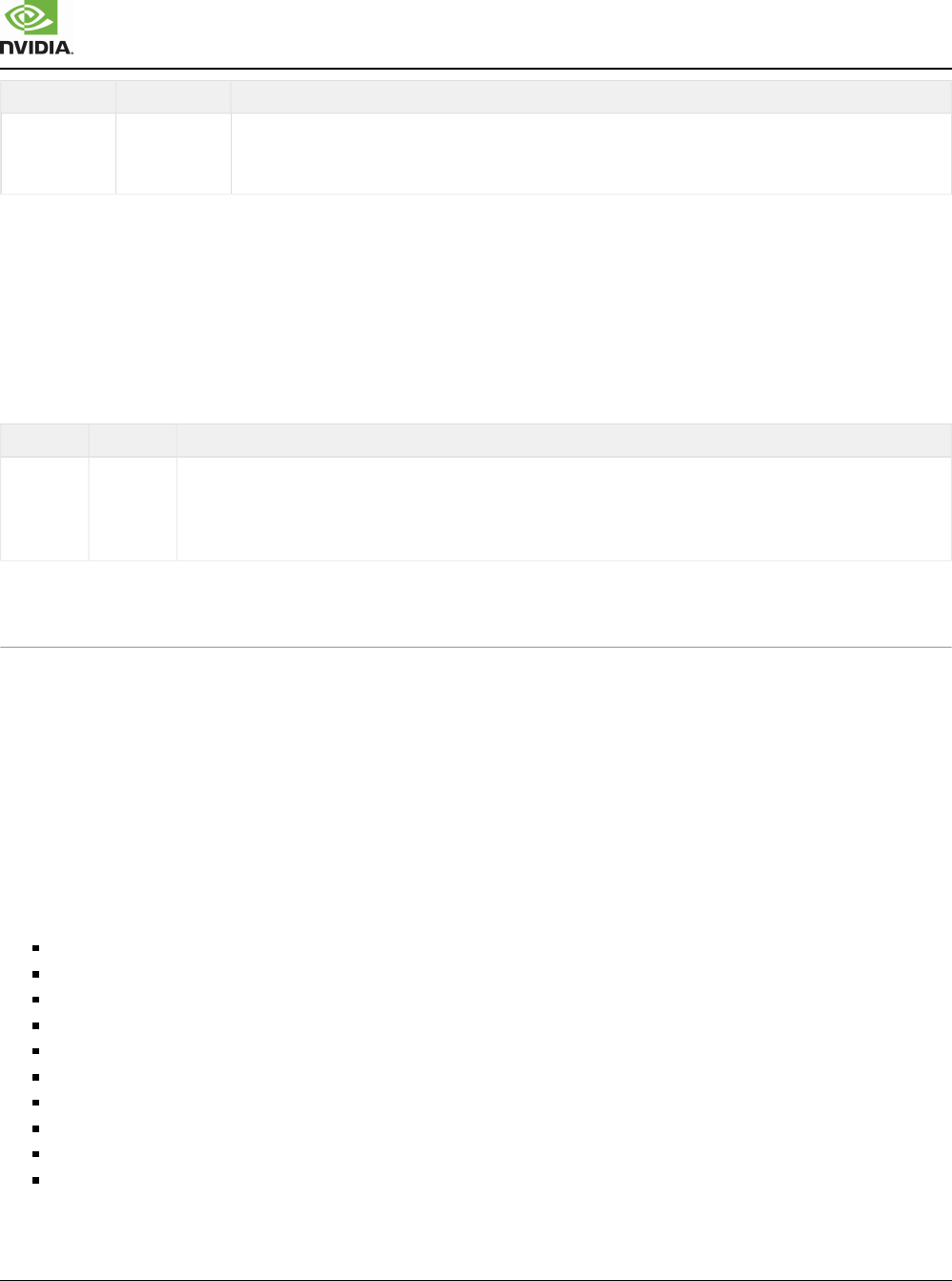
Xavier Series SoC Technical Reference Manual
XAVIER | TRM | DP-09253-002_v1.1 | SUBJECT TO CHANGE | www.nvidia.com Page of 6026 8287
Bit Reset Description
MAP:
Represents the set of enabled events.
Enable map is under control of masters allowed to read the timestamp
GTE_INTR_CTLR_SLICE10_TETDIS_0
Offset: 0x184
Read/Write: R/W
Parity Protection: N
SCR Protection: TEDSCR_0
Reset: 0x00000000 (0b0000,0000,0000,0000,0000,0000,0000,0000)
Bit Reset Description
31:0 0x0
MAP:
Represents the set of disabled events
Disable map is assumed to be frozen during system configuration to enforce visibility rules, i.e., taking the
security model into account to hide certain signals from certain masters
8.4 Multi-Purpose I/O Pins and Pin Multiplexing (PinMux)
8.4.1 Overview
The Xavier series SoC pad-ring is a compilation of pads, custom cells, and related test logic along the periphery
of the die. This chapter discusses the features and capabilities of the Multi-purpose I/O (MPIO) pads, and how
to configure their multiplexing so that the same group of MPIO's can serve multiple functions for different
applications, hence Pin Multiplexing (PinMux).
Scope of this chapter:
MPIO pad types
MPIO pad controls
Pad control units
MPIO pad features such low power, back drive
Low power features of MPIO pads
PinMux scheme
Generic programming considerations of pad controls
Default pin states and pull up/down selection
Misc system arch aspects applicable to MPIO pads
Registers for PinMux selection, I/O capabilities including electrical control settings.
PinMux allows a single MPIO pad or a group of MPIO pads to be used by multiple low-speed I/O controllers,
including the GPIO controller. Depending on the platform use case, the PinMux logic can be programmed

Xavier Series SoC Technical Reference Manual
XAVIER | TRM | DP-09253-002_v1.1 | SUBJECT TO CHANGE | www.nvidia.com Page of 6027 8287
1.
2.
3.
/configured to allow any specific controller the exclusive use of the assigned MPIOs. The configuration is static
and determined by Xavier system platform requirements. With Pin Multiplexing, the total number of I/Os
required for Xavier can thus be optimized.
The PinMux scheme include multiple groups of MPIO pads, each of which is shared by a number of low-speed I
/O controllers, including the GPIO controller. A Pad control unit with configuration registers is associated with
each of these MPIO pads groups to achieve the following:
PinMux selection (selecting specific controller for its exclusive use of the group of MPIO pads)
I/O capabilities of the MPIO pads group
Electrical settings of the MPIO pads group
Notes:
Details of the MPIO pads are not discussed except for their usage and features.
Refer to the corresponding chapters of the various Low-speed Interfaces which are connected to the PinMux logic for
specific programming sequences.
High-Speed I/O (HSIO) interfaces such as PCIe, USB3.x, SATA, UFS, and SLVS do not use MPIO pads, do not
support pinmuxing, and are not discussed in this chapter. Refer to the HSIO Cluster chapter and related HSIO
Complex chapters for related features and programming guidelines.
The following diagram illustrates how PinMux multiplexes different Xavier I/O signals (UART, I S, SPI, and
2
PWM) to use one common MPIO pad (group).
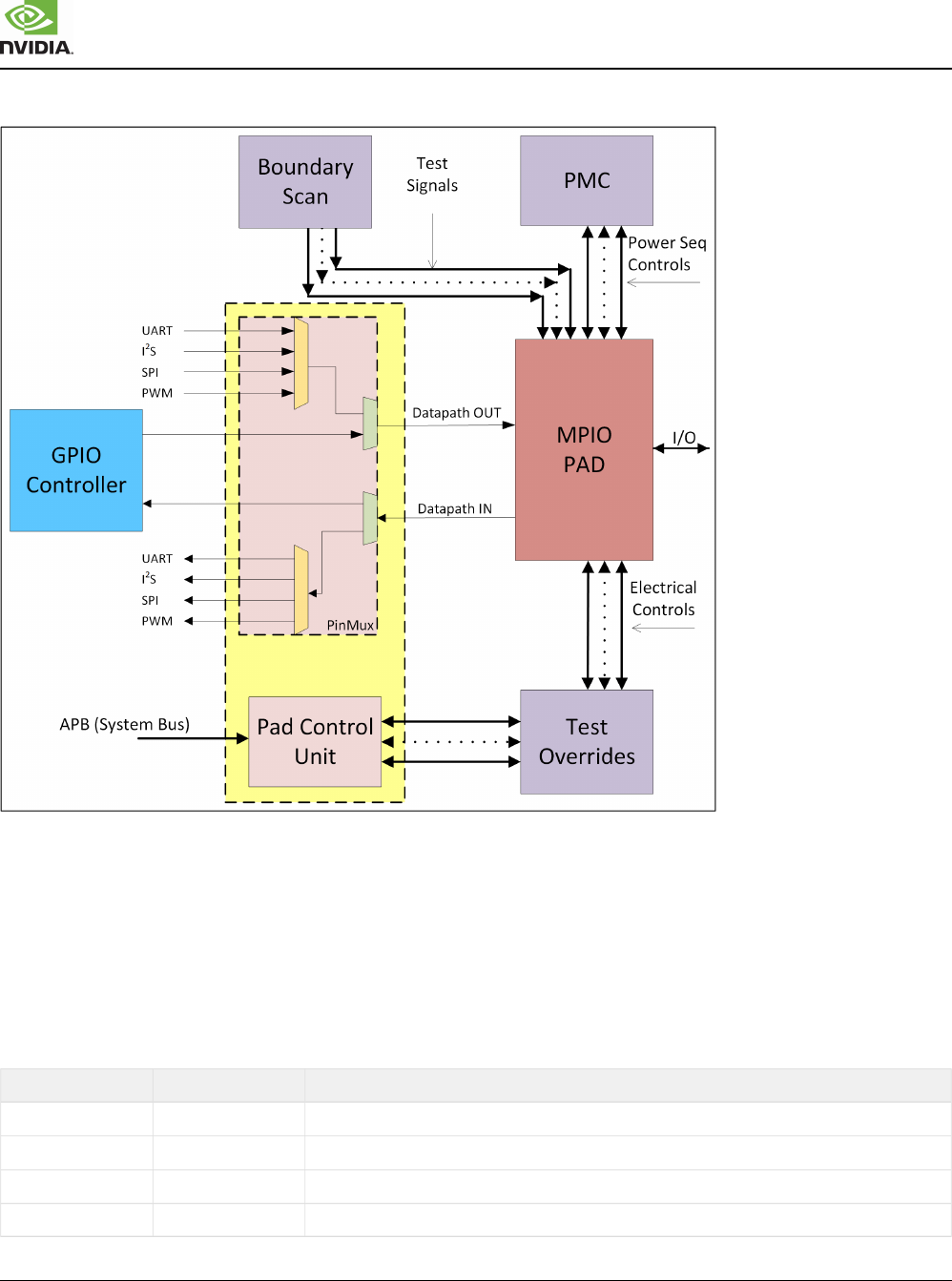
Xavier Series SoC Technical Reference Manual
XAVIER | TRM | DP-09253-002_v1.1 | SUBJECT TO CHANGE | www.nvidia.com Page of 6028 8287
Figure 8.20 PinMux Illustration
Standard and Compatibility
Xavier's MPIO pads used in Pin Multiplexing support various low-speed interfaces as well as control sidebands
for high-speed interfaces. Each of the MPIO pad types is designed to comply with the interface standards
including their electrical specifications. The table below lists the MPIO pad types and the interfaces they
support.
Table 8.28 MPIO Pad Types and Their Supported Interfaces
MPIO Pad Type MPIO Pad Name Supported Interfaces/Devices
ST BDPGLP
UART, SPI, I S, Various peripheral sideband GPIOs
2
CZ BDSDMEM
SD, SDIO, EMMC, I S, CAN
2
DD BDPGLPHVIN
I C, PCIe sidebands, SPI, UART, DP-AUX sidebands, HDMI CEC, USB VBUS controls
2
LV_CZ BDSDMEMLV QSPI, RGMII, UFS sidebands

Xavier Series SoC Technical Reference Manual
XAVIER | TRM | DP-09253-002_v1.1 | SUBJECT TO CHANGE | www.nvidia.com Page of 6029 8287
MPIO Pad Type MPIO Pad Name Supported Interfaces/Devices
JT_RST BILPRST JTAG
For details of how these supported standards are implemented in Xavier, refer to the relevant LSIO and HSIO
chapters in this TRM.
Glossary
Note that different names may end up in the same acronym when the entire Xavier TRM is put in perspective.
The acronyms listed here are within the context of the Multi-Purpose I/O Pins and Pin Multiplexing chapter.
Term Definition
AON I/O Rails I/O rails VDDIO_SYS,VDDIO_AO and VDDIO_AO_HV serving as AON cluster logic are referred as AON I/O rails
CZ Controlled Impedance Pad
DD Dual Driver CMOS Pad
DPD Deep Power Down (Pad Low-Power Mode)
GPIO General Purpose I/O
HPD Hot Plug Detect
HSIO High-Speed I/O
LSIO Low-Speed I/O
LV Low Voltage Pad
MPIO Multi Purpose I/O
OD Open Drain/Over Drive
PAD Group Collection of pads sharing the same I/O supply/power ball
Padlet Logical group of pads sharing I/O voltage along with pad control registers, PinMux logic, test logic such as -
boundary scan, etc.
SFIO Special Functional I/O (indicating that the specific I/O pin meant for some functional interface connected with
Hardware IP controller)
ST Standard CMOS Pad
Relevant Chapters in the TRM
Address Map
Controller Area Network (CAN)
Clock Controller and Reset (CAR)
Hardware Safety Manager (HSM)
High-Speed I/O Cluster (HSIO)
I C Controller
2
MIPI M-PHY (MPHY)
Memory SubSystem (MSS)
NVLink Complex (NVLink)

Xavier Series SoC Technical Reference Manual
XAVIER | TRM | DP-09253-002_v1.1 | SUBJECT TO CHANGE | www.nvidia.com Page of 6030 8287
PCIe Complex (PCIe)
Pulse Width Modulation (PWM)
Quad Serial Peripheral Interface (QSPI)
SATA Complex (SATA)
Serial Peripheral Interface (SPI)
SD and MMC Controller (SDMMC)
Universal Asynchronous Receiver/Transmitter (UART)
Universal Flash Storage Complex (UFS)
USB Complex (USB)
MPIO Pad Features
PinMux MPIO pads
Output Driver
Tri-state capability
Drive strength controls
Push-pull mode, Open-drain mode, or both
Input Receiver
Schmitt mode, CMOS mode, or both
Weak pull-up and weak pull-down
Table 8.29 MPIO Pad Types
Pad/PHY
Type
I/O Rail
Voltage
Input
Buffer
Output Buffer I/O Voltage
Tolerance
Nominal Pull
Strength
Slew Rate
Control
Drive
Strength
Control
Pad Name
ST 1.8V Schmitt
and
CMOS
Push-pull and
open drain
(emulation
mode)
VDDIO 100 K ±15% No 5-bits, up
and down
BDPGLP_*
CZ 1.8/3.3V Schmitt
and
CMOS
Push-pull VDDIO 20 K ±35% 2-bits, up
and down
7-bits, up
and down
BDSDMEM_*
DD 1.8V Schmitt
and
CMOS
Push-pull and
Open Drain
3.3V for
Open Drain,
VDDIO
otherwise
100 K No 5-bits, up
and down
BDPGLPHVIN_
*
LV_CZ 1.8 V/1.2V Schmitt
and
CMOS
Push-pull VDDIO 18 K ±30% 2-bits, up
and down
5-bits, up
and down
BDSDMEMLV_
*
The Standard (ST) MPIO pads are the most common pads on the chip. They are used for typical General
Purpose I/O, and various slow speed interfaces.

Xavier Series SoC Technical Reference Manual
XAVIER | TRM | DP-09253-002_v1.1 | SUBJECT TO CHANGE | www.nvidia.com Page of 6031 8287
The Dual-driver (DD) MPIO pads are like the ST pads with the additional provision of tolerating I/O swing up to
3.3V as long as the pad’s output-driver is set to open-drain mode. There are special power-sequencing
considerations when using this functionality to ensure the pads operate without any damage/reliability issues.
They are used for open drain mode interfaces – I C, USB VBUS, PCIe side bands, HDMI CEC and Display
2
HPD signals.
The Controlled output impedance (CZ) MPIO pads are optimized for use in applications requiring tightly
controlled output impedance. They are like ST pads except for changes in the drive strength circuitry and in the
weak pull-ups/-downs. Circuitry within Xavier continually matches the output impedance of the CZ pads to the
on-board pull-up resistors attached to the CZ_COMP pad.
The Low Voltage Controlled Impedance (LV_CZ) pads are like CZ pads but optionally support for use with a 1.2
V supply voltage (and signaling level).
Special Purpose Pad Types
Beyond pad types covered so far, we have some special purpose pads used for targeted purpose. Note these
special purpose MPIO pads are different from PHYs used for high speed differential interfaces like USB,
Display etc.
Table 8.30 Special Purpose Pad Types
Pad I/O Rail
Voltage
Functional
Name
Brief Description Pad Name
MEM_COMP 1.8/3.3V SDMMC
Calibration
Pads
Used for generating PVT compensated impedance calibration code for
the SDMEM pads (typically used for interfacing SDMMC devices). It is
connected to GND external reference resistor of 50 Ohm with ± 1%
variation.
BDSDMEMCOMP_
*
MEMLV_COM
P
1.8V eMMC
Calibration
Pads
Same as MEM_COMP but can operated at lower I/O voltage. BSDMEMLVCOMP
_*
JT_RST 1.8V JTAG and
Reset
Pads
(Input
Only)
Used for JTAG (except JTAG TDO) and Reset interface.
Has a special mode of operation called VDD only mode where in the
pad becomes operational without having the I/O rail up. This mode of
operation is needed for Reset pads which must propagate the reset
before I/O rails are up. This is achieved by Logic0 tie-off to
RCVR_SEL pin of this pad.
Beyond SYS_RESET_N pin, JTAG pin, JTAG mode selection pins
also follow similar usage with tie-off to RCVR_SEL pad input.
BILPRST_*
MPIO Pad Variations
Within each standard MPIO pad types there are variations that are mainly associated with the way how pads
behave during DPD mode and availability some specific features in DPD. There are three distinct types of

Xavier Series SoC Technical Reference Manual
XAVIER | TRM | DP-09253-002_v1.1 | SUBJECT TO CHANGE | www.nvidia.com Page of 6032 8287
variations in each type. Based on the functional and power choices appropriate Pad type shall be chosen for
each pin.
Table 8.31 MPIO Pad Variations
S.No Input
Receiver in
DPD
Output
Values
PU/PD
Availability
During DPD1
Pad Type
Extension
Usage
1 ENABLED DYNAMIC YES VDP1P1P1
2
Used for pins that need to be active when core supply
VDD_SOC = OFF
2 ENABLED STATIC YES VDVXP1P1
P1
Used for pins that need to be active during chip DPD power
states.
Since the input receive is enabled, can be used for pins
used Wake events.
Lesser leakage power than *VDP1P1P1 type pads since
only input receive logic is active.
3 DISABLED STATIC YES VXVDP1P1
P1
3
Since receiver is DISABLED can’t be used for signals acting
as Wake events
Consumes less leakage power of all pad variants as even
input receiver circuits are also in disabled state.
4 N/A N/A N/A R90 Pad physical orientation is North-South, default pad type
orientation is West-East.
Note 1: For DD pads PU is not available in DPD by nature of the pad.
Note 2: This variation is available only in BDPGLP_*, BDPGLPHVIN_*, BILPRST_* pads. These pads do have
DPD latching circuit like VDVXP1P1P1 pad type and support entering in to DPD mode with SEL_DPD/E_DPD
sequencing. We (earlier Xavier Arch) choose this way rather than removing the DPD latching and circuitry to be
able to have flexibility to park in a state during DPD. So structurally VDP1P1P1 and VDVXP1P1P1 pads are
same and the power domain of core side inputs is the only difference from usage POV.
Note 3: The pad type BDSDMEM_* and BDSDMEMLV_ deviates from the general MPIO pad type variation.
These types of pads have single VXVD pad type with wake capability selection through an additional pin.
When additional input pin “WAKE_PAD” tied to 1, it behaves like VDVX pad with input receiver enabled for
wake functionality.
When additional input pin “WAKE_PAD” tied to 1, it behaves like VXVD pad with receiver disabled.
MPIO Pad Low-power Modes and Features
Following is the summary of different power modes of the MPIO pads.

Xavier Series SoC Technical Reference Manual
XAVIER | TRM | DP-09253-002_v1.1 | SUBJECT TO CHANGE | www.nvidia.com Page of 6033 8287
Table 8.32 MPIO Pad Low-power Modes and Features
Mode Rail Status and DPD
Control Setting
Description Usage Remarks
OFF I/O Rail – OFF
VDD_RTC – OFF
VAUX_CORE – OFF
Control Inputs –Don’t
Care
Pad circuits are fully
OFF and non-
functional and
consuming zero
power.
System OFF
states
STANDBY-
NORETENTI
ON
I/O Rail – OFF
VDD_RTC – ON
VAUX_CORE – OFF
E_DPD =1
SEL_DPD=1
Pads circuits are OFF
except for the
VDD_RTC portion of
the circuit.
Consumes minimal
leakage in the always-
on [AO] portion of the
circuit operating in
VDD_RTC.
SC7 State Specific Interface’s I/O rail can be turned OFF
and no I/O state is retained.
Since the core rail is OFF, E_DPD and
SEL_DPD should be at Logic1.
STANDBY I/O Rail – ON
VDD_RTC – ON
VAUX_CORE – OFF
E_DPD =1
SEL_DPD=1
Pads are holding the I
/O state but core rail is
OFF and hence
consuming minimal
power.
SC7 State I/O states are retained through holding latches
inside the pads
LOGICAL
DPD
I/O Rail – ON
VDD_RTC – ON
VAUX_CORE – ON
E_DPD =0
SEL_DPD=1
Pads are holding the I
/O state but core rail is
not OFF and hence
consuming normal
power.
Transitory state
and I/O values
are retained.
No power benefit in this mode since core rail is
ON. However, software can possibly go through
this state as and when the interface is becoming
IDLE to reach the STANDBY state
It happens with software sequences for power
saving to DPD state.
LOGICAL
DPD- I/O
OFF
I/O Rail – OFF
VDD_RTC – ON
VAUX_CORE – ON
E_DPD =0
SEL_DPD=1
Pads are not holding
the I/O state but core
rail is not OFF and
hence consuming
normal power.
Transitory state
and I/O Values
are not retained.
Used by the software to transit from STANDBY-
NO RETENTION to Functional Status Inactive
state.
INACTIVE
I/O Rail – OFF
VDD_RTC – ON
Pads are functional
from Core side but I/O
rails are kept OFF
This happens when I/O rails are powering up
time windows during system active-low power
states.

Xavier Series SoC Technical Reference Manual
XAVIER | TRM | DP-09253-002_v1.1 | SUBJECT TO CHANGE | www.nvidia.com Page of 6034 8287
Mode Rail Status and DPD
Control Setting
Description Usage Remarks
VAUX_CORE – ON
E_DPD =0
SEL_DPD=0
Transitory state
needed to for
transitioning to
low power states.
FUNCTIONA
L/
ACTIVE
I/O Rail – ON
VDD_RTC – ON
VAUX_CORE – ON
E_DPD =0
SEL_DPD=0
Normal mode and
pads consume both
Static and Dynamic
power
Normal functional
usage
MPIO Pad Electrical Control Features
General purpose pads support features to cater electrical requirements of multiple slow speed interfaces and
GPIO pins. Following provides list of such features common to all MPIO pads. Further complete list of electrical
features by pad type are covered in Electrical Controls section.
Weak Pull-up: I/O driver pulls up the line irrespective of pull-up resistor on board.
Maps to PUPD bit field in pad control register.
Weak Pull-down: I/O driver pulls down the line irrespective of pull-up resister on board.
Maps to PUPD bit field in pad control register.
Programmable Output pull-up/pull-down drive strength: Enables to program different drive strengths required by
different external bridges, codecs, and such devices in the system.
Maps to CFG_CAL_DRVUP/DN fields in pad control register.
Schmitt receiver: Enables Schmitt receiver in input receiver circuit. Enabling Schmitt provides better noise margin
characteristics for the input and depending on driver’s logic threshold levels this can be enabled.
Maps to E_SCHMT bit field in pad control register.
Input receiver: Controls whether the input path (receiver portion of I/O driver) is enabled or not. Generally disabled for
most of the pads except those needed for boot.
Maps to E_INPUT bit field in pad control register.
pad output state: Top Level override to float Pad Output irrespective of the actual PinMux Control. Useful to get the
correct default values and while switching PinMux to GPIO mode of operation (though such switching is not
recommended in general).
Maps to TRISTATE bit field in pad control register.
TRISTATE = 0x0: i.e., Pad I/O driver is DRIVEN (Some of the critical pads typically PMIC interface pads, clock
pads etc., the Default status are driven to ensure correct values are driven to PMIC or external device)

Xavier Series SoC Technical Reference Manual
XAVIER | TRM | DP-09253-002_v1.1 | SUBJECT TO CHANGE | www.nvidia.com Page of 6035 8287
TRISTATE = 0x1: i.e., Pad I/O drive is FLOATED (actual value on the pad output depends on the Weak Pullup
/Pulldown control in the respective PUPD fields.
Boot Loader software enables this field to driven state before starts using the pad in output mode. Same applies
to peripheral interface drivers which shall configure pad control fields during the interface initialization. Other
than PMIC Interface related pads, Power On Reset default is FLOATED so that any unused pin comes with
OUTPUT FLOATED/Weak PU/PD state.
Electrical Controls
Below is summary of electrical controls of MPIO pads. All these electrical controls are configurable through pad
control registers. For more details of electrical controls or more pad types, refer to pad control registers.
Table 8.33 BDSDMEM Electrical Controls (BDSDMEM Variants)
Signal
Name
In/Out Power
Domain
Description
E_INPUT In VDD_SOC
/VDD_RT
C
Enables receiver path I/O ZI/TZI
E_SCHMT In VDD_SOC
/VDD_RT
C
Enables Schmitt trigger in the receiver
E_LPBK In VDD_SOC
/VDD_RT
C
Enables loopback mode A -> ZI/TZI
DRV_TYP
E_[0]
In VDD_SOC
/VDD_RT
C
1x/2x I/O driver selection
DRV_TYP
E_[1]
In VDD_SOC
/VDD_RT
C
Drive codes selection: COMP pad driven codes or pad default codes.
DRVUP_D
EF_[1:0]
In VDD_SOC
/VDD_RT
C
Back-up default driver output pull-up control code.
Applied Drive up/down codes - [0, 1, DRVUP_DEF [1], DRVUP_DEF[0], 0]
DRVDN_D
EF_[1:0]
In VDD_SOC
/VDD_RT
C
Back-up default driver output pull-down control code.
Applied Drive up/down codes - [0, 1, DRVDN_DEF [1], DRVDN_DEF[0], 0]
E_PULLU In VDD_SOC
/VDD_RT
C
Enables weak pull-up (20 K Ohm ±35%)
E_PULLD In VDD_SOC
/VDD_RT
C
Enables weak pull-down (20 K Ohm ±35%)
In

Xavier Series SoC Technical Reference Manual
XAVIER | TRM | DP-09253-002_v1.1 | SUBJECT TO CHANGE | www.nvidia.com Page of 6036 8287
Signal
Name
In/Out Power
Domain
Description
E_PBIAS_
BUF
VDD_SOC
/VDD_RT
C
Enables internally generated bias for driver PMOS in 3.3V mode. Selects strong driver with
internally generated 0.5*VDDP when VDDP is low and VCLAMP is High. Wrong setting
combination with VREF_SEL may cause electrical stress resulting in pad damage.
VREF_SE
L_[3:0]
In VDD_SOC
/VDD_RT
C
Select different bias levels for driver PMOS when (E_PBIAS_BUF == 1)
SCHMIT_
[1:0]
Schmitt trigger hysteresis window control
Note: VDD_SOC/ VDD_RTC power domain depends on VXVD (or VDVX)/VD* variant respectively.
Table 8.34 BDSDMEMLV Electrical Controls (BDSDMEMLV Variants)
Signal Name In/Out Power Domain Description
E_INPUT In VDD_SOC/VDD_RTC Enables receiver path I/O ZI/TZI
E_SCHMT In VDD_SOC/VDD_RTC Enables Schmitt trigger in the receiver
E_HSM In VDD_SOC/VDD_RTC Reserved.
Earlier – Enables high speed mode for the driver and receiver.
IO_RESET_N In VDD_SOC/VDD_RTC Reserved.
Earlier – Active low Reset to pad logic.
E_PREEMP In VDD_SOC/VDD_RTC Reserved.
Earlier – Pre-emphasis enable.
E_LPBK In VDD_SOC/VDD_RTC Enables loopback mode
DRV_TYPE_[0] In VDD_SOC/VDD_RTC 1x/2x I/O driver selection
DRV_TYPE_[1] In VDD_SOC/VDD_RTC Drive codes selection: COMP pad driven codes or default codes.
E_PULLU In VDD_SOC/VDD_RTC Enables weak pull-up (~18 K Ohm ±30%).
E_PULLD In VDD_SOC/VDD_RTC Enables weak pull-down (~18 K Ohm ±30%).
DRVDN_[7:0] In VDD_SOC/VDD_RTC I/O Driver Output Pull-Down drive strength code
DRVUP_[7:0] In VDD_SOC/VDD_RTC I/O Driver Output Pull-Up drive strength code
Note: VDD_SOC/VDD_RTC power domain depends on VXVD (or VDVX)/VD* variant respectively.
Table 8.35 BDPGLP, BDPGLPHVIN Electrical Controls (BDPGLP, BDPGLPHVIN Variants)
Signal
Name
In/Out Power Domain Description
E_INPUT In VDD_SOC
/VDD_RTC
Enables receiver path I/O ZI/TZI
E_SCHMT
In
Enables Schmitt trigger in the receiver

Xavier Series SoC Technical Reference Manual
XAVIER | TRM | DP-09253-002_v1.1 | SUBJECT TO CHANGE | www.nvidia.com Page of 6037 8287
Signal
Name
In/Out Power Domain Description
VDD_SOC
/VDD_RTC
E_LPBK In VDD_SOC
/VDD_RTC
Enables loopback mode A -> ZI/TZI
E_PULLU In VDD_SOC
/VDD_RTC
Enables weak pull-up (~100 K Ohm ±15%)
E_PULLD In VDD_SOC
/VDD_RTC
Enables weak pull-down (~100 K Ohm ±15%)
DRVDN[4:
0]
In VDD_SOC
/VDD_RTC
I/O Driver Output Pull-Down drive strength code
DRVUP[4:
0]
In VDD_SOC
/VDD_RTC
I/O Driver Output Pull-Up drive strength code
E_LPDR In VDD_SOC
/VDD_RTC
Disables most base driver fingers, leaving only minimal base driver finger. Enabled
for I C interface to meet slow rise/fall time spec of low speed modes.
2
E_IO_HV In VDD_SOC
/VDD_RTC
Enables open-drain pull-up capability to 3.3V. Enables 3.3V Receiver. Relevant for
BDPGLPHVIN* variant pad only.
Note: VDD_SOC/ VDD_RTC power domain depends on VXVD (or VDVX)/VD* variant respectively.
Table 8.36 BILPRST Electrical Controls (BILPRST_VD Variants)
Signal Name In/Out Power Domain Description
RCVR_SEL In VDD_RTC Selects between VDD-ONLY or VDD-AND-VDDP receivers.
0 => Selects VDD-ONLY Receiver
1 => Selects VDD-AND-VDDP Receiver
Power Sequence Controls
Power sequence controls are the specific controls to handle sequencing in and out of different power states a
MPIO pad supports.
Table 8.37 BDSDMEM Power Sequence Controls (BDSDMEMVD*, BDSDMEMVXVD)
Signal Name In/Out Power Domain Description
E_33V In VDD_RTC Selection of 1.8V/3.3V I/O output voltage swing.
SEL_DPD In VDD_TRC Latches state of I/O pin set by E_33V/E_PULLU/E_PULLD and data level shifters.
E_DPD In VDD_RTC Places pad in DPD mode by deactivating bias, clamping settings for DPD mode.
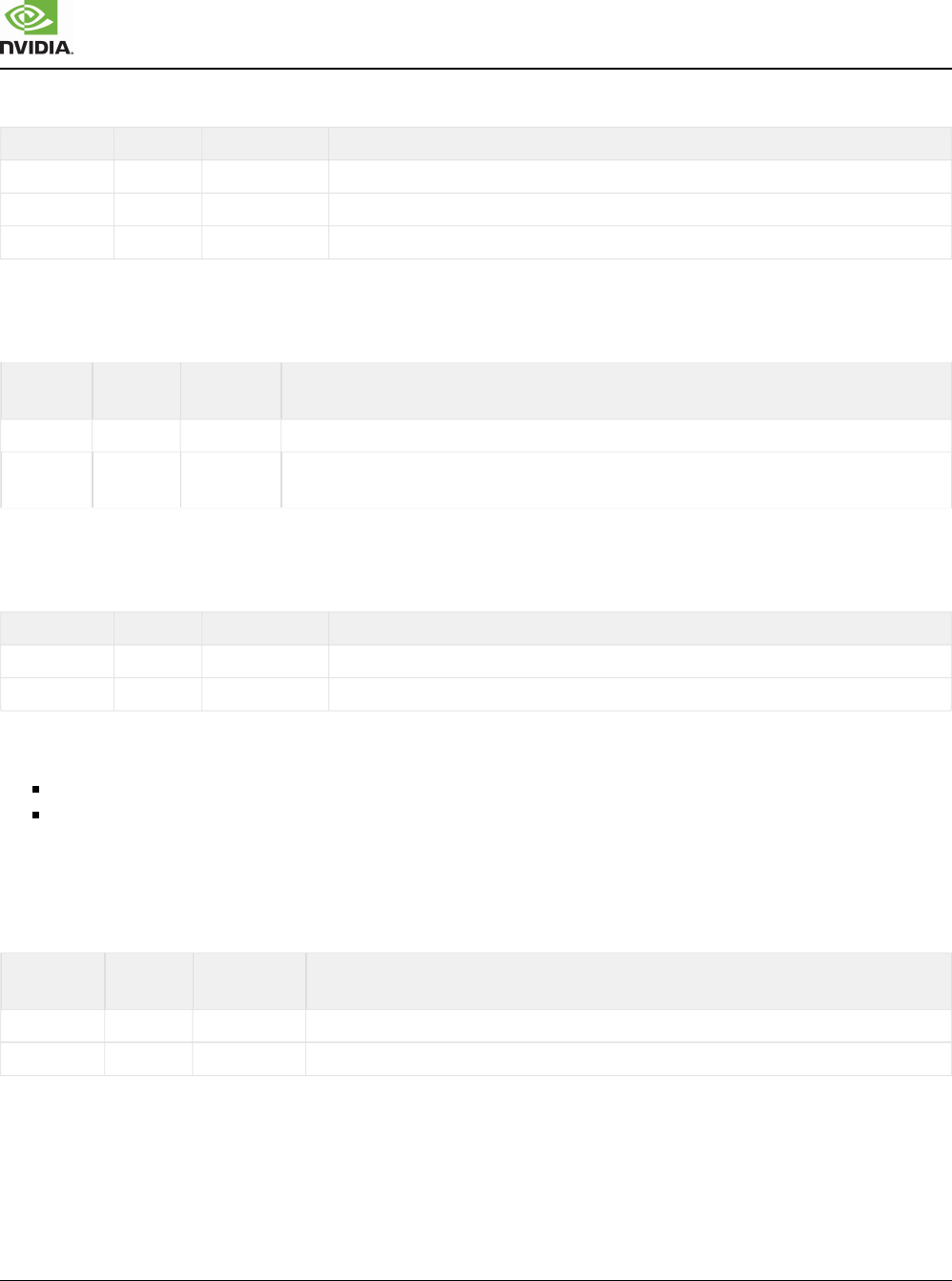
Xavier Series SoC Technical Reference Manual
XAVIER | TRM | DP-09253-002_v1.1 | SUBJECT TO CHANGE | www.nvidia.com Page of 6038 8287
Table 8.38 BDSDMEMLV Power Sequence Controls (BDSDMEMLV_VXVD)
Signal Name In/Out Power Domain Description
E_18V In VDD_RTC Selection of 1.8V/1.2V I/O output voltage swing.
SEL_DPD In VDD_TRC Latches state of I/O pin set by E_18V/E_PULLU/E_PULLD and data level shifters.
E_DPD In VDD_RTC Places pad in DPD mode by deactivating bias, clamping settings for DPD mode.
Table 8.39 EMMCIO_BRICK Power Sequence Controls (BDEMMC_IOBRICK)
Signal
Name
In/Out Power
Domain
Description
SEL_DPD In VDD_TRC Latches state of I/O pin set by E_18V/E_PULLU/E_PULLD and data level shifters. Disable Rx.
E_DPD In VDD_RTC Places pad in DPD mode by deactivating bias, clamping settings for DPD mode, and gating-
out inputs from core.
Table 8.40 BDPGLP Power Sequence Controls (BDPGLP_VD, BDPGLP_VDVX, BDPGLP_VXVD)
Signal Name In/Out Power Domain Description
SEL_DPD In VDD_TRC Latches state of I/O pin set by E_18V/E_PULLU/E_PULLD and data level shifters.
E_DPD In VDD_RTC Places pad in DPD mode by deactivating bias, clamping settings for DPD mode.
Notes:
For VD variants, all the pad inputs and outputs are in VDD_RTC power domain.
VDD_RTC/VDD_SOC power domain depends on VDVX/VXVD variant respectively.
Table 8.41 BDPGLPHVIN Power Sequence Controls (BDPGLPHVIN_VD, BDPGLP_HVIN_VDVX,
BDPGLP_HVIN_VXVD)
Signal Name In/Out Power
Domain
Description
SEL_DPD In VDD_TRC Latches state of I/O pin set by E_18V/E_PULLU/E_PULLD and data level shifters.
E_DPD In VDD_RTC Places pad in DPD mode by deactivating bias, clamping settings for DPD mode.
Notes: VDD_RTC/VDD_SOC power domain depends on VDVX/VXVD variant respectively.
Pad Control Unit
Pad control units are the APB clients with register banks for pad controls and PinMux selection. The pad
controls provide option to program the pad electrical characteristics depending on platform design and/or

Xavier Series SoC Technical Reference Manual
XAVIER | TRM | DP-09253-002_v1.1 | SUBJECT TO CHANGE | www.nvidia.com Page of 6039 8287
1.
2.
connected devices. Each pad control units consists of registers for multiple pads of a PAD group. The following
diagram shows the I/O of a Pad Control Unit.
Figure 8.21 Pad Control Unit and Its I/O
PinMux Scheme
The concept of PinMux logic is to share the same pin for multiple interfaces which aren’t active at the same time
in every platform. Sharing of pins using PinMux optimizes the number of pins required in SoC thus reducing the
cost of die. Xavier connects to various peripherals on different platforms, but not all peripherals in single
platform. Based on targeted market segment platform goals, we arrive at PinMuxing selection. Respective
platform software shall configure the pins at boot or post-boot stages prior to communication with related
peripheral devices.
PinMux option per pin consists of:
Sharing the pin with four different Special Functional I/Os (SFIOs) and one GPIO, i.e., a pin that is not required for
SFIO can be used by GPIO-driven software.
Override provision to float the pad outputs irrespective of the driving SFIO controller.
The Xavier PinMux Controller includes the logic and registers to select a pin for one of the four SFIO. The
following diagram shows the PinMux logic associated with a single MPIO pad. The diagram shows interface
with various units and polarity of the signals shown are at interface level. At pad level when ENB =1 the output
drivers are disabled.
List of PinMux IPs
The following table provides high level list of IPs connected with PinMux logic. Note that this also covers the
cases of interfaces which have only one SFIO usage (i.e., only one PinMux option) and possible to use as
GPIO pin. For signal level muxing details refer to Xavier customer PinMux sheet.

Xavier Series SoC Technical Reference Manual
XAVIER | TRM | DP-09253-002_v1.1 | SUBJECT TO CHANGE | www.nvidia.com Page of 6040 8287
Table 8.42 List of PinMux IPs
S. No Interface
Name/IO Rail
Brief Description PinMux Sheet Reference
1 SDMMC For Interfacing with WiFi modem etc or for the second
removable SD card.
SDMMC1, SDMMC3
2 EAVB Ethernet Audio Video Bridge EQOS
3 UART For connecting various peripherals like BT via UART and Audio
codec/FM etc via I S interfaces
2
4
I S
2
For various Audio Codec and Digital Speakers I2S1-I2S6
5 DMIC,
DSPKR, IQC
Digital Mic, Codec, DAB Interface DMIC1- DMIC5
DSPKR0, DSPKR1
IQC1, IQC2
6
I C
2
Inter Integrated Circult I2C1, I2C2, I2C3, I2C4, I2C5, I2C6,
I2C7, I2C8, I2C9, I2C10
7 QSPI QSPI interface QSP0*, QSPI1*
8 CAN Interface to the CAN PHY CAN0*, CAN1*
9 SPI Touch device, MCU connection, Serial Flash SPI*1, SPI2*, SPI3*
10 PWM Pulse Width Modulation PWM1-PWM8
11 DP-AUX DisplayPort Auxiliary DP_AUX_Ch0-3
Most of the PHYs for DP/HDMI, CSI/DSI interfaces don’t share the lanes with other protocols.
On the other hand, UPHY PHY supports multiple HSIO protocols USB3, UFS, PCIe, SATA, and CLVS-MC
(Sony Proprietary Camera interface). Depending on protocol usage of targeted platforms number of lanes,
number of PLLs, number of PCIe/USB3.0 controllers and related side bands is determined. For UPHY lane
sharing details of HSIO protocols refer to HSIO sections.
8.4.2 Functionality
Programmable Drive Strength Capabilities
This section summarizes the programmable drive strength capabilities of various pads in the granularity of pad
groups.
SDMEM pads which do not have calibration pad, do not have programmable drive strength registers. The
DRVUP_VCLAMP [6:0]/DRVDN_VCLAMP [6:0] codes are hard wired to corresponding power group VCLAMP and
GND respectively. Pins in below pad groups have 2-bit back up drive strength control.
AO_HV, AUDIO_HV

Xavier Series SoC Technical Reference Manual
XAVIER | TRM | DP-09253-002_v1.1 | SUBJECT TO CHANGE | www.nvidia.com Page of 6041 8287
SDMEMLV pads which do not have calibration pad, have programmable drive strength registers. Pins in below pad
groups:
UFS, EQOS
BDPGLP, BDPGLPHVIN pads which do not have calibration pads, have programmable drive strength registers. Pins
in below pad groups:
Rest all pad groups CONN, CAM etc. MPIO pad groups listed in customer PinMux sheet.
SDMEM pads which have calibration pad, drive strength driven by COMP pad and overriding and programmable
drive strength registers. Pins in below pad groups:
SDMMC1_HV, SDMMC3_HV
SDMEMLV pads which have calibration pad, drive strength driven by COMP pad and overriding and programmable
drive strength registers. Pins in below pad groups:
QSPI
Typical platform design goal is drive impedance is 50 Ohm for all the cases 1 through 5 above.
For all the pads that don’t have corresponding calibration pads (i.e., 1 to 3 above) the drive strength must be
programmed. Power On Reset default value in such cases typically works fine as the low interface speed and
trace design doesn’t need higher drive codes. Based on Si char tuned drive codes are recommended through
PROD flow which must be programmed by software as part respective interface initialization.
For all the pads having COMP pad (drive strength calibration) pad and hardware drive strength calibration logic,
respective interface initialization calls for drive strength calibration. Software must follow respective IP interface
initialization guides to ensure that drive strength calibration is done either one-time or periodic interval to
program the drive codes to compensate for PVT variation.
Pin-states and Default Pad Controls
Each of the Xavier I/O pin default pin-state is defined based on primary interface bus idle signal level
requirements. Other than functional interface pins, GPIO pins default pin-state is pull-down. There are few
exceptions like GPIOs used for button matrix require default pin-state to be pull-up to save external strong pull-
ups and platform cost. Ultimately, the Power On Reset field in the Xavier PinMux sheet captures this
information per pin including all the exceptions based on platform consideration.
Either during cold-boot or warm-boot power cycling, pin-states defaults to the reset values captured in the POR
field of the Xavier PinMux sheet. Following section provides the connection to reset types which has
implications to pin-states of pad controls.
Further, following per pin fields captured in the Xavier PinMux sheet are used to derive each pin pad control
field reset default values.
POR – Pin state at reset/power on.
Z (Pin tri-stated)
PU/1 (Pin pulled down)
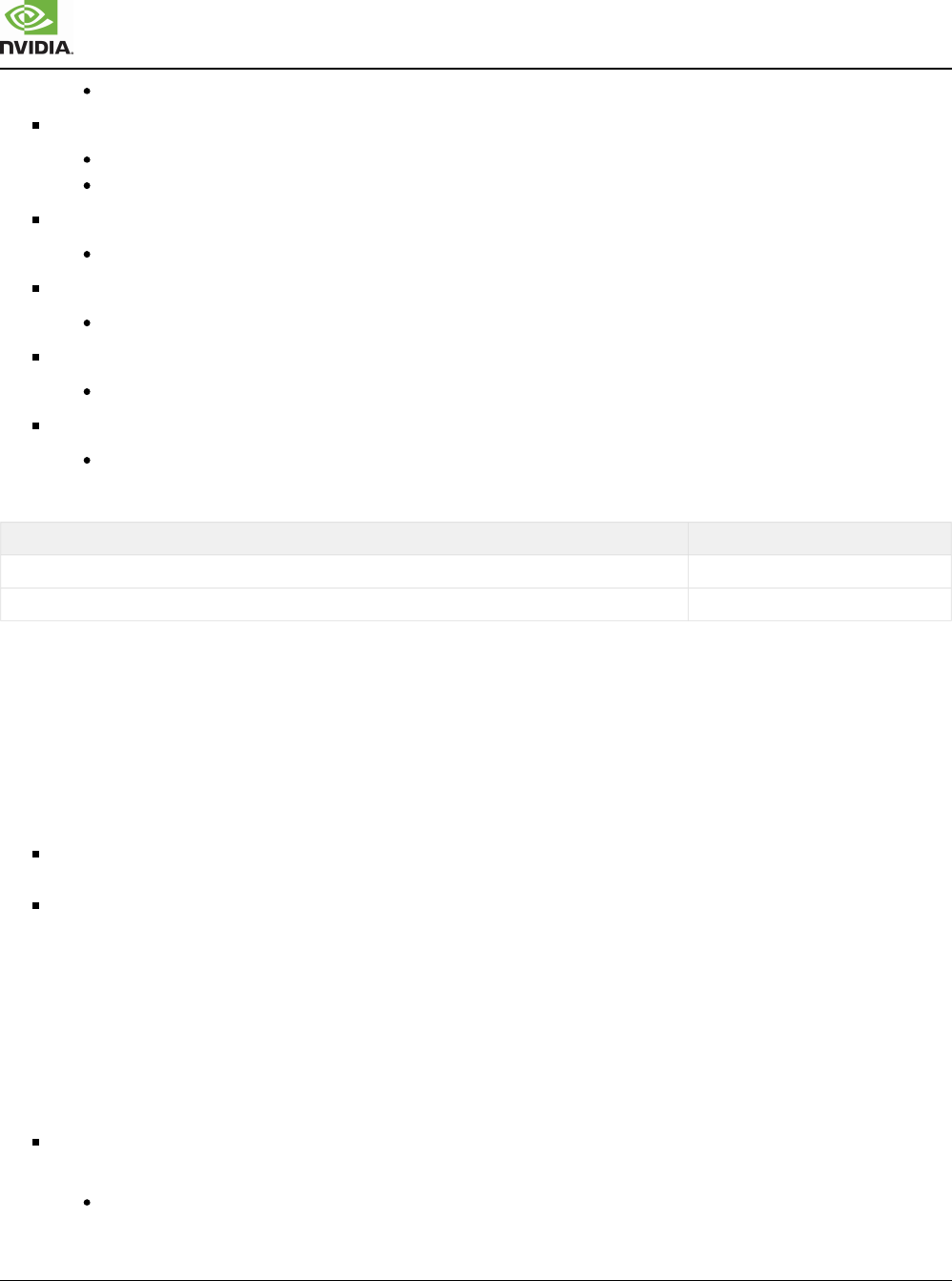
Xavier Series SoC Technical Reference Manual
XAVIER | TRM | DP-09253-002_v1.1 | SUBJECT TO CHANGE | www.nvidia.com Page of 6042 8287
PD/0 (Pin pulled up)
Tristate_en
Passthrough (Pin active, i.e., driven value for output; transparent for input)
Tristate (Pin tri-stated)
PU/PD
Pad control setting pull down/pull Up is enabled for pad internal weak pull-down or pull-up.
e_input
Pad control setting to enable input receiver path which is irrespective of pad I/O direction.
e_io_hv
Pad control setting to select for 3.3V tolerance. Applicable for BDPGLPHVIN, open-drain capable pads.
e_lpdr
Pad control setting to turn of drivers inside pad. Applicable for BDPGLP and BDPGLPHVIN pad types.
Table 8.43 Resets Impacting Pin-state
Pins Reset connection
All pads on I/O rails excluding VDDIO_PWR_CTL L2 warm reset
Pads on VDDIO_PWR_CTL L1 warm reset
For the pins in VDDIO_PWR_CTL all the pad control registers, associated GPIO logic works on L1 warm reset
unlike all MPIO pads in various other groups.
GPIO Pin-state, Pad Controls Managed by software
Apart from the pin-states, pad controls coming up as reset defaults, following two cases where software
manages the pin-state, pad control based on platform configuration.
GPIO/special purpose pins which are part of I/O rails that are active during SC7 power state transitions shall be
managed by software.
GPIO/special purpose pins which are not part of Always-on I/O rails but require different pin-state vs the default pin-
state are managed by software as per customer PinMux configuration in Customer PinMux.
Back Drive Capability
A limited set of Xavier I/Os are back drive capable - they can withstand being driven by external device when
Xavier is not powered, without damaging the I/O. Xavier MPIO back drive capabilities used as low speed
interfaces, these GPIOs are:
3.3V tolerant only when Xavier's 1.8V-rail is ready (E_IO_HV == 1), under these circumstances only they can tolerate I
/O to be 3.3V.
note that this means that an external pull-up to 3.3V is supported because Xavier back drive capable I/O not
can’t tolerate 3.3V when the Xavier 1.8V I/O rail is OFF.

Xavier Series SoC Technical Reference Manual
XAVIER | TRM | DP-09253-002_v1.1 | SUBJECT TO CHANGE | www.nvidia.com Page of 6043 8287
1.8V fail-safe. When Xavier is powered off, this I/O can be pulled-high-1.8V, without any back-drive current.
List of interfaces supporting back drive capability at VDDP 1.8V only:
UART, I C, SPI ports (not all ports)
2
GPIOs (not all GPIO pins)
Below is list of MPIO variant I/Os which are back drive capable. Exact list of interface devices mapping to these I
/Os usage varies across platforms. Refer to PinMux sheet for the same.
Table 8.44 List of Low-Speed Back Drive I/Os
Signal/Pin Names Pad Type I/O Rail group
AO_RETENTION_N BDPGLPHVIN_EFCR90M14L_VDP1P1P1 VDDIO_SYS
SAFE_STATE BDPGLPHVIN_EFCR90M14L_VDP1P1P1 VDDIO_SYS
SHUTDOWN_N BDPGLPHVIN_EFCR90M14L_VDP1P1P1 VDDIO_SYS
SPI2_SCK BDPGLPHVIN_EFCR90M14L_VDP1P1P1 VDDIO_AO
SPI2_MISO BDPGLPHVIN_EFCR90M14L_VDP1P1P1 VDDIO_AO
SPI2_MOSI BDPGLPHVIN_EFCR90M14L_VDP1P1P1 VDDIO_AO
SPI2_CS0 BDPGLPHVIN_EFCR90M14L_VDP1P1P1 VDDIO_AO
UART3_TX BDPGLPHVIN_EFCR90M14L_VDP1P1P1 VDDIO_AO
UART3_RX BDPGLPHVIN_EFCR90M14L_VDP1P1P1 VDDIO_AO
SOC_GPIO07 BDPGLPHVIN_EFCR90M14L_VXVDP1P1P1 VDDIO_CAM
SOC_GPIO40 BDPGLPHVIN_EFCR90M14L_VXVDP1P1P1 VDDIO_CAM
SOC_GPIO41 BDPGLPHVIN_EFCR90M14L_VXVDP1P1P1 VDDIO_CAM
SOC_GPIO42 BDPGLPHVIN_EFCR90M14L_VXVDP1P1P1 VDDIO_CAM
SOC_GPIO43 BDPGLPHVIN_EFCR90M14L_VXVDP1P1P1 VDDIO_CAM
SOC_GPIO44 BDPGLPHVIN_EFCR90M14L_VXVDP1P1P1 VDDIO_CAM
SOC_GPIO45 BDPGLPHVIN_EFCR90M14L_VXVDP1P1P1 VDDIO_CAM
UART1_TX BDPGLPHVIN_EFCR90M14L_VXVDP1P1P1 VDDIO_CAM
UART1_RX BDPGLPHVIN_EFCR90M14L_VXVDP1P1P1 VDDIO_CAM
UART2_TX BDPGLPHVIN_EFCR90M14L_VXVDP1P1P1 VDDIO_UART
UART2_RX BDPGLPHVIN_EFCR90M14L_VXVDP1P1P1 VDDIO_UART
SPI3_SCK BDPGLPHVIN_EFCR90M14L_VDVXP1P1P1 VDDIO_UART
SPI3_MISO BDPGLPHVIN_EFCR90M14L_VXVDP1P1P1 VDDIO_UART
SPI3_MOSI BDPGLPHVIN_EFCR90M14L_VXVDP1P1P1 VDDIO_UART
SPI3_CS0 BDPGLPHVIN_EFCR90M14L_VDVXP1P1P1 VDDIO_UART
SPI3_CS1 BDPGLPHVIN_EFCR90M14L_VDVXP1P1P1 VDDIO_UART
The following table provides summary of Xavier back drive capability and limitations including high speed and
low speed interfaces.

Xavier Series SoC Technical Reference Manual
XAVIER | TRM | DP-09253-002_v1.1 | SUBJECT TO CHANGE | www.nvidia.com Page of 6044 8287
Table 8.45 Xavier I/O Back Drive Summary
Pad/brick
Category
Usage Back Drive Support
PEX_CLK PCIe Clock output Not required (output only)
MIPI4X* CSI Yes. There is possibility of 5.5 mA transient leakage per CSI I/O pair
DP_SINGLE eDP/DP/HDMI Not required (output only)
DP_AUX Display Sideband
Yes. Not required in DP-AUX mode, I C mode has support.
2
DDR I/O brick LPDDR4X, LPDDR4 No.
U-PHY/NVHS PCIe, SATA, UFS, USB3.
0, NVLink
No, see below details for specific protocol usage.
PCIe, USB3.1: A/C coupled plus covered with discovery mechanism.
SATA: A/C coupled; No issue.
UFS: D/C coupled, but this is a host managed interface.
NVLink: managed interface.
REF_CLK pairs: okay by limiting the voltage swing to 0.8V/0.9V.
USB2 No. External pull-up or driving the I/O when Xavier is not powered causes EOS and
life time reduction. But USB compliant connector system do not result in such back-
drive scenario.
MPIO pads with
1.8V
Low speed I/O, Side
bands
Yes (Refer to the List of Low-Speed Back Drive I/Os)
MPIO pads with
3.3V
Low speed I/O, Side
bands
No. Need platform workaround solutions.
External Wake Events
External wake events are I/O state change(s), which are defined as triggers to notify the Xavier SoC power
management logic to indicate the type of action needed. For example, HDMI interfaces define a pin called Hot
plug detect (HPD), and wake event associated with it. Upon a hot plug-in connection of HDMI, the event is
notified as pin-state value change on HPD pin. We define number of such external wake events to cater
multiple platform use cases. Upon I/O state change, “wake engine” logic in PMC registers the event and triggers
power manager hardware. For more details on wake event programming model, wake processing capabilities
refer to PMC section.
Xavier I/O pin supposed to capable as “Wake pin” is indicated with wake event numbering in PinMux sheet.
GPIO Ports and Controller Mapping
The following is the GPIO controller to different GPIO port mapping. All GPIOs part of such marked pin group (e.
g., all UART pin group GPIOs are associated with GPIO_CTL2) associated with mapped GPIO controller.
GPIOs in PEX_CTL_2 pin group need NVHS0_DVDD power supply.

Xavier Series SoC Technical Reference Manual
XAVIER | TRM | DP-09253-002_v1.1 | SUBJECT TO CHANGE | www.nvidia.com Page of 6045 8287
GPIOs in SYS, AO, and AO_HV pin group are on VDD_RTC (Ungated always-on core power supply).
GPIOs in rest of the pin groups are on Ungated VDD_SOC core power supply.
Table 8.46 GPIO's in Different Pad Control Groups
GPIO Controller Pad Control Groups GPIO Ports
GPIO_CTL0 PEX_CTL_2 (on NVHS0_DVDD) GG
GPIO_CTL1 DEBUG, AUDIO_HV A, V, W
GPIO_CTL2 UART, EDP, CAM M, N, P, Q, R, X , Y, Z
GPIO_CTL3 PEX_CTL, UFS, AUDIO K, L, S, T, U, FF
GPIO_CTL4 CONN, QSPI, EQOS, PWR_CTL B, C, D, E, F, G, H, I
GPIO_CTL5 SDMMC3_HV, SDMMC1_HV J, O
GPIO_AON SYS, AO, AO_HV, (All on VDD_RTC) AA, BB, CC, DD, EE
DPD
DPD refers to Xavier pads Deep Power Down state which may be the case during SC7 and/or such Xavier low
power states. In SC7 scenario, SoC Power i.e. VDD_SOC (same as VAUXC_CORE/VDD_SOC) rail is cut off.
Pad DPD control signal SEL_DPD assertion enable the latches inside the pad to store pad A/EN/E_PULLU
/E_PULLD pad controls. If I/O rail is on, latched values are driven out during SC7. So, the Xavier i/o state prior
to entering to SC7/low power state is retained while the pad is in DPD mode.
Essentially, I/O DPD sequencing on/off consists of:
Pads DPD mode handled by IP/PMC hardware managed.
I/O or core rail power on/off managed by software in combination with platform power tree design.
SC7 is a low-power/standby state in which Xavier maintains much of its I/O state while most of the core logic is
powered off. It’s possible that pads are transitioned in to DPD mode in many other scenarios beyond Xavier
SC7 and shall not be inferred as one-to-one correspondence. For example, some pads in DPD mode may be
completely powered down including i/o rails while others still powered. External wakes, platform back drive
usage cases are platform variant.
MPIO Pad DPD Sequence
Following diagram sequencing, timing relations of power sequence signals that are necessary to transition a
MPIO pad transition in and out of DPD mode. All MPIO pads follow same DPD sequence driven by PMC logic.

Xavier Series SoC Technical Reference Manual
XAVIER | TRM | DP-09253-002_v1.1 | SUBJECT TO CHANGE | www.nvidia.com Page of 6046 8287
1.
Figure 8.22 MPIO Pad DPD Sequence Diagram
DPD Controls and Mechanisms
Xavier pads and hardware support several types of DPD control mechanisms. Always-ON MPIO pads and non-
AON MPIO pads have different schemes of overriding during SC7 entry/exit. Override mechanism details to be
referred from DPD controls in PMC section, however below summary presents overview based on PMC
hardware implementation in different categories.
Categories of signals are:
Category of pads that don’t have DPD mode support at all. Pads that are associated with PMIC for system
initialization and Reset don’t enter DPD mode during SC7 are such examples.
Table 8.47 I/Os Not Supporting DPD
Type of DPD Capability I/Os Not Supporting DPD thus not Entering in DPD
PMC global DPD override support N/A
I/O rail category: AO or Non-AO Always-On I/O rail
Usage System reset and JTAG inputs
List of I/Os
SYS_RESET_N
NVDBG_SEL
JTAG_TRST_
JTAG_TMS
JTAG_TCK

Xavier Series SoC Technical Reference Manual
XAVIER | TRM | DP-09253-002_v1.1 | SUBJECT TO CHANGE | www.nvidia.com Page of 6047 8287
1.
2.
3.
Type of DPD Capability I/Os Not Supporting DPD thus not Entering in DPD
JTAG_TDI
NVJTAG_SEL
Category of pads that their DPD controls are tied off to 1’b0 with JTAG overrides. These are the set of pads that
should not go into DPD state because of their critical functional nature and power management.
Table 8.48 I/Os Not Entering DPD as Result of Tie-off
Type of DPD Capability I/Os Not Entering in DPD as Result of (SEL_DPD/E_DPD=0) Tie-off
PMC global DPD override support N/A
I/O rail category: AO or Non-AO Always-on I/O rail category
Usage System mgmt. (PMIC control), Clock inputs, JTAG output
List of I/Os SHUTDOWN_N
PMU_INT_N
SOC_PWR_REQ
CLK_32K_IN
JTAG_TDO
Category of pads that they have per pin DPD software controls. These are the set of I/Os in always-on I/O rails. Also,
these I/Os have per pin DPD override masks that enable to exclude the I/O from SC7 entry/exit PMC global DPD
sequencing.

Xavier Series SoC Technical Reference Manual
XAVIER | TRM | DP-09253-002_v1.1 | SUBJECT TO CHANGE | www.nvidia.com Page of 6048 8287
3.
Table 8.49 PMC DPD Control Specifics per I/O Names
Type of DPD Capability
I/Os which can enter in to DPD and have per pin DPD req control
PMC Global DPD Override Support Yes
I/O Rail Category: AO or Non-AO
Always-on I/O rail category
Usage
System mgmt. (Misc and thermal, notifications), LSIO ports – UART, SPI2, I C, and
2
CAN interfaces
List of I/Os and PMC DPD Control
Specifics
I/O Name
PMC DPD Control Name
TOUCH_CLK (PWM4) TOUCH_CLK
SAFE_STATE SAFE_STATE
VCOMP_ALERT VCOMP_ALERT
PWR_I2C_SCL PWR_I2C_SCL
PWR_I2C_SDA PWR_I2C_SDA
AO_RETENTION_N AO_RETENTION
BATT_OC BATT_OC
POWER_ON POWER_ON
SPI2_SCK SPI2_SCK
SPI2_MISO SPI2_MISO
SPI2_MOSI SPI2_MOSI
SPI2_CS0 SPI2_CS0
UART3_TX UART3_TX
UART3_RX UART3_RX
GEN2_I2C_SCL GEN2_I2C_SCL
GEN2_I2C_SDA GEN2_I2C_SDA
GEN8_I2C_SCL GEN8_I2C_SCL
GEN8_I2C_SDA GEN8_I2C_SDA
CAN1_DOUT CAN1_DOUT
CAN1_DIN CAN1_DIN
CAN0_DOUT CAN0_DOUT
CAN0_DIN CAN0_DIN
CAN0_STB CAN0_STB
CAN0_EN CAN0_EN
CAN0_WAKE CAN0_WAKE
CAN0_ERR CAN0_ERR
CAN1_STB CAN1_STB
CAN1_EN CAN1_EN

Xavier Series SoC Technical Reference Manual
XAVIER | TRM | DP-09253-002_v1.1 | SUBJECT TO CHANGE | www.nvidia.com Page of 6049 8287
3.
4.
CAN1_WAKE CAN1_WAKE
CAN1_ERR CAN1_ERR
Rest of MPIO pads which can be transitioned to DPD state by pin group wise DPD controls. All such I/Os go through
PMC global DPD sequencing during SC7 entry/exit irrespective of software DPD control programming.

Xavier Series SoC Technical Reference Manual
XAVIER | TRM | DP-09253-002_v1.1 | SUBJECT TO CHANGE | www.nvidia.com Page of 6050 8287
4.
Table 8.50 PMC DPD Control Specifics per I/O Group of Interface Names
Type of DPD Capability
I/Os which can enter in to DPD and
have per group DPD req control. Few
exceptions include per I/O or I/F
controls.
PMC Global DPD Override Support No
I/O Rail Category: AO or Non-AO
Non-AO I/O rail category
Usage Rest of LSIO ports, GPIOs
List of I/Os and PMC DPD Control
Specifics
I/O Group or Pin/Interface Name
PMC DPD Control Name
EQOS EQOS
SDMMC1_HV SDMMC1_HV
SDMMC3_HV SDMMC3_HV
SDMMC4 SDMMC4
QSPI SPI
CONN (excluding UART4, PWM5,
PWM6, PWM7 pins)
CONN
AUDIO (excluding DAP3 and DAP5
pins)
AUDIO
AUDIO_HV AUDIO_HV
DEBUG DBG
CAM CAM
PWR_CTL PWR_CTL
UART excluding UART5 interface,
PWM2, PWM3 pins
UART
UFS UFS
PEX_CTL excluding PEX_L0_RST_N
/PEX_L1_RST_N pins
PEX_CNTRL
PEX_CLK PEX_CLK1, PEX_CLK2, PEX_CLK3,
PEX_CLK_BIAS
PEX_CTL2 excluding PEX_L5_RST_N PEX_CTL_2
VDDIO_PEX_CLK_2 PEX_CLK_2, PEX_CLK_2_BIAS
HDMI_DP0 brick HDMI_DP0
HDMI_DP1 brick HDMI_DP1
HDMI_DP2 brick HDMI_DP2
HDMI_DP3 brick HDMI_DP3
EDP Excluding SOC_GPIO53 EDP
CSI bias pad MIPI_BIAS

Xavier Series SoC Technical Reference Manual
XAVIER | TRM | DP-09253-002_v1.1 | SUBJECT TO CHANGE | www.nvidia.com Page of 6051 8287
4.
5.
CSI per brick A CSIA
CSI per brick B CSIB
CSI per brick C CSIC
CSI per brick D CSID
CSI per brick E CSIE
CSI per brick F CSIF
CSI per brick G CSIG
CSI per brick H CSIH
I/O: PEX_L0_RST_N PEX_L0_RST_N
I/O: PEX_L1_RST_N PEX_L1_RST_N
I/O: PEX_L5_RST_N PEX_L5_RST_N
I/O: SOC_GPIO53 (DGPU_PWR_EN) SOC_GPIO53
I/O: GP_PWM2 GP_PWM2
I/O: GP_PWM3 GP_PWM3
I/O: SOC_GPIO12 (PWM5) SOC_GPIO12
I/O: SOC_GPIO13 (PWM6) SOC_GPIO13
I/O: SOC_GPIO10 (PWM7) SOC_GPIO10
I/F: UART4 interface pins UART4
I/F: UART5 interface pins UART5
I/F: DAP3 interface pins DAP3
I/F: DAP5 interface pins DAP5
Set of analog and high-speed interface pads. These are the cases of pads that may not have DPD mode like other
Xavier MPIO/GPIO pads, instead there is a power down mode which is used for low power mode. Some others have
DPD mode, but either way such DPD/Power down mode is not controlled by PMC during SC7 entry/exit, instead the
IP logic that is interfacing this has got appropriate clamps or managed to put the pad in low power state. List of such
high-speed I/Os are:
Display sidebands: BDDPAUX
Memory interface pads: LP4X_IOBRICK, LP4X_CDB, LP4X_COMP, and LP4X_RESET
USB2 interface pads: BDUSB2
USB2 bias pad: BDUSB2_BIAS
PCIe/SATA/NvMe/UFS, NVLink interface pads: UPHYDS_PLL4DS12, UPHYDS_PLL1DS8
Refer to respective I/O sections for details on low power management.
PEX_CLK Pad DPD Controls
PEX_CLK related DPD control manage two clock pairs, one each from each of x3 bricks due to legacy
implementation reasons. This section depicts the DPD software controls mapping to the physical bricks/lanes
and thus Xavier I/O's.
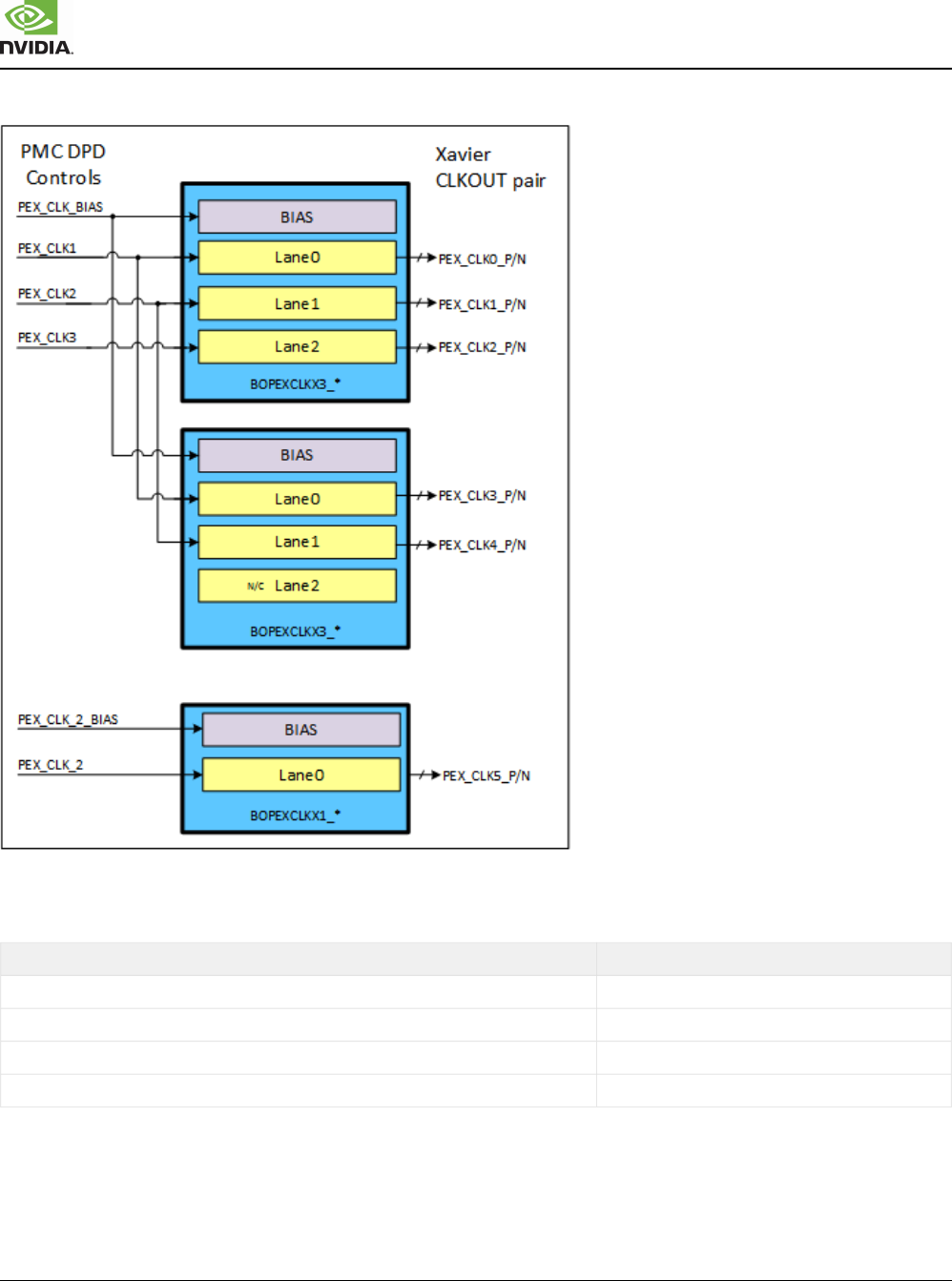
Xavier Series SoC Technical Reference Manual
XAVIER | TRM | DP-09253-002_v1.1 | SUBJECT TO CHANGE | www.nvidia.com Page of 6052 8287
Figure 8.23 PEX CLKOUT Pads Software DPD Control Mapping
For BOPEXCLK 3x pad instances PEX_CLK1/2/3 are the DPD controls.
Table 8.51 BOPEXCLK 3x DPD Control
BOPEXCLK 3x Corresponding DPD control
Instance1 E_DPD_0, Instance2 E_DPD_0 PEX_CLK1
Instance1 E_DPD_1, Instance2 E_DPD_1 PEX_CLK2
Instance1 E_DPD_2, Instance2 E_DPD_2 PEX_CLK3
Instance1 E_DPD_BIAS, INSTANCE2 E_DPD_BIAS PEX_CLK_BIAS
For BOPEXCLK 1x pad: Controls are PEX_CLK_2_BIAS and PEX_CLK_2.

Xavier Series SoC Technical Reference Manual
XAVIER | TRM | DP-09253-002_v1.1 | SUBJECT TO CHANGE | www.nvidia.com Page of 6053 8287
Table 8.52 BOPEXCLK 1x DPD Control
BOPEXCLK 1x Corresponding DPD control
E_DPD PEX_CLK_2
E_DPD_BIAS PEX_CLK_2_BIAS
8.4.3 Programming Guidelines
Some controller instances make their set of signals available on two or more sets of MPIO’s. To say it another
way, such controllers have more than one “interface.”
Note: Before using any controller, make sure that the PinMux registers are programmed to bring out the
controller’s signals on a maximum of one interface.
PinMux Programming
PinMuxing configurations are static. Pimuxing provides the flexibility to choose a pin for different function across
different platforms, but not to change them dynamically.
In specific cases, based on use case requirement it is needed to change a pin from SFIO to GPIO or vice versa.
Although PinMux selection dynamic changing is not supported, SFIO to GPIO or vice versa changes are
allowed. Subsection outlines the PinMux programming, SFIO/GPIO switching programming and such pad
control programming guidelines.
Changing a PinMux Selection
PinMux programming to select the pin function is part of respective I/O initialization. Below sequence are a
reference and confines to general purpose pad I/Os which are shared by multiple low speed interface
controllers (SFIO).
Ensure that all the interface controllers sharing the pins are in in-active state, so that possible glitches do not result
corruption in downstream logic.
Change the PADCTL_<padctl_group>_<ball_name> .PM value to desired I/O function enumerated per pin.
Initialize the respective SFIO controller and follow required SFIO interface programming guide.
Driving Source Change from SFIO to GPIO
Pads are by-default owned by SFIO Primary function or Alternative options can be switched as software driven
GPIO as follows:
Configure the pad’s GPIO specific registers for correct value for output mode with the correct value as specified in
GPIO section. This ensures the new source is ready with the correct value.

Xavier Series SoC Technical Reference Manual
XAVIER | TRM | DP-09253-002_v1.1 | SUBJECT TO CHANGE | www.nvidia.com Page of 6054 8287
Change the pad control register i.e. PADCTL_<padctl_group>_<Ball_Name>.GPIO_SF_SEL bit field register
corresponding a pin to 1’b0 for GPIO selection.
Follow the GPIO controller programming model depending on desired GPIO function as specified in GPIO section
(Input or output to a value or input with interrupt etc.).
Driving Source Change from GPIO to SFIO
Pads currently set up in GPIO mode may be switched back to SFIO function as follows:
Change the pad control register i.e., PADCTL_<padctl_group>_<Ball_Name>.GPIO_SF_SEL bit field register
corresponding a pin to “1” for SFIO selection.
Initialize the respective SFIO controller and follow required SFIO interface programming guide.
Programming Sequence for Input Mode
After cold boot based on platform configuration (typically obtained from the Boot Loader) different LSIO
functional controllers must be mapped to specific I/O pin. The following is the programming sequence for that:
Set PM field as per PinMux selection in pad control register PADCTL_<padctl_group>_<ball_name>_*.PM =
0x0: Primary
0x1: Alt1
0x2: Alt2
0x3: Alt3
Set SFIO/GPIO selection to SFIO selection, (PADCTL_<padctl_group>_<ball_name>_*.GPIO_SFIO_SEL =
HSIO) (nothing but SFIO).
Set (PADCTL_<padctl_group>_<ball_name>_* .TRISTATE = TRISTATE) to disable SoC functional logic
driving the I/O.
Set (PADCTL_<padctl_group>_<ball_name>_* .E_INPUT= ENABLE) to turn on input receiver.
The specific I/O controllers driving the I/Os is configured and activated.
Programming Sequence for Output Mode and Bi-directional Mode
Normal Push-pull Pad
Set PM field as per PinMux selection in pad control register PADCTL_<padctl_group>_<ball_name>_*.PM =
0x0: Primary
0x1: Alt1
0x2: Alt2
0x3: Alt3
Set SFIO/GPIO selection to SFIO selection, (PADCTL_<padctl_group>_<ball_name>_*.GPIO_SFIO_SEL =
HSIO) (nothing but SFIO).
Set (PADCTL_<padctl_group>_<ball_name>_* .TRISTATE = PASSTHROUGH) to enable selected SFIO
functional logic driving the I/Os.
Set (PADCTL_<padctl_group>_<ball_name>_* .E_INPUT = ENABLE) for bidirectional configuration, or
Set (PADCTL_<padctl_group>_<ball_name>_* .E_INPUT = DISABALE) for output only configuration
The specific I/O controllers driving I/O is thus configured and activated.
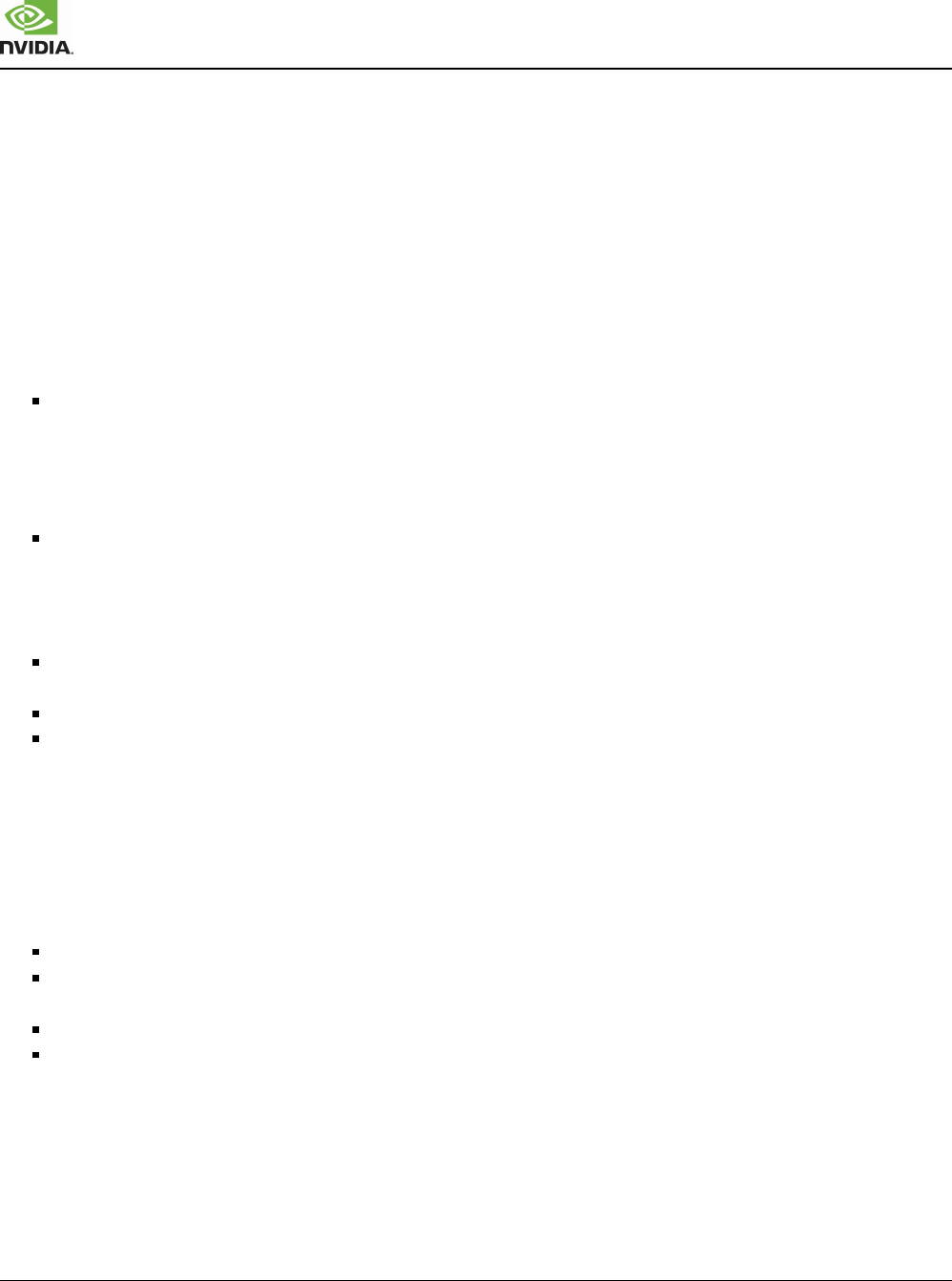
Xavier Series SoC Technical Reference Manual
XAVIER | TRM | DP-09253-002_v1.1 | SUBJECT TO CHANGE | www.nvidia.com Page of 6055 8287
Open-drain Pad
Open drain pads are used to emulate Wired-AND functionality, where in multiple drivers can be shorted on the
board with an external pull-up. These pads don’t drive active HIGH, instead it drives active LOW or float the pin.
Platform pull-up shall ensure correct value on the node i.e., if all the drivers are floating it is at Logic1 and if any
of the drivers are driving active LOW, bus state is at Logic0. Such pads require a different programming
sequence. So, any logic (both functional or software based GPIO) shall never the program/drive pads to Active
1. Both the ST pads and DD pads able to operate in open drain Mode. But the DD pads have specific control to
tolerate the I/O swing of 3.3V.
3.3V Tolerance and Open-drain Operation
Configure the pad for 3.3V swing tolerance by enabling the E_IO_HV pad control, i.e.
(PADCTL_<padctl_group>_<ball_name>_*.E_IO_HV = 1). Applicable to DD pads when it has to tolerate 3.3V levels.
Typically other than the PMIC interface, which is guaranteed to operate at 1.8V for all the other DD pads pad control
field E_IO_HV is set to 1 as reset default to ensure they come with 3.3V tolerance mode. E_IO_HV pad control must
be set to 1 before I/O can be pulled to > 1.8V.
Set (PADCTL_<pactcl_group>_<ball_ame>_*.TRISTATE = TRISTATE). Even when the functional logic driving
Logic1, the pad is in open drain driver mode and it is floated through an external pull-up. Enabling internal pull-up is
ignored by the pad when the E_IO_HV is set though this is not the recommended.
1.8V Tolerance and Open-drain Operation
To emulate open drain in 1.8V mode of operation: Platform design to float the pad with external pull-up or
program (PADCTL_<padctl_group>_<ball_name>.PUPD = PULLUP)
Configure the Pad for 1.8V swing tolerance by setting (PADCTL_<padctl_group>_<ball_name>.E_IO_HV = 0).
To drive High Impedance into the pad set (PADCTL_<pactcl_group>_<ball_ame>_*.TRISTATE = TRISTATE).
1.8V Tolerance/Driving and Push-pull Operation
Since DD pads can be operated in normal push pull mode as well as open drain mode to emulate the push pull
mode the following configuration is followed.
To put the open-drain pad in 1.8V push-pull mode operation:
Set (PADCTL_<padctl_group>_<ball_name>.E_IO_HV = DISABLE).
Set (PADCTL_<padctl_group>_<ball_name>_* .TRISTATE = PASSTHROUGH) to enable functional logic driving
/sampling the I/O.
Set (PADCTL_<padctl_group>_<ball_name>_* .E_INPUT = ENABLE) for bi-directional mode of operation.
The specific I/O controllers driving the I/O is configured and activated
Pad Control Programming
Set Pad to High Impedance State
To select the pad for drive high impedance state:

Xavier Series SoC Technical Reference Manual
XAVIER | TRM | DP-09253-002_v1.1 | SUBJECT TO CHANGE | www.nvidia.com Page of 6056 8287
1.
2.
3.
4.
1.
a.
b.
2.
Set (PADCTL_<padctl_group>_<ball_name>_* .TRISTATE = TRISTATE).
Ensure (PADCTL_<padctl_group>_<ball_name>_* .PUPD == 0) to ensure internal pull-up/pull-down is disabled.
Pad Controls Wrong Programming Causing Electrical Damage
E_PBIAS_BUF, VREF_SEL pad controls to SDMEM* pads
E_PBIAS_BUF and VREF_SEL programming should follow below rules as listed in cell document. For VDD33
and VDD18 in the same direction or high VDD33 along with low VDD18 case, follow the rules below to prevent
overstress.
When (VDD33 - 0.91 * VDD18 > 1.98V), E_PBIAS_BUF must be 0;
When (VDD33 - 0.83 * VDD18 > 1.98V) && (E_PBIAS_BUF = 1), VREF_SEL must < 1;
When (VDD33 - 0.77 * VDD18 > 1.98V) && (E_PBIAS_BUF = 1), VREF_SEL must < 2;
When (VDD33 - 0.71 * VDD18 > 1.98V) && (E_PBIAS_BUF = 1), VREF_SEL must < 3;
Pad Controls Sequencing Requirements
To avoid remote chances of leakage and long-term reliability E_33V need to be set before supplying 3.3V to the 1.8V
/3.3V dual voltage supported pads.
SDMMC1/SDMMC3 for removable card usage is covered by SD card voltage switching sequence.
For cases, the I/O voltage usage is limited to 1.8V pad control programming through Xavier
Customer PinMux is adequate.E_IO_HV=0 to be programmed by PinMux initialization driver for back drive capable I
/Os using BDPGLPHVIN pads. Otherwise, the pad remains in open drain mode and doesn't function as push-pull
driver.
Pad Control Settings per PinMux Selection
As these pad control settings are applicable only when a PinMux SFIO is chosen, it could be different from reset
default settings. Although these shall be covered in respective interface section programming guidelines, based
on platform requirements pad electrical settings are tuned via customer PinMux sheet. Software uses generated
files out of PinMux sheet for initialization during boot.
Unused I/O Programming
Unused general purpose I/Os in a platform may be left unconnected however pad controls must be set per
below guideline to avoid leakage and/or noise especially when I/O power supply is ON. Programming steps for
different I/Os is summarized as below.
Table 8.53 Unused I/O Programming with I/O Power Supply ON
PHY/BRICK PAD Control Programming requirement when I/O is unused but I/O power supply is ON
MPIO pads
Following is done by platform Xavier Customer PinMux. So required pad control programming is automatically done
through PinMux driver in MB1. No further software steps are needed.
TRI-STATE enable, (PADCTL_<power_group>_<IO>_0.TRISTATE = 1)
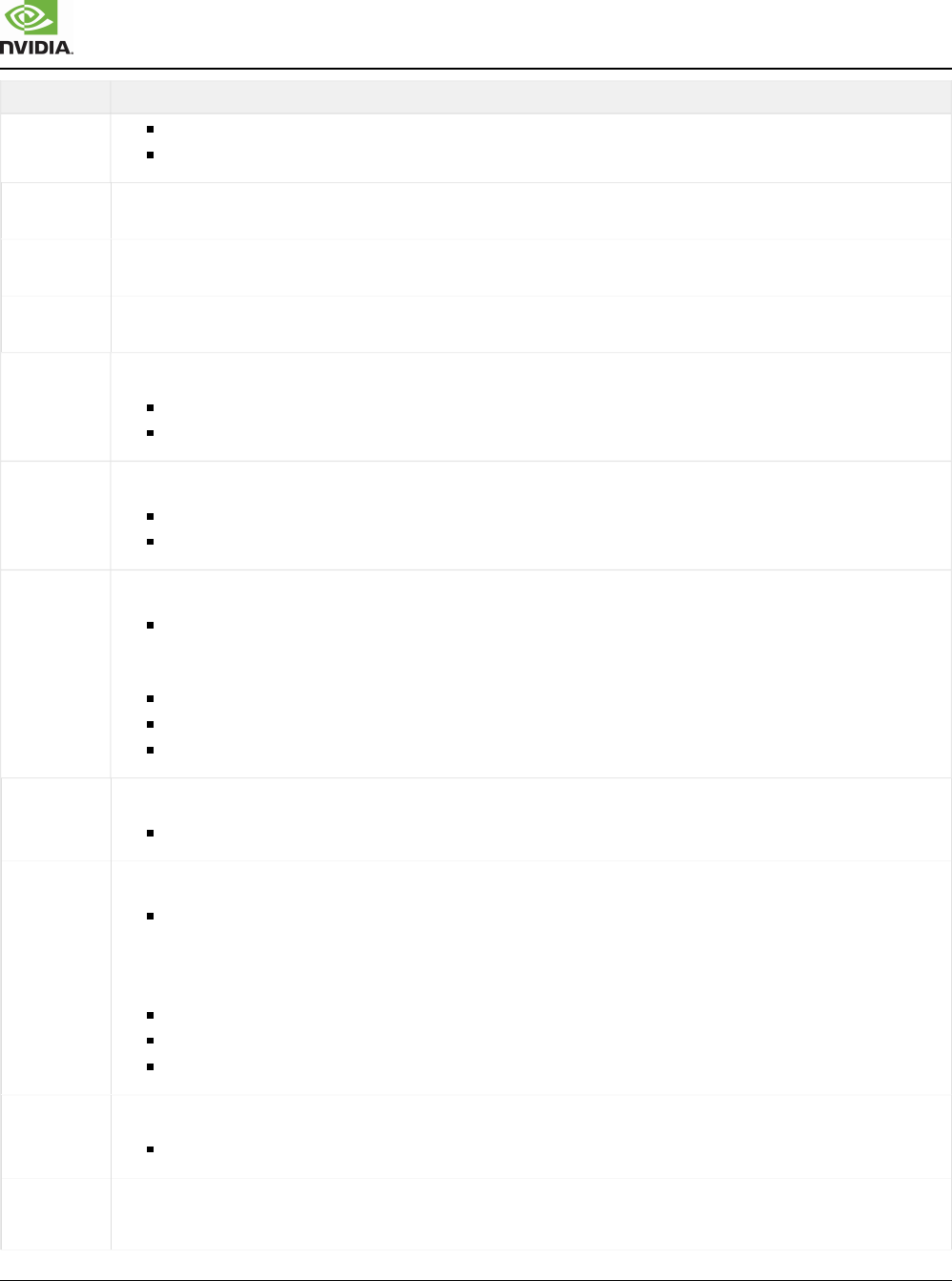
Xavier Series SoC Technical Reference Manual
XAVIER | TRM | DP-09253-002_v1.1 | SUBJECT TO CHANGE | www.nvidia.com Page of 6057 8287
PHY/BRICK PAD Control Programming requirement when I/O is unused but I/O power supply is ON
Input path disable, (PADCTL_<power_group>_<IO>_0.E_INPUT = 1)
Weak pull-down enable, (PADCTL_<power_group>_<IO>_0.PUPD = 1)
DDR I/O
Brick
Park the unused bricks in DPD mode as per the EMC programming guide.
DDR COMP
Pads
Park the unused bricks in DPD mode as per the EMC programming guide.
DDR_RESET
_PAD
Park the unused bricks in DPD mode as per the EMC programming guide.
HSIO UPHY Park the unused brick lanes in IDDQ mode.
Set IDDQ and RESET to asserted via per lane UPHY PADCTL registers.
Enable pulldowns in the UPHY PADCTL registers.
NVHS UPHY Park the unused brick in IDDQ mode.
Set IDDQ and RESET to asserted via UPHY PADCTL register.
Enable pulldowns in the UPHY PADCTL registers.
USB2 pads Park unused bricks in DPD mode.
Set PD* to 1 via XUSB PADCTL register XUSB_PADCTL_USB2_OTG_PAD1_CTL_0_0
Enable weak pull-down by programming following bit fields.
(XUSB_AO_UTMIP_SLEEPWALK_CFG_0. MASTER_ENABLE = 1)
(XUSB_AO_UTMIP_SLEEPWALK_0. USBOP_RPD_A = 1)
(XUSB_AO_UTMIP_SLEEPWALK_0. USBON_RPD_A = 1)
USB2 BIAS
pad
Power down the BIAS pad if all the USB2 bricks are not used (less likely)
Set (XUSB_PADCTL_USB2_BIAS_PAD_CTL_0_0.PD = 1).
MIPI CSI
PHY
Park the unused bricks in DPD mode to keep the PAD in quiescent state.
Program bit fields corresponding to unused bricks in PMC registers – PMC_IMPL_IO_DPD_REQ_0,
PMC_IMPL_IO_DPD2_REQ_0
Enable weak pulldowns in the pad.
(NVCSI_PHY_0_NVCSI_CIL_<A-H>_PAD_CONFIG_0.SPARE_CLK_<A-H> = 1)
(NVCSI_PHY_0_NVCSI_CIL_<A-H>_PAD_CONFIG_0.SPARE_IO1_<A-H> = 1)
(NVCSI_PHY_0_NVCSI_CIL_<A-H>_PAD_CONFIG_0.SPARE_IO0_<A-H> = 1)
MIPI BIAS
pad
Park the BIAS pad in DPD mode if none of the CSI ports are used.
Program the MIPI_BIAS bit field in PMC to enable DPD
DP/HDMI
Combo PHY
Power down different elements in the PHY following the sequence below.
Set override for power down signals from register:
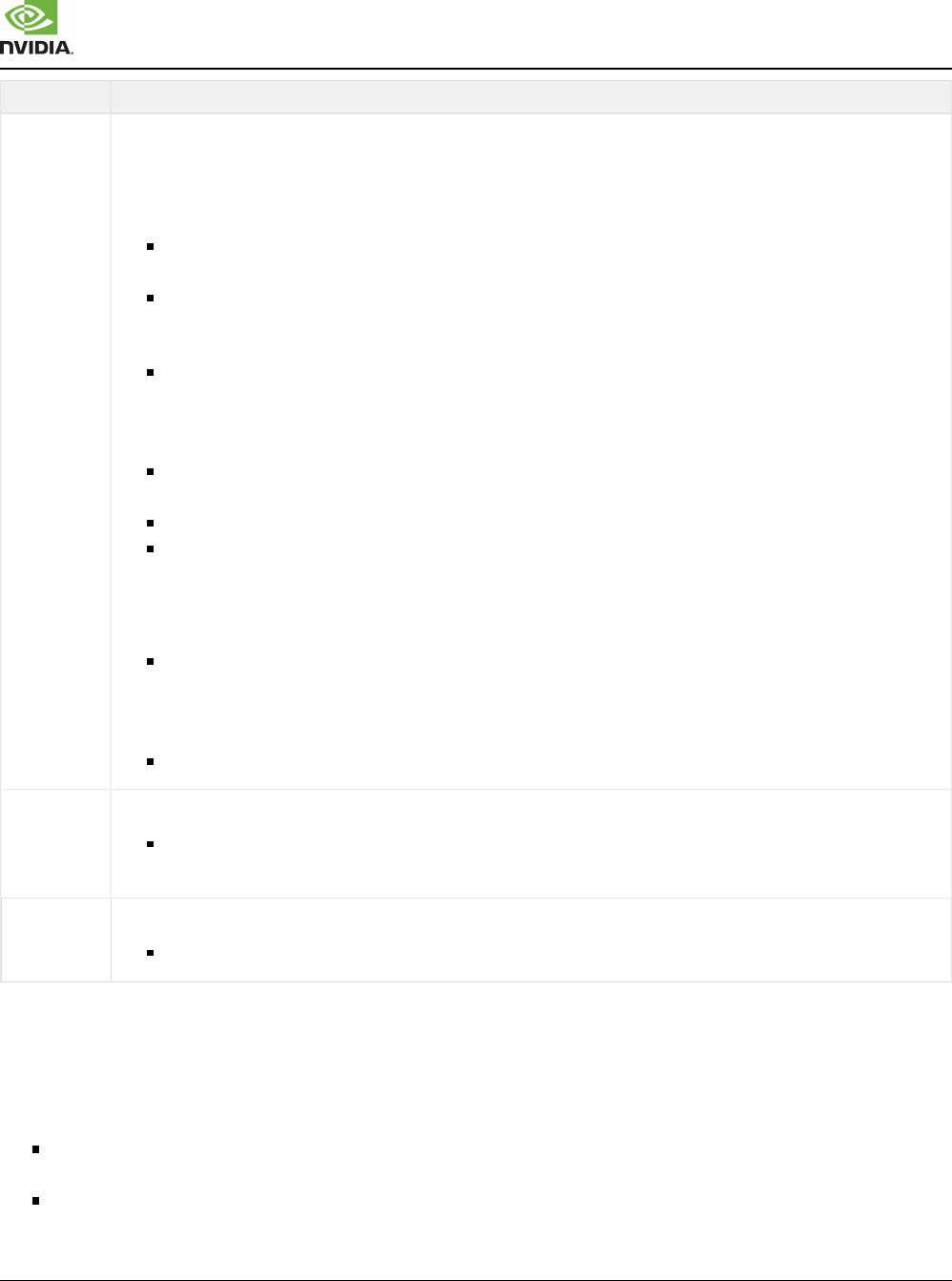
Xavier Series SoC Technical Reference Manual
XAVIER | TRM | DP-09253-002_v1.1 | SUBJECT TO CHANGE | www.nvidia.com Page of 6058 8287
PHY/BRICK PAD Control Programming requirement when I/O is unused but I/O power supply is ON
SOR_NV_PDISP_SOR_PLL2_0_AUX2_OVERRIDE_POWERDOWN
SOR_NV_PDISP_SOR_PLL2_0_AUX1_SEQ_PLLCAPPD_OVERRIDE
Disable the Tx lanes, CAL, and wait for > 5 µs
Set PDCAL to 1 through SOR reg:
SOR_NV_PDISP_SOR_DP_PADCTL0_0_PAD_CAL_PD_POWERDOWN
Set PD_TX* to 1 through SOR reg:
SOR_NV_PDISP_SOR_DP_PADCTL0_0_PD_TXD_0..3_YES
Set PDPORT to 1 through SOR reg:
SOR_NV_PDISP_SOR_PLL2_0_AUX7_PORT_POWERDOWN_ENABLE
Disable the PLL / charge-pump / VCO, and wait for > 5 µs.
Set PLLCAPPD to 1 through SOR reg:
SOR_NV_PDISP_SOR_PLL2_0_AUX8_SEQ_PLLCAPPD_ENFORCE_ENABLE
Set PLLVCOPD to 1 through SOR reg: SOR_NV_PDISP_SOR_PLL0_0_VCOPD_ASSERT
Set PDPLL to 1 through SOR reg:
SOR_NV_PDISP_SOR_PLL0_0_PWR_OFF
Assert PDBG to disable bandgap, and wait for > 5 µs.
Set PDBG to 1 through SOR reg:
SOR_NV_PDISP_SOR_PLL2_0_AUX6_BANDGAP_POWERDOWN_ENABLE
Assert DPD master power down control.
Set E_DPD to 1 through PMC reg: PMC_IMPL_IO_DPD_REQ_0_HDMI_DP0..3_ON
DP AUX
pads
Park the unused bricks in DPD/Power down state.
Set DPAUX_HYBRID_SPARE_0_PAD_PWR_POWERDOWN to `1’ corresponding to the DP-AUX
channel.
PEX CLK out
pads
Park the unused lanes in DPD mode.
Set corresponding bit fields in PMC register PMC_IMPL_IO_DPD_REQ_0
DPD Sequencing
When certain interface is not required to be active, group of pads associated with the interface may be put in
power down (DPD) state to save power. Based on MPIO pad capabilities, and functional requirements:
All non-AO groups of MPIO pads enter in to DPD state as part of SC7 entry and exit DPD state as part of SC7 entry
by PMC hardware.
All AO groups of MPIO pads do not enter in to DPD state as part of SC7 entry and do exit DPD state as part of SC7
exit by PMC hardware.

Xavier Series SoC Technical Reference Manual
XAVIER | TRM | DP-09253-002_v1.1 | SUBJECT TO CHANGE | www.nvidia.com Page of 6059 8287
Below is a reference guide for generic MPIO pad DPD sequencing during system active, PMC “Pad controls”
sections software programming sequence shall be referred for precise programming steps. Steps outline for
typical MPIO interface DPD entry and exit:
DPD Entry:
Software: Bring the I/O interface to Bus IDLE state. I/O controllers are brought into IDLE state and subsequently the
values they are driving towards the pads are stable.
Software: Program the PMC_IMPL_SEL_DPD_TIM_0 register as per SEL_DPD and E_DPD timing requirements.
There are two pad control pins i.e., E_DPD and SEL_DPD which are driven with proper timing as per the Pad data
sheet.
Software: Set PMC PMC_IMPL_IO_DPD[DPD2/DPD7/DPD8]_REQ_0 register bit field(s) corresponding to the group
of pads or interface. DPD controls and mechanisms lists all such PMC DPD software knobs.
Hardware: PMC runs the state machine to drive the DPD sequence control pins to enter i in DPD state.
SEL_DPD is asserted which triggers the pad to latch the pad inputs.
E_DPD is asserted based on PMC_IMPL_SEL_DPD_TIM_0 configuration.
Hardware: I/O state prior to entering to DPD is maintained while in DPD.
DPD Exit:
Software: Enable clocks and initialize respective I/O controller.
Software: Clear PMC PMC_IMPL_IO_DPD[DPD2/DPD7/DPD8] _REQ_0 register bit field(s) corresponding to the
group of pads or interface. DPD controls and mechanisms lists all such PMC DPD software knobs.
Hardware: PMC runs the state machine to drive the DPD sequence control pins to exit the DPD state.
SEL_DPD is de-asserted which triggers the pad to latch the pad inputs.
E_DPD is de-asserted based on PMC_IMPL_SEL_DPD_TIM_0 configuration.
Software: Proceeds with I/O interface programming for required interface operation.
MPIO Pad DPD State Output Tweaking
In such cases the following sequence should be performed:
SC7-entry-init: Configure the pad’s GPIO specific registers for desired pin state.
SC7-entry-init: Change the pin to GPIO (as on output)
SC7-entry-init: Drive the desired value
SC7-entry-init: Trigger to DPD mode by setting bit i.e., PMC_IMPL_DPDx_REQ in PMC to sample the correct value
Proceed with SC7 – entry sequence
SC7-exit: Do the PinMux recovery
SC7-exit: Change the pin from GPIO to SFIO and associate with the respective controller
SC7-exit Ensure the controller is configured to drive correct value what is getting driven in the pad so that there is no
glitch when the pad is coming out of DPD
SC7-exit: Bring the pads out of DPD

Xavier Series SoC Technical Reference Manual
XAVIER | TRM | DP-09253-002_v1.1 | SUBJECT TO CHANGE | www.nvidia.com Page of 6060 8287
PHY/Brick SC7 Entry/Exit
Most of the unused PHY/Bricks I/O states are parked to tri-state and hence they are put into low power state
during SC7 and brought out of power down modes during SC7 exit. Refer to respective HSIO/DDR architecture
documents for the same.
Bringing I/O Rails Down during SC7
To realize lowest possible leakage power, it’s possible to power down I/O rails in conjunction with Xavier low
power states such as SC7. Xavier I/O rails may be shared with the interfacing device and hence the possibility
of powering off I/O rails goes case by case based on interface/platform.
Discrete Pad’s I/O Rails in SC7
Normally the I/O rails of the discrete pads are ON during SC7 to support wakes etc. However, to aggressively
reduce system power it may be turned OFF in specific platforms depending on use case requirements. I/O rail
power on/off has special considerations with regards to power sequencing and duly meeting MPIO pad
functional requirements as listed in DPD controls handling and low power state aspects.
Important note with regards to turning ON I/O rails:
MPIO pads VDDP supply must not be powered ON while the pad is in DPD mode. Deep sleep exit turning ON I/O
rails has modification in Xavier. Reset is asserted to exit the DPD mode (rather to say ensure MPIO pad is not in DPD
mode) before I/O rails are powered ON. See the Power Management Controller chapter for more details.
PHY/Bricks I/O Rail in SC7
Bricks are put in their respective low power mode and the control mechanism differs for each brick. The low
power mode mechanisms of different bricks are captured in Low Power Modes for PHYs as a reference.
Respective software drivers for the brick like Display Driver, Camera Driver puts the bricks in low power mode
when iinterface is IDLE. Low power/DPD programming shall refer to respective HSIO/DDR architecture
documents.
Wake Events Configuration
To enable wake triggering when wake capable pad is in active state, the E_INPUT pad control needs to be
programmed HIGH to enable receiver path in pad.
However, such wake capable pad is in DPD state (E_DPD = 1, SEL_DPD = 1) enables receiver path to trigger
wake irrespective of E_INPUT pad control setting. To avoid corner case scenarios of missing wake events
during DPD and active states, it’s recommended to set E_INPUT = 1 setting for wake capable pads. It is
required to setup E_INPUT = 1 (Enable) by software post-boot for all the wake event supported pads relevant
for a platform.

Xavier Series SoC Technical Reference Manual
XAVIER | TRM | DP-09253-002_v1.1 | SUBJECT TO CHANGE | www.nvidia.com Page of 6061 8287
Most of the mechanical buttons act as SC7 wake source which means their key press to be de-bounced during
SC7. Beyond which the wake events must be protected from noise spikes. So, wake sensing logic in PMC does
glitch filtering and de-bounce capability. Wake programming consists of various signaling, routing and masking
register configuration in PMC. Following is highlight of wake signal conditioning capabilities are supported.
DEBOUNCE selection:
DEBOUNCE_CLK = 1 kHz: Any wake events width less than 31 µs is ignored.
DEBOUNCE_CLK = 32 kHz: Any wake events width less than 31 µs is ignored.
DE-GLITCH:
If enabled, Glitches <= 2 nS are filtered out.
Refer to PMC section titled “Wake Programming Model.”
PCIe C5 Sidebands on NVHS0_DVDD Power Supply
NVLink controller and logic associated with are partitioned in to NVHS0_DVDD supply to be able to run NVLink
at high speeds irrespective of core DVFS. Refer to the “PCIe INIT” in the HSIO section for details in initialization
steps required prior to accessing PCIe L5 side-band pad controls or GPIO registers. Required programming
steps are covered in HSIO section.
It is required that:
NVHS0_DVDD rail must be powered for PCIe C5/SLVS interfaces
Resets driven CAR registers need to be cleared.
8.4.4 PinMux Registers
Refer to "Reading Register Tables" in the Introduction chapter for the register table protocol as well as
recommendations for accessing registers.
The register descriptions below give the offset of each register within the PinMux address range. The Base
Addresses of the registers in the PinMux are specified in the Address Map section of the Xavier TRM.
CAM PAD Control Registers
PADCTL_CAM_EXTPERIPH2_CLK_0
Offset: 0x0
Read/Write: RW
Parity Protection: N
SCR Protection: SCR_EXTPERIPH2_CLK_0
Reset: 0x00000414 (0bxxxx,xxxx,xxxx,xxxx,xxx0,x1x0,x0x1,0100)

Xavier Series SoC Technical Reference Manual
XAVIER | TRM | DP-09253-002_v1.1 | SUBJECT TO CHANGE | www.nvidia.com Page of 6062 8287
Bit Reset Description
12 DISABLE
E_SCHMT:
= DISABLE0
= ENABLE1
10 SFIO
GPIO_SF_SEL:
= GPIO0
= SFIO1
8 DISABLE E_LPDR:
= DISABLE0
= ENABLE1
6 DISABLE E_INPUT:
= DISABLE0
= ENABLE1
4 TRISTATE TRISTATE:
= PASSTHROUGH0
= TRISTATE1
3:2 PULL_DOWN PUPD:
= NONE0
= PULL_DOWN1
= PULL_UP2
= RSVD3
1:0 EXTPERIPH2
PM:
= EXTPERIPH20
= RSVD11
= RSVD22
= RSVD33
PADCTL_CAM_CFG2TMC_EXTPERIPH2_CLK_0
Offset: 0x4
Read/Write: RW
Parity Protection: N
SCR Protection: SCR_EXTPERIPH2_CLK_0
Reset: 0x00000000 (0bxxxx,xxx0,0000,xxx0,0000,xxxx,xxxx,xxxx)
Bit Reset Description
24:20 0x0 CFG_CAL_DRVUP
16:12 0x0 CFG_CAL_DRVDN
PADCTL_CAM_EXTPERIPH1_CLK_0
Offset: 0x8
Read/Write: RW
Parity Protection: N

Xavier Series SoC Technical Reference Manual
XAVIER | TRM | DP-09253-002_v1.1 | SUBJECT TO CHANGE | www.nvidia.com Page of 6063 8287
SCR Protection: SCR_EXTPERIPH1_CLK_0
Reset: 0x00000414 (0bxxxx,xxxx,xxxx,xxxx,xxx0,x1x0,x0x1,0100)
Bit Reset Description
12 DISABLE
E_SCHMT:
= DISABLE0
= ENABLE1
10 SFIO
GPIO_SF_SEL:
= GPIO0
= SFIO1
8 DISABLE E_LPDR:
= DISABLE0
= ENABLE1
6 DISABLE E_INPUT:
= DISABLE0
= ENABLE1
4 TRISTATE TRISTATE:
= PASSTHROUGH0
= TRISTATE1
3:2 PULL_DOWN PUPD:
= NONE0
= PULL_DOWN1
= PULL_UP2
= RSVD3
1:0 EXTPERIPH1
PM:
= EXTPERIPH10
= RSVD11
= RSVD22
= RSVD33
PADCTL_CAM_CFG2TMC_EXTPERIPH1_CLK_0
Offset: 0xc
Read/Write: RW
Parity Protection: N
SCR Protection: SCR_EXTPERIPH1_CLK_0
Reset: 0x00000000 (0bxxxx,xxx0,0000,xxx0,0000,xxxx,xxxx,xxxx)
Bit Reset Description
24:20 0x0 CFG_CAL_DRVUP
16:12 0x0 CFG_CAL_DRVDN
PADCTL_CAM_CAM_I2C_SDA_0

Xavier Series SoC Technical Reference Manual
XAVIER | TRM | DP-09253-002_v1.1 | SUBJECT TO CHANGE | www.nvidia.com Page of 6064 8287
Offset: 0x10
Read/Write: RW
Parity Protection: N
SCR Protection: SCR_CAM_I2C_SDA_0
Reset: 0x00001570 (0bxxxx,xxxx,xxxx,xxxx,xxx1,x1x1,x111,0000)
Bit Reset Description
12 ENABLE
E_SCHMT:
= DISABLE0
= ENABLE1
10 SFIO
GPIO_SF_SEL:
= GPIO0
= SFIO1
8 ENABLE
E_LPDR:
= DISABLE0
= ENABLE1
6 ENABLE
E_INPUT:
= DISABLE0
= ENABLE1
5 ENABLE E_IO_HV:
= DISABLE0
= ENABLE1
4 TRISTATE TRISTATE:
= PASSTHROUGH0
= TRISTATE1
3:2 NONE PUPD:
= NONE0
= PULL_DOWN1
= PULL_UP2
= RSVD3
1:0 I2C3
PM:
= I2C30
= RSVD11
= RSVD22
= RSVD33
PADCTL_CAM_CFG2TMC_CAM_I2C_SDA_0
Offset: 0x14
Read/Write: RW
Parity Protection: N
SCR Protection: SCR_CAM_I2C_SDA_0
Reset: 0x00000000 (0bxxxx,xxx0,0000,xxx0,0000,xxxx,xxxx,xxxx)

Xavier Series SoC Technical Reference Manual
XAVIER | TRM | DP-09253-002_v1.1 | SUBJECT TO CHANGE | www.nvidia.com Page of 6065 8287
Bit Reset Description
24:20 0x0 CFG_CAL_DRVUP
16:12 0x0
CFG_CAL_DRVDN
PADCTL_CAM_CAM_I2C_SCL_0
Offset: 0x18
Read/Write: RW
Parity Protection: N
SCR Protection: SCR_CAM_I2C_SCL_0
Reset: 0x00001570 (0bxxxx,xxxx,xxxx,xxxx,xxx1,x1x1,x111,0000)
Bit Reset Description
12 ENABLE E_SCHMT:
= DISABLE0
= ENABLE1
10 SFIO GPIO_SF_SEL:
= GPIO0
= SFIO1
8 ENABLE E_LPDR:
= DISABLE0
= ENABLE1
6 ENABLE
E_INPUT:
= DISABLE0
= ENABLE1
5 ENABLE
E_IO_HV:
= DISABLE0
= ENABLE1
4 TRISTATE
TRISTATE:
= PASSTHROUGH0
= TRISTATE1
3:2 NONE
PUPD:
= NONE0
= PULL_DOWN1
= PULL_UP2
= RSVD3
1:0 I2C3 PM:
= I2C30
= RSVD11
= RSVD22
= RSVD33

Xavier Series SoC Technical Reference Manual
XAVIER | TRM | DP-09253-002_v1.1 | SUBJECT TO CHANGE | www.nvidia.com Page of 6066 8287
PADCTL_CAM_CFG2TMC_CAM_I2C_SCL_0
Offset: 0x1c
Read/Write: RW
Parity Protection: N
SCR Protection: SCR_CAM_I2C_SCL_0
Reset: 0x00000000 (0bxxxx,xxx0,0000,xxx0,0000,xxxx,xxxx,xxxx)
Bit Reset Description
24:20 0x0 CFG_CAL_DRVUP
16:12 0x0 CFG_CAL_DRVDN
PADCTL_CAM_SOC_GPIO40_0
Offset: 0x20
Read/Write: RW
Parity Protection: N
SCR Protection: SCR_SOC_GPIO40_0
Reset: 0x00000474 (0bxxxx,xxxx,xxxx,xxxx,xxx0,x1x0,x111,0100)
Bit Reset Description
12 DISABLE E_SCHMT:
= DISABLE0
= ENABLE1
10 SFIO GPIO_SF_SEL:
= GPIO0
= SFIO1
8 DISABLE E_LPDR:
= DISABLE0
= ENABLE1
6 ENABLE
E_INPUT:
= DISABLE0
= ENABLE1
5 ENABLE
E_IO_HV:
= DISABLE0
= ENABLE1
4 TRISTATE
TRISTATE:
= PASSTHROUGH0
= TRISTATE1
3:2 PULL_DOWN
PUPD:
= NONE0
= PULL_DOWN1
= PULL_UP2
= RSVD3

Xavier Series SoC Technical Reference Manual
XAVIER | TRM | DP-09253-002_v1.1 | SUBJECT TO CHANGE | www.nvidia.com Page of 6067 8287
Bit Reset Description
1:0 VGP1 PM:
= VGP10
= SLVS1
= RSVD22
= RSVD33
PADCTL_CAM_CFG2TMC_SOC_GPIO40_0
Offset: 0x24
Read/Write: RW
Parity Protection: N
SCR Protection: SCR_SOC_GPIO40_0
Reset: 0x00000000 (0bxxxx,xxx0,0000,xxx0,0000,xxxx,xxxx,xxxx)
Bit Reset Description
24:20 0x0 CFG_CAL_DRVUP
16:12 0x0 CFG_CAL_DRVDN
PADCTL_CAM_SOC_GPIO41_0
Offset: 0x28
Read/Write: RW
Parity Protection: N
SCR Protection: SCR_SOC_GPIO41_0
Reset: 0x00000474 (0bxxxx,xxxx,xxxx,xxxx,xxx0,x1x0,x111,0100)
Bit Reset Description
12 DISABLE E_SCHMT:
= DISABLE0
= ENABLE1
10 SFIO GPIO_SF_SEL:
= GPIO0
= SFIO1
8 DISABLE E_LPDR:
= DISABLE0
= ENABLE1
6 ENABLE
E_INPUT:
= DISABLE0
= ENABLE1
5 ENABLE
E_IO_HV:
= DISABLE0
= ENABLE1

Xavier Series SoC Technical Reference Manual
XAVIER | TRM | DP-09253-002_v1.1 | SUBJECT TO CHANGE | www.nvidia.com Page of 6068 8287
Bit Reset Description
4 TRISTATE
TRISTATE:
= PASSTHROUGH0
= TRISTATE1
3:2 PULL_DOWN
PUPD:
= NONE0
= PULL_DOWN1
= PULL_UP2
= RSVD3
1:0 VGP2 PM:
= VGP20
= EXTPERIPH31
= RSVD22
= RSVD33
PADCTL_CAM_CFG2TMC_SOC_GPIO41_0
Offset: 0x2c
Read/Write: RW
Parity Protection: N
SCR Protection: SCR_SOC_GPIO41_0
Reset: 0x00000000 (0bxxxx,xxx0,0000,xxx0,0000,xxxx,xxxx,xxxx)
Bit Reset Description
24:20 0x0 CFG_CAL_DRVUP
16:12 0x0 CFG_CAL_DRVDN
PADCTL_CAM_SOC_GPIO42_0
Offset: 0x30
Read/Write: RW
Parity Protection: N
SCR Protection: SCR_SOC_GPIO42_0
Reset: 0x00000474 (0bxxxx,xxxx,xxxx,xxxx,xxx0,x1x0,x111,0100)
Bit Reset Description
12 DISABLE E_SCHMT:
= DISABLE0
= ENABLE1
10 SFIO GPIO_SF_SEL:
= GPIO0
= SFIO1
8
DISABLE

Xavier Series SoC Technical Reference Manual
XAVIER | TRM | DP-09253-002_v1.1 | SUBJECT TO CHANGE | www.nvidia.com Page of 6069 8287
Bit Reset Description
E_LPDR:
= DISABLE0
= ENABLE1
6 ENABLE E_INPUT:
= DISABLE0
= ENABLE1
5 ENABLE E_IO_HV:
= DISABLE0
= ENABLE1
4 TRISTATE TRISTATE:
= PASSTHROUGH0
= TRISTATE1
3:2 PULL_DOWN
PUPD:
= NONE0
= PULL_DOWN1
= PULL_UP2
= RSVD3
1:0 VGP3 PM:
= VGP30
= EXTPERIPH41
= RSVD22
= RSVD33
PADCTL_CAM_CFG2TMC_SOC_GPIO42_0
Offset: 0x34
Read/Write: RW
Parity Protection: N
SCR Protection: SCR_SOC_GPIO42_0
Reset: 0x00000000 (0bxxxx,xxx0,0000,xxx0,0000,xxxx,xxxx,xxxx)
Bit Reset Description
24:20 0x0 CFG_CAL_DRVUP
16:12 0x0 CFG_CAL_DRVDN
PADCTL_CAM_SOC_GPIO43_0
Offset: 0x38
Read/Write: RW
Parity Protection: N
SCR Protection: SCR_SOC_GPIO43_0
Reset: 0x00000474 (0bxxxx,xxxx,xxxx,xxxx,xxx0,x1x0,x111,0100)

Xavier Series SoC Technical Reference Manual
XAVIER | TRM | DP-09253-002_v1.1 | SUBJECT TO CHANGE | www.nvidia.com Page of 6070 8287
Bit Reset Description
12 DISABLE E_SCHMT:
= DISABLE0
= ENABLE1
10 SFIO GPIO_SF_SEL:
= GPIO0
= SFIO1
8 DISABLE E_LPDR:
= DISABLE0
= ENABLE1
6 ENABLE E_INPUT:
= DISABLE0
= ENABLE1
5 ENABLE
E_IO_HV:
= DISABLE0
= ENABLE1
4 TRISTATE
TRISTATE:
= PASSTHROUGH0
= TRISTATE1
3:2 PULL_DOWN
PUPD:
= NONE0
= PULL_DOWN1
= PULL_UP2
= RSVD3
1:0 VGP4 PM:
= VGP40
= SLVS1
= RSVD22
= RSVD33
PADCTL_CAM_CFG2TMC_SOC_GPIO43_0
Offset: 0x3c
Read/Write: RW
Parity Protection: N
SCR Protection: SCR_SOC_GPIO43_0
Reset: 0x00000000 (0bxxxx,xxx0,0000,xxx0,0000,xxxx,xxxx,xxxx)
Bit Reset Description
24:20 0x0 CFG_CAL_DRVUP
16:12 0x0
CFG_CAL_DRVDN
PADCTL_CAM_SOC_GPIO44_0

Xavier Series SoC Technical Reference Manual
XAVIER | TRM | DP-09253-002_v1.1 | SUBJECT TO CHANGE | www.nvidia.com Page of 6071 8287
Offset: 0x40
Read/Write: RW
Parity Protection: N
SCR Protection: SCR_SOC_GPIO44_0
Reset: 0x00000474 (0bxxxx,xxxx,xxxx,xxxx,xxx0,x1x0,x111,0100)
Bit Reset Description
12 DISABLE
E_SCHMT:
= DISABLE0
= ENABLE1
10 SFIO
GPIO_SF_SEL:
= GPIO0
= SFIO1
8 DISABLE E_LPDR:
= DISABLE0
= ENABLE1
6 ENABLE E_INPUT:
= DISABLE0
= ENABLE1
5 ENABLE E_IO_HV:
= DISABLE0
= ENABLE1
4 TRISTATE TRISTATE:
= PASSTHROUGH0
= TRISTATE1
3:2 PULL_DOWN PUPD:
= NONE0
= PULL_DOWN1
= PULL_UP2
= RSVD3
1:0 VGP5
PM:
= VGP50
= GP1
= RSVD22
= RSVD33
PADCTL_CAM_CFG2TMC_SOC_GPIO44_0
Offset: 0x44
Read/Write: RW
Parity Protection: N
SCR Protection: SCR_SOC_GPIO44_0
Reset: 0x00000000 (0bxxxx,xxx0,0000,xxx0,0000,xxxx,xxxx,xxxx)

Xavier Series SoC Technical Reference Manual
XAVIER | TRM | DP-09253-002_v1.1 | SUBJECT TO CHANGE | www.nvidia.com Page of 6072 8287
Bit Reset Description
24:20 0x0 CFG_CAL_DRVUP
16:12 0x0
CFG_CAL_DRVDN
PADCTL_CAM_SOC_GPIO45_0
Offset: 0x48
Read/Write: RW
Parity Protection: N
SCR Protection: SCR_SOC_GPIO45_0
Reset: 0x00000474 (0bxxxx,xxxx,xxxx,xxxx,xxx0,x1x0,x111,0100)
Bit Reset Description
12 DISABLE E_SCHMT:
= DISABLE0
= ENABLE1
10 SFIO GPIO_SF_SEL:
= GPIO0
= SFIO1
8 DISABLE E_LPDR:
= DISABLE0
= ENABLE1
6 ENABLE E_INPUT:
= DISABLE0
= ENABLE1
5 ENABLE
E_IO_HV:
= DISABLE0
= ENABLE1
4 TRISTATE
TRISTATE:
= PASSTHROUGH0
= TRISTATE1
3:2 PULL_DOWN
PUPD:
= NONE0
= PULL_DOWN1
= PULL_UP2
= RSVD3
1:0 VGP6 PM:
= VGP60
= RSVD11
= RSVD22
= RSVD33
PADCTL_CAM_CFG2TMC_SOC_GPIO45_0

Xavier Series SoC Technical Reference Manual
XAVIER | TRM | DP-09253-002_v1.1 | SUBJECT TO CHANGE | www.nvidia.com Page of 6073 8287
Offset: 0x4c
Read/Write: RW
Parity Protection: N
SCR Protection: SCR_SOC_GPIO45_0
Reset: 0x00000000 (0bxxxx,xxx0,0000,xxx0,0000,xxxx,xxxx,xxxx)
Bit Reset Description
24:20 0x0 CFG_CAL_DRVUP
16:12 0x0 CFG_CAL_DRVDN
PADCTL_CAM_SOC_GPIO20_0
Offset: 0x50
Read/Write: RW
Parity Protection: N
SCR Protection: SCR_SOC_GPIO20_0
Reset: 0x00000454 (0bxxxx,xxxx,xxxx,xxxx,xxx0,x1x0,x1x1,0100)
Bit Reset Description
12 DISABLE E_SCHMT:
= DISABLE0
= ENABLE1
10 SFIO GPIO_SF_SEL:
= GPIO0
= SFIO1
8 DISABLE E_LPDR:
= DISABLE0
= ENABLE1
6 ENABLE
E_INPUT:
= DISABLE0
= ENABLE1
4 TRISTATE
TRISTATE:
= PASSTHROUGH0
= TRISTATE1
3:2 PULL_DOWN PUPD:
= NONE0
= PULL_DOWN1
= PULL_UP2
= RSVD3
1:0
RSVD0
PM:
= RSVD00

Xavier Series SoC Technical Reference Manual
XAVIER | TRM | DP-09253-002_v1.1 | SUBJECT TO CHANGE | www.nvidia.com Page of 6074 8287
Bit Reset Description
= RSVD11
= RSVD22
= RSVD33
PADCTL_CAM_CFG2TMC_SOC_GPIO20_0
Offset: 0x54
Read/Write: RW
Parity Protection: N
SCR Protection: SCR_SOC_GPIO20_0
Reset: 0x00000000 (0bxxxx,xxx0,0000,xxx0,0000,xxxx,xxxx,xxxx)
Bit Reset Description
24:20 0x0
CFG_CAL_DRVUP
16:12 0x0
CFG_CAL_DRVDN
PADCTL_CAM_SOC_GPIO21_0
Offset: 0x58
Read/Write: RW
Parity Protection: N
SCR Protection: SCR_SOC_GPIO21_0
Reset: 0x00000454 (0bxxxx,xxxx,xxxx,xxxx,xxx0,x1x0,x1x1,0100)
Bit Reset Description
12 DISABLE E_SCHMT:
= DISABLE0
= ENABLE1
10 SFIO GPIO_SF_SEL:
= GPIO0
= SFIO1
8 DISABLE
E_LPDR:
= DISABLE0
= ENABLE1
6 ENABLE
E_INPUT:
= DISABLE0
= ENABLE1
4 TRISTATE TRISTATE:
= PASSTHROUGH0
= TRISTATE1
3:2
PULL_DOWN
PUPD:
= NONE0

Xavier Series SoC Technical Reference Manual
XAVIER | TRM | DP-09253-002_v1.1 | SUBJECT TO CHANGE | www.nvidia.com Page of 6075 8287
Bit Reset Description
= PULL_DOWN1
= PULL_UP2
= RSVD3
1:0 RSVD0 PM:
= RSVD00
= RSVD11
= RSVD22
= RSVD33
PADCTL_CAM_CFG2TMC_SOC_GPIO21_0
Offset: 0x5c
Read/Write: RW
Parity Protection: N
SCR Protection: SCR_SOC_GPIO21_0
Reset: 0x00000000 (0bxxxx,xxx0,0000,xxx0,0000,xxxx,xxxx,xxxx)
Bit Reset Description
24:20 0x0
CFG_CAL_DRVUP
16:12 0x0 CFG_CAL_DRVDN
PADCTL_CAM_SOC_GPIO22_0
Offset: 0x60
Read/Write: RW
Parity Protection: N
SCR Protection: SCR_SOC_GPIO22_0
Reset: 0x00000454 (0bxxxx,xxxx,xxxx,xxxx,xxx0,x1x0,x1x1,0100)
Bit Reset Description
12 DISABLE E_SCHMT:
= DISABLE0
= ENABLE1
10 SFIO GPIO_SF_SEL:
= GPIO0
= SFIO1
8 DISABLE
E_LPDR:
= DISABLE0
= ENABLE1
6 ENABLE
E_INPUT:
= DISABLE0
= ENABLE1

Xavier Series SoC Technical Reference Manual
XAVIER | TRM | DP-09253-002_v1.1 | SUBJECT TO CHANGE | www.nvidia.com Page of 6076 8287
Bit Reset Description
4 TRISTATE
TRISTATE:
= PASSTHROUGH0
= TRISTATE1
3:2 PULL_DOWN
PUPD:
= NONE0
= PULL_DOWN1
= PULL_UP2
= RSVD3
1:0 RSVD0 PM:
= RSVD00
= NV1
= RSVD22
= RSVD33
PADCTL_CAM_CFG2TMC_SOC_GPIO22_0
Offset: 0x64
Read/Write: RW
Parity Protection: N
SCR Protection: SCR_SOC_GPIO22_0
Reset: 0x00000000 (0bxxxx,xxx0,0000,xxx0,0000,xxxx,xxxx,xxxx)
Bit Reset Description
24:20 0x0 CFG_CAL_DRVUP
16:12 0x0 CFG_CAL_DRVDN
PADCTL_CAM_SOC_GPIO23_0
Offset: 0x68
Read/Write: RW
Parity Protection: N
SCR Protection: SCR_SOC_GPIO23_0
Reset: 0x00000440 (0bxxxx,xxxx,xxxx,xxxx,xxx0,x1x0,x1x0,0000)
Bit Reset Description
12 DISABLE E_SCHMT:
= DISABLE0
= ENABLE1
10 SFIO GPIO_SF_SEL:
= GPIO0
= SFIO1
8
DISABLE

Xavier Series SoC Technical Reference Manual
XAVIER | TRM | DP-09253-002_v1.1 | SUBJECT TO CHANGE | www.nvidia.com Page of 6077 8287
Bit Reset Description
E_LPDR:
= DISABLE0
= ENABLE1
6 ENABLE E_INPUT:
= DISABLE0
= ENABLE1
4 PASSTHROUGH TRISTATE:
= PASSTHROUGH0
= TRISTATE1
3:2 NONE PUPD:
= NONE0
= PULL_DOWN1
= PULL_UP2
= RSVD3
1:0 RSVD0
PM:
= RSVD00
= WDT1
= RSVD22
= RSVD33
PADCTL_CAM_CFG2TMC_SOC_GPIO23_0
Offset: 0x6c
Read/Write: RW
Parity Protection: N
SCR Protection: SCR_SOC_GPIO23_0
Reset: 0x00000000 (0bxxxx,xxx0,0000,xxx0,0000,xxxx,xxxx,xxxx)
Bit Reset Description
24:20 0x0 CFG_CAL_DRVUP
16:12 0x0 CFG_CAL_DRVDN
PADCTL_CAM_SOC_GPIO04_0
Offset: 0x70
Read/Write: RW
Parity Protection: N
SCR Protection: SCR_SOC_GPIO04_0
Reset: 0x00000454 (0bxxxx,xxxx,xxxx,xxxx,xxx0,x1x0,x1x1,0100)
Bit Reset Description
12
DISABLE

Xavier Series SoC Technical Reference Manual
XAVIER | TRM | DP-09253-002_v1.1 | SUBJECT TO CHANGE | www.nvidia.com Page of 6078 8287
Bit Reset Description
E_SCHMT:
= DISABLE0
= ENABLE1
10 SFIO
GPIO_SF_SEL:
= GPIO0
= SFIO1
8 DISABLE
E_LPDR:
= DISABLE0
= ENABLE1
6 ENABLE E_INPUT:
= DISABLE0
= ENABLE1
4 TRISTATE TRISTATE:
= PASSTHROUGH0
= TRISTATE1
3:2 PULL_DOWN PUPD:
= NONE0
= PULL_DOWN1
= PULL_UP2
= RSVD3
1:0 RSVD0 PM:
= RSVD00
= RSVD11
= RSVD22
= RSVD33
PADCTL_CAM_CFG2TMC_SOC_GPIO04_0
Offset: 0x74
Read/Write: RW
Parity Protection: N
SCR Protection: SCR_SOC_GPIO04_0
Reset: 0x00000000 (0bxxxx,xxx0,0000,xxx0,0000,xxxx,xxxx,xxxx)
Bit Reset Description
24:20 0x0
CFG_CAL_DRVUP
16:12 0x0
CFG_CAL_DRVDN
PADCTL_CAM_SOC_GPIO05_0
Offset: 0x78
Read/Write: RW
Parity Protection: N

Xavier Series SoC Technical Reference Manual
XAVIER | TRM | DP-09253-002_v1.1 | SUBJECT TO CHANGE | www.nvidia.com Page of 6079 8287
SCR Protection: SCR_SOC_GPIO05_0
Reset: 0x00000454 (0bxxxx,xxxx,xxxx,xxxx,xxx0,x1x0,x1x1,0100)
Bit Reset Description
12 DISABLE
E_SCHMT:
= DISABLE0
= ENABLE1
10 SFIO
GPIO_SF_SEL:
= GPIO0
= SFIO1
8 DISABLE E_LPDR:
= DISABLE0
= ENABLE1
6 ENABLE E_INPUT:
= DISABLE0
= ENABLE1
4 TRISTATE TRISTATE:
= PASSTHROUGH0
= TRISTATE1
3:2 PULL_DOWN PUPD:
= NONE0
= PULL_DOWN1
= PULL_UP2
= RSVD3
1:0 RSVD0
PM:
= RSVD00
= IGPU1
= RSVD22
= RSVD33
PADCTL_CAM_CFG2TMC_SOC_GPIO05_0
Offset: 0x7c
Read/Write: RW
Parity Protection: N
SCR Protection: SCR_SOC_GPIO05_0
Reset: 0x00000000 (0bxxxx,xxx0,0000,xxx0,0000,xxxx,xxxx,xxxx)
Bit Reset Description
24:20 0x0 CFG_CAL_DRVUP
16:12 0x0 CFG_CAL_DRVDN
PADCTL_CAM_SOC_GPIO06_0

Xavier Series SoC Technical Reference Manual
XAVIER | TRM | DP-09253-002_v1.1 | SUBJECT TO CHANGE | www.nvidia.com Page of 6080 8287
Offset: 0x80
Read/Write: RW
Parity Protection: N
SCR Protection: SCR_SOC_GPIO06_0
Reset: 0x00000454 (0bxxxx,xxxx,xxxx,xxxx,xxx0,x1x0,x1x1,0100)
Bit Reset Description
12 DISABLE
E_SCHMT:
= DISABLE0
= ENABLE1
10 SFIO
GPIO_SF_SEL:
= GPIO0
= SFIO1
8 DISABLE
E_LPDR:
= DISABLE0
= ENABLE1
6 ENABLE
E_INPUT:
= DISABLE0
= ENABLE1
4 TRISTATE TRISTATE:
= PASSTHROUGH0
= TRISTATE1
3:2 PULL_DOWN PUPD:
= NONE0
= PULL_DOWN1
= PULL_UP2
= RSVD3
1:0 RSVD0
PM:
= RSVD00
= RSVD11
= RSVD22
= RSVD33
PADCTL_CAM_CFG2TMC_SOC_GPIO06_0
Offset: 0x84
Read/Write: RW
Parity Protection: N
SCR Protection: SCR_SOC_GPIO06_0
Reset: 0x00000000 (0bxxxx,xxx0,0000,xxx0,0000,xxxx,xxxx,xxxx)
Bit Reset Description
24:20 0x0 CFG_CAL_DRVUP
16:12 0x0
CFG_CAL_DRVDN

Xavier Series SoC Technical Reference Manual
XAVIER | TRM | DP-09253-002_v1.1 | SUBJECT TO CHANGE | www.nvidia.com Page of 6081 8287
PADCTL_CAM_SOC_GPIO07_0
Offset: 0x88
Read/Write: RW
Parity Protection: N
SCR Protection: SCR_SOC_GPIO07_0
Reset: 0x00000474 (0bxxxx,xxxx,xxxx,xxxx,xxx0,x1x0,x111,0100)
Bit Reset Description
12 DISABLE
E_SCHMT:
= DISABLE0
= ENABLE1
10 SFIO
GPIO_SF_SEL:
= GPIO0
= SFIO1
8 DISABLE E_LPDR:
= DISABLE0
= ENABLE1
6 ENABLE E_INPUT:
= DISABLE0
= ENABLE1
5 ENABLE E_IO_HV:
= DISABLE0
= ENABLE1
4 TRISTATE TRISTATE:
= PASSTHROUGH0
= TRISTATE1
3:2 PULL_DOWN PUPD:
= NONE0
= PULL_DOWN1
= PULL_UP2
= RSVD3
1:0 RSVD0
PM:
= RSVD00
= SATA1
= SOC2
= RSVD33
PADCTL_CAM_CFG2TMC_SOC_GPIO07_0
Offset: 0x8c
Read/Write: RW

Xavier Series SoC Technical Reference Manual
XAVIER | TRM | DP-09253-002_v1.1 | SUBJECT TO CHANGE | www.nvidia.com Page of 6082 8287
Parity Protection: N
SCR Protection: SCR_SOC_GPIO07_0
Reset: 0x00000000 (0bxxxx,xxx0,0000,xxx0,0000,xxxx,xxxx,xxxx)
Bit Reset Description
24:20 0x0 CFG_CAL_DRVUP
16:12 0x0 CFG_CAL_DRVDN
PADCTL_CAM_UART1_CTS_0
Offset: 0x90
Read/Write: RW
Parity Protection: N
SCR Protection: SCR_UART1_CTS_0
Reset: 0x00000458 (0bxxxx,xxxx,xxxx,xxxx,xxx0,x1x0,x1x1,1000)
Bit Reset Description
12 DISABLE E_SCHMT:
= DISABLE0
= ENABLE1
10 SFIO GPIO_SF_SEL:
= GPIO0
= SFIO1
8 DISABLE E_LPDR:
= DISABLE0
= ENABLE1
6 ENABLE E_INPUT:
= DISABLE0
= ENABLE1
4 TRISTATE TRISTATE:
= PASSTHROUGH0
= TRISTATE1
3:2 PULL_UP
PUPD:
= NONE0
= PULL_DOWN1
= PULL_UP2
= RSVD3
1:0 UARTA PM:
= UARTA0
= RSVD11
= RSVD22
= RSVD33
PADCTL_CAM_CFG2TMC_UART1_CTS_0

Xavier Series SoC Technical Reference Manual
XAVIER | TRM | DP-09253-002_v1.1 | SUBJECT TO CHANGE | www.nvidia.com Page of 6083 8287
Offset: 0x94
Read/Write: RW
Parity Protection: N
SCR Protection: SCR_UART1_CTS_0
Reset: 0x00000000 (0bxxxx,xxx0,0000,xxx0,0000,xxxx,xxxx,xxxx)
Bit Reset Description
24:20 0x0 CFG_CAL_DRVUP
16:12 0x0 CFG_CAL_DRVDN
PADCTL_CAM_UART1_RTS_0
Offset: 0x98
Read/Write: RW
Parity Protection: N
SCR Protection: SCR_UART1_RTS_0
Reset: 0x00000414 (0bxxxx,xxxx,xxxx,xxxx,xxx0,x1x0,x0x1,0100)
Bit Reset Description
12 DISABLE E_SCHMT:
= DISABLE0
= ENABLE1
10 SFIO GPIO_SF_SEL:
= GPIO0
= SFIO1
8 DISABLE E_LPDR:
= DISABLE0
= ENABLE1
6 DISABLE
E_INPUT:
= DISABLE0
= ENABLE1
4 TRISTATE
TRISTATE:
= PASSTHROUGH0
= TRISTATE1
3:2 PULL_DOWN
PUPD:
= NONE0
= PULL_DOWN1
= PULL_UP2
= RSVD3
1:0
UARTA
PM:
= UARTA0

Xavier Series SoC Technical Reference Manual
XAVIER | TRM | DP-09253-002_v1.1 | SUBJECT TO CHANGE | www.nvidia.com Page of 6084 8287
Bit Reset Description
= RSVD11
= RSVD22
= RSVD33
PADCTL_CAM_CFG2TMC_UART1_RTS_0
Offset: 0x9c
Read/Write: RW
Parity Protection: N
SCR Protection: SCR_UART1_RTS_0
Reset: 0x00000000 (0bxxxx,xxx0,0000,xxx0,0000,xxxx,xxxx,xxxx)
Bit Reset Description
24:20 0x0
CFG_CAL_DRVUP
16:12 0x0 CFG_CAL_DRVDN
PADCTL_CAM_UART1_RX_0
Offset: 0xa0
Read/Write: RW
Parity Protection: N
SCR Protection: SCR_UART1_RX_0
Reset: 0x00000470 (0bxxxx,xxxx,xxxx,xxxx,xxx0,x1x0,x111,0000)
Bit Reset Description
12 DISABLE E_SCHMT:
= DISABLE0
= ENABLE1
10 SFIO
GPIO_SF_SEL:
= GPIO0
= SFIO1
8 DISABLE
E_LPDR:
= DISABLE0
= ENABLE1
6 ENABLE
E_INPUT:
= DISABLE0
= ENABLE1
5 ENABLE
E_IO_HV:
= DISABLE0
= ENABLE1
4
TRISTATE

Xavier Series SoC Technical Reference Manual
XAVIER | TRM | DP-09253-002_v1.1 | SUBJECT TO CHANGE | www.nvidia.com Page of 6085 8287
Bit Reset Description
TRISTATE:
= PASSTHROUGH0
= TRISTATE1
3:2 NONE PUPD:
= NONE0
= PULL_DOWN1
= PULL_UP2
= RSVD3
1:0 UARTA PM:
= UARTA0
= RSVD11
= RSVD22
= RSVD33
PADCTL_CAM_CFG2TMC_UART1_RX_0
Offset: 0xa4
Read/Write: RW
Parity Protection: N
SCR Protection: SCR_UART1_RX_0
Reset: 0x00000000 (0bxxxx,xxx0,0000,xxx0,0000,xxxx,xxxx,xxxx)
Bit Reset Description
24:20 0x0
CFG_CAL_DRVUP
16:12 0x0
CFG_CAL_DRVDN
PADCTL_CAM_UART1_TX_0
Offset: 0xa8
Read/Write: RW
Parity Protection: N
SCR Protection: SCR_UART1_TX_0
Reset: 0x00000434 (0bxxxx,xxxx,xxxx,xxxx,xxx0,x1x0,x011,0100)
Bit Reset Description
12 DISABLE
E_SCHMT:
= DISABLE0
= ENABLE1
10 SFIO
GPIO_SF_SEL:
= GPIO0
= SFIO1
8
DISABLE

Xavier Series SoC Technical Reference Manual
XAVIER | TRM | DP-09253-002_v1.1 | SUBJECT TO CHANGE | www.nvidia.com Page of 6086 8287
Bit Reset Description
E_LPDR:
= DISABLE0
= ENABLE1
6 DISABLE
E_INPUT:
= DISABLE0
= ENABLE1
5 ENABLE
E_IO_HV:
= DISABLE0
= ENABLE1
4 TRISTATE TRISTATE:
= PASSTHROUGH0
= TRISTATE1
3:2 PULL_DOWN PUPD:
= NONE0
= PULL_DOWN1
= PULL_UP2
= RSVD3
1:0 UARTA PM:
= UARTA0
= RSVD11
= RSVD22
= RSVD33
PADCTL_CAM_CFG2TMC_UART1_TX_0
Offset: 0xac
Read/Write: RW
Parity Protection: N
SCR Protection: SCR_UART1_TX_0
Reset: 0x00000000 (0bxxxx,xxx0,0000,xxx0,0000,xxxx,xxxx,xxxx)
Bit Reset Description
24:20 0x0
CFG_CAL_DRVUP
16:12 0x0
CFG_CAL_DRVDN
Audio PAD Control Registers
PADCTL_AUDIO_SOC_GPIO33_0
Offset: 0x0
Read/Write: RW
Parity Protection: N

Xavier Series SoC Technical Reference Manual
XAVIER | TRM | DP-09253-002_v1.1 | SUBJECT TO CHANGE | www.nvidia.com Page of 6087 8287
SCR Protection: SCR_SOC_GPIO33_0
Reset: 0x00000458 (0bxxxx,xxxx,xxxx,xxxx,xxx0,x1x0,x1x1,1000)
Bit Reset Description
12 DISABLE
E_SCHMT:
= DISABLE0
= ENABLE1
10 SFIO
GPIO_SF_SEL:
= GPIO0
= SFIO1
8 DISABLE E_LPDR:
= DISABLE0
= ENABLE1
6 ENABLE E_INPUT:
= DISABLE0
= ENABLE1
4 TRISTATE TRISTATE:
= PASSTHROUGH0
= TRISTATE1
3:2 PULL_UP PUPD:
= NONE0
= PULL_DOWN1
= PULL_UP2
= RSVD3
1:0 RSVD0
PM:
= RSVD00
= SPDIF1
= RSVD22
= RSVD33
PADCTL_AUDIO_CFG2TMC_SOC_GPIO33_0
Offset: 0x4
Read/Write: RW
Parity Protection: N
SCR Protection: SCR_SOC_GPIO33_0
Reset: 0x00000000 (0bxxxx,xxx0,0000,xxx0,0000,xxxx,xxxx,xxxx)
Bit Reset Description
24:20 0x0 CFG_CAL_DRVUP
16:12 0x0 CFG_CAL_DRVDN
PADCTL_AUDIO_SOC_GPIO32_0

Xavier Series SoC Technical Reference Manual
XAVIER | TRM | DP-09253-002_v1.1 | SUBJECT TO CHANGE | www.nvidia.com Page of 6088 8287
Offset: 0x8
Read/Write: RW
Parity Protection: N
SCR Protection: SCR_SOC_GPIO32_0
Reset: 0x00000454 (0bxxxx,xxxx,xxxx,xxxx,xxx0,x1x0,x1x1,0100)
Bit Reset Description
12 DISABLE
E_SCHMT:
= DISABLE0
= ENABLE1
10 SFIO
GPIO_SF_SEL:
= GPIO0
= SFIO1
8 DISABLE
E_LPDR:
= DISABLE0
= ENABLE1
6 ENABLE
E_INPUT:
= DISABLE0
= ENABLE1
4 TRISTATE TRISTATE:
= PASSTHROUGH0
= TRISTATE1
3:2 PULL_DOWN PUPD:
= NONE0
= PULL_DOWN1
= PULL_UP2
= RSVD3
1:0 RSVD0
PM:
= RSVD00
= SPDIF1
= RSVD22
= RSVD33
PADCTL_AUDIO_CFG2TMC_SOC_GPIO32_0
Offset: 0xc
Read/Write: RW
Parity Protection: N
SCR Protection: SCR_SOC_GPIO32_0
Reset: 0x00000000 (0bxxxx,xxx0,0000,xxx0,0000,xxxx,xxxx,xxxx)
Bit Reset Description
24:20 0x0 CFG_CAL_DRVUP
16:12 0x0
CFG_CAL_DRVDN

Xavier Series SoC Technical Reference Manual
XAVIER | TRM | DP-09253-002_v1.1 | SUBJECT TO CHANGE | www.nvidia.com Page of 6089 8287
PADCTL_AUDIO_SOC_GPIO31_0
Offset: 0x10
Read/Write: RW
Parity Protection: N
SCR Protection: SCR_SOC_GPIO31_0
Reset: 0x00000454 (0bxxxx,xxxx,xxxx,xxxx,xxx0,x1x0,x1x1,0100)
Bit Reset Description
12 DISABLE
E_SCHMT:
= DISABLE0
= ENABLE1
10 SFIO
GPIO_SF_SEL:
= GPIO0
= SFIO1
8 DISABLE E_LPDR:
= DISABLE0
= ENABLE1
6 ENABLE E_INPUT:
= DISABLE0
= ENABLE1
4 TRISTATE TRISTATE:
= PASSTHROUGH0
= TRISTATE1
3:2 PULL_DOWN PUPD:
= NONE0
= PULL_DOWN1
= PULL_UP2
= RSVD3
1:0 RSVD0
PM:
= RSVD00
= SDMMC11
= RSVD22
= RSVD33
PADCTL_AUDIO_CFG2TMC_SOC_GPIO31_0
Offset: 0x14
Read/Write: RW
Parity Protection: N
SCR Protection: SCR_SOC_GPIO31_0
Reset: 0x00000000 (0bxxxx,xxx0,0000,xxx0,0000,xxxx,xxxx,xxxx)

Xavier Series SoC Technical Reference Manual
XAVIER | TRM | DP-09253-002_v1.1 | SUBJECT TO CHANGE | www.nvidia.com Page of 6090 8287
Bit Reset Description
24:20 0x0 CFG_CAL_DRVUP
16:12 0x0 CFG_CAL_DRVDN
PADCTL_AUDIO_SOC_GPIO30_0
Offset: 0x18
Read/Write: RW
Parity Protection: N
SCR Protection: SCR_SOC_GPIO30_0
Reset: 0x00000454 (0bxxxx,xxxx,xxxx,xxxx,xxx0,x1x0,x1x1,0100)
Bit Reset Description
12 DISABLE
E_SCHMT:
= DISABLE0
= ENABLE1
10 SFIO
GPIO_SF_SEL:
= GPIO0
= SFIO1
8 DISABLE E_LPDR:
= DISABLE0
= ENABLE1
6 ENABLE E_INPUT:
= DISABLE0
= ENABLE1
4 TRISTATE TRISTATE:
= PASSTHROUGH0
= TRISTATE1
3:2 PULL_DOWN PUPD:
= NONE0
= PULL_DOWN1
= PULL_UP2
= RSVD3
1:0 RSVD0
PM:
= RSVD00
= RSVD11
= RSVD22
= RSVD33
PADCTL_AUDIO_CFG2TMC_SOC_GPIO30_0
Offset: 0x1c
Read/Write: RW

Xavier Series SoC Technical Reference Manual
XAVIER | TRM | DP-09253-002_v1.1 | SUBJECT TO CHANGE | www.nvidia.com Page of 6091 8287
Parity Protection: N
SCR Protection: SCR_SOC_GPIO30_0
Reset: 0x00000000 (0bxxxx,xxx0,0000,xxx0,0000,xxxx,xxxx,xxxx)
Bit Reset Description
24:20 0x0
CFG_CAL_DRVUP
16:12 0x0
CFG_CAL_DRVDN
PADCTL_AUDIO_AUD_MCLK_0
Offset: 0x20
Read/Write: RW
Parity Protection: N
SCR Protection: SCR_AUD_MCLK_0
Reset: 0x00000414 (0bxxxx,xxxx,xxxx,xxxx,xxx0,x1x0,x0x1,0100)
Bit Reset Description
12 DISABLE
E_SCHMT:
= DISABLE0
= ENABLE1
10 SFIO
GPIO_SF_SEL:
= GPIO0
= SFIO1
8 DISABLE
E_LPDR:
= DISABLE0
= ENABLE1
6 DISABLE
E_INPUT:
= DISABLE0
= ENABLE1
4 TRISTATE TRISTATE:
= PASSTHROUGH0
= TRISTATE1
3:2 PULL_DOWN PUPD:
= NONE0
= PULL_DOWN1
= PULL_UP2
= RSVD3
1:0 AUD
PM:
= AUD0
= RSVD11
= RSVD22
= RSVD33
PADCTL_AUDIO_CFG2TMC_AUD_MCLK_0

Xavier Series SoC Technical Reference Manual
XAVIER | TRM | DP-09253-002_v1.1 | SUBJECT TO CHANGE | www.nvidia.com Page of 6092 8287
Offset: 0x24
Read/Write: RW
Parity Protection: N
SCR Protection: SCR_AUD_MCLK_0
Reset: 0x00000000 (0bxxxx,xxx0,0000,xxx0,0000,xxxx,xxxx,xxxx)
Bit Reset Description
24:20 0x0 CFG_CAL_DRVUP
16:12 0x0
CFG_CAL_DRVDN
PADCTL_AUDIO_DAP1_FS_0
Offset: 0x28
Read/Write: RW
Parity Protection: N
SCR Protection: SCR_DAP1_FS_0
Reset: 0x00000454 (0bxxxx,xxxx,xxxx,xxxx,xxx0,x1x0,x1x1,0100)
Bit Reset Description
12 DISABLE
E_SCHMT:
= DISABLE0
= ENABLE1
10 SFIO
GPIO_SF_SEL:
= GPIO0
= SFIO1
8 DISABLE E_LPDR:
= DISABLE0
= ENABLE1
6 ENABLE E_INPUT:
= DISABLE0
= ENABLE1
4 TRISTATE TRISTATE:
= PASSTHROUGH0
= TRISTATE1
3:2 PULL_DOWN PUPD:
= NONE0
= PULL_DOWN1
= PULL_UP2
= RSVD3
1:0
I2S1
PM:
= I2S10

Xavier Series SoC Technical Reference Manual
XAVIER | TRM | DP-09253-002_v1.1 | SUBJECT TO CHANGE | www.nvidia.com Page of 6093 8287
Bit Reset Description
= RSVD11
= RSVD22
= RSVD33
PADCTL_AUDIO_CFG2TMC_DAP1_FS_0
Offset: 0x2c
Read/Write: RW
Parity Protection: N
SCR Protection: SCR_DAP1_FS_0
Reset: 0x00000000 (0bxxxx,xxx0,0000,xxx0,0000,xxxx,xxxx,xxxx)
Bit Reset Description
24:20 0x0 CFG_CAL_DRVUP
16:12 0x0 CFG_CAL_DRVDN
PADCTL_AUDIO_DAP1_DIN_0
Offset: 0x30
Read/Write: RW
Parity Protection: N
SCR Protection: SCR_DAP1_DIN_0
Reset: 0x00000454 (0bxxxx,xxxx,xxxx,xxxx,xxx0,x1x0,x1x1,0100)
Bit Reset Description
12 DISABLE E_SCHMT:
= DISABLE0
= ENABLE1
10 SFIO GPIO_SF_SEL:
= GPIO0
= SFIO1
8 DISABLE E_LPDR:
= DISABLE0
= ENABLE1
6 ENABLE E_INPUT:
= DISABLE0
= ENABLE1
4 TRISTATE TRISTATE:
= PASSTHROUGH0
= TRISTATE1
3:2
PULL_DOWN
PUPD:
= NONE0

Xavier Series SoC Technical Reference Manual
XAVIER | TRM | DP-09253-002_v1.1 | SUBJECT TO CHANGE | www.nvidia.com Page of 6094 8287
Bit Reset Description
= PULL_DOWN1
= PULL_UP2
= RSVD3
1:0 I2S1
PM:
= I2S10
= RSVD11
= RSVD22
= RSVD33
PADCTL_AUDIO_CFG2TMC_DAP1_DIN_0
Offset: 0x34
Read/Write: RW
Parity Protection: N
SCR Protection: SCR_DAP1_DIN_0
Reset: 0x00000000 (0bxxxx,xxx0,0000,xxx0,0000,xxxx,xxxx,xxxx)
Bit Reset Description
24:20 0x0 CFG_CAL_DRVUP
16:12 0x0 CFG_CAL_DRVDN
PADCTL_AUDIO_DAP1_DOUT_0
Offset: 0x38
Read/Write: RW
Parity Protection: N
SCR Protection: SCR_DAP1_DOUT_0
Reset: 0x00000414 (0bxxxx,xxxx,xxxx,xxxx,xxx0,x1x0,x0x1,0100)
Bit Reset Description
12 DISABLE
E_SCHMT:
= DISABLE0
= ENABLE1
10 SFIO
GPIO_SF_SEL:
= GPIO0
= SFIO1
8 DISABLE E_LPDR:
= DISABLE0
= ENABLE1
6 DISABLE E_INPUT:
= DISABLE0
= ENABLE1

Xavier Series SoC Technical Reference Manual
XAVIER | TRM | DP-09253-002_v1.1 | SUBJECT TO CHANGE | www.nvidia.com Page of 6095 8287
Bit Reset Description
4 TRISTATE TRISTATE:
= PASSTHROUGH0
= TRISTATE1
3:2 PULL_DOWN PUPD:
= NONE0
= PULL_DOWN1
= PULL_UP2
= RSVD3
1:0 I2S1
PM:
= I2S10
= RSVD11
= RSVD22
= RSVD33
PADCTL_AUDIO_CFG2TMC_DAP1_DOUT_0
Offset: 0x3c
Read/Write: RW
Parity Protection: N
SCR Protection: SCR_DAP1_DOUT_0
Reset: 0x00000000 (0bxxxx,xxx0,0000,xxx0,0000,xxxx,xxxx,xxxx)
Bit Reset Description
24:20 0x0 CFG_CAL_DRVUP
16:12 0x0
CFG_CAL_DRVDN
PADCTL_AUDIO_DAP1_SCLK_0
Offset: 0x40
Read/Write: RW
Parity Protection: N
SCR Protection: SCR_DAP1_SCLK_0
Reset: 0x00000454 (0bxxxx,xxxx,xxxx,xxxx,xxx0,x1x0,x1x1,0100)
Bit Reset Description
12 DISABLE
E_SCHMT:
= DISABLE0
= ENABLE1
10 SFIO
GPIO_SF_SEL:
= GPIO0
= SFIO1
8
DISABLE

Xavier Series SoC Technical Reference Manual
XAVIER | TRM | DP-09253-002_v1.1 | SUBJECT TO CHANGE | www.nvidia.com Page of 6096 8287
Bit Reset Description
E_LPDR:
= DISABLE0
= ENABLE1
6 ENABLE
E_INPUT:
= DISABLE0
= ENABLE1
4 TRISTATE
TRISTATE:
= PASSTHROUGH0
= TRISTATE1
3:2 PULL_DOWN
PUPD:
= NONE0
= PULL_DOWN1
= PULL_UP2
= RSVD3
1:0 I2S1 PM:
= I2S10
= RSVD11
= RSVD22
= RSVD33
PADCTL_AUDIO_CFG2TMC_DAP1_SCLK_0
Offset: 0x44
Read/Write: RW
Parity Protection: N
SCR Protection: SCR_DAP1_SCLK_0
Reset: 0x00000000 (0bxxxx,xxx0,0000,xxx0,0000,xxxx,xxxx,xxxx)
Bit Reset Description
24:20 0x0
CFG_CAL_DRVUP
16:12 0x0
CFG_CAL_DRVDN
PADCTL_AUDIO_DAP3_FS_0
Offset: 0x48
Read/Write: RW
Parity Protection: N
SCR Protection: SCR_DAP3_FS_0
Reset: 0x00000454 (0bxxxx,xxxx,xxxx,xxxx,xxx0,x1x0,x1x1,0100)
Bit Reset Description
12
DISABLE

Xavier Series SoC Technical Reference Manual
XAVIER | TRM | DP-09253-002_v1.1 | SUBJECT TO CHANGE | www.nvidia.com Page of 6097 8287
Bit Reset Description
E_SCHMT:
= DISABLE0
= ENABLE1
10 SFIO GPIO_SF_SEL:
= GPIO0
= SFIO1
8 DISABLE E_LPDR:
= DISABLE0
= ENABLE1
6 ENABLE E_INPUT:
= DISABLE0
= ENABLE1
4 TRISTATE
TRISTATE:
= PASSTHROUGH0
= TRISTATE1
3:2 PULL_DOWN
PUPD:
= NONE0
= PULL_DOWN1
= PULL_UP2
= RSVD3
1:0 I2S3 PM:
= I2S30
= DMIC21
= RSVD22
= RSVD33
PADCTL_AUDIO_CFG2TMC_DAP3_FS_0
Offset: 0x4c
Read/Write: RW
Parity Protection: N
SCR Protection: SCR_DAP3_FS_0
Reset: 0x00000000 (0bxxxx,xxx0,0000,xxx0,0000,xxxx,xxxx,xxxx)
Bit Reset Description
24:20 0x0 CFG_CAL_DRVUP
16:12 0x0 CFG_CAL_DRVDN
PADCTL_AUDIO_DAP3_DIN_0
Offset: 0x50
Read/Write: RW
Parity Protection: N

Xavier Series SoC Technical Reference Manual
XAVIER | TRM | DP-09253-002_v1.1 | SUBJECT TO CHANGE | www.nvidia.com Page of 6098 8287
SCR Protection: SCR_DAP3_DIN_0
Reset: 0x00000454 (0bxxxx,xxxx,xxxx,xxxx,xxx0,x1x0,x1x1,0100)
Bit Reset Description
12 DISABLE E_SCHMT:
= DISABLE0
= ENABLE1
10 SFIO GPIO_SF_SEL:
= GPIO0
= SFIO1
8 DISABLE E_LPDR:
= DISABLE0
= ENABLE1
6 ENABLE
E_INPUT:
= DISABLE0
= ENABLE1
4 TRISTATE
TRISTATE:
= PASSTHROUGH0
= TRISTATE1
3:2 PULL_DOWN
PUPD:
= NONE0
= PULL_DOWN1
= PULL_UP2
= RSVD3
1:0 I2S3 PM:
= I2S30
= DMIC21
= RSVD22
= RSVD33
PADCTL_AUDIO_CFG2TMC_DAP3_DIN_0
Offset: 0x54
Read/Write: RW
Parity Protection: N
SCR Protection: SCR_DAP3_DIN_0
Reset: 0x00000000 (0bxxxx,xxx0,0000,xxx0,0000,xxxx,xxxx,xxxx)
Bit Reset Description
24:20 0x0 CFG_CAL_DRVUP
16:12 0x0 CFG_CAL_DRVDN
PADCTL_AUDIO_DAP3_DOUT_0

Xavier Series SoC Technical Reference Manual
XAVIER | TRM | DP-09253-002_v1.1 | SUBJECT TO CHANGE | www.nvidia.com Page of 6099 8287
Offset: 0x58
Read/Write: RW
Parity Protection: N
SCR Protection: SCR_DAP3_DOUT_0
Reset: 0x00000414 (0bxxxx,xxxx,xxxx,xxxx,xxx0,x1x0,x0x1,0100)
Bit Reset Description
12 DISABLE E_SCHMT:
= DISABLE0
= ENABLE1
10 SFIO GPIO_SF_SEL:
= GPIO0
= SFIO1
8 DISABLE E_LPDR:
= DISABLE0
= ENABLE1
6 DISABLE E_INPUT:
= DISABLE0
= ENABLE1
4 TRISTATE TRISTATE:
= PASSTHROUGH0
= TRISTATE1
3:2 PULL_DOWN
PUPD:
= NONE0
= PULL_DOWN1
= PULL_UP2
= RSVD3
1:0 I2S3 PM:
= I2S30
= DMIC11
= RSVD22
= RSVD33
PADCTL_AUDIO_CFG2TMC_DAP3_DOUT_0
Offset: 0x5c
Read/Write: RW
Parity Protection: N
SCR Protection: SCR_DAP3_DOUT_0
Reset: 0x00000000 (0bxxxx,xxx0,0000,xxx0,0000,xxxx,xxxx,xxxx)
Bit Reset Description
24:20 0x0 CFG_CAL_DRVUP
16:12 0x0 CFG_CAL_DRVDN

Xavier Series SoC Technical Reference Manual
XAVIER | TRM | DP-09253-002_v1.1 | SUBJECT TO CHANGE | www.nvidia.com Page of 6100 8287
PADCTL_AUDIO_DAP3_SCLK_0
Offset: 0x60
Read/Write: RW
Parity Protection: N
SCR Protection: SCR_DAP3_SCLK_0
Reset: 0x00000454 (0bxxxx,xxxx,xxxx,xxxx,xxx0,x1x0,x1x1,0100)
Bit Reset Description
12 DISABLE E_SCHMT:
= DISABLE0
= ENABLE1
10 SFIO GPIO_SF_SEL:
= GPIO0
= SFIO1
8 DISABLE E_LPDR:
= DISABLE0
= ENABLE1
6 ENABLE
E_INPUT:
= DISABLE0
= ENABLE1
4 TRISTATE
TRISTATE:
= PASSTHROUGH0
= TRISTATE1
3:2 PULL_DOWN
PUPD:
= NONE0
= PULL_DOWN1
= PULL_UP2
= RSVD3
1:0 I2S3 PM:
= I2S30
= DMIC11
= RSVD22
= RSVD33
PADCTL_AUDIO_CFG2TMC_DAP3_SCLK_0
Offset: 0x64
Read/Write: RW
Parity Protection: N
SCR Protection: SCR_DAP3_SCLK_0
Reset: 0x00000000 (0bxxxx,xxx0,0000,xxx0,0000,xxxx,xxxx,xxxx)

Xavier Series SoC Technical Reference Manual
XAVIER | TRM | DP-09253-002_v1.1 | SUBJECT TO CHANGE | www.nvidia.com Page of 6101 8287
Bit Reset Description
24:20 0x0 CFG_CAL_DRVUP
16:12 0x0
CFG_CAL_DRVDN
PADCTL_AUDIO_DAP5_FS_0
Offset: 0x68
Read/Write: RW
Parity Protection: N
SCR Protection: SCR_DAP5_FS_0
Reset: 0x00000454 (0bxxxx,xxxx,xxxx,xxxx,xxx0,x1x0,x1x1,0100)
Bit Reset Description
12 DISABLE E_SCHMT:
= DISABLE0
= ENABLE1
10 SFIO GPIO_SF_SEL:
= GPIO0
= SFIO1
8 DISABLE E_LPDR:
= DISABLE0
= ENABLE1
6 ENABLE
E_INPUT:
= DISABLE0
= ENABLE1
4 TRISTATE
TRISTATE:
= PASSTHROUGH0
= TRISTATE1
3:2 PULL_DOWN
PUPD:
= NONE0
= PULL_DOWN1
= PULL_UP2
= RSVD3
1:0 I2S5 PM:
= I2S50
= DMIC41
= DSPK12
= RSVD33
PADCTL_AUDIO_CFG2TMC_DAP5_FS_0
Offset: 0x6c
Read/Write: RW

Xavier Series SoC Technical Reference Manual
XAVIER | TRM | DP-09253-002_v1.1 | SUBJECT TO CHANGE | www.nvidia.com Page of 6102 8287
Parity Protection: N
SCR Protection: SCR_DAP5_FS_0
Reset: 0x00000000 (0bxxxx,xxx0,0000,xxx0,0000,xxxx,xxxx,xxxx)
Bit Reset Description
24:20 0x0 CFG_CAL_DRVUP
16:12 0x0 CFG_CAL_DRVDN
PADCTL_AUDIO_DAP5_DIN_0
Offset: 0x70
Read/Write: RW
Parity Protection: N
SCR Protection: SCR_DAP5_DIN_0
Reset: 0x00000454 (0bxxxx,xxxx,xxxx,xxxx,xxx0,x1x0,x1x1,0100)
Bit Reset Description
12 DISABLE E_SCHMT:
= DISABLE0
= ENABLE1
10 SFIO GPIO_SF_SEL:
= GPIO0
= SFIO1
8 DISABLE E_LPDR:
= DISABLE0
= ENABLE1
6 ENABLE E_INPUT:
= DISABLE0
= ENABLE1
4 TRISTATE TRISTATE:
= PASSTHROUGH0
= TRISTATE1
3:2 PULL_DOWN
PUPD:
= NONE0
= PULL_DOWN1
= PULL_UP2
= RSVD3
1:0 I2S5 PM:
= I2S50
= DMIC41
= DSPK12
= RSVD33
PADCTL_AUDIO_CFG2TMC_DAP5_DIN_0

Xavier Series SoC Technical Reference Manual
XAVIER | TRM | DP-09253-002_v1.1 | SUBJECT TO CHANGE | www.nvidia.com Page of 6103 8287
Offset: 0x74
Read/Write: RW
Parity Protection: N
SCR Protection: SCR_DAP5_DIN_0
Reset: 0x00000000 (0bxxxx,xxx0,0000,xxx0,0000,xxxx,xxxx,xxxx)
Bit Reset Description
24:20 0x0 CFG_CAL_DRVUP
16:12 0x0 CFG_CAL_DRVDN
PADCTL_AUDIO_DAP5_DOUT_0
Offset: 0x78
Read/Write: RW
Parity Protection: N
SCR Protection: SCR_DAP5_DOUT_0
Reset: 0x00000414 (0bxxxx,xxxx,xxxx,xxxx,xxx0,x1x0,x0x1,0100)
Bit Reset Description
12 DISABLE E_SCHMT:
= DISABLE0
= ENABLE1
10 SFIO GPIO_SF_SEL:
= GPIO0
= SFIO1
8 DISABLE E_LPDR:
= DISABLE0
= ENABLE1
6 DISABLE
E_INPUT:
= DISABLE0
= ENABLE1
4 TRISTATE
TRISTATE:
= PASSTHROUGH0
= TRISTATE1
3:2 PULL_DOWN
PUPD:
= NONE0
= PULL_DOWN1
= PULL_UP2
= RSVD3
1:0
I2S5
PM:
= I2S50

Xavier Series SoC Technical Reference Manual
XAVIER | TRM | DP-09253-002_v1.1 | SUBJECT TO CHANGE | www.nvidia.com Page of 6104 8287
Bit Reset Description
= DSPK01
= RSVD22
= RSVD33
PADCTL_AUDIO_CFG2TMC_DAP5_DOUT_0
Offset: 0x7c
Read/Write: RW
Parity Protection: N
SCR Protection: SCR_DAP5_DOUT_0
Reset: 0x00000000 (0bxxxx,xxx0,0000,xxx0,0000,xxxx,xxxx,xxxx)
Bit Reset Description
24:20 0x0
CFG_CAL_DRVUP
16:12 0x0 CFG_CAL_DRVDN
PADCTL_AUDIO_DAP5_SCLK_0
Offset: 0x80
Read/Write: RW
Parity Protection: N
SCR Protection: SCR_DAP5_SCLK_0
Reset: 0x00000454 (0bxxxx,xxxx,xxxx,xxxx,xxx0,x1x0,x1x1,0100)
Bit Reset Description
12 DISABLE E_SCHMT:
= DISABLE0
= ENABLE1
10 SFIO
GPIO_SF_SEL:
= GPIO0
= SFIO1
8 DISABLE
E_LPDR:
= DISABLE0
= ENABLE1
6 ENABLE
E_INPUT:
= DISABLE0
= ENABLE1
4 TRISTATE
TRISTATE:
= PASSTHROUGH0
= TRISTATE1
3:2
PULL_DOWN
PUPD:
= NONE0

Xavier Series SoC Technical Reference Manual
XAVIER | TRM | DP-09253-002_v1.1 | SUBJECT TO CHANGE | www.nvidia.com Page of 6105 8287
Bit Reset Description
= PULL_DOWN1
= PULL_UP2
= RSVD3
1:0 I2S5 PM:
= I2S50
= DSPK01
= RSVD22
= RSVD33
PADCTL_AUDIO_CFG2TMC_DAP5_SCLK_0
Offset: 0x84
Read/Write: RW
Parity Protection: N
SCR Protection: SCR_DAP5_SCLK_0
Reset: 0x00000000 (0bxxxx,xxx0,0000,xxx0,0000,xxxx,xxxx,xxxx)
Bit Reset Description
24:20 0x0 CFG_CAL_DRVUP
16:12 0x0 CFG_CAL_DRVDN
Audio High Voltage PAD Control Registers
PADCTL_AUDIO_HV_DAP6_FS_0
Offset: 0x0
Read/Write: RW
Parity Protection: N
SCR Protection: SCR_DAP6_FS_0
Reset: 0x0000c454 (0b0000,0000,0000,xxx0,1100,x10x,x1x1,0100)
Bit Reset Description
31:28 0x0 SPARE_VDD
27:24 0x0 SPARE_VAUXC
23:20 0x0 RFU_IN
16:15 0x1 SCHMITT
14:13
DEFAULT_DRIVE_1X
DRV_TYPE:
DRV_TYPE[0]:
0 = 1X driver;
1 = 2X driver;
DRV_TYPE[1]:

Xavier Series SoC Technical Reference Manual
XAVIER | TRM | DP-09253-002_v1.1 | SUBJECT TO CHANGE | www.nvidia.com Page of 6106 8287
Bit Reset Description
0 = Driving codes from BDSDMEMCOMP;
1 = Default driving codes;
= COMP_DRIVE_1X0
= COMP_DRIVE_2X1
= DEFAULT_DRIVE_1X2
= DEFAULT_DRIVE_2X3
12 DISABLE E_SCHMT:
= DISABLE0
= ENABLE1
10 SFIO GPIO_SF_SEL:
= GPIO0
= SFIO1
9 DISABLE E_PBIAS_BUF:
= DISABLE0
= ENABLE1
6 ENABLE E_INPUT:
= DISABLE0
= ENABLE1
4 TRISTATE
TRISTATE:
= PASSTHROUGH0
= TRISTATE1
3:2 PULL_DOWN
PUPD:
= NONE0
= PULL_DOWN1
= PULL_UP2
= RSVD3
1:0 I2S6 PM:
= I2S60
= IQC11
= RSVD22
= RSVD33
PADCTL_AUDIO_HV_CFG2TMC_DAP6_FS_0
Offset: 0x4
Read/Write: RW
Parity Protection: N
SCR Protection: SCR_DAP6_FS_0
Reset: 0x00000000 (0b0000,xxxx,xxxx,xxxx,xxxx,xxxx,xxxx,xxxx)
Bit Reset Description
31:30 0x0 CFG_CAL_DRVUP_DEF

Xavier Series SoC Technical Reference Manual
XAVIER | TRM | DP-09253-002_v1.1 | SUBJECT TO CHANGE | www.nvidia.com Page of 6107 8287
Bit Reset Description
29:28 0x0 CFG_CAL_DRVDN_DEF
PADCTL_AUDIO_HV_DAP6_DIN_0
Offset: 0x8
Read/Write: RW
Parity Protection: N
SCR Protection: SCR_DAP6_DIN_0
Reset: 0x0000c454 (0b0000,0000,0000,xxx0,1100,x10x,x1x1,0100)
Bit Reset Description
31:28 0x0 SPARE_VDD
27:24 0x0
SPARE_VAUXC
23:20 0x0
RFU_IN
16:15 0x1
SCHMITT
14:13 DEFAULT_DRIVE_1X DRV_TYPE:
DRV_TYPE[0]:
0 = 1X driver;
1 = 2X driver;
DRV_TYPE[1]:
0 = Driving codes from BDSDMEMCOMP;
1 = Default driving codes;
= COMP_DRIVE_1X0
= COMP_DRIVE_2X1
= DEFAULT_DRIVE_1X2
= DEFAULT_DRIVE_2X3
12 DISABLE E_SCHMT:
= DISABLE0
= ENABLE1
10 SFIO
GPIO_SF_SEL:
= GPIO0
= SFIO1
9 DISABLE
E_PBIAS_BUF:
= DISABLE0
= ENABLE1
6 ENABLE E_INPUT:
= DISABLE0
= ENABLE1
4 TRISTATE TRISTATE:
= PASSTHROUGH0
= TRISTATE1

Xavier Series SoC Technical Reference Manual
XAVIER | TRM | DP-09253-002_v1.1 | SUBJECT TO CHANGE | www.nvidia.com Page of 6108 8287
Bit Reset Description
3:2 PULL_DOWN
PUPD:
= NONE0
= PULL_DOWN1
= PULL_UP2
= RSVD3
1:0 I2S6 PM:
= I2S60
= IQC11
= RSVD22
= RSVD33
PADCTL_AUDIO_HV_CFG2TMC_DAP6_DIN_0
Offset: 0xc
Read/Write: RW
Parity Protection: N
SCR Protection: SCR_DAP6_DIN_0
Reset: 0x00000000 (0b0000,xxxx,xxxx,xxxx,xxxx,xxxx,xxxx,xxxx)
Bit Reset Description
31:30 0x0 CFG_CAL_DRVUP_DEF
29:28 0x0 CFG_CAL_DRVDN_DEF
PADCTL_AUDIO_HV_DAP6_DOUT_0
Offset: 0x10
Read/Write: RW
Parity Protection: N
SCR Protection: SCR_DAP6_DOUT_0
Reset: 0x0000c414 (0b0000,0000,0000,xxx0,1100,x10x,x0x1,0100)
Bit Reset Description
31:28 0x0 SPARE_VDD
27:24 0x0 SPARE_VAUXC
23:20 0x0
RFU_IN
16:15 0x1
SCHMITT
14:13
DEFAULT_DRIVE_1X
DRV_TYPE:
DRV_TYPE[0]:
0 = 1X driver;
1 = 2X driver;
DRV_TYPE[1]:
0 = Driving codes from BDSDMEMCOMP;

Xavier Series SoC Technical Reference Manual
XAVIER | TRM | DP-09253-002_v1.1 | SUBJECT TO CHANGE | www.nvidia.com Page of 6109 8287
Bit Reset Description
1 = Default driving codes;
= COMP_DRIVE_1X0
= COMP_DRIVE_2X1
= DEFAULT_DRIVE_1X2
= DEFAULT_DRIVE_2X3
12 DISABLE E_SCHMT:
= DISABLE0
= ENABLE1
10 SFIO GPIO_SF_SEL:
= GPIO0
= SFIO1
9 DISABLE E_PBIAS_BUF:
= DISABLE0
= ENABLE1
6 DISABLE
E_INPUT:
= DISABLE0
= ENABLE1
4 TRISTATE
TRISTATE:
= PASSTHROUGH0
= TRISTATE1
3:2 PULL_DOWN PUPD:
= NONE0
= PULL_DOWN1
= PULL_UP2
= RSVD3
1:0 I2S6 PM:
= I2S60
= IQC11
= RSVD22
= RSVD33
PADCTL_AUDIO_HV_CFG2TMC_DAP6_DOUT_0
Offset: 0x14
Read/Write: RW
Parity Protection: N
SCR Protection: SCR_DAP6_DOUT_0
Reset: 0x00000000 (0b0000,xxxx,xxxx,xxxx,xxxx,xxxx,xxxx,xxxx)
Bit Reset Description
31:30 0x0
CFG_CAL_DRVUP_DEF
29:28 0x0 CFG_CAL_DRVDN_DEF

Xavier Series SoC Technical Reference Manual
XAVIER | TRM | DP-09253-002_v1.1 | SUBJECT TO CHANGE | www.nvidia.com Page of 6110 8287
PADCTL_AUDIO_HV_DAP6_SCLK_0
Offset: 0x18
Read/Write: RW
Parity Protection: N
SCR Protection: SCR_DAP6_SCLK_0
Reset: 0x0000c454 (0b0000,0000,0000,xxx0,1100,x10x,x1x1,0100)
Bit Reset Description
31:28 0x0 SPARE_VDD
27:24 0x0 SPARE_VAUXC
23:20 0x0 RFU_IN
16:15 0x1 SCHMITT
14:13 DEFAULT_DRIVE_1X DRV_TYPE:
DRV_TYPE[0]:
0 = 1X driver;
1 = 2X driver;
DRV_TYPE[1]:
0 = Driving codes from BDSDMEMCOMP;
1 = Default driving codes;
= COMP_DRIVE_1X0
= COMP_DRIVE_2X1
= DEFAULT_DRIVE_1X2
= DEFAULT_DRIVE_2X3
12 DISABLE E_SCHMT:
= DISABLE0
= ENABLE1
10 SFIO GPIO_SF_SEL:
= GPIO0
= SFIO1
9 DISABLE E_PBIAS_BUF:
= DISABLE0
= ENABLE1
6 ENABLE E_INPUT:
= DISABLE0
= ENABLE1
4 TRISTATE
TRISTATE:
= PASSTHROUGH0
= TRISTATE1
3:2
PULL_DOWN
PUPD:
= NONE0

Xavier Series SoC Technical Reference Manual
XAVIER | TRM | DP-09253-002_v1.1 | SUBJECT TO CHANGE | www.nvidia.com Page of 6111 8287
Bit Reset Description
= PULL_DOWN1
= PULL_UP2
= RSVD3
1:0 I2S6 PM:
= I2S60
= IQC11
= RSVD22
= RSVD33
PADCTL_AUDIO_HV_CFG2TMC_DAP6_SCLK_0
Offset: 0x1c
Read/Write: RW
Parity Protection: N
SCR Protection: SCR_DAP6_SCLK_0
Reset: 0x00000000 (0b0000,xxxx,xxxx,xxxx,xxxx,xxxx,xxxx,xxxx)
Bit Reset Description
31:30 0x0
CFG_CAL_DRVUP_DEF
29:28 0x0 CFG_CAL_DRVDN_DEF
PADCTL_AUDIO_HV_DAP4_FS_0
Offset: 0x20
Read/Write: RW
Parity Protection: N
SCR Protection: SCR_DAP4_FS_0
Reset: 0x0000c454 (0b0000,0000,0000,xxx0,1100,x10x,x1x1,0100)
Bit Reset Description
31:28 0x0 SPARE_VDD
27:24 0x0 SPARE_VAUXC
23:20 0x0 RFU_IN
16:15 0x1
SCHMITT
14:13
DEFAULT_DRIVE_1X
DRV_TYPE:
DRV_TYPE[0]:
0 = 1X driver;
1 = 2X driver;
DRV_TYPE[1]:
0 = Driving codes from BDSDMEMCOMP;
1 = Default driving codes;

Xavier Series SoC Technical Reference Manual
XAVIER | TRM | DP-09253-002_v1.1 | SUBJECT TO CHANGE | www.nvidia.com Page of 6112 8287
Bit Reset Description
= COMP_DRIVE_1X0
= COMP_DRIVE_2X1
= DEFAULT_DRIVE_1X2
= DEFAULT_DRIVE_2X3
12 DISABLE E_SCHMT:
= DISABLE0
= ENABLE1
10 SFIO GPIO_SF_SEL:
= GPIO0
= SFIO1
9 DISABLE E_PBIAS_BUF:
= DISABLE0
= ENABLE1
6 ENABLE
E_INPUT:
= DISABLE0
= ENABLE1
4 TRISTATE
TRISTATE:
= PASSTHROUGH0
= TRISTATE1
3:2 PULL_DOWN PUPD:
= NONE0
= PULL_DOWN1
= PULL_UP2
= RSVD3
1:0 I2S4 PM:
= I2S40
= IQC21
= RSVD22
= RSVD33
PADCTL_AUDIO_HV_CFG2TMC_DAP4_FS_0
Offset: 0x24
Read/Write: RW
Parity Protection: N
SCR Protection: SCR_DAP4_FS_0
Reset: 0x00000000 (0b0000,xxxx,xxxx,xxxx,xxxx,xxxx,xxxx,xxxx)
Bit Reset Description
31:30 0x0
CFG_CAL_DRVUP_DEF
29:28 0x0 CFG_CAL_DRVDN_DEF
PADCTL_AUDIO_HV_DAP4_DIN_0

Xavier Series SoC Technical Reference Manual
XAVIER | TRM | DP-09253-002_v1.1 | SUBJECT TO CHANGE | www.nvidia.com Page of 6113 8287
Offset: 0x28
Read/Write: RW
Parity Protection: N
SCR Protection: SCR_DAP4_DIN_0
Reset: 0x0000c454 (0b0000,0000,0000,xxx0,1100,x10x,x1x1,0100)
Bit Reset Description
31:28 0x0 SPARE_VDD
27:24 0x0 SPARE_VAUXC
23:20 0x0 RFU_IN
16:15 0x1 SCHMITT
14:13 DEFAULT_DRIVE_1X DRV_TYPE:
DRV_TYPE[0]:
0 = 1X driver;
1 = 2X driver;
DRV_TYPE[1]:
0 = Driving codes from BDSDMEMCOMP;
1 = Default driving codes;
= COMP_DRIVE_1X0
= COMP_DRIVE_2X1
= DEFAULT_DRIVE_1X2
= DEFAULT_DRIVE_2X3
12 DISABLE E_SCHMT:
= DISABLE0
= ENABLE1
10 SFIO GPIO_SF_SEL:
= GPIO0
= SFIO1
9 DISABLE E_PBIAS_BUF:
= DISABLE0
= ENABLE1
6 ENABLE E_INPUT:
= DISABLE0
= ENABLE1
4 TRISTATE
TRISTATE:
= PASSTHROUGH0
= TRISTATE1
3:2 PULL_DOWN
PUPD:
= NONE0
= PULL_DOWN1
= PULL_UP2
= RSVD3

Xavier Series SoC Technical Reference Manual
XAVIER | TRM | DP-09253-002_v1.1 | SUBJECT TO CHANGE | www.nvidia.com Page of 6114 8287
Bit Reset Description
1:0 I2S4 PM:
= I2S40
= IQC21
= RSVD22
= RSVD33
PADCTL_AUDIO_HV_CFG2TMC_DAP4_DIN_0
Offset: 0x2c
Read/Write: RW
Parity Protection: N
SCR Protection: SCR_DAP4_DIN_0
Reset: 0x00000000 (0b0000,xxxx,xxxx,xxxx,xxxx,xxxx,xxxx,xxxx)
Bit Reset Description
31:30 0x0
CFG_CAL_DRVUP_DEF
29:28 0x0
CFG_CAL_DRVDN_DEF
PADCTL_AUDIO_HV_DAP4_DOUT_0
Offset: 0x30
Read/Write: RW
Parity Protection: N
SCR Protection: SCR_DAP4_DOUT_0
Reset: 0x0000c414 (0b0000,0000,0000,xxx0,1100,x10x,x0x1,0100)
Bit Reset Description
31:28 0x0
SPARE_VDD
27:24 0x0 SPARE_VAUXC
23:20 0x0 RFU_IN
16:15 0x1 SCHMITT
14:13 DEFAULT_DRIVE_1X DRV_TYPE:
DRV_TYPE[0]:
0 = 1X driver;
1 = 2X driver;
DRV_TYPE[1]:
0 = Driving codes from BDSDMEMCOMP;
1 = Default driving codes;
= COMP_DRIVE_1X0
= COMP_DRIVE_2X1
= DEFAULT_DRIVE_1X2
= DEFAULT_DRIVE_2X3

Xavier Series SoC Technical Reference Manual
XAVIER | TRM | DP-09253-002_v1.1 | SUBJECT TO CHANGE | www.nvidia.com Page of 6115 8287
Bit Reset Description
12 DISABLE E_SCHMT:
= DISABLE0
= ENABLE1
10 SFIO GPIO_SF_SEL:
= GPIO0
= SFIO1
9 DISABLE E_PBIAS_BUF:
= DISABLE0
= ENABLE1
6 DISABLE E_INPUT:
= DISABLE0
= ENABLE1
4 TRISTATE TRISTATE:
= PASSTHROUGH0
= TRISTATE1
3:2 PULL_DOWN
PUPD:
= NONE0
= PULL_DOWN1
= PULL_UP2
= RSVD3
1:0 I2S4 PM:
= I2S40
= IQC21
= RSVD22
= RSVD33
PADCTL_AUDIO_HV_CFG2TMC_DAP4_DOUT_0
Offset: 0x34
Read/Write: RW
Parity Protection: N
SCR Protection: SCR_DAP4_DOUT_0
Reset: 0x00000000 (0b0000,xxxx,xxxx,xxxx,xxxx,xxxx,xxxx,xxxx)
Bit Reset Description
31:30 0x0 CFG_CAL_DRVUP_DEF
29:28 0x0 CFG_CAL_DRVDN_DEF
PADCTL_AUDIO_HV_DAP4_SCLK_0
Offset: 0x38
Read/Write: RW
Parity Protection: N

Xavier Series SoC Technical Reference Manual
XAVIER | TRM | DP-09253-002_v1.1 | SUBJECT TO CHANGE | www.nvidia.com Page of 6116 8287
SCR Protection: SCR_DAP4_SCLK_0
Reset: 0x0000c454 (0b0000,0000,0000,xxx0,1100,x10x,x1x1,0100)
Bit Reset Description
31:28 0x0 SPARE_VDD
27:24 0x0 SPARE_VAUXC
23:20 0x0
RFU_IN
16:15 0x1
SCHMITT
14:13 DEFAULT_DRIVE_1X
DRV_TYPE:
DRV_TYPE[0]:
0 = 1X driver;
1 = 2X driver;
DRV_TYPE[1]:
0 = Driving codes from BDSDMEMCOMP;
1 = Default driving codes;
= COMP_DRIVE_1X0
= COMP_DRIVE_2X1
= DEFAULT_DRIVE_1X2
= DEFAULT_DRIVE_2X3
12 DISABLE
E_SCHMT:
= DISABLE0
= ENABLE1
10 SFIO
GPIO_SF_SEL:
= GPIO0
= SFIO1
9 DISABLE E_PBIAS_BUF:
= DISABLE0
= ENABLE1
6 ENABLE E_INPUT:
= DISABLE0
= ENABLE1
4 TRISTATE TRISTATE:
= PASSTHROUGH0
= TRISTATE1
3:2 PULL_DOWN PUPD:
= NONE0
= PULL_DOWN1
= PULL_UP2
= RSVD3
1:0
I2S4
PM:
= I2S40

Xavier Series SoC Technical Reference Manual
XAVIER | TRM | DP-09253-002_v1.1 | SUBJECT TO CHANGE | www.nvidia.com Page of 6117 8287
Bit Reset Description
= IQC21
= RSVD22
= RSVD33
PADCTL_AUDIO_HV_CFG2TMC_DAP4_SCLK_0
Offset: 0x3c
Read/Write: RW
Parity Protection: N
SCR Protection: SCR_DAP4_SCLK_0
Reset: 0x00000000 (0b0000,xxxx,xxxx,xxxx,xxxx,xxxx,xxxx,xxxx)
Bit Reset Description
31:30 0x0 CFG_CAL_DRVUP_DEF
29:28 0x0 CFG_CAL_DRVDN_DEF
CONN PAD Control Registers
PADCTL_CONN_DAP2_DIN_0
Offset: 0x0
Read/Write: RW
Parity Protection: N
SCR Protection: SCR_DAP2_DIN_0
Reset: 0x00000454 (0bxxxx,xxxx,xxxx,xxxx,xxx0,x1x0,x1x1,0100)
Bit Reset Description
12 DISABLE
E_SCHMT:
= DISABLE0
= ENABLE1
10 SFIO GPIO_SF_SEL:
= GPIO0
= SFIO1
8 DISABLE E_LPDR:
= DISABLE0
= ENABLE1
6 ENABLE E_INPUT:
= DISABLE0
= ENABLE1
4
TRISTATE

Xavier Series SoC Technical Reference Manual
XAVIER | TRM | DP-09253-002_v1.1 | SUBJECT TO CHANGE | www.nvidia.com Page of 6118 8287
Bit Reset Description
TRISTATE:
= PASSTHROUGH0
= TRISTATE1
3:2 PULL_DOWN
PUPD:
= NONE0
= PULL_DOWN1
= PULL_UP2
= RSVD3
1:0 I2S2 PM:
= I2S20
= RSVD11
= RSVD22
= RSVD33
PADCTL_CONN_CFG2TMC_DAP2_DIN_0
Offset: 0x4
Read/Write: RW
Parity Protection: N
SCR Protection: SCR_DAP2_DIN_0
Reset: 0x00000000 (0bxxxx,xxx0,0000,xxx0,0000,xxxx,xxxx,xxxx)
Bit Reset Description
24:20 0x0 CFG_CAL_DRVUP
16:12 0x0 CFG_CAL_DRVDN
PADCTL_CONN_DAP2_DOUT_0
Offset: 0x8
Read/Write: RW
Parity Protection: N
SCR Protection: SCR_DAP2_DOUT_0
Reset: 0x00000414 (0bxxxx,xxxx,xxxx,xxxx,xxx0,x1x0,x0x1,0100)
Bit Reset Description
12 DISABLE E_SCHMT:
= DISABLE0
= ENABLE1
10 SFIO GPIO_SF_SEL:
= GPIO0
= SFIO1
8
DISABLE

Xavier Series SoC Technical Reference Manual
XAVIER | TRM | DP-09253-002_v1.1 | SUBJECT TO CHANGE | www.nvidia.com Page of 6119 8287
Bit Reset Description
E_LPDR:
= DISABLE0
= ENABLE1
6 DISABLE E_INPUT:
= DISABLE0
= ENABLE1
4 TRISTATE TRISTATE:
= PASSTHROUGH0
= TRISTATE1
3:2 PULL_DOWN PUPD:
= NONE0
= PULL_DOWN1
= PULL_UP2
= RSVD3
1:0 I2S2
PM:
= I2S20
= RSVD11
= RSVD22
= RSVD33
PADCTL_CONN_CFG2TMC_DAP2_DOUT_0
Offset: 0xc
Read/Write: RW
Parity Protection: N
SCR Protection: SCR_DAP2_DOUT_0
Reset: 0x00000000 (0bxxxx,xxx0,0000,xxx0,0000,xxxx,xxxx,xxxx)
Bit Reset Description
24:20 0x0 CFG_CAL_DRVUP
16:12 0x0 CFG_CAL_DRVDN
PADCTL_CONN_DAP2_FS_0
Offset: 0x10
Read/Write: RW
Parity Protection: N
SCR Protection: SCR_DAP2_FS_0
Reset: 0x00000454 (0bxxxx,xxxx,xxxx,xxxx,xxx0,x1x0,x1x1,0100)
Bit Reset Description
12
DISABLE

Xavier Series SoC Technical Reference Manual
XAVIER | TRM | DP-09253-002_v1.1 | SUBJECT TO CHANGE | www.nvidia.com Page of 6120 8287
Bit Reset Description
E_SCHMT:
= DISABLE0
= ENABLE1
10 SFIO
GPIO_SF_SEL:
= GPIO0
= SFIO1
8 DISABLE
E_LPDR:
= DISABLE0
= ENABLE1
6 ENABLE
E_INPUT:
= DISABLE0
= ENABLE1
4 TRISTATE TRISTATE:
= PASSTHROUGH0
= TRISTATE1
3:2 PULL_DOWN PUPD:
= NONE0
= PULL_DOWN1
= PULL_UP2
= RSVD3
1:0 I2S2
PM:
= I2S20
= RSVD11
= RSVD22
= RSVD33
PADCTL_CONN_CFG2TMC_DAP2_FS_0
Offset: 0x14
Read/Write: RW
Parity Protection: N
SCR Protection: SCR_DAP2_FS_0
Reset: 0x00000000 (0bxxxx,xxx0,0000,xxx0,0000,xxxx,xxxx,xxxx)
Bit Reset Description
24:20 0x0 CFG_CAL_DRVUP
16:12 0x0
CFG_CAL_DRVDN
PADCTL_CONN_DAP2_SCLK_0
Offset: 0x18
Read/Write: RW
Parity Protection: N

Xavier Series SoC Technical Reference Manual
XAVIER | TRM | DP-09253-002_v1.1 | SUBJECT TO CHANGE | www.nvidia.com Page of 6121 8287
SCR Protection: SCR_DAP2_SCLK_0
Reset: 0x00000454 (0bxxxx,xxxx,xxxx,xxxx,xxx0,x1x0,x1x1,0100)
Bit Reset Description
12 DISABLE
E_SCHMT:
= DISABLE0
= ENABLE1
10 SFIO
GPIO_SF_SEL:
= GPIO0
= SFIO1
8 DISABLE
E_LPDR:
= DISABLE0
= ENABLE1
6 ENABLE E_INPUT:
= DISABLE0
= ENABLE1
4 TRISTATE TRISTATE:
= PASSTHROUGH0
= TRISTATE1
3:2 PULL_DOWN PUPD:
= NONE0
= PULL_DOWN1
= PULL_UP2
= RSVD3
1:0 I2S2
PM:
= I2S20
= RSVD11
= RSVD22
= RSVD33
PADCTL_CONN_CFG2TMC_DAP2_SCLK_0
Offset: 0x1c
Read/Write: RW
Parity Protection: N
SCR Protection: SCR_DAP2_SCLK_0
Reset: 0x00000000 (0bxxxx,xxx0,0000,xxx0,0000,xxxx,xxxx,xxxx)
Bit Reset Description
24:20 0x0 CFG_CAL_DRVUP
16:12 0x0
CFG_CAL_DRVDN
PADCTL_CONN_UART4_CTS_0

Xavier Series SoC Technical Reference Manual
XAVIER | TRM | DP-09253-002_v1.1 | SUBJECT TO CHANGE | www.nvidia.com Page of 6122 8287
Offset: 0x20
Read/Write: RW
Parity Protection: N
SCR Protection: SCR_UART4_CTS_0
Reset: 0x00000458 (0bxxxx,xxxx,xxxx,xxxx,xxx0,x1x0,x1x1,1000)
Bit Reset Description
12 DISABLE E_SCHMT:
= DISABLE0
= ENABLE1
10 SFIO
GPIO_SF_SEL:
= GPIO0
= SFIO1
8 DISABLE
E_LPDR:
= DISABLE0
= ENABLE1
6 ENABLE E_INPUT:
= DISABLE0
= ENABLE1
4 TRISTATE TRISTATE:
= PASSTHROUGH0
= TRISTATE1
3:2 PULL_UP PUPD:
= NONE0
= PULL_DOWN1
= PULL_UP2
= RSVD3
1:0 UARTD PM:
= UARTD0
= RSVD11
= RSVD22
= RSVD33
PADCTL_CONN_CFG2TMC_UART4_CTS_0
Offset: 0x24
Read/Write: RW
Parity Protection: N
SCR Protection: SCR_UART4_CTS_0
Reset: 0x00000000 (0bxxxx,xxx0,0000,xxx0,0000,xxxx,xxxx,xxxx)
Bit Reset Description
24:20 0x0
CFG_CAL_DRVUP
16:12 0x0
CFG_CAL_DRVDN

Xavier Series SoC Technical Reference Manual
XAVIER | TRM | DP-09253-002_v1.1 | SUBJECT TO CHANGE | www.nvidia.com Page of 6123 8287
PADCTL_CONN_UART4_RTS_0
Offset: 0x28
Read/Write: RW
Parity Protection: N
SCR Protection: SCR_UART4_RTS_0
Reset: 0x00000414 (0bxxxx,xxxx,xxxx,xxxx,xxx0,x1x0,x0x1,0100)
Bit Reset Description
12 DISABLE
E_SCHMT:
= DISABLE0
= ENABLE1
10 SFIO
GPIO_SF_SEL:
= GPIO0
= SFIO1
8 DISABLE
E_LPDR:
= DISABLE0
= ENABLE1
6 DISABLE E_INPUT:
= DISABLE0
= ENABLE1
4 TRISTATE TRISTATE:
= PASSTHROUGH0
= TRISTATE1
3:2 PULL_DOWN PUPD:
= NONE0
= PULL_DOWN1
= PULL_UP2
= RSVD3
1:0 UARTD
PM:
= UARTD0
= RSVD11
= RSVD22
= RSVD33
PADCTL_CONN_CFG2TMC_UART4_RTS_0
Offset: 0x2c
Read/Write: RW
Parity Protection: N
SCR Protection: SCR_UART4_RTS_0
Reset: 0x00000000 (0bxxxx,xxx0,0000,xxx0,0000,xxxx,xxxx,xxxx)

Xavier Series SoC Technical Reference Manual
XAVIER | TRM | DP-09253-002_v1.1 | SUBJECT TO CHANGE | www.nvidia.com Page of 6124 8287
Bit Reset Description
24:20 0x0
CFG_CAL_DRVUP
16:12 0x0 CFG_CAL_DRVDN
PADCTL_CONN_UART4_RX_0
Offset: 0x30
Read/Write: RW
Parity Protection: N
SCR Protection: SCR_UART4_RX_0
Reset: 0x00000454 (0bxxxx,xxxx,xxxx,xxxx,xxx0,x1x0,x1x1,0100)
Bit Reset Description
12 DISABLE
E_SCHMT:
= DISABLE0
= ENABLE1
10 SFIO
GPIO_SF_SEL:
= GPIO0
= SFIO1
8 DISABLE
E_LPDR:
= DISABLE0
= ENABLE1
6 ENABLE E_INPUT:
= DISABLE0
= ENABLE1
4 TRISTATE TRISTATE:
= PASSTHROUGH0
= TRISTATE1
3:2 PULL_DOWN PUPD:
= NONE0
= PULL_DOWN1
= PULL_UP2
= RSVD3
1:0 UARTD
PM:
= UARTD0
= RSVD11
= RSVD22
= RSVD33
PADCTL_CONN_CFG2TMC_UART4_RX_0
Offset: 0x34
Read/Write: RW

Xavier Series SoC Technical Reference Manual
XAVIER | TRM | DP-09253-002_v1.1 | SUBJECT TO CHANGE | www.nvidia.com Page of 6125 8287
Parity Protection: N
SCR Protection: SCR_UART4_RX_0
Reset: 0x00000000 (0bxxxx,xxx0,0000,xxx0,0000,xxxx,xxxx,xxxx)
Bit Reset Description
24:20 0x0
CFG_CAL_DRVUP
16:12 0x0
CFG_CAL_DRVDN
PADCTL_CONN_UART4_TX_0
Offset: 0x38
Read/Write: RW
Parity Protection: N
SCR Protection: SCR_UART4_TX_0
Reset: 0x00000414 (0bxxxx,xxxx,xxxx,xxxx,xxx0,x1x0,x0x1,0100)
Bit Reset Description
12 DISABLE E_SCHMT:
= DISABLE0
= ENABLE1
10 SFIO
GPIO_SF_SEL:
= GPIO0
= SFIO1
8 DISABLE
E_LPDR:
= DISABLE0
= ENABLE1
6 DISABLE E_INPUT:
= DISABLE0
= ENABLE1
4 TRISTATE TRISTATE:
= PASSTHROUGH0
= TRISTATE1
3:2 PULL_DOWN PUPD:
= NONE0
= PULL_DOWN1
= PULL_UP2
= RSVD3
1:0 UARTD PM:
= UARTD0
= RSVD11
= RSVD22
= RSVD33
PADCTL_CONN_CFG2TMC_UART4_TX_0

Xavier Series SoC Technical Reference Manual
XAVIER | TRM | DP-09253-002_v1.1 | SUBJECT TO CHANGE | www.nvidia.com Page of 6126 8287
Offset: 0x3c
Read/Write: RW
Parity Protection: N
SCR Protection: SCR_UART4_TX_0
Reset: 0x00000000 (0bxxxx,xxx0,0000,xxx0,0000,xxxx,xxxx,xxxx)
Bit Reset Description
24:20 0x0
CFG_CAL_DRVUP
16:12 0x0
CFG_CAL_DRVDN
PADCTL_CONN_SOC_GPIO03_0
Offset: 0x40
Read/Write: RW
Parity Protection: N
SCR Protection: SCR_SOC_GPIO03_0
Reset: 0x00000458 (0bxxxx,xxxx,xxxx,xxxx,xxx0,x1x0,x1x1,1000)
Bit Reset Description
12 DISABLE
E_SCHMT:
= DISABLE0
= ENABLE1
10 SFIO
GPIO_SF_SEL:
= GPIO0
= SFIO1
8 DISABLE
E_LPDR:
= DISABLE0
= ENABLE1
6 ENABLE E_INPUT:
= DISABLE0
= ENABLE1
4 TRISTATE TRISTATE:
= PASSTHROUGH0
= TRISTATE1
3:2 PULL_UP PUPD:
= NONE0
= PULL_DOWN1
= PULL_UP2
= RSVD3
1:0
RSVD0
PM:
= RSVD00

Xavier Series SoC Technical Reference Manual
XAVIER | TRM | DP-09253-002_v1.1 | SUBJECT TO CHANGE | www.nvidia.com Page of 6127 8287
Bit Reset Description
= RSVD11
= RSVD22
= RSVD33
PADCTL_CONN_CFG2TMC_SOC_GPIO03_0
Offset: 0x44
Read/Write: RW
Parity Protection: N
SCR Protection: SCR_SOC_GPIO03_0
Reset: 0x00000000 (0bxxxx,xxx0,0000,xxx0,0000,xxxx,xxxx,xxxx)
Bit Reset Description
24:20 0x0 CFG_CAL_DRVUP
16:12 0x0 CFG_CAL_DRVDN
PADCTL_CONN_SOC_GPIO02_0
Offset: 0x48
Read/Write: RW
Parity Protection: N
SCR Protection: SCR_SOC_GPIO02_0
Reset: 0x00000454 (0bxxxx,xxxx,xxxx,xxxx,xxx0,x1x0,x1x1,0100)
Bit Reset Description
12 DISABLE
E_SCHMT:
= DISABLE0
= ENABLE1
10 SFIO GPIO_SF_SEL:
= GPIO0
= SFIO1
8 DISABLE E_LPDR:
= DISABLE0
= ENABLE1
6 ENABLE E_INPUT:
= DISABLE0
= ENABLE1
4 TRISTATE TRISTATE:
= PASSTHROUGH0
= TRISTATE1
3:2
PULL_DOWN
PUPD:
= NONE0

Xavier Series SoC Technical Reference Manual
XAVIER | TRM | DP-09253-002_v1.1 | SUBJECT TO CHANGE | www.nvidia.com Page of 6128 8287
Bit Reset Description
= PULL_DOWN1
= PULL_UP2
= RSVD3
1:0 RSVD0
PM:
= RSVD00
= RSVD11
= RSVD22
= RSVD33
PADCTL_CONN_CFG2TMC_SOC_GPIO02_0
Offset: 0x4c
Read/Write: RW
Parity Protection: N
SCR Protection: SCR_SOC_GPIO02_0
Reset: 0x00000000 (0bxxxx,xxx0,0000,xxx0,0000,xxxx,xxxx,xxxx)
Bit Reset Description
24:20 0x0 CFG_CAL_DRVUP
16:12 0x0
CFG_CAL_DRVDN
PADCTL_CONN_SOC_GPIO01_0
Offset: 0x50
Read/Write: RW
Parity Protection: N
SCR Protection: SCR_SOC_GPIO01_0
Reset: 0x00000458 (0bxxxx,xxxx,xxxx,xxxx,xxx0,x1x0,x1x1,1000)
Bit Reset Description
12 DISABLE
E_SCHMT:
= DISABLE0
= ENABLE1
10 SFIO GPIO_SF_SEL:
= GPIO0
= SFIO1
8 DISABLE E_LPDR:
= DISABLE0
= ENABLE1
6 ENABLE E_INPUT:
= DISABLE0
= ENABLE1

Xavier Series SoC Technical Reference Manual
XAVIER | TRM | DP-09253-002_v1.1 | SUBJECT TO CHANGE | www.nvidia.com Page of 6129 8287
Bit Reset Description
4 TRISTATE TRISTATE:
= PASSTHROUGH0
= TRISTATE1
3:2 PULL_UP PUPD:
= NONE0
= PULL_DOWN1
= PULL_UP2
= RSVD3
1:0 RSVD0 PM:
= RSVD00
= RSVD11
= RSVD22
= RSVD33
PADCTL_CONN_CFG2TMC_SOC_GPIO01_0
Offset: 0x54
Read/Write: RW
Parity Protection: N
SCR Protection: SCR_SOC_GPIO01_0
Reset: 0x00000000 (0bxxxx,xxx0,0000,xxx0,0000,xxxx,xxxx,xxxx)
Bit Reset Description
24:20 0x0
CFG_CAL_DRVUP
16:12 0x0
CFG_CAL_DRVDN
PADCTL_CONN_SOC_GPIO00_0
Offset: 0x58
Read/Write: RW
Parity Protection: N
SCR Protection: SCR_SOC_GPIO00_0
Reset: 0x00000458 (0bxxxx,xxxx,xxxx,xxxx,xxx0,x1x0,x1x1,1000)
Bit Reset Description
12 DISABLE
E_SCHMT:
= DISABLE0
= ENABLE1
10 SFIO
GPIO_SF_SEL:
= GPIO0
= SFIO1
8
DISABLE

Xavier Series SoC Technical Reference Manual
XAVIER | TRM | DP-09253-002_v1.1 | SUBJECT TO CHANGE | www.nvidia.com Page of 6130 8287
Bit Reset Description
E_LPDR:
= DISABLE0
= ENABLE1
6 ENABLE
E_INPUT:
= DISABLE0
= ENABLE1
4 TRISTATE
TRISTATE:
= PASSTHROUGH0
= TRISTATE1
3:2 PULL_UP PUPD:
= NONE0
= PULL_DOWN1
= PULL_UP2
= RSVD3
1:0 RSVD0 PM:
= RSVD00
= RSVD11
= RSVD22
= RSVD33
PADCTL_CONN_CFG2TMC_SOC_GPIO00_0
Offset: 0x5c
Read/Write: RW
Parity Protection: N
SCR Protection: SCR_SOC_GPIO00_0
Reset: 0x00000000 (0bxxxx,xxx0,0000,xxx0,0000,xxxx,xxxx,xxxx)
Bit Reset Description
24:20 0x0
CFG_CAL_DRVUP
16:12 0x0 CFG_CAL_DRVDN
PADCTL_CONN_GEN1_I2C_SCL_0
Offset: 0x60
Read/Write: RW
Parity Protection: N
SCR Protection: SCR_GEN1_I2C_SCL_0
Reset: 0x00001570 (0bxxxx,xxxx,xxxx,xxxx,xxx1,x1x1,x111,0000)
Bit Reset Description
12
ENABLE

Xavier Series SoC Technical Reference Manual
XAVIER | TRM | DP-09253-002_v1.1 | SUBJECT TO CHANGE | www.nvidia.com Page of 6131 8287
Bit Reset Description
E_SCHMT:
= DISABLE0
= ENABLE1
10 SFIO GPIO_SF_SEL:
= GPIO0
= SFIO1
8 ENABLE E_LPDR:
= DISABLE0
= ENABLE1
6 ENABLE E_INPUT:
= DISABLE0
= ENABLE1
5 ENABLE E_IO_HV:
= DISABLE0
= ENABLE1
4 TRISTATE
TRISTATE:
= PASSTHROUGH0
= TRISTATE1
3:2 NONE
PUPD:
= NONE0
= PULL_DOWN1
= PULL_UP2
= RSVD3
1:0 I2C1 PM:
= I2C10
= RSVD11
= RSVD22
= RSVD33
PADCTL_CONN_CFG2TMC_GEN1_I2C_SCL_0
Offset: 0x64
Read/Write: RW
Parity Protection: N
SCR Protection: SCR_GEN1_I2C_SCL_0
Reset: 0x00000000 (0bxxxx,xxx0,0000,xxx0,0000,xxxx,xxxx,xxxx)
Bit Reset Description
24:20 0x0
CFG_CAL_DRVUP
16:12 0x0 CFG_CAL_DRVDN
PADCTL_CONN_GEN1_I2C_SDA_0

Xavier Series SoC Technical Reference Manual
XAVIER | TRM | DP-09253-002_v1.1 | SUBJECT TO CHANGE | www.nvidia.com Page of 6132 8287
Offset: 0x68
Read/Write: RW
Parity Protection: N
SCR Protection: SCR_GEN1_I2C_SDA_0
Reset: 0x00001570 (0bxxxx,xxxx,xxxx,xxxx,xxx1,x1x1,x111,0000)
Bit Reset Description
12 ENABLE
E_SCHMT:
= DISABLE0
= ENABLE1
10 SFIO
GPIO_SF_SEL:
= GPIO0
= SFIO1
8 ENABLE
E_LPDR:
= DISABLE0
= ENABLE1
6 ENABLE
E_INPUT:
= DISABLE0
= ENABLE1
5 ENABLE E_IO_HV:
= DISABLE0
= ENABLE1
4 TRISTATE TRISTATE:
= PASSTHROUGH0
= TRISTATE1
3:2 NONE PUPD:
= NONE0
= PULL_DOWN1
= PULL_UP2
= RSVD3
1:0 I2C1
PM:
= I2C10
= RSVD11
= RSVD22
= RSVD33
PADCTL_CONN_CFG2TMC_GEN1_I2C_SDA_0
Offset: 0x6c
Read/Write: RW
Parity Protection: N
SCR Protection: SCR_GEN1_I2C_SDA_0
Reset: 0x00000000 (0bxxxx,xxx0,0000,xxx0,0000,xxxx,xxxx,xxxx)

Xavier Series SoC Technical Reference Manual
XAVIER | TRM | DP-09253-002_v1.1 | SUBJECT TO CHANGE | www.nvidia.com Page of 6133 8287
Bit Reset Description
24:20 0x0 CFG_CAL_DRVUP
16:12 0x0
CFG_CAL_DRVDN
PADCTL_CONN_SOC_GPIO08_0
Offset: 0x70
Read/Write: RW
Parity Protection: N
SCR Protection: SCR_SOC_GPIO08_0
Reset: 0x00000454 (0bxxxx,xxxx,xxxx,xxxx,xxx0,x1x0,x1x1,0100)
Bit Reset Description
12 DISABLE E_SCHMT:
= DISABLE0
= ENABLE1
10 SFIO GPIO_SF_SEL:
= GPIO0
= SFIO1
8 DISABLE E_LPDR:
= DISABLE0
= ENABLE1
6 ENABLE
E_INPUT:
= DISABLE0
= ENABLE1
4 TRISTATE
TRISTATE:
= PASSTHROUGH0
= TRISTATE1
3:2 PULL_DOWN
PUPD:
= NONE0
= PULL_DOWN1
= PULL_UP2
= RSVD3
1:0 RSVD0 PM:
= RSVD00
= CCLA1
= RSVD22
= RSVD33
PADCTL_CONN_CFG2TMC_SOC_GPIO08_0

Xavier Series SoC Technical Reference Manual
XAVIER | TRM | DP-09253-002_v1.1 | SUBJECT TO CHANGE | www.nvidia.com Page of 6134 8287
Offset: 0x74
Read/Write: RW
Parity Protection: N
SCR Protection: SCR_SOC_GPIO08_0
Reset: 0x00000000 (0bxxxx,xxx0,0000,xxx0,0000,xxxx,xxxx,xxxx)
Bit Reset Description
24:20 0x0 CFG_CAL_DRVUP
16:12 0x0 CFG_CAL_DRVDN
PADCTL_CONN_SOC_GPIO09_0
Offset: 0x78
Read/Write: RW
Parity Protection: N
SCR Protection: SCR_SOC_GPIO09_0
Reset: 0x00000454 (0bxxxx,xxxx,xxxx,xxxx,xxx0,x1x0,x1x1,0100)
Bit Reset Description
12 DISABLE E_SCHMT:
= DISABLE0
= ENABLE1
10 SFIO GPIO_SF_SEL:
= GPIO0
= SFIO1
8 DISABLE E_LPDR:
= DISABLE0
= ENABLE1
6 ENABLE
E_INPUT:
= DISABLE0
= ENABLE1
4 TRISTATE
TRISTATE:
= PASSTHROUGH0
= TRISTATE1
3:2 PULL_DOWN PUPD:
= NONE0
= PULL_DOWN1
= PULL_UP2
= RSVD3
1:0 RSVD0 PM:
= RSVD00
= RSVD11
= RSVD22
= RSVD33

Xavier Series SoC Technical Reference Manual
XAVIER | TRM | DP-09253-002_v1.1 | SUBJECT TO CHANGE | www.nvidia.com Page of 6135 8287
PADCTL_CONN_CFG2TMC_SOC_GPIO09_0
Offset: 0x7c
Read/Write: RW
Parity Protection: N
SCR Protection: SCR_SOC_GPIO09_0
Reset: 0x00000000 (0bxxxx,xxx0,0000,xxx0,0000,xxxx,xxxx,xxxx)
Bit Reset Description
24:20 0x0
CFG_CAL_DRVUP
16:12 0x0 CFG_CAL_DRVDN
PADCTL_CONN_SOC_GPIO10_0
Offset: 0x80
Read/Write: RW
Parity Protection: N
SCR Protection: SCR_SOC_GPIO10_0
Reset: 0x00000410 (0bxxxx,xxxx,xxxx,xxxx,xxx0,x1x0,x0x1,0000)
Bit Reset Description
12 DISABLE E_SCHMT:
= DISABLE0
= ENABLE1
10 SFIO
GPIO_SF_SEL:
= GPIO0
= SFIO1
8 DISABLE
E_LPDR:
= DISABLE0
= ENABLE1
6 DISABLE
E_INPUT:
= DISABLE0
= ENABLE1
4 TRISTATE
TRISTATE:
= PASSTHROUGH0
= TRISTATE1
3:2 NONE PUPD:
= NONE0
= PULL_DOWN1
= PULL_UP2
= RSVD3
1:0
GP
PM:
= GP0

Xavier Series SoC Technical Reference Manual
XAVIER | TRM | DP-09253-002_v1.1 | SUBJECT TO CHANGE | www.nvidia.com Page of 6136 8287
Bit Reset Description
= RSVD11
= RSVD22
= RSVD33
PADCTL_CONN_CFG2TMC_SOC_GPIO10_0
Offset: 0x84
Read/Write: RW
Parity Protection: N
SCR Protection: SCR_SOC_GPIO10_0
Reset: 0x00000000 (0bxxxx,xxx0,0000,xxx0,0000,xxxx,xxxx,xxxx)
Bit Reset Description
24:20 0x0
CFG_CAL_DRVUP
16:12 0x0 CFG_CAL_DRVDN
PADCTL_CONN_SOC_GPIO11_0
Offset: 0x88
Read/Write: RW
Parity Protection: N
SCR Protection: SCR_SOC_GPIO11_0
Reset: 0x00000454 (0bxxxx,xxxx,xxxx,xxxx,xxx0,x1x0,x1x1,0100)
Bit Reset Description
12 DISABLE E_SCHMT:
= DISABLE0
= ENABLE1
10 SFIO
GPIO_SF_SEL:
= GPIO0
= SFIO1
8 DISABLE
E_LPDR:
= DISABLE0
= ENABLE1
6 ENABLE
E_INPUT:
= DISABLE0
= ENABLE1
4 TRISTATE
TRISTATE:
= PASSTHROUGH0
= TRISTATE1
3:2
PULL_DOWN
PUPD:
= NONE0

Xavier Series SoC Technical Reference Manual
XAVIER | TRM | DP-09253-002_v1.1 | SUBJECT TO CHANGE | www.nvidia.com Page of 6137 8287
Bit Reset Description
= PULL_DOWN1
= PULL_UP2
= RSVD3
1:0 RSVD0 PM:
= RSVD00
= SDMMC11
= RSVD22
= RSVD33
PADCTL_CONN_CFG2TMC_SOC_GPIO11_0
Offset: 0x8c
Read/Write: RW
Parity Protection: N
SCR Protection: SCR_SOC_GPIO11_0
Reset: 0x00000000 (0bxxxx,xxx0,0000,xxx0,0000,xxxx,xxxx,xxxx)
Bit Reset Description
24:20 0x0 CFG_CAL_DRVUP
16:12 0x0 CFG_CAL_DRVDN
PADCTL_CONN_SOC_GPIO12_0
Offset: 0x90
Read/Write: RW
Parity Protection: N
SCR Protection: SCR_SOC_GPIO12_0
Reset: 0x00000410 (0bxxxx,xxxx,xxxx,xxxx,xxx0,x1x0,x0x1,0000)
Bit Reset Description
12 DISABLE E_SCHMT:
= DISABLE0
= ENABLE1
10 SFIO GPIO_SF_SEL:
= GPIO0
= SFIO1
8 DISABLE E_LPDR:
= DISABLE0
= ENABLE1
6 DISABLE
E_INPUT:
= DISABLE0
= ENABLE1

Xavier Series SoC Technical Reference Manual
XAVIER | TRM | DP-09253-002_v1.1 | SUBJECT TO CHANGE | www.nvidia.com Page of 6138 8287
Bit Reset Description
4 TRISTATE TRISTATE:
= PASSTHROUGH0
= TRISTATE1
3:2 NONE
PUPD:
= NONE0
= PULL_DOWN1
= PULL_UP2
= RSVD3
1:0 RSVD0 PM:
= RSVD00
= GP1
= RSVD22
= RSVD33
PADCTL_CONN_CFG2TMC_SOC_GPIO12_0
Offset: 0x94
Read/Write: RW
Parity Protection: N
SCR Protection: SCR_SOC_GPIO12_0
Reset: 0x00000000 (0bxxxx,xxx0,0000,xxx0,0000,xxxx,xxxx,xxxx)
Bit Reset Description
24:20 0x0 CFG_CAL_DRVUP
16:12 0x0 CFG_CAL_DRVDN
PADCTL_CONN_SOC_GPIO13_0
Offset: 0x98
Read/Write: RW
Parity Protection: N
SCR Protection: SCR_SOC_GPIO13_0
Reset: 0x00000410 (0bxxxx,xxxx,xxxx,xxxx,xxx0,x1x0,x0x1,0000)
Bit Reset Description
12 DISABLE E_SCHMT:
= DISABLE0
= ENABLE1
10 SFIO GPIO_SF_SEL:
= GPIO0
= SFIO1
8
DISABLE

Xavier Series SoC Technical Reference Manual
XAVIER | TRM | DP-09253-002_v1.1 | SUBJECT TO CHANGE | www.nvidia.com Page of 6139 8287
Bit Reset Description
E_LPDR:
= DISABLE0
= ENABLE1
6 DISABLE E_INPUT:
= DISABLE0
= ENABLE1
4 TRISTATE TRISTATE:
= PASSTHROUGH0
= TRISTATE1
3:2 NONE PUPD:
= NONE0
= PULL_DOWN1
= PULL_UP2
= RSVD3
1:0 RSVD0
PM:
= RSVD00
= GP1
= RSVD22
= RSVD33
PADCTL_CONN_CFG2TMC_SOC_GPIO13_0
Offset: 0x9c
Read/Write: RW
Parity Protection: N
SCR Protection: SCR_SOC_GPIO13_0
Reset: 0x00000000 (0bxxxx,xxx0,0000,xxx0,0000,xxxx,xxxx,xxxx)
Bit Reset Description
24:20 0x0 CFG_CAL_DRVUP
16:12 0x0 CFG_CAL_DRVDN
PADCTL_CONN_SOC_GPIO14_0
Offset: 0xa0
Read/Write: RW
Parity Protection: N
SCR Protection: SCR_SOC_GPIO14_0
Reset: 0x00000454 (0bxxxx,xxxx,xxxx,xxxx,xxx0,x1x0,x1x1,0100)
Bit Reset Description
12
DISABLE

Xavier Series SoC Technical Reference Manual
XAVIER | TRM | DP-09253-002_v1.1 | SUBJECT TO CHANGE | www.nvidia.com Page of 6140 8287
Bit Reset Description
E_SCHMT:
= DISABLE0
= ENABLE1
10 SFIO
GPIO_SF_SEL:
= GPIO0
= SFIO1
8 DISABLE
E_LPDR:
= DISABLE0
= ENABLE1
6 ENABLE
E_INPUT:
= DISABLE0
= ENABLE1
4 TRISTATE TRISTATE:
= PASSTHROUGH0
= TRISTATE1
3:2 PULL_DOWN PUPD:
= NONE0
= PULL_DOWN1
= PULL_UP2
= RSVD3
1:0 RSVD0
PM:
= RSVD00
= RSVD11
= RSVD22
= RSVD33
PADCTL_CONN_CFG2TMC_SOC_GPIO14_0
Offset: 0xa4
Read/Write: RW
Parity Protection: N
SCR Protection: SCR_SOC_GPIO14_0
Reset: 0x00000000 (0bxxxx,xxx0,0000,xxx0,0000,xxxx,xxxx,xxxx)
Bit Reset Description
24:20 0x0 CFG_CAL_DRVUP
16:12 0x0
CFG_CAL_DRVDN

Xavier Series SoC Technical Reference Manual
XAVIER | TRM | DP-09253-002_v1.1 | SUBJECT TO CHANGE | www.nvidia.com Page of 6141 8287
Debug PAD Control Registers
PADCTL_DEBUG_DIRECTDC1_OUT7_0
Offset: 0x8
Read/Write: RW
Parity Protection: N
SCR Protection: SCR_DIRECTDC1_OUT7_0
Reset: 0x00022414 (0bxxxx,xxxx,0000,xx1x,0010,x10x,x0x1,0100)
Bit Reset Description
23:20 0x0 RFU_IN
17 IORESET IO_RESET:
= NORMAL0
= IORESET1
15 DISABLE E_PREEMP:
= DISABLE0
= ENABLE1
14:13 COMP_DRIVE_2X DRV_TYPE:
DRV_TYPE[0]:
0 = 1X driver;
1 = 2X driver;
DRV_TYPE[1]:
0 = Driving codes from BDSDMEMCOMP;
1 = Default driving codes;
= COMP_DRIVE_1X0
= COMP_DRIVE_2X1
= DEFAULT_DRIVE_1X2
= DEFAULT_DRIVE_2X3
12 DISABLE E_SCHMT:
= DISABLE0
= ENABLE1
10 SFIO
GPIO_SF_SEL:
= GPIO0
= SFIO1
9 DISABLE
E_HSM:
= DISABLE0
= ENABLE1
6 DISABLE
E_INPUT:
= DISABLE0
= ENABLE1
4
TRISTATE

Xavier Series SoC Technical Reference Manual
XAVIER | TRM | DP-09253-002_v1.1 | SUBJECT TO CHANGE | www.nvidia.com Page of 6142 8287
Bit Reset Description
TRISTATE:
= PASSTHROUGH0
= TRISTATE1
3:2 PULL_DOWN
PUPD:
= NONE0
= PULL_DOWN1
= PULL_UP2
= RSVD3
1:0 DIRECTDC1 PM:
= DIRECTDC10
= RSVD11
= RSVD22
= RSVD33
PADCTL_DEBUG_DIRECTDC1_OUT6_0
Offset: 0x10
Read/Write: RW
Parity Protection: N
SCR Protection: SCR_DIRECTDC1_OUT6_0
Reset: 0x00022414 (0bxxxx,xxxx,0000,xx1x,0010,x10x,x0x1,0100)
Bit Reset Description
23:20 0x0 RFU_IN
17 IORESET
IO_RESET:
= NORMAL0
= IORESET1
15 DISABLE E_PREEMP:
= DISABLE0
= ENABLE1
14:13 COMP_DRIVE_2X DRV_TYPE:
DRV_TYPE[0]:
0 = 1X driver;
1 = 2X driver;
DRV_TYPE[1]:
0 = Driving codes from BDSDMEMCOMP;
1 = Default driving codes;
= COMP_DRIVE_1X0
= COMP_DRIVE_2X1
= DEFAULT_DRIVE_1X2
= DEFAULT_DRIVE_2X3

Xavier Series SoC Technical Reference Manual
XAVIER | TRM | DP-09253-002_v1.1 | SUBJECT TO CHANGE | www.nvidia.com Page of 6143 8287
Bit Reset Description
12 DISABLE E_SCHMT:
= DISABLE0
= ENABLE1
10 SFIO GPIO_SF_SEL:
= GPIO0
= SFIO1
9 DISABLE E_HSM:
= DISABLE0
= ENABLE1
6 DISABLE E_INPUT:
= DISABLE0
= ENABLE1
4 TRISTATE TRISTATE:
= PASSTHROUGH0
= TRISTATE1
3:2 PULL_DOWN
PUPD:
= NONE0
= PULL_DOWN1
= PULL_UP2
= RSVD3
1:0 DIRECTDC1 PM:
= DIRECTDC10
= RSVD11
= RSVD22
= RSVD33
PADCTL_DEBUG_DIRECTDC1_OUT5_0
Offset: 0x18
Read/Write: RW
Parity Protection: N
SCR Protection: SCR_DIRECTDC1_OUT5_0
Reset: 0x00022414 (0bxxxx,xxxx,0000,xx1x,0010,x10x,x0x1,0100)
Bit Reset Description
23:20 0x0 RFU_IN
17 IORESET
IO_RESET:
= NORMAL0
= IORESET1
15
DISABLE

Xavier Series SoC Technical Reference Manual
XAVIER | TRM | DP-09253-002_v1.1 | SUBJECT TO CHANGE | www.nvidia.com Page of 6144 8287
Bit Reset Description
E_PREEMP:
= DISABLE0
= ENABLE1
14:13 COMP_DRIVE_2X
DRV_TYPE:
DRV_TYPE[0]:
0 = 1X driver;
1 = 2X driver;
DRV_TYPE[1]:
0 = Driving codes from BDSDMEMCOMP;
1 = Default driving codes;
= COMP_DRIVE_1X0
= COMP_DRIVE_2X1
= DEFAULT_DRIVE_1X2
= DEFAULT_DRIVE_2X3
12 DISABLE
E_SCHMT:
= DISABLE0
= ENABLE1
10 SFIO
GPIO_SF_SEL:
= GPIO0
= SFIO1
9 DISABLE E_HSM:
= DISABLE0
= ENABLE1
6 DISABLE E_INPUT:
= DISABLE0
= ENABLE1
4 TRISTATE TRISTATE:
= PASSTHROUGH0
= TRISTATE1
3:2 PULL_DOWN PUPD:
= NONE0
= PULL_DOWN1
= PULL_UP2
= RSVD3
1:0 DIRECTDC1
PM:
= DIRECTDC10
= RSVD11
= RSVD22
= RSVD33
PADCTL_DEBUG_DIRECTDC1_OUT4_0

Xavier Series SoC Technical Reference Manual
XAVIER | TRM | DP-09253-002_v1.1 | SUBJECT TO CHANGE | www.nvidia.com Page of 6145 8287
Offset: 0x20
Read/Write: RW
Parity Protection: N
SCR Protection: SCR_DIRECTDC1_OUT4_0
Reset: 0x00022414 (0bxxxx,xxxx,0000,xx1x,0010,x10x,x0x1,0100)
Bit Reset Description
23:20 0x0 RFU_IN
17 IORESET
IO_RESET:
= NORMAL0
= IORESET1
15 DISABLE E_PREEMP:
= DISABLE0
= ENABLE1
14:13 COMP_DRIVE_2X DRV_TYPE:
DRV_TYPE[0]:
0 = 1X driver;
1 = 2X driver;
DRV_TYPE[1]:
0 = Driving codes from BDSDMEMCOMP;
1 = Default driving codes;
= COMP_DRIVE_1X0
= COMP_DRIVE_2X1
= DEFAULT_DRIVE_1X2
= DEFAULT_DRIVE_2X3
12 DISABLE E_SCHMT:
= DISABLE0
= ENABLE1
10 SFIO GPIO_SF_SEL:
= GPIO0
= SFIO1
9 DISABLE E_HSM:
= DISABLE0
= ENABLE1
6 DISABLE
E_INPUT:
= DISABLE0
= ENABLE1
4 TRISTATE
TRISTATE:
= PASSTHROUGH0
= TRISTATE1
3:2
PULL_DOWN
PUPD:
= NONE0
= PULL_DOWN1

Xavier Series SoC Technical Reference Manual
XAVIER | TRM | DP-09253-002_v1.1 | SUBJECT TO CHANGE | www.nvidia.com Page of 6146 8287
Bit Reset Description
= PULL_UP2
= RSVD3
1:0 DIRECTDC1 PM:
= DIRECTDC10
= RSVD11
= RSVD22
= RSVD33
PADCTL_DEBUG_DIRECTDC1_OUT3_0
Offset: 0x28
Read/Write: RW
Parity Protection: N
SCR Protection: SCR_DIRECTDC1_OUT3_0
Reset: 0x00022414 (0bxxxx,xxxx,0000,xx1x,0010,x10x,x0x1,0100)
Bit Reset Description
23:20 0x0 RFU_IN
17 IORESET
IO_RESET:
= NORMAL0
= IORESET1
15 DISABLE E_PREEMP:
= DISABLE0
= ENABLE1
14:13 COMP_DRIVE_2X DRV_TYPE:
DRV_TYPE[0]:
0 = 1X driver;
1 = 2X driver;
DRV_TYPE[1]:
0 = Driving codes from BDSDMEMCOMP;
1 = Default driving codes;
= COMP_DRIVE_1X0
= COMP_DRIVE_2X1
= DEFAULT_DRIVE_1X2
= DEFAULT_DRIVE_2X3
12 DISABLE E_SCHMT:
= DISABLE0
= ENABLE1
10 SFIO GPIO_SF_SEL:
= GPIO0
= SFIO1

Xavier Series SoC Technical Reference Manual
XAVIER | TRM | DP-09253-002_v1.1 | SUBJECT TO CHANGE | www.nvidia.com Page of 6147 8287
Bit Reset Description
9 DISABLE E_HSM:
= DISABLE0
= ENABLE1
6 DISABLE E_INPUT:
= DISABLE0
= ENABLE1
4 TRISTATE TRISTATE:
= PASSTHROUGH0
= TRISTATE1
3:2 PULL_DOWN PUPD:
= NONE0
= PULL_DOWN1
= PULL_UP2
= RSVD3
1:0 DIRECTDC1
PM:
= DIRECTDC10
= RSVD11
= RSVD22
= RSVD33
PADCTL_DEBUG_DIRECTDC1_OUT2_0
Offset: 0x30
Read/Write: RW
Parity Protection: N
SCR Protection: SCR_DIRECTDC1_OUT2_0
Reset: 0x00022414 (0bxxxx,xxxx,0000,xx1x,0010,x10x,x0x1,0100)
Bit Reset Description
23:20 0x0
RFU_IN
17 IORESET
IO_RESET:
= NORMAL0
= IORESET1
15 DISABLE
E_PREEMP:
= DISABLE0
= ENABLE1
14:13
COMP_DRIVE_2X
DRV_TYPE:
DRV_TYPE[0]:
0 = 1X driver;
1 = 2X driver;
DRV_TYPE[1]:
0 = Driving codes from BDSDMEMCOMP;

Xavier Series SoC Technical Reference Manual
XAVIER | TRM | DP-09253-002_v1.1 | SUBJECT TO CHANGE | www.nvidia.com Page of 6148 8287
Bit Reset Description
1 = Default driving codes;
= COMP_DRIVE_1X0
= COMP_DRIVE_2X1
= DEFAULT_DRIVE_1X2
= DEFAULT_DRIVE_2X3
12 DISABLE
E_SCHMT:
= DISABLE0
= ENABLE1
10 SFIO GPIO_SF_SEL:
= GPIO0
= SFIO1
9 DISABLE E_HSM:
= DISABLE0
= ENABLE1
6 DISABLE E_INPUT:
= DISABLE0
= ENABLE1
4 TRISTATE TRISTATE:
= PASSTHROUGH0
= TRISTATE1
3:2 PULL_DOWN PUPD:
= NONE0
= PULL_DOWN1
= PULL_UP2
= RSVD3
1:0 DIRECTDC1
PM:
= DIRECTDC10
= RSVD11
= RSVD22
= RSVD33
PADCTL_DEBUG_DIRECTDC1_OUT1_0
Offset: 0x38
Read/Write: RW
Parity Protection: N
SCR Protection: SCR_DIRECTDC1_OUT1_0
Reset: 0x00022414 (0bxxxx,xxxx,0000,xx1x,0010,x10x,x0x1,0100)
Bit Reset Description
23:20 0x0
RFU_IN

Xavier Series SoC Technical Reference Manual
XAVIER | TRM | DP-09253-002_v1.1 | SUBJECT TO CHANGE | www.nvidia.com Page of 6149 8287
Bit Reset Description
17 IORESET IO_RESET:
= NORMAL0
= IORESET1
15 DISABLE E_PREEMP:
= DISABLE0
= ENABLE1
14:13 COMP_DRIVE_2X DRV_TYPE:
DRV_TYPE[0]:
0 = 1X driver;
1 = 2X driver;
DRV_TYPE[1]:
0 = Driving codes from BDSDMEMCOMP;
1 = Default driving codes;
= COMP_DRIVE_1X0
= COMP_DRIVE_2X1
= DEFAULT_DRIVE_1X2
= DEFAULT_DRIVE_2X3
12 DISABLE E_SCHMT:
= DISABLE0
= ENABLE1
10 SFIO
GPIO_SF_SEL:
= GPIO0
= SFIO1
9 DISABLE
E_HSM:
= DISABLE0
= ENABLE1
6 DISABLE
E_INPUT:
= DISABLE0
= ENABLE1
4 TRISTATE
TRISTATE:
= PASSTHROUGH0
= TRISTATE1
3:2 PULL_DOWN PUPD:
= NONE0
= PULL_DOWN1
= PULL_UP2
= RSVD3
1:0 DIRECTDC1 PM:
= DIRECTDC10
= RSVD11
= RSVD22
= RSVD33

Xavier Series SoC Technical Reference Manual
XAVIER | TRM | DP-09253-002_v1.1 | SUBJECT TO CHANGE | www.nvidia.com Page of 6150 8287
PADCTL_DEBUG_DIRECTDC1_OUT0_0
Offset: 0x40
Read/Write: RW
Parity Protection: N
SCR Protection: SCR_DIRECTDC1_OUT0_0
Reset: 0x00022414 (0bxxxx,xxxx,0000,xx1x,0010,x10x,x0x1,0100)
Bit Reset Description
23:20 0x0 RFU_IN
17 IORESET
IO_RESET:
= NORMAL0
= IORESET1
15 DISABLE E_PREEMP:
= DISABLE0
= ENABLE1
14:13 COMP_DRIVE_2X DRV_TYPE:
DRV_TYPE[0]:
0 = 1X driver;
1 = 2X driver;
DRV_TYPE[1]:
0 = Driving codes from BDSDMEMCOMP;
1 = Default driving codes;
= COMP_DRIVE_1X0
= COMP_DRIVE_2X1
= DEFAULT_DRIVE_1X2
= DEFAULT_DRIVE_2X3
12 DISABLE E_SCHMT:
= DISABLE0
= ENABLE1
10 SFIO GPIO_SF_SEL:
= GPIO0
= SFIO1
9 DISABLE E_HSM:
= DISABLE0
= ENABLE1
6 DISABLE
E_INPUT:
= DISABLE0
= ENABLE1
4 TRISTATE
TRISTATE:
= PASSTHROUGH0
= TRISTATE1

Xavier Series SoC Technical Reference Manual
XAVIER | TRM | DP-09253-002_v1.1 | SUBJECT TO CHANGE | www.nvidia.com Page of 6151 8287
Bit Reset Description
3:2 PULL_DOWN PUPD:
= NONE0
= PULL_DOWN1
= PULL_UP2
= RSVD3
1:0 DIRECTDC1 PM:
= DIRECTDC10
= RSVD11
= RSVD22
= RSVD33
PADCTL_DEBUG_DIRECTDC1_IN_0
Offset: 0x48
Read/Write: RW
Parity Protection: N
SCR Protection: SCR_DIRECTDC1_IN_0
Reset: 0x00022454 (0bxxxx,xxxx,0000,xx1x,0010,x10x,x1x1,0100)
Bit Reset Description
23:20 0x0 RFU_IN
17 IORESET IO_RESET:
= NORMAL0
= IORESET1
15 DISABLE E_PREEMP:
= DISABLE0
= ENABLE1
14:13 COMP_DRIVE_2X
DRV_TYPE:
DRV_TYPE[0]:
0 = 1X driver;
1 = 2X driver;
DRV_TYPE[1]:
0 = Driving codes from BDSDMEMCOMP;
1 = Default driving codes;
= COMP_DRIVE_1X0
= COMP_DRIVE_2X1
= DEFAULT_DRIVE_1X2
= DEFAULT_DRIVE_2X3
12 DISABLE
E_SCHMT:
= DISABLE0
= ENABLE1

Xavier Series SoC Technical Reference Manual
XAVIER | TRM | DP-09253-002_v1.1 | SUBJECT TO CHANGE | www.nvidia.com Page of 6152 8287
Bit Reset Description
10 SFIO
GPIO_SF_SEL:
= GPIO0
= SFIO1
9 DISABLE
E_HSM:
= DISABLE0
= ENABLE1
6 ENABLE
E_INPUT:
= DISABLE0
= ENABLE1
4 TRISTATE
TRISTATE:
= PASSTHROUGH0
= TRISTATE1
3:2 PULL_DOWN PUPD:
= NONE0
= PULL_DOWN1
= PULL_UP2
= RSVD3
1:0 DIRECTDC1 PM:
= DIRECTDC10
= RSVD11
= RSVD22
= RSVD33
PADCTL_DEBUG_DIRECTDC1_CLK_0
Offset: 0x50
Read/Write: RW
Parity Protection: N
SCR Protection: SCR_DIRECTDC1_CLK_0
Reset: 0x00022414 (0bxxxx,xxxx,0000,xx1x,0010,x10x,x0x1,0100)
Bit Reset Description
23:20 0x0 RFU_IN
17 IORESET IO_RESET:
= NORMAL0
= IORESET1
15 DISABLE E_PREEMP:
= DISABLE0
= ENABLE1
14:13
COMP_DRIVE_2X
DRV_TYPE:
DRV_TYPE[0]:

Xavier Series SoC Technical Reference Manual
XAVIER | TRM | DP-09253-002_v1.1 | SUBJECT TO CHANGE | www.nvidia.com Page of 6153 8287
Bit Reset Description
0 = 1X driver;
1 = 2X driver;
DRV_TYPE[1]:
0 = Driving codes from BDSDMEMCOMP;
1 = Default driving codes;
= COMP_DRIVE_1X0
= COMP_DRIVE_2X1
= DEFAULT_DRIVE_1X2
= DEFAULT_DRIVE_2X3
12 DISABLE E_SCHMT:
= DISABLE0
= ENABLE1
10 SFIO GPIO_SF_SEL:
= GPIO0
= SFIO1
9 DISABLE
E_HSM:
= DISABLE0
= ENABLE1
6 DISABLE
E_INPUT:
= DISABLE0
= ENABLE1
4 TRISTATE
TRISTATE:
= PASSTHROUGH0
= TRISTATE1
3:2 PULL_DOWN
PUPD:
= NONE0
= PULL_DOWN1
= PULL_UP2
= RSVD3
1:0 DIRECTDC1 PM:
= DIRECTDC10
= RSVD11
= RSVD22
= RSVD33
PADCTL_DEBUG_DIRECTDC_COMP_0
Offset: 0x58
Read/Write: RW

Xavier Series SoC Technical Reference Manual
XAVIER | TRM | DP-09253-002_v1.1 | SUBJECT TO CHANGE | www.nvidia.com Page of 6154 8287
Parity Protection: N
SCR Protection: SCR_DIRECTDC_COMP_0
Reset: 0x00002000 (0bxxxx,xxxx,0000,xxxx,x01x,xxxx,xxx0,xx00)
Bit Reset Description
23:20 0x0 RFU_IN
14:13 COMP_DRIVE_2X DRV_TYPE:
DRV_TYPE[0]:
0 = 1X driver;
1 = 2X driver;
DRV_TYPE[1]:
0 = Driving codes from BDSDMEMCOMP;
1 = Default driving codes;
= COMP_DRIVE_1X0
= COMP_DRIVE_2X1
= DEFAULT_DRIVE_1X2
= DEFAULT_DRIVE_2X3
4 PASSTHROUGH TRISTATE:
= PASSTHROUGH0
= TRISTATE1
1:0 DIRECTDC PM:
= DIRECTDC0
= RSVD11
= RSVD22
= RSVD33
SDMMC4 PAD Control Registers
PADCTL_SDMMC4_EMMC4_PAD_0
Offset: 0x0
Read/Write: RW
Parity Protection: N
SCR Protection: SCR_EMMC4_PAD_0
Reset: 0x00000000 (0bxxxx,xxxx,xxxx,xxxx,xxx0,xxxx,xx0x,xxxx)
Bit Reset Description
12 DISABLE
E_SCHMT:
= DISABLE0
= ENABLE1
5
DISABLE

Xavier Series SoC Technical Reference Manual
XAVIER | TRM | DP-09253-002_v1.1 | SUBJECT TO CHANGE | www.nvidia.com Page of 6155 8287
Bit Reset Description
E_PREEMP:
= DISABLE0
= ENABLE1
PADCTL_SDMMC4_EMMC4_PAD_CLK_0
Offset: 0x8
Read/Write: RW
Parity Protection: N
SCR Protection: SCR_EMMC4_PAD_CLK_0
Reset: 0x00002060 (0bxxxx,xxxx,xxxx,xxxx,x01x,xxxx,x11x,00xx)
Bit Reset Description
14:13 COMP_DRIVE_2X
DRV_TYPE:
Unused DRV_TYPE registers Not used for EMMC4 pads
DRV_TYPE[0]:
0 = 1X driver;
1 = 2X driver;
DRV_TYPE[1]:
0 = Driving codes from BDSDMEMCOMP;
1 = Default driving codes;
= COMP_DRIVE_1X0
= COMP_DRIVE_2X1
= DEFAULT_DRIVE_1X2
= DEFAULT_DRIVE_2X3
6 ENABLE E_INPUT:
= DISABLE0
= ENABLE1
5 ENABLE E_DEEP_LPBK:
= DISABLE0
= ENABLE1
3:2 NONE PUPD:
= NONE0
= PULL_DOWN1
= PULL_UP2
= RSVD3
PADCTL_SDMMC4_EMMC4_PAD_CMD_0
Offset: 0x10
Read/Write: RW

Xavier Series SoC Technical Reference Manual
XAVIER | TRM | DP-09253-002_v1.1 | SUBJECT TO CHANGE | www.nvidia.com Page of 6156 8287
Parity Protection: N
SCR Protection: SCR_EMMC4_PAD_CMD_0
Reset: 0x00002048 (0bxxxx,xxxx,xxxx,xxxx,x01x,xxxx,x1xx,10xx)
Bit Reset Description
14:13 COMP_DRIVE_2X DRV_TYPE:
Unused DRV_TYPE registers Not used for EMMC4 pads
DRV_TYPE[0]:
0 = 1X driver;
1 = 2X driver;
DRV_TYPE[1]:
0 = Driving codes from BDSDMEMCOMP;
1 = Default driving codes;
= COMP_DRIVE_1X0
= COMP_DRIVE_2X1
= DEFAULT_DRIVE_1X2
= DEFAULT_DRIVE_2X3
6 ENABLE
E_INPUT:
= DISABLE0
= ENABLE1
3:2 PULL_UP
PUPD:
= NONE0
= PULL_DOWN1
= PULL_UP2
= RSVD3
PADCTL_SDMMC4_EMMC4_PAD_DQS_0
Offset: 0x18
Read/Write: RW
Parity Protection: N
SCR Protection: SCR_EMMC4_PAD_DQS_0
Reset: 0x00000044 (0bxxxx,xxxx,xxxx,xxxx,xxxx,xxxx,x1xx,01xx)
Bit Reset Description
6 ENABLE
E_INPUT:
= DISABLE0
= ENABLE1
3:2 PULL_DOWN
PUPD:
= NONE0
= PULL_DOWN1
= PULL_UP2
= RSVD3

Xavier Series SoC Technical Reference Manual
XAVIER | TRM | DP-09253-002_v1.1 | SUBJECT TO CHANGE | www.nvidia.com Page of 6157 8287
PADCTL_SDMMC4_EMMC4_PAD_DAT7_0
Offset: 0x20
Read/Write: RW
Parity Protection: N
SCR Protection: SCR_EMMC4_PAD_DAT7_0
Reset: 0x00002048 (0bxxxx,xxxx,xxxx,xxxx,x01x,xxxx,x1xx,10xx)
Bit Reset Description
14:13 COMP_DRIVE_2X DRV_TYPE:
Unused DRV_TYPE registers Not used for EMMC4 pads
DRV_TYPE[0]:
0 = 1X driver;
1 = 2X driver;
DRV_TYPE[1]:
0 = Driving codes from BDSDMEMCOMP;
1 = Default driving codes;
= COMP_DRIVE_1X0
= COMP_DRIVE_2X1
= DEFAULT_DRIVE_1X2
= DEFAULT_DRIVE_2X3
6 ENABLE E_INPUT:
= DISABLE0
= ENABLE1
3:2 PULL_UP PUPD:
= NONE0
= PULL_DOWN1
= PULL_UP2
= RSVD3
PADCTL_SDMMC4_EMMC4_PAD_DAT6_0
Offset: 0x28
Read/Write: RW
Parity Protection: N
SCR Protection: SCR_EMMC4_PAD_DAT6_0
Reset: 0x00002048 (0bxxxx,xxxx,xxxx,xxxx,x01x,xxxx,x1xx,10xx)
Bit Reset Description
14:13
COMP_DRIVE_2X
DRV_TYPE:
Unused DRV_TYPE registers Not used for EMMC4 pads

Xavier Series SoC Technical Reference Manual
XAVIER | TRM | DP-09253-002_v1.1 | SUBJECT TO CHANGE | www.nvidia.com Page of 6158 8287
Bit Reset Description
DRV_TYPE[0]:
0 = 1X driver;
1 = 2X driver;
DRV_TYPE[1]:
0 = Driving codes from BDSDMEMCOMP;
1 = Default driving codes;
= COMP_DRIVE_1X0
= COMP_DRIVE_2X1
= DEFAULT_DRIVE_1X2
= DEFAULT_DRIVE_2X3
6 ENABLE E_INPUT:
= DISABLE0
= ENABLE1
3:2 PULL_UP PUPD:
= NONE0
= PULL_DOWN1
= PULL_UP2
= RSVD3
PADCTL_SDMMC4_EMMC4_PAD_DAT5_0
Offset: 0x30
Read/Write: RW
Parity Protection: N
SCR Protection: SCR_EMMC4_PAD_DAT5_0
Reset: 0x00002048 (0bxxxx,xxxx,xxxx,xxxx,x01x,xxxx,x1xx,10xx)
Bit Reset Description
14:13 COMP_DRIVE_2X DRV_TYPE:
Unused DRV_TYPE registers Not used for EMMC4 pads
DRV_TYPE[0]:
0 = 1X driver;
1 = 2X driver;
DRV_TYPE[1]:
0 = Driving codes from BDSDMEMCOMP;
1 = Default driving codes;
= COMP_DRIVE_1X0
= COMP_DRIVE_2X1
= DEFAULT_DRIVE_1X2
= DEFAULT_DRIVE_2X3
6
ENABLE

Xavier Series SoC Technical Reference Manual
XAVIER | TRM | DP-09253-002_v1.1 | SUBJECT TO CHANGE | www.nvidia.com Page of 6159 8287
Bit Reset Description
E_INPUT:
= DISABLE0
= ENABLE1
3:2 PULL_UP PUPD:
= NONE0
= PULL_DOWN1
= PULL_UP2
= RSVD3
PADCTL_SDMMC4_EMMC4_PAD_DAT4_0
Offset: 0x38
Read/Write: RW
Parity Protection: N
SCR Protection: SCR_EMMC4_PAD_DAT4_0
Reset: 0x00002048 (0bxxxx,xxxx,xxxx,xxxx,x01x,xxxx,x1xx,10xx)
Bit Reset Description
14:13 COMP_DRIVE_2X DRV_TYPE:
Unused DRV_TYPE registers Not used for EMMC4 pads
DRV_TYPE[0]:
0 = 1X driver;
1 = 2X driver;
DRV_TYPE[1]:
0 = Driving codes from BDSDMEMCOMP;
1 = Default driving codes;
= COMP_DRIVE_1X0
= COMP_DRIVE_2X1
= DEFAULT_DRIVE_1X2
= DEFAULT_DRIVE_2X3
6 ENABLE E_INPUT:
= DISABLE0
= ENABLE1
3:2 PULL_UP
PUPD:
= NONE0
= PULL_DOWN1
= PULL_UP2
= RSVD3
PADCTL_SDMMC4_EMMC4_PAD_DAT3_0

Xavier Series SoC Technical Reference Manual
XAVIER | TRM | DP-09253-002_v1.1 | SUBJECT TO CHANGE | www.nvidia.com Page of 6160 8287
Offset: 0x40
Read/Write: RW
Parity Protection: N
SCR Protection: SCR_EMMC4_PAD_DAT3_0
Reset: 0x00002048 (0bxxxx,xxxx,0000,xxxx,x01x,xxxx,x1xx,10xx)
Bit Reset Description
23:20 0x0
RFU_IN
14:13 COMP_DRIVE_2X DRV_TYPE:
Unused DRV_TYPE registers Not used for EMMC4 pads
DRV_TYPE[0]:
0 = 1X driver;
1 = 2X driver;
DRV_TYPE[1]:
0 = Driving codes from BDSDMEMCOMP;
1 = Default driving codes;
= COMP_DRIVE_1X0
= COMP_DRIVE_2X1
= DEFAULT_DRIVE_1X2
= DEFAULT_DRIVE_2X3
6 ENABLE
E_INPUT:
= DISABLE0
= ENABLE1
3:2 PULL_UP
PUPD:
= NONE0
= PULL_DOWN1
= PULL_UP2
= RSVD3
PADCTL_SDMMC4_EMMC4_PAD_DAT2_0
Offset: 0x48
Read/Write: RW
Parity Protection: N
SCR Protection: SCR_EMMC4_PAD_DAT2_0
Reset: 0x00002048 (0bxxxx,xxxx,0000,xxxx,x01x,xxxx,x1xx,10xx)
Bit Reset Description
23:20 0x0 RFU_IN
14:13
COMP_DRIVE_2X
DRV_TYPE:
Unused DRV_TYPE registers Not used for EMMC4 pads
DRV_TYPE[0]:

Xavier Series SoC Technical Reference Manual
XAVIER | TRM | DP-09253-002_v1.1 | SUBJECT TO CHANGE | www.nvidia.com Page of 6161 8287
Bit Reset Description
0 = 1X driver;
1 = 2X driver;
DRV_TYPE[1]:
0 = Driving codes from BDSDMEMCOMP;
1 = Default driving codes;
= COMP_DRIVE_1X0
= COMP_DRIVE_2X1
= DEFAULT_DRIVE_1X2
= DEFAULT_DRIVE_2X3
6 ENABLE E_INPUT:
= DISABLE0
= ENABLE1
3:2 PULL_UP PUPD:
= NONE0
= PULL_DOWN1
= PULL_UP2
= RSVD3
PADCTL_SDMMC4_EMMC4_PAD_DAT1_0
Offset: 0x50
Read/Write: RW
Parity Protection: N
SCR Protection: SCR_EMMC4_PAD_DAT1_0
Reset: 0x00002048 (0bxxxx,xxxx,0000,xxxx,x01x,xxxx,x1xx,10xx)
Bit Reset Description
23:20 0x0 RFU_IN
14:13 COMP_DRIVE_2X DRV_TYPE:
Unused DRV_TYPE registers Not used for EMMC4 pads
DRV_TYPE[0]:
0 = 1X driver;
1 = 2X driver;
DRV_TYPE[1]:
0 = Driving codes from BDSDMEMCOMP;
1 = Default driving codes;
= COMP_DRIVE_1X0
= COMP_DRIVE_2X1
= DEFAULT_DRIVE_1X2
= DEFAULT_DRIVE_2X3
6
ENABLE

Xavier Series SoC Technical Reference Manual
XAVIER | TRM | DP-09253-002_v1.1 | SUBJECT TO CHANGE | www.nvidia.com Page of 6162 8287
Bit Reset Description
E_INPUT:
= DISABLE0
= ENABLE1
3:2 PULL_UP
PUPD:
= NONE0
= PULL_DOWN1
= PULL_UP2
= RSVD3
PADCTL_SDMMC4_EMMC4_PAD_DAT0_0
Offset: 0x58
Read/Write: RW
Parity Protection: N
SCR Protection: SCR_EMMC4_PAD_DAT0_0
Reset: 0x00002048 (0bxxxx,xxxx,0000,xxxx,x01x,xxxx,x1xx,10xx)
Bit Reset Description
23:20 0x0
RFU_IN
14:13 COMP_DRIVE_2X DRV_TYPE:
Unused DRV_TYPE registers Not used for EMMC4 pads
DRV_TYPE[0]:
0 = 1X driver;
1 = 2X driver;
DRV_TYPE[1]:
0 = Driving codes from BDSDMEMCOMP;
1 = Default driving codes;
= COMP_DRIVE_1X0
= COMP_DRIVE_2X1
= DEFAULT_DRIVE_1X2
= DEFAULT_DRIVE_2X3
6 ENABLE
E_INPUT:
= DISABLE0
= ENABLE1
3:2 PULL_UP PUPD:
= NONE0
= PULL_DOWN1
= PULL_UP2
= RSVD3

Xavier Series SoC Technical Reference Manual
XAVIER | TRM | DP-09253-002_v1.1 | SUBJECT TO CHANGE | www.nvidia.com Page of 6163 8287
APEX_CTL PAD Control Registers
PADCTL_PEX_CTL_PEX_L2_CLKREQ_N_0
Offset: 0x0
Read/Write: RW
Parity Protection: N
SCR Protection: SCR_PEX_L2_CLKREQ_N_0
Reset: 0x00000570 (0bxxxx,xxxx,xxxx,xxxx,xxx0,x1x1,x111,0000)
Bit Reset Description
12 DISABLE E_SCHMT:
= DISABLE0
= ENABLE1
10 SFIO GPIO_SF_SEL:
= GPIO0
= SFIO1
8 ENABLE
E_LPDR:
= DISABLE0
= ENABLE1
6 ENABLE
E_INPUT:
= DISABLE0
= ENABLE1
5 ENABLE
E_IO_HV:
= DISABLE0
= ENABLE1
4 TRISTATE
TRISTATE:
= PASSTHROUGH0
= TRISTATE1
3:2 NONE PUPD:
= NONE0
= PULL_DOWN1
= PULL_UP2
= RSVD3
1:0 PE2 PM:
= PE20
= RSVD11
= RSVD22
= RSVD33
PADCTL_PEX_CTL_CFG2TMC_PEX_L2_CLKREQ_N_0
Offset: 0x4
Read/Write: RW

Xavier Series SoC Technical Reference Manual
XAVIER | TRM | DP-09253-002_v1.1 | SUBJECT TO CHANGE | www.nvidia.com Page of 6164 8287
Parity Protection: N
SCR Protection: SCR_PEX_L2_CLKREQ_N_0
Reset: 0x00000000 (0bxxxx,xxx0,0000,xxx0,0000,xxxx,xxxx,xxxx)
Bit Reset Description
24:20 0x0 CFG_CAL_DRVUP
16:12 0x0 CFG_CAL_DRVDN
PADCTL_PEX_CTL_PEX_WAKE_N_0
Offset: 0x8
Read/Write: RW
Parity Protection: N
SCR Protection: SCR_PEX_WAKE_N_0
Reset: 0x00000570 (0bxxxx,xxxx,xxxx,xxxx,xxx0,x1x1,x111,0000)
Bit Reset Description
12 DISABLE E_SCHMT:
= DISABLE0
= ENABLE1
10 SFIO GPIO_SF_SEL:
= GPIO0
= SFIO1
8 ENABLE E_LPDR:
= DISABLE0
= ENABLE1
6 ENABLE E_INPUT:
= DISABLE0
= ENABLE1
5 ENABLE
E_IO_HV:
= DISABLE0
= ENABLE1
4 TRISTATE
TRISTATE:
= PASSTHROUGH0
= TRISTATE1
3:2 NONE
PUPD:
= NONE0
= PULL_DOWN1
= PULL_UP2
= RSVD3
1:0
RSVD0
PM:
= RSVD00

Xavier Series SoC Technical Reference Manual
XAVIER | TRM | DP-09253-002_v1.1 | SUBJECT TO CHANGE | www.nvidia.com Page of 6165 8287
Bit Reset Description
= RSVD11
= RSVD22
= RSVD33
PADCTL_PEX_CTL_CFG2TMC_PEX_WAKE_N_0
Offset: 0xc
Read/Write: RW
Parity Protection: N
SCR Protection: SCR_PEX_WAKE_N_0
Reset: 0x00000000 (0bxxxx,xxx0,0000,xxx0,0000,xxxx,xxxx,xxxx)
Bit Reset Description
24:20 0x0 CFG_CAL_DRVUP
16:12 0x0 CFG_CAL_DRVDN
PADCTL_PEX_CTL_PEX_L1_CLKREQ_N_0
Offset: 0x10
Read/Write: RW
Parity Protection: N
SCR Protection: SCR_PEX_L1_CLKREQ_N_0
Reset: 0x00000570 (0bxxxx,xxxx,xxxx,xxxx,xxx0,x1x1,x111,0000)
Bit Reset Description
12 DISABLE E_SCHMT:
= DISABLE0
= ENABLE1
10 SFIO GPIO_SF_SEL:
= GPIO0
= SFIO1
8 ENABLE E_LPDR:
= DISABLE0
= ENABLE1
6 ENABLE E_INPUT:
= DISABLE0
= ENABLE1
5 ENABLE E_IO_HV:
= DISABLE0
= ENABLE1
4
TRISTATE

Xavier Series SoC Technical Reference Manual
XAVIER | TRM | DP-09253-002_v1.1 | SUBJECT TO CHANGE | www.nvidia.com Page of 6166 8287
Bit Reset Description
TRISTATE:
= PASSTHROUGH0
= TRISTATE1
3:2 NONE
PUPD:
= NONE0
= PULL_DOWN1
= PULL_UP2
= RSVD3
1:0 PE1 PM:
= PE10
= RSVD11
= RSVD22
= RSVD33
PADCTL_PEX_CTL_CFG2TMC_PEX_L1_CLKREQ_N_0
Offset: 0x14
Read/Write: RW
Parity Protection: N
SCR Protection: SCR_PEX_L1_CLKREQ_N_0
Reset: 0x00000000 (0bxxxx,xxx0,0000,xxx0,0000,xxxx,xxxx,xxxx)
Bit Reset Description
24:20 0x0 CFG_CAL_DRVUP
16:12 0x0 CFG_CAL_DRVDN
PADCTL_PEX_CTL_PEX_L1_RST_N_0
Offset: 0x18
Read/Write: RW
Parity Protection: N
SCR Protection: SCR_PEX_L1_RST_N_0
Reset: 0x00000560 (0bxxxx,xxxx,xxxx,xxxx,xxx0,x1x1,x110,0000)
Bit Reset Description
12 DISABLE E_SCHMT:
= DISABLE0
= ENABLE1
10 SFIO GPIO_SF_SEL:
= GPIO0
= SFIO1
8
ENABLE

Xavier Series SoC Technical Reference Manual
XAVIER | TRM | DP-09253-002_v1.1 | SUBJECT TO CHANGE | www.nvidia.com Page of 6167 8287
Bit Reset Description
E_LPDR:
= DISABLE0
= ENABLE1
6 ENABLE E_INPUT:
= DISABLE0
= ENABLE1
5 ENABLE E_IO_HV:
= DISABLE0
= ENABLE1
4 PASSTHROUGH TRISTATE:
= PASSTHROUGH0
= TRISTATE1
3:2 NONE PUPD:
= NONE0
= PULL_DOWN1
= PULL_UP2
= RSVD3
1:0 PE1
PM:
= PE10
= RSVD11
= RSVD22
= ISTCTRL3
PADCTL_PEX_CTL_CFG2TMC_PEX_L1_RST_N_0
Offset: 0x1c
Read/Write: RW
Parity Protection: N
SCR Protection: SCR_PEX_L1_RST_N_0
Reset: 0x00000000 (0bxxxx,xxx0,0000,xxx0,0000,xxxx,xxxx,xxxx)
Bit Reset Description
24:20 0x0 CFG_CAL_DRVUP
16:12 0x0 CFG_CAL_DRVDN
PADCTL_PEX_CTL_PEX_L0_CLKREQ_N_0
Offset: 0x20
Read/Write: RW
Parity Protection: N
SCR Protection: SCR_PEX_L0_CLKREQ_N_0
Reset: 0x00000570 (0bxxxx,xxxx,xxxx,xxxx,xxx0,x1x1,x111,0000)

Xavier Series SoC Technical Reference Manual
XAVIER | TRM | DP-09253-002_v1.1 | SUBJECT TO CHANGE | www.nvidia.com Page of 6168 8287
Bit Reset Description
12 DISABLE E_SCHMT:
= DISABLE0
= ENABLE1
10 SFIO GPIO_SF_SEL:
= GPIO0
= SFIO1
8 ENABLE E_LPDR:
= DISABLE0
= ENABLE1
6 ENABLE E_INPUT:
= DISABLE0
= ENABLE1
5 ENABLE E_IO_HV:
= DISABLE0
= ENABLE1
4 TRISTATE
TRISTATE:
= PASSTHROUGH0
= TRISTATE1
3:2 NONE
PUPD:
= NONE0
= PULL_DOWN1
= PULL_UP2
= RSVD3
1:0 PE0 PM:
= PE00
= RSVD11
= RSVD22
= RSVD33
PADCTL_PEX_CTL_CFG2TMC_PEX_L0_CLKREQ_N_0
Offset: 0x24
Read/Write: RW
Parity Protection: N
SCR Protection: SCR_PEX_L0_CLKREQ_N_0
Reset: 0x00000000 (0bxxxx,xxx0,0000,xxx0,0000,xxxx,xxxx,xxxx)
Bit Reset Description
24:20 0x0
CFG_CAL_DRVUP
16:12 0x0
CFG_CAL_DRVDN
PADCTL_PEX_CTL_PEX_L0_RST_N_0

Xavier Series SoC Technical Reference Manual
XAVIER | TRM | DP-09253-002_v1.1 | SUBJECT TO CHANGE | www.nvidia.com Page of 6169 8287
Offset: 0x28
Read/Write: RW
Parity Protection: N
SCR Protection: SCR_PEX_L0_RST_N_0
Reset: 0x00000560 (0bxxxx,xxxx,xxxx,xxxx,xxx0,x1x1,x110,0000)
Bit Reset Description
12 DISABLE
E_SCHMT:
= DISABLE0
= ENABLE1
10 SFIO
GPIO_SF_SEL:
= GPIO0
= SFIO1
8 ENABLE
E_LPDR:
= DISABLE0
= ENABLE1
6 ENABLE E_INPUT:
= DISABLE0
= ENABLE1
5 ENABLE E_IO_HV:
= DISABLE0
= ENABLE1
4 PASSTHROUGH TRISTATE:
= PASSTHROUGH0
= TRISTATE1
3:2 NONE PUPD:
= NONE0
= PULL_DOWN1
= PULL_UP2
= RSVD3
1:0 PE0
PM:
= PE00
= RSVD11
= RSVD22
= ISTCTRL3
PADCTL_PEX_CTL_CFG2TMC_PEX_L0_RST_N_0
Offset: 0x2c
Read/Write: RW
Parity Protection: N
SCR Protection: SCR_PEX_L0_RST_N_0
Reset: 0x00000000 (0bxxxx,xxx0,0000,xxx0,0000,xxxx,xxxx,xxxx)

Xavier Series SoC Technical Reference Manual
XAVIER | TRM | DP-09253-002_v1.1 | SUBJECT TO CHANGE | www.nvidia.com Page of 6170 8287
Bit Reset Description
24:20 0x0
CFG_CAL_DRVUP
16:12 0x0
CFG_CAL_DRVDN
PADCTL_PEX_CTL_PEX_L2_RST_N_0
Offset: 0x30
Read/Write: RW
Parity Protection: N
SCR Protection: SCR_PEX_L2_RST_N_0
Reset: 0x00000560 (0bxxxx,xxxx,xxxx,xxxx,xxx0,x1x1,x110,0000)
Bit Reset Description
12 DISABLE E_SCHMT:
= DISABLE0
= ENABLE1
10 SFIO GPIO_SF_SEL:
= GPIO0
= SFIO1
8 ENABLE E_LPDR:
= DISABLE0
= ENABLE1
6 ENABLE E_INPUT:
= DISABLE0
= ENABLE1
5 ENABLE E_IO_HV:
= DISABLE0
= ENABLE1
4 PASSTHROUGH
TRISTATE:
= PASSTHROUGH0
= TRISTATE1
3:2 NONE
PUPD:
= NONE0
= PULL_DOWN1
= PULL_UP2
= RSVD3
1:0 PE2 PM:
= PE20
= RSVD11
= RSVD22
= RSVD33
PADCTL_PEX_CTL_CFG2TMC_PEX_L2_RST_N_0

Xavier Series SoC Technical Reference Manual
XAVIER | TRM | DP-09253-002_v1.1 | SUBJECT TO CHANGE | www.nvidia.com Page of 6171 8287
Offset: 0x34
Read/Write: RW
Parity Protection: N
SCR Protection: SCR_PEX_L2_RST_N_0
Reset: 0x00000000 (0bxxxx,xxx0,0000,xxx0,0000,xxxx,xxxx,xxxx)
Bit Reset Description
24:20 0x0
CFG_CAL_DRVUP
16:12 0x0 CFG_CAL_DRVDN
PADCTL_PEX_CTL_PEX_L3_CLKREQ_N_0
Offset: 0x38
Read/Write: RW
Parity Protection: N
SCR Protection: SCR_PEX_L3_CLKREQ_N_0
Reset: 0x00000570 (0bxxxx,xxxx,xxxx,xxxx,xxx0,x1x1,x111,0000)
Bit Reset Description
12 DISABLE E_SCHMT:
= DISABLE0
= ENABLE1
10 SFIO GPIO_SF_SEL:
= GPIO0
= SFIO1
8 ENABLE
E_LPDR:
= DISABLE0
= ENABLE1
6 ENABLE
E_INPUT:
= DISABLE0
= ENABLE1
5 ENABLE
E_IO_HV:
= DISABLE0
= ENABLE1
4 TRISTATE
TRISTATE:
= PASSTHROUGH0
= TRISTATE1
3:2 NONE PUPD:
= NONE0
= PULL_DOWN1
= PULL_UP2
= RSVD3
1:0
PE3

Xavier Series SoC Technical Reference Manual
XAVIER | TRM | DP-09253-002_v1.1 | SUBJECT TO CHANGE | www.nvidia.com Page of 6172 8287
Bit Reset Description
PM:
= PE30
= RSVD11
= RSVD22
= RSVD33
PADCTL_PEX_CTL_CFG2TMC_PEX_L3_CLKREQ_N_0
Offset: 0x3c
Read/Write: RW
Parity Protection: N
SCR Protection: SCR_PEX_L3_CLKREQ_N_0
Reset: 0x00000000 (0bxxxx,xxx0,0000,xxx0,0000,xxxx,xxxx,xxxx)
Bit Reset Description
24:20 0x0 CFG_CAL_DRVUP
16:12 0x0
CFG_CAL_DRVDN
PADCTL_PEX_CTL_PEX_L3_RST_N_0
Offset: 0x40
Read/Write: RW
Parity Protection: N
SCR Protection: SCR_PEX_L3_RST_N_0
Reset: 0x00000560 (0bxxxx,xxxx,xxxx,xxxx,xxx0,x1x1,x110,0000)
Bit Reset Description
12 DISABLE
E_SCHMT:
= DISABLE0
= ENABLE1
10 SFIO
GPIO_SF_SEL:
= GPIO0
= SFIO1
8 ENABLE E_LPDR:
= DISABLE0
= ENABLE1
6 ENABLE E_INPUT:
= DISABLE0
= ENABLE1
5 ENABLE E_IO_HV:
= DISABLE0
= ENABLE1

Xavier Series SoC Technical Reference Manual
XAVIER | TRM | DP-09253-002_v1.1 | SUBJECT TO CHANGE | www.nvidia.com Page of 6173 8287
Bit Reset Description
4 PASSTHROUGH TRISTATE:
= PASSTHROUGH0
= TRISTATE1
3:2 NONE PUPD:
= NONE0
= PULL_DOWN1
= PULL_UP2
= RSVD3
1:0 PE3 PM:
= PE30
= RSVD11
= RSVD22
= RSVD33
PADCTL_PEX_CTL_CFG2TMC_PEX_L3_RST_N_0
Offset: 0x44
Read/Write: RW
Parity Protection: N
SCR Protection: SCR_PEX_L3_RST_N_0
Reset: 0x00000000 (0bxxxx,xxx0,0000,xxx0,0000,xxxx,xxxx,xxxx)
Bit Reset Description
24:20 0x0
CFG_CAL_DRVUP
16:12 0x0
CFG_CAL_DRVDN
PADCTL_PEX_CTL_PEX_L4_CLKREQ_N_0
Offset: 0x48
Read/Write: RW
Parity Protection: N
SCR Protection: SCR_PEX_L4_CLKREQ_N_0
Reset: 0x00000570 (0bxxxx,xxxx,xxxx,xxxx,xxx0,x1x1,x111,0000)
Bit Reset Description
12 DISABLE
E_SCHMT:
= DISABLE0
= ENABLE1
10 SFIO
GPIO_SF_SEL:
= GPIO0
= SFIO1
8
ENABLE

Xavier Series SoC Technical Reference Manual
XAVIER | TRM | DP-09253-002_v1.1 | SUBJECT TO CHANGE | www.nvidia.com Page of 6174 8287
Bit Reset Description
E_LPDR:
= DISABLE0
= ENABLE1
6 ENABLE
E_INPUT:
= DISABLE0
= ENABLE1
5 ENABLE
E_IO_HV:
= DISABLE0
= ENABLE1
4 TRISTATE TRISTATE:
= PASSTHROUGH0
= TRISTATE1
3:2 NONE PUPD:
= NONE0
= PULL_DOWN1
= PULL_UP2
= RSVD3
1:0 PE4 PM:
= PE40
= RSVD11
= RSVD22
= RSVD33
PADCTL_PEX_CTL_CFG2TMC_PEX_L4_CLKREQ_N_0
Offset: 0x4c
Read/Write: RW
Parity Protection: N
SCR Protection: SCR_PEX_L4_CLKREQ_N_0
Reset: 0x00000000 (0bxxxx,xxx0,0000,xxx0,0000,xxxx,xxxx,xxxx)
Bit Reset Description
24:20 0x0
CFG_CAL_DRVUP
16:12 0x0
CFG_CAL_DRVDN
PADCTL_PEX_CTL_PEX_L4_RST_N_0
Offset: 0x50
Read/Write: RW
Parity Protection: N
SCR Protection: SCR_PEX_L4_RST_N_0
Reset: 0x00000560 (0bxxxx,xxxx,xxxx,xxxx,xxx0,x1x1,x110,0000)

Xavier Series SoC Technical Reference Manual
XAVIER | TRM | DP-09253-002_v1.1 | SUBJECT TO CHANGE | www.nvidia.com Page of 6175 8287
Bit Reset Description
12 DISABLE E_SCHMT:
= DISABLE0
= ENABLE1
10 SFIO
GPIO_SF_SEL:
= GPIO0
= SFIO1
8 ENABLE
E_LPDR:
= DISABLE0
= ENABLE1
6 ENABLE E_INPUT:
= DISABLE0
= ENABLE1
5 ENABLE E_IO_HV:
= DISABLE0
= ENABLE1
4 PASSTHROUGH TRISTATE:
= PASSTHROUGH0
= TRISTATE1
3:2 NONE PUPD:
= NONE0
= PULL_DOWN1
= PULL_UP2
= RSVD3
1:0 PE4
PM:
= PE40
= RSVD11
= RSVD22
= RSVD33
PADCTL_PEX_CTL_CFG2TMC_PEX_L4_RST_N_0
Offset: 0x54
Read/Write: RW
Parity Protection: N
SCR Protection: SCR_PEX_L4_RST_N_0
Reset: 0x00000000 (0bxxxx,xxx0,0000,xxx0,0000,xxxx,xxxx,xxxx)
Bit Reset Description
24:20 0x0 CFG_CAL_DRVUP
16:12 0x0 CFG_CAL_DRVDN
PADCTL_PEX_CTL_SATA_DEV_SLP_0

Xavier Series SoC Technical Reference Manual
XAVIER | TRM | DP-09253-002_v1.1 | SUBJECT TO CHANGE | www.nvidia.com Page of 6176 8287
Offset: 0x58
Read/Write: RW
Parity Protection: N
SCR Protection: SCR_SATA_DEV_SLP_0
Reset: 0x00000430 (0bxxxx,xxxx,xxxx,xxxx,xxx0,x1x0,x011,0000)
Bit Reset Description
12 DISABLE E_SCHMT:
= DISABLE0
= ENABLE1
10 SFIO GPIO_SF_SEL:
= GPIO0
= SFIO1
8 DISABLE E_LPDR:
= DISABLE0
= ENABLE1
6 DISABLE E_INPUT:
= DISABLE0
= ENABLE1
5 ENABLE
E_IO_HV:
= DISABLE0
= ENABLE1
4 TRISTATE
TRISTATE:
= PASSTHROUGH0
= TRISTATE1
3:2 NONE PUPD:
= NONE0
= PULL_DOWN1
= PULL_UP2
= RSVD3
1:0 SATA PM:
= SATA0
= RSVD11
= RSVD22
= RSVD33
PADCTL_PEX_CTL_CFG2TMC_SATA_DEV_SLP_0
Offset: 0x5c
Read/Write: RW
Parity Protection: N
SCR Protection: SCR_SATA_DEV_SLP_0
Reset: 0x00000000 (0bxxxx,xxx0,0000,xxx0,0000,xxxx,xxxx,xxxx)

Xavier Series SoC Technical Reference Manual
XAVIER | TRM | DP-09253-002_v1.1 | SUBJECT TO CHANGE | www.nvidia.com Page of 6177 8287
Bit Reset Description
24:20 0x0 CFG_CAL_DRVUP
16:12 0x0 CFG_CAL_DRVDN
SDMMC1 High Voltage PAD Control Registers
PADCTL_SDMMC1_HV_SDMMC1_CLK_0
Offset: 0x0
Read/Write: RW
Parity Protection: N
SCR Protection: SCR_SDMMC1_CLK_0
Reset: 0x0000a474 (0b0000,0000,0000,xxx0,1010,x10x,x111,0100)
Bit Reset Description
31:28 0x0
SPARE_VDD
27:24 0x0
SPARE_VAUXC
23:20 0x0 RFU_IN
16:15 0x1 SCHMITT
14:13 COMP_DRIVE_2X DRV_TYPE:
DRV_TYPE[0]:
0 = 1X driver;
1 = 2X driver;
DRV_TYPE[1]:
0 = Driving codes from BDSDMEMCOMP;
1 = Default driving codes;
= COMP_DRIVE_1X0
= COMP_DRIVE_2X1
= DEFAULT_DRIVE_1X2
= DEFAULT_DRIVE_2X3
12 DISABLE E_SCHMT:
= DISABLE0
= ENABLE1
10 SFIO GPIO_SF_SEL:
= GPIO0
= SFIO1
9 DISABLE
E_PBIAS_BUF:
= DISABLE0
= ENABLE1
6
ENABLE

Xavier Series SoC Technical Reference Manual
XAVIER | TRM | DP-09253-002_v1.1 | SUBJECT TO CHANGE | www.nvidia.com Page of 6178 8287
Bit Reset Description
E_INPUT:
= DISABLE0
= ENABLE1
5 ENABLE
E_LPBK:
= DISABLE0
= ENABLE1
4 TRISTATE
TRISTATE:
= PASSTHROUGH0
= TRISTATE1
3:2 PULL_DOWN PUPD:
= NONE0
= PULL_DOWN1
= PULL_UP2
= RSVD3
1:0 SDMMC1 PM:
= SDMMC10
= RSVD11
= MIPI2
= RSVD33
PADCTL_SDMMC1_HV_CFG2TMC_SDMMC1_CLK_0
Offset: 0x4
Read/Write: RW
Parity Protection: N
SCR Protection: SCR_SDMMC1_CLK_0
Reset: 0x00000000 (0b0000,xxxx,xxxx,xxxx,xxxx,xxxx,xxxx,xxxx)
Bit Reset Description
31:30 0x0
CFG_CAL_DRVUP_DEF
29:28 0x0 CFG_CAL_DRVDN_DEF
PADCTL_SDMMC1_HV_SDMMC1_CMD_0
Offset: 0x8
Read/Write: RW
Parity Protection: N
SCR Protection: SCR_SDMMC1_CMD_0
Reset: 0x0000a458 (0b0000,0000,0000,xxx0,1010,x10x,x1x1,1000)
Bit Reset Description
31:28 0x0 SPARE_VDD

Xavier Series SoC Technical Reference Manual
XAVIER | TRM | DP-09253-002_v1.1 | SUBJECT TO CHANGE | www.nvidia.com Page of 6179 8287
Bit Reset Description
27:24 0x0 SPARE_VAUXC
23:20 0x0 RFU_IN
16:15 0x1
SCHMITT
14:13 COMP_DRIVE_2X
DRV_TYPE:
DRV_TYPE[0]:
0 = 1X driver;
1 = 2X driver;
DRV_TYPE[1]:
0 = Driving codes from BDSDMEMCOMP;
1 = Default driving codes;
= COMP_DRIVE_1X0
= COMP_DRIVE_2X1
= DEFAULT_DRIVE_1X2
= DEFAULT_DRIVE_2X3
12 DISABLE
E_SCHMT:
= DISABLE0
= ENABLE1
10 SFIO GPIO_SF_SEL:
= GPIO0
= SFIO1
9 DISABLE E_PBIAS_BUF:
= DISABLE0
= ENABLE1
6 ENABLE E_INPUT:
= DISABLE0
= ENABLE1
4 TRISTATE TRISTATE:
= PASSTHROUGH0
= TRISTATE1
3:2 PULL_UP PUPD:
= NONE0
= PULL_DOWN1
= PULL_UP2
= RSVD3
1:0 SDMMC1
PM:
= SDMMC10
= RSVD11
= MIPI2
= RSVD33
PADCTL_SDMMC1_HV_CFG2TMC_SDMMC1_CMD_0

Xavier Series SoC Technical Reference Manual
XAVIER | TRM | DP-09253-002_v1.1 | SUBJECT TO CHANGE | www.nvidia.com Page of 6180 8287
Offset: 0xc
Read/Write: RW
Parity Protection: N
SCR Protection: SCR_SDMMC1_CMD_0
Reset: 0x00000000 (0b0000,xxxx,xxxx,xxxx,xxxx,xxxx,xxxx,xxxx)
Bit Reset Description
31:30 0x0
CFG_CAL_DRVUP_DEF
29:28 0x0 CFG_CAL_DRVDN_DEF
PADCTL_SDMMC1_HV_SDMMC1_COMP_0
Offset: 0x10
Read/Write: RW
Parity Protection: N
SCR Protection: SCR_SDMMC1_COMP_0
Reset: 0x00000000 (0bxxxx,xxxx,xxxx,xxxx,xxxx,xxxx,xxx0,xx00)
Bit Reset Description
4 PASSTHROUGH TRISTATE:
= PASSTHROUGH0
= TRISTATE1
1:0 SDMMC1 PM:
= SDMMC10
= RSVD11
= RSVD22
= RSVD33
reg CFG2TMC_SDMMC1_COMP not used
PADCTL_SDMMC1_HV_SDMMC1_DAT3_0
Offset: 0x18
Read/Write: RW
Parity Protection: N
SCR Protection: SCR_SDMMC1_DAT3_0
Reset: 0x0000a458 (0b0000,0000,0000,xxx0,1010,x10x,x1x1,1000)
Bit Reset Description
31:28 0x0 SPARE_VDD
27:24 0x0 SPARE_VAUXC
23:20 0x0 RFU_IN
16:15 0x1 SCHMITT

Xavier Series SoC Technical Reference Manual
XAVIER | TRM | DP-09253-002_v1.1 | SUBJECT TO CHANGE | www.nvidia.com Page of 6181 8287
Bit Reset Description
14:13 COMP_DRIVE_2X DRV_TYPE:
DRV_TYPE[0]:
0 = 1X driver;
1 = 2X driver;
DRV_TYPE[1]:
0 = Driving codes from BDSDMEMCOMP;
1 = Default driving codes;
= COMP_DRIVE_1X0
= COMP_DRIVE_2X1
= DEFAULT_DRIVE_1X2
= DEFAULT_DRIVE_2X3
12 DISABLE E_SCHMT:
= DISABLE0
= ENABLE1
10 SFIO GPIO_SF_SEL:
= GPIO0
= SFIO1
9 DISABLE E_PBIAS_BUF:
= DISABLE0
= ENABLE1
6 ENABLE
E_INPUT:
= DISABLE0
= ENABLE1
4 TRISTATE
TRISTATE:
= PASSTHROUGH0
= TRISTATE1
3:2 PULL_UP
PUPD:
= NONE0
= PULL_DOWN1
= PULL_UP2
= RSVD3
1:0 SDMMC1 PM:
= SDMMC10
= RSVD11
= MIPI2
= RSVD33
PADCTL_SDMMC1_HV_CFG2TMC_SDMMC1_DAT3_0
Offset: 0x1c
Read/Write: RW

Xavier Series SoC Technical Reference Manual
XAVIER | TRM | DP-09253-002_v1.1 | SUBJECT TO CHANGE | www.nvidia.com Page of 6182 8287
Parity Protection: N
SCR Protection: SCR_SDMMC1_DAT3_0
Reset: 0x00000000 (0b0000,xxxx,xxxx,xxxx,xxxx,xxxx,xxxx,xxxx)
Bit Reset Description
31:30 0x0 CFG_CAL_DRVUP_DEF
29:28 0x0 CFG_CAL_DRVDN_DEF
PADCTL_SDMMC1_HV_SDMMC1_DAT2_0
Offset: 0x20
Read/Write: RW
Parity Protection: N
SCR Protection: SCR_SDMMC1_DAT2_0
Reset: 0x0000a458 (0b0000,0000,0000,xxx0,1010,x10x,x1x1,1000)
Bit Reset Description
31:28 0x0 SPARE_VDD
27:24 0x0 SPARE_VAUXC
23:20 0x0
RFU_IN
16:15 0x1
SCHMITT
14:13 COMP_DRIVE_2X
DRV_TYPE:
DRV_TYPE[0]:
0 = 1X driver;
1 = 2X driver;
DRV_TYPE[1]:
0 = Driving codes from BDSDMEMCOMP;
1 = Default driving codes;
= COMP_DRIVE_1X0
= COMP_DRIVE_2X1
= DEFAULT_DRIVE_1X2
= DEFAULT_DRIVE_2X3
12 DISABLE
E_SCHMT:
= DISABLE0
= ENABLE1
10 SFIO
GPIO_SF_SEL:
= GPIO0
= SFIO1
9 DISABLE
E_PBIAS_BUF:
= DISABLE0
= ENABLE1
6
ENABLE

Xavier Series SoC Technical Reference Manual
XAVIER | TRM | DP-09253-002_v1.1 | SUBJECT TO CHANGE | www.nvidia.com Page of 6183 8287
Bit Reset Description
E_INPUT:
= DISABLE0
= ENABLE1
4 TRISTATE TRISTATE:
= PASSTHROUGH0
= TRISTATE1
3:2 PULL_UP PUPD:
= NONE0
= PULL_DOWN1
= PULL_UP2
= RSVD3
1:0 SDMMC1
PM:
= SDMMC10
= RSVD11
= MIPI2
= RSVD33
PADCTL_SDMMC1_HV_CFG2TMC_SDMMC1_DAT2_0
Offset: 0x24
Read/Write: RW
Parity Protection: N
SCR Protection: SCR_SDMMC1_DAT2_0
Reset: 0x00000000 (0b0000,xxxx,xxxx,xxxx,xxxx,xxxx,xxxx,xxxx)
Bit Reset Description
31:30 0x0 CFG_CAL_DRVUP_DEF
29:28 0x0
CFG_CAL_DRVDN_DEF
PADCTL_SDMMC1_HV_SDMMC1_DAT1_0
Offset: 0x28
Read/Write: RW
Parity Protection: N
SCR Protection: SCR_SDMMC1_DAT1_0
Reset: 0x0000a458 (0b0000,0000,0000,xxx0,1010,x10x,x1x1,1000)
Bit Reset Description
31:28 0x0
SPARE_VDD
27:24 0x0
SPARE_VAUXC
23:20 0x0 RFU_IN
16:15 0x1 SCHMITT

Xavier Series SoC Technical Reference Manual
XAVIER | TRM | DP-09253-002_v1.1 | SUBJECT TO CHANGE | www.nvidia.com Page of 6184 8287
Bit Reset Description
14:13 COMP_DRIVE_2X
DRV_TYPE:
DRV_TYPE[0]:
0 = 1X driver;
1 = 2X driver;
DRV_TYPE[1]:
0 = Driving codes from BDSDMEMCOMP;
1 = Default driving codes;
= COMP_DRIVE_1X0
= COMP_DRIVE_2X1
= DEFAULT_DRIVE_1X2
= DEFAULT_DRIVE_2X3
12 DISABLE
E_SCHMT:
= DISABLE0
= ENABLE1
10 SFIO
GPIO_SF_SEL:
= GPIO0
= SFIO1
9 DISABLE
E_PBIAS_BUF:
= DISABLE0
= ENABLE1
6 ENABLE E_INPUT:
= DISABLE0
= ENABLE1
4 TRISTATE TRISTATE:
= PASSTHROUGH0
= TRISTATE1
3:2 PULL_UP PUPD:
= NONE0
= PULL_DOWN1
= PULL_UP2
= RSVD3
1:0 SDMMC1
PM:
= SDMMC10
= RSVD11
= MIPI2
= RSVD33
PADCTL_SDMMC1_HV_CFG2TMC_SDMMC1_DAT1_0
Offset: 0x2c
Read/Write: RW

Xavier Series SoC Technical Reference Manual
XAVIER | TRM | DP-09253-002_v1.1 | SUBJECT TO CHANGE | www.nvidia.com Page of 6185 8287
Parity Protection: N
SCR Protection: SCR_SDMMC1_DAT1_0
Reset: 0x00000000 (0b0000,xxxx,xxxx,xxxx,xxxx,xxxx,xxxx,xxxx)
Bit Reset Description
31:30 0x0
CFG_CAL_DRVUP_DEF
29:28 0x0
CFG_CAL_DRVDN_DEF
PADCTL_SDMMC1_HV_SDMMC1_DAT0_0
Offset: 0x30
Read/Write: RW
Parity Protection: N
SCR Protection: SCR_SDMMC1_DAT0_0
Reset: 0x0000a458 (0b0000,0000,0000,xxx0,1010,x10x,x1x1,1000)
Bit Reset Description
31:28 0x0 SPARE_VDD
27:24 0x0 SPARE_VAUXC
23:20 0x0 RFU_IN
16:15 0x1 SCHMITT
14:13 COMP_DRIVE_2X DRV_TYPE:
DRV_TYPE[0]:
0 = 1X driver;
1 = 2X driver;
DRV_TYPE[1]:
0 = Driving codes from BDSDMEMCOMP;
1 = Default driving codes;
= COMP_DRIVE_1X0
= COMP_DRIVE_2X1
= DEFAULT_DRIVE_1X2
= DEFAULT_DRIVE_2X3
12 DISABLE E_SCHMT:
= DISABLE0
= ENABLE1
10 SFIO GPIO_SF_SEL:
= GPIO0
= SFIO1
9 DISABLE E_PBIAS_BUF:
= DISABLE0
= ENABLE1
6
ENABLE

Xavier Series SoC Technical Reference Manual
XAVIER | TRM | DP-09253-002_v1.1 | SUBJECT TO CHANGE | www.nvidia.com Page of 6186 8287
Bit Reset Description
E_INPUT:
= DISABLE0
= ENABLE1
4 TRISTATE
TRISTATE:
= PASSTHROUGH0
= TRISTATE1
3:2 PULL_UP
PUPD:
= NONE0
= PULL_DOWN1
= PULL_UP2
= RSVD3
1:0 SDMMC1 PM:
= SDMMC10
= RSVD11
= MIPI2
= RSVD33
PADCTL_SDMMC1_HV_CFG2TMC_SDMMC1_DAT0_0
Offset: 0x34
Read/Write: RW
Parity Protection: N
SCR Protection: SCR_SDMMC1_DAT0_0
Reset: 0x00000000 (0b0000,xxxx,xxxx,xxxx,xxxx,xxxx,xxxx,xxxx)
Bit Reset Description
31:30 0x0
CFG_CAL_DRVUP_DEF
29:28 0x0 CFG_CAL_DRVDN_DEF
SDMMC3 High Voltage PAD Control Registers
PADCTL_SDMMC3_HV_SDMMC3_DAT3_0
Offset: 0x0
Read/Write: RW
Parity Protection: N
SCR Protection: SCR_SDMMC3_DAT3_0
Reset: 0x0000a458 (0b0000,0000,0000,xxx0,1010,x10x,x1x1,1000)

Xavier Series SoC Technical Reference Manual
XAVIER | TRM | DP-09253-002_v1.1 | SUBJECT TO CHANGE | www.nvidia.com Page of 6187 8287
Bit Reset Description
31:28 0x0 SPARE_VDD
27:24 0x0 SPARE_VAUXC
23:20 0x0
RFU_IN
16:15 0x1
SCHMITT
14:13 COMP_DRIVE_2X
DRV_TYPE:
DRV_TYPE[0]:
0 = 1X driver;
1 = 2X driver;
DRV_TYPE[1]:
0 = Driving codes from BDSDMEMCOMP;
1 = Default driving codes;
= COMP_DRIVE_1X0
= COMP_DRIVE_2X1
= DEFAULT_DRIVE_1X2
= DEFAULT_DRIVE_2X3
12 DISABLE
E_SCHMT:
= DISABLE0
= ENABLE1
10 SFIO
GPIO_SF_SEL:
= GPIO0
= SFIO1
9 DISABLE
E_PBIAS_BUF:
= DISABLE0
= ENABLE1
6 ENABLE E_INPUT:
= DISABLE0
= ENABLE1
4 TRISTATE TRISTATE:
= PASSTHROUGH0
= TRISTATE1
3:2 PULL_UP PUPD:
= NONE0
= PULL_DOWN1
= PULL_UP2
= RSVD3
1:0 SDMMC3
PM:
= SDMMC30
= RSVD11
= RSVD22
= RSVD33
PADCTL_SDMMC3_HV_CFG2TMC_SDMMC3_DAT3_0

Xavier Series SoC Technical Reference Manual
XAVIER | TRM | DP-09253-002_v1.1 | SUBJECT TO CHANGE | www.nvidia.com Page of 6188 8287
Offset: 0x4
Read/Write: RW
Parity Protection: N
SCR Protection: SCR_SDMMC3_DAT3_0
Reset: 0x00000000 (0b0000,xxxx,xxxx,xxxx,xxxx,xxxx,xxxx,xxxx)
Bit Reset Description
31:30 0x0 CFG_CAL_DRVUP_DEF
29:28 0x0 CFG_CAL_DRVDN_DEF
PADCTL_SDMMC3_HV_SDMMC3_DAT2_0
Offset: 0x8
Read/Write: RW
Parity Protection: N
SCR Protection: SCR_SDMMC3_DAT2_0
Reset: 0x0000a458 (0b0000,0000,0000,xxx0,1010,x10x,x1x1,1000)
Bit Reset Description
31:28 0x0 SPARE_VDD
27:24 0x0 SPARE_VAUXC
23:20 0x0 RFU_IN
16:15 0x1
SCHMITT
14:13 COMP_DRIVE_2X
DRV_TYPE:
DRV_TYPE[0]:
0 = 1X driver;
1 = 2X driver;
DRV_TYPE[1]:
0 = Driving codes from BDSDMEMCOMP;
1 = Default driving codes;
= COMP_DRIVE_1X0
= COMP_DRIVE_2X1
= DEFAULT_DRIVE_1X2
= DEFAULT_DRIVE_2X3
12 DISABLE
E_SCHMT:
= DISABLE0
= ENABLE1
10 SFIO GPIO_SF_SEL:
= GPIO0
= SFIO1
9
DISABLE

Xavier Series SoC Technical Reference Manual
XAVIER | TRM | DP-09253-002_v1.1 | SUBJECT TO CHANGE | www.nvidia.com Page of 6189 8287
Bit Reset Description
E_PBIAS_BUF:
= DISABLE0
= ENABLE1
6 ENABLE E_INPUT:
= DISABLE0
= ENABLE1
4 TRISTATE TRISTATE:
= PASSTHROUGH0
= TRISTATE1
3:2 PULL_UP PUPD:
= NONE0
= PULL_DOWN1
= PULL_UP2
= RSVD3
1:0 SDMMC3
PM:
= SDMMC30
= RSVD11
= RSVD22
= RSVD33
PADCTL_SDMMC3_HV_CFG2TMC_SDMMC3_DAT2_0
Offset: 0xc
Read/Write: RW
Parity Protection: N
SCR Protection: SCR_SDMMC3_DAT2_0
Reset: 0x00000000 (0b0000,xxxx,xxxx,xxxx,xxxx,xxxx,xxxx,xxxx)
Bit Reset Description
31:30 0x0 CFG_CAL_DRVUP_DEF
29:28 0x0 CFG_CAL_DRVDN_DEF
PADCTL_SDMMC3_HV_SDMMC3_DAT1_0
Offset: 0x10
Read/Write: RW
Parity Protection: N
SCR Protection: SCR_SDMMC3_DAT1_0
Reset: 0x0000a458 (0b0000,0000,0000,xxx0,1010,x10x,x1x1,1000)
Bit Reset Description
31:28 0x0
SPARE_VDD

Xavier Series SoC Technical Reference Manual
XAVIER | TRM | DP-09253-002_v1.1 | SUBJECT TO CHANGE | www.nvidia.com Page of 6190 8287
Bit Reset Description
27:24 0x0 SPARE_VAUXC
23:20 0x0 RFU_IN
16:15 0x1 SCHMITT
14:13 COMP_DRIVE_2X DRV_TYPE:
DRV_TYPE[0]:
0 = 1X driver;
1 = 2X driver;
DRV_TYPE[1]:
0 = Driving codes from BDSDMEMCOMP;
1 = Default driving codes;
= COMP_DRIVE_1X0
= COMP_DRIVE_2X1
= DEFAULT_DRIVE_1X2
= DEFAULT_DRIVE_2X3
12 DISABLE E_SCHMT:
= DISABLE0
= ENABLE1
10 SFIO GPIO_SF_SEL:
= GPIO0
= SFIO1
9 DISABLE
E_PBIAS_BUF:
= DISABLE0
= ENABLE1
6 ENABLE
E_INPUT:
= DISABLE0
= ENABLE1
4 TRISTATE
TRISTATE:
= PASSTHROUGH0
= TRISTATE1
3:2 PULL_UP
PUPD:
= NONE0
= PULL_DOWN1
= PULL_UP2
= RSVD3
1:0 SDMMC3 PM:
= SDMMC30
= RSVD11
= RSVD22
= RSVD33
PADCTL_SDMMC3_HV_CFG2TMC_SDMMC3_DAT1_0

Xavier Series SoC Technical Reference Manual
XAVIER | TRM | DP-09253-002_v1.1 | SUBJECT TO CHANGE | www.nvidia.com Page of 6191 8287
Offset: 0x14
Read/Write: RW
Parity Protection: N
SCR Protection: SCR_SDMMC3_DAT1_0
Reset: 0x00000000 (0b0000,xxxx,xxxx,xxxx,xxxx,xxxx,xxxx,xxxx)
Bit Reset Description
31:30 0x0 CFG_CAL_DRVUP_DEF
29:28 0x0 CFG_CAL_DRVDN_DEF
PADCTL_SDMMC3_HV_SDMMC3_DAT0_0
Offset: 0x18
Read/Write: RW
Parity Protection: N
SCR Protection: SCR_SDMMC3_DAT0_0
Reset: 0x0000a458 (0b0000,0000,0000,xxx0,1010,x10x,x1x1,1000)
Bit Reset Description
31:28 0x0
SPARE_VDD
27:24 0x0
SPARE_VAUXC
23:20 0x0
RFU_IN
16:15 0x1 SCHMITT
14:13 COMP_DRIVE_2X DRV_TYPE:
DRV_TYPE[0]:
0 = 1X driver;
1 = 2X driver;
DRV_TYPE[1]:
0 = Driving codes from BDSDMEMCOMP;
1 = Default driving codes;
= COMP_DRIVE_1X0
= COMP_DRIVE_2X1
= DEFAULT_DRIVE_1X2
= DEFAULT_DRIVE_2X3
12 DISABLE E_SCHMT:
= DISABLE0
= ENABLE1
10 SFIO
GPIO_SF_SEL:
= GPIO0
= SFIO1
9
DISABLE

Xavier Series SoC Technical Reference Manual
XAVIER | TRM | DP-09253-002_v1.1 | SUBJECT TO CHANGE | www.nvidia.com Page of 6192 8287
Bit Reset Description
E_PBIAS_BUF:
= DISABLE0
= ENABLE1
6 ENABLE
E_INPUT:
= DISABLE0
= ENABLE1
4 TRISTATE
TRISTATE:
= PASSTHROUGH0
= TRISTATE1
3:2 PULL_UP
PUPD:
= NONE0
= PULL_DOWN1
= PULL_UP2
= RSVD3
1:0 SDMMC3 PM:
= SDMMC30
= RSVD11
= RSVD22
= RSVD33
PADCTL_SDMMC3_HV_CFG2TMC_SDMMC3_DAT0_0
Offset: 0x1c
Read/Write: RW
Parity Protection: N
SCR Protection: SCR_SDMMC3_DAT0_0
Reset: 0x00000000 (0b0000,xxxx,xxxx,xxxx,xxxx,xxxx,xxxx,xxxx)
Bit Reset Description
31:30 0x0
CFG_CAL_DRVUP_DEF
29:28 0x0
CFG_CAL_DRVDN_DEF
PADCTL_SDMMC3_HV_SDMMC3_COMP_0
Offset: 0x20
Read/Write: RW
Parity Protection: N
SCR Protection: SCR_SDMMC3_COMP_0
Reset: 0x00000000 (0bxxxx,xxxx,xxxx,xxxx,xxxx,xxxx,xxx0,xx00)
Bit Reset Description
4
PASSTHROUGH

Xavier Series SoC Technical Reference Manual
XAVIER | TRM | DP-09253-002_v1.1 | SUBJECT TO CHANGE | www.nvidia.com Page of 6193 8287
Bit Reset Description
TRISTATE:
= PASSTHROUGH0
= TRISTATE1
1:0 SDMMC3 PM:
= SDMMC30
= RSVD11
= RSVD22
= RSVD33
reg CFG2TMC_SDMMC3_COMP not used
PADCTL_SDMMC3_HV_SDMMC3_CMD_0
Offset: 0x28
Read/Write: RW
Parity Protection: N
SCR Protection: SCR_SDMMC3_CMD_0
Reset: 0x0000a458 (0b0000,0000,0000,xxx0,1010,x10x,x1x1,1000)
Bit Reset Description
31:28 0x0 SPARE_VDD
27:24 0x0 SPARE_VAUXC
23:20 0x0
RFU_IN
16:15 0x1
SCHMITT
14:13 COMP_DRIVE_2X
DRV_TYPE:
DRV_TYPE[0]:
0 = 1X driver;
1 = 2X driver;
DRV_TYPE[1]:
0 = Driving codes from BDSDMEMCOMP;
1 = Default driving codes;
= COMP_DRIVE_1X0
= COMP_DRIVE_2X1
= DEFAULT_DRIVE_1X2
= DEFAULT_DRIVE_2X3
12 DISABLE
E_SCHMT:
= DISABLE0
= ENABLE1
10 SFIO
GPIO_SF_SEL:
= GPIO0
= SFIO1
9
DISABLE

Xavier Series SoC Technical Reference Manual
XAVIER | TRM | DP-09253-002_v1.1 | SUBJECT TO CHANGE | www.nvidia.com Page of 6194 8287
Bit Reset Description
E_PBIAS_BUF:
= DISABLE0
= ENABLE1
6 ENABLE
E_INPUT:
= DISABLE0
= ENABLE1
4 TRISTATE
TRISTATE:
= PASSTHROUGH0
= TRISTATE1
3:2 PULL_UP PUPD:
= NONE0
= PULL_DOWN1
= PULL_UP2
= RSVD3
1:0 SDMMC3 PM:
= SDMMC30
= RSVD11
= RSVD22
= RSVD33
PADCTL_SDMMC3_HV_CFG2TMC_SDMMC3_CMD_0
Offset: 0x2c
Read/Write: RW
Parity Protection: N
SCR Protection: SCR_SDMMC3_CMD_0
Reset: 0x00000000 (0b0000,xxxx,xxxx,xxxx,xxxx,xxxx,xxxx,xxxx)
Bit Reset Description
31:30 0x0
CFG_CAL_DRVUP_DEF
29:28 0x0 CFG_CAL_DRVDN_DEF
PADCTL_SDMMC3_HV_SDMMC3_CLK_0
Offset: 0x30
Read/Write: RW
Parity Protection: N
SCR Protection: SCR_SDMMC3_CLK_0
Reset: 0x0000a474 (0b0000,0000,0000,xxx0,1010,x10x,x111,0100)
Bit Reset Description
31:28 0x0 SPARE_VDD

Xavier Series SoC Technical Reference Manual
XAVIER | TRM | DP-09253-002_v1.1 | SUBJECT TO CHANGE | www.nvidia.com Page of 6195 8287
Bit Reset Description
27:24 0x0 SPARE_VAUXC
23:20 0x0 RFU_IN
16:15 0x1
SCHMITT
14:13 COMP_DRIVE_2X
DRV_TYPE:
DRV_TYPE[0]:
0 = 1X driver;
1 = 2X driver;
DRV_TYPE[1]:
0 = Driving codes from BDSDMEMCOMP;
1 = Default driving codes;
= COMP_DRIVE_1X0
= COMP_DRIVE_2X1
= DEFAULT_DRIVE_1X2
= DEFAULT_DRIVE_2X3
12 DISABLE
E_SCHMT:
= DISABLE0
= ENABLE1
10 SFIO GPIO_SF_SEL:
= GPIO0
= SFIO1
9 DISABLE E_PBIAS_BUF:
= DISABLE0
= ENABLE1
6 ENABLE E_INPUT:
= DISABLE0
= ENABLE1
5 ENABLE E_LPBK:
= DISABLE0
= ENABLE1
4 TRISTATE TRISTATE:
= PASSTHROUGH0
= TRISTATE1
3:2 PULL_DOWN
PUPD:
= NONE0
= PULL_DOWN1
= PULL_UP2
= RSVD3
1:0 SDMMC3 PM:
= SDMMC30
= RSVD11
= RSVD22
= RSVD33

Xavier Series SoC Technical Reference Manual
XAVIER | TRM | DP-09253-002_v1.1 | SUBJECT TO CHANGE | www.nvidia.com Page of 6196 8287
PADCTL_SDMMC3_HV_CFG2TMC_SDMMC3_CLK_0
Offset: 0x34
Read/Write: RW
Parity Protection: N
SCR Protection: SCR_SDMMC3_CLK_0
Reset: 0x00000000 (0b0000,xxxx,xxxx,xxxx,xxxx,xxxx,xxxx,xxxx)
Bit Reset Description
31:30 0x0 CFG_CAL_DRVUP_DEF
29:28 0x0 CFG_CAL_DRVDN_DEF
QSPI PAD Control Registers
PADCTL_QSPI_QSPI0_IO3_0
Offset: 0x0
Read/Write: RW
Parity Protection: N
SCR Protection: SCR_QSPI0_IO3_0
Reset: 0x00023458 (0bxxxx,xxxx,0000,xx1x,0011,x10x,x1x1,1000)
Bit Reset Description
23:20 0x0 RFU_IN
17 IORESET IO_RESET:
= NORMAL0
= IORESET1
15 DISABLE E_PREEMP:
= DISABLE0
= ENABLE1
14:13 COMP_DRIVE_2X DRV_TYPE:
DRV_TYPE[0]:
0 = 1X driver;
1 = 2X driver;
DRV_TYPE[1]:
0 = Driving codes from BDSDMEMCOMP;
1 = Default driving codes;
= COMP_DRIVE_1X0
= COMP_DRIVE_2X1
= DEFAULT_DRIVE_1X2
= DEFAULT_DRIVE_2X3

Xavier Series SoC Technical Reference Manual
XAVIER | TRM | DP-09253-002_v1.1 | SUBJECT TO CHANGE | www.nvidia.com Page of 6197 8287
Bit Reset Description
12 ENABLE E_SCHMT:
= DISABLE0
= ENABLE1
10 SFIO GPIO_SF_SEL:
= GPIO0
= SFIO1
9 DISABLE E_HSM:
= DISABLE0
= ENABLE1
6 ENABLE E_INPUT:
= DISABLE0
= ENABLE1
4 TRISTATE
TRISTATE:
= PASSTHROUGH0
= TRISTATE1
3:2 PULL_UP
PUPD:
= NONE0
= PULL_DOWN1
= PULL_UP2
= RSVD3
1:0 QSPI0 PM:
= QSPI00
= RSVD11
= RSVD22
= RSVD33
PADCTL_QSPI_QSPI0_IO2_0
Offset: 0x8
Read/Write: RW
Parity Protection: N
SCR Protection: SCR_QSPI0_IO2_0
Reset: 0x00023458 (0bxxxx,xxxx,0000,xx1x,0011,x10x,x1x1,1000)
Bit Reset Description
23:20 0x0 RFU_IN
17 IORESET IO_RESET:
= NORMAL0
= IORESET1
15
DISABLE

Xavier Series SoC Technical Reference Manual
XAVIER | TRM | DP-09253-002_v1.1 | SUBJECT TO CHANGE | www.nvidia.com Page of 6198 8287
Bit Reset Description
E_PREEMP:
= DISABLE0
= ENABLE1
14:13 COMP_DRIVE_2X
DRV_TYPE:
DRV_TYPE[0]:
0 = 1X driver;
1 = 2X driver;
DRV_TYPE[1]:
0 = Driving codes from BDSDMEMCOMP;
1 = Default driving codes;
= COMP_DRIVE_1X0
= COMP_DRIVE_2X1
= DEFAULT_DRIVE_1X2
= DEFAULT_DRIVE_2X3
12 ENABLE
E_SCHMT:
= DISABLE0
= ENABLE1
10 SFIO GPIO_SF_SEL:
= GPIO0
= SFIO1
9 DISABLE E_HSM:
= DISABLE0
= ENABLE1
6 ENABLE E_INPUT:
= DISABLE0
= ENABLE1
4 TRISTATE TRISTATE:
= PASSTHROUGH0
= TRISTATE1
3:2 PULL_UP PUPD:
= NONE0
= PULL_DOWN1
= PULL_UP2
= RSVD3
1:0 QSPI0
PM:
= QSPI00
= RSVD11
= RSVD22
= RSVD33
PADCTL_QSPI_QSPI0_IO1_0

Xavier Series SoC Technical Reference Manual
XAVIER | TRM | DP-09253-002_v1.1 | SUBJECT TO CHANGE | www.nvidia.com Page of 6199 8287
Offset: 0x10
Read/Write: RW
Parity Protection: N
SCR Protection: SCR_QSPI0_IO1_0
Reset: 0x00023458 (0bxxxx,xxxx,0000,xx1x,0011,x10x,x1x1,1000)
Bit Reset Description
23:20 0x0 RFU_IN
17 IORESET IO_RESET:
= NORMAL0
= IORESET1
15 DISABLE E_PREEMP:
= DISABLE0
= ENABLE1
14:13 COMP_DRIVE_2X DRV_TYPE:
DRV_TYPE[0]:
0 = 1X driver;
1 = 2X driver;
DRV_TYPE[1]:
0 = Driving codes from BDSDMEMCOMP;
1 = Default driving codes;
= COMP_DRIVE_1X0
= COMP_DRIVE_2X1
= DEFAULT_DRIVE_1X2
= DEFAULT_DRIVE_2X3
12 ENABLE E_SCHMT:
= DISABLE0
= ENABLE1
10 SFIO GPIO_SF_SEL:
= GPIO0
= SFIO1
9 DISABLE
E_HSM:
= DISABLE0
= ENABLE1
6 ENABLE
E_INPUT:
= DISABLE0
= ENABLE1
4 TRISTATE
TRISTATE:
= PASSTHROUGH0
= TRISTATE1
3:2
PULL_UP
PUPD:
= NONE0
= PULL_DOWN1

Xavier Series SoC Technical Reference Manual
XAVIER | TRM | DP-09253-002_v1.1 | SUBJECT TO CHANGE | www.nvidia.com Page of 6200 8287
Bit Reset Description
= PULL_UP2
= RSVD3
1:0 QSPI0 PM:
= QSPI00
= RSVD11
= RSVD22
= RSVD33
PADCTL_QSPI_QSPI0_IO0_0
Offset: 0x18
Read/Write: RW
Parity Protection: N
SCR Protection: SCR_QSPI0_IO0_0
Reset: 0x00023458 (0bxxxx,xxxx,0000,xx1x,0011,x10x,x1x1,1000)
Bit Reset Description
23:20 0x0 RFU_IN
17 IORESET IO_RESET:
= NORMAL0
= IORESET1
15 DISABLE E_PREEMP:
= DISABLE0
= ENABLE1
14:13 COMP_DRIVE_2X DRV_TYPE:
DRV_TYPE[0]:
0 = 1X driver;
1 = 2X driver;
DRV_TYPE[1]:
0 = Driving codes from BDSDMEMCOMP;
1 = Default driving codes;
= COMP_DRIVE_1X0
= COMP_DRIVE_2X1
= DEFAULT_DRIVE_1X2
= DEFAULT_DRIVE_2X3
12 ENABLE E_SCHMT:
= DISABLE0
= ENABLE1
10 SFIO GPIO_SF_SEL:
= GPIO0
= SFIO1

Xavier Series SoC Technical Reference Manual
XAVIER | TRM | DP-09253-002_v1.1 | SUBJECT TO CHANGE | www.nvidia.com Page of 6201 8287
Bit Reset Description
9 DISABLE E_HSM:
= DISABLE0
= ENABLE1
6 ENABLE E_INPUT:
= DISABLE0
= ENABLE1
4 TRISTATE TRISTATE:
= PASSTHROUGH0
= TRISTATE1
3:2 PULL_UP PUPD:
= NONE0
= PULL_DOWN1
= PULL_UP2
= RSVD3
1:0 QSPI0
PM:
= QSPI00
= RSVD11
= RSVD22
= RSVD33
PADCTL_QSPI_QSPI0_SCK_0
Offset: 0x20
Read/Write: RW
Parity Protection: N
SCR Protection: SCR_QSPI0_SCK_0
Reset: 0x00023474 (0bxxxx,xxxx,0000,xx1x,0011,x10x,x111,0100)
Bit Reset Description
23:20 0x0
RFU_IN
17 IORESET
IO_RESET:
= NORMAL0
= IORESET1
15 DISABLE
E_PREEMP:
= DISABLE0
= ENABLE1
14:13
COMP_DRIVE_2X
DRV_TYPE:
DRV_TYPE[0]:
0 = 1X driver;
1 = 2X driver;
DRV_TYPE[1]:
0 = Driving codes from BDSDMEMCOMP;

Xavier Series SoC Technical Reference Manual
XAVIER | TRM | DP-09253-002_v1.1 | SUBJECT TO CHANGE | www.nvidia.com Page of 6202 8287
Bit Reset Description
1 = Default driving codes;
= COMP_DRIVE_1X0
= COMP_DRIVE_2X1
= DEFAULT_DRIVE_1X2
= DEFAULT_DRIVE_2X3
12 ENABLE
E_SCHMT:
= DISABLE0
= ENABLE1
10 SFIO
GPIO_SF_SEL:
= GPIO0
= SFIO1
9 DISABLE E_HSM:
= DISABLE0
= ENABLE1
6 ENABLE E_INPUT:
= DISABLE0
= ENABLE1
5 ENABLE E_LPBK:
= DISABLE0
= ENABLE1
4 TRISTATE TRISTATE:
= PASSTHROUGH0
= TRISTATE1
3:2 PULL_DOWN PUPD:
= NONE0
= PULL_DOWN1
= PULL_UP2
= RSVD3
1:0 QSPI0
PM:
= QSPI00
= RSVD11
= RSVD22
= RSVD33
PADCTL_QSPI_QSPI0_CS_N_0
Offset: 0x28
Read/Write: RW
Parity Protection: N
SCR Protection: SCR_QSPI0_CS_N_0
Reset: 0x00023418 (0bxxxx,xxxx,0000,xx1x,0011,x10x,x0x1,1000)

Xavier Series SoC Technical Reference Manual
XAVIER | TRM | DP-09253-002_v1.1 | SUBJECT TO CHANGE | www.nvidia.com Page of 6203 8287
Bit Reset Description
23:20 0x0 RFU_IN
17 IORESET
IO_RESET:
= NORMAL0
= IORESET1
15 DISABLE
E_PREEMP:
= DISABLE0
= ENABLE1
14:13 COMP_DRIVE_2X DRV_TYPE:
DRV_TYPE[0]:
0 = 1X driver;
1 = 2X driver;
DRV_TYPE[1]:
0 = Driving codes from BDSDMEMCOMP;
1 = Default driving codes;
= COMP_DRIVE_1X0
= COMP_DRIVE_2X1
= DEFAULT_DRIVE_1X2
= DEFAULT_DRIVE_2X3
12 ENABLE E_SCHMT:
= DISABLE0
= ENABLE1
10 SFIO GPIO_SF_SEL:
= GPIO0
= SFIO1
9 DISABLE E_HSM:
= DISABLE0
= ENABLE1
6 DISABLE E_INPUT:
= DISABLE0
= ENABLE1
4 TRISTATE
TRISTATE:
= PASSTHROUGH0
= TRISTATE1
3:2 PULL_UP
PUPD:
= NONE0
= PULL_DOWN1
= PULL_UP2
= RSVD3
1:0 QSPI0 PM:
= QSPI00
= RSVD11
= RSVD22
= RSVD33

Xavier Series SoC Technical Reference Manual
XAVIER | TRM | DP-09253-002_v1.1 | SUBJECT TO CHANGE | www.nvidia.com Page of 6204 8287
PADCTL_QSPI_QSPI1_IO3_0
Offset: 0x30
Read/Write: RW
Parity Protection: N
SCR Protection: SCR_QSPI1_IO3_0
Reset: 0x00023458 (0bxxxx,xxxx,0000,xx1x,0011,x10x,x1x1,1000)
Bit Reset Description
23:20 0x0 RFU_IN
17 IORESET IO_RESET:
= NORMAL0
= IORESET1
15 DISABLE E_PREEMP:
= DISABLE0
= ENABLE1
14:13 COMP_DRIVE_2X DRV_TYPE:
DRV_TYPE[0]:
0 = 1X driver;
1 = 2X driver;
DRV_TYPE[1]:
0 = Driving codes from BDSDMEMCOMP;
1 = Default driving codes;
= COMP_DRIVE_1X0
= COMP_DRIVE_2X1
= DEFAULT_DRIVE_1X2
= DEFAULT_DRIVE_2X3
12 ENABLE E_SCHMT:
= DISABLE0
= ENABLE1
10 SFIO GPIO_SF_SEL:
= GPIO0
= SFIO1
9 DISABLE
E_HSM:
= DISABLE0
= ENABLE1
6 ENABLE
E_INPUT:
= DISABLE0
= ENABLE1
4
TRISTATE

Xavier Series SoC Technical Reference Manual
XAVIER | TRM | DP-09253-002_v1.1 | SUBJECT TO CHANGE | www.nvidia.com Page of 6205 8287
Bit Reset Description
TRISTATE:
= PASSTHROUGH0
= TRISTATE1
3:2 PULL_UP PUPD:
= NONE0
= PULL_DOWN1
= PULL_UP2
= RSVD3
1:0 QSPI1 PM:
= QSPI10
= RSVD11
= RSVD22
= RSVD33
PADCTL_QSPI_QSPI1_IO2_0
Offset: 0x38
Read/Write: RW
Parity Protection: N
SCR Protection: SCR_QSPI1_IO2_0
Reset: 0x00023458 (0bxxxx,xxxx,0000,xx1x,0011,x10x,x1x1,1000)
Bit Reset Description
23:20 0x0
RFU_IN
17 IORESET IO_RESET:
= NORMAL0
= IORESET1
15 DISABLE E_PREEMP:
= DISABLE0
= ENABLE1
14:13 COMP_DRIVE_2X
DRV_TYPE:
DRV_TYPE[0]:
0 = 1X driver;
1 = 2X driver;
DRV_TYPE[1]:
0 = Driving codes from BDSDMEMCOMP;
1 = Default driving codes;
= COMP_DRIVE_1X0
= COMP_DRIVE_2X1
= DEFAULT_DRIVE_1X2
= DEFAULT_DRIVE_2X3

Xavier Series SoC Technical Reference Manual
XAVIER | TRM | DP-09253-002_v1.1 | SUBJECT TO CHANGE | www.nvidia.com Page of 6206 8287
Bit Reset Description
12 ENABLE E_SCHMT:
= DISABLE0
= ENABLE1
10 SFIO
GPIO_SF_SEL:
= GPIO0
= SFIO1
9 DISABLE
E_HSM:
= DISABLE0
= ENABLE1
6 ENABLE E_INPUT:
= DISABLE0
= ENABLE1
4 TRISTATE TRISTATE:
= PASSTHROUGH0
= TRISTATE1
3:2 PULL_UP PUPD:
= NONE0
= PULL_DOWN1
= PULL_UP2
= RSVD3
1:0 QSPI1 PM:
= QSPI10
= RSVD11
= RSVD22
= RSVD33
PADCTL_QSPI_QSPI1_IO1_0
Offset: 0x40
Read/Write: RW
Parity Protection: N
SCR Protection: SCR_QSPI1_IO1_0
Reset: 0x00023458 (0bxxxx,xxxx,0000,xx1x,0011,x10x,x1x1,1000)
Bit Reset Description
23:20 0x0
RFU_IN
17 IORESET IO_RESET:
= NORMAL0
= IORESET1
15
DISABLE

Xavier Series SoC Technical Reference Manual
XAVIER | TRM | DP-09253-002_v1.1 | SUBJECT TO CHANGE | www.nvidia.com Page of 6207 8287
Bit Reset Description
E_PREEMP:
= DISABLE0
= ENABLE1
14:13 COMP_DRIVE_2X DRV_TYPE:
DRV_TYPE[0]:
0 = 1X driver;
1 = 2X driver;
DRV_TYPE[1]:
0 = Driving codes from BDSDMEMCOMP;
1 = Default driving codes;
= COMP_DRIVE_1X0
= COMP_DRIVE_2X1
= DEFAULT_DRIVE_1X2
= DEFAULT_DRIVE_2X3
12 ENABLE E_SCHMT:
= DISABLE0
= ENABLE1
10 SFIO GPIO_SF_SEL:
= GPIO0
= SFIO1
9 DISABLE E_HSM:
= DISABLE0
= ENABLE1
6 ENABLE
E_INPUT:
= DISABLE0
= ENABLE1
4 TRISTATE
TRISTATE:
= PASSTHROUGH0
= TRISTATE1
3:2 PULL_UP PUPD:
= NONE0
= PULL_DOWN1
= PULL_UP2
= RSVD3
1:0 QSPI1 PM:
= QSPI10
= RSVD11
= RSVD22
= RSVD33
PADCTL_QSPI_QSPI1_IO0_0

Xavier Series SoC Technical Reference Manual
XAVIER | TRM | DP-09253-002_v1.1 | SUBJECT TO CHANGE | www.nvidia.com Page of 6208 8287
Offset: 0x48
Read/Write: RW
Parity Protection: N
SCR Protection: SCR_QSPI1_IO0_0
Reset: 0x00023458 (0bxxxx,xxxx,0000,xx1x,0011,x10x,x1x1,1000)
Bit Reset Description
23:20 0x0
RFU_IN
17 IORESET IO_RESET:
= NORMAL0
= IORESET1
15 DISABLE E_PREEMP:
= DISABLE0
= ENABLE1
14:13 COMP_DRIVE_2X
DRV_TYPE:
DRV_TYPE[0]:
0 = 1X driver;
1 = 2X driver;
DRV_TYPE[1]:
0 = Driving codes from BDSDMEMCOMP;
1 = Default driving codes;
= COMP_DRIVE_1X0
= COMP_DRIVE_2X1
= DEFAULT_DRIVE_1X2
= DEFAULT_DRIVE_2X3
12 ENABLE
E_SCHMT:
= DISABLE0
= ENABLE1
10 SFIO GPIO_SF_SEL:
= GPIO0
= SFIO1
9 DISABLE E_HSM:
= DISABLE0
= ENABLE1
6 ENABLE E_INPUT:
= DISABLE0
= ENABLE1
4 TRISTATE TRISTATE:
= PASSTHROUGH0
= TRISTATE1
3:2
PULL_UP
PUPD:
= NONE0
= PULL_DOWN1

Xavier Series SoC Technical Reference Manual
XAVIER | TRM | DP-09253-002_v1.1 | SUBJECT TO CHANGE | www.nvidia.com Page of 6209 8287
Bit Reset Description
= PULL_UP2
= RSVD3
1:0 QSPI1 PM:
= QSPI10
= RSVD11
= RSVD22
= RSVD33
PADCTL_QSPI_QSPI1_SCK_0
Offset: 0x50
Read/Write: RW
Parity Protection: N
SCR Protection: SCR_QSPI1_SCK_0
Reset: 0x00023474 (0bxxxx,xxxx,0000,xx1x,0011,x10x,x111,0100)
Bit Reset Description
23:20 0x0
RFU_IN
17 IORESET IO_RESET:
= NORMAL0
= IORESET1
15 DISABLE E_PREEMP:
= DISABLE0
= ENABLE1
14:13 COMP_DRIVE_2X
DRV_TYPE:
DRV_TYPE[0]:
0 = 1X driver;
1 = 2X driver;
DRV_TYPE[1]:
0 = Driving codes from BDSDMEMCOMP;
1 = Default driving codes;
= COMP_DRIVE_1X0
= COMP_DRIVE_2X1
= DEFAULT_DRIVE_1X2
= DEFAULT_DRIVE_2X3
12 ENABLE
E_SCHMT:
= DISABLE0
= ENABLE1
10 SFIO GPIO_SF_SEL:
= GPIO0
= SFIO1

Xavier Series SoC Technical Reference Manual
XAVIER | TRM | DP-09253-002_v1.1 | SUBJECT TO CHANGE | www.nvidia.com Page of 6210 8287
Bit Reset Description
9 DISABLE E_HSM:
= DISABLE0
= ENABLE1
6 ENABLE
E_INPUT:
= DISABLE0
= ENABLE1
5 ENABLE
E_LPBK:
= DISABLE0
= ENABLE1
4 TRISTATE TRISTATE:
= PASSTHROUGH0
= TRISTATE1
3:2 PULL_DOWN PUPD:
= NONE0
= PULL_DOWN1
= PULL_UP2
= RSVD3
1:0 QSPI1 PM:
= QSPI10
= RSVD11
= RSVD22
= RSVD33
PADCTL_QSPI_QSPI1_CS_N_0
Offset: 0x58
Read/Write: RW
Parity Protection: N
SCR Protection: SCR_QSPI1_CS_N_0
Reset: 0x00023418 (0bxxxx,xxxx,0000,xx1x,0011,x10x,x0x1,1000)
Bit Reset Description
23:20 0x0 RFU_IN
17 IORESET IO_RESET:
= NORMAL0
= IORESET1
15 DISABLE E_PREEMP:
= DISABLE0
= ENABLE1
14:13
COMP_DRIVE_2X
DRV_TYPE:
DRV_TYPE[0]:

Xavier Series SoC Technical Reference Manual
XAVIER | TRM | DP-09253-002_v1.1 | SUBJECT TO CHANGE | www.nvidia.com Page of 6211 8287
Bit Reset Description
0 = 1X driver;
1 = 2X driver;
DRV_TYPE[1]:
0 = Driving codes from BDSDMEMCOMP;
1 = Default driving codes;
= COMP_DRIVE_1X0
= COMP_DRIVE_2X1
= DEFAULT_DRIVE_1X2
= DEFAULT_DRIVE_2X3
12 ENABLE E_SCHMT:
= DISABLE0
= ENABLE1
10 SFIO GPIO_SF_SEL:
= GPIO0
= SFIO1
9 DISABLE E_HSM:
= DISABLE0
= ENABLE1
6 DISABLE
E_INPUT:
= DISABLE0
= ENABLE1
4 TRISTATE
TRISTATE:
= PASSTHROUGH0
= TRISTATE1
3:2 PULL_UP PUPD:
= NONE0
= PULL_DOWN1
= PULL_UP2
= RSVD3
1:0 QSPI1 PM:
= QSPI10
= RSVD11
= RSVD22
= RSVD33
PADCTL_QSPI_QSPI_COMP_0
Offset: 0x60
Read/Write: RW

Xavier Series SoC Technical Reference Manual
XAVIER | TRM | DP-09253-002_v1.1 | SUBJECT TO CHANGE | www.nvidia.com Page of 6212 8287
Parity Protection: N
SCR Protection: SCR_QSPI_COMP_0
Reset: 0x00002000 (0bxxxx,xxxx,0000,xxxx,x01x,xxxx,xxx0,xx00)
Bit Reset Description
23:20 0x0 RFU_IN
14:13 COMP_DRIVE_2X DRV_TYPE:
DRV_TYPE[0]:
0 = 1X driver;
1 = 2X driver;
DRV_TYPE[1]:
0 = Driving codes from BDSDMEMCOMP;
1 = Default driving codes;
= COMP_DRIVE_1X0
= COMP_DRIVE_2X1
= DEFAULT_DRIVE_1X2
= DEFAULT_DRIVE_2X3
4 PASSTHROUGH TRISTATE:
= PASSTHROUGH0
= TRISTATE1
1:0 QSPI PM:
= QSPI0
= RSVD11
= RSVD22
= RSVD33
SYS PAD Control Registers
PADCTL_SYS_SHUTDOWN_N_0
Offset: 0x0
Read/Write: RW
Parity Protection: N
SCR Protection: SCR_SHUTDOWN_N_0
Reset: 0x00000020 (0bxxxx,xxxx,xxxx,xxxx,xxx0,xxx0,x010,0000)
Bit Reset Description
12 DISABLE
E_SCHMT:
= DISABLE0
= ENABLE1
8
DISABLE

Xavier Series SoC Technical Reference Manual
XAVIER | TRM | DP-09253-002_v1.1 | SUBJECT TO CHANGE | www.nvidia.com Page of 6213 8287
Bit Reset Description
E_LPDR:
= DISABLE0
= ENABLE1
6 DISABLE E_INPUT:
= DISABLE0
= ENABLE1
5 ENABLE E_IO_HV:
= DISABLE0
= ENABLE1
4 PASSTHROUGH TRISTATE:
= PASSTHROUGH0
= TRISTATE1
3:2 NONE
PUPD:
= NONE0
= PULL_DOWN1
= PULL_UP2
= RSVD3
1:0 SHUTDOWN PM:
= SHUTDOWN0
= RSVD11
= RSVD22
= ISTCTRL3
PADCTL_SYS_CFG2TMC_SHUTDOWN_N_0
Offset: 0x4
Read/Write: RW
Parity Protection: N
SCR Protection: SCR_SHUTDOWN_N_0
Reset: 0x00000000 (0bxxxx,xxx0,0000,xxx0,0000,xxxx,xxxx,xxxx)
Bit Reset Description
24:20 0x0 CFG_CAL_DRVUP
16:12 0x0 CFG_CAL_DRVDN
PADCTL_SYS_PMU_INT_N_0
Offset: 0x8
Read/Write: RW
Parity Protection: N
SCR Protection: SCR_PMU_INT_N_0
Reset: 0x00000040 (0bxxxx,xxxx,xxxx,xxxx,xxx0,xxx0,x1xx,00xx)

Xavier Series SoC Technical Reference Manual
XAVIER | TRM | DP-09253-002_v1.1 | SUBJECT TO CHANGE | www.nvidia.com Page of 6214 8287
Bit Reset Description
12 DISABLE E_SCHMT:
= DISABLE0
= ENABLE1
8 DISABLE E_LPDR:
= DISABLE0
= ENABLE1
6 ENABLE E_INPUT:
= DISABLE0
= ENABLE1
3:2 NONE PUPD:
= NONE0
= PULL_DOWN1
= PULL_UP2
= RSVD3
PADCTL_SYS_CFG2TMC_PMU_INT_N_0
Offset: 0xc
Read/Write: RW
Parity Protection: N
SCR Protection: SCR_PMU_INT_N_0
Reset: 0x00000000 (0bxxxx,xxx0,0000,xxx0,0000,xxxx,xxxx,xxxx)
Bit Reset Description
24:20 0x0 CFG_CAL_DRVUP
16:12 0x0 CFG_CAL_DRVDN
PADCTL_SYS_SAFE_STATE_0
Offset: 0x10
Read/Write: RW
Parity Protection: Y
SCR Protection: SCR_SAFE_STATE_0
Reset: 0x00000470 (0bxxxx,xxxx,xxxx,xxxx,xxx0,x1x0,x111,0000)
Bit Reset Description
12 DISABLE E_SCHMT:
= DISABLE0
= ENABLE1
10
SFIO

Xavier Series SoC Technical Reference Manual
XAVIER | TRM | DP-09253-002_v1.1 | SUBJECT TO CHANGE | www.nvidia.com Page of 6215 8287
Bit Reset Description
GPIO_SF_SEL:
= GPIO0
= SFIO1
8 DISABLE E_LPDR:
= DISABLE0
= ENABLE1
6 ENABLE E_INPUT:
= DISABLE0
= ENABLE1
5 ENABLE E_IO_HV:
= DISABLE0
= ENABLE1
4 TRISTATE TRISTATE:
= PASSTHROUGH0
= TRISTATE1
3:2 NONE
PUPD:
= NONE0
= PULL_DOWN1
= PULL_UP2
= RSVD3
1:0 SCE PM:
= SCE0
= RSVD11
= RSVD22
= RSVD33
PADCTL_SYS_CFG2TMC_SAFE_STATE_0
Offset: 0x14
Read/Write: RW
Parity Protection: Y
SCR Protection: SCR_SAFE_STATE_0
Reset: 0x00000000 (0bxxxx,xxx0,0000,xxx0,0000,xxxx,xxxx,xxxx)
Bit Reset Description
24:20 0x0 CFG_CAL_DRVUP
16:12 0x0 CFG_CAL_DRVDN
PADCTL_SYS_VCOMP_ALERT_0
Offset: 0x18
Read/Write: RW
Parity Protection: N

Xavier Series SoC Technical Reference Manual
XAVIER | TRM | DP-09253-002_v1.1 | SUBJECT TO CHANGE | www.nvidia.com Page of 6216 8287
SCR Protection: SCR_VCOMP_ALERT_0
Reset: 0x00000454 (0bxxxx,xxxx,xxxx,xxxx,xxx0,x1x0,x1x1,0100)
Bit Reset Description
12 DISABLE E_SCHMT:
= DISABLE0
= ENABLE1
10 SFIO GPIO_SF_SEL:
= GPIO0
= SFIO1
8 DISABLE E_LPDR:
= DISABLE0
= ENABLE1
6 ENABLE E_INPUT:
= DISABLE0
= ENABLE1
4 TRISTATE
TRISTATE:
= PASSTHROUGH0
= TRISTATE1
3:2 PULL_DOWN
PUPD:
= NONE0
= PULL_DOWN1
= PULL_UP2
= RSVD3
1:0 SOC PM:
= SOC0
= RSVD11
= RSVD22
= RSVD33
PADCTL_SYS_CFG2TMC_VCOMP_ALERT_0
Offset: 0x1c
Read/Write: RW
Parity Protection: N
SCR Protection: SCR_VCOMP_ALERT_0
Reset: 0x00000000 (0bxxxx,xxx0,0000,xxx0,0000,xxxx,xxxx,xxxx)
Bit Reset Description
24:20 0x0
CFG_CAL_DRVUP
16:12 0x0 CFG_CAL_DRVDN
PADCTL_SYS_SOC_PWR_REQ_0

Xavier Series SoC Technical Reference Manual
XAVIER | TRM | DP-09253-002_v1.1 | SUBJECT TO CHANGE | www.nvidia.com Page of 6217 8287
Offset: 0x20
Read/Write: RW
Parity Protection: N
SCR Protection: SCR_SOC_PWR_REQ_0
Reset: 0x00000000 (0bxxxx,xxxx,xxxx,xxxx,xxx0,xxx0,x0xx,00xx)
Bit Reset Description
12 DISABLE E_SCHMT:
= DISABLE0
= ENABLE1
8 DISABLE E_LPDR:
= DISABLE0
= ENABLE1
6 DISABLE E_INPUT:
= DISABLE0
= ENABLE1
3:2 NONE PUPD:
= NONE0
= PULL_DOWN1
= PULL_UP2
= RSVD3
PADCTL_SYS_CFG2TMC_SOC_PWR_REQ_0
Offset: 0x24
Read/Write: RW
Parity Protection: N
SCR Protection: SCR_SOC_PWR_REQ_0
Reset: 0x00000000 (0bxxxx,xxx0,0000,xxx0,0000,xxxx,xxxx,xxxx)
Bit Reset Description
24:20 0x0
CFG_CAL_DRVUP
16:12 0x0
CFG_CAL_DRVDN
PADCTL_SYS_BATT_OC_0
Offset: 0x28
Read/Write: RW
Parity Protection: N
SCR Protection: SCR_BATT_OC_0
Reset: 0x00001454 (0bxxxx,xxxx,xxxx,xxxx,xxx1,x1x0,x1x1,0100)

Xavier Series SoC Technical Reference Manual
XAVIER | TRM | DP-09253-002_v1.1 | SUBJECT TO CHANGE | www.nvidia.com Page of 6218 8287
Bit Reset Description
12 ENABLE E_SCHMT:
= DISABLE0
= ENABLE1
10 SFIO
GPIO_SF_SEL:
= GPIO0
= SFIO1
8 DISABLE
E_LPDR:
= DISABLE0
= ENABLE1
6 ENABLE E_INPUT:
= DISABLE0
= ENABLE1
4 TRISTATE TRISTATE:
= PASSTHROUGH0
= TRISTATE1
3:2 PULL_DOWN PUPD:
= NONE0
= PULL_DOWN1
= PULL_UP2
= RSVD3
1:0 SOC PM:
= SOC0
= RSVD11
= RSVD22
= RSVD33
PADCTL_SYS_CFG2TMC_BATT_OC_0
Offset: 0x2c
Read/Write: RW
Parity Protection: N
SCR Protection: SCR_BATT_OC_0
Reset: 0x00000000 (0bxxxx,xxx0,0000,xxx0,0000,xxxx,xxxx,xxxx)
Bit Reset Description
24:20 0x0 CFG_CAL_DRVUP
16:12 0x0 CFG_CAL_DRVDN
PADCTL_SYS_CLK_32K_IN_0
Offset: 0x30
Read/Write: RW

Xavier Series SoC Technical Reference Manual
XAVIER | TRM | DP-09253-002_v1.1 | SUBJECT TO CHANGE | www.nvidia.com Page of 6219 8287
Parity Protection: N
SCR Protection: SCR_CLK_32K_IN_0
Reset: 0x00001000 (0bxxxx,xxxx,xxxx,xxxx,xxx1,xxx0,xxxx,00xx)
Bit Reset Description
12 ENABLE
E_SCHMT:
= DISABLE0
= ENABLE1
8 DISABLE
E_LPDR:
= DISABLE0
= ENABLE1
3:2 NONE PUPD:
= NONE0
= PULL_DOWN1
= PULL_UP2
= RSVD3
PADCTL_SYS_CFG2TMC_CLK_32K_IN_0
Offset: 0x34
Read/Write: RW
Parity Protection: N
SCR Protection: SCR_CLK_32K_IN_0
Reset: 0x00000000 (0bxxxx,xxx0,0000,xxx0,0000,xxxx,xxxx,xxxx)
Bit Reset Description
24:20 0x0 CFG_CAL_DRVUP
16:12 0x0 CFG_CAL_DRVDN
PADCTL_SYS_POWER_ON_0
Offset: 0x38
Read/Write: RW
Parity Protection: N
SCR Protection: SCR_POWER_ON_0
Reset: 0x00000454 (0bxxxx,xxxx,xxxx,xxxx,xxx0,x1x0,x1x1,0100)
Bit Reset Description
12 DISABLE E_SCHMT:
= DISABLE0
= ENABLE1
10 SFIO GPIO_SF_SEL:
= GPIO0
= SFIO1

Xavier Series SoC Technical Reference Manual
XAVIER | TRM | DP-09253-002_v1.1 | SUBJECT TO CHANGE | www.nvidia.com Page of 6220 8287
Bit Reset Description
8 DISABLE
E_LPDR:
= DISABLE0
= ENABLE1
6 ENABLE
E_INPUT:
= DISABLE0
= ENABLE1
4 TRISTATE
TRISTATE:
= PASSTHROUGH0
= TRISTATE1
3:2 PULL_DOWN
PUPD:
= NONE0
= PULL_DOWN1
= PULL_UP2
= RSVD3
1:0 RSVD0 PM:
= RSVD00
= RSVD11
= RSVD22
= RSVD33
PADCTL_SYS_CFG2TMC_POWER_ON_0
Offset: 0x3c
Read/Write: RW
Parity Protection: N
SCR Protection: SCR_POWER_ON_0
Reset: 0x00000000 (0bxxxx,xxx0,0000,xxx0,0000,xxxx,xxxx,xxxx)
Bit Reset Description
24:20 0x0
CFG_CAL_DRVUP
16:12 0x0
CFG_CAL_DRVDN
PADCTL_SYS_PWR_I2C_SCL_0
Offset: 0x40
Read/Write: RW
Parity Protection: N
SCR Protection: SCR_PWR_I2C_SCL_0
Reset: 0x00001550 (0bxxxx,xxxx,xxxx,xxxx,xxx1,x1x1,x101,0000)
Bit Reset Description
12
ENABLE

Xavier Series SoC Technical Reference Manual
XAVIER | TRM | DP-09253-002_v1.1 | SUBJECT TO CHANGE | www.nvidia.com Page of 6221 8287
Bit Reset Description
E_SCHMT:
= DISABLE0
= ENABLE1
10 SFIO GPIO_SF_SEL:
= GPIO0
= SFIO1
8 ENABLE E_LPDR:
= DISABLE0
= ENABLE1
6 ENABLE E_INPUT:
= DISABLE0
= ENABLE1
5 DISABLE
E_IO_HV:
= DISABLE0
= ENABLE1
4 TRISTATE
TRISTATE:
= PASSTHROUGH0
= TRISTATE1
3:2 NONE
PUPD:
= NONE0
= PULL_DOWN1
= PULL_UP2
= RSVD3
1:0 I2C5 PM:
= I2C50
= RSVD11
= RSVD22
= RSVD33
PADCTL_SYS_CFG2TMC_PWR_I2C_SCL_0
Offset: 0x44
Read/Write: RW
Parity Protection: N
SCR Protection: SCR_PWR_I2C_SCL_0
Reset: 0x00000000 (0bxxxx,xxx0,0000,xxx0,0000,xxxx,xxxx,xxxx)
Bit Reset Description
24:20 0x0 CFG_CAL_DRVUP
16:12 0x0 CFG_CAL_DRVDN
PADCTL_SYS_PWR_I2C_SDA_0

Xavier Series SoC Technical Reference Manual
XAVIER | TRM | DP-09253-002_v1.1 | SUBJECT TO CHANGE | www.nvidia.com Page of 6222 8287
Offset: 0x48
Read/Write: RW
Parity Protection: N
SCR Protection: SCR_PWR_I2C_SDA_0
Reset: 0x00001550 (0bxxxx,xxxx,xxxx,xxxx,xxx1,x1x1,x101,0000)
Bit Reset Description
12 ENABLE E_SCHMT:
= DISABLE0
= ENABLE1
10 SFIO
GPIO_SF_SEL:
= GPIO0
= SFIO1
8 ENABLE
E_LPDR:
= DISABLE0
= ENABLE1
6 ENABLE E_INPUT:
= DISABLE0
= ENABLE1
5 DISABLE E_IO_HV:
= DISABLE0
= ENABLE1
4 TRISTATE TRISTATE:
= PASSTHROUGH0
= TRISTATE1
3:2 NONE PUPD:
= NONE0
= PULL_DOWN1
= PULL_UP2
= RSVD3
1:0 I2C5
PM:
= I2C50
= RSVD11
= RSVD22
= RSVD33
PADCTL_SYS_CFG2TMC_PWR_I2C_SDA_0
Offset: 0x4c
Read/Write: RW
Parity Protection: N
SCR Protection: SCR_PWR_I2C_SDA_0
Reset: 0x00000000 (0bxxxx,xxx0,0000,xxx0,0000,xxxx,xxxx,xxxx)

Xavier Series SoC Technical Reference Manual
XAVIER | TRM | DP-09253-002_v1.1 | SUBJECT TO CHANGE | www.nvidia.com Page of 6223 8287
Bit Reset Description
24:20 0x0 CFG_CAL_DRVUP
16:12 0x0 CFG_CAL_DRVDN
reg GEN1_I2C_SCL not used
reg CFG2TMC_GEN1_I2C_SCL not used
reg GEN1_I2C_SDA not used
reg CFG2TMC_GEN1_I2C_SDA not used
PADCTL_SYS_AO_RETENTION_N_0
Offset: 0x60
Read/Write: RW
Parity Protection: N
SCR Protection: SCR_AO_RETENTION_N_0
Reset: 0x00000470 (0bxxxx,xxxx,xxxx,xxxx,xxx0,x1x0,x111,0000)
Bit Reset Description
12 DISABLE
E_SCHMT:
= DISABLE0
= ENABLE1
10 SFIO
GPIO_SF_SEL:
= GPIO0
= SFIO1
8 DISABLE E_LPDR:
= DISABLE0
= ENABLE1
6 ENABLE E_INPUT:
= DISABLE0
= ENABLE1
5 ENABLE E_IO_HV:
= DISABLE0
= ENABLE1
4 TRISTATE TRISTATE:
= PASSTHROUGH0
= TRISTATE1
3:2 NONE PUPD:
= NONE0
= PULL_DOWN1
= PULL_UP2
= RSVD3

Xavier Series SoC Technical Reference Manual
XAVIER | TRM | DP-09253-002_v1.1 | SUBJECT TO CHANGE | www.nvidia.com Page of 6224 8287
Bit Reset Description
1:0 GPIO
PM:
= GPIO0
= RSVD11
= RSVD22
= RSVD33
PADCTL_SYS_CFG2TMC_AO_RETENTION_N_0
Offset: 0x64
Read/Write: RW
Parity Protection: N
SCR Protection: SCR_AO_RETENTION_N_0
Reset: 0x00000000 (0bxxxx,xxx0,0000,xxx0,0000,xxxx,xxxx,xxxx)
Bit Reset Description
24:20 0x0 CFG_CAL_DRVUP
16:12 0x0
CFG_CAL_DRVDN
PADCTL_SYS_EC_FEATURE_0
==================================
GLOBAL SLICE
==================================
Offset: 0x400
Read/Write: RO
Parity Protection: N
SCR Protection: EC_SCR_0
Reset: 0x00020001 (0b0000,0000,0000,0010,xxxx,xxxx,xx00,0001)
Bit Reset Description
31:16 0x2 NUM_ERR:
Number of errors connected to this collator. This is passed as a build time option to the plugin
5:0 0x1 NUM_ERR_SLICES:
Number of error slices supported by this error collator, does not include the GlobalSpace and is
derived by ceil (NUM_ERR/32). SW shall first read this register to determine the number of slices
and read the required number of Error_Status registers .
PADCTL_SYS_EC_SWRESET_0
Offset: 0x404
Read/Write: WO

Xavier Series SoC Technical Reference Manual
XAVIER | TRM | DP-09253-002_v1.1 | SUBJECT TO CHANGE | www.nvidia.com Page of 6225 8287
Parity Protection: N
SCR Protection: EC_SCR_0
Reset: 0x00000000 (0bxxxx,xxxx,xxxx,xxxx,xxxx,xxxx,xxxx,xxx0)
Bit Reset Description
0 0x0
SWRST:
1'b1 : Issue a SW reset to the Error Collator. This will reset all the registers(Except SCR), counters
and logic of the Error Collator. SW can use this bit to flush errors logged into the error collator
for ex, after Boot, SC7/8 exit.
1'b0 : Do nothing, reset value.
This bit is auto-cleared.
PADCTL_SYS_EC_MISSIONERR_TYPE_0
Offset: 0x408
Read/Write: RO
Parity Protection: N
SCR Protection: EC_SCR_0
Reset: 0x00000005 (0bxxxx,xxxx,xxxx,xxxx,xxxx,xxxx,xx00,0101)
Bit Reset Description
5:0 0x5
CODE:
This register indicates the fault code of the error line based on the value of MISSIONERR_INDEX Register.
This can be used by a fault handling agent to triage an error without requiring device-specific code.The
possible values of this field are:
6'd0 : None
6'd1 : Parity Error on internal data path
6'd2 : ECC SEC Error on internal data path
6'd3 : ECC DED Error on internal data path
6'd4 : Comparator Error
6'd5 : Register Parity Error
6'd6 : Parity Error from on-chip SRAM/Fifo
6'd7 : ECC SEC Error from on-chip SRAM/Fifo
6'd8 : ECC DED Error from on-chip SRAM/Fifo
6'd9 : Clock Monitor Error
6'd10 : Voltage Error
6'd11 : Temperature Error
6'd16 : SW Correctable Error
6'd17 : SW Un-Correctable Error
6'd32 : Other HW Correctable Error
6'd33 : Other HW Uncorrectable Error
All other values : Reserved for future use.
PADCTL_SYS_EC_CURRENT_COUNTER_VALUE_0
Offset: 0x40c
Read/Write: RO

Xavier Series SoC Technical Reference Manual
XAVIER | TRM | DP-09253-002_v1.1 | SUBJECT TO CHANGE | www.nvidia.com Page of 6226 8287
Parity Protection: N
SCR Protection: EC_SCR_0
Reset: 0x00000000 (0bxxxx,xxxx,xxxx,xxxx,xxxx,xxx0,0000,0000)
Bit Reset Description
8:0 0x0 VALUE:
Provides the current value of the counter corresponding to the error in MissionErr_Index Register.
Default provides the value of error 0 counter.
Bit[8] is the ovrerflow bit post which the counter saturates and does not counter further.
PADCTL_SYS_EC_MISSIONERR_INDEX_0
Offset: 0x414
Read/Write: RW
Parity Protection: Y
SCR Protection: EC_SCR_0
Reset: 0x00000000 (0bxxxx,xxxx,xxxx,xxxx,xxxx,xxxx,xxxx,xx00)
Bit Reset Description
1:0 0x0 IDX:
BINARY Encoded. For error number 32, register should be programmed with value 0x20.
Write to this register with Error number will update:
- MISSIONERR_TYPE Register with the Error-Code for the Error.
- CURRENT_COUNTER_VALUE Register with the error's SEC/DED Counter.
- MISSIONERR_USERVALUE with value of the first error_<i>_user signal.
SW can use this to trage the error.
number shall update the MISSIONERR_TYPE register with the error code and the Current_Counter_Value
register
with the value of the errors SEC/DED counter. SW can use this register to triage the error.
PADCTL_SYS_EC_CORRECTABLE_THRESHOLD_0
Offset: 0x418
Read/Write: RW
Parity Protection: Y
SCR Protection: EC_SCR_0
Reset: 0x000000ff (0bxxxx,xxxx,xxxx,xxxx,xxxx,xxxx,1111,1111)
Bit Reset Description
7:0
0xff
COUNT:
Threshold value for all SEC Fault Reporting Units connected to this error collator.
SEC Errors are logged once the threshold is reached and the overflow bit is set.
7'b0 : Log SEC error after receiving 1 Error.

Xavier Series SoC Technical Reference Manual
XAVIER | TRM | DP-09253-002_v1.1 | SUBJECT TO CHANGE | www.nvidia.com Page of 6227 8287
Bit Reset Description
7'b1 : Log SEC error after receiving 2 Errors.
...
7'bFF : Log SEC error after receiving 256 Errors.
PADCTL_SYS_EC_MISSIONERR_INJECT_UNLOCK_0
Offset: 0x41c
Read/Write: RW
Parity Protection: N
SCR Protection: EC_SCR_0
Reset: 0x00000000 (0bxxxx,xxxx,xxxx,xxxx,xxxx,xxxx,0000,0000)
Bit Reset Description
7:0 0x0 VALUE:
Writes to ERRSLICE_XXX_MISSIONERR_INJECT registers are disabled until this register is written with a
value of 0xE1.
This is to prevent an inadvertent safety error injection in the safety plugin due to:
1. A fault on ERRSLICE_XXX_MISSIONERR_INJECT register itself.
2. Erroneous SW.
The register shall be written with a value of 0x0 to reestablish the lock after user has completed the error
injection testing.
0xE1 : Unlock the MISSIONERR_INJECT Register
0x0 : Lock the MISSIONERR_INJECT Register
= LOCK0
= UNLOCK225
PADCTL_SYS_EC_ERRSLICE0_MISSIONERR_ENABLE_0
==================================
ERROR SLICE - 0
==================================
Offset: 0x430
Read/Write: RW
Parity Protection: Y
SCR Protection: EC_SCR_0
Reset: 0x00000007 (0bxxxx,xxxx,xxxx,xxxx,xxxx,xxxx,xxxx,x111)
Bit Reset Description
2
0x1
ERR2:
1'b1 -> Enable Mission Error Reporting for Register Parity Error from PADCTL.SYS.SCR.SAFE_STATE
1'b0 -> Disable Mission Error Reporting for Register Parity Error from PADCTL.SYS.SCR.SAFE_STATE

Xavier Series SoC Technical Reference Manual
XAVIER | TRM | DP-09253-002_v1.1 | SUBJECT TO CHANGE | www.nvidia.com Page of 6228 8287
Bit Reset Description
= DISABLE0
= ENABLE1
1 0x1 ERR1:
1'b1 -> Enable Mission Error Reporting for Register Parity Error from PADCTL.SYS.SAFE_STATE
1'b0 -> Disable Mission Error Reporting for Register Parity Error from PADCTL.SYS.SAFE_STATE
= DISABLE0
= ENABLE1
0 0x1 ERR0:
1'b1 -> Enable Mission Error Reporting for Register Parity Error from PADCTL_SYS_err_collator
1'b0 -> Disable Mission Error Reporting for Register Parity Error from PADCTL_SYS_err_collator
= DISABLE0
= ENABLE1
PADCTL_SYS_EC_ERRSLICE0_MISSIONERR_FORCE_0
Offset: 0x434
Read/Write: WO
Parity Protection: N
SCR Protection: EC_SCR_0
Reset: 0x00000000 (0bxxxx,xxxx,xxxx,xxxx,xxxx,xxxx,xxxx,x000)
Bit Reset Description
2 0x0
ERR2:
1'b1 -> Force Assertion of Mission Error Reporting for Register Parity Error from PADCTL.SYS.SCR.
SAFE_STATE
1'b0 -> Do Nothing
= NOFORCE0
= FORCE1
1 0x0
ERR1:
1'b1 -> Force Assertion of Mission Error Reporting for Register Parity Error from PADCTL.SYS.SAFE_STATE
1'b0 -> Do Nothing
= NOFORCE0
= FORCE1
0 0x0
ERR0:
1'b1 -> Force Assertion of Mission Error Reporting for Register Parity Error from PADCTL_SYS_err_collator
1'b0 -> Do Nothing
= NOFORCE0
= FORCE1
PADCTL_SYS_EC_ERRSLICE0_MISSIONERR_STATUS_0

Xavier Series SoC Technical Reference Manual
XAVIER | TRM | DP-09253-002_v1.1 | SUBJECT TO CHANGE | www.nvidia.com Page of 6229 8287
SW must write 1 to clear the fields of this register.
Bits in this register continue to be logged independent of the value of MissionError_Enable register, to avoid
silent dropping of errors.
Offset: 0x438
Read/Write: RW
Parity Protection: Y
SCR Protection: EC_SCR_0
Reset: 0x00000000 (0bxxxx,xxxx,xxxx,xxxx,xxxx,xxxx,xxxx,x000)
Bit Reset Description
2 0x0 ERR2:
1'b1 -> Error_2_pulse[1:0] for Register Parity Error from PADCTL.SYS.SCR.SAFE_STATE was equal to
2'b10.
1'b0 -> Error_2_pulse[1:0] for Register Parity Error from PADCTL.SYS.SCR.SAFE_STATE was equal to
2'b01.
1 0x0 ERR1:
1'b1 -> Error_1_pulse[1:0] for Register Parity Error from PADCTL.SYS.SAFE_STATE was equal to 2'b10.
1'b0 -> Error_1_pulse[1:0] for Register Parity Error from PADCTL.SYS.SAFE_STATE was equal to 2'b01.
0 0x0
ERR0:
1'b1 -> Error_0_pulse[1:0] for Register Parity Error from PADCTL_SYS_err_collator was equal to 2'b10.
1'b0 -> Error_0_pulse[1:0] for Register Parity Error from PADCTL_SYS_err_collator was equal to 2'b01.
PADCTL_SYS_EC_ERRSLICE0_MISSIONERR_INJECT_0
Offset: 0x43c
Read/Write: RW
Parity Protection: N
SCR Protection: EC_SCR_0
Reset: 0x00000000 (0bxxxx,xxxx,xxxx,xxxx,xxxx,xxxx,xxxx,x000)
Bit Reset Description
2 0x0 ERR2:
1'b1 -> Assert the inject_error_2 output for Register Parity Error to PADCTL.SYS.SCR.SAFE_STATE to
allow for error injection.
1'b0 -> De-Asseert inject_error_2 output.
= DISABLE0
= ENABLE1
1
0x0
ERR1:
1'b1 -> Assert the inject_error_1 output for Register Parity Error to PADCTL.SYS.SAFE_STATE to allow for
error injection.
1'b0 -> De-Asseert inject_error_1 output.

Xavier Series SoC Technical Reference Manual
XAVIER | TRM | DP-09253-002_v1.1 | SUBJECT TO CHANGE | www.nvidia.com Page of 6230 8287
Bit Reset Description
= DISABLE0
= ENABLE1
0 0x0 ERR0:
1'b1 -> Assert the inject_error_0 output for Register Parity Error to PADCTL_SYS_err_collator to allow for
error injection.
1'b0 -> De-Asseert inject_error_0 output.
= DISABLE0
= ENABLE1
PADCTL_SYS_EC_ERRSLICE0_LATENTERR_ENABLE_0
Offset: 0x440
Read/Write: RW
Parity Protection: Y
SCR Protection: EC_SCR_0
Reset: 0x00000007 (0bxxxx,xxxx,xxxx,xxxx,xxxx,xxxx,xxxx,x111)
Bit Reset Description
2 0x1 ERR2:
1'b1 -> Enable Latent Error Reporting for Register Parity Error from PADCTL.SYS.SCR.SAFE_STATE
1'b0 -> Disable Latent Error Reporting for Register Parity Error from PADCTL.SYS.SCR.SAFE_STATE
= DISABLE0
= ENABLE1
1 0x1 ERR1:
1'b1 -> Enable Latent Error Reporting for Register Parity Error from PADCTL.SYS.SAFE_STATE
1'b0 -> Disable Latent Error Reporting for Register Parity Error from PADCTL.SYS.SAFE_STATE
= DISABLE0
= ENABLE1
0 0x1 ERR0:
1'b1 -> Enable Latent Error Reporting for Register Parity Error from PADCTL_SYS_err_collator
1'b0 -> Disable Latent Error Reporting for Register Parity Error from PADCTL_SYS_err_collator
= DISABLE0
= ENABLE1
PADCTL_SYS_EC_ERRSLICE0_LATENTERR_FORCE_0
Offset: 0x444
Read/Write: WO

Xavier Series SoC Technical Reference Manual
XAVIER | TRM | DP-09253-002_v1.1 | SUBJECT TO CHANGE | www.nvidia.com Page of 6231 8287
Parity Protection: N
SCR Protection: EC_SCR_0
Reset: 0x00000000 (0bxxxx,xxxx,xxxx,xxxx,xxxx,xxxx,xxxx,x000)
Bit Reset Description
2 0x0
ERR2:
1'b1 -> Force Assertion of Latent Error Reporting for Register Parity Error from PADCTL.SYS.SCR.
SAFE_STATE
1'b0 -> Do Nothing
= NOFORCE0
= FORCE1
1 0x0 ERR1:
1'b1 -> Force Assertion of Latent Error Reporting for Register Parity Error from PADCTL.SYS.SAFE_STATE
1'b0 -> Do Nothing
= NOFORCE0
= FORCE1
0 0x0
ERR0:
1'b1 -> Force Assertion of Latent Error Reporting for Register Parity Error from PADCTL_SYS_err_collator
1'b0 -> Do Nothing
= NOFORCE0
= FORCE1
PADCTL_SYS_EC_ERRSLICE0_LATENTERR_STATUS_0
SW must write 1 to clear the fields of this register.
Bits in this register continue to be logged independent of the value of LatentError_Enable register, to avoid
silent dropping of errors.
Offset: 0x448
Read/Write: RW
Parity Protection: Y
SCR Protection: EC_SCR_0
Reset: 0x00000000 (0bxxxx,xxxx,xxxx,xxxx,xxxx,xxxx,xxxx,x000)
Bit Reset Description
2 0x0 ERR2:
1'b1 -> Error_2_pulse[1:0] for Register Parity Error from PADCTL.SYS.SCR.SAFE_STATE was equal to
2'b00 or 2'b11.
1'b0 -> Error_2_pulse[1:0] for Register Parity Error from PADCTL.SYS.SCR.SAFE_STATE was equal to
2'b01 or 2'b10, but no latent error.
1
0x0
ERR1:
1'b1 -> Error_1_pulse[1:0] for Register Parity Error from PADCTL.SYS.SAFE_STATE was equal to 2'b00 or

Xavier Series SoC Technical Reference Manual
XAVIER | TRM | DP-09253-002_v1.1 | SUBJECT TO CHANGE | www.nvidia.com Page of 6232 8287
Bit Reset Description
2'b11.
1'b0 -> Error_1_pulse[1:0] for Register Parity Error from PADCTL.SYS.SAFE_STATE was equal to 2'b01 or
2'b10, but no latent error.
0 0x0
ERR0:
1'b1 -> Error_0_pulse[1:0] for Register Parity Error from PADCTL_SYS_err_collator was equal to 2'b00 or
2'b11.
1'b0 -> Error_0_pulse[1:0] for Register Parity Error from PADCTL_SYS_err_collator was equal to 2'b01 or
2'b10, but no latent error.
PADCTL_SYS_EC_ERRSLICE0_COUNTER_RELOAD_0
Offset: 0x450
Read/Write: WO
Parity Protection: N
SCR Protection: EC_SCR_0
Reset: 0x00000000 (0bxxxx,xxxx,xxxx,xxxx,xxxx,xxxx,xxxx,x000)
Bit Reset Description
2 0x0 ERR2:
1'b1 -> Reload Error Counter for Register Parity Error from PADCTL.SYS.SCR.SAFE_STATE
1'b0 -> Do Nothing
= NORELOAD0
= RELOAD1
1 0x0 ERR1:
1'b1 -> Reload Error Counter for Register Parity Error from PADCTL.SYS.SAFE_STATE
1'b0 -> Do Nothing
= NORELOAD0
= RELOAD1
0 0x0 ERR0:
1'b1 -> Reload Error Counter for Register Parity Error from PADCTL_SYS_err_collator
1'b0 -> Do Nothing
= NORELOAD0
= RELOAD1
UART PAD Control Registers
PADCTL_UART_GPU_PWR_REQ_0
Offset: 0x0
Read/Write: RW

Xavier Series SoC Technical Reference Manual
XAVIER | TRM | DP-09253-002_v1.1 | SUBJECT TO CHANGE | www.nvidia.com Page of 6233 8287
Parity Protection: N
SCR Protection: SCR_GPU_PWR_REQ_0
Reset: 0x00000400 (0bxxxx,xxxx,xxxx,xxxx,xxx0,x1x0,x0x0,0000)
Bit Reset Description
12 DISABLE
E_SCHMT:
= DISABLE0
= ENABLE1
10 SFIO GPIO_SF_SEL:
= GPIO0
= SFIO1
8 DISABLE E_LPDR:
= DISABLE0
= ENABLE1
6 DISABLE E_INPUT:
= DISABLE0
= ENABLE1
4 PASSTHROUGH TRISTATE:
= PASSTHROUGH0
= TRISTATE1
3:2 NONE PUPD:
= NONE0
= PULL_DOWN1
= PULL_UP2
= RSVD3
1:0 RSVD0
PM:
= RSVD00
= RSVD11
= RSVD22
= RSVD33
PADCTL_UART_CFG2TMC_GPU_PWR_REQ_0
Offset: 0x4
Read/Write: RW
Parity Protection: N
SCR Protection: SCR_GPU_PWR_REQ_0
Reset: 0x00000000 (0bxxxx,xxx0,0000,xxx0,0000,xxxx,xxxx,xxxx)
Bit Reset Description
24:20 0x0 CFG_CAL_DRVUP
16:12 0x0 CFG_CAL_DRVDN
PADCTL_UART_SPI3_MISO_0

Xavier Series SoC Technical Reference Manual
XAVIER | TRM | DP-09253-002_v1.1 | SUBJECT TO CHANGE | www.nvidia.com Page of 6234 8287
Offset: 0x8
Read/Write: RW
Parity Protection: N
SCR Protection: SCR_SPI3_MISO_0
Reset: 0x00000474 (0bxxxx,xxxx,xxxx,xxxx,xxx0,x1x0,x111,0100)
Bit Reset Description
12 DISABLE
E_SCHMT:
= DISABLE0
= ENABLE1
10 SFIO GPIO_SF_SEL:
= GPIO0
= SFIO1
8 DISABLE E_LPDR:
= DISABLE0
= ENABLE1
6 ENABLE E_INPUT:
= DISABLE0
= ENABLE1
5 ENABLE E_IO_HV:
= DISABLE0
= ENABLE1
4 TRISTATE TRISTATE:
= PASSTHROUGH0
= TRISTATE1
3:2 PULL_DOWN
PUPD:
= NONE0
= PULL_DOWN1
= PULL_UP2
= RSVD3
1:0 SPI3 PM:
= SPI30
= RSVD11
= RSVD22
= RSVD33
PADCTL_UART_CFG2TMC_SPI3_MISO_0
Offset: 0xc
Read/Write: RW
Parity Protection: N
SCR Protection: SCR_SPI3_MISO_0
Reset: 0x00000000 (0bxxxx,xxx0,0000,xxx0,0000,xxxx,xxxx,xxxx)

Xavier Series SoC Technical Reference Manual
XAVIER | TRM | DP-09253-002_v1.1 | SUBJECT TO CHANGE | www.nvidia.com Page of 6235 8287
Bit Reset Description
24:20 0x0
CFG_CAL_DRVUP
16:12 0x0
CFG_CAL_DRVDN
PADCTL_UART_SPI1_CS0_0
Offset: 0x10
Read/Write: RW
Parity Protection: N
SCR Protection: SCR_SPI1_CS0_0
Reset: 0x00000458 (0bxxxx,xxxx,xxxx,xxxx,xxx0,x1x0,x1x1,1000)
Bit Reset Description
12 DISABLE
E_SCHMT:
= DISABLE0
= ENABLE1
10 SFIO GPIO_SF_SEL:
= GPIO0
= SFIO1
8 DISABLE E_LPDR:
= DISABLE0
= ENABLE1
6 ENABLE E_INPUT:
= DISABLE0
= ENABLE1
4 TRISTATE TRISTATE:
= PASSTHROUGH0
= TRISTATE1
3:2 PULL_UP PUPD:
= NONE0
= PULL_DOWN1
= PULL_UP2
= RSVD3
1:0 SPI1
PM:
= SPI10
= RSVD11
= RSVD22
= RSVD33
PADCTL_UART_CFG2TMC_SPI1_CS0_0
Offset: 0x14
Read/Write: RW

Xavier Series SoC Technical Reference Manual
XAVIER | TRM | DP-09253-002_v1.1 | SUBJECT TO CHANGE | www.nvidia.com Page of 6236 8287
Parity Protection: N
SCR Protection: SCR_SPI1_CS0_0
Reset: 0x00000000 (0bxxxx,xxx0,0000,xxx0,0000,xxxx,xxxx,xxxx)
Bit Reset Description
24:20 0x0 CFG_CAL_DRVUP
16:12 0x0 CFG_CAL_DRVDN
PADCTL_UART_SPI3_CS0_0
Offset: 0x18
Read/Write: RW
Parity Protection: N
SCR Protection: SCR_SPI3_CS0_0
Reset: 0x00000470 (0bxxxx,xxxx,xxxx,xxxx,xxx0,x1x0,x111,0000)
Bit Reset Description
12 DISABLE E_SCHMT:
= DISABLE0
= ENABLE1
10 SFIO GPIO_SF_SEL:
= GPIO0
= SFIO1
8 DISABLE E_LPDR:
= DISABLE0
= ENABLE1
6 ENABLE E_INPUT:
= DISABLE0
= ENABLE1
5 ENABLE
E_IO_HV:
= DISABLE0
= ENABLE1
4 TRISTATE
TRISTATE:
= PASSTHROUGH0
= TRISTATE1
3:2 NONE
PUPD:
= NONE0
= PULL_DOWN1
= PULL_UP2
= RSVD3
1:0
SPI3
PM:
= SPI30

Xavier Series SoC Technical Reference Manual
XAVIER | TRM | DP-09253-002_v1.1 | SUBJECT TO CHANGE | www.nvidia.com Page of 6237 8287
Bit Reset Description
= RSVD11
= RSVD22
= RSVD33
PADCTL_UART_CFG2TMC_SPI3_CS0_0
Offset: 0x1c
Read/Write: RW
Parity Protection: N
SCR Protection: SCR_SPI3_CS0_0
Reset: 0x00000000 (0bxxxx,xxx0,0000,xxx0,0000,xxxx,xxxx,xxxx)
Bit Reset Description
24:20 0x0 CFG_CAL_DRVUP
16:12 0x0 CFG_CAL_DRVDN
PADCTL_UART_SPI1_MISO_0
Offset: 0x20
Read/Write: RW
Parity Protection: N
SCR Protection: SCR_SPI1_MISO_0
Reset: 0x00000458 (0bxxxx,xxxx,xxxx,xxxx,xxx0,x1x0,x1x1,1000)
Bit Reset Description
12 DISABLE E_SCHMT:
= DISABLE0
= ENABLE1
10 SFIO GPIO_SF_SEL:
= GPIO0
= SFIO1
8 DISABLE E_LPDR:
= DISABLE0
= ENABLE1
6 ENABLE E_INPUT:
= DISABLE0
= ENABLE1
4 TRISTATE TRISTATE:
= PASSTHROUGH0
= TRISTATE1
3:2
PULL_UP
PUPD:
= NONE0

Xavier Series SoC Technical Reference Manual
XAVIER | TRM | DP-09253-002_v1.1 | SUBJECT TO CHANGE | www.nvidia.com Page of 6238 8287
Bit Reset Description
= PULL_DOWN1
= PULL_UP2
= RSVD3
1:0 SPI1
PM:
= SPI10
= RSVD11
= RSVD22
= RSVD33
PADCTL_UART_CFG2TMC_SPI1_MISO_0
Offset: 0x24
Read/Write: RW
Parity Protection: N
SCR Protection: SCR_SPI1_MISO_0
Reset: 0x00000000 (0bxxxx,xxx0,0000,xxx0,0000,xxxx,xxxx,xxxx)
Bit Reset Description
24:20 0x0 CFG_CAL_DRVUP
16:12 0x0 CFG_CAL_DRVDN
PADCTL_UART_SPI3_CS1_0
Offset: 0x28
Read/Write: RW
Parity Protection: N
SCR Protection: SCR_SPI3_CS1_0
Reset: 0x00000470 (0bxxxx,xxxx,xxxx,xxxx,xxx0,x1x0,x111,0000)
Bit Reset Description
12 DISABLE
E_SCHMT:
= DISABLE0
= ENABLE1
10 SFIO
GPIO_SF_SEL:
= GPIO0
= SFIO1
8 DISABLE E_LPDR:
= DISABLE0
= ENABLE1
6 ENABLE E_INPUT:
= DISABLE0
= ENABLE1

Xavier Series SoC Technical Reference Manual
XAVIER | TRM | DP-09253-002_v1.1 | SUBJECT TO CHANGE | www.nvidia.com Page of 6239 8287
Bit Reset Description
5 ENABLE E_IO_HV:
= DISABLE0
= ENABLE1
4 TRISTATE TRISTATE:
= PASSTHROUGH0
= TRISTATE1
3:2 NONE PUPD:
= NONE0
= PULL_DOWN1
= PULL_UP2
= RSVD3
1:0 SPI3
PM:
= SPI30
= RSVD11
= RSVD22
= RSVD33
PADCTL_UART_CFG2TMC_SPI3_CS1_0
Offset: 0x2c
Read/Write: RW
Parity Protection: N
SCR Protection: SCR_SPI3_CS1_0
Reset: 0x00000000 (0bxxxx,xxx0,0000,xxx0,0000,xxxx,xxxx,xxxx)
Bit Reset Description
24:20 0x0 CFG_CAL_DRVUP
16:12 0x0
CFG_CAL_DRVDN
PADCTL_UART_GP_PWM3_0
Offset: 0x30
Read/Write: RW
Parity Protection: N
SCR Protection: SCR_GP_PWM3_0
Reset: 0x00000410 (0bxxxx,xxxx,xxxx,xxxx,xxx0,x1x0,x0x1,0000)
Bit Reset Description
12 DISABLE
E_SCHMT:
= DISABLE0
= ENABLE1
10
SFIO

Xavier Series SoC Technical Reference Manual
XAVIER | TRM | DP-09253-002_v1.1 | SUBJECT TO CHANGE | www.nvidia.com Page of 6240 8287
Bit Reset Description
GPIO_SF_SEL:
= GPIO0
= SFIO1
8 DISABLE
E_LPDR:
= DISABLE0
= ENABLE1
6 DISABLE
E_INPUT:
= DISABLE0
= ENABLE1
4 TRISTATE
TRISTATE:
= PASSTHROUGH0
= TRISTATE1
3:2 NONE PUPD:
= NONE0
= PULL_DOWN1
= PULL_UP2
= RSVD3
1:0 GP PM:
= GP0
= RSVD11
= RSVD22
= RSVD33
PADCTL_UART_CFG2TMC_GP_PWM3_0
Offset: 0x34
Read/Write: RW
Parity Protection: N
SCR Protection: SCR_GP_PWM3_0
Reset: 0x00000000 (0bxxxx,xxx0,0000,xxx0,0000,xxxx,xxxx,xxxx)
Bit Reset Description
24:20 0x0
CFG_CAL_DRVUP
16:12 0x0
CFG_CAL_DRVDN
PADCTL_UART_GP_PWM2_0
Offset: 0x38
Read/Write: RW
Parity Protection: N
SCR Protection: SCR_GP_PWM2_0
Reset: 0x00000410 (0bxxxx,xxxx,xxxx,xxxx,xxx0,x1x0,x0x1,0000)

Xavier Series SoC Technical Reference Manual
XAVIER | TRM | DP-09253-002_v1.1 | SUBJECT TO CHANGE | www.nvidia.com Page of 6241 8287
Bit Reset Description
12 DISABLE
E_SCHMT:
= DISABLE0
= ENABLE1
10 SFIO
GPIO_SF_SEL:
= GPIO0
= SFIO1
8 DISABLE
E_LPDR:
= DISABLE0
= ENABLE1
6 DISABLE
E_INPUT:
= DISABLE0
= ENABLE1
4 TRISTATE TRISTATE:
= PASSTHROUGH0
= TRISTATE1
3:2 NONE PUPD:
= NONE0
= PULL_DOWN1
= PULL_UP2
= RSVD3
1:0 GP
PM:
= GP0
= RSVD11
= RSVD22
= RSVD33
PADCTL_UART_CFG2TMC_GP_PWM2_0
Offset: 0x3c
Read/Write: RW
Parity Protection: N
SCR Protection: SCR_GP_PWM2_0
Reset: 0x00000000 (0bxxxx,xxx0,0000,xxx0,0000,xxxx,xxxx,xxxx)
Bit Reset Description
24:20 0x0 CFG_CAL_DRVUP
16:12 0x0 CFG_CAL_DRVDN
PADCTL_UART_SPI1_SCK_0
Offset: 0x40
Read/Write: RW

Xavier Series SoC Technical Reference Manual
XAVIER | TRM | DP-09253-002_v1.1 | SUBJECT TO CHANGE | www.nvidia.com Page of 6242 8287
Parity Protection: N
SCR Protection: SCR_SPI1_SCK_0
Reset: 0x00000454 (0bxxxx,xxxx,xxxx,xxxx,xxx0,x1x0,x1x1,0100)
Bit Reset Description
12 DISABLE E_SCHMT:
= DISABLE0
= ENABLE1
10 SFIO GPIO_SF_SEL:
= GPIO0
= SFIO1
8 DISABLE E_LPDR:
= DISABLE0
= ENABLE1
6 ENABLE
E_INPUT:
= DISABLE0
= ENABLE1
4 TRISTATE
TRISTATE:
= PASSTHROUGH0
= TRISTATE1
3:2 PULL_DOWN PUPD:
= NONE0
= PULL_DOWN1
= PULL_UP2
= RSVD3
1:0 SPI1 PM:
= SPI10
= RSVD11
= RSVD22
= RSVD33
PADCTL_UART_CFG2TMC_SPI1_SCK_0
Offset: 0x44
Read/Write: RW
Parity Protection: N
SCR Protection: SCR_SPI1_SCK_0
Reset: 0x00000000 (0bxxxx,xxx0,0000,xxx0,0000,xxxx,xxxx,xxxx)
Bit Reset Description
24:20 0x0
CFG_CAL_DRVUP
16:12 0x0 CFG_CAL_DRVDN
PADCTL_UART_SPI3_SCK_0

Xavier Series SoC Technical Reference Manual
XAVIER | TRM | DP-09253-002_v1.1 | SUBJECT TO CHANGE | www.nvidia.com Page of 6243 8287
Offset: 0x48
Read/Write: RW
Parity Protection: N
SCR Protection: SCR_SPI3_SCK_0
Reset: 0x00000474 (0bxxxx,xxxx,xxxx,xxxx,xxx0,x1x0,x111,0100)
Bit Reset Description
12 DISABLE E_SCHMT:
= DISABLE0
= ENABLE1
10 SFIO
GPIO_SF_SEL:
= GPIO0
= SFIO1
8 DISABLE
E_LPDR:
= DISABLE0
= ENABLE1
6 ENABLE
E_INPUT:
= DISABLE0
= ENABLE1
5 ENABLE
E_IO_HV:
= DISABLE0
= ENABLE1
4 TRISTATE TRISTATE:
= PASSTHROUGH0
= TRISTATE1
3:2 PULL_DOWN PUPD:
= NONE0
= PULL_DOWN1
= PULL_UP2
= RSVD3
1:0 SPI3
PM:
= SPI30
= RSVD11
= RSVD22
= RSVD33
PADCTL_UART_CFG2TMC_SPI3_SCK_0
Offset: 0x4c
Read/Write: RW
Parity Protection: N
SCR Protection: SCR_SPI3_SCK_0
Reset: 0x00000000 (0bxxxx,xxx0,0000,xxx0,0000,xxxx,xxxx,xxxx)

Xavier Series SoC Technical Reference Manual
XAVIER | TRM | DP-09253-002_v1.1 | SUBJECT TO CHANGE | www.nvidia.com Page of 6244 8287
Bit Reset Description
24:20 0x0 CFG_CAL_DRVUP
16:12 0x0 CFG_CAL_DRVDN
PADCTL_UART_SPI1_CS1_0
Offset: 0x50
Read/Write: RW
Parity Protection: N
SCR Protection: SCR_SPI1_CS1_0
Reset: 0x00000458 (0bxxxx,xxxx,xxxx,xxxx,xxx0,x1x0,x1x1,1000)
Bit Reset Description
12 DISABLE E_SCHMT:
= DISABLE0
= ENABLE1
10 SFIO GPIO_SF_SEL:
= GPIO0
= SFIO1
8 DISABLE E_LPDR:
= DISABLE0
= ENABLE1
6 ENABLE
E_INPUT:
= DISABLE0
= ENABLE1
4 TRISTATE
TRISTATE:
= PASSTHROUGH0
= TRISTATE1
3:2 PULL_UP PUPD:
= NONE0
= PULL_DOWN1
= PULL_UP2
= RSVD3
1:0 SPI1 PM:
= SPI10
= RSVD11
= RSVD22
= RSVD33
PADCTL_UART_CFG2TMC_SPI1_CS1_0
Offset: 0x54
Read/Write: RW

Xavier Series SoC Technical Reference Manual
XAVIER | TRM | DP-09253-002_v1.1 | SUBJECT TO CHANGE | www.nvidia.com Page of 6245 8287
Parity Protection: N
SCR Protection: SCR_SPI1_CS1_0
Reset: 0x00000000 (0bxxxx,xxx0,0000,xxx0,0000,xxxx,xxxx,xxxx)
Bit Reset Description
24:20 0x0
CFG_CAL_DRVUP
16:12 0x0
CFG_CAL_DRVDN
PADCTL_UART_SPI1_MOSI_0
Offset: 0x58
Read/Write: RW
Parity Protection: N
SCR Protection: SCR_SPI1_MOSI_0
Reset: 0x00000458 (0bxxxx,xxxx,xxxx,xxxx,xxx0,x1x0,x1x1,1000)
Bit Reset Description
12 DISABLE E_SCHMT:
= DISABLE0
= ENABLE1
10 SFIO
GPIO_SF_SEL:
= GPIO0
= SFIO1
8 DISABLE
E_LPDR:
= DISABLE0
= ENABLE1
6 ENABLE E_INPUT:
= DISABLE0
= ENABLE1
4 TRISTATE TRISTATE:
= PASSTHROUGH0
= TRISTATE1
3:2 PULL_UP PUPD:
= NONE0
= PULL_DOWN1
= PULL_UP2
= RSVD3
1:0 SPI1 PM:
= SPI10
= RSVD11
= RSVD22
= RSVD33
PADCTL_UART_CFG2TMC_SPI1_MOSI_0

Xavier Series SoC Technical Reference Manual
XAVIER | TRM | DP-09253-002_v1.1 | SUBJECT TO CHANGE | www.nvidia.com Page of 6246 8287
Offset: 0x5c
Read/Write: RW
Parity Protection: N
SCR Protection: SCR_SPI1_MOSI_0
Reset: 0x00000000 (0bxxxx,xxx0,0000,xxx0,0000,xxxx,xxxx,xxxx)
Bit Reset Description
24:20 0x0
CFG_CAL_DRVUP
16:12 0x0
CFG_CAL_DRVDN
PADCTL_UART_SPI3_MOSI_0
Offset: 0x60
Read/Write: RW
Parity Protection: N
SCR Protection: SCR_SPI3_MOSI_0
Reset: 0x00000474 (0bxxxx,xxxx,xxxx,xxxx,xxx0,x1x0,x111,0100)
Bit Reset Description
12 DISABLE
E_SCHMT:
= DISABLE0
= ENABLE1
10 SFIO
GPIO_SF_SEL:
= GPIO0
= SFIO1
8 DISABLE
E_LPDR:
= DISABLE0
= ENABLE1
6 ENABLE E_INPUT:
= DISABLE0
= ENABLE1
5 ENABLE E_IO_HV:
= DISABLE0
= ENABLE1
4 TRISTATE TRISTATE:
= PASSTHROUGH0
= TRISTATE1
3:2 PULL_DOWN PUPD:
= NONE0
= PULL_DOWN1
= PULL_UP2
= RSVD3
1:0
SPI3

Xavier Series SoC Technical Reference Manual
XAVIER | TRM | DP-09253-002_v1.1 | SUBJECT TO CHANGE | www.nvidia.com Page of 6247 8287
Bit Reset Description
PM:
= SPI30
= RSVD11
= RSVD22
= RSVD33
PADCTL_UART_CFG2TMC_SPI3_MOSI_0
Offset: 0x64
Read/Write: RW
Parity Protection: N
SCR Protection: SCR_SPI3_MOSI_0
Reset: 0x00000000 (0bxxxx,xxx0,0000,xxx0,0000,xxxx,xxxx,xxxx)
Bit Reset Description
24:20 0x0 CFG_CAL_DRVUP
16:12 0x0 CFG_CAL_DRVDN
PADCTL_UART_CV_PWR_REQ_0
Offset: 0x68
Read/Write: RW
Parity Protection: N
SCR Protection: SCR_CV_PWR_REQ_0
Reset: 0x00000400 (0bxxxx,xxxx,xxxx,xxxx,xxx0,x1x0,x0x0,0000)
Bit Reset Description
12 DISABLE E_SCHMT:
= DISABLE0
= ENABLE1
10 SFIO GPIO_SF_SEL:
= GPIO0
= SFIO1
8 DISABLE E_LPDR:
= DISABLE0
= ENABLE1
6 DISABLE
E_INPUT:
= DISABLE0
= ENABLE1
4 PASSTHROUGH
TRISTATE:
= PASSTHROUGH0
= TRISTATE1

Xavier Series SoC Technical Reference Manual
XAVIER | TRM | DP-09253-002_v1.1 | SUBJECT TO CHANGE | www.nvidia.com Page of 6248 8287
Bit Reset Description
3:2 NONE
PUPD:
= NONE0
= PULL_DOWN1
= PULL_UP2
= RSVD3
1:0 RSVD0 PM:
= RSVD00
= RSVD11
= RSVD22
= RSVD33
PADCTL_UART_CFG2TMC_CV_PWR_REQ_0
Offset: 0x6c
Read/Write: RW
Parity Protection: N
SCR Protection: SCR_CV_PWR_REQ_0
Reset: 0x00000000 (0bxxxx,xxx0,0000,xxx0,0000,xxxx,xxxx,xxxx)
Bit Reset Description
24:20 0x0 CFG_CAL_DRVUP
16:12 0x0 CFG_CAL_DRVDN
PADCTL_UART_UART2_TX_0
Offset: 0x70
Read/Write: RW
Parity Protection: N
SCR Protection: SCR_UART2_TX_0
Reset: 0x00000434 (0bxxxx,xxxx,xxxx,xxxx,xxx0,x1x0,x011,0100)
Bit Reset Description
12 DISABLE E_SCHMT:
= DISABLE0
= ENABLE1
10 SFIO GPIO_SF_SEL:
= GPIO0
= SFIO1
8 DISABLE E_LPDR:
= DISABLE0
= ENABLE1
6
DISABLE

Xavier Series SoC Technical Reference Manual
XAVIER | TRM | DP-09253-002_v1.1 | SUBJECT TO CHANGE | www.nvidia.com Page of 6249 8287
Bit Reset Description
E_INPUT:
= DISABLE0
= ENABLE1
5 ENABLE E_IO_HV:
= DISABLE0
= ENABLE1
4 TRISTATE TRISTATE:
= PASSTHROUGH0
= TRISTATE1
3:2 PULL_DOWN PUPD:
= NONE0
= PULL_DOWN1
= PULL_UP2
= RSVD3
1:0 UARTB
PM:
= UARTB0
= RSVD11
= RSVD22
= RSVD33
PADCTL_UART_CFG2TMC_UART2_TX_0
Offset: 0x74
Read/Write: RW
Parity Protection: N
SCR Protection: SCR_UART2_TX_0
Reset: 0x00000000 (0bxxxx,xxx0,0000,xxx0,0000,xxxx,xxxx,xxxx)
Bit Reset Description
24:20 0x0 CFG_CAL_DRVUP
16:12 0x0 CFG_CAL_DRVDN
PADCTL_UART_UART2_RX_0
Offset: 0x78
Read/Write: RW
Parity Protection: N
SCR Protection: SCR_UART2_RX_0
Reset: 0x00000474 (0bxxxx,xxxx,xxxx,xxxx,xxx0,x1x0,x111,0100)
Bit Reset Description
12
DISABLE

Xavier Series SoC Technical Reference Manual
XAVIER | TRM | DP-09253-002_v1.1 | SUBJECT TO CHANGE | www.nvidia.com Page of 6250 8287
Bit Reset Description
E_SCHMT:
= DISABLE0
= ENABLE1
10 SFIO
GPIO_SF_SEL:
= GPIO0
= SFIO1
8 DISABLE
E_LPDR:
= DISABLE0
= ENABLE1
6 ENABLE E_INPUT:
= DISABLE0
= ENABLE1
5 ENABLE E_IO_HV:
= DISABLE0
= ENABLE1
4 TRISTATE TRISTATE:
= PASSTHROUGH0
= TRISTATE1
3:2 PULL_DOWN PUPD:
= NONE0
= PULL_DOWN1
= PULL_UP2
= RSVD3
1:0 UARTB
PM:
= UARTB0
= RSVD11
= RSVD22
= RSVD33
PADCTL_UART_CFG2TMC_UART2_RX_0
Offset: 0x7c
Read/Write: RW
Parity Protection: N
SCR Protection: SCR_UART2_RX_0
Reset: 0x00000000 (0bxxxx,xxx0,0000,xxx0,0000,xxxx,xxxx,xxxx)
Bit Reset Description
24:20 0x0 CFG_CAL_DRVUP
16:12 0x0 CFG_CAL_DRVDN
PADCTL_UART_UART2_RTS_0

Xavier Series SoC Technical Reference Manual
XAVIER | TRM | DP-09253-002_v1.1 | SUBJECT TO CHANGE | www.nvidia.com Page of 6251 8287
Offset: 0x80
Read/Write: RW
Parity Protection: N
SCR Protection: SCR_UART2_RTS_0
Reset: 0x00000414 (0bxxxx,xxxx,xxxx,xxxx,xxx0,x1x0,x0x1,0100)
Bit Reset Description
12 DISABLE E_SCHMT:
= DISABLE0
= ENABLE1
10 SFIO GPIO_SF_SEL:
= GPIO0
= SFIO1
8 DISABLE E_LPDR:
= DISABLE0
= ENABLE1
6 DISABLE E_INPUT:
= DISABLE0
= ENABLE1
4 TRISTATE TRISTATE:
= PASSTHROUGH0
= TRISTATE1
3:2 PULL_DOWN
PUPD:
= NONE0
= PULL_DOWN1
= PULL_UP2
= RSVD3
1:0 UARTB PM:
= UARTB0
= RSVD11
= RSVD22
= RSVD33
PADCTL_UART_CFG2TMC_UART2_RTS_0
Offset: 0x84
Read/Write: RW
Parity Protection: N
SCR Protection: SCR_UART2_RTS_0
Reset: 0x00000000 (0bxxxx,xxx0,0000,xxx0,0000,xxxx,xxxx,xxxx)
Bit Reset Description
24:20 0x0 CFG_CAL_DRVUP
16:12 0x0 CFG_CAL_DRVDN

Xavier Series SoC Technical Reference Manual
XAVIER | TRM | DP-09253-002_v1.1 | SUBJECT TO CHANGE | www.nvidia.com Page of 6252 8287
PADCTL_UART_UART2_CTS_0
Offset: 0x88
Read/Write: RW
Parity Protection: N
SCR Protection: SCR_UART2_CTS_0
Reset: 0x00000458 (0bxxxx,xxxx,xxxx,xxxx,xxx0,x1x0,x1x1,1000)
Bit Reset Description
12 DISABLE E_SCHMT:
= DISABLE0
= ENABLE1
10 SFIO GPIO_SF_SEL:
= GPIO0
= SFIO1
8 DISABLE E_LPDR:
= DISABLE0
= ENABLE1
6 ENABLE
E_INPUT:
= DISABLE0
= ENABLE1
4 TRISTATE
TRISTATE:
= PASSTHROUGH0
= TRISTATE1
3:2 PULL_UP
PUPD:
= NONE0
= PULL_DOWN1
= PULL_UP2
= RSVD3
1:0 UARTB PM:
= UARTB0
= RSVD11
= RSVD22
= RSVD33
PADCTL_UART_CFG2TMC_UART2_CTS_0
Offset: 0x8c
Read/Write: RW
Parity Protection: N
SCR Protection: SCR_UART2_CTS_0
Reset: 0x00000000 (0bxxxx,xxx0,0000,xxx0,0000,xxxx,xxxx,xxxx)

Xavier Series SoC Technical Reference Manual
XAVIER | TRM | DP-09253-002_v1.1 | SUBJECT TO CHANGE | www.nvidia.com Page of 6253 8287
Bit Reset Description
24:20 0x0 CFG_CAL_DRVUP
16:12 0x0
CFG_CAL_DRVDN
PADCTL_UART_UART5_RX_0
Offset: 0x90
Read/Write: RW
Parity Protection: N
SCR Protection: SCR_UART5_RX_0
Reset: 0x00000454 (0bxxxx,xxxx,xxxx,xxxx,xxx0,x1x0,x1x1,0100)
Bit Reset Description
12 DISABLE E_SCHMT:
= DISABLE0
= ENABLE1
10 SFIO GPIO_SF_SEL:
= GPIO0
= SFIO1
8 DISABLE E_LPDR:
= DISABLE0
= ENABLE1
6 ENABLE
E_INPUT:
= DISABLE0
= ENABLE1
4 TRISTATE
TRISTATE:
= PASSTHROUGH0
= TRISTATE1
3:2 PULL_DOWN
PUPD:
= NONE0
= PULL_DOWN1
= PULL_UP2
= RSVD3
1:0 UARTE PM:
= UARTE0
= RSVD11
= RSVD22
= RSVD33
PADCTL_UART_CFG2TMC_UART5_RX_0
Offset: 0x94
Read/Write: RW

Xavier Series SoC Technical Reference Manual
XAVIER | TRM | DP-09253-002_v1.1 | SUBJECT TO CHANGE | www.nvidia.com Page of 6254 8287
Parity Protection: N
SCR Protection: SCR_UART5_RX_0
Reset: 0x00000000 (0bxxxx,xxx0,0000,xxx0,0000,xxxx,xxxx,xxxx)
Bit Reset Description
24:20 0x0 CFG_CAL_DRVUP
16:12 0x0 CFG_CAL_DRVDN
PADCTL_UART_UART5_TX_0
Offset: 0x98
Read/Write: RW
Parity Protection: N
SCR Protection: SCR_UART5_TX_0
Reset: 0x00000414 (0bxxxx,xxxx,xxxx,xxxx,xxx0,x1x0,x0x1,0100)
Bit Reset Description
12 DISABLE E_SCHMT:
= DISABLE0
= ENABLE1
10 SFIO GPIO_SF_SEL:
= GPIO0
= SFIO1
8 DISABLE E_LPDR:
= DISABLE0
= ENABLE1
6 DISABLE E_INPUT:
= DISABLE0
= ENABLE1
4 TRISTATE TRISTATE:
= PASSTHROUGH0
= TRISTATE1
3:2 PULL_DOWN
PUPD:
= NONE0
= PULL_DOWN1
= PULL_UP2
= RSVD3
1:0 UARTE PM:
= UARTE0
= RSVD11
= RSVD22
= RSVD33
PADCTL_UART_CFG2TMC_UART5_TX_0

Xavier Series SoC Technical Reference Manual
XAVIER | TRM | DP-09253-002_v1.1 | SUBJECT TO CHANGE | www.nvidia.com Page of 6255 8287
Offset: 0x9c
Read/Write: RW
Parity Protection: N
SCR Protection: SCR_UART5_TX_0
Reset: 0x00000000 (0bxxxx,xxx0,0000,xxx0,0000,xxxx,xxxx,xxxx)
Bit Reset Description
24:20 0x0 CFG_CAL_DRVUP
16:12 0x0 CFG_CAL_DRVDN
PADCTL_UART_UART5_RTS_0
Offset: 0xa0
Read/Write: RW
Parity Protection: N
SCR Protection: SCR_UART5_RTS_0
Reset: 0x00000414 (0bxxxx,xxxx,xxxx,xxxx,xxx0,x1x0,x0x1,0100)
Bit Reset Description
12 DISABLE E_SCHMT:
= DISABLE0
= ENABLE1
10 SFIO GPIO_SF_SEL:
= GPIO0
= SFIO1
8 DISABLE E_LPDR:
= DISABLE0
= ENABLE1
6 DISABLE
E_INPUT:
= DISABLE0
= ENABLE1
4 TRISTATE
TRISTATE:
= PASSTHROUGH0
= TRISTATE1
3:2 PULL_DOWN
PUPD:
= NONE0
= PULL_DOWN1
= PULL_UP2
= RSVD3
1:0
UARTE
PM:
= UARTE0

Xavier Series SoC Technical Reference Manual
XAVIER | TRM | DP-09253-002_v1.1 | SUBJECT TO CHANGE | www.nvidia.com Page of 6256 8287
Bit Reset Description
= RSVD11
= RSVD22
= RSVD33
PADCTL_UART_CFG2TMC_UART5_RTS_0
Offset: 0xa4
Read/Write: RW
Parity Protection: N
SCR Protection: SCR_UART5_RTS_0
Reset: 0x00000000 (0bxxxx,xxx0,0000,xxx0,0000,xxxx,xxxx,xxxx)
Bit Reset Description
24:20 0x0
CFG_CAL_DRVUP
16:12 0x0 CFG_CAL_DRVDN
PADCTL_UART_UART5_CTS_0
Offset: 0xa8
Read/Write: RW
Parity Protection: N
SCR Protection: SCR_UART5_CTS_0
Reset: 0x00000458 (0bxxxx,xxxx,xxxx,xxxx,xxx0,x1x0,x1x1,1000)
Bit Reset Description
12 DISABLE E_SCHMT:
= DISABLE0
= ENABLE1
10 SFIO
GPIO_SF_SEL:
= GPIO0
= SFIO1
8 DISABLE
E_LPDR:
= DISABLE0
= ENABLE1
6 ENABLE
E_INPUT:
= DISABLE0
= ENABLE1
4 TRISTATE
TRISTATE:
= PASSTHROUGH0
= TRISTATE1
3:2
PULL_UP
PUPD:
= NONE0

Xavier Series SoC Technical Reference Manual
XAVIER | TRM | DP-09253-002_v1.1 | SUBJECT TO CHANGE | www.nvidia.com Page of 6257 8287
Bit Reset Description
= PULL_DOWN1
= PULL_UP2
= RSVD3
1:0 UARTE PM:
= UARTE0
= RSVD11
= RSVD22
= RSVD33
PADCTL_UART_CFG2TMC_UART5_CTS_0
Offset: 0xac
Read/Write: RW
Parity Protection: N
SCR Protection: SCR_UART5_CTS_0
Reset: 0x00000000 (0bxxxx,xxx0,0000,xxx0,0000,xxxx,xxxx,xxxx)
Bit Reset Description
24:20 0x0 CFG_CAL_DRVUP
16:12 0x0 CFG_CAL_DRVDN
PADCTL_UART_USB_VBUS_EN0_0
Offset: 0xb0
Read/Write: RW
Parity Protection: N
SCR Protection: SCR_USB_VBUS_EN0_0
Reset: 0x00000560 (0bxxxx,xxxx,xxxx,xxxx,xxx0,x1x1,x110,0000)
Bit Reset Description
12 DISABLE E_SCHMT:
= DISABLE0
= ENABLE1
10 SFIO GPIO_SF_SEL:
= GPIO0
= SFIO1
8 ENABLE E_LPDR:
= DISABLE0
= ENABLE1
6 ENABLE
E_INPUT:
= DISABLE0
= ENABLE1

Xavier Series SoC Technical Reference Manual
XAVIER | TRM | DP-09253-002_v1.1 | SUBJECT TO CHANGE | www.nvidia.com Page of 6258 8287
Bit Reset Description
5 ENABLE E_IO_HV:
= DISABLE0
= ENABLE1
4 PASSTHROUGH
TRISTATE:
= PASSTHROUGH0
= TRISTATE1
3:2 NONE
PUPD:
= NONE0
= PULL_DOWN1
= PULL_UP2
= RSVD3
1:0 USB PM:
= USB0
= RSVD11
= RSVD22
= RSVD33
PADCTL_UART_CFG2TMC_USB_VBUS_EN0_0
Offset: 0xb4
Read/Write: RW
Parity Protection: N
SCR Protection: SCR_USB_VBUS_EN0_0
Reset: 0x00000000 (0bxxxx,xxx0,0000,xxx0,0000,xxxx,xxxx,xxxx)
Bit Reset Description
24:20 0x0
CFG_CAL_DRVUP
16:12 0x0 CFG_CAL_DRVDN
PADCTL_UART_USB_VBUS_EN1_0
Offset: 0xb8
Read/Write: RW
Parity Protection: N
SCR Protection: SCR_USB_VBUS_EN1_0
Reset: 0x00000560 (0bxxxx,xxxx,xxxx,xxxx,xxx0,x1x1,x110,0000)
Bit Reset Description
12 DISABLE E_SCHMT:
= DISABLE0
= ENABLE1
10
SFIO

Xavier Series SoC Technical Reference Manual
XAVIER | TRM | DP-09253-002_v1.1 | SUBJECT TO CHANGE | www.nvidia.com Page of 6259 8287
Bit Reset Description
GPIO_SF_SEL:
= GPIO0
= SFIO1
8 ENABLE E_LPDR:
= DISABLE0
= ENABLE1
6 ENABLE E_INPUT:
= DISABLE0
= ENABLE1
5 ENABLE E_IO_HV:
= DISABLE0
= ENABLE1
4 PASSTHROUGH TRISTATE:
= PASSTHROUGH0
= TRISTATE1
3:2 NONE
PUPD:
= NONE0
= PULL_DOWN1
= PULL_UP2
= RSVD3
1:0 USB PM:
= USB0
= RSVD11
= RSVD22
= RSVD33
PADCTL_UART_CFG2TMC_USB_VBUS_EN1_0
Offset: 0xbc
Read/Write: RW
Parity Protection: N
SCR Protection: SCR_USB_VBUS_EN1_0
Reset: 0x00000000 (0bxxxx,xxx0,0000,xxx0,0000,xxxx,xxxx,xxxx)
Bit Reset Description
24:20 0x0 CFG_CAL_DRVUP
16:12 0x0 CFG_CAL_DRVDN

Xavier Series SoC Technical Reference Manual
XAVIER | TRM | DP-09253-002_v1.1 | SUBJECT TO CHANGE | www.nvidia.com Page of 6260 8287
AO PAD Control Registers
PADCTL_AO_TOUCH_CLK_0
Offset: 0x0
Read/Write: RW
Parity Protection: N
SCR Protection: SCR_TOUCH_CLK_0
Reset: 0x00000414 (0bxxxx,xxxx,xxxx,xxxx,xxx0,x1x0,x0x1,0100)
Bit Reset Description
12 DISABLE
E_SCHMT:
= DISABLE0
= ENABLE1
10 SFIO
GPIO_SF_SEL:
= GPIO0
= SFIO1
8 DISABLE E_LPDR:
= DISABLE0
= ENABLE1
6 DISABLE E_INPUT:
= DISABLE0
= ENABLE1
4 TRISTATE TRISTATE:
= PASSTHROUGH0
= TRISTATE1
3:2 PULL_DOWN PUPD:
= NONE0
= PULL_DOWN1
= PULL_UP2
= RSVD3
1:0 GP
PM:
= GP0
= TOUCH1
= RSVD22
= RSVD33
PADCTL_AO_CFG2TMC_TOUCH_CLK_0
Offset: 0x4
Read/Write: RW

Xavier Series SoC Technical Reference Manual
XAVIER | TRM | DP-09253-002_v1.1 | SUBJECT TO CHANGE | www.nvidia.com Page of 6261 8287
Parity Protection: N
SCR Protection: SCR_TOUCH_CLK_0
Reset: 0x00000000 (0bxxxx,xxx0,0000,xxx0,0000,xxxx,xxxx,xxxx)
Bit Reset Description
24:20 0x0
CFG_CAL_DRVUP
16:12 0x0
CFG_CAL_DRVDN
PADCTL_AO_UART3_RX_0
Offset: 0x8
Read/Write: RW
Parity Protection: N
SCR Protection: SCR_UART3_RX_0
Reset: 0x00000474 (0bxxxx,xxxx,xxxx,xxxx,xxx0,x1x0,x111,0100)
Bit Reset Description
12 DISABLE E_SCHMT:
= DISABLE0
= ENABLE1
10 SFIO
GPIO_SF_SEL:
= GPIO0
= SFIO1
8 DISABLE
E_LPDR:
= DISABLE0
= ENABLE1
6 ENABLE E_INPUT:
= DISABLE0
= ENABLE1
5 ENABLE E_IO_HV:
= DISABLE0
= ENABLE1
4 TRISTATE TRISTATE:
= PASSTHROUGH0
= TRISTATE1
3:2 PULL_DOWN PUPD:
= NONE0
= PULL_DOWN1
= PULL_UP2
= RSVD3
1:0
UARTC
PM:
= UARTC0

Xavier Series SoC Technical Reference Manual
XAVIER | TRM | DP-09253-002_v1.1 | SUBJECT TO CHANGE | www.nvidia.com Page of 6262 8287
Bit Reset Description
= RSVD11
= RSVD22
= RSVD33
PADCTL_AO_CFG2TMC_UART3_RX_0
Offset: 0xc
Read/Write: RW
Parity Protection: N
SCR Protection: SCR_UART3_RX_0
Reset: 0x00000000 (0bxxxx,xxx0,0000,xxx0,0000,xxxx,xxxx,xxxx)
Bit Reset Description
24:20 0x0
CFG_CAL_DRVUP
16:12 0x0
CFG_CAL_DRVDN
PADCTL_AO_UART3_TX_0
Offset: 0x10
Read/Write: RW
Parity Protection: N
SCR Protection: SCR_UART3_TX_0
Reset: 0x00000434 (0bxxxx,xxxx,xxxx,xxxx,xxx0,x1x0,x011,0100)
Bit Reset Description
12 DISABLE E_SCHMT:
= DISABLE0
= ENABLE1
10 SFIO GPIO_SF_SEL:
= GPIO0
= SFIO1
8 DISABLE
E_LPDR:
= DISABLE0
= ENABLE1
6 DISABLE
E_INPUT:
= DISABLE0
= ENABLE1
5 ENABLE E_IO_HV:
= DISABLE0
= ENABLE1
4
TRISTATE

Xavier Series SoC Technical Reference Manual
XAVIER | TRM | DP-09253-002_v1.1 | SUBJECT TO CHANGE | www.nvidia.com Page of 6263 8287
Bit Reset Description
TRISTATE:
= PASSTHROUGH0
= TRISTATE1
3:2 PULL_DOWN PUPD:
= NONE0
= PULL_DOWN1
= PULL_UP2
= RSVD3
1:0 UARTC
PM:
= UARTC0
= RSVD11
= RSVD22
= RSVD33
PADCTL_AO_CFG2TMC_UART3_TX_0
Offset: 0x14
Read/Write: RW
Parity Protection: N
SCR Protection: SCR_UART3_TX_0
Reset: 0x00000000 (0bxxxx,xxx0,0000,xxx0,0000,xxxx,xxxx,xxxx)
Bit Reset Description
24:20 0x0 CFG_CAL_DRVUP
16:12 0x0
CFG_CAL_DRVDN
PADCTL_AO_GEN8_I2C_SDA_0
Offset: 0x18
Read/Write: RW
Parity Protection: N
SCR Protection: SCR_GEN8_I2C_SDA_0
Reset: 0x00001570 (0bxxxx,xxxx,xxxx,xxxx,xxx1,x1x1,x111,0000)
Bit Reset Description
12 ENABLE
E_SCHMT:
= DISABLE0
= ENABLE1
10 SFIO
GPIO_SF_SEL:
= GPIO0
= SFIO1
8
ENABLE

Xavier Series SoC Technical Reference Manual
XAVIER | TRM | DP-09253-002_v1.1 | SUBJECT TO CHANGE | www.nvidia.com Page of 6264 8287
Bit Reset Description
E_LPDR:
= DISABLE0
= ENABLE1
6 ENABLE
E_INPUT:
= DISABLE0
= ENABLE1
5 ENABLE
E_IO_HV:
= DISABLE0
= ENABLE1
4 TRISTATE
TRISTATE:
= PASSTHROUGH0
= TRISTATE1
3:2 NONE PUPD:
= NONE0
= PULL_DOWN1
= PULL_UP2
= RSVD3
1:0 I2C8 PM:
= I2C80
= RSVD11
= RSVD22
= RSVD33
PADCTL_AO_CFG2TMC_GEN8_I2C_SDA_0
Offset: 0x1c
Read/Write: RW
Parity Protection: N
SCR Protection: SCR_GEN8_I2C_SDA_0
Reset: 0x00000000 (0bxxxx,xxx0,0000,xxx0,0000,xxxx,xxxx,xxxx)
Bit Reset Description
24:20 0x0
CFG_CAL_DRVUP
16:12 0x0
CFG_CAL_DRVDN
PADCTL_AO_GEN8_I2C_SCL_0
Offset: 0x20
Read/Write: RW
Parity Protection: N
SCR Protection: SCR_GEN8_I2C_SCL_0
Reset: 0x00001570 (0bxxxx,xxxx,xxxx,xxxx,xxx1,x1x1,x111,0000)

Xavier Series SoC Technical Reference Manual
XAVIER | TRM | DP-09253-002_v1.1 | SUBJECT TO CHANGE | www.nvidia.com Page of 6265 8287
Bit Reset Description
12 ENABLE
E_SCHMT:
= DISABLE0
= ENABLE1
10 SFIO
GPIO_SF_SEL:
= GPIO0
= SFIO1
8 ENABLE
E_LPDR:
= DISABLE0
= ENABLE1
6 ENABLE
E_INPUT:
= DISABLE0
= ENABLE1
5 ENABLE E_IO_HV:
= DISABLE0
= ENABLE1
4 TRISTATE TRISTATE:
= PASSTHROUGH0
= TRISTATE1
3:2 NONE PUPD:
= NONE0
= PULL_DOWN1
= PULL_UP2
= RSVD3
1:0 I2C8
PM:
= I2C80
= RSVD11
= RSVD22
= RSVD33
PADCTL_AO_CFG2TMC_GEN8_I2C_SCL_0
Offset: 0x24
Read/Write: RW
Parity Protection: N
SCR Protection: SCR_GEN8_I2C_SCL_0
Reset: 0x00000000 (0bxxxx,xxx0,0000,xxx0,0000,xxxx,xxxx,xxxx)
Bit Reset Description
24:20 0x0 CFG_CAL_DRVUP
16:12 0x0 CFG_CAL_DRVDN
PADCTL_AO_SPI2_MOSI_0

Xavier Series SoC Technical Reference Manual
XAVIER | TRM | DP-09253-002_v1.1 | SUBJECT TO CHANGE | www.nvidia.com Page of 6266 8287
Offset: 0x28
Read/Write: RW
Parity Protection: N
SCR Protection: SCR_SPI2_MOSI_0
Reset: 0x00000574 (0bxxxx,xxxx,xxxx,xxxx,xxx0,x1x1,x111,0100)
Bit Reset Description
12 DISABLE E_SCHMT:
= DISABLE0
= ENABLE1
10 SFIO GPIO_SF_SEL:
= GPIO0
= SFIO1
8 ENABLE E_LPDR:
= DISABLE0
= ENABLE1
6 ENABLE
E_INPUT:
= DISABLE0
= ENABLE1
5 ENABLE
E_IO_HV:
= DISABLE0
= ENABLE1
4 TRISTATE
TRISTATE:
= PASSTHROUGH0
= TRISTATE1
3:2 PULL_DOWN
PUPD:
= NONE0
= PULL_DOWN1
= PULL_UP2
= RSVD3
1:0 SPI2 PM:
= SPI20
= UARTG1
= RSVD22
= RSVD33
PADCTL_AO_CFG2TMC_SPI2_MOSI_0
Offset: 0x2c
Read/Write: RW
Parity Protection: N
SCR Protection: SCR_SPI2_MOSI_0
Reset: 0x00000000 (0bxxxx,xxx0,0000,xxx0,0000,xxxx,xxxx,xxxx)

Xavier Series SoC Technical Reference Manual
XAVIER | TRM | DP-09253-002_v1.1 | SUBJECT TO CHANGE | www.nvidia.com Page of 6267 8287
Bit Reset Description
24:20 0x0 CFG_CAL_DRVUP
16:12 0x0 CFG_CAL_DRVDN
PADCTL_AO_GEN2_I2C_SCL_0
Offset: 0x30
Read/Write: RW
Parity Protection: N
SCR Protection: SCR_GEN2_I2C_SCL_0
Reset: 0x00001570 (0bxxxx,xxxx,xxxx,xxxx,xxx1,x1x1,x111,0000)
Bit Reset Description
12 ENABLE
E_SCHMT:
= DISABLE0
= ENABLE1
10 SFIO
GPIO_SF_SEL:
= GPIO0
= SFIO1
8 ENABLE
E_LPDR:
= DISABLE0
= ENABLE1
6 ENABLE
E_INPUT:
= DISABLE0
= ENABLE1
5 ENABLE E_IO_HV:
= DISABLE0
= ENABLE1
4 TRISTATE TRISTATE:
= PASSTHROUGH0
= TRISTATE1
3:2 NONE PUPD:
= NONE0
= PULL_DOWN1
= PULL_UP2
= RSVD3
1:0 I2C2
PM:
= I2C20
= RSVD11
= RSVD22
= RSVD33
PADCTL_AO_CFG2TMC_GEN2_I2C_SCL_0

Xavier Series SoC Technical Reference Manual
XAVIER | TRM | DP-09253-002_v1.1 | SUBJECT TO CHANGE | www.nvidia.com Page of 6268 8287
Offset: 0x34
Read/Write: RW
Parity Protection: N
SCR Protection: SCR_GEN2_I2C_SCL_0
Reset: 0x00000000 (0bxxxx,xxx0,0000,xxx0,0000,xxxx,xxxx,xxxx)
Bit Reset Description
24:20 0x0 CFG_CAL_DRVUP
16:12 0x0
CFG_CAL_DRVDN
PADCTL_AO_SPI2_CS0_0
Offset: 0x38
Read/Write: RW
Parity Protection: N
SCR Protection: SCR_SPI2_CS0_0
Reset: 0x00000570 (0bxxxx,xxxx,xxxx,xxxx,xxx0,x1x1,x111,0000)
Bit Reset Description
12 DISABLE
E_SCHMT:
= DISABLE0
= ENABLE1
10 SFIO GPIO_SF_SEL:
= GPIO0
= SFIO1
8 ENABLE E_LPDR:
= DISABLE0
= ENABLE1
6 ENABLE E_INPUT:
= DISABLE0
= ENABLE1
5 ENABLE E_IO_HV:
= DISABLE0
= ENABLE1
4 TRISTATE TRISTATE:
= PASSTHROUGH0
= TRISTATE1
3:2 NONE
PUPD:
= NONE0
= PULL_DOWN1
= PULL_UP2
= RSVD3
1:0
SPI2

Xavier Series SoC Technical Reference Manual
XAVIER | TRM | DP-09253-002_v1.1 | SUBJECT TO CHANGE | www.nvidia.com Page of 6269 8287
Bit Reset Description
PM:
= SPI20
= UARTG1
= RSVD22
= RSVD33
PADCTL_AO_CFG2TMC_SPI2_CS0_0
Offset: 0x3c
Read/Write: RW
Parity Protection: N
SCR Protection: SCR_SPI2_CS0_0
Reset: 0x00000000 (0bxxxx,xxx0,0000,xxx0,0000,xxxx,xxxx,xxxx)
Bit Reset Description
24:20 0x0 CFG_CAL_DRVUP
16:12 0x0 CFG_CAL_DRVDN
PADCTL_AO_GEN2_I2C_SDA_0
Offset: 0x40
Read/Write: RW
Parity Protection: N
SCR Protection: SCR_GEN2_I2C_SDA_0
Reset: 0x00001570 (0bxxxx,xxxx,xxxx,xxxx,xxx1,x1x1,x111,0000)
Bit Reset Description
12 ENABLE E_SCHMT:
= DISABLE0
= ENABLE1
10 SFIO GPIO_SF_SEL:
= GPIO0
= SFIO1
8 ENABLE E_LPDR:
= DISABLE0
= ENABLE1
6 ENABLE E_INPUT:
= DISABLE0
= ENABLE1
5 ENABLE
E_IO_HV:
= DISABLE0
= ENABLE1

Xavier Series SoC Technical Reference Manual
XAVIER | TRM | DP-09253-002_v1.1 | SUBJECT TO CHANGE | www.nvidia.com Page of 6270 8287
Bit Reset Description
4 TRISTATE TRISTATE:
= PASSTHROUGH0
= TRISTATE1
3:2 NONE
PUPD:
= NONE0
= PULL_DOWN1
= PULL_UP2
= RSVD3
1:0 I2C2 PM:
= I2C20
= RSVD11
= RSVD22
= RSVD33
PADCTL_AO_CFG2TMC_GEN2_I2C_SDA_0
Offset: 0x44
Read/Write: RW
Parity Protection: N
SCR Protection: SCR_GEN2_I2C_SDA_0
Reset: 0x00000000 (0bxxxx,xxx0,0000,xxx0,0000,xxxx,xxxx,xxxx)
Bit Reset Description
24:20 0x0 CFG_CAL_DRVUP
16:12 0x0 CFG_CAL_DRVDN
PADCTL_AO_SPI2_SCK_0
Offset: 0x48
Read/Write: RW
Parity Protection: N
SCR Protection: SCR_SPI2_SCK_0
Reset: 0x00000574 (0bxxxx,xxxx,xxxx,xxxx,xxx0,x1x1,x111,0100)
Bit Reset Description
12 DISABLE E_SCHMT:
= DISABLE0
= ENABLE1
10 SFIO GPIO_SF_SEL:
= GPIO0
= SFIO1
8
ENABLE

Xavier Series SoC Technical Reference Manual
XAVIER | TRM | DP-09253-002_v1.1 | SUBJECT TO CHANGE | www.nvidia.com Page of 6271 8287
Bit Reset Description
E_LPDR:
= DISABLE0
= ENABLE1
6 ENABLE E_INPUT:
= DISABLE0
= ENABLE1
5 ENABLE E_IO_HV:
= DISABLE0
= ENABLE1
4 TRISTATE TRISTATE:
= PASSTHROUGH0
= TRISTATE1
3:2 PULL_DOWN PUPD:
= NONE0
= PULL_DOWN1
= PULL_UP2
= RSVD3
1:0 SPI2
PM:
= SPI20
= UARTG1
= RSVD22
= RSVD33
PADCTL_AO_CFG2TMC_SPI2_SCK_0
Offset: 0x4c
Read/Write: RW
Parity Protection: N
SCR Protection: SCR_SPI2_SCK_0
Reset: 0x00000000 (0bxxxx,xxx0,0000,xxx0,0000,xxxx,xxxx,xxxx)
Bit Reset Description
24:20 0x0 CFG_CAL_DRVUP
16:12 0x0 CFG_CAL_DRVDN
PADCTL_AO_SPI2_MISO_0
Offset: 0x50
Read/Write: RW
Parity Protection: N
SCR Protection: SCR_SPI2_MISO_0
Reset: 0x00000574 (0bxxxx,xxxx,xxxx,xxxx,xxx0,x1x1,x111,0100)

Xavier Series SoC Technical Reference Manual
XAVIER | TRM | DP-09253-002_v1.1 | SUBJECT TO CHANGE | www.nvidia.com Page of 6272 8287
Bit Reset Description
12 DISABLE E_SCHMT:
= DISABLE0
= ENABLE1
10 SFIO GPIO_SF_SEL:
= GPIO0
= SFIO1
8 ENABLE E_LPDR:
= DISABLE0
= ENABLE1
6 ENABLE E_INPUT:
= DISABLE0
= ENABLE1
5 ENABLE E_IO_HV:
= DISABLE0
= ENABLE1
4 TRISTATE
TRISTATE:
= PASSTHROUGH0
= TRISTATE1
3:2 PULL_DOWN
PUPD:
= NONE0
= PULL_DOWN1
= PULL_UP2
= RSVD3
1:0 SPI2 PM:
= SPI20
= UARTG1
= RSVD22
= RSVD33
PADCTL_AO_CFG2TMC_SPI2_MISO_0
Offset: 0x54
Read/Write: RW
Parity Protection: N
SCR Protection: SCR_SPI2_MISO_0
Reset: 0x00000000 (0bxxxx,xxx0,0000,xxx0,0000,xxxx,xxxx,xxxx)
Bit Reset Description
24:20 0x0
CFG_CAL_DRVUP
16:12 0x0
CFG_CAL_DRVDN

Xavier Series SoC Technical Reference Manual
XAVIER | TRM | DP-09253-002_v1.1 | SUBJECT TO CHANGE | www.nvidia.com Page of 6273 8287
Always On High Voltage PAD Control Registers
PADCTL_AO_HV_CAN1_DOUT_0
Offset: 0x0
Read/Write: RW
Parity Protection: N
SCR Protection: SCR_CAN1_DOUT_0
Reset: 0x0000c418 (0b0000,0000,0000,xxx0,1100,x10x,x0x1,1000)
Bit Reset Description
31:28 0x0
SPARE_VDD
27:24 0x0 SPARE_VAUXC
23:20 0x0 RFU_IN
16:15 0x1 SCHMITT
14:13 DEFAULT_DRIVE_1X DRV_TYPE:
DRV_TYPE[0]:
0 = 1X driver;
1 = 2X driver;
DRV_TYPE[1]:
0 = Driving codes from BDSDMEMCOMP;
1 = Default driving codes;
= COMP_DRIVE_1X0
= COMP_DRIVE_2X1
= DEFAULT_DRIVE_1X2
= DEFAULT_DRIVE_2X3
12 DISABLE E_SCHMT:
= DISABLE0
= ENABLE1
10 SFIO GPIO_SF_SEL:
= GPIO0
= SFIO1
9 DISABLE E_PBIAS_BUF:
= DISABLE0
= ENABLE1
6 DISABLE
E_INPUT:
= DISABLE0
= ENABLE1
4 TRISTATE
TRISTATE:
= PASSTHROUGH0
= TRISTATE1

Xavier Series SoC Technical Reference Manual
XAVIER | TRM | DP-09253-002_v1.1 | SUBJECT TO CHANGE | www.nvidia.com Page of 6274 8287
Bit Reset Description
3:2 PULL_UP PUPD:
= NONE0
= PULL_DOWN1
= PULL_UP2
= RSVD3
1:0 CAN1
PM:
= CAN10
= RSVD11
= RSVD22
= RSVD33
PADCTL_AO_HV_CFG2TMC_CAN1_DOUT_0
Offset: 0x4
Read/Write: RW
Parity Protection: N
SCR Protection: SCR_CAN1_DOUT_0
Reset: 0x00000000 (0b0000,xxxx,xxxx,xxxx,xxxx,xxxx,xxxx,xxxx)
Bit Reset Description
31:30 0x0 CFG_CAL_DRVUP_DEF
29:28 0x0 CFG_CAL_DRVDN_DEF
PADCTL_AO_HV_CAN1_DIN_0
Offset: 0x8
Read/Write: RW
Parity Protection: N
SCR Protection: SCR_CAN1_DIN_0
Reset: 0x0000c458 (0b0000,0000,0000,xxx0,1100,x10x,x1x1,1000)
Bit Reset Description
31:28 0x0 SPARE_VDD
27:24 0x0
SPARE_VAUXC
23:20 0x0
RFU_IN
16:15 0x1
SCHMITT
14:13
DEFAULT_DRIVE_1X
DRV_TYPE:
DRV_TYPE[0]:
0 = 1X driver;
1 = 2X driver;
DRV_TYPE[1]:
0 = Driving codes from BDSDMEMCOMP;

Xavier Series SoC Technical Reference Manual
XAVIER | TRM | DP-09253-002_v1.1 | SUBJECT TO CHANGE | www.nvidia.com Page of 6275 8287
Bit Reset Description
1 = Default driving codes;
= COMP_DRIVE_1X0
= COMP_DRIVE_2X1
= DEFAULT_DRIVE_1X2
= DEFAULT_DRIVE_2X3
12 DISABLE E_SCHMT:
= DISABLE0
= ENABLE1
10 SFIO GPIO_SF_SEL:
= GPIO0
= SFIO1
9 DISABLE
E_PBIAS_BUF:
= DISABLE0
= ENABLE1
6 ENABLE
E_INPUT:
= DISABLE0
= ENABLE1
4 TRISTATE
TRISTATE:
= PASSTHROUGH0
= TRISTATE1
3:2 PULL_UP
PUPD:
= NONE0
= PULL_DOWN1
= PULL_UP2
= RSVD3
1:0 CAN1 PM:
= CAN10
= RSVD11
= RSVD22
= RSVD33
PADCTL_AO_HV_CFG2TMC_CAN1_DIN_0
Offset: 0xc
Read/Write: RW
Parity Protection: N
SCR Protection: SCR_CAN1_DIN_0
Reset: 0x00000000 (0b0000,xxxx,xxxx,xxxx,xxxx,xxxx,xxxx,xxxx)
Bit Reset Description
31:30 0x0
CFG_CAL_DRVUP_DEF
29:28 0x0
CFG_CAL_DRVDN_DEF

Xavier Series SoC Technical Reference Manual
XAVIER | TRM | DP-09253-002_v1.1 | SUBJECT TO CHANGE | www.nvidia.com Page of 6276 8287
PADCTL_AO_HV_CAN0_DOUT_0
Offset: 0x10
Read/Write: RW
Parity Protection: N
SCR Protection: SCR_CAN0_DOUT_0
Reset: 0x0000c418 (0b0000,0000,0000,xxx0,1100,x10x,x0x1,1000)
Bit Reset Description
31:28 0x0 SPARE_VDD
27:24 0x0 SPARE_VAUXC
23:20 0x0 RFU_IN
16:15 0x1 SCHMITT
14:13 DEFAULT_DRIVE_1X
DRV_TYPE:
DRV_TYPE[0]:
0 = 1X driver;
1 = 2X driver;
DRV_TYPE[1]:
0 = Driving codes from BDSDMEMCOMP;
1 = Default driving codes;
= COMP_DRIVE_1X0
= COMP_DRIVE_2X1
= DEFAULT_DRIVE_1X2
= DEFAULT_DRIVE_2X3
12 DISABLE E_SCHMT:
= DISABLE0
= ENABLE1
10 SFIO GPIO_SF_SEL:
= GPIO0
= SFIO1
9 DISABLE E_PBIAS_BUF:
= DISABLE0
= ENABLE1
6 DISABLE E_INPUT:
= DISABLE0
= ENABLE1
4 TRISTATE TRISTATE:
= PASSTHROUGH0
= TRISTATE1
3:2
PULL_UP
PUPD:
= NONE0

Xavier Series SoC Technical Reference Manual
XAVIER | TRM | DP-09253-002_v1.1 | SUBJECT TO CHANGE | www.nvidia.com Page of 6277 8287
Bit Reset Description
= PULL_DOWN1
= PULL_UP2
= RSVD3
1:0 CAN0 PM:
= CAN00
= RSVD11
= RSVD22
= RSVD33
PADCTL_AO_HV_CFG2TMC_CAN0_DOUT_0
Offset: 0x14
Read/Write: RW
Parity Protection: N
SCR Protection: SCR_CAN0_DOUT_0
Reset: 0x00000000 (0b0000,xxxx,xxxx,xxxx,xxxx,xxxx,xxxx,xxxx)
Bit Reset Description
31:30 0x0 CFG_CAL_DRVUP_DEF
29:28 0x0 CFG_CAL_DRVDN_DEF
PADCTL_AO_HV_CAN0_DIN_0
Offset: 0x18
Read/Write: RW
Parity Protection: N
SCR Protection: SCR_CAN0_DIN_0
Reset: 0x0000c458 (0b0000,0000,0000,xxx0,1100,x10x,x1x1,1000)
Bit Reset Description
31:28 0x0 SPARE_VDD
27:24 0x0 SPARE_VAUXC
23:20 0x0 RFU_IN
16:15 0x1 SCHMITT
14:13
DEFAULT_DRIVE_1X
DRV_TYPE:
DRV_TYPE[0]:
0 = 1X driver;
1 = 2X driver;
DRV_TYPE[1]:
0 = Driving codes from BDSDMEMCOMP;
1 = Default driving codes;

Xavier Series SoC Technical Reference Manual
XAVIER | TRM | DP-09253-002_v1.1 | SUBJECT TO CHANGE | www.nvidia.com Page of 6278 8287
Bit Reset Description
= COMP_DRIVE_1X0
= COMP_DRIVE_2X1
= DEFAULT_DRIVE_1X2
= DEFAULT_DRIVE_2X3
12 DISABLE E_SCHMT:
= DISABLE0
= ENABLE1
10 SFIO GPIO_SF_SEL:
= GPIO0
= SFIO1
9 DISABLE
E_PBIAS_BUF:
= DISABLE0
= ENABLE1
6 ENABLE
E_INPUT:
= DISABLE0
= ENABLE1
4 TRISTATE
TRISTATE:
= PASSTHROUGH0
= TRISTATE1
3:2 PULL_UP
PUPD:
= NONE0
= PULL_DOWN1
= PULL_UP2
= RSVD3
1:0 CAN0 PM:
= CAN00
= RSVD11
= RSVD22
= RSVD33
PADCTL_AO_HV_CFG2TMC_CAN0_DIN_0
Offset: 0x1c
Read/Write: RW
Parity Protection: N
SCR Protection: SCR_CAN0_DIN_0
Reset: 0x00000000 (0b0000,xxxx,xxxx,xxxx,xxxx,xxxx,xxxx,xxxx)
Bit Reset Description
31:30 0x0
CFG_CAL_DRVUP_DEF
29:28 0x0
CFG_CAL_DRVDN_DEF
PADCTL_AO_HV_CAN0_STB_0

Xavier Series SoC Technical Reference Manual
XAVIER | TRM | DP-09253-002_v1.1 | SUBJECT TO CHANGE | www.nvidia.com Page of 6279 8287
Offset: 0x20
Read/Write: RW
Parity Protection: N
SCR Protection: SCR_CAN0_STB_0
Reset: 0x0000c440 (0b0000,0000,0000,xxx0,1100,x10x,x1x0,0000)
Bit Reset Description
31:28 0x0 SPARE_VDD
27:24 0x0 SPARE_VAUXC
23:20 0x0 RFU_IN
16:15 0x1 SCHMITT
14:13 DEFAULT_DRIVE_1X
DRV_TYPE:
DRV_TYPE[0]:
0 = 1X driver;
1 = 2X driver;
DRV_TYPE[1]:
0 = Driving codes from BDSDMEMCOMP;
1 = Default driving codes;
= COMP_DRIVE_1X0
= COMP_DRIVE_2X1
= DEFAULT_DRIVE_1X2
= DEFAULT_DRIVE_2X3
12 DISABLE E_SCHMT:
= DISABLE0
= ENABLE1
10 SFIO GPIO_SF_SEL:
= GPIO0
= SFIO1
9 DISABLE E_PBIAS_BUF:
= DISABLE0
= ENABLE1
6 ENABLE E_INPUT:
= DISABLE0
= ENABLE1
4 PASSTHROUGH TRISTATE:
= PASSTHROUGH0
= TRISTATE1
3:2 NONE
PUPD:
= NONE0
= PULL_DOWN1
= PULL_UP2
= RSVD3

Xavier Series SoC Technical Reference Manual
XAVIER | TRM | DP-09253-002_v1.1 | SUBJECT TO CHANGE | www.nvidia.com Page of 6280 8287
Bit Reset Description
1:0 RSVD0
PM:
= RSVD00
= WDT1
= RSVD22
= RSVD33
PADCTL_AO_HV_CFG2TMC_CAN0_STB_0
Offset: 0x24
Read/Write: RW
Parity Protection: N
SCR Protection: SCR_CAN0_STB_0
Reset: 0x00000000 (0b0000,xxxx,xxxx,xxxx,xxxx,xxxx,xxxx,xxxx)
Bit Reset Description
31:30 0x0 CFG_CAL_DRVUP_DEF
29:28 0x0
CFG_CAL_DRVDN_DEF
PADCTL_AO_HV_CAN0_EN_0
Offset: 0x28
Read/Write: RW
Parity Protection: N
SCR Protection: SCR_CAN0_EN_0
Reset: 0x0000c450 (0b0000,0000,0000,xxx0,1100,x10x,x1x1,0000)
Bit Reset Description
31:28 0x0
SPARE_VDD
27:24 0x0
SPARE_VAUXC
23:20 0x0 RFU_IN
16:15 0x1 SCHMITT
14:13 DEFAULT_DRIVE_1X DRV_TYPE:
DRV_TYPE[0]:
0 = 1X driver;
1 = 2X driver;
DRV_TYPE[1]:
0 = Driving codes from BDSDMEMCOMP;
1 = Default driving codes;
= COMP_DRIVE_1X0
= COMP_DRIVE_2X1
= DEFAULT_DRIVE_1X2
= DEFAULT_DRIVE_2X3

Xavier Series SoC Technical Reference Manual
XAVIER | TRM | DP-09253-002_v1.1 | SUBJECT TO CHANGE | www.nvidia.com Page of 6281 8287
Bit Reset Description
12 DISABLE E_SCHMT:
= DISABLE0
= ENABLE1
10 SFIO GPIO_SF_SEL:
= GPIO0
= SFIO1
9 DISABLE E_PBIAS_BUF:
= DISABLE0
= ENABLE1
6 ENABLE E_INPUT:
= DISABLE0
= ENABLE1
4 TRISTATE
TRISTATE:
= PASSTHROUGH0
= TRISTATE1
3:2 NONE
PUPD:
= NONE0
= PULL_DOWN1
= PULL_UP2
= RSVD3
1:0 RSVD0 PM:
= RSVD00
= RSVD11
= RSVD22
= RSVD33
PADCTL_AO_HV_CFG2TMC_CAN0_EN_0
Offset: 0x2c
Read/Write: RW
Parity Protection: N
SCR Protection: SCR_CAN0_EN_0
Reset: 0x00000000 (0b0000,xxxx,xxxx,xxxx,xxxx,xxxx,xxxx,xxxx)
Bit Reset Description
31:30 0x0 CFG_CAL_DRVUP_DEF
29:28 0x0 CFG_CAL_DRVDN_DEF
PADCTL_AO_HV_CAN0_WAKE_0
Offset: 0x30
Read/Write: RW
Parity Protection: N

Xavier Series SoC Technical Reference Manual
XAVIER | TRM | DP-09253-002_v1.1 | SUBJECT TO CHANGE | www.nvidia.com Page of 6282 8287
SCR Protection: SCR_CAN0_WAKE_0
Reset: 0x0000c450 (0b0000,0000,0000,xxx0,1100,x10x,x1x1,0000)
Bit Reset Description
31:28 0x0 SPARE_VDD
27:24 0x0 SPARE_VAUXC
23:20 0x0 RFU_IN
16:15 0x1
SCHMITT
14:13 DEFAULT_DRIVE_1X
DRV_TYPE:
DRV_TYPE[0]:
0 = 1X driver;
1 = 2X driver;
DRV_TYPE[1]:
0 = Driving codes from BDSDMEMCOMP;
1 = Default driving codes;
= COMP_DRIVE_1X0
= COMP_DRIVE_2X1
= DEFAULT_DRIVE_1X2
= DEFAULT_DRIVE_2X3
12 DISABLE
E_SCHMT:
= DISABLE0
= ENABLE1
10 SFIO GPIO_SF_SEL:
= GPIO0
= SFIO1
9 DISABLE E_PBIAS_BUF:
= DISABLE0
= ENABLE1
6 ENABLE E_INPUT:
= DISABLE0
= ENABLE1
4 TRISTATE TRISTATE:
= PASSTHROUGH0
= TRISTATE1
3:2 NONE PUPD:
= NONE0
= PULL_DOWN1
= PULL_UP2
= RSVD3
1:0
RSVD0
PM:
= RSVD00

Xavier Series SoC Technical Reference Manual
XAVIER | TRM | DP-09253-002_v1.1 | SUBJECT TO CHANGE | www.nvidia.com Page of 6283 8287
Bit Reset Description
= RSVD11
= RSVD22
= RSVD33
PADCTL_AO_HV_CFG2TMC_CAN0_WAKE_0
Offset: 0x34
Read/Write: RW
Parity Protection: N
SCR Protection: SCR_CAN0_WAKE_0
Reset: 0x00000000 (0b0000,xxxx,xxxx,xxxx,xxxx,xxxx,xxxx,xxxx)
Bit Reset Description
31:30 0x0 CFG_CAL_DRVUP_DEF
29:28 0x0 CFG_CAL_DRVDN_DEF
PADCTL_AO_HV_CAN0_ERR_0
Offset: 0x38
Read/Write: RW
Parity Protection: N
SCR Protection: SCR_CAN0_ERR_0
Reset: 0x0000c458 (0b0000,0000,0000,xxx0,1100,x10x,x1x1,1000)
Bit Reset Description
31:28 0x0
SPARE_VDD
27:24 0x0
SPARE_VAUXC
23:20 0x0
RFU_IN
16:15 0x1 SCHMITT
14:13 DEFAULT_DRIVE_1X DRV_TYPE:
DRV_TYPE[0]:
0 = 1X driver;
1 = 2X driver;
DRV_TYPE[1]:
0 = Driving codes from BDSDMEMCOMP;
1 = Default driving codes;
= COMP_DRIVE_1X0
= COMP_DRIVE_2X1
= DEFAULT_DRIVE_1X2
= DEFAULT_DRIVE_2X3
12
DISABLE

Xavier Series SoC Technical Reference Manual
XAVIER | TRM | DP-09253-002_v1.1 | SUBJECT TO CHANGE | www.nvidia.com Page of 6284 8287
Bit Reset Description
E_SCHMT:
= DISABLE0
= ENABLE1
10 SFIO
GPIO_SF_SEL:
= GPIO0
= SFIO1
9 DISABLE
E_PBIAS_BUF:
= DISABLE0
= ENABLE1
6 ENABLE
E_INPUT:
= DISABLE0
= ENABLE1
4 TRISTATE TRISTATE:
= PASSTHROUGH0
= TRISTATE1
3:2 PULL_UP PUPD:
= NONE0
= PULL_DOWN1
= PULL_UP2
= RSVD3
1:0 RSVD0
PM:
= RSVD00
= RSVD11
= RSVD22
= RSVD33
PADCTL_AO_HV_CFG2TMC_CAN0_ERR_0
Offset: 0x3c
Read/Write: RW
Parity Protection: N
SCR Protection: SCR_CAN0_ERR_0
Reset: 0x00000000 (0b0000,xxxx,xxxx,xxxx,xxxx,xxxx,xxxx,xxxx)
Bit Reset Description
31:30 0x0 CFG_CAL_DRVUP_DEF
29:28 0x0
CFG_CAL_DRVDN_DEF
PADCTL_AO_HV_CAN1_STB_0
Offset: 0x40
Read/Write: RW
Parity Protection: N

Xavier Series SoC Technical Reference Manual
XAVIER | TRM | DP-09253-002_v1.1 | SUBJECT TO CHANGE | www.nvidia.com Page of 6285 8287
SCR Protection: SCR_CAN1_STB_0
Reset: 0x0000c454 (0b0000,0000,0000,xxx0,1100,x10x,x1x1,0100)
Bit Reset Description
31:28 0x0
SPARE_VDD
27:24 0x0 SPARE_VAUXC
23:20 0x0 RFU_IN
16:15 0x1 SCHMITT
14:13 DEFAULT_DRIVE_1X DRV_TYPE:
DRV_TYPE[0]:
0 = 1X driver;
1 = 2X driver;
DRV_TYPE[1]:
0 = Driving codes from BDSDMEMCOMP;
1 = Default driving codes;
= COMP_DRIVE_1X0
= COMP_DRIVE_2X1
= DEFAULT_DRIVE_1X2
= DEFAULT_DRIVE_2X3
12 DISABLE E_SCHMT:
= DISABLE0
= ENABLE1
10 SFIO GPIO_SF_SEL:
= GPIO0
= SFIO1
9 DISABLE
E_PBIAS_BUF:
= DISABLE0
= ENABLE1
6 ENABLE
E_INPUT:
= DISABLE0
= ENABLE1
4 TRISTATE
TRISTATE:
= PASSTHROUGH0
= TRISTATE1
3:2 PULL_DOWN
PUPD:
= NONE0
= PULL_DOWN1
= PULL_UP2
= RSVD3
1:0
RSVD0
PM:
= RSVD00

Xavier Series SoC Technical Reference Manual
XAVIER | TRM | DP-09253-002_v1.1 | SUBJECT TO CHANGE | www.nvidia.com Page of 6286 8287
Bit Reset Description
= DMIC31
= DMIC52
= RSVD33
PADCTL_AO_HV_CFG2TMC_CAN1_STB_0
Offset: 0x44
Read/Write: RW
Parity Protection: N
SCR Protection: SCR_CAN1_STB_0
Reset: 0x00000000 (0b0000,xxxx,xxxx,xxxx,xxxx,xxxx,xxxx,xxxx)
Bit Reset Description
31:30 0x0
CFG_CAL_DRVUP_DEF
29:28 0x0
CFG_CAL_DRVDN_DEF
PADCTL_AO_HV_CAN1_EN_0
Offset: 0x48
Read/Write: RW
Parity Protection: N
SCR Protection: SCR_CAN1_EN_0
Reset: 0x0000c450 (0b0000,0000,0000,xxx0,1100,x10x,x1x1,0000)
Bit Reset Description
31:28 0x0 SPARE_VDD
27:24 0x0 SPARE_VAUXC
23:20 0x0 RFU_IN
16:15 0x1 SCHMITT
14:13 DEFAULT_DRIVE_1X
DRV_TYPE:
DRV_TYPE[0]:
0 = 1X driver;
1 = 2X driver;
DRV_TYPE[1]:
0 = Driving codes from BDSDMEMCOMP;
1 = Default driving codes;
= COMP_DRIVE_1X0
= COMP_DRIVE_2X1
= DEFAULT_DRIVE_1X2
= DEFAULT_DRIVE_2X3
12
DISABLE

Xavier Series SoC Technical Reference Manual
XAVIER | TRM | DP-09253-002_v1.1 | SUBJECT TO CHANGE | www.nvidia.com Page of 6287 8287
Bit Reset Description
E_SCHMT:
= DISABLE0
= ENABLE1
10 SFIO GPIO_SF_SEL:
= GPIO0
= SFIO1
9 DISABLE E_PBIAS_BUF:
= DISABLE0
= ENABLE1
6 ENABLE E_INPUT:
= DISABLE0
= ENABLE1
4 TRISTATE TRISTATE:
= PASSTHROUGH0
= TRISTATE1
3:2 NONE
PUPD:
= NONE0
= PULL_DOWN1
= PULL_UP2
= RSVD3
1:0 RSVD0 PM:
= RSVD00
= DMIC31
= DMIC52
= RSVD33
PADCTL_AO_HV_CFG2TMC_CAN1_EN_0
Offset: 0x4c
Read/Write: RW
Parity Protection: N
SCR Protection: SCR_CAN1_EN_0
Reset: 0x00000000 (0b0000,xxxx,xxxx,xxxx,xxxx,xxxx,xxxx,xxxx)
Bit Reset Description
31:30 0x0 CFG_CAL_DRVUP_DEF
29:28 0x0 CFG_CAL_DRVDN_DEF
PADCTL_AO_HV_CAN1_WAKE_0
Offset: 0x50
Read/Write: RW
Parity Protection: N

Xavier Series SoC Technical Reference Manual
XAVIER | TRM | DP-09253-002_v1.1 | SUBJECT TO CHANGE | www.nvidia.com Page of 6288 8287
SCR Protection: SCR_CAN1_WAKE_0
Reset: 0x0000c450 (0b0000,0000,0000,xxx0,1100,x10x,x1x1,0000)
Bit Reset Description
31:28 0x0 SPARE_VDD
27:24 0x0 SPARE_VAUXC
23:20 0x0
RFU_IN
16:15 0x1
SCHMITT
14:13 DEFAULT_DRIVE_1X
DRV_TYPE:
DRV_TYPE[0]:
0 = 1X driver;
1 = 2X driver;
DRV_TYPE[1]:
0 = Driving codes from BDSDMEMCOMP;
1 = Default driving codes;
= COMP_DRIVE_1X0
= COMP_DRIVE_2X1
= DEFAULT_DRIVE_1X2
= DEFAULT_DRIVE_2X3
12 DISABLE
E_SCHMT:
= DISABLE0
= ENABLE1
10 SFIO
GPIO_SF_SEL:
= GPIO0
= SFIO1
9 DISABLE E_PBIAS_BUF:
= DISABLE0
= ENABLE1
6 ENABLE E_INPUT:
= DISABLE0
= ENABLE1
4 TRISTATE TRISTATE:
= PASSTHROUGH0
= TRISTATE1
3:2 NONE PUPD:
= NONE0
= PULL_DOWN1
= PULL_UP2
= RSVD3
1:0
RSVD0
PM:
= RSVD00

Xavier Series SoC Technical Reference Manual
XAVIER | TRM | DP-09253-002_v1.1 | SUBJECT TO CHANGE | www.nvidia.com Page of 6289 8287
Bit Reset Description
= RSVD11
= RSVD22
= RSVD33
PADCTL_AO_HV_CFG2TMC_CAN1_WAKE_0
Offset: 0x54
Read/Write: RW
Parity Protection: N
SCR Protection: SCR_CAN1_WAKE_0
Reset: 0x00000000 (0b0000,xxxx,xxxx,xxxx,xxxx,xxxx,xxxx,xxxx)
Bit Reset Description
31:30 0x0 CFG_CAL_DRVUP_DEF
29:28 0x0 CFG_CAL_DRVDN_DEF
PADCTL_AO_HV_CAN1_ERR_0
Offset: 0x58
Read/Write: RW
Parity Protection: N
SCR Protection: SCR_CAN1_ERR_0
Reset: 0x0000c458 (0b0000,0000,0000,xxx0,1100,x10x,x1x1,1000)
Bit Reset Description
31:28 0x0 SPARE_VDD
27:24 0x0
SPARE_VAUXC
23:20 0x0
RFU_IN
16:15 0x1
SCHMITT
14:13 DEFAULT_DRIVE_1X DRV_TYPE:
DRV_TYPE[0]:
0 = 1X driver;
1 = 2X driver;
DRV_TYPE[1]:
0 = Driving codes from BDSDMEMCOMP;
1 = Default driving codes;
= COMP_DRIVE_1X0
= COMP_DRIVE_2X1
= DEFAULT_DRIVE_1X2
= DEFAULT_DRIVE_2X3
12
DISABLE

Xavier Series SoC Technical Reference Manual
XAVIER | TRM | DP-09253-002_v1.1 | SUBJECT TO CHANGE | www.nvidia.com Page of 6290 8287
Bit Reset Description
E_SCHMT:
= DISABLE0
= ENABLE1
10 SFIO
GPIO_SF_SEL:
= GPIO0
= SFIO1
9 DISABLE
E_PBIAS_BUF:
= DISABLE0
= ENABLE1
6 ENABLE E_INPUT:
= DISABLE0
= ENABLE1
4 TRISTATE TRISTATE:
= PASSTHROUGH0
= TRISTATE1
3:2 PULL_UP PUPD:
= NONE0
= PULL_DOWN1
= PULL_UP2
= RSVD3
1:0 RSVD0 PM:
= RSVD00
= RSVD11
= RSVD22
= RSVD33
PADCTL_AO_HV_CFG2TMC_CAN1_ERR_0
Offset: 0x5c
Read/Write: RW
Parity Protection: N
SCR Protection: SCR_CAN1_ERR_0
Reset: 0x00000000 (0b0000,xxxx,xxxx,xxxx,xxxx,xxxx,xxxx,xxxx)
Bit Reset Description
31:30 0x0
CFG_CAL_DRVUP_DEF
29:28 0x0
CFG_CAL_DRVDN_DEF

Xavier Series SoC Technical Reference Manual
XAVIER | TRM | DP-09253-002_v1.1 | SUBJECT TO CHANGE | www.nvidia.com Page of 6291 8287
EDP PAD Control Registers
PADCTL_EDP_SOC_GPIO50_0
Offset: 0x0
Read/Write: RW
Parity Protection: N
SCR Protection: SCR_SOC_GPIO50_0
Reset: 0x00000454 (0bxxxx,xxxx,xxxx,xxxx,xxx0,x1x0,x1x1,0100)
Bit Reset Description
12 DISABLE E_SCHMT:
= DISABLE0
= ENABLE1
10 SFIO GPIO_SF_SEL:
= GPIO0
= SFIO1
8 DISABLE E_LPDR:
= DISABLE0
= ENABLE1
6 ENABLE
E_INPUT:
= DISABLE0
= ENABLE1
4 TRISTATE
TRISTATE:
= PASSTHROUGH0
= TRISTATE1
3:2 PULL_DOWN
PUPD:
= NONE0
= PULL_DOWN1
= PULL_UP2
= RSVD3
1:0 RSVD0 PM:
= RSVD00
= DCA1
= RSVD22
= RSVD33
PADCTL_EDP_CFG2TMC_SOC_GPIO50_0
Offset: 0x4
Read/Write: RW

Xavier Series SoC Technical Reference Manual
XAVIER | TRM | DP-09253-002_v1.1 | SUBJECT TO CHANGE | www.nvidia.com Page of 6292 8287
Parity Protection: N
SCR Protection: SCR_SOC_GPIO50_0
Reset: 0x00000000 (0bxxxx,xxx0,0000,xxx0,0000,xxxx,xxxx,xxxx)
Bit Reset Description
24:20 0x0 CFG_CAL_DRVUP
16:12 0x0 CFG_CAL_DRVDN
PADCTL_EDP_SOC_GPIO51_0
Offset: 0x8
Read/Write: RW
Parity Protection: N
SCR Protection: SCR_SOC_GPIO51_0
Reset: 0x00000454 (0bxxxx,xxxx,xxxx,xxxx,xxx0,x1x0,x1x1,0100)
Bit Reset Description
12 DISABLE E_SCHMT:
= DISABLE0
= ENABLE1
10 SFIO GPIO_SF_SEL:
= GPIO0
= SFIO1
8 DISABLE E_LPDR:
= DISABLE0
= ENABLE1
6 ENABLE E_INPUT:
= DISABLE0
= ENABLE1
4 TRISTATE
TRISTATE:
= PASSTHROUGH0
= TRISTATE1
3:2 PULL_DOWN
PUPD:
= NONE0
= PULL_DOWN1
= PULL_UP2
= RSVD3
1:0 RSVD0 PM:
= RSVD00
= DCA1
= RSVD22
= RSVD33
PADCTL_EDP_CFG2TMC_SOC_GPIO51_0

Xavier Series SoC Technical Reference Manual
XAVIER | TRM | DP-09253-002_v1.1 | SUBJECT TO CHANGE | www.nvidia.com Page of 6293 8287
Offset: 0xc
Read/Write: RW
Parity Protection: N
SCR Protection: SCR_SOC_GPIO51_0
Reset: 0x00000000 (0bxxxx,xxx0,0000,xxx0,0000,xxxx,xxxx,xxxx)
Bit Reset Description
24:20 0x0 CFG_CAL_DRVUP
16:12 0x0 CFG_CAL_DRVDN
PADCTL_EDP_SOC_GPIO52_0
Offset: 0x10
Read/Write: RW
Parity Protection: Y
SCR Protection: SCR_SOC_GPIO52_0
Reset: 0x00000454 (0bxxxx,xxxx,xxxx,xxxx,xxx0,x1x0,x1x1,0100)
Bit Reset Description
12 DISABLE E_SCHMT:
= DISABLE0
= ENABLE1
10 SFIO GPIO_SF_SEL:
= GPIO0
= SFIO1
8 DISABLE E_LPDR:
= DISABLE0
= ENABLE1
6 ENABLE E_INPUT:
= DISABLE0
= ENABLE1
4 TRISTATE
TRISTATE:
= PASSTHROUGH0
= TRISTATE1
3:2 PULL_DOWN
PUPD:
= NONE0
= PULL_DOWN1
= PULL_UP2
= RSVD3
1:0
RSVD0
PM:
= RSVD00

Xavier Series SoC Technical Reference Manual
XAVIER | TRM | DP-09253-002_v1.1 | SUBJECT TO CHANGE | www.nvidia.com Page of 6294 8287
Bit Reset Description
= DCB1
= DGPU2
= RSVD33
PADCTL_EDP_CFG2TMC_SOC_GPIO52_0
Offset: 0x14
Read/Write: RW
Parity Protection: Y
SCR Protection: SCR_SOC_GPIO52_0
Reset: 0x00000000 (0bxxxx,xxx0,0000,xxx0,0000,xxxx,xxxx,xxxx)
Bit Reset Description
24:20 0x0
CFG_CAL_DRVUP
16:12 0x0
CFG_CAL_DRVDN
PADCTL_EDP_SOC_GPIO53_0
Offset: 0x18
Read/Write: RW
Parity Protection: N
SCR Protection: SCR_SOC_GPIO53_0
Reset: 0x00000454 (0bxxxx,xxxx,xxxx,xxxx,xxx0,x1x0,x1x1,0100)
Bit Reset Description
12 DISABLE E_SCHMT:
= DISABLE0
= ENABLE1
10 SFIO GPIO_SF_SEL:
= GPIO0
= SFIO1
8 DISABLE
E_LPDR:
= DISABLE0
= ENABLE1
6 ENABLE
E_INPUT:
= DISABLE0
= ENABLE1
4 TRISTATE TRISTATE:
= PASSTHROUGH0
= TRISTATE1
3:2
PULL_DOWN
PUPD:
= NONE0

Xavier Series SoC Technical Reference Manual
XAVIER | TRM | DP-09253-002_v1.1 | SUBJECT TO CHANGE | www.nvidia.com Page of 6295 8287
Bit Reset Description
= PULL_DOWN1
= PULL_UP2
= RSVD3
1:0 RSVD0 PM:
= RSVD00
= DCB1
= RSVD22
= ISTCTRL3
PADCTL_EDP_CFG2TMC_SOC_GPIO53_0
Offset: 0x1c
Read/Write: RW
Parity Protection: N
SCR Protection: SCR_SOC_GPIO53_0
Reset: 0x00000000 (0bxxxx,xxx0,0000,xxx0,0000,xxxx,xxxx,xxxx)
Bit Reset Description
24:20 0x0
CFG_CAL_DRVUP
16:12 0x0 CFG_CAL_DRVDN
PADCTL_EDP_SOC_GPIO54_0
Offset: 0x20
Read/Write: RW
Parity Protection: N
SCR Protection: SCR_SOC_GPIO54_0
Reset: 0x00000454 (0bxxxx,xxxx,xxxx,xxxx,xxx0,x1x0,x1x1,0100)
Bit Reset Description
12 DISABLE E_SCHMT:
= DISABLE0
= ENABLE1
10 SFIO GPIO_SF_SEL:
= GPIO0
= SFIO1
8 DISABLE
E_LPDR:
= DISABLE0
= ENABLE1
6 ENABLE
E_INPUT:
= DISABLE0
= ENABLE1

Xavier Series SoC Technical Reference Manual
XAVIER | TRM | DP-09253-002_v1.1 | SUBJECT TO CHANGE | www.nvidia.com Page of 6296 8287
Bit Reset Description
4 TRISTATE
TRISTATE:
= PASSTHROUGH0
= TRISTATE1
3:2 PULL_DOWN
PUPD:
= NONE0
= PULL_DOWN1
= PULL_UP2
= RSVD3
1:0 RSVD0 PM:
= RSVD00
= SDMMC31
= GP2
= RSVD33
PADCTL_EDP_CFG2TMC_SOC_GPIO54_0
Offset: 0x24
Read/Write: RW
Parity Protection: N
SCR Protection: SCR_SOC_GPIO54_0
Reset: 0x00000000 (0bxxxx,xxx0,0000,xxx0,0000,xxxx,xxxx,xxxx)
Bit Reset Description
24:20 0x0 CFG_CAL_DRVUP
16:12 0x0 CFG_CAL_DRVDN
PADCTL_EDP_SOC_GPIO55_0
Offset: 0x28
Read/Write: RW
Parity Protection: N
SCR Protection: SCR_SOC_GPIO55_0
Reset: 0x00000454 (0bxxxx,xxxx,xxxx,xxxx,xxx0,x1x0,x1x1,0100)
Bit Reset Description
12 DISABLE E_SCHMT:
= DISABLE0
= ENABLE1
10 SFIO GPIO_SF_SEL:
= GPIO0
= SFIO1
8
DISABLE

Xavier Series SoC Technical Reference Manual
XAVIER | TRM | DP-09253-002_v1.1 | SUBJECT TO CHANGE | www.nvidia.com Page of 6297 8287
Bit Reset Description
E_LPDR:
= DISABLE0
= ENABLE1
6 ENABLE E_INPUT:
= DISABLE0
= ENABLE1
4 TRISTATE TRISTATE:
= PASSTHROUGH0
= TRISTATE1
3:2 PULL_DOWN PUPD:
= NONE0
= PULL_DOWN1
= PULL_UP2
= RSVD3
1:0 RSVD0
PM:
= RSVD00
= SDMMC31
= RSVD22
= RSVD33
PADCTL_EDP_CFG2TMC_SOC_GPIO55_0
Offset: 0x2c
Read/Write: RW
Parity Protection: N
SCR Protection: SCR_SOC_GPIO55_0
Reset: 0x00000000 (0bxxxx,xxx0,0000,xxx0,0000,xxxx,xxxx,xxxx)
Bit Reset Description
24:20 0x0 CFG_CAL_DRVUP
16:12 0x0 CFG_CAL_DRVDN
PADCTL_EDP_DP_AUX_CH0_HPD_0
Offset: 0x30
Read/Write: RW
Parity Protection: N
SCR Protection: SCR_DP_AUX_CH0_HPD_0
Reset: 0x00000474 (0bxxxx,xxxx,xxxx,xxxx,xxx0,x1x0,x111,0100)
Bit Reset Description
12
DISABLE

Xavier Series SoC Technical Reference Manual
XAVIER | TRM | DP-09253-002_v1.1 | SUBJECT TO CHANGE | www.nvidia.com Page of 6298 8287
Bit Reset Description
E_SCHMT:
= DISABLE0
= ENABLE1
10 SFIO
GPIO_SF_SEL:
= GPIO0
= SFIO1
8 DISABLE
E_LPDR:
= DISABLE0
= ENABLE1
6 ENABLE E_INPUT:
= DISABLE0
= ENABLE1
5 ENABLE E_IO_HV:
= DISABLE0
= ENABLE1
4 TRISTATE TRISTATE:
= PASSTHROUGH0
= TRISTATE1
3:2 PULL_DOWN PUPD:
= NONE0
= PULL_DOWN1
= PULL_UP2
= RSVD3
1:0 DP
PM:
= DP0
= RSVD11
= RSVD22
= RSVD33
PADCTL_EDP_CFG2TMC_DP_AUX_CH0_HPD_0
Offset: 0x34
Read/Write: RW
Parity Protection: N
SCR Protection: SCR_DP_AUX_CH0_HPD_0
Reset: 0x00000000 (0bxxxx,xxx0,0000,xxx0,0000,xxxx,xxxx,xxxx)
Bit Reset Description
24:20 0x0 CFG_CAL_DRVUP
16:12 0x0 CFG_CAL_DRVDN
PADCTL_EDP_DP_AUX_CH1_HPD_0

Xavier Series SoC Technical Reference Manual
XAVIER | TRM | DP-09253-002_v1.1 | SUBJECT TO CHANGE | www.nvidia.com Page of 6299 8287
Offset: 0x38
Read/Write: RW
Parity Protection: N
SCR Protection: SCR_DP_AUX_CH1_HPD_0
Reset: 0x00000474 (0bxxxx,xxxx,xxxx,xxxx,xxx0,x1x0,x111,0100)
Bit Reset Description
12 DISABLE E_SCHMT:
= DISABLE0
= ENABLE1
10 SFIO GPIO_SF_SEL:
= GPIO0
= SFIO1
8 DISABLE E_LPDR:
= DISABLE0
= ENABLE1
6 ENABLE E_INPUT:
= DISABLE0
= ENABLE1
5 ENABLE E_IO_HV:
= DISABLE0
= ENABLE1
4 TRISTATE
TRISTATE:
= PASSTHROUGH0
= TRISTATE1
3:2 PULL_DOWN
PUPD:
= NONE0
= PULL_DOWN1
= PULL_UP2
= RSVD3
1:0 DP PM:
= DP0
= RSVD11
= RSVD22
= RSVD33
PADCTL_EDP_CFG2TMC_DP_AUX_CH1_HPD_0
Offset: 0x3c
Read/Write: RW
Parity Protection: N
SCR Protection: SCR_DP_AUX_CH1_HPD_0
Reset: 0x00000000 (0bxxxx,xxx0,0000,xxx0,0000,xxxx,xxxx,xxxx)

Xavier Series SoC Technical Reference Manual
XAVIER | TRM | DP-09253-002_v1.1 | SUBJECT TO CHANGE | www.nvidia.com Page of 6300 8287
Bit Reset Description
24:20 0x0
CFG_CAL_DRVUP
16:12 0x0 CFG_CAL_DRVDN
PADCTL_EDP_DP_AUX_CH2_HPD_0
Offset: 0x40
Read/Write: RW
Parity Protection: N
SCR Protection: SCR_DP_AUX_CH2_HPD_0
Reset: 0x00000474 (0bxxxx,xxxx,xxxx,xxxx,xxx0,x1x0,x111,0100)
Bit Reset Description
12 DISABLE
E_SCHMT:
= DISABLE0
= ENABLE1
10 SFIO
GPIO_SF_SEL:
= GPIO0
= SFIO1
8 DISABLE
E_LPDR:
= DISABLE0
= ENABLE1
6 ENABLE E_INPUT:
= DISABLE0
= ENABLE1
5 ENABLE E_IO_HV:
= DISABLE0
= ENABLE1
4 TRISTATE TRISTATE:
= PASSTHROUGH0
= TRISTATE1
3:2 PULL_DOWN PUPD:
= NONE0
= PULL_DOWN1
= PULL_UP2
= RSVD3
1:0 DP
PM:
= DP0
= DISPLAYA1
= RSVD22
= RSVD33

Xavier Series SoC Technical Reference Manual
XAVIER | TRM | DP-09253-002_v1.1 | SUBJECT TO CHANGE | www.nvidia.com Page of 6301 8287
PADCTL_EDP_CFG2TMC_DP_AUX_CH2_HPD_0
Offset: 0x44
Read/Write: RW
Parity Protection: N
SCR Protection: SCR_DP_AUX_CH2_HPD_0
Reset: 0x00000000 (0bxxxx,xxx0,0000,xxx0,0000,xxxx,xxxx,xxxx)
Bit Reset Description
24:20 0x0
CFG_CAL_DRVUP
16:12 0x0
CFG_CAL_DRVDN
PADCTL_EDP_DP_AUX_CH3_HPD_0
Offset: 0x48
Read/Write: RW
Parity Protection: N
SCR Protection: SCR_DP_AUX_CH3_HPD_0
Reset: 0x00000474 (0bxxxx,xxxx,xxxx,xxxx,xxx0,x1x0,x111,0100)
Bit Reset Description
12 DISABLE
E_SCHMT:
= DISABLE0
= ENABLE1
10 SFIO
GPIO_SF_SEL:
= GPIO0
= SFIO1
8 DISABLE
E_LPDR:
= DISABLE0
= ENABLE1
6 ENABLE E_INPUT:
= DISABLE0
= ENABLE1
5 ENABLE E_IO_HV:
= DISABLE0
= ENABLE1
4 TRISTATE TRISTATE:
= PASSTHROUGH0
= TRISTATE1
3:2 PULL_DOWN PUPD:
= NONE0
= PULL_DOWN1
= PULL_UP2
= RSVD3

Xavier Series SoC Technical Reference Manual
XAVIER | TRM | DP-09253-002_v1.1 | SUBJECT TO CHANGE | www.nvidia.com Page of 6302 8287
Bit Reset Description
1:0 DP PM:
= DP0
= DISPLAYB1
= RSVD22
= RSVD33
PADCTL_EDP_CFG2TMC_DP_AUX_CH3_HPD_0
Offset: 0x4c
Read/Write: RW
Parity Protection: N
SCR Protection: SCR_DP_AUX_CH3_HPD_0
Reset: 0x00000000 (0bxxxx,xxx0,0000,xxx0,0000,xxxx,xxxx,xxxx)
Bit Reset Description
24:20 0x0
CFG_CAL_DRVUP
16:12 0x0
CFG_CAL_DRVDN
PADCTL_EDP_HDMI_CEC_0
Offset: 0x50
Read/Write: RW
Parity Protection: N
SCR Protection: SCR_HDMI_CEC_0
Reset: 0x00000470 (0bxxxx,xxxx,xxxx,xxxx,xxx0,x1x0,x111,0000)
Bit Reset Description
12 DISABLE
E_SCHMT:
= DISABLE0
= ENABLE1
10 SFIO
GPIO_SF_SEL:
= GPIO0
= SFIO1
8 DISABLE
E_LPDR:
= DISABLE0
= ENABLE1
6 ENABLE E_INPUT:
= DISABLE0
= ENABLE1
5 ENABLE E_IO_HV:
= DISABLE0
= ENABLE1

Xavier Series SoC Technical Reference Manual
XAVIER | TRM | DP-09253-002_v1.1 | SUBJECT TO CHANGE | www.nvidia.com Page of 6303 8287
Bit Reset Description
4 TRISTATE TRISTATE:
= PASSTHROUGH0
= TRISTATE1
3:2 NONE PUPD:
= NONE0
= PULL_DOWN1
= PULL_UP2
= RSVD3
1:0 HDMI
PM:
= HDMI0
= RSVD11
= RSVD22
= RSVD33
PADCTL_EDP_CFG2TMC_HDMI_CEC_0
Offset: 0x54
Read/Write: RW
Parity Protection: N
SCR Protection: SCR_HDMI_CEC_0
Reset: 0x00000000 (0bxxxx,xxx0,0000,xxx0,0000,xxxx,xxxx,xxxx)
Bit Reset Description
24:20 0x0 CFG_CAL_DRVUP
16:12 0x0
CFG_CAL_DRVDN
PADCTL_EDP_EC_FEATURE_0
==================================
GLOBAL SLICE
==================================
Offset: 0x400
Read/Write: RO
Parity Protection: N
SCR Protection: EC_SCR_0
Reset: 0x00020001 (0b0000,0000,0000,0010,xxxx,xxxx,xx00,0001)
Bit Reset Description
31:16 0x2 NUM_ERR:
Number of errors connected to this collator. This is passed as a build time option to the plugin
5:0
0x1

Xavier Series SoC Technical Reference Manual
XAVIER | TRM | DP-09253-002_v1.1 | SUBJECT TO CHANGE | www.nvidia.com Page of 6304 8287
Bit Reset Description
NUM_ERR_SLICES:
Number of error slices supported by this error collator, does not include the GlobalSpace and is
derived by ceil (NUM_ERR/32). SW shall first read this register to determine the number of slices
and read the required number of Error_Status registers .
PADCTL_EDP_EC_SWRESET_0
Offset: 0x404
Read/Write: WO
Parity Protection: N
SCR Protection: EC_SCR_0
Reset: 0x00000000 (0bxxxx,xxxx,xxxx,xxxx,xxxx,xxxx,xxxx,xxx0)
Bit Reset Description
0 0x0 SWRST:
1'b1 : Issue a SW reset to the Error Collator. This will reset all the registers(Except SCR), counters
and logic of the Error Collator. SW can use this bit to flush errors logged into the error collator
for ex, after Boot, SC7/8 exit.
1'b0 : Do nothing, reset value.
This bit is auto-cleared.
PADCTL_EDP_EC_MISSIONERR_TYPE_0
Offset: 0x408
Read/Write: RO
Parity Protection: N
SCR Protection: EC_SCR_0
Reset: 0x00000005 (0bxxxx,xxxx,xxxx,xxxx,xxxx,xxxx,xx00,0101)
Bit Reset Description
5:0
0x5
CODE:
This register indicates the fault code of the error line based on the value of MISSIONERR_INDEX Register.
This can be used by a fault handling agent to triage an error without requiring device-specific code.The
possible values of this field are:
6'd0 : None
6'd1 : Parity Error on internal data path
6'd2 : ECC SEC Error on internal data path
6'd3 : ECC DED Error on internal data path
6'd4 : Comparator Error
6'd5 : Register Parity Error
6'd6 : Parity Error from on-chip SRAM/Fifo
6'd7 : ECC SEC Error from on-chip SRAM/Fifo
6'd8 : ECC DED Error from on-chip SRAM/Fifo
6'd9 : Clock Monitor Error
6'd10 : Voltage Error

Xavier Series SoC Technical Reference Manual
XAVIER | TRM | DP-09253-002_v1.1 | SUBJECT TO CHANGE | www.nvidia.com Page of 6305 8287
Bit Reset Description
6'd11 : Temperature Error
6'd16 : SW Correctable Error
6'd17 : SW Un-Correctable Error
6'd32 : Other HW Correctable Error
6'd33 : Other HW Uncorrectable Error
All other values : Reserved for future use.
PADCTL_EDP_EC_CURRENT_COUNTER_VALUE_0
Offset: 0x40c
Read/Write: RO
Parity Protection: N
SCR Protection: EC_SCR_0
Reset: 0x00000000 (0bxxxx,xxxx,xxxx,xxxx,xxxx,xxx0,0000,0000)
Bit Reset Description
8:0 0x0
VALUE:
Provides the current value of the counter corresponding to the error in MissionErr_Index Register.
Default provides the value of error 0 counter.
Bit[8] is the ovrerflow bit post which the counter saturates and does not counter further.
PADCTL_EDP_EC_MISSIONERR_INDEX_0
Offset: 0x414
Read/Write: RW
Parity Protection: Y
SCR Protection: EC_SCR_0
Reset: 0x00000000 (0bxxxx,xxxx,xxxx,xxxx,xxxx,xxxx,xxxx,xx00)
Bit Reset Description
1:0 0x0 IDX:
BINARY Encoded. For error number 32, register should be programmed with value 0x20.
Write to this register with Error number will update:
- MISSIONERR_TYPE Register with the Error-Code for the Error.
- CURRENT_COUNTER_VALUE Register with the error's SEC/DED Counter.
- MISSIONERR_USERVALUE with value of the first error_<i>_user signal.
SW can use this to trage the error.
number shall update the MISSIONERR_TYPE register with the error code and the Current_Counter_Value
register
with the value of the errors SEC/DED counter. SW can use this register to triage the error.
PADCTL_EDP_EC_CORRECTABLE_THRESHOLD_0
Offset: 0x418
Read/Write: RW

Xavier Series SoC Technical Reference Manual
XAVIER | TRM | DP-09253-002_v1.1 | SUBJECT TO CHANGE | www.nvidia.com Page of 6306 8287
Parity Protection: Y
SCR Protection: EC_SCR_0
Reset: 0x000000ff (0bxxxx,xxxx,xxxx,xxxx,xxxx,xxxx,1111,1111)
Bit Reset Description
7:0 0xff COUNT:
Threshold value for all SEC Fault Reporting Units connected to this error collator.
SEC Errors are logged once the threshold is reached and the overflow bit is set.
7'b0 : Log SEC error after receiving 1 Error.
7'b1 : Log SEC error after receiving 2 Errors.
...
7'bFF : Log SEC error after receiving 256 Errors.
PADCTL_EDP_EC_MISSIONERR_INJECT_UNLOCK_0
Offset: 0x41c
Read/Write: RW
Parity Protection: N
SCR Protection: EC_SCR_0
Reset: 0x00000000 (0bxxxx,xxxx,xxxx,xxxx,xxxx,xxxx,0000,0000)
Bit Reset Description
7:0 0x0
VALUE:
Writes to ERRSLICE_XXX_MISSIONERR_INJECT registers are disabled until this register is written with a
value of 0xE1.
This is to prevent an inadvertent safety error injection in the safety plugin due to:
1. A fault on ERRSLICE_XXX_MISSIONERR_INJECT register itself.
2. Erroneous SW.
The register shall be written with a value of 0x0 to reestablish the lock after user has completed the error
injection testing.
0xE1 : Unlock the MISSIONERR_INJECT Register
0x0 : Lock the MISSIONERR_INJECT Register
= LOCK0
= UNLOCK225
0x20 to 0x2C = Reserved for future use.
PADCTL_EDP_EC_ERRSLICE0_MISSIONERR_ENABLE_0
==================================
ERROR SLICE - 0
==================================
Offset: 0x430
Read/Write: RW
Parity Protection: Y

Xavier Series SoC Technical Reference Manual
XAVIER | TRM | DP-09253-002_v1.1 | SUBJECT TO CHANGE | www.nvidia.com Page of 6307 8287
SCR Protection: EC_SCR_0
Reset: 0x00000007 (0bxxxx,xxxx,xxxx,xxxx,xxxx,xxxx,xxxx,x111)
Bit Reset Description
2 0x1
ERR2:
1'b1 -> Enable Mission Error Reporting for Register Parity Error from PADCTL.EDP.SCR.SOC_GPIO52
1'b0 -> Disable Mission Error Reporting for Register Parity Error from PADCTL.EDP.SCR.SOC_GPIO52
= DISABLE0
= ENABLE1
1 0x1 ERR1:
1'b1 -> Enable Mission Error Reporting for Register Parity Error from PADCTL.EDP.SOC_GPIO52
1'b0 -> Disable Mission Error Reporting for Register Parity Error from PADCTL.EDP.SOC_GPIO52
= DISABLE0
= ENABLE1
0 0x1 ERR0:
1'b1 -> Enable Mission Error Reporting for Register Parity Error from PADCTL_EDP_err_collator
1'b0 -> Disable Mission Error Reporting for Register Parity Error from PADCTL_EDP_err_collator
= DISABLE0
= ENABLE1
PADCTL_EDP_EC_ERRSLICE0_MISSIONERR_FORCE_0
Offset: 0x434
Read/Write: WO
Parity Protection: N
SCR Protection: EC_SCR_0
Reset: 0x00000000 (0bxxxx,xxxx,xxxx,xxxx,xxxx,xxxx,xxxx,x000)
Bit Reset Description
2 0x0 ERR2:
1'b1 -> Force Assertion of Mission Error Reporting for Register Parity Error from PADCTL.EDP.SCR.
SOC_GPIO52
1'b0 -> Do Nothing
= NOFORCE0
= FORCE1
1 0x0 ERR1:
1'b1 -> Force Assertion of Mission Error Reporting for Register Parity Error from PADCTL.EDP.SOC_GPIO52
1'b0 -> Do Nothing
= NOFORCE0
= FORCE1
0
0x0

Xavier Series SoC Technical Reference Manual
XAVIER | TRM | DP-09253-002_v1.1 | SUBJECT TO CHANGE | www.nvidia.com Page of 6308 8287
Bit Reset Description
ERR0:
1'b1 -> Force Assertion of Mission Error Reporting for Register Parity Error from PADCTL_EDP_err_collator
1'b0 -> Do Nothing
= NOFORCE0
= FORCE1
PADCTL_EDP_EC_ERRSLICE0_MISSIONERR_STATUS_0
SW must write 1 to clear the fields of this register.
Bits in this register continue to be logged independent of the value of MissionError_Enable register, to avoid
silent dropping of errors.
Offset: 0x438
Read/Write: RW
Parity Protection: Y
SCR Protection: EC_SCR_0
Reset: 0x00000000 (0bxxxx,xxxx,xxxx,xxxx,xxxx,xxxx,xxxx,x000)
Bit Reset Description
2 0x0 ERR2:
1'b1 -> Error_2_pulse[1:0] for Register Parity Error from PADCTL.EDP.SCR.SOC_GPIO52 was equal to
2'b10.
1'b0 -> Error_2_pulse[1:0] for Register Parity Error from PADCTL.EDP.SCR.SOC_GPIO52 was equal to
2'b01.
1 0x0 ERR1:
1'b1 -> Error_1_pulse[1:0] for Register Parity Error from PADCTL.EDP.SOC_GPIO52 was equal to 2'b10.
1'b0 -> Error_1_pulse[1:0] for Register Parity Error from PADCTL.EDP.SOC_GPIO52 was equal to 2'b01.
0 0x0 ERR0:
1'b1 -> Error_0_pulse[1:0] for Register Parity Error from PADCTL_EDP_err_collator was equal to 2'b10.
1'b0 -> Error_0_pulse[1:0] for Register Parity Error from PADCTL_EDP_err_collator was equal to 2'b01.
PADCTL_EDP_EC_ERRSLICE0_MISSIONERR_INJECT_0
Offset: 0x43c
Read/Write: RW
Parity Protection: N
SCR Protection: EC_SCR_0
Reset: 0x00000000 (0bxxxx,xxxx,xxxx,xxxx,xxxx,xxxx,xxxx,x000)
Bit Reset Description
2
0x0
ERR2:
1'b1 -> Assert the inject_error_2 output for Register Parity Error to PADCTL.EDP.SCR.SOC_GPIO52 to
allow for error injection.

Xavier Series SoC Technical Reference Manual
XAVIER | TRM | DP-09253-002_v1.1 | SUBJECT TO CHANGE | www.nvidia.com Page of 6309 8287
Bit Reset Description
1'b0 -> De-Asseert inject_error_2 output.
= DISABLE0
= ENABLE1
1 0x0 ERR1:
1'b1 -> Assert the inject_error_1 output for Register Parity Error to PADCTL.EDP.SOC_GPIO52 to allow for
error injection.
1'b0 -> De-Asseert inject_error_1 output.
= DISABLE0
= ENABLE1
0 0x0 ERR0:
1'b1 -> Assert the inject_error_0 output for Register Parity Error to PADCTL_EDP_err_collator to allow for
error injection.
1'b0 -> De-Asseert inject_error_0 output.
= DISABLE0
= ENABLE1
PADCTL_EDP_EC_ERRSLICE0_LATENTERR_ENABLE_0
Offset: 0x440
Read/Write: RW
Parity Protection: Y
SCR Protection: EC_SCR_0
Reset: 0x00000007 (0bxxxx,xxxx,xxxx,xxxx,xxxx,xxxx,xxxx,x111)
Bit Reset Description
2 0x1 ERR2:
1'b1 -> Enable Latent Error Reporting for Register Parity Error from PADCTL.EDP.SCR.SOC_GPIO52
1'b0 -> Disable Latent Error Reporting for Register Parity Error from PADCTL.EDP.SCR.SOC_GPIO52
= DISABLE0
= ENABLE1
1 0x1 ERR1:
1'b1 -> Enable Latent Error Reporting for Register Parity Error from PADCTL.EDP.SOC_GPIO52
1'b0 -> Disable Latent Error Reporting for Register Parity Error from PADCTL.EDP.SOC_GPIO52
= DISABLE0
= ENABLE1
0
0x1
ERR0:
1'b1 -> Enable Latent Error Reporting for Register Parity Error from PADCTL_EDP_err_collator
1'b0 -> Disable Latent Error Reporting for Register Parity Error from PADCTL_EDP_err_collator

Xavier Series SoC Technical Reference Manual
XAVIER | TRM | DP-09253-002_v1.1 | SUBJECT TO CHANGE | www.nvidia.com Page of 6310 8287
Bit Reset Description
= DISABLE0
= ENABLE1
PADCTL_EDP_EC_ERRSLICE0_LATENTERR_FORCE_0
Offset: 0x444
Read/Write: WO
Parity Protection: N
SCR Protection: EC_SCR_0
Reset: 0x00000000 (0bxxxx,xxxx,xxxx,xxxx,xxxx,xxxx,xxxx,x000)
Bit Reset Description
2 0x0 ERR2:
1'b1 -> Force Assertion of Latent Error Reporting for Register Parity Error from PADCTL.EDP.SCR.
SOC_GPIO52
1'b0 -> Do Nothing
= NOFORCE0
= FORCE1
1 0x0 ERR1:
1'b1 -> Force Assertion of Latent Error Reporting for Register Parity Error from PADCTL.EDP.SOC_GPIO52
1'b0 -> Do Nothing
= NOFORCE0
= FORCE1
0 0x0 ERR0:
1'b1 -> Force Assertion of Latent Error Reporting for Register Parity Error from PADCTL_EDP_err_collator
1'b0 -> Do Nothing
= NOFORCE0
= FORCE1
PADCTL_EDP_EC_ERRSLICE0_LATENTERR_STATUS_0
SW must write 1 to clear the fields of this register.
Bits in this register continue to be logged independent of the value of LatentError_Enable register, to avoid
silent dropping of errors.
Offset: 0x448
Read/Write: RW
Parity Protection: Y
SCR Protection: EC_SCR_0
Reset: 0x00000000 (0bxxxx,xxxx,xxxx,xxxx,xxxx,xxxx,xxxx,x000)

Xavier Series SoC Technical Reference Manual
XAVIER | TRM | DP-09253-002_v1.1 | SUBJECT TO CHANGE | www.nvidia.com Page of 6311 8287
Bit Reset Description
2 0x0
ERR2:
1'b1 -> Error_2_pulse[1:0] for Register Parity Error from PADCTL.EDP.SCR.SOC_GPIO52 was equal to
2'b00 or 2'b11.
1'b0 -> Error_2_pulse[1:0] for Register Parity Error from PADCTL.EDP.SCR.SOC_GPIO52 was equal to
2'b01 or 2'b10, but no latent error.
1 0x0
ERR1:
1'b1 -> Error_1_pulse[1:0] for Register Parity Error from PADCTL.EDP.SOC_GPIO52 was equal to 2'b00 or
2'b11.
1'b0 -> Error_1_pulse[1:0] for Register Parity Error from PADCTL.EDP.SOC_GPIO52 was equal to 2'b01 or
2'b10, but no latent error.
0 0x0
ERR0:
1'b1 -> Error_0_pulse[1:0] for Register Parity Error from PADCTL_EDP_err_collator was equal to 2'b00 or
2'b11.
1'b0 -> Error_0_pulse[1:0] for Register Parity Error from PADCTL_EDP_err_collator was equal to 2'b01 or
2'b10, but no latent error.
PADCTL_EDP_EC_ERRSLICE0_COUNTER_RELOAD_0
Offset: 0x450
Read/Write: WO
Parity Protection: N
SCR Protection: EC_SCR_0
Reset: 0x00000000 (0bxxxx,xxxx,xxxx,xxxx,xxxx,xxxx,xxxx,x000)
Bit Reset Description
2 0x0
ERR2:
1'b1 -> Reload Error Counter for Register Parity Error from PADCTL.EDP.SCR.SOC_GPIO52
1'b0 -> Do Nothing
= NORELOAD0
= RELOAD1
1 0x0 ERR1:
1'b1 -> Reload Error Counter for Register Parity Error from PADCTL.EDP.SOC_GPIO52
1'b0 -> Do Nothing
= NORELOAD0
= RELOAD1
0 0x0 ERR0:
1'b1 -> Reload Error Counter for Register Parity Error from PADCTL_EDP_err_collator
1'b0 -> Do Nothing
= NORELOAD0
= RELOAD1

Xavier Series SoC Technical Reference Manual
XAVIER | TRM | DP-09253-002_v1.1 | SUBJECT TO CHANGE | www.nvidia.com Page of 6312 8287
UFS PAD Control Registers
PADCTL_UFS_UFS0_RST_0
Offset: 0x0
Read/Write: RW
Parity Protection: N
SCR Protection: SCR_UFS0_RST_0
Reset: 0x00022400 (0bxxxx,xxxx,0000,xx1x,0010,x10x,x0x0,0000)
Bit Reset Description
23:20 0x0 RFU_IN
17 IORESET
IO_RESET:
= NORMAL0
= IORESET1
15 DISABLE E_PREEMP:
= DISABLE0
= ENABLE1
14:13 COMP_DRIVE_2X DRV_TYPE:
DRV_TYPE[0]:
0 = 1X driver;
1 = 2X driver;
DRV_TYPE[1]:
0 = Driving codes from BDSDMEMCOMP;
1 = Default driving codes;
= COMP_DRIVE_1X0
= COMP_DRIVE_2X1
= DEFAULT_DRIVE_1X2
= DEFAULT_DRIVE_2X3
12 DISABLE E_SCHMT:
= DISABLE0
= ENABLE1
10 SFIO GPIO_SF_SEL:
= GPIO0
= SFIO1
9 DISABLE E_HSM:
= DISABLE0
= ENABLE1
6 DISABLE E_INPUT:
= DISABLE0
= ENABLE1
4
PASSTHROUGH

Xavier Series SoC Technical Reference Manual
XAVIER | TRM | DP-09253-002_v1.1 | SUBJECT TO CHANGE | www.nvidia.com Page of 6313 8287
Bit Reset Description
TRISTATE:
= PASSTHROUGH0
= TRISTATE1
3:2 NONE PUPD:
= NONE0
= PULL_DOWN1
= PULL_UP2
= RSVD3
1:0 UFS0 PM:
= UFS00
= RSVD11
= RSVD22
= RSVD33
PADCTL_UFS_CFG2TMC_UFS0_RST_0
Offset: 0x4
Read/Write: RW
Parity Protection: N
SCR Protection: SCR_UFS0_RST_0
Reset: 0x00000000 (0b0000,0000,xxx0,0000,0000,xxxx,xxxx,xxxx)
Bit Reset Description
31:24 0x0
CFG_CAL_DRVUP
20:12 0x0
CFG_CAL_DRVDN
PADCTL_UFS_UFS0_REF_CLK_0
Offset: 0x8
Read/Write: RW
Parity Protection: N
SCR Protection: SCR_UFS0_REF_CLK_0
Reset: 0x00022400 (0bxxxx,xxxx,0000,xx1x,0010,x10x,x0x0,0000)
Bit Reset Description
23:20 0x0
RFU_IN
17 IORESET IO_RESET:
= NORMAL0
= IORESET1
15 DISABLE
E_PREEMP:
= DISABLE0
= ENABLE1

Xavier Series SoC Technical Reference Manual
XAVIER | TRM | DP-09253-002_v1.1 | SUBJECT TO CHANGE | www.nvidia.com Page of 6314 8287
Bit Reset Description
14:13 COMP_DRIVE_2X DRV_TYPE:
DRV_TYPE[0]:
0 = 1X driver;
1 = 2X driver;
DRV_TYPE[1]:
0 = Driving codes from BDSDMEMCOMP;
1 = Default driving codes;
= COMP_DRIVE_1X0
= COMP_DRIVE_2X1
= DEFAULT_DRIVE_1X2
= DEFAULT_DRIVE_2X3
12 DISABLE E_SCHMT:
= DISABLE0
= ENABLE1
10 SFIO
GPIO_SF_SEL:
= GPIO0
= SFIO1
9 DISABLE
E_HSM:
= DISABLE0
= ENABLE1
6 DISABLE
E_INPUT:
= DISABLE0
= ENABLE1
4 PASSTHROUGH
TRISTATE:
= PASSTHROUGH0
= TRISTATE1
3:2 NONE PUPD:
= NONE0
= PULL_DOWN1
= PULL_UP2
= RSVD3
1:0 UFS0 PM:
= UFS00
= RSVD11
= RSVD22
= RSVD33
PADCTL_UFS_CFG2TMC_UFS0_REF_CLK_0
Offset: 0xc
Read/Write: RW
Parity Protection: N
SCR Protection: SCR_UFS0_REF_CLK_0
Reset: 0x00000000 (0b0000,0000,xxx0,0000,0000,xxxx,xxxx,xxxx)

Xavier Series SoC Technical Reference Manual
XAVIER | TRM | DP-09253-002_v1.1 | SUBJECT TO CHANGE | www.nvidia.com Page of 6315 8287
Bit Reset Description
31:24 0x0
CFG_CAL_DRVUP
20:12 0x0
CFG_CAL_DRVDN
PEX_CTL PAD Control Registers
PADCTL_PEX_CTL_2_PEX_L5_CLKREQ_N_0
Offset: 0x0
Read/Write: RW
Parity Protection: N
SCR Protection: SCR_PEX_L5_CLKREQ_N_0
Reset: 0x00000570 (0bxxxx,xxxx,xxxx,xxxx,xxx0,x1x1,x111,0000)
Bit Reset Description
12 DISABLE
E_SCHMT:
= DISABLE0
= ENABLE1
10 SFIO GPIO_SF_SEL:
= GPIO0
= SFIO1
8 ENABLE E_LPDR:
= DISABLE0
= ENABLE1
6 ENABLE E_INPUT:
= DISABLE0
= ENABLE1
5 ENABLE E_IO_HV:
= DISABLE0
= ENABLE1
4 TRISTATE TRISTATE:
= PASSTHROUGH0
= TRISTATE1
3:2 NONE
PUPD:
= NONE0
= PULL_DOWN1
= PULL_UP2
= RSVD3
1:0
PE5
PM:
= PE50

Xavier Series SoC Technical Reference Manual
XAVIER | TRM | DP-09253-002_v1.1 | SUBJECT TO CHANGE | www.nvidia.com Page of 6316 8287
Bit Reset Description
= RSVD11
= RSVD22
= RSVD33
PADCTL_PEX_CTL_2_CFG2TMC_PEX_L5_CLKREQ_N_0
Offset: 0x4
Read/Write: RW
Parity Protection: N
SCR Protection: SCR_PEX_L5_CLKREQ_N_0
Reset: 0x00000000 (0bxxxx,xxx0,0000,xxx0,0000,xxxx,xxxx,xxxx)
Bit Reset Description
24:20 0x0
CFG_CAL_DRVUP
16:12 0x0 CFG_CAL_DRVDN
PADCTL_PEX_CTL_2_PEX_L5_RST_N_0
Offset: 0x8
Read/Write: RW
Parity Protection: N
SCR Protection: SCR_PEX_L5_RST_N_0
Reset: 0x00000560 (0bxxxx,xxxx,xxxx,xxxx,xxx0,x1x1,x110,0000)
Bit Reset Description
12 DISABLE E_SCHMT:
= DISABLE0
= ENABLE1
10 SFIO
GPIO_SF_SEL:
= GPIO0
= SFIO1
8 ENABLE
E_LPDR:
= DISABLE0
= ENABLE1
6 ENABLE
E_INPUT:
= DISABLE0
= ENABLE1
5 ENABLE
E_IO_HV:
= DISABLE0
= ENABLE1
4
PASSTHROUGH

Xavier Series SoC Technical Reference Manual
XAVIER | TRM | DP-09253-002_v1.1 | SUBJECT TO CHANGE | www.nvidia.com Page of 6317 8287
Bit Reset Description
TRISTATE:
= PASSTHROUGH0
= TRISTATE1
3:2 NONE PUPD:
= NONE0
= PULL_DOWN1
= PULL_UP2
= RSVD3
1:0 PE5 PM:
= PE50
= RSVD11
= RSVD22
= ISTCTRL3
PADCTL_PEX_CTL_2_CFG2TMC_PEX_L5_RST_N_0
Offset: 0xc
Read/Write: RW
Parity Protection: N
SCR Protection: SCR_PEX_L5_RST_N_0
Reset: 0x00000000 (0bxxxx,xxx0,0000,xxx0,0000,xxxx,xxxx,xxxx)
Bit Reset Description
24:20 0x0
CFG_CAL_DRVUP
16:12 0x0
CFG_CAL_DRVDN
EQOS PAD Control Registers
PADCTL_EQOS_EQOS_TD3_0
Offset: 0x0
Read/Write: RW
Parity Protection: N
SCR Protection: SCR_EQOS_TD3_0
Reset: 0x00022410 (0bxxxx,xxxx,0000,xx1x,0010,x10x,x0x1,0000)
Bit Reset Description
23:20 0x0
RFU_IN
17 IORESET
IO_RESET:
= NORMAL0
= IORESET1

Xavier Series SoC Technical Reference Manual
XAVIER | TRM | DP-09253-002_v1.1 | SUBJECT TO CHANGE | www.nvidia.com Page of 6318 8287
Bit Reset Description
15 DISABLE E_PREEMP:
= DISABLE0
= ENABLE1
14:13 COMP_DRIVE_2X
DRV_TYPE:
DRV_TYPE[0]:
0 = 1X driver;
1 = 2X driver;
DRV_TYPE[1]:
0 = Driving codes from BDSDMEMCOMP;
1 = Default driving codes;
= COMP_DRIVE_1X0
= COMP_DRIVE_2X1
= DEFAULT_DRIVE_1X2
= DEFAULT_DRIVE_2X3
12 DISABLE
E_SCHMT:
= DISABLE0
= ENABLE1
10 SFIO
GPIO_SF_SEL:
= GPIO0
= SFIO1
9 DISABLE
E_HSM:
= DISABLE0
= ENABLE1
6 DISABLE
E_INPUT:
= DISABLE0
= ENABLE1
4 TRISTATE TRISTATE:
= PASSTHROUGH0
= TRISTATE1
3:2 NONE PUPD:
= NONE0
= PULL_DOWN1
= PULL_UP2
= RSVD3
1:0 EQOS
PM:
= EQOS0
= RSVD11
= RSVD22
= RSVD33
PADCTL_EQOS_EQOS_TD2_0

Xavier Series SoC Technical Reference Manual
XAVIER | TRM | DP-09253-002_v1.1 | SUBJECT TO CHANGE | www.nvidia.com Page of 6319 8287
Offset: 0x8
Read/Write: RW
Parity Protection: N
SCR Protection: SCR_EQOS_TD2_0
Reset: 0x00022410 (0bxxxx,xxxx,0000,xx1x,0010,x10x,x0x1,0000)
Bit Reset Description
23:20 0x0 RFU_IN
17 IORESET IO_RESET:
= NORMAL0
= IORESET1
15 DISABLE E_PREEMP:
= DISABLE0
= ENABLE1
14:13 COMP_DRIVE_2X DRV_TYPE:
DRV_TYPE[0]:
0 = 1X driver;
1 = 2X driver;
DRV_TYPE[1]:
0 = Driving codes from BDSDMEMCOMP;
1 = Default driving codes;
= COMP_DRIVE_1X0
= COMP_DRIVE_2X1
= DEFAULT_DRIVE_1X2
= DEFAULT_DRIVE_2X3
12 DISABLE E_SCHMT:
= DISABLE0
= ENABLE1
10 SFIO GPIO_SF_SEL:
= GPIO0
= SFIO1
9 DISABLE E_HSM:
= DISABLE0
= ENABLE1
6 DISABLE E_INPUT:
= DISABLE0
= ENABLE1
4 TRISTATE TRISTATE:
= PASSTHROUGH0
= TRISTATE1
3:2
NONE
PUPD:
= NONE0

Xavier Series SoC Technical Reference Manual
XAVIER | TRM | DP-09253-002_v1.1 | SUBJECT TO CHANGE | www.nvidia.com Page of 6320 8287
Bit Reset Description
= PULL_DOWN1
= PULL_UP2
= RSVD3
1:0 EQOS
PM:
= EQOS0
= RSVD11
= RSVD22
= RSVD33
PADCTL_EQOS_EQOS_TD1_0
Offset: 0x10
Read/Write: RW
Parity Protection: N
SCR Protection: SCR_EQOS_TD1_0
Reset: 0x00022410 (0bxxxx,xxxx,0000,xx1x,0010,x10x,x0x1,0000)
Bit Reset Description
23:20 0x0
RFU_IN
17 IORESET
IO_RESET:
= NORMAL0
= IORESET1
15 DISABLE
E_PREEMP:
= DISABLE0
= ENABLE1
14:13 COMP_DRIVE_2X
DRV_TYPE:
DRV_TYPE[0]:
0 = 1X driver;
1 = 2X driver;
DRV_TYPE[1]:
0 = Driving codes from BDSDMEMCOMP;
1 = Default driving codes;
= COMP_DRIVE_1X0
= COMP_DRIVE_2X1
= DEFAULT_DRIVE_1X2
= DEFAULT_DRIVE_2X3
12 DISABLE
E_SCHMT:
= DISABLE0
= ENABLE1
10 SFIO
GPIO_SF_SEL:
= GPIO0
= SFIO1

Xavier Series SoC Technical Reference Manual
XAVIER | TRM | DP-09253-002_v1.1 | SUBJECT TO CHANGE | www.nvidia.com Page of 6321 8287
Bit Reset Description
9 DISABLE E_HSM:
= DISABLE0
= ENABLE1
6 DISABLE E_INPUT:
= DISABLE0
= ENABLE1
4 TRISTATE TRISTATE:
= PASSTHROUGH0
= TRISTATE1
3:2 NONE PUPD:
= NONE0
= PULL_DOWN1
= PULL_UP2
= RSVD3
1:0 EQOS
PM:
= EQOS0
= RSVD11
= RSVD22
= RSVD33
PADCTL_EQOS_EQOS_TD0_0
Offset: 0x18
Read/Write: RW
Parity Protection: N
SCR Protection: SCR_EQOS_TD0_0
Reset: 0x00022410 (0bxxxx,xxxx,0000,xx1x,0010,x10x,x0x1,0000)
Bit Reset Description
23:20 0x0
RFU_IN
17 IORESET
IO_RESET:
= NORMAL0
= IORESET1
15 DISABLE
E_PREEMP:
= DISABLE0
= ENABLE1
14:13
COMP_DRIVE_2X
DRV_TYPE:
DRV_TYPE[0]:
0 = 1X driver;
1 = 2X driver;
DRV_TYPE[1]:
0 = Driving codes from BDSDMEMCOMP;

Xavier Series SoC Technical Reference Manual
XAVIER | TRM | DP-09253-002_v1.1 | SUBJECT TO CHANGE | www.nvidia.com Page of 6322 8287
Bit Reset Description
1 = Default driving codes;
= COMP_DRIVE_1X0
= COMP_DRIVE_2X1
= DEFAULT_DRIVE_1X2
= DEFAULT_DRIVE_2X3
12 DISABLE E_SCHMT:
= DISABLE0
= ENABLE1
10 SFIO
GPIO_SF_SEL:
= GPIO0
= SFIO1
9 DISABLE
E_HSM:
= DISABLE0
= ENABLE1
6 DISABLE E_INPUT:
= DISABLE0
= ENABLE1
4 TRISTATE TRISTATE:
= PASSTHROUGH0
= TRISTATE1
3:2 NONE PUPD:
= NONE0
= PULL_DOWN1
= PULL_UP2
= RSVD3
1:0 EQOS PM:
= EQOS0
= RSVD11
= RSVD22
= RSVD33
PADCTL_EQOS_EQOS_RD3_0
Offset: 0x20
Read/Write: RW
Parity Protection: N
SCR Protection: SCR_EQOS_RD3_0
Reset: 0x00022450 (0bxxxx,xxxx,0000,xx1x,0010,x10x,x1x1,0000)
Bit Reset Description
23:20 0x0
RFU_IN

Xavier Series SoC Technical Reference Manual
XAVIER | TRM | DP-09253-002_v1.1 | SUBJECT TO CHANGE | www.nvidia.com Page of 6323 8287
Bit Reset Description
17 IORESET IO_RESET:
= NORMAL0
= IORESET1
15 DISABLE E_PREEMP:
= DISABLE0
= ENABLE1
14:13 COMP_DRIVE_2X DRV_TYPE:
DRV_TYPE[0]:
0 = 1X driver;
1 = 2X driver;
DRV_TYPE[1]:
0 = Driving codes from BDSDMEMCOMP;
1 = Default driving codes;
= COMP_DRIVE_1X0
= COMP_DRIVE_2X1
= DEFAULT_DRIVE_1X2
= DEFAULT_DRIVE_2X3
12 DISABLE E_SCHMT:
= DISABLE0
= ENABLE1
10 SFIO GPIO_SF_SEL:
= GPIO0
= SFIO1
9 DISABLE E_HSM:
= DISABLE0
= ENABLE1
6 ENABLE
E_INPUT:
= DISABLE0
= ENABLE1
4 TRISTATE
TRISTATE:
= PASSTHROUGH0
= TRISTATE1
3:2 NONE
PUPD:
= NONE0
= PULL_DOWN1
= PULL_UP2
= RSVD3
1:0 EQOS PM:
= EQOS0
= RSVD11
= RSVD22
= RSVD33

Xavier Series SoC Technical Reference Manual
XAVIER | TRM | DP-09253-002_v1.1 | SUBJECT TO CHANGE | www.nvidia.com Page of 6324 8287
PADCTL_EQOS_EQOS_RD2_0
Offset: 0x28
Read/Write: RW
Parity Protection: N
SCR Protection: SCR_EQOS_RD2_0
Reset: 0x00022450 (0bxxxx,xxxx,0000,xx1x,0010,x10x,x1x1,0000)
Bit Reset Description
23:20 0x0 RFU_IN
17 IORESET IO_RESET:
= NORMAL0
= IORESET1
15 DISABLE E_PREEMP:
= DISABLE0
= ENABLE1
14:13 COMP_DRIVE_2X
DRV_TYPE:
DRV_TYPE[0]:
0 = 1X driver;
1 = 2X driver;
DRV_TYPE[1]:
0 = Driving codes from BDSDMEMCOMP;
1 = Default driving codes;
= COMP_DRIVE_1X0
= COMP_DRIVE_2X1
= DEFAULT_DRIVE_1X2
= DEFAULT_DRIVE_2X3
12 DISABLE E_SCHMT:
= DISABLE0
= ENABLE1
10 SFIO GPIO_SF_SEL:
= GPIO0
= SFIO1
9 DISABLE
E_HSM:
= DISABLE0
= ENABLE1
6 ENABLE
E_INPUT:
= DISABLE0
= ENABLE1
4 TRISTATE TRISTATE:
= PASSTHROUGH0
= TRISTATE1
3:2
NONE
PUPD:
= NONE0

Xavier Series SoC Technical Reference Manual
XAVIER | TRM | DP-09253-002_v1.1 | SUBJECT TO CHANGE | www.nvidia.com Page of 6325 8287
Bit Reset Description
= PULL_DOWN1
= PULL_UP2
= RSVD3
1:0 EQOS PM:
= EQOS0
= RSVD11
= RSVD22
= RSVD33
PADCTL_EQOS_EQOS_RD1_0
Offset: 0x30
Read/Write: RW
Parity Protection: N
SCR Protection: SCR_EQOS_RD1_0
Reset: 0x00022450 (0bxxxx,xxxx,0000,xx1x,0010,x10x,x1x1,0000)
Bit Reset Description
23:20 0x0 RFU_IN
17 IORESET IO_RESET:
= NORMAL0
= IORESET1
15 DISABLE E_PREEMP:
= DISABLE0
= ENABLE1
14:13 COMP_DRIVE_2X DRV_TYPE:
DRV_TYPE[0]:
0 = 1X driver;
1 = 2X driver;
DRV_TYPE[1]:
0 = Driving codes from BDSDMEMCOMP;
1 = Default driving codes;
= COMP_DRIVE_1X0
= COMP_DRIVE_2X1
= DEFAULT_DRIVE_1X2
= DEFAULT_DRIVE_2X3
12 DISABLE E_SCHMT:
= DISABLE0
= ENABLE1
10 SFIO GPIO_SF_SEL:
= GPIO0
= SFIO1

Xavier Series SoC Technical Reference Manual
XAVIER | TRM | DP-09253-002_v1.1 | SUBJECT TO CHANGE | www.nvidia.com Page of 6326 8287
Bit Reset Description
9 DISABLE E_HSM:
= DISABLE0
= ENABLE1
6 ENABLE
E_INPUT:
= DISABLE0
= ENABLE1
4 TRISTATE
TRISTATE:
= PASSTHROUGH0
= TRISTATE1
3:2 NONE PUPD:
= NONE0
= PULL_DOWN1
= PULL_UP2
= RSVD3
1:0 EQOS PM:
= EQOS0
= RSVD11
= RSVD22
= RSVD33
PADCTL_EQOS_EQOS_SMA_MDIO_0
Offset: 0x38
Read/Write: RW
Parity Protection: N
SCR Protection: SCR_EQOS_SMA_MDIO_0
Reset: 0x00022458 (0bxxxx,xxxx,0000,xx1x,0010,x10x,x1x1,1000)
Bit Reset Description
23:20 0x0 RFU_IN
17 IORESET IO_RESET:
= NORMAL0
= IORESET1
15 DISABLE E_PREEMP:
= DISABLE0
= ENABLE1
14:13
COMP_DRIVE_2X
DRV_TYPE:
DRV_TYPE[0]:
0 = 1X driver;
1 = 2X driver;
DRV_TYPE[1]:
0 = Driving codes from BDSDMEMCOMP;

Xavier Series SoC Technical Reference Manual
XAVIER | TRM | DP-09253-002_v1.1 | SUBJECT TO CHANGE | www.nvidia.com Page of 6327 8287
Bit Reset Description
1 = Default driving codes;
= COMP_DRIVE_1X0
= COMP_DRIVE_2X1
= DEFAULT_DRIVE_1X2
= DEFAULT_DRIVE_2X3
12 DISABLE E_SCHMT:
= DISABLE0
= ENABLE1
10 SFIO GPIO_SF_SEL:
= GPIO0
= SFIO1
9 DISABLE E_HSM:
= DISABLE0
= ENABLE1
6 ENABLE E_INPUT:
= DISABLE0
= ENABLE1
4 TRISTATE TRISTATE:
= PASSTHROUGH0
= TRISTATE1
3:2 PULL_UP
PUPD:
= NONE0
= PULL_DOWN1
= PULL_UP2
= RSVD3
1:0 EQOS PM:
= EQOS0
= RSVD11
= RSVD22
= RSVD33
PADCTL_EQOS_EQOS_RD0_0
Offset: 0x40
Read/Write: RW
Parity Protection: N
SCR Protection: SCR_EQOS_RD0_0
Reset: 0x00022450 (0bxxxx,xxxx,0000,xx1x,0010,x10x,x1x1,0000)
Bit Reset Description
23:20 0x0 RFU_IN

Xavier Series SoC Technical Reference Manual
XAVIER | TRM | DP-09253-002_v1.1 | SUBJECT TO CHANGE | www.nvidia.com Page of 6328 8287
Bit Reset Description
17 IORESET
IO_RESET:
= NORMAL0
= IORESET1
15 DISABLE
E_PREEMP:
= DISABLE0
= ENABLE1
14:13 COMP_DRIVE_2X
DRV_TYPE:
DRV_TYPE[0]:
0 = 1X driver;
1 = 2X driver;
DRV_TYPE[1]:
0 = Driving codes from BDSDMEMCOMP;
1 = Default driving codes;
= COMP_DRIVE_1X0
= COMP_DRIVE_2X1
= DEFAULT_DRIVE_1X2
= DEFAULT_DRIVE_2X3
12 DISABLE
E_SCHMT:
= DISABLE0
= ENABLE1
10 SFIO
GPIO_SF_SEL:
= GPIO0
= SFIO1
9 DISABLE E_HSM:
= DISABLE0
= ENABLE1
6 ENABLE E_INPUT:
= DISABLE0
= ENABLE1
4 TRISTATE TRISTATE:
= PASSTHROUGH0
= TRISTATE1
3:2 NONE PUPD:
= NONE0
= PULL_DOWN1
= PULL_UP2
= RSVD3
1:0 EQOS
PM:
= EQOS0
= RSVD11
= RSVD22
= RSVD33

Xavier Series SoC Technical Reference Manual
XAVIER | TRM | DP-09253-002_v1.1 | SUBJECT TO CHANGE | www.nvidia.com Page of 6329 8287
PADCTL_EQOS_EQOS_SMA_MDC_0
Offset: 0x48
Read/Write: RW
Parity Protection: N
SCR Protection: SCR_EQOS_SMA_MDC_0
Reset: 0x00022410 (0bxxxx,xxxx,0000,xx1x,0010,x10x,x0x1,0000)
Bit Reset Description
23:20 0x0
RFU_IN
17 IORESET
IO_RESET:
= NORMAL0
= IORESET1
15 DISABLE E_PREEMP:
= DISABLE0
= ENABLE1
14:13 COMP_DRIVE_2X DRV_TYPE:
DRV_TYPE[0]:
0 = 1X driver;
1 = 2X driver;
DRV_TYPE[1]:
0 = Driving codes from BDSDMEMCOMP;
1 = Default driving codes;
= COMP_DRIVE_1X0
= COMP_DRIVE_2X1
= DEFAULT_DRIVE_1X2
= DEFAULT_DRIVE_2X3
12 DISABLE
E_SCHMT:
= DISABLE0
= ENABLE1
10 SFIO GPIO_SF_SEL:
= GPIO0
= SFIO1
9 DISABLE E_HSM:
= DISABLE0
= ENABLE1
6 DISABLE E_INPUT:
= DISABLE0
= ENABLE1
4 TRISTATE TRISTATE:
= PASSTHROUGH0
= TRISTATE1
3:2
NONE
PUPD:
= NONE0

Xavier Series SoC Technical Reference Manual
XAVIER | TRM | DP-09253-002_v1.1 | SUBJECT TO CHANGE | www.nvidia.com Page of 6330 8287
Bit Reset Description
= PULL_DOWN1
= PULL_UP2
= RSVD3
1:0 EQOS
PM:
= EQOS0
= RSVD11
= RSVD22
= RSVD33
PADCTL_EQOS_EQOS_COMP_0
Offset: 0x50
Read/Write: RW
Parity Protection: N
SCR Protection: SCR_EQOS_COMP_0
Reset: 0x00002000 (0bxxxx,xxxx,0000,xxxx,x01x,xxxx,xxx0,xx00)
Bit Reset Description
23:20 0x0
RFU_IN
14:13 COMP_DRIVE_2X DRV_TYPE:
DRV_TYPE[0]:
0 = 1X driver;
1 = 2X driver;
DRV_TYPE[1]:
0 = Driving codes from BDSDMEMCOMP;
1 = Default driving codes;
= COMP_DRIVE_1X0
= COMP_DRIVE_2X1
= DEFAULT_DRIVE_1X2
= DEFAULT_DRIVE_2X3
4 PASSTHROUGH TRISTATE:
= PASSTHROUGH0
= TRISTATE1
1:0 EQOS
PM:
= EQOS0
= RSVD11
= RSVD22
= RSVD33
PADCTL_EQOS_EQOS_TXC_0

Xavier Series SoC Technical Reference Manual
XAVIER | TRM | DP-09253-002_v1.1 | SUBJECT TO CHANGE | www.nvidia.com Page of 6331 8287
Offset: 0x58
Read/Write: RW
Parity Protection: N
SCR Protection: SCR_EQOS_TXC_0
Reset: 0x00022410 (0bxxxx,xxxx,0000,xx1x,0010,x10x,x0x1,0000)
Bit Reset Description
23:20 0x0 RFU_IN
17 IORESET IO_RESET:
= NORMAL0
= IORESET1
15 DISABLE E_PREEMP:
= DISABLE0
= ENABLE1
14:13 COMP_DRIVE_2X DRV_TYPE:
DRV_TYPE[0]:
0 = 1X driver;
1 = 2X driver;
DRV_TYPE[1]:
0 = Driving codes from BDSDMEMCOMP;
1 = Default driving codes;
= COMP_DRIVE_1X0
= COMP_DRIVE_2X1
= DEFAULT_DRIVE_1X2
= DEFAULT_DRIVE_2X3
12 DISABLE E_SCHMT:
= DISABLE0
= ENABLE1
10 SFIO GPIO_SF_SEL:
= GPIO0
= SFIO1
9 DISABLE E_HSM:
= DISABLE0
= ENABLE1
6 DISABLE E_INPUT:
= DISABLE0
= ENABLE1
4 TRISTATE TRISTATE:
= PASSTHROUGH0
= TRISTATE1
3:2
NONE
PUPD:
= NONE0

Xavier Series SoC Technical Reference Manual
XAVIER | TRM | DP-09253-002_v1.1 | SUBJECT TO CHANGE | www.nvidia.com Page of 6332 8287
Bit Reset Description
= PULL_DOWN1
= PULL_UP2
= RSVD3
1:0 EQOS
PM:
= EQOS0
= RSVD11
= RSVD22
= RSVD33
PADCTL_EQOS_EQOS_RXC_0
Offset: 0x60
Read/Write: RW
Parity Protection: N
SCR Protection: SCR_EQOS_RXC_0
Reset: 0x00022450 (0bxxxx,xxxx,0000,xx1x,0010,x10x,x1x1,0000)
Bit Reset Description
23:20 0x0
RFU_IN
17 IORESET
IO_RESET:
= NORMAL0
= IORESET1
15 DISABLE
E_PREEMP:
= DISABLE0
= ENABLE1
14:13 COMP_DRIVE_2X
DRV_TYPE:
DRV_TYPE[0]:
0 = 1X driver;
1 = 2X driver;
DRV_TYPE[1]:
0 = Driving codes from BDSDMEMCOMP;
1 = Default driving codes;
= COMP_DRIVE_1X0
= COMP_DRIVE_2X1
= DEFAULT_DRIVE_1X2
= DEFAULT_DRIVE_2X3
12 DISABLE
E_SCHMT:
= DISABLE0
= ENABLE1
10 SFIO
GPIO_SF_SEL:
= GPIO0
= SFIO1

Xavier Series SoC Technical Reference Manual
XAVIER | TRM | DP-09253-002_v1.1 | SUBJECT TO CHANGE | www.nvidia.com Page of 6333 8287
Bit Reset Description
9 DISABLE E_HSM:
= DISABLE0
= ENABLE1
6 ENABLE E_INPUT:
= DISABLE0
= ENABLE1
4 TRISTATE TRISTATE:
= PASSTHROUGH0
= TRISTATE1
3:2 NONE PUPD:
= NONE0
= PULL_DOWN1
= PULL_UP2
= RSVD3
1:0 EQOS
PM:
= EQOS0
= RSVD11
= RSVD22
= RSVD33
PADCTL_EQOS_EQOS_TX_CTL_0
Offset: 0x68
Read/Write: RW
Parity Protection: N
SCR Protection: SCR_EQOS_TX_CTL_0
Reset: 0x00022410 (0bxxxx,xxxx,0000,xx1x,0010,x10x,x0x1,0000)
Bit Reset Description
23:20 0x0
RFU_IN
17 IORESET
IO_RESET:
= NORMAL0
= IORESET1
15 DISABLE
E_PREEMP:
= DISABLE0
= ENABLE1
14:13
COMP_DRIVE_2X
DRV_TYPE:
DRV_TYPE[0]:
0 = 1X driver;
1 = 2X driver;
DRV_TYPE[1]:
0 = Driving codes from BDSDMEMCOMP;

Xavier Series SoC Technical Reference Manual
XAVIER | TRM | DP-09253-002_v1.1 | SUBJECT TO CHANGE | www.nvidia.com Page of 6334 8287
Bit Reset Description
1 = Default driving codes;
= COMP_DRIVE_1X0
= COMP_DRIVE_2X1
= DEFAULT_DRIVE_1X2
= DEFAULT_DRIVE_2X3
12 DISABLE E_SCHMT:
= DISABLE0
= ENABLE1
10 SFIO
GPIO_SF_SEL:
= GPIO0
= SFIO1
9 DISABLE
E_HSM:
= DISABLE0
= ENABLE1
6 DISABLE E_INPUT:
= DISABLE0
= ENABLE1
4 TRISTATE TRISTATE:
= PASSTHROUGH0
= TRISTATE1
3:2 NONE PUPD:
= NONE0
= PULL_DOWN1
= PULL_UP2
= RSVD3
1:0 EQOS PM:
= EQOS0
= RSVD11
= RSVD22
= RSVD33
PADCTL_EQOS_EQOS_RX_CTL_0
Offset: 0x70
Read/Write: RW
Parity Protection: N
SCR Protection: SCR_EQOS_RX_CTL_0
Reset: 0x00022450 (0bxxxx,xxxx,0000,xx1x,0010,x10x,x1x1,0000)
Bit Reset Description
23:20 0x0
RFU_IN

Xavier Series SoC Technical Reference Manual
XAVIER | TRM | DP-09253-002_v1.1 | SUBJECT TO CHANGE | www.nvidia.com Page of 6335 8287
Bit Reset Description
17 IORESET IO_RESET:
= NORMAL0
= IORESET1
15 DISABLE E_PREEMP:
= DISABLE0
= ENABLE1
14:13 COMP_DRIVE_2X DRV_TYPE:
DRV_TYPE[0]:
0 = 1X driver;
1 = 2X driver;
DRV_TYPE[1]:
0 = Driving codes from BDSDMEMCOMP;
1 = Default driving codes;
= COMP_DRIVE_1X0
= COMP_DRIVE_2X1
= DEFAULT_DRIVE_1X2
= DEFAULT_DRIVE_2X3
12 DISABLE E_SCHMT:
= DISABLE0
= ENABLE1
10 SFIO GPIO_SF_SEL:
= GPIO0
= SFIO1
9 DISABLE E_HSM:
= DISABLE0
= ENABLE1
6 ENABLE
E_INPUT:
= DISABLE0
= ENABLE1
4 TRISTATE
TRISTATE:
= PASSTHROUGH0
= TRISTATE1
3:2 NONE
PUPD:
= NONE0
= PULL_DOWN1
= PULL_UP2
= RSVD3
1:0 EQOS PM:
= EQOS0
= RSVD11
= RSVD22
= RSVD33

Xavier Series SoC Technical Reference Manual
XAVIER | TRM | DP-09253-002_v1.1 | SUBJECT TO CHANGE | www.nvidia.com Page of 6336 8287
PWR_CTL PAD Control Registers
PADCTL_PWR_CTL_CPU_PWR_REQ_1_0
Offset: 0x0
Read/Write: RW
Parity Protection: N
SCR Protection: SCR_CPU_PWR_REQ_1_0
Reset: 0x00000400 (0bxxxx,xxxx,xxxx,xxxx,xxx0,x1x0,x0x0,0000)
Bit Reset Description
12 DISABLE E_SCHMT:
= DISABLE0
= ENABLE1
10 SFIO GPIO_SF_SEL:
= GPIO0
= SFIO1
8 DISABLE
E_LPDR:
= DISABLE0
= ENABLE1
6 DISABLE
E_INPUT:
= DISABLE0
= ENABLE1
4 PASSTHROUGH TRISTATE:
= PASSTHROUGH0
= TRISTATE1
3:2 NONE PUPD:
= NONE0
= PULL_DOWN1
= PULL_UP2
= RSVD3
1:0 RSVD0 PM:
= RSVD00
= RSVD11
= RSVD22
= RSVD33
PADCTL_PWR_CTL_CFG2TMC_CPU_PWR_REQ_1_0
Offset: 0x4
Read/Write: RW

Xavier Series SoC Technical Reference Manual
XAVIER | TRM | DP-09253-002_v1.1 | SUBJECT TO CHANGE | www.nvidia.com Page of 6337 8287
Parity Protection: N
SCR Protection: SCR_CPU_PWR_REQ_1_0
Reset: 0x00000000 (0bxxxx,xxx0,0000,xxx0,0000,xxxx,xxxx,xxxx)
Bit Reset Description
24:20 0x0
CFG_CAL_DRVUP
16:12 0x0
CFG_CAL_DRVDN
PADCTL_PWR_CTL_CPU_PWR_REQ_0_0
Offset: 0x8
Read/Write: RW
Parity Protection: N
SCR Protection: SCR_CPU_PWR_REQ_0_0
Reset: 0x00000400 (0bxxxx,xxxx,xxxx,xxxx,xxx0,x1x0,x0x0,0000)
Bit Reset Description
12 DISABLE E_SCHMT:
= DISABLE0
= ENABLE1
10 SFIO
GPIO_SF_SEL:
= GPIO0
= SFIO1
8 DISABLE
E_LPDR:
= DISABLE0
= ENABLE1
6 DISABLE E_INPUT:
= DISABLE0
= ENABLE1
4 PASSTHROUGH TRISTATE:
= PASSTHROUGH0
= TRISTATE1
3:2 NONE PUPD:
= NONE0
= PULL_DOWN1
= PULL_UP2
= RSVD3
1:0 RSVD0 PM:
= RSVD00
= RSVD11
= RSVD22
= RSVD33
PADCTL_PWR_CTL_CFG2TMC_CPU_PWR_REQ_0_0

Xavier Series SoC Technical Reference Manual
XAVIER | TRM | DP-09253-002_v1.1 | SUBJECT TO CHANGE | www.nvidia.com Page of 6338 8287
Offset: 0xc
Read/Write: RW
Parity Protection: N
SCR Protection: SCR_CPU_PWR_REQ_0_0
Reset: 0x00000000 (0bxxxx,xxx0,0000,xxx0,0000,xxxx,xxxx,xxxx)
Bit Reset Description
24:20 0x0
CFG_CAL_DRVUP
16:12 0x0
CFG_CAL_DRVDN
8.5 Hardware Synchronization Primitives (HSP)
8.5.1 Overview
This chapter describes various modules used to allow multiple processors to share resources and communicate
together. These synchronization elements are reserved for software level interprocessor synchronization and
messaging, especially between different ARM processors. This chapter does not discuss the synchronization
elements used between a processor and a peripheral, or the mechanisms used between software threads in the
same processor cluster.
Rationale
The ARM instructions supporting exclusive access (LDREX/STREX, SWAP, etc.) can only be used inside a
coherency domain and so cannot be used between different processor clusters in the NVIDIA Xavier series
®
System-on-Chip (SoC). This hardware therefore provides a set of hardware synchronization primitives for
interprocessor synchronization.
There are also times when the cores inside the CCPLEX clusters do not operate in an SMP fashion. This is
required particularly during some power management sequences with caches and/or MMU disabled. Hardware
synchronization may again be required during these periods if exclusive access to a shared resource is
required.
Use Cases
Interprocessor Communication (IPC) protocols use hardware synchronization mechanisms, especially the new
doorbells, when operating between two processors not in an SMP relationship.

Xavier Series SoC Technical Reference Manual
XAVIER | TRM | DP-09253-002_v1.1 | SUBJECT TO CHANGE | www.nvidia.com Page of 6339 8287
Features
This section provides a quick overview of some important features. A complete specification for these features
is provided later with a high level view.
Shared Mailboxes
The shared mailboxes support a single-writer and single-reader model.
Shared Semaphores
The shared semaphores are formed by three registers, each 32-bits wide:
A read-only register showing the current value of the semaphore
Two write-only registers to set and clear individual semaphore bits
Arbitrated Semaphores
The arbitrated semaphores are true mutex binary semaphores that also include state information to avoid
software use of a busy spin loop if so desired.
Doorbells
The doorbells implement a simple mechanism to support IPC protocols. Each doorbell is one-to-one associated
with a given destination processor, and the assertion of the doorbell signal indicates to the destination
processor that at least one other processor requires attention, typically because the source processor posted a
message in memory.
The doorbell mechanism uses a source-tracking approach to aggregate multiple requests for attention into a
single register, simplifying the software communication model: the target processor identifies the set of pending
requests through a single register read.
8.5.2 Functional Description
Xavier implements an IP block that encapsulates the multiple hardware synchronization primitives, and is
accessed via an APB bus.
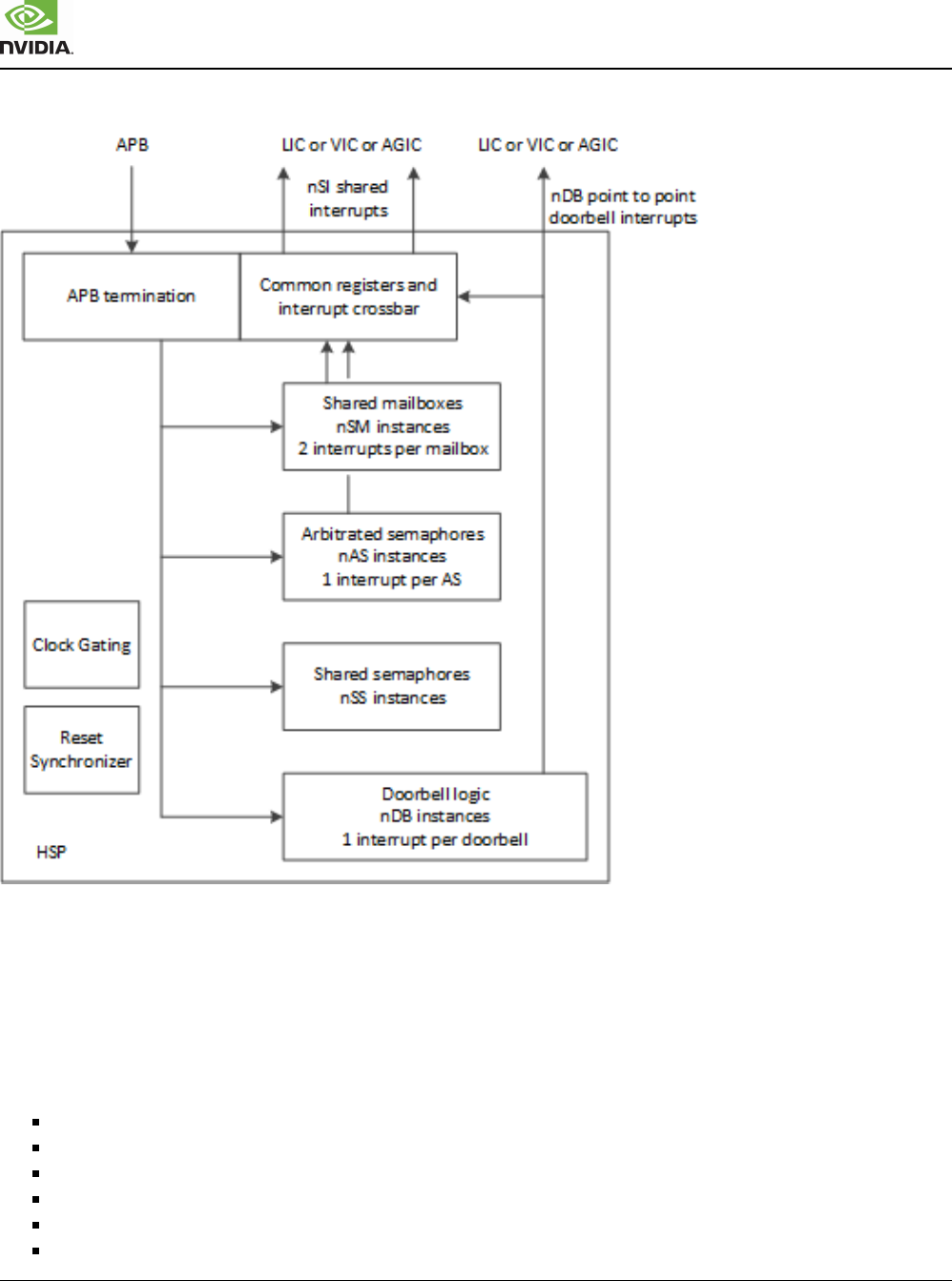
Xavier Series SoC Technical Reference Manual
XAVIER | TRM | DP-09253-002_v1.1 | SUBJECT TO CHANGE | www.nvidia.com Page of 6340 8287
Figure 8.24 Decomposition of the Hardware Synchronization Primitive
The HSP module is instantiated multiple times in Xavier, together with the number of instances of the different
primitives inside each instance.
Note: Only two different configurations are present to limit the design and verification effort (shown as the type
column). In addition, each configuration can have a redundant version.
In the following table:
nSM is the number of Shared Mailboxes
nAS is the number of Arbitrated Semaphores
nSS is the number of Shared Semaphores
nDB is the number of Doorbells
nSI is the number of Shared Interrupts (see below)
Red shows which HSPs are redundant
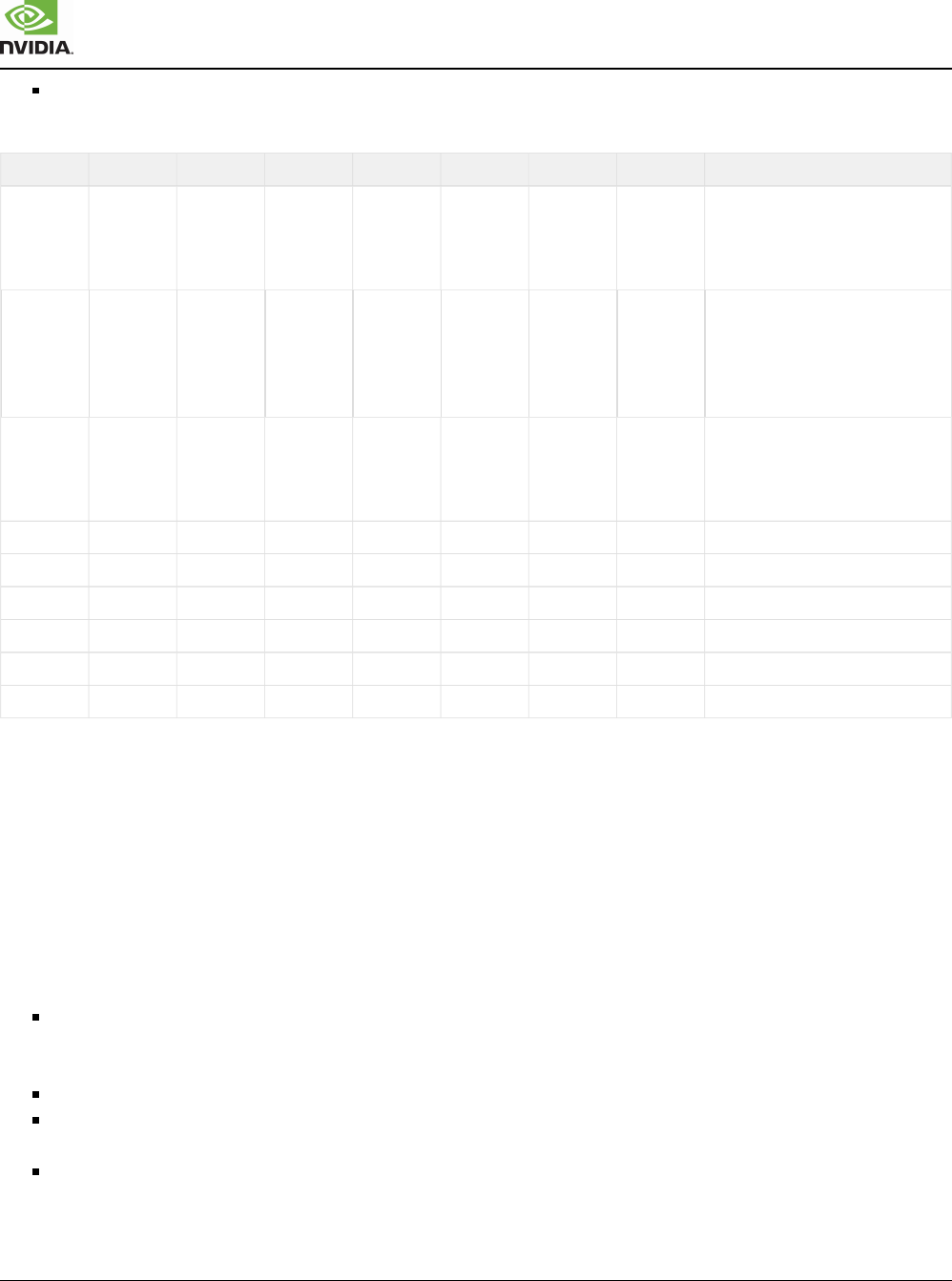
Xavier Series SoC Technical Reference Manual
XAVIER | TRM | DP-09253-002_v1.1 | SUBJECT TO CHANGE | www.nvidia.com Page of 6341 8287
Type shows the two possible HSP configurations
Table 8.54 HSP Module Instantiation
Location nSM nAS nSS nDB nSI Red Type Description
Top0 8 2 2 8 8 Yes 0 Each doorbell has an identified
destination. Other resources at
top are unallocated at this time to
cover as yet unidentified needs.
Top1 8 0 4 0 5 Yes 1 Reserved for virtualization.
Allows for a total of eight
bidirectional mailboxes at top,
same as Cortex-R5 HSP for
convenience.
BPMP 8 0 4 0 5 1 All Cortex-R5 clusters, the
Cortex-A9 cluster, and the Top1
instance use a similarly
configured HSP.
AON 8 0 4 0 5 1
SCE 8 0 4 0 5 Yes 1
APE 8 0 4 0 5 1
RCE 8 0 4 0 5 Yes 1
PVA0 8 0 4 0 5 1
PVA1 8 0 4 0 5 1
The Shared Mailboxes, Arbitrated Semaphores, and Shared Semaphores are always replicated per security
level, and each HSP supports two different security levels (TrustZone or non-TrustZone), so that nSM, nAS,
®
and nSS are always a multiple of two to allow differentiation between two security levels. The doorbell logic is
only duplicated for the CPU where one doorbell can be used to ping the TrustZone secure software without
interference from TrustZone non-secure software or exposing any information to the TrustZone non-secure
software.
Doorbells are system resources, instantiated once into a top level HSP. Doorbell interrupts are sent to specific
targets:
Two doorbells connected to the LIC, and from there to the CCPLEX GIC, are normally mapped to TrustZone secure
and non secure. (The CCPLEX CPU doorbell signals could be made directly visible to the CCPMU, this is not done in
Xavier.)
One doorbell directly connected to the CCPMU inside CCPLEX (the MCE used to communicate with BPMP).
Four doorbells for AON, BPMP, SCE, and RCE Cortex-R5 clusters. Each doorbell connected to VIC inside a Cortex-
R5 cluster.
One doorbell connected to the APE GIC.
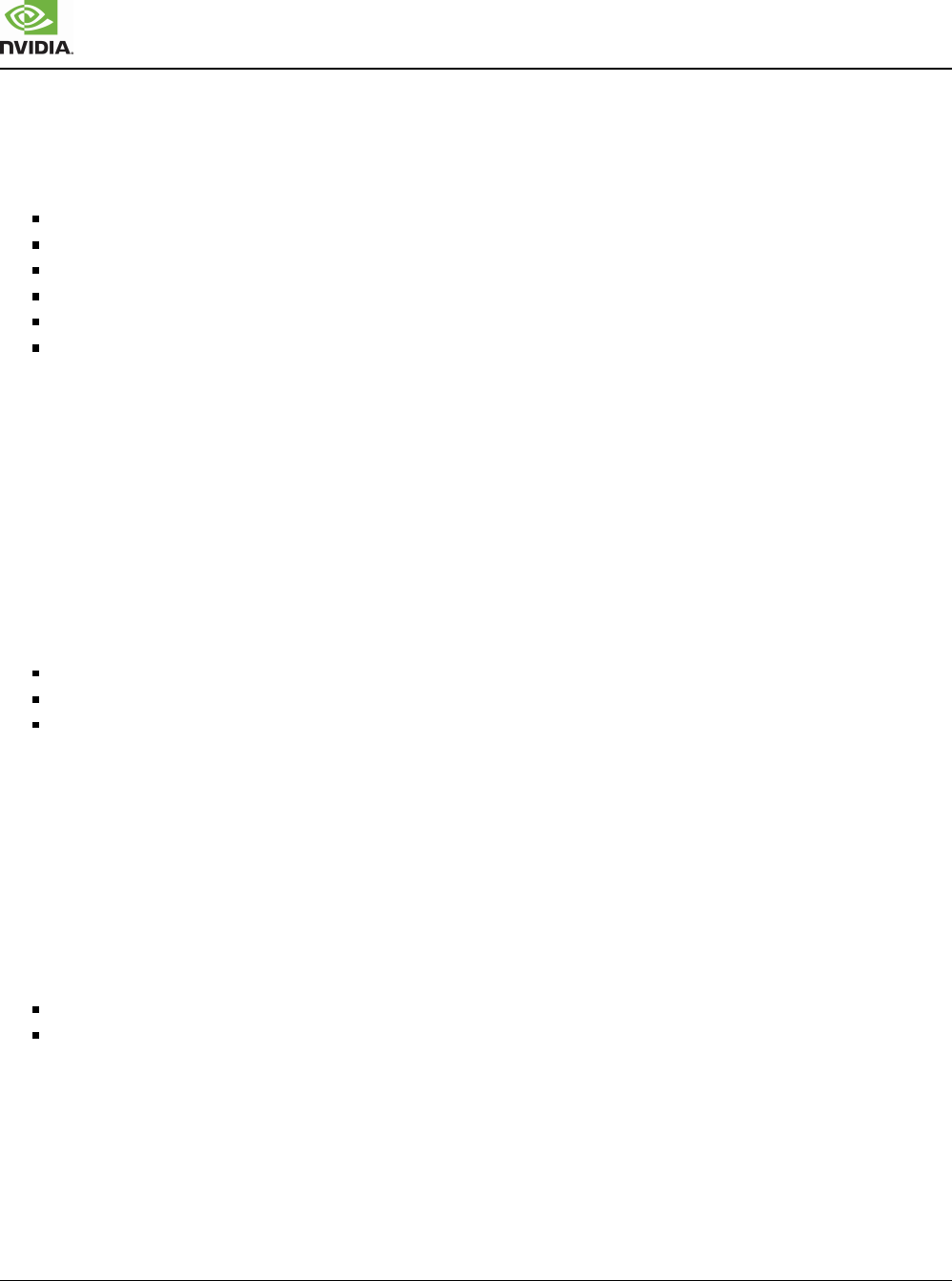
Xavier Series SoC Technical Reference Manual
XAVIER | TRM | DP-09253-002_v1.1 | SUBJECT TO CHANGE | www.nvidia.com Page of 6342 8287
Sub-Unit Descriptions
The HSP module has these main blocks:
APB termination
Common registers and interrupt crossbar
Shared mailboxes
Shared semaphores
Arbitrated semaphores
Doorbells
APB Termination
The APB termination logic is a slave APB that transforms incoming APB transactions into local register read
and write operations. The HSP APB termination implements the new security model.
Common Registers and Interrupt Crossbar
The common registers and interrupt crossbar block contains the interrupt routing logic that takes the set of local
interrupts and generates a set of shared interrupts, connected to an interrupt controller associated with the
instance:
LIC for all HSP instantiated at top
Local VIC for HSP instantiated inside a Cortex-R5 cluster
Cortex-A9 GIC for HSP instantiated inside the APE
The number of shared interrupts, nSI, is a parameter configurable by instance and specified in the HSP Module
Instantiation table.
Shared Mailboxes
The shared mailboxes are word width registers with a very simple interrupt mechanism controlled by the MSB.
Their usual operating model is single writer/single reader.
Each shared mailbox has the following resources:
A 32-bit register
Full and empty interrupts controlled by the value of the MSB. The MSB is interpreted as a Valid bit, so the full
interrupt is the value of the MSB and the empty interrupt is the inverted value of the MSB.
All security aspects are handled by using the new security model for register access.
The number of shared mailboxes is extended to support more than one pair of communicating processors and
virtualization requirements. There are 16 unidirectional mailboxes (eight for TOP0 and eight for TOP1) at
TOP_HSP and eight unidirectional mailboxes local to each Cortex-R5 and Cortex-A9 cluster: APE, BPMP,
AON, RCE, and SCE.
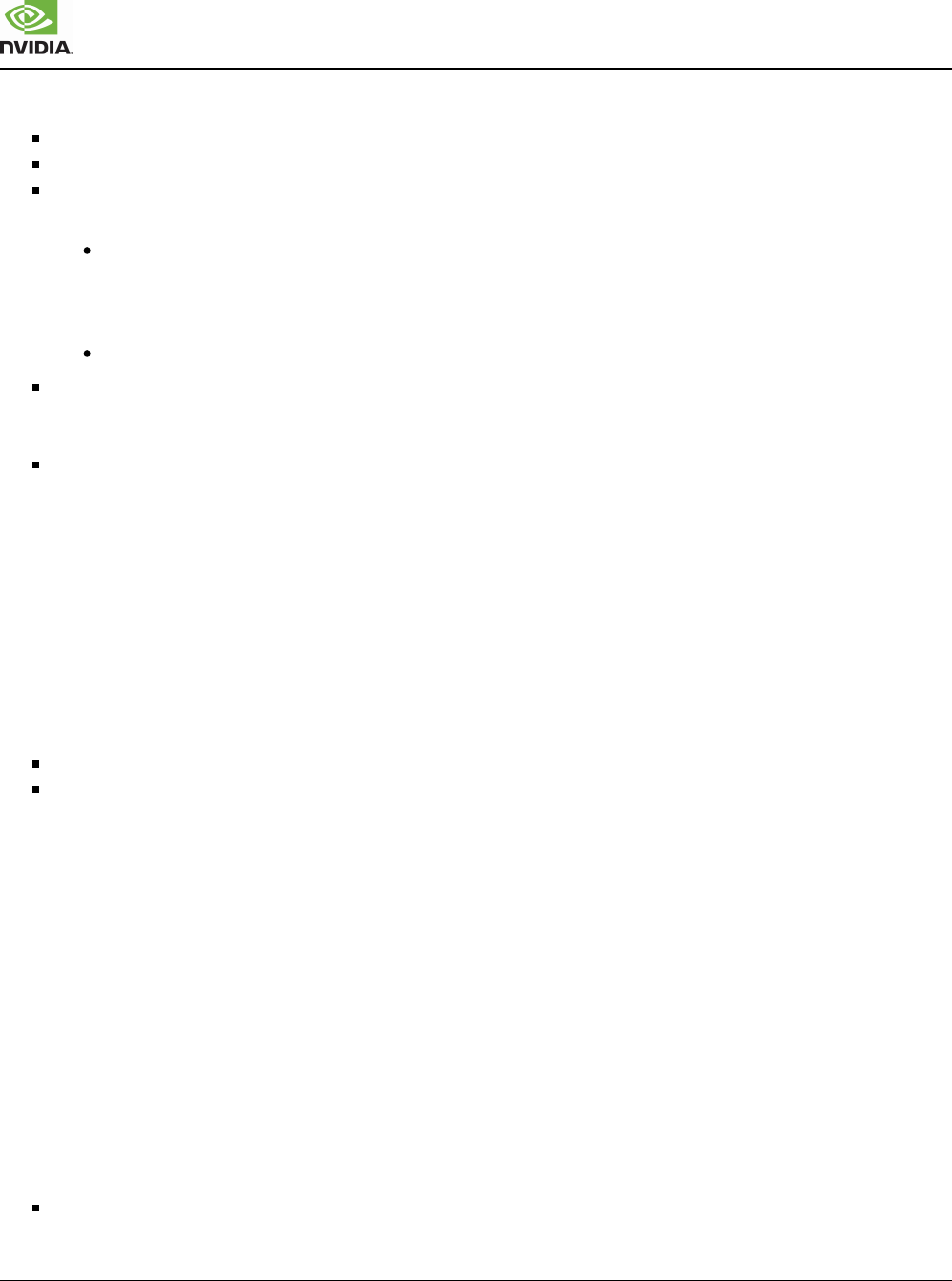
Xavier Series SoC Technical Reference Manual
XAVIER | TRM | DP-09253-002_v1.1 | SUBJECT TO CHANGE | www.nvidia.com Page of 6343 8287
The expected usage model of shared mailboxes is:
Dedicated to a specific consumer, as it is generally easier to share the input port
Dedicated to a bidirectional IPC method, in which case shared mailboxes are allocated as a pair, one per direction
Preferably, the IPC is between one producer and one consumer to avoid resource conflicts
This is not always possible in multithreaded or multiprocessor use cases, in which either:
A single threaded software agent is used as a resource manager per direction, arbitrating, and dispatching
message. This assumes that all software producers are able to synchronize using software mechanisms, i.e.,
not shared mailboxes, and the same for all software consumers. This is a viable model for the BPMP CCPLEX
IPC.
The input and output semaphores are used for resource sharing
No easy way to operate a mailbox with agents at different levels of security on the same port. If the IPC requires a
mix of security levels and QoS per level, the IPC must use as many mailboxes as required to achieve the required
QoS.
Targeting (very) short messages, not bulk transfer. The base assumption is that the message can identify a descriptor
for a larger structure when needed, possibly via an address offset against some known base or an index in a list or
whatever is convenient for software. Shared mailboxes are not optimized for bandwidth.
Shared Semaphores
The shared semaphores are registers with associated SET/CLR addresses to allow easy manipulation of
individual bits inside them, i.e., without the need for a RMW operation. There is no hardware arbitration, so
software must statically allocate the ownership of individual semaphores for correct operation.
The shared semaphores are formed by three registers, each 32 bits wide:
Read-only register showing the current value of the semaphore
Two write-only registers to set and clear individual semaphore bits
These semaphores can be used for synchronizing processors acting in a producer/consumer relationship, i.e., a
pair of them can be used to implement either a two- or four-way handshake.
Correct operation of the shared semaphores require to statically allocate an owner for each bit, because it is
impossible to implement an atomic test and set (or similar operation) given the register interface. It also means
that calling them "semaphores" is a bit misleading; they are simply atomic set and atomic clear registers.
Arbitrated Semaphores
The arbitrated semaphores are true binary semaphores that also include state information to avoid a busy spin
loop if so wanted. The arbitrated semaphores support two sides, simply denoted 0 and 1, and arbitrates
between requests coming from each side.
In essence, the arbitrated semaphores are built in the following way, all registers being 32 bits wide:
A set of read only flags representing ownership (SMP_GNT_ST), showing ownership of the semaphore, one register
per side (0 and 1).

Xavier Series SoC Technical Reference Manual
XAVIER | TRM | DP-09253-002_v1.1 | SUBJECT TO CHANGE | www.nvidia.com Page of 6344 8287
1.
2.
A set of write only trigger request flags (SMP_GET), a processor can only acquire a resource (represented by a bit in
the status word) through setting a corresponding request flag. The request is blocked until the resource is not owned
by a different processor. Currently, request flags are only cleared by acquiring the resource. Again, there is one
register per side (0 and 1).
A set of clear flags (SMP_PUT), a processor relinquishes ownership by writing a one bit corresponding to the shared
resource (write only).
A set of request status flags (SMP_REQ_ST) showing the current pending requests (read only)
One companion set of registers is defined, with one register per side (0 and 1).
Enable register (INT_EN), enabling the generation of an interrupt if the corresponding status bit toggles.
Storing the request information instead of simply using write triggers allows the following implementation to
avoid the typical busy spin lock loop and the corresponding waste of bandwidth and power.
EnableOwnershipInterrupt (i);
RequestResource (i);
WaitForInterrupt();
Doorbell Logic
A doorbell allows a set of source agents in Xavier to request the attention of a specified target agent.
The doorbell logic presents two logically separate interfaces:
The trigger interface can be used by any master in the system; the doorbell logic uses source ID tracking to recognize
the exact source.
The control interface is normally configured for use by the target agent only.
The trigger interface also distinguishes between TrustZone secure and not secure security levels. The doorbell
includes one bit per possible source, per supported security level. Writing to the trigger interface sets a
corresponding bit as shown in the pseudo code below (for one doorbell):
SourceID = f(pUSER) // extract source ID for APB USER field
If TriggerWrite
If pns == TZ_SECURE: Map_0[SourceID] = 1b
If pns == TZ_NOT_SECURE: Map_1[SourceID] = 1b
The control logic uses security aware registers to control whose agent has access to it, with the following set of
registers:
Standard security configuration register to specify the exact security model
Bitmap indicating which sources can raise the doorbell signal and at which security level
Status/control register indicating the set of sources with pending flags (clear on write)
Status/control register indicating the raw bitmap (clear on write)
The control logic then generates one doorbell signal per doorbell. The doorbell signals are:
Exposed as a port with a direct connection to the target processor cluster interrupt controller
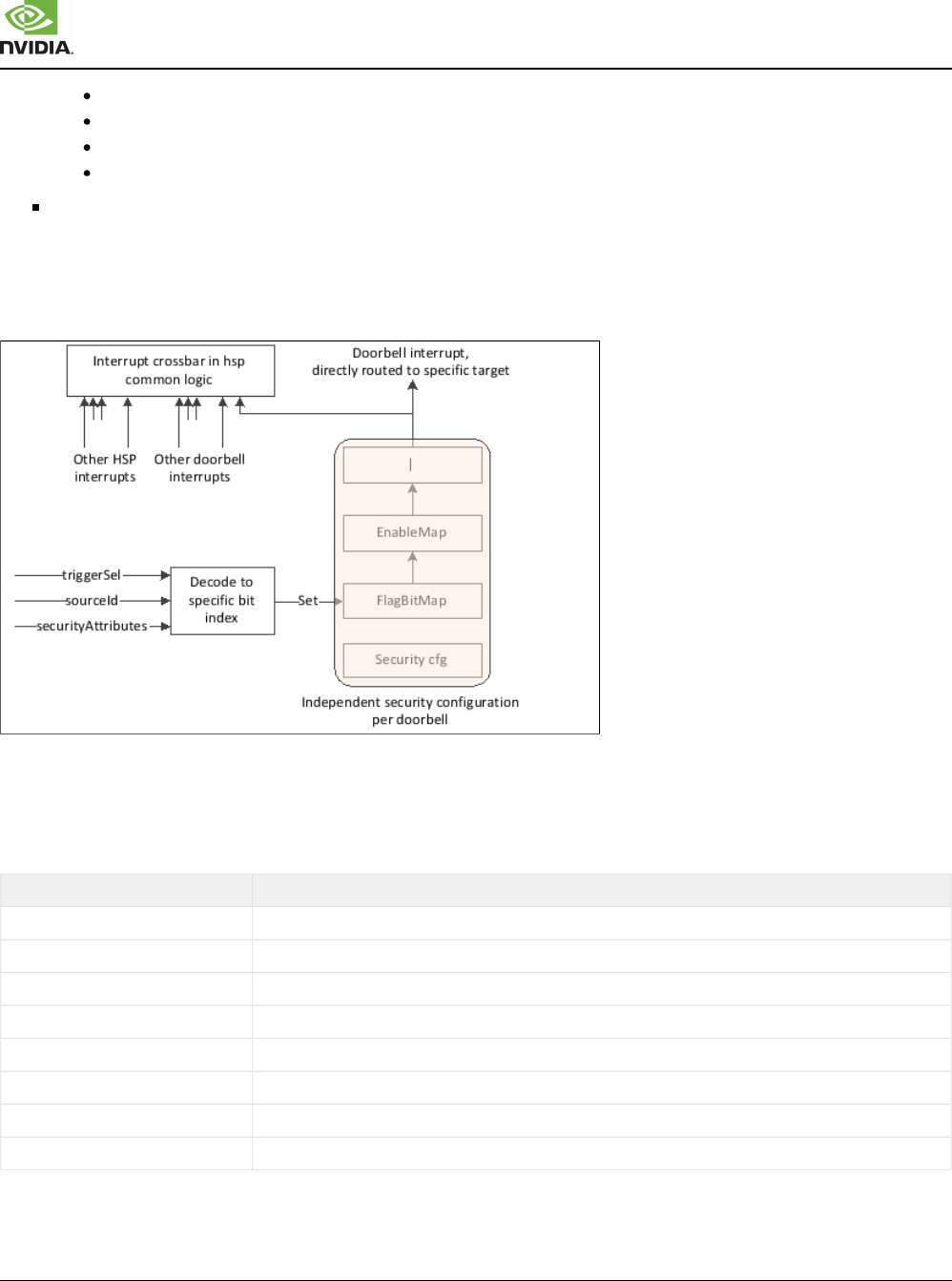
Xavier Series SoC Technical Reference Manual
XAVIER | TRM | DP-09253-002_v1.1 | SUBJECT TO CHANGE | www.nvidia.com Page of 6345 8287
VIC inside a Cortex-R5 cluster
GIC inside the APE cluster
LIC for CCPLEX, and from there directly to the GIC, as the GIC is essentially transparent for the CCPLEX path
CCPLEX power management
Exposed to the interrupt crossbar logic in the HSP, so that it can be mapped as a HSP shared interrupt, allowing the
doorbell to be routed to a different target.
The operation of one doorbell is illustrated in the figure below:
Figure 8.25 Doorbell Logic
Doorbells are identified by numbers, with the following mapping between a doorbell number and its intended
destination.
Table 8.55 Mapping between Doorbell Number and Usage
Doorbell Target
0 CCPLEX power management
1 CCPLEX TrustZone not secure
2 CCPLEX TrustZone secure
3 BPMP
4 AON
5 SCE
6 APE
7 RCE

Xavier Series SoC Technical Reference Manual
XAVIER | TRM | DP-09253-002_v1.1 | SUBJECT TO CHANGE | www.nvidia.com Page of 6346 8287
1.
2.
3.
4.
5.
6.
7.
1.
2.
3.
4.
5.
6.
7.
8.
Multiple Processors Access to Shared Resources
Xavier does not support full coherency mechanisms, so an IPC protocol must tackle ordering and visibility
issues. The protocol uses a doorbell interrupt to get attention and a standard structure of circular buffers plus
associated read/write pointers in shared memory (internal or external). With this model, the expected software
sequence looks like the following:
Source Processor
Writes a set of messages with known format in shared memory circular buffer structure
If the shared memory is cacheable, flushes its cache to make the messages globally visible
Issues a DMB to ensure that pointer and message are ordered
Writes the value of the write pointer at known location in shared memory
If the shared memory is cacheable, flushes its cache
Issues a DMB to ensure ordering between pointer and interrupt
Writes to a doorbell register in MMIO space to trigger the interrupt to the destination
Destination Processor
Receives doorbell interrupt and enters Interrupt Service Routine
Reads the associated doorbell status register to identify the set of source processors with pending messages
Cache invalidates the address used by the write pointer for the source processor circular buffer
Issues a DMB
Read the write pointer
Cache invalidates the addresses used by the set of messages identified by the write pointer
Issues a DMB
Reads the set of messages
Using Doorbells for Handshake during Boot Sequence
During the boot sequence, the doorbells are used to synchronize the boot sequence across multiple
processors. Each doorbell allows for a full handshake between two processors, denoted as B (normally BPMP)
and D (normally CCPLEX power management). The handshake makes sure that D executes a specific task A
at a time controlled by B and works like this.
B performs all tasks that must be done before task A can be done. When everything is ready, B signals to D that it
can proceed by ringing D doorbell (i.e., writing to the doorbell trigger register). B can continue working on other tasks
not dependent on task A completion. When it reaches a point that requires task A to be complete, B check the
doorbell pending status. If the doorbell is still asserted, B waits for completion by polling on the doorbell status.
D performs all tasks that must be done before task A can be done. When everything is ready D checks if its doorbell
is asserted. If not, it polls on its doorbell until assertion.
D performs task A, then signals completion to B by clearing the doorbell (i.e., by writing to the doorbell pending
status). Clearing the doorbell is acting as an acknowledge by D.
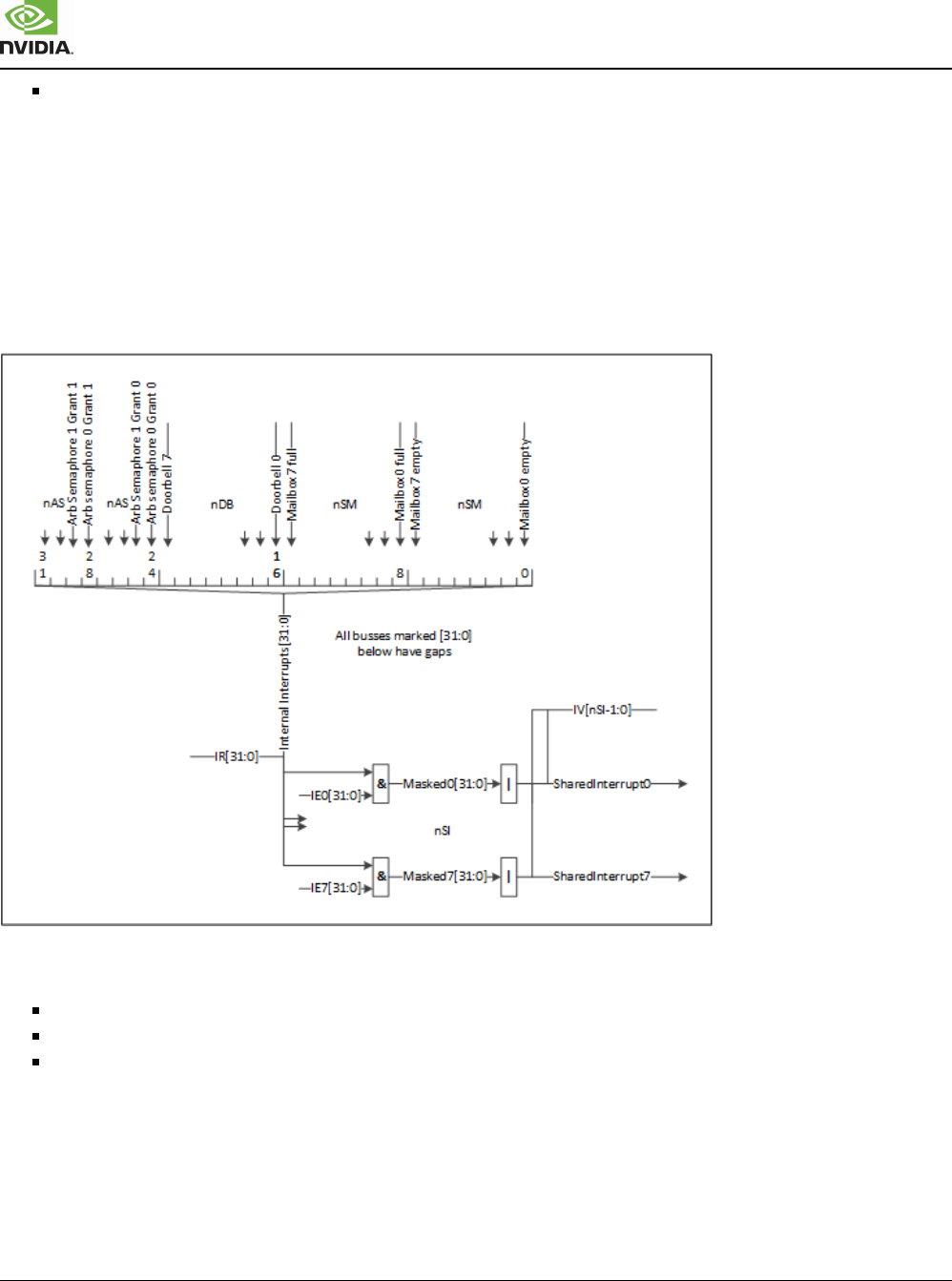
Xavier Series SoC Technical Reference Manual
XAVIER | TRM | DP-09253-002_v1.1 | SUBJECT TO CHANGE | www.nvidia.com Page of 6347 8287
When B sees the doorbell pending status deasserted, it knows that task A is complete and can now execute tasks
dependent on task A completion.
Shared Interrupts Configuration
Each shared interrupt is the aggregate of the selected bits; in other words, each shared interrupt is driven by the
same structure of AND followed by OR used in LIC. The figure below shows the logic for the Top0 HSP
instance.
Figure 8.26 Shared Interrupt Logic
Assume that software wants to map the shared interrupts as follows:
Shared0 is a (aggregated) mailbox empty, so IE0 = 0xFF
Shared1 is a (aggregated) mailbox full, so IE1 = 0xFF << 8
Shared2 is Arbitrated Semaphore 0, and Arbitrated Semaphore 1 is not used, so IE2 = 0x1 << 24
8.5.3 Programming Model
The programming model is register based.

Xavier Series SoC Technical Reference Manual
XAVIER | TRM | DP-09253-002_v1.1 | SUBJECT TO CHANGE | www.nvidia.com Page of 6348 8287
1.
2.
1.
2.
1.
2.
3.
1.
2.
3.
8.5.4 HSP Programming Guidelines
Shared Mailboxes
A shared mailbox serves a unidirectional communication between a producer and a consumer. The two masters
agree upon a mailbox to use, and which master is the producer and which master is the consumer. In the
following sequences, it is assumed that shared mailbox {sm} is selected.
Producer Sending a Message
Make sure the selected shared mailbox is empty by checking the TAG field of register HSP_SHRD_MBOX_MBOX_
{sm}_SHRD_MBOX_0.
Write the message in the DATA field of register HSP_SHRD_MBOX_MBOX_{sm}_SHRD_MBOX_0. Set the TAG
field of the register to 1.
Consumer Receiving a Message
Read register HSP_SHRD_MBOX_MBOX_{sm}_SHRD_MBOX_0. If TAG field is 1, then the DATA field carries the
message.
After consuming the message in the mailbox, set the TAG field of the register to 0. The DATA field is don't care and
can be written with any value.
Shared Semaphores
A producer/consumer pair uses shared semaphore to synchronize management of a shared resource. Each bit
in a shared semaphore register represents a shared semaphore. The producer and consumer select a shared
semaphore to use (a particular shared semaphore register and a particular bit) and agree on their roles.
In the following sequences, we assume bit {b} of shared semaphore register {ss} is selected.
Producer
Make sure the shared semaphore is empty by checking that bit {b} in HSP_SHRD_SEM_{ss}_SHRD_SMP_STA_0 is
0.
The Producer writes to the shared resource.
Indicate the data in the shared resource is ready for consumption by writing 1 to bit {b} in HSP_SHRD_SEM_{ss}
_SHRD_SMP_STA_SET_0.
Consumer
The shared resource is ready for consumption when reading HSP_SHRD_SEM_{ss}_SHRD_SMP_STA_0 return
value 1 in bit {b}.
The Consumer consumes the data in the shared resource.
Indicate that the shared resource is available for new data by writing 1 to bit {b} in HSP_SHRD_SEM_{ss}
_SHRD_SMP_STA_CLR_0.

Xavier Series SoC Technical Reference Manual
XAVIER | TRM | DP-09253-002_v1.1 | SUBJECT TO CHANGE | www.nvidia.com Page of 6349 8287
1.
2.
3.
1.
2.
1.
1.
2.
Arbitrated Semaphores
Each arbitrated semaphore is accessed through two register sets, indexed by 0 and 1; one set for each master
sharing the arbitrated semaphore. Each bit in the arbitrated semaphore register corresponds to an arbitrated
semaphore. The two masters agree on an arbitrated semaphore to use (a particular arbitrated semaphore
register and a particular bit), and agree on which master takes register set 0 and which master takes register
set 1.
In the following sequences, we assume bit {b} of the arbitrated semaphore register {as} is selected.
Requesting Semaphore with Interrupt
Enable the ownership interrupt by setting the corresponding bit in HSP_ARB_SEM{0,1}_{as}_INT_EN_0.
Set the corresponding bit in HSP_ARB_SEM{0,1}_{as}_SMP_GET_0 to 1.
Wait for the interrupt. When that happens, the semaphore is acquired.
Requesting Semaphore with Busy Spin Lock
Set bit {b} in HSP_ARB_SEM{0,1}..{as}_SMP_GET_0 to 1.
Poll register HSP_ARB_SEM{0,1}..{as}_SMP_GNT_ST_0. When the bit {b} is 1, the semaphore is acquired.
Relinquishing Semaphore
Set bit {b} in HSP_ARB_SEM{0,1}_{as}_SMP_PUT_0 to 1.
Doorbells
A triggering master can ask for attention from the receiving master by ringing the doorbell of the receiving
master. In the following sequences, we assume {db} is the doorbell index of the receiving master. There is a
dedicated doorbell for each master in TOP0_HSP.
Ringing a Doorbell
Check that the receiving master receives the doorbell by ensuring that the bit corresponds to the triggering master
and its security level of HSP_DBELL_{db}_ENABLE_0 is 1.
Write to HSP_DBELL_{db}_TRIGGER_0. Any value can be written.
Answering a Doorbell
After servicing a doorbell, the receiving master clears the doorbell from a particular master and security level by
writing 1 to the corresponding bit in HSP_DBELL_{db}_PENDING_0.

Xavier Series SoC Technical Reference Manual
XAVIER | TRM | DP-09253-002_v1.1 | SUBJECT TO CHANGE | www.nvidia.com Page of 6350 8287
1.
2.
8.5.5 HSP Registers
The set of registers is split across the different modules, each set share a common base. Each module has a
number of 64-KiB pages to help in virtualization in Xavier and all of the modules expose their registers via an
APB interface. Each submodule in HSP has its own set of 64-KiB pages plus an extra 64-KiB page for the
common registers. The different windows are placed one after the other in this order:
One 64-KiB page for the common registers
nSM/2 64-KiB pages for the shared mailboxes, grouped in pairs to support bidirectional communication. The number
of mailboxes in a given HSP must be even.
nSS 64-KiB pages for the shared semaphores
nAS 64-KiB pages for the arbitrated semaphores
One 64-KiB page for the doorbells.
All these are referred to a base address shown as HSP_{inst}_BASE in this document, where {inst} identifies
the specific HSP instance.
All transactions sent to a given module must be terminated, if an address is not assigned or if the access
violates some access restrictions, an error response is sent and the access does not affect any state outside of
the APB interface itself.
Common Registers
Common registers are used for two independent reasons:
For truly common functionality
To increase the functionality while keeping the legacy architecture. This is done for security handling. It is
recommended for some modules are treated as one security group, with the security handling performing in a
wrapper that instantiates the legacy code.
The common registers offset is from HSP_{inst}_BASE. The common registers consist of Security Control
Registers (SCRs) and HSP Interrupt registers:
HSP_SCR_SS_{ss}_REG_0
HSP_SCR_AS_{as}_REG_0
HSP_SCR_SM_{sm}_REG_0
HSP_SCR_DBELL_{db}_REG_0
HSP_INT_SCR_SCR_C0_REG_0
HSP_INT_IE{i}_0 (register array)
HSP_INT_IV_0
HSP_INT_IR_0
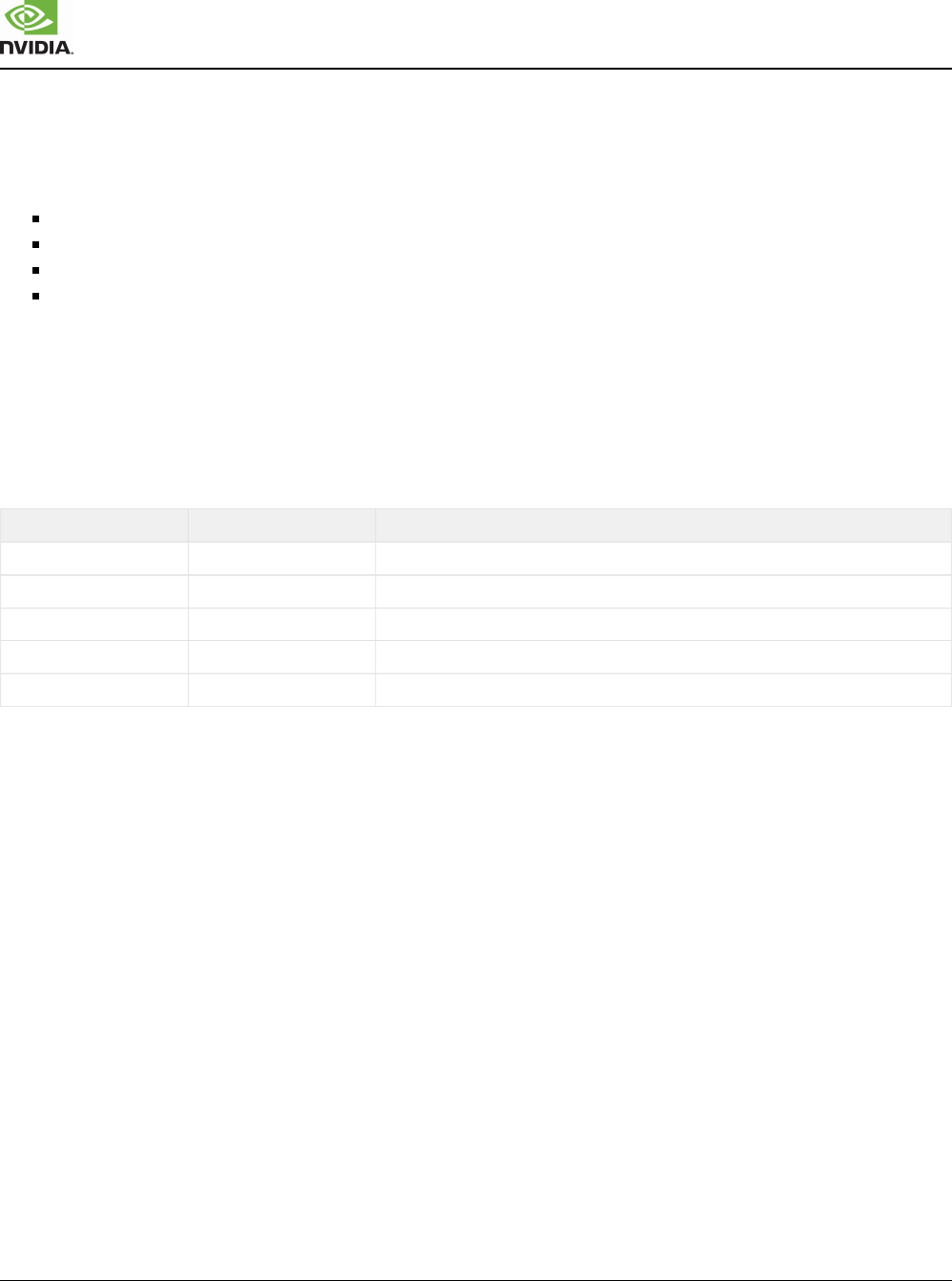
Xavier Series SoC Technical Reference Manual
XAVIER | TRM | DP-09253-002_v1.1 | SUBJECT TO CHANGE | www.nvidia.com Page of 6351 8287
HSP Interrupt Registers
The mapping of the HSP internal interrupts is defined as follows:
Bits[00 + [nSM-1:0]] are the empty interrupts of the nSM instantiated shared mailboxes
Bits[08 + [nSM-1:0]] are the full interrupts of the nSM instantiated shared mailboxes
Bits[16 + [nDB-1:0]] are the interrupts of the nDB instantiated doorbells
Bits[24 + [nAS-1:0]] are the grant interrupts of the nAS instantiated arbitrated semaphores
Bits not defined by the mapping above are marked reserved and not physically present. This is true for both IE
{i} and IR registers. Note that this mapping means that nSM, nDB cannot exceed 8 and nAS cannot exceed 4,
for a given HSP instance.
These registers have the same bit mapping, shown in the following table.
Table 8.56 Format of the IE{i} and IR Interrupt Registers
Bit Reset Description
31:28 0x0 smp1_gnt_enable/valid/asserted
27:24 0x0 smp0_gnt_enable/valid/asserted
23:16 0x0 dbell_enable/valid/asserted
15:8 0x0 mbox_full_enable/valid/asserted
7:0 0x0 mbox_empty_enable/valid/asserted
HSP_INT{i}_IE_0
This is an array of eight identical register entries. This array controls the routing of interrupt {i}, a bit mask
indicating which of the internal interrupts is propagated to external interrupt {i}, {i} in [0:nSI-1].
ExternalInterrupts[i] = |(IE{i} & InternalInterrupts}
See the Format of the IE{i} and IR Interrupt Registers table for the organization of the register fields.
Offset: 0x100..0x11f | Read/Write: R/W | SCR Protection: SCR_C0_REG_0 | Reset: 0x00000000
HSP_INT_IV_0
This register contains the currently asserted shared interrupts, ExternalInterrupts.
Each bit of IV is mapped to the corresponding shared interrupt.
Offset: 0x300 | Read/Write: RO | SCR Protection: SCR_C0_REG_0 | Reset: 0x00000000
HSP_INT_IR_0
This register indicates the currently asserted internal interrupts, InternalInterrupts.

Xavier Series SoC Technical Reference Manual
XAVIER | TRM | DP-09253-002_v1.1 | SUBJECT TO CHANGE | www.nvidia.com Page of 6352 8287
See the Format of the IE{i} and IR Interrupt Registers table for the organization of the register fields.
Offset: 0x304 | Read/Write: RO | SCR Protection: SCR_C0_REG_0 | Reset: 0x000000ff
HSP_INT_SPARE_0
Offset: 0x308 | Read/Write: R/W | Reset: 0x00000000 (0bxxxx,xxxx,xxxx,xxxx,xxxx,xxxx,xxxx,0000)
Bit Reset Description
3:0 0x0 spare
HSP_INT_HSP_CLK_OVR_0
Offset: 0x30c | Read/Write: R/W | Reset: 0x00000000 (0bxxxx,xxxx,xxxx,xxxx,xxxx,xxxx,xxxx,xxx0)
Bit Reset Description
0 0x0 hsp_clk_ovr_on
HSP_INT_DIMENSIONING_0
Offset: 0x380 | Read/Write: RO | Reset: 0x000XXXXX (0bxxxx,xxxx,xxxx,xxxx,xxxx,xxxx,xxxx,xxxx)
Bit Reset Description
19:16 X nSI: Number of shared interrupts in this instance
15:12 X nDB: Number of doorbells in this instance
11:8 X nAS: Number of arbitrated semaphores in this instance
7:4 X nSS: Number of shared semaphores in this instance
3:0 X nSM: Number of shared mailboxes in this instance
Shared Mailbox Registers
Shared mailboxes are placed 32 KiB apart, so that a pair is mapped in a 64 KiB page. The base for a given
mailbox is SM{sm} {inst}_BASE + 64 KiB + {sm} * 32 KiB.
BASE{sm} = HSP
HSP_SHRD_MBOX_MBOX_{sm}_SHRD_MBOX_0
Software-controlled mailbox registers. There are eight shared mailbox registers, where {sm} = 0 through 7.
Offset: 0x0 + (sm * 0x8000) | Read/Write: R/W | SCR Protection: SM_{sm}_REG_0 | Reset: 0x00000000
(0b0000,0000,0000,0000,0000,0000,0000,0000)
Bit Reset Description
31
0

Xavier Series SoC Technical Reference Manual
XAVIER | TRM | DP-09253-002_v1.1 | SUBJECT TO CHANGE | www.nvidia.com Page of 6353 8287
Bit Reset Description
TAG: This bit acts as a Valid bit for the mailbox. The mailbox is deemed full when TAG = 1b and empty when
TAG = 0b, with the status also reflected in corresponding interrupts. The producer writes TAG to 1b to signal
the availability of a message; the consumer writes TAG to 0b to signal that the message has been fully
handled.
30:0 0 DATA: Value exchanged between producer and consumer. No hardware semantic.
HSP_SHRD_MBOX_MBOX_{sm}_SHRD_MBOX_FULL_INT_IE_0
Offset: 0x4 + (sm * 0x8000) | Read/Write: R/W | Parity Protection: N | SCR Protection: SM_{sm}_REG_0 |
Reset: 0x00000001 (0bxxxx,xxxx,xxxx,xxxx,xxxx,xxxx,xxxx,xxx1)
Bit Reset Description
0 0x1 ENABLE: Mailbox full interrupt enable
HSP_SHRD_MBOX_MBOX_{sm}_SHRD_MBOX_EMPTY_INT_IE_0
Offset: 0x8 + (sm * 0x8000) | Read/Write: R/W | Parity Protection: N | SCR Protection: SM_{sm}_REG_0 |
Reset: 0x00000001 (0bxxxx,xxxx,xxxx,xxxx,xxxx,xxxx,xxxx,xxx1)
Bit Reset Description
0 0x1 ENABLE: Mailbox empty interrupt enable
Shared Semaphore Registers
Each shared semaphore instance has an associated page starting at SS{ss} {inst}_BASE + (1 +
BASE = HSP
nSM/2) * 64 KiB + {ss} * 64 KiB.
HSP_SHRD_SEM_{ss}_SHRD_SMP_STA_0
There are eight shared semaphore status registers, where {ss} is 0 through 7. This register gives the current
status for the shared semaphore instance.
Offset: 0x000 + (ss * 0x10000) | Read/Write: RO | SCR Protection: SS_{ss}_REG_0 | Reset: 0x00000000
Bit Reset Description
31:0 0 SMP: Current value. Each bit is an individual semaphore.
HSP_SHRD_SEM_{ss}_SHRD_SMP_STA_SET_0
There are eight shared semaphore set registers, where {ss} is 0 through 7. Set the bits in this register to update
the current value.
Offset: 0x004 + (ss * 0x10000) | Read/Write: WO | SCR Protection: SS_{ss}_REG_0 | Reset: NA

Xavier Series SoC Technical Reference Manual
XAVIER | TRM | DP-09253-002_v1.1 | SUBJECT TO CHANGE | www.nvidia.com Page of 6354 8287
Bit Reset Description
31:0 NA SMP_SET: Writing bit i to 1b sets semaphore bit i. Undefined for reads.
HSP_SHRD_SEM_{ss}_SHRD_SMP_STA_CLR_0
There are eight shared semaphore clear registers, where {ss} is 0 through 7. Clear the bits in this register to
update the current value.
Offset: 0x008 + (ss * 0x10000) | Read/Write: WO | SCR Protection: SS_{ss}_REG_0 | Reset: NA
Bit Reset Description
31:0 NA SMP_CLR: Writing bit i to 1b clears semaphore bit i. Undefined for reads.
Arbitrated Semaphore Registers
Arbitrated semaphore instance {as} has a register range starting at AS{as} {inst}_BASE + (1 + nSM
BASE = HSP
/2 + nSS) * 64 KiB + {as} * 64 KB. Each arbitrated semaphore instance contains two apertures, identified as {a}
in {0,1}, corresponding to two different owners. The owner associated with an aperture is defined by software
convention. The following table shows the base offset according to arbitrated semaphore instance and aperture.
Table 8.57 Base Offsets of Arbitrated Semaphore Registers
Semaphore Instance {as} Base Offset
Aperture 0 {a} = 0 Aperture 1 {a} = 1
0 0x00 0x20
1 0x10000 0x10020
2 0x20000 0x20020
3 0x30000 0x30020
HSP_ARB_SEM{a}_{as}_SMP_GNT_ST_0
This register indicates current ownership; each bit is an individual semaphore. There are eight Arbitrated
Semaphore Grant Status registers, where {as} = semaphore 0 through 3 and {a} = aperture 0 or 1.
Offset: Base | Read/Write: RO | SCR Protection: AS_{as}_REG_0 | Reset: 0x00000000 (0b0000,
0000,0000,0000,0000,0000,0000,0000)
Bit Reset Description
31:0 0 STATUS: Bit i at 1 indicates aperture{a} is the current owner of resource i

Xavier Series SoC Technical Reference Manual
XAVIER | TRM | DP-09253-002_v1.1 | SUBJECT TO CHANGE | www.nvidia.com Page of 6355 8287
HSP_ARB_SEM{a}_{as}_SMP_GET_0
There are eight Arbitrated Semaphore Get registers, where {as} = semaphore 0 through 3 and {a} = aperture 0
or 1. Use this register to make a request for ownership.
Offset: Base + 0x4 | Read/Write: WO | SCR Protection: AS_{as}_REG_0 | Reset: 0x00000000 (0b0000,
0000,0000,0000,0000,0000,0000,0000)
Bit Reset Description
31:0 NA GET: Writing bit i to 1b is a request for ownership of resource i from aperture {a}. All pending requests are
accumulated in an internal register visible as HSP_ARB_SEM{a}_{as}_REQ_ST_0. Requests cannot be
canceled; a request bit gets cleared when ownership is acquired.
HSP_ARB_SEM{a}_{as}_SMP_PUT_0
There are eight Arbitrated Semaphore Put registers, where {as} = semaphore 0 through 3 and {a} = aperture 0
or 1. Use this register to relinquish ownership.
Offset: Base + 0x8 | Read/Write: WO | SCR Protection: AS_{as}_REG_0 | Reset: 0x00000000 (0b0000,
0000,0000,0000,0000,0000,0000,0000)
Bit Reset Description
31:0 NA PUT: Writing bit i to 1b relinquishes ownership of resource i from aperture {a}.
HSP_ARB_SEM{a}_{as}_SMP_REQ_ST_0
There are eight Arbitrated Semaphore Request registers, where {as} = semaphore 0 through 3 and {a} =
aperture 0 or 1. This register indicates if there are any pending requests.
Offset: Base + 0xc | Read/Write: RO | SCR Protection: AS_{as}_REG_0 | Reset: 0x00000000 (0b0000,
0000,0000,0000,0000,0000,0000,0000)
Bit Reset Description
31:0 0 REQ: Bitmap of pending requests from aperture {a}.
HSP_ARB_SEM{a}_{as}_SMP_INT_EN_0
There are eight Arbitrated Semaphore Interrupt Enable registers, where {as} = semaphore 0 through 3 and {a} =
aperture 0 or 1.
Offset: Base + 0x10 | Read/Write: R/W | SCR Protection: AS_{as}_REG_0 | Reset: 0x00000000 (0b0000,
0000,0000,0000,0000,0000,0000,0000)
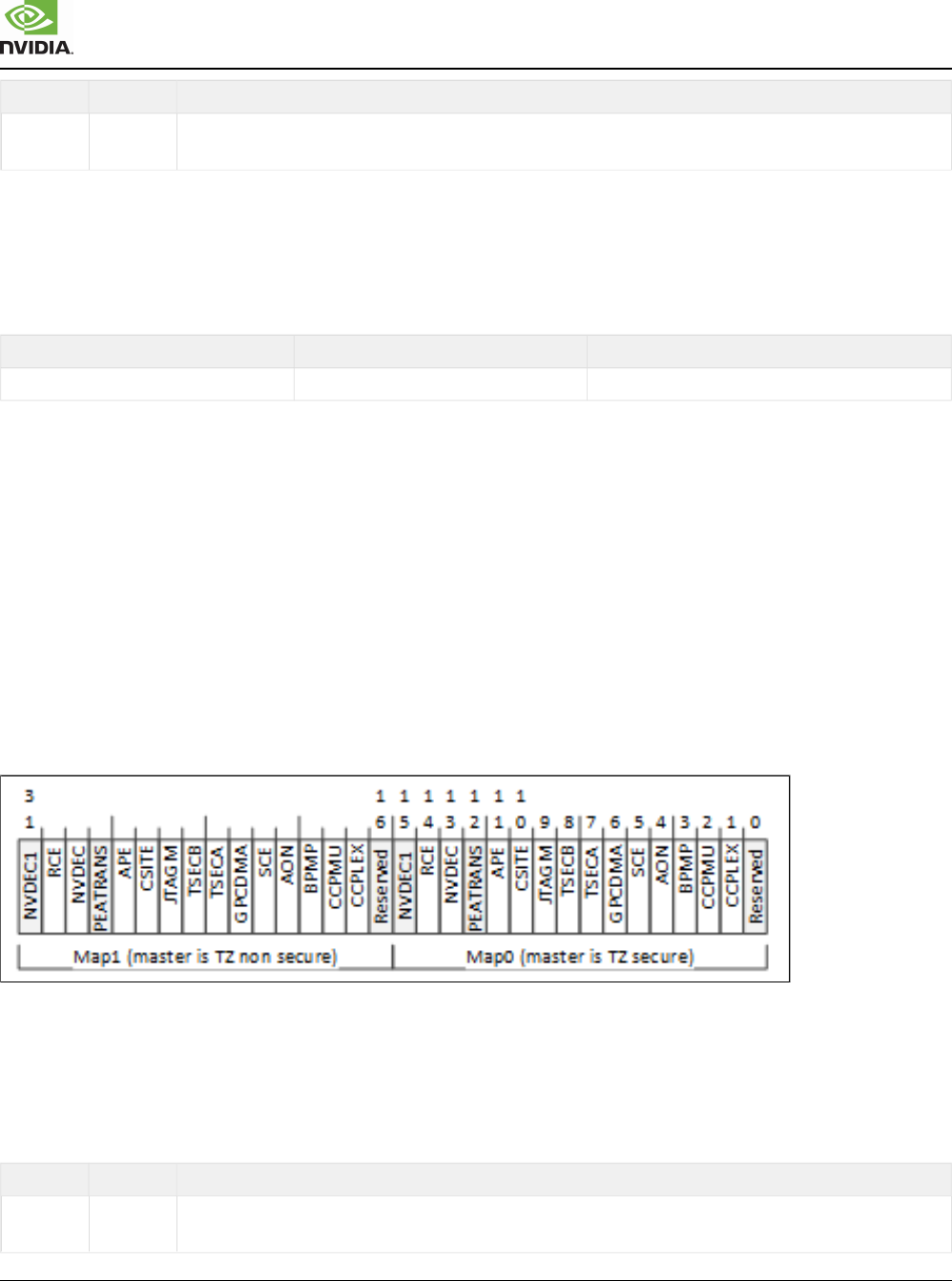
Xavier Series SoC Technical Reference Manual
XAVIER | TRM | DP-09253-002_v1.1 | SUBJECT TO CHANGE | www.nvidia.com Page of 6356 8287
Bit Reset Description
31:0 0 EN: Interrupt enable. The interrupt is active when resource i is granted to aperture {a} and the corresponding
enable bit is 1.
HSP_ARB_SEM_SPARE_SPARE_0
Offset: 0x80 | Read/Write: R/W | SCR Protection: None | Reset: 0x00000000 (0bxxxx,xxxx,xxxx,xxxx,xxxx,xxxx,
xxxx,xxx0)
Bit Reset Description
31:0 0 SPARE
Doorbell Registers
All doorbell registers are in a single page, doorbell {db} has a register range starting at DB{db} {inst}
BASE = HSP
_BASE + (1 + nSM/2 + nSS + nAS) * 64 KiB + {db} * 0x100.
In the Enable, Raw, and Pending registers, each field is defined as a bitmap, where each bit is associated with
a master ID. Only the bits associated with valid Master ID are guaranteed to be present. Two of these are
packed per register to provide fast access; each map is denoted as MAP{sl}. The variable {sl} takes values 0
(TrustZone secure) and 1 (TrustZone non-secure).
The following figure illustrates the bitmap.
Figure 8.27 Format for Doorbell Registers Using Bitmaps
HSP_DBELL_{db}_TRIGGER_0
In this write-only register, set a pending flag based on the source ID and the security level of the transaction.
There are seven doorbell trigger registers, where {db} is a value from 0 to 7.
Offset: 0x0 + (db * 0x100) | Read/Write: WO | SCR Protection: None | Reset: NA
Bit Reset Description
31:0 NA DUMMY: Any write to this register sets bit Raw{db}_{sl}[{src}], where {src} and {sl} are the master ID and
TrustZone attribute of the APB write transaction, respectively.

Xavier Series SoC Technical Reference Manual
XAVIER | TRM | DP-09253-002_v1.1 | SUBJECT TO CHANGE | www.nvidia.com Page of 6357 8287
HSP_DBELL_{db}_ENABLE_0
This register indicates which pending flags can raise the doorbell signal. There are seven doorbell enable
registers, where {db} is a value from 0 to 7.
Offset: 0x4 + (db * 0x100) | Read/Write: R/W | SCR Protection: DB_{db}_REG_0 | Reset: 0x00000000 (0b0000,
0000,0000,0000,0000,0000,0000,0000)
Bit Reset Description
31:16 0 MAP1: Which bits in Raw{db} {db}_{sl}.
{sl} can raise signal doorbell
This field is valid when {sl} = 1, indicating the master is TrustZone non-secure).
15:0 0 MAP0: Which bits in Raw{db} {db}_{sl}.
{sl} can raise signal doorbell
This field is valid when {sl} = 0, indicating the master is TrustZone secure).
HSP_DBELL_{db}_RAW_0
Which flags have been set as a result of a write to the {db}_TRIGGER register.
Offset: 0x8 + (db * 0x100) | Read/Write: RWC | SCR Protection: DB_{db}_REG_0 | Reset: 0x00000000 (0b0000,
0000,0000,0000,0000,0000,0000,0000)
Bit Reset Description
31:16 0 MAP1: Which flags are currently set; writing 1 to a bit clears it.
This field is valid when {sl} = 1, indicating the master is TrustZone non-secure).
15:0 0 MAP0: Which flags are currently set; writing 1 to a bit clears it.
This field is valid when {sl} = 0, indicating the master is TrustZone secure).
HSP_DBELL_{db}_PENDING_0
This register indicates which flags are set and enabled, equivalently the input to the OR reduce function that
controls the signal doorbell_{db}. The read value for {i} is not guaranteed after execution of an operation on {i}.
Offset: 0xc + (db * 0x100) | Read/Write: RWC | SCR Protection: DB_{db}_REG_0 | Reset: 0x00000000 (0b0000,
0000,0000,0000,0000,0000,0000,0000)
Bit Reset Description
31:16 0 MAP1: Which enabled flags are currently set. Writing 1 to a bit clears the equivalent bit in the HSP_DBELL_
{db}_RAW_0 register, and thus implicitly clears the same bit in this register.
This field is valid when {sl} = 1, indicating the master is TrustZone non-secure).
15:0 0 MAP0: Which enabled flags are currently set. Writing 1 to a bit clears the equivalent bit in the HSP_DBELL_
{db}_RAW_0 register, and thus implicitly clears the same bit in this register.
This field is valid when {sl} = 0, indicating the master is TrustZone secure).

Xavier Series SoC Technical Reference Manual
XAVIER | TRM | DP-09253-002_v1.1 | SUBJECT TO CHANGE | www.nvidia.com Page of 6358 8287
Invalid Registers
HSP, like other blocks, will normally create an APB slave error when invalid registers are accessed. However,
certain addresses do not do this, as follows:
Read and write accesses to the following invalid register addresses do not result in APB slave error response.
0x03c5_0018, 0x03c5_001c, 0x03c5_0020, 0x03c5_0024, 0x03c5_0028, 0x03c5_002c, 0x03c7_0058, 0x03c7_005c
Read accesses to register address 0x03c8_0080 do not result in APB slave error response.
Writing and reading to the invalid register addresses above has no side effect on HSP functionality, so is
harmless, but this failure to report an error could mask programming errors and so HSP users should be aware
of this.
Avoid Use of 0xDEAD1001 in Certain Registers
The HSP returns read data of 0x00000000 if the expected register read data is 0xDEAD1001.
Therefore a software workaround is required to avoid hitting this issue by ensuring the value 0xDEAD1001 is
not returned on register read. This bug affects shared mailboxes, shared semaphores, and arbitrated
semaphores programming.
Shared Mailboxes
Software should not write the value 0xDEAD1001 to HSP_SHRD_MBOX_MBOX_<N>_SHRD_MBOX_0
registers
Shared Semaphores
The affected bit positions are bit 31, 30, 28, 27, 26, 25, 23, 21, 19, 18, 16, 12, and 0. For every
HSP_SHRD_SEM_<N>_SHRD_SMP_STA_SET_0 register, software shall select a bit position, say bit ‘X,’ out
of the affected bit positions and never write ‘1’ to that bit of the register.
Arbitrated Semaphores
The affected bits are bit 31, 30, 28, 27, 26, 25, 23, 21, 19, 18, 16, 12, and 0. For every Software
HSP_ARB_SEM<0/1>_<N>_SMP_GET_0 pair, software shall select a bit position, say a bit ‘X,’ out of the
affected bits and never write ‘1’ to bit ‘X’ of the register.
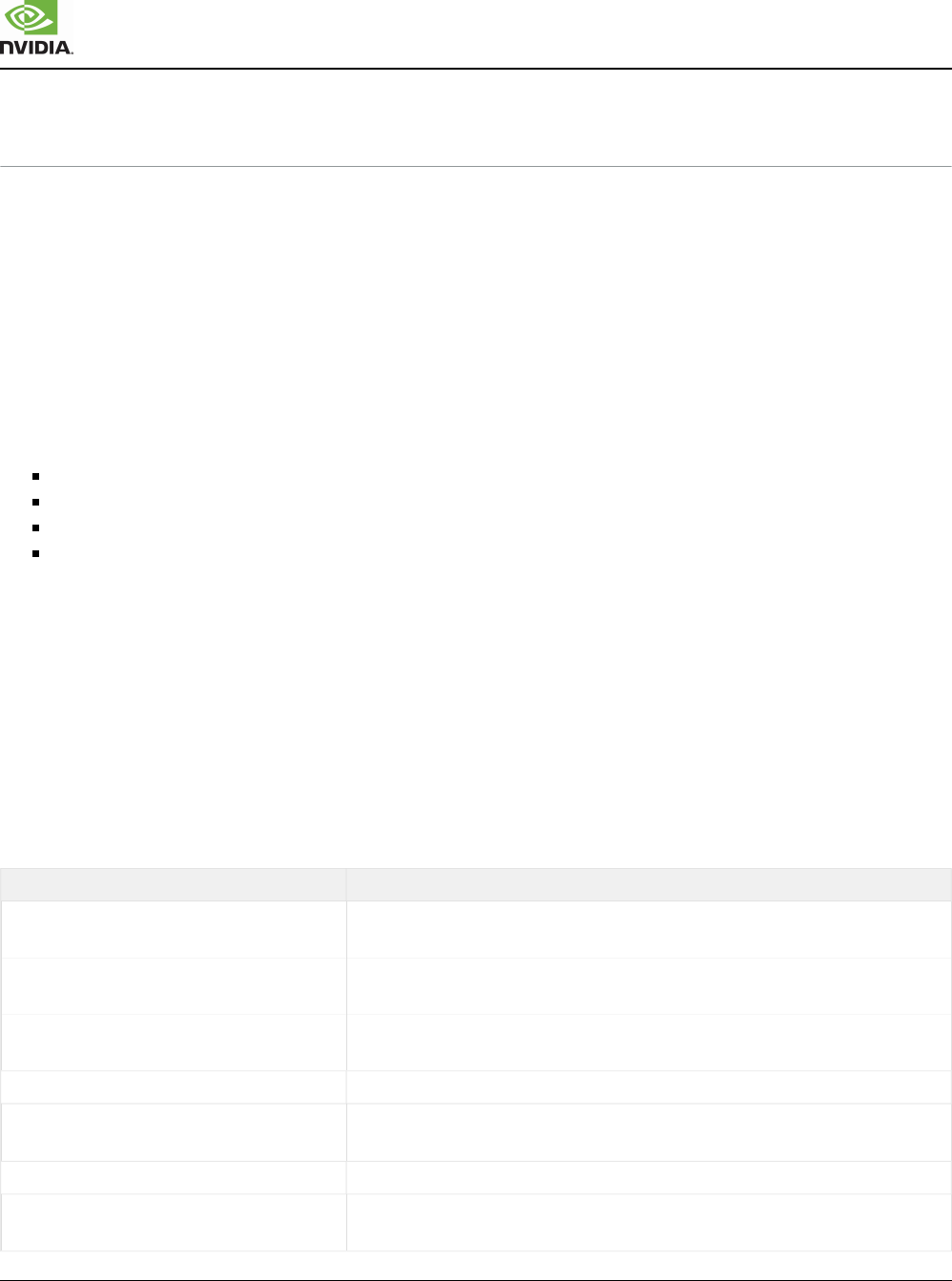
Xavier Series SoC Technical Reference Manual
XAVIER | TRM | DP-09253-002_v1.1 | SUBJECT TO CHANGE | www.nvidia.com Page of 6359 8287
8.6 Design for Debugging (DFD)
8.6.1 Overview
The NVIDIA® Xavier series System-on-Chip (SoC) has multiple Design For Debug (DFD) features for
debugging the SoC. The DFD features allow low-level system debug as well as debug of all the processor
cores: the eight ARMv8 Carmel CCPLEX cores; the embedded Cortex-R5 cores; and the Cortex-A9 APE. DFD
enables the use and development of low-level debugging tools that allow developers of a Xavier-based
implementation to place it into known states and monitor its behavior while running. The benefits of this
enhanced DFD implementation include:
A unified CoreSight TAP for all the CPUs in Xavier
Enhanced security and safety
Availability for debug over standard interfaces
Debug and Trace capabilities over functional interfaces
The DFD capability is based on ARM CoreSight 2.0 Architecture.
This chapter describes the Xavier debug blocks and debugging strategies.
Related Documentation
Information in the following documentation is useful to understand how to develop a debugging implementation
using DFD. Some of these manuals are available from the public section of the ARM Infocenter website; others
you may have to order from ARM. The versions shown are the most recent at the time of writing, however if a
newer version is available, that should be used.
Document Description
CoreSight SoC Revision: r3p2 Technical
Reference Manual (TRM)
Describes the ARM CoreSight™ SoC-400 components
®
CoreSight Trace Memory Controller Revision:
r0p1 TRM
Describes the ARM Trace Memory Controller
CoreSight System Trace Macrocell Revision:
r0p1 TRM
Describes the ARM System Trace Macrocell
A9-PTM (r1p0) TRM Describes the CoreSight PTM-A9 Program Trace Macrocell (PTM)
R5-ETM (r0p0) TRM
Describes the CoreSight Embedded Trace Macrocell (ETM) for the Cortex -R5 and
®
Cortex-R5F processors, the CoreSight ETM-R5 macrocell
ARM v8 Architecture Describes the ARM architecture v8, ARMv8
Cortex-R5 and CoreSight SoC-400 (r3p1)
Integration Manual
Describes the ARM CoreSight SoC-400 TRM
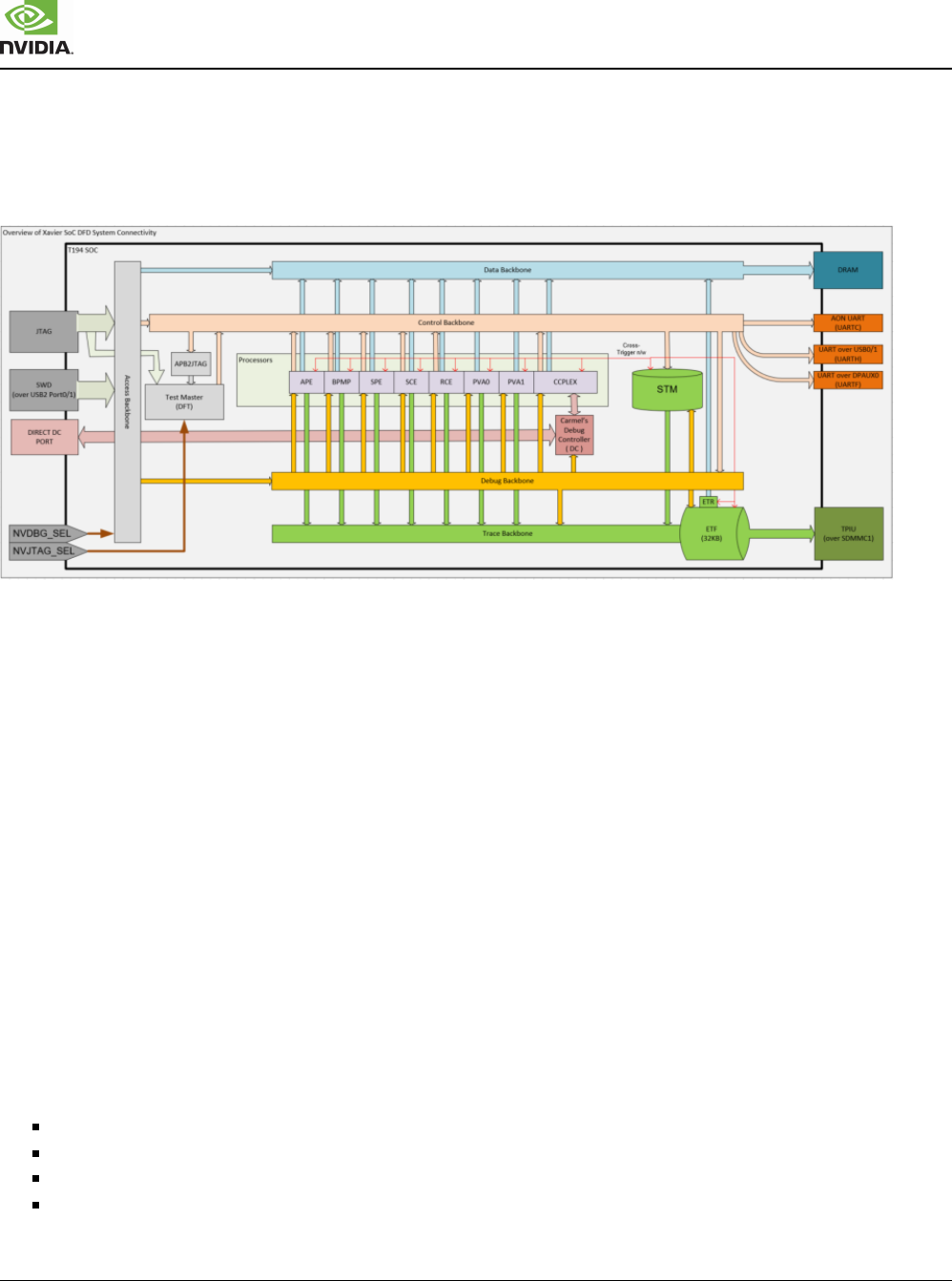
Xavier Series SoC Technical Reference Manual
XAVIER | TRM | DP-09253-002_v1.1 | SUBJECT TO CHANGE | www.nvidia.com Page of 6360 8287
System Connectivity Overview
The following figure provides overview of the system connectivity of DFD in Xavier.
Figure 8.28 System Connectivity
The Access Backbone primarily consists of the CoreSight DAP housing two debug ports (JTAG-DP and SW-
DP) and two access ports (AXI-AP and APB-AP). AXI-AP can be a bus master on the Control Backbone (CBB)
and on the Data Backbone (DBB), while the APB-AP can be a master on the Debug Backbone. The Debug
Backbone primarily consists of APB Interconnects (APBICs) and provides debug access to various CoreSight
components and the external debug registers of the ARM processors. CBB is also a master on the Debug
Backbone and allows on-chip Software to perform self-hosted debug.
The Trace Backbone primarily consists of ATB bridges and funnels. The funnels can be configured via the
debug backbone. The trace backbone allows traces to be routed to memory (DRAM) via ETR and/or external
trace port analyzer (TPA) like DSTREAM over Trace Port Interface Unit (TPIU).
The Cross-Trigger network helps convey debug state, events, and information between different components.
CBB provides access to the most of the MMIO space, while DBB provides access to memory (DRAM).
Accesses from AXI-AP are routed to CBB vs DBB based on the physical target address of the AXI transaction.
MMIO/memory space that is not accessible via CBB/DBB, but only accessible to a certain processors, can be
accessed indirectly via the following path: Debug Backbone -> Processor -> MMIO/memory.
Features
ARM CoreSight SoC-400 debug and trace support with STM and TMC
External Debug interfaces supported – JTAG, SWD
External Trace interfaces supported – TPIU
Closed Box Debug and Trace support – SWD and UART (over USB2 pins), TPIU (over SDMMC pins), UART (over
DPAUX pins)
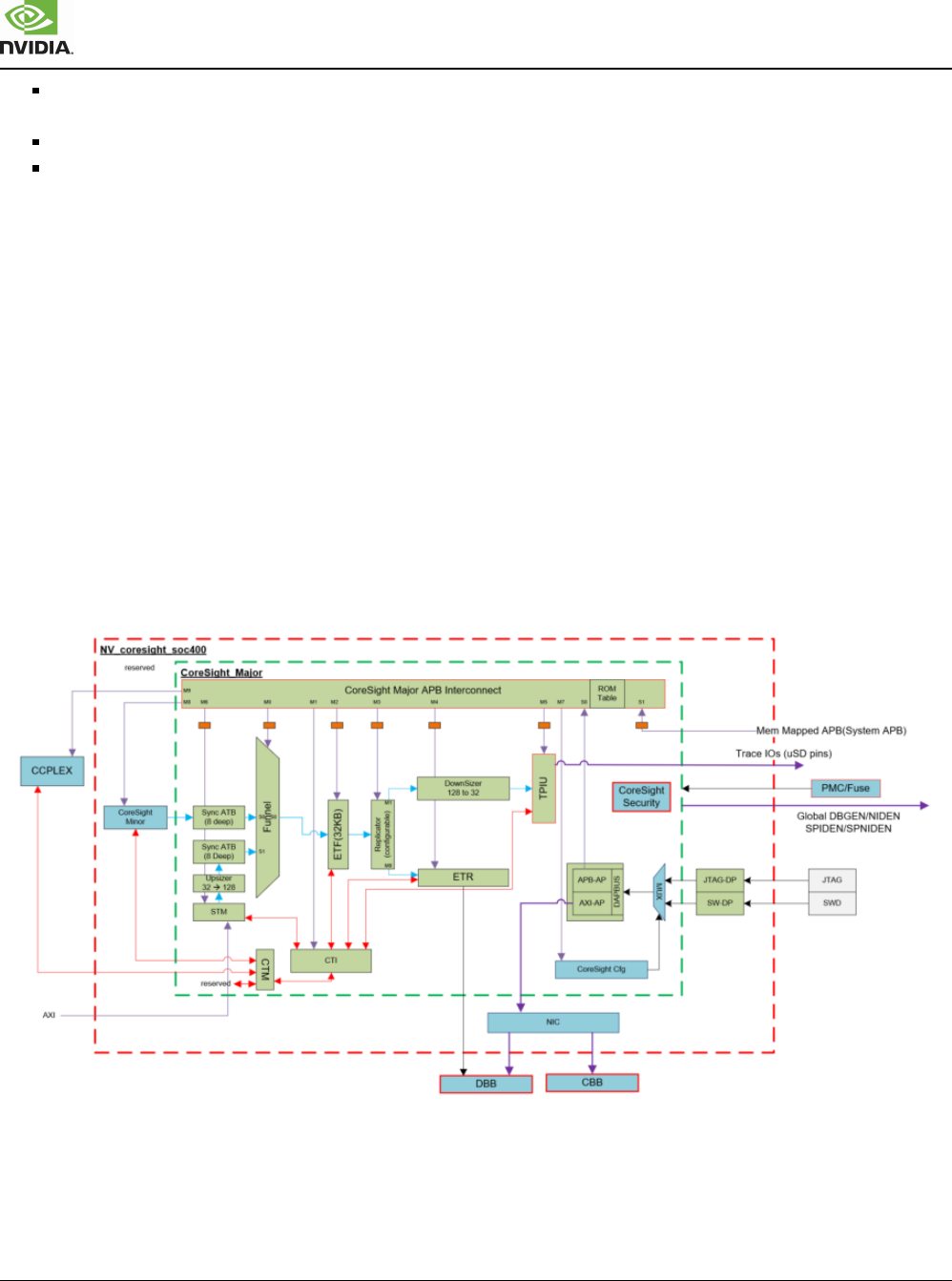
Xavier Series SoC Technical Reference Manual
XAVIER | TRM | DP-09253-002_v1.1 | SUBJECT TO CHANGE | www.nvidia.com Page of 6361 8287
Watchdog scheme to support recovery of on-chip contents (context/cache/RAMs) and memory (DRAM) in case of a
hang.
SC7 Debug mode
AO UART for unified cluster logging
Note: The eight Carmel-based ARMv8 CPU cores in CCPLEX do not support ARM architectural tracing
capabilities.
CoreSight SoC-400 Subsystem
The following is an overview of the CoreSight based implementation for Xavier.
CoreSight Major and CoreSight Minor Topology
CoreSight is primarily divided into CoreSight Major and CoreSight Minor blocks. CoreSight Major contains most
of the top-level components like the top APBIC and ROM table, and it aggregates the trace and routes it to
various trace sinks (e.g., ETF, TPIU, memory). CoreSight Minor serves the purpose of aggregating interfaces
between various auxiliary clusters and CoreSight Major. The following figures give an overview of the CoreSight
Major and CoreSight Minor blocks.
Figure 8.29 CoreSight Major

Xavier Series SoC Technical Reference Manual
XAVIER | TRM | DP-09253-002_v1.1 | SUBJECT TO CHANGE | www.nvidia.com Page of 6362 8287
Figure 8.30 CoreSight Minor
System Trace Macrocel
The System Trace Macrocel (STM) has been implemented for software instrumentation purposes.
Embedded Trace FIFO
The Embedded Trace FIFO (ETF) acts as a 32 KB buffer and it can be used to store trace up to 32 KB, or it can
also be used to absorb intermittent trace bandwidth spikes while streaming trace to trace-sinks.
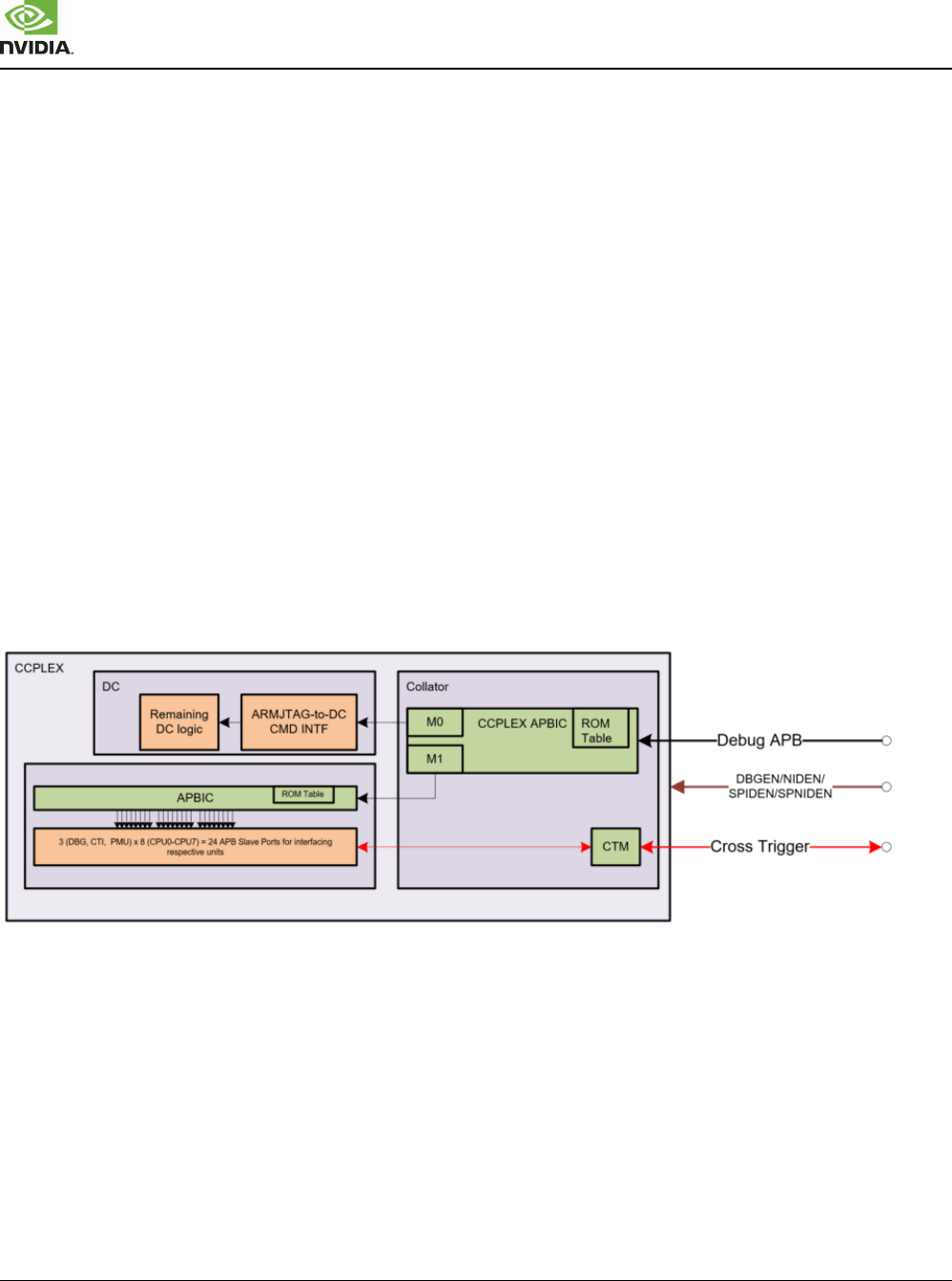
Xavier Series SoC Technical Reference Manual
XAVIER | TRM | DP-09253-002_v1.1 | SUBJECT TO CHANGE | www.nvidia.com Page of 6363 8287
Replicator
The Replicator allows routing ATB traffic between Embedded Trace Router (ETR) and Trace Port Interface Unit
(TPIU).
Embedded Trace Router
The ETR converts the ATB trace format into AXI and routes it over DBB to memory.
Trace Port Interface Unit
The TPIU allows streaming trace over I/Os. In Xavier, TPIU is pinmuxed over SDMMC1 pins in a MIPI NIDnT
compatible specification. The I/O interface supports a signal frequency of up to 204 MHz and consists of four
data pins, one clock, and one control pin for backward compatibility.
CoreSight CCPLEX Topology
The Xavier CCPLEX consists of eight Carmel CPUs that support ARMv8 ISA along with their respective PMUs
and CTIs. CCPLEX also has an NVIDIA designed Debug Controller (DC) that allows for native Carmel Debug.
The high-level topology is shown below.
Figure 8.31 CCPLEX Topology
CoreSight Topology for Auxiliary Clusters
The Cortex-R5 based BPMP, SCE, and RCE have a Dual Core Lock Step (DCLS) implementation. The SPE
consists of a single Cortex-R5 based subsystem, while APE consists of a single Cortex-A9 based subsystem.
The PVA cluster implements two single-Cortex-R5 based subclusters, each of which also contain two Video
Processing Units (VPUs). The topologies for these clusters are described in the figures below.
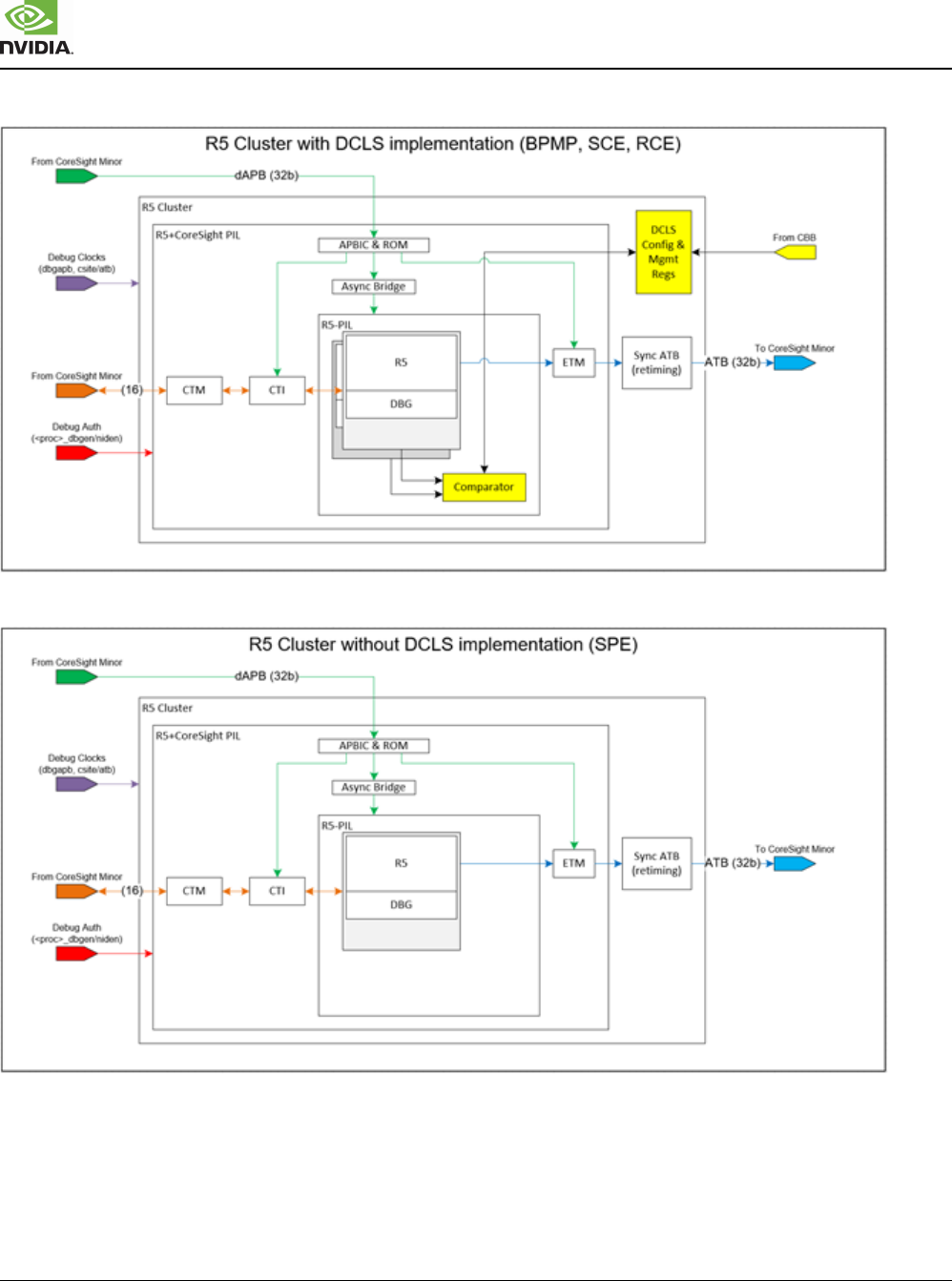
Xavier Series SoC Technical Reference Manual
XAVIER | TRM | DP-09253-002_v1.1 | SUBJECT TO CHANGE | www.nvidia.com Page of 6364 8287
Figure 8.32 Cortex-R5 Cluster with DCLS Implementation
Figure 8.33 Cortex-R5 Cluster without DCLS Implementation
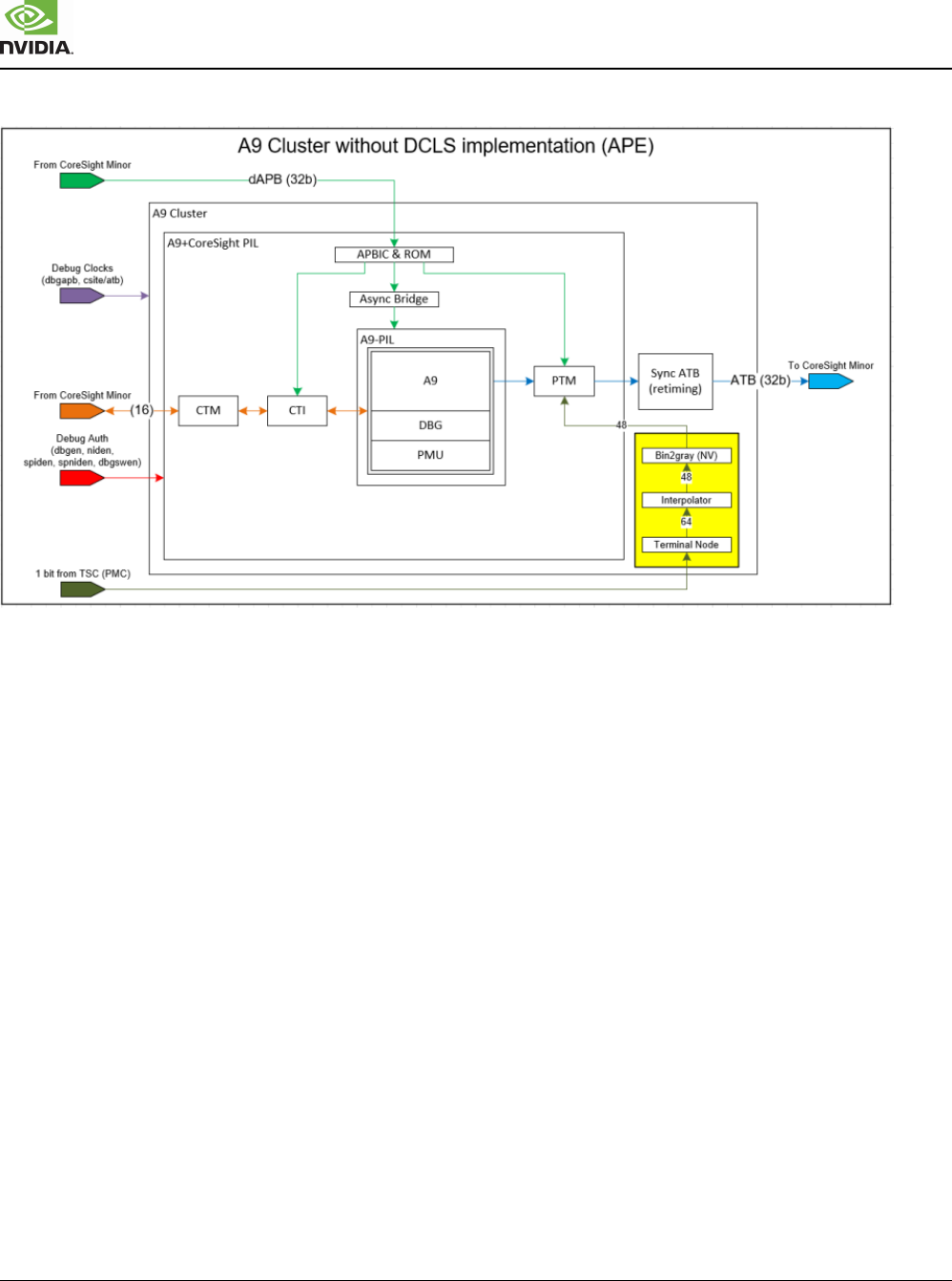
Xavier Series SoC Technical Reference Manual
XAVIER | TRM | DP-09253-002_v1.1 | SUBJECT TO CHANGE | www.nvidia.com Page of 6365 8287
Figure 8.34 Cortex-A9 Cluster without DCLS Implementation
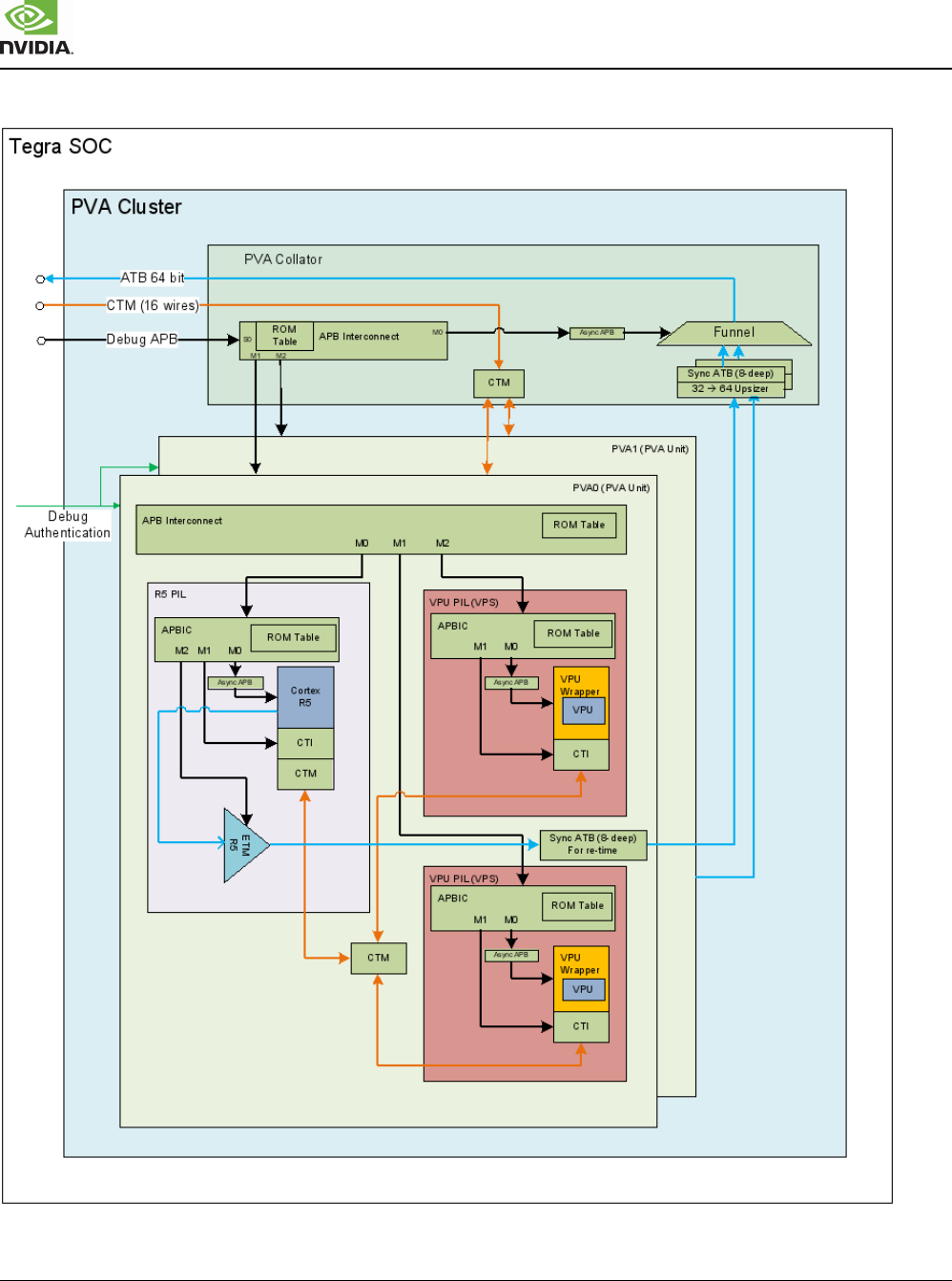
Xavier Series SoC Technical Reference Manual
XAVIER | TRM | DP-09253-002_v1.1 | SUBJECT TO CHANGE | www.nvidia.com Page of 6366 8287
Figure 8.35 PVA Cluster

Xavier Series SoC Technical Reference Manual
XAVIER | TRM | DP-09253-002_v1.1 | SUBJECT TO CHANGE | www.nvidia.com Page of 6367 8287
CoreSight Configuration Block
CoreSight Configuration Block (CoreSight Cfg) is a NVIDIA specific aperture housing custom registers useful for
debug purposes and is accessible by debugger over APBIC. Registers in this aperture are described along with
the debug features in subsequent sections.
CoreSight IDCODEs and CHIPIDs
JTAG-DP registers are not accessible over SWD, and SW-DP registers are not accessible over the JTAG
interface. There are two instances of SWJ-DP component, one configured as SW-DP with JTAG-AP being
accessible over the SWD interface, while the other is configured as JTAG-DP and accessible over the JTAG
interface.
Refer to the CoreSight SoC-400 TRM (r3p2) for IDCODE values of these CoreSight components.
Component Register Value
JTAG-AP IDR 0x 47600103
AXI-AP IDR 0x44770004
APB-AP IDR 0x 47700025
SW-DP DPIDR 0x6BA02477
Xavier also has a MMIO R/W register, CORESIGHT_CFG_CHIPID_0, which is used to check the connection to
a particular CPU or Access Port. An MMIO write can be issued from the CPU or Access Port to this register and
then the value can be read back. If the read value matches the written value, the connection is considered
successful. The Xavier shell performs this sequence, and when the read value matches the written value, it
prints out the matched value. Else it errors out. To avoid false matches, a different value is chosen for writing
/reading for different CPUs and Access Ports.
The following table lists of CBB Masters that can perform read/write operation over debug APB either directly
(APB-AP) or via System Access, i.e., Connected Port -> CBB -> Debug Backbone -> CoreSight.
CPU / Access
Port
CHIPID_VAL Comments
APB-AP 0xcdcdcdcd
AXI-AP 0xcacacaca
APE 0xaaaaaaaa
BPMP 0xbbbbbbbb
SPE 0x5e5e5e5e
SCE 0x5c5c5c5c
RCE 0x04ce04ce
PVA
-
PVA is not a master on CBB and hence PVA-R5 and VPUs cannot write
/read CORESIGHT_CFG_CHIPID_0. Instead, PVA-R5 can write to
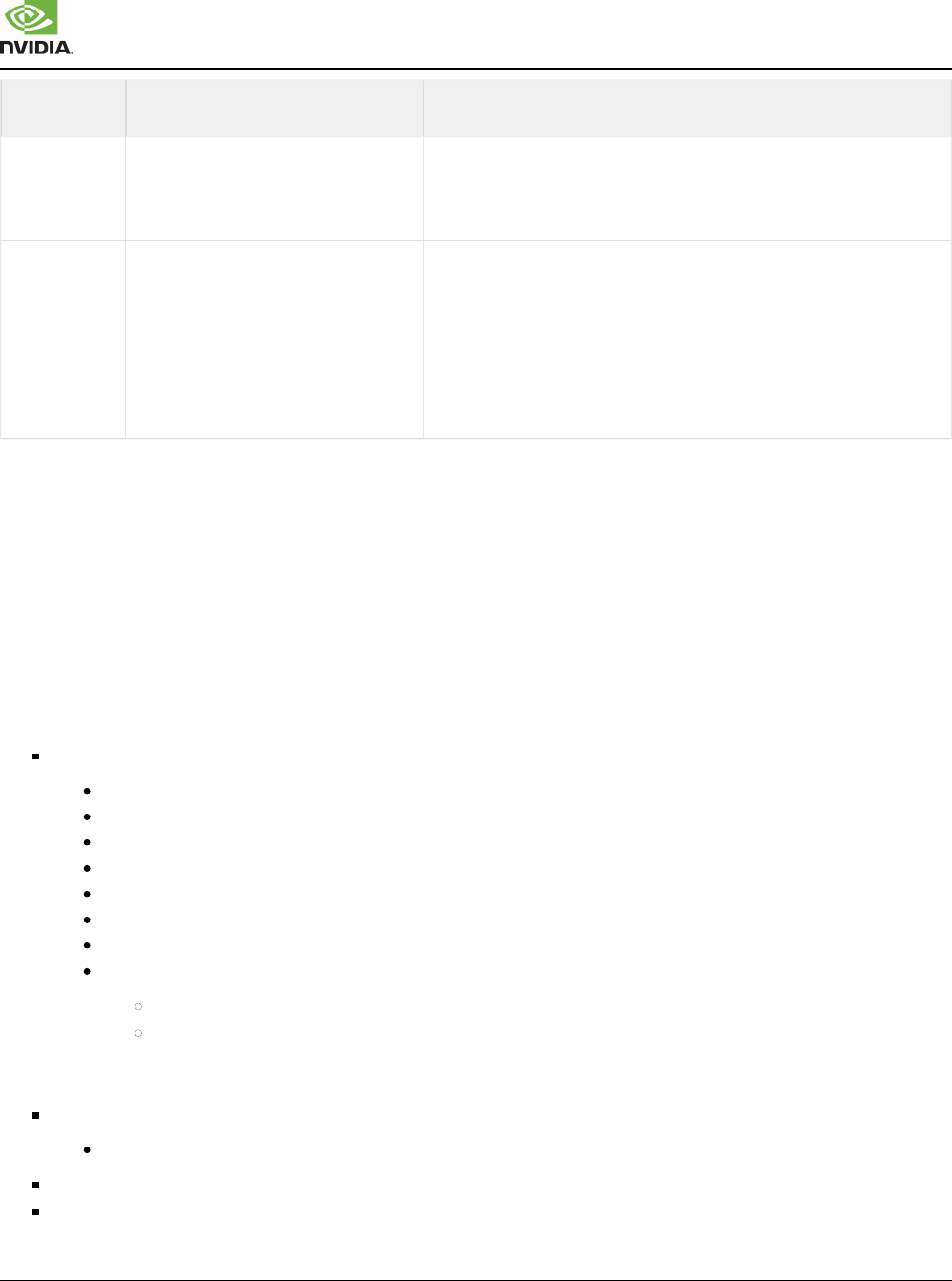
Xavier Series SoC Technical Reference Manual
XAVIER | TRM | DP-09253-002_v1.1 | SUBJECT TO CHANGE | www.nvidia.com Page of 6368 8287
CPU / Access
Port
CHIPID_VAL Comments
PVA_CFG_CCQ_STATUS3 a sample value (e.g., 0x095a095a) and read
it back. The VPU cannot perform MMIO accesses. Hence, the test could
have VPU write sample value (e.g., 0x05930593) to a location in VMEM
and read it back.
Carmel Cores bcbc0000 – carmel cluster 0 cpu 0
bcbc0001 – carmel cluster 0 cpu 1
bcbc0010 – carmel cluster 1 cpu 0
bcbc0011 – carmel cluster 1 cpu 1
bcbc0020 – carmel cluster 2 cpu 0
bcbc0021 – carmel cluster 2 cpu 1
bcbc0030 – carmel cluster 3 cpu 0
bcbc0031 – carmel cluster 3 cpu 1
CoreSight Address Space
CoreSight ROM Tables
Each APBIC implements a ROM table which tabulates the configurable components hanging off the APBIC.
The ROM tables are housed at offset 0 of the defined aperture and are automatically read by the debuggers to
determine the Debug Architecture of the SoC during the auto-enumeration process. Listed below is the
structure of different ROM tables in Xavier and IPs enumerated by them.
CoreSight Major ROM Table points to:
CoreSight Major Components
Funnel
CTI
ETF
Replicator
ETR
TPIU
STM
CoreSight Config aperture (for NV custom logic)
CoreSight Minor ROM Table (1 level nested ROM)
st
CCPLEX Collator ROM Table (1 level nested ROM)
st
CoreSight Minor ROM Table points to:
CoreSight Minor Components
CoreSight Minor Funnel
APE/BPMP/SPE/SCE/RCE ROM Tables (2 level nested ROM)
nd
PVA Collator ROM Table (2 level nested ROM)
nd
CCPLEX Collator ROM Table points to:

Xavier Series SoC Technical Reference Manual
XAVIER | TRM | DP-09253-002_v1.1 | SUBJECT TO CHANGE | www.nvidia.com Page of 6369 8287
CCPLEX Debug Controller (DC)
Carmel Cluster ROM Table (2 level nested ROM)
nd
PVA Collator ROM Table points to:
PVA Collator Funnel
PVA0 ROM Table (3 level nested ROM)
rd
PVA1 ROM Table (3 level nested ROM)
rd
PVA{0,1} ROM Table points to:
PVA#_R5 ROM Table (4 level nested ROM)
th
PVA#_VPU0 ROM Table (4 level nested ROM)
th
PVA#_VPU1 ROM Table (4 level nested ROM)
th
APE ROM Table points to:
One DBG
One CTI
One PMU
One PTM
BPMP/SPE/SCE/RCE/PVA{0,1}_R5 ROM Tables point to:
One DBG
One CTI
One ETM
PVA{0,1}_VPU{0,1} ROM Tables point to:
One DBG
One CTI
Carmel Cluster ROM Table points to:
Eight DBG
Eight CTI
Eight PMU
DAPBUS Configuration
APB-AP is connected to Access Port 0 of DFD's CoreSight DAPBUS
AXI-AP is connected to Access Port 1 of DFD's CoreSight DAPBUS
CoreSight Address Map
The table below provides CoreSight address components (in hexadecimal) when accessed via system AMAP.
Debuggers should use [30:0] of the base addresses and set bit 31 when making accesses to the components
below.

Xavier Series SoC Technical Reference Manual
XAVIER | TRM | DP-09253-002_v1.1 | SUBJECT TO CHANGE | www.nvidia.com Page of 6370 8287
Table 8.58 CoreSight Address Components
Component Absolute Start Address Absolute End Address
CoreSight Major
CoreSight Major Interconnect ROM 24000000 2400FFFF
Funnel 24010000 2401FFFF
CTI 24020000 2402FFFF
ETF 24030000 2403FFFF
Replicator 24040000 2404FFFF
ETR 24050000 2405FFFF
TPIU 24060000 2406FFFF
STM 24070000 2407FFFF
CoreSight Cfg 24080000 240BFFFF
Reserved for additional CoreSight IPs 240C0000 247FFFFF
CoreSight Minor Interconnect 24800000 24FFFFFF
CCPLEX Collator Interconnect 26000000 27FFFFFF
CoreSight Minor Interconnect
CoreSight Minor Interconnect ROM 24800000 2480FFFF
Reserved 24810000 2481FFFF
Funnel 24820000 2482FFFF
Reserved 24830000 248FFFFF
APE 24900000 249FFFFF
BPMP 24A00000 24AFFFFF
SPE 24B00000 24BFFFFF
SCE 24C00000 24CFFFFF
RCE 24D00000 24DFFFFF
PVA Collator Interconnect 24E00000 24FFFFFF
CCPLEX Collator Interconnect
CCPLEX Collator Interconnect ROM 26000000 2600FFFF
Reserved 26010000 2601FFFF
CCPLEX Debug Controller (DC) 26020000 2602FFFF
Reserved 26030000 267FFFFF
CCPLEX CPU Clusters 27000000 27FFFFFF
CCPLEX CPU Clusters
Cluster ROM 27000000 2700FFFF
CPU0_DBG 27010000 2701FFFF

Xavier Series SoC Technical Reference Manual
XAVIER | TRM | DP-09253-002_v1.1 | SUBJECT TO CHANGE | www.nvidia.com Page of 6371 8287
Component Absolute Start Address Absolute End Address
CPU0_CTI 27020000 2702FFFF
CPU0_PMU 27030000 2703FFFF
CPU1_DBG 27110000 2711FFFF
CPU1_CTI 27120000 2712FFFF
CPU1_PMU 27130000 2713FFFF
CPU2_DBG 27410000 2741FFFF
CPU2_CTI 27420000 2742FFFF
CPU2_PMU 27430000 2743FFFF
CPU3_DBG 27510000 2751FFFF
CPU3_CTI 27520000 2752FFFF
CPU3_PMU 27530000 2753FFFF
CPU4_DBG 27810000 2781FFFF
CPU4_CTI 27820000 2782FFFF
CPU4_PMU 27830000 2783FFFF
CPU5_DBG 27910000 2791FFFF
CPU5_CTI 27920000 2792FFFF
CPU5_PMU 27930000 2793FFFF
CPU6_DBG 27C10000 27C1FFFF
CPU6_CTI 27C20000 27C2FFFF
CPU6_PMU 27C30000 27C3FFFF
CPU7_DBG 27D10000 27D1FFFF
CPU7_CTI 27D20000 27D2FFFF
CPU7_PMU 27D30000 27D3FFFF
APE
Cluster ROM 24900000 2490FFFF
CPU0_DBG 24910000 24910FFF
CPU0_PMU 24911000 24911FFF
CPU0_CTI 24918000 24918FFF
CPU0_ETM 2491C000 2491CFFF
BPMP
Cluster ROM 24A00000 24A00FFF
CPU0_DBG 24A10000 24A10FFF
CPU0_CTI 24A18000 24A18FFF
CPU0_ETM 24A1C000 24A1CFFF
SPE

Xavier Series SoC Technical Reference Manual
XAVIER | TRM | DP-09253-002_v1.1 | SUBJECT TO CHANGE | www.nvidia.com Page of 6372 8287
Component Absolute Start Address Absolute End Address
Cluster ROM 24B00000 24B00FFF
CPU0_DBG 24B10000 24B10FFF
CPU0_CTI 24B18000 24B18FFF
CPU0_ETM 24B1C000 24B1CFFF
SCE
Cluster ROM 24C00000 24C00FFF
CPU0_DBG 24C10000 24C10FFF
CPU0_CTI 24C18000 24C18FFF
CPU0_ETM 24C1C000 24C1CFFF
RCE
Cluster ROM 24D00000 24D00FFF
CPU0_DBG 24D10000 24D10FFF
CPU0_CTI 24D18000 24D18FFF
CPU0_ETM 24D1C000 24D1CFFF
PVA Collator Interconnect
PVA Collator Interconnect ROM 24E00000 24E00FFF
PVA Collator Funnel 24E10000 24E1FFFF
Reserved 24E20000 24EFFFFF
PVA0 Interconnect 24F00000 24F7FFFF
PVA1 Interconnect 24F80000 24FFFFFF
PVA0 Interconnect
PVA0 Interconnect ROM 24F00000 24F00FFF
PVA0 R5 24F20000 24F3FFFF
PVA0 VPU0 24F40000 24F5FFFF
PVA0 VPU1 24F60000 24F7FFFF
PVA1 Interconnect
PVA1 Interconnect ROM 24F80000 24F80FFF
PVA1 R5 24FA0000 24FBFFFF
PVA1 VPU0 24FC0000 24FDFFFF
PVA1 VPU1 24FE0000 24FFFFFF
PVA0 R5
Cluster ROM 24F20000 24F20FFF
CPU0_DBG 24F30000 24F30FFF
CPU0_CTI 24F38000 24F38FFF
CPU0_ETM 24F3C000 24F3CFFF

Xavier Series SoC Technical Reference Manual
XAVIER | TRM | DP-09253-002_v1.1 | SUBJECT TO CHANGE | www.nvidia.com Page of 6373 8287
Component Absolute Start Address Absolute End Address
PVA0 VPU0
Cluster Rom 24F40000 24F40FFF
CPU0_DBG 24F50000 24F50FFF
CPU0_CTI 24F58000 24F58FFF
PVA0 VPU1
Cluster ROM 24F60000 24F60FFF
CPU0_DBG 24F70000 24F70FFF
CPU0_CTI 24F78000 24F78FFF
PVA1 R5
Cluster Rom 24FA0000 24FA0FFF
CPU0_DBG 24FB0000 24FB0FFF
CPU0_CTI 24FB8000 24FB8FFF
CPU0_ETM 24FBC000 24FBCFFF
PVA1 VPU0
Cluster ROM 24FC0000 24FC0FFF
CPU0_DBG 24FD0000 24FD0FFF
CPU0_CTI 24FD8000 24FD8FFF
PVA1 VPU1
Cluster ROM 24FE0000 24FE0FFF
CPU0_DBG 24FF0000 24FF0FFF
CPU0_CTI 24FF8000 24FF8FFF
Physical Address Based Routing
AXI-AP is a master on the CBB and DBB. Transactions issued from AXI-AP are routed to CBB vs. DBB based
on the physical address of the AXI transaction.
Interfaces
Table 8.59 System Interconnect Interfaces
IP Data
width
(bits)
Addr
Width
(bits)
Protocol Clock Direction Connected to
STM 32 32 AXI3 CSITE Slave CBB
STM 32 - ATB3 CSITE Master 32:128 Upsizer
STM 32 32 dAPB CSITE Slave CoreSight Major APBIC
ETR 128 40 AXI-DBB CSITE Master DBB

Xavier Series SoC Technical Reference Manual
XAVIER | TRM | DP-09253-002_v1.1 | SUBJECT TO CHANGE | www.nvidia.com Page of 6374 8287
IP Data
width
(bits)
Addr
Width
(bits)
Protocol Clock Direction Connected to
ETR 128 - ATB3 CSITE Slave Replicator
ETR 32 32 dAPB CSITE Slave CoreSight Major APBIC
TPIU 4 - ARM Trace
Format
TPIU
(tpiu_in_clk)
Master SDMMC pinmux
TPIU 128 - ATB4 CSITE Slave Replicator (TPIU has fixed width of 32. The
signal passed through 128:32 downsizer before
connecting to TPIU)
TPIU 32 32 dAPB CSITE Slave CoreSight Major APBIC
CTI (in
CoreSight Major)
32 32 dAPB DBGAPB Slave CoreSight Major APBIC
CTI 16 events CSITE in/out ETF / ETR / STM / TPIU
AXI-AP 64 40 ACE-Lite DBGAPB Master DFD 1x2 NIC
DFD 1x2 NIC 64 40 AXI-CBB DBGAPB Master CBB
DFD 1x2 NIC 64 40 AXI-DBB DBGAPB Master DBB
CoreSight Major
APBIC
32 32 APB DBGAPB Slave CBB
CoreSight Major
APBIC
32 32 APB DBGAPB Slave APB-AP
ARMJTAG 1-TDI
1-TDO
1-TMS
1-TCK
4-pin JTAG TCK Master DAP
Note: TRSTN must be asserted (held low) for
ARMJTAG to work.
SWD 1-SWDIO
1-SWCLK
2-pin SWD SWCLK Master DAP
CCPLEX
Collator
16 CTM
event+ack
DBGAPB DFD
APE / BPMP /
PVA Collator
/ SPE / SCE /
RCE
16 (per
interface)
CTM
event+ack
DBGAPB DFD
APE / BPMP /
SPE
/ SCE / RCE
32 (per
interface)
ATB4 CSITE Master DFD
PVA Collator 64 ATB4 CSITE Master DFD
APE / BPMP /
PVA Collator
/ SPE / SCE /
RCE
32 (per
interface)
32 (per
interface)
dAPB DBGAPB Slave CoreSight Minor APBIC
32
32
dAPB
DBGAPB
Slave
CoreSight Major APBIC

Xavier Series SoC Technical Reference Manual
XAVIER | TRM | DP-09253-002_v1.1 | SUBJECT TO CHANGE | www.nvidia.com Page of 6375 8287
IP Data
width
(bits)
Addr
Width
(bits)
Protocol Clock Direction Connected to
CCPLEX
Collator
Table 8.60 External IO Interfaces
Interface Pins Protocol Pins over which muxed Description
Dedicated JTAG TMS, TCK, TDI, TDO 4-pin JTAG - ARMJTAG
UART3 RX, TX 2-pin UART - Debug AON UART (also used by BR)
UART6 RX, TX 2-pin UART DPAUX0 (I2C – IOP/ION) Closed Box Debug over DPAUX
UART8 RX, TX 2-pin UART USB2 (D+/D-) Closed Box Debug over USB2
TPIU CLK, CTL, DATA0/1/2/3 TPIU SDMMC1
(CLK, CMD, DAT0/1/2/3)
MIPI NIDnT
(Trace over SDMMC)
SWD SWCLK, SWDIO SWD USB2 (D+/D-) Closed Box Debug over USB2
NVJTAG_SEL NVJTAG_SEL - - NVJTAG over Dedicated JTAG interface
NVDBG_SEL NVDBG_SEL - - NVJTAG over USB2/SWD interface
Cross Trigger Network
The Cross Trigger Interface allows collection of events from various components and facilitates communication
using these events among the participants using Cross Trigger Matrix. The following table lists connectivity of
various CTI events in the system.
Table 8.61 CTI Mappings in CoreSight
CTI Trigger Signal Name of Connected Module Connected Module Comments
CTITRIGIN0 FULL ETF
CTITRIGIN1 ACQCOMP ETF
CTITRIGIN2 FULL ETR
CTITRIGIN3 ACQCOMP ETR
CTITRIGIN4 ASYNCOUT STM
CTITRIGIN5 TRIGOUTSPTE STM
CTITRIGIN6 TRIGOUTSW STM
CTITRIGIN7 nvl2dfd_nvltrigger NVLINK Wrapper ACK drives dfd2nvl_nvltrigger_ack
CTITRIGOUT0 TRIGIN ETF
CTITRIGOUT1 FLUSHIN ETF
CTITRIGOUT2 TRIGIN ETR
CTITRIGOUT3 FLUSHIN ETR
CTITRIGOUT4 TRIGIN TPIU
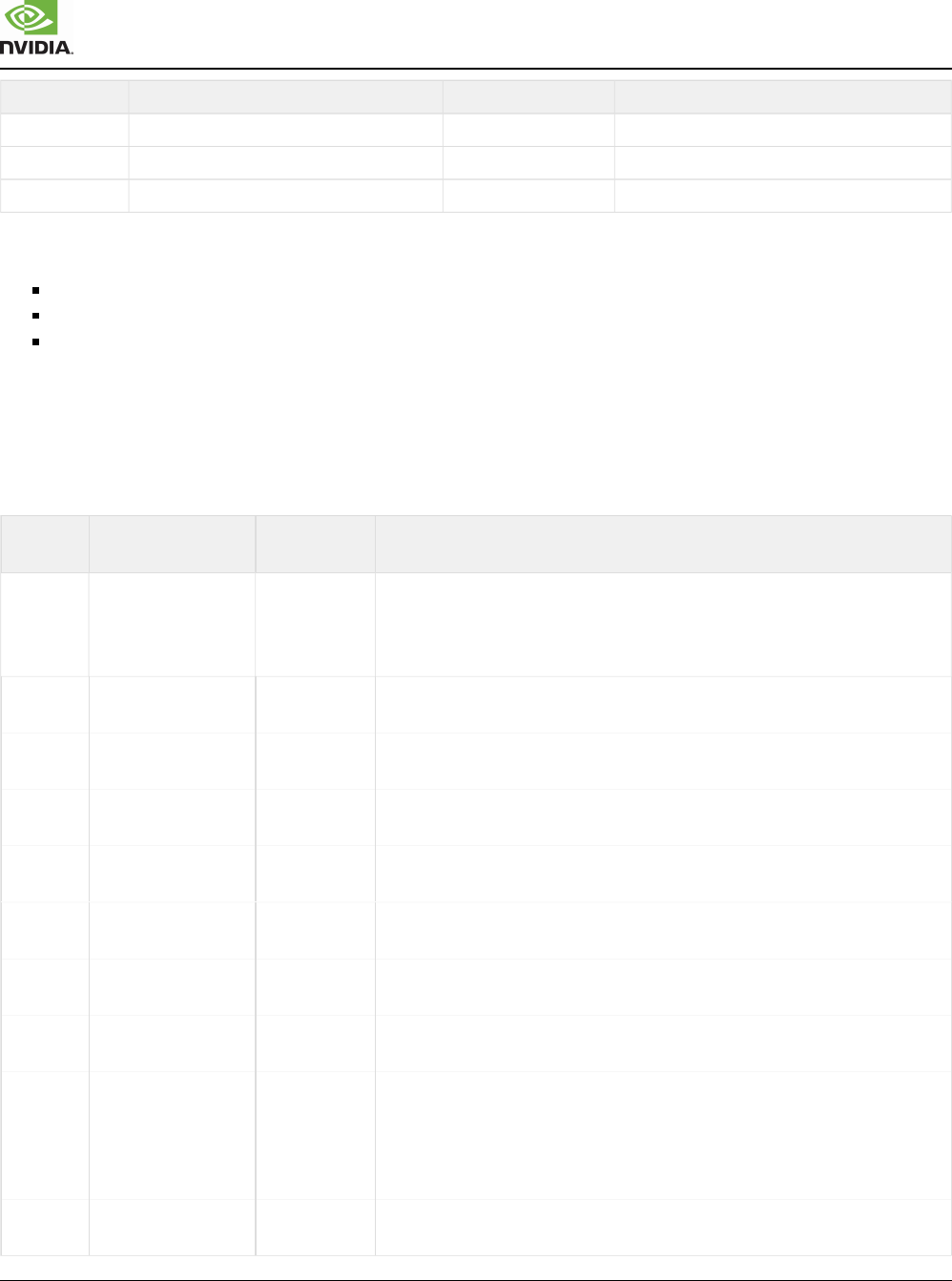
Xavier Series SoC Technical Reference Manual
XAVIER | TRM | DP-09253-002_v1.1 | SUBJECT TO CHANGE | www.nvidia.com Page of 6376 8287
CTI Trigger Signal Name of Connected Module Connected Module Comments
CTITRIGOUT5 FLUSHIN TPIU
CTITRIGOUT6 - Not connected
CTITRIGOUT7 dfd2nvl_dfdtrigger NVLINK Wrapper ACK is driven by nvl2dfd_dfdtrigger_ack
Notes:
TRIGOUTHETE is not connected to CTITRIGIN#.
CTITRIGINACK[7:0] outputs from CTI are left unconnected.
CTITRIGOUTACK[7:0] inputs to CTI are tied to '0.'
CTI Mappings in R5-CoreSight PILs
Applicable for BPMP, SPE, SCE, RCE, and PVA0/1's Cortex-R5 clusters.
The following table provides information, but for more details refer to the Cortex-R5 CoreSight PIL specification.
CTI
Trigger
Signal Name of
Connected Module
Connected
Module
Comments
CTITRIGI
N0
DBGTRIGGER R5 PIL logic ensures CTITRIGIN0 can be asserted by DBGTRIGGER only if
CTITRIGINACK0 is LOW.
CTITRIGIN0 held using PIL-logic (even if source de-asserts trigger) until
CTITRIGINACK0 is asserted by CTI.
CTITRIGI
N1
nPMUIRQ R5's PMU Trigger input to CTI held using PIL-logic (even if source de-asserts trigger) until
corresponding CTITRIGINACK is asserted by CTI
CTITRIGI
N2
ETMEXTOUT[0] ETM in R5-
CoreSight PIL
(same as above)
CTITRIGI
N3
ETMEXTOUT[1] ETM in R5-
CoreSight PIL
(same as above)
CTITRIGI
N4
COMMRX R5 (same as above)
CTITRIGI
N5
COMMTX R5 (same as above)
CTITRIGI
N6
ETMTRIGGER ETM in R5-
CoreSight PIL
CTITRIGINACK6 connected to ETM's TRIGGERACK by PIL-logic
CTITRIGI
N7
0 Tied-off CTITRIGINACK7 is left unconnected
CTITRIGO
UT0
EDBGRQ R5 CTITRIGOUT0 shall be OR-ed with EDBGRQ_<P> signal (corresponding to the
processor / cluster) from DFD.
The OR-ed output is then connected to EDBGRQ input of the processor.
CTITRIGOUTACK0 is tied to '0' and CTI relies of clearing CTITRIGOUT0 via
Software ACK
CTITRIGO
UT1
ETMEXTIN[0] ETM in R5-
CoreSight PIL
CTITRIGOUTACK1 is driven by CTITRIGOUT1

Xavier Series SoC Technical Reference Manual
XAVIER | TRM | DP-09253-002_v1.1 | SUBJECT TO CHANGE | www.nvidia.com Page of 6377 8287
CTI
Trigger
Signal Name of
Connected Module
Connected
Module
Comments
CTITRIGO
UT2
ETMEXTIN[1] ETM in R5-
CoreSight PIL
CTITRIGOUTACK2 is driven by CTITRIGOUT2
CTITRIGO
UT3
nCTIIRQ VIC in R5-
Cluster
Interrupt from R5-PIL connected to local VIC in Cortex-R5 cluster.
CTITRIGOUTACK3 is tied to '0'
CTITRIGO
UT4
- Not connected CTITRIGOUTACK4 is tied to '0'
CTITRIGO
UT5
- Not connected CTITRIGOUTACK5 is tied to '0'
CTITRIGO
UT6
- Not connected CTITRIGOUTACK6 is tied to '0'
CTITRIGO
UT7
DBGRESTART R5 CTITRIGOUTACK7 is driven from DBGRESTARTED signal from Cortex-R5
CTI Mappings in VPU
VPU natively has following signals:
input cti_stop_req – When this signal is asserted, VPU enters debug mode.
output cti_stop_req_ack – VPU asserts this signal to indicate that the positive transition on cti_stop_req has been
detected by the VPU and that it shall start entering debug mode.
output cti_stopped – VPU asserts this signal when it enters debug mode (irrespective of the reason that caused VPU
to enter debug mode). Signal is deasserted when cti_stopped_ack is asserted.
input cti_stopped_ack – When this signal is asserted, VPU deaserts cti_stopped. This signal must be asserted for
further operation of VPU in debug mode.
input cti_run_req – When this signal is asserted, VPU exits debug mode.
output cti_run_req_ack – VPU asserts this signal to indicate that the positive transition on cti_run_req has been
detected by the VPU and that it shall start exiting debug mode.
output cti_started – VPU asserts this signal to indicate that it has exited debug mode.
input cti_started_ack – This signal must be asserted for VPU to deassert cti_started, so that VPU can resume normal
operation.
input dbg_ext_break_in – When this signal is asserted, VPU enters debug mode.
The signals listed above are connected as shown below.
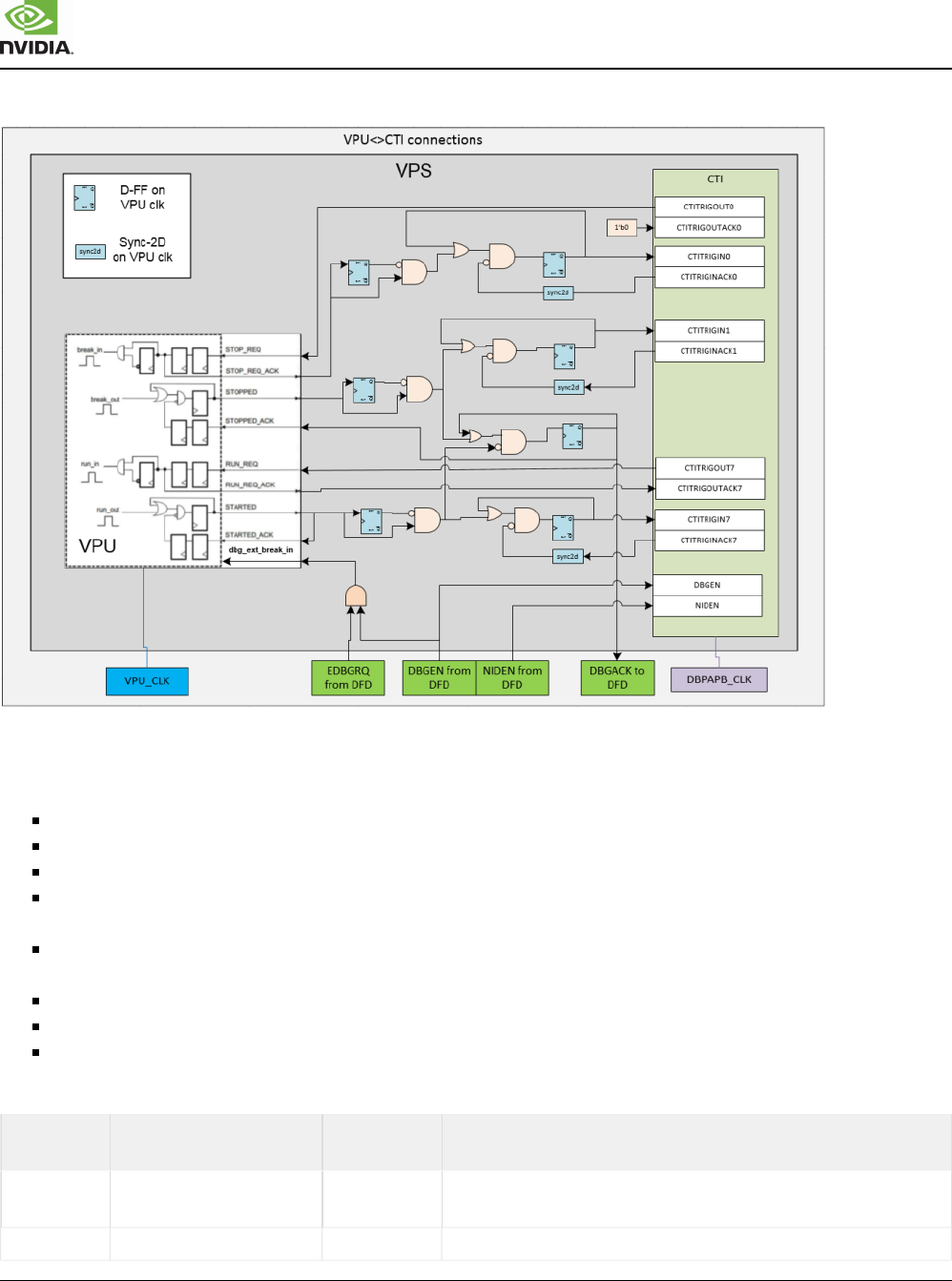
Xavier Series SoC Technical Reference Manual
XAVIER | TRM | DP-09253-002_v1.1 | SUBJECT TO CHANGE | www.nvidia.com Page of 6378 8287
Figure 8.36 VPU to CTI Connections
Summary of Behavior
VPU enters Debug state when the EDBGRQ signal corresponding to the specific VPU is asserted.
The DBGACK signal to DFD remains asserted for the entire duration that the VPU is in Debug state.
Assertion of CTITRIGOUT0 causes VPU to start entering Debug state.
CTITRIGOUT0 is be cleared via Software write to CTIINTACK[0] and not by asserting CTITRIGOUTACK0 (similar to
R5-CTI connections).
CTITRIGIN0 is asserted when VPU has started entering Debug state (based on CTITRIGOUT0 request) and remains
asserted until CTI ACKs this trigger input.
CTITRIGIN1 is asserted when VPU has entered Debug state and remains asserted until CTI ACKs this trigger input.
Assertion of CTITRIGOUT7 causes the VPU to exit Debug state and this output remains asserted until ACKed.
CTITRIGIN7 is asserted when VPU has exited Debug state and remains asserted until CTI ACKs this trigger input.
Table 8.62 CTI Mappings in APE
CTI Trigger Signal Name of
Connected Module
Connected
Module
Comments
CTITRIGIN0 DBGTRIGGER R5 APE cluster logic ensures CTITRIGIN0 remains asserted until
CTITRIGINACK0 is asserted.
CTITRIGIN1 nPMUIRQ[0] APE's PMU Corresponding CTITRIGINACK not connected

Xavier Series SoC Technical Reference Manual
XAVIER | TRM | DP-09253-002_v1.1 | SUBJECT TO CHANGE | www.nvidia.com Page of 6379 8287
CTI Trigger Signal Name of
Connected Module
Connected
Module
Comments
CTITRIGIN2 PTMEXTOUT[0] PTM in APE
cluster
(same as above)
CTITRIGIN3 PTMEXTOUT[1] PTM in APE
cluster
(same as above)
CTITRIGIN4 COMMTX A9 in APE
cluster
(same as above)
CTITRIGIN5 COMMRX A9 in APE
cluster
(same as above)
CTITRIGIN6 PTMTRIGGER PTM in APE
cluster
(same as above)
CTITRIGIN7 0 Tied-off (same as above)
CTITRIGOUT
0
EDBGRQ R5 (EDBGRQ input to A9) =
(CTITRIGOUT0)
(EDBGRQ_APE from DFD)
(PTMDBGREQ from APE PTM's)
CTITRIGOUTACK0 is tied to '0'
and CTI relies of clearing CTITRIGOUT0 via Software ACK
CTITRIGOUT
[4:1]
PTMEXTIN[3:0] PTM in APE
cluster
Corresponding CTITRIGOUTACK is tied to '0'
CTITRIGOUT
5
CTIEXTTRIG0 Not connected CTITRIGOUTACK5 ( is tied to '0'
also known as CTIEXTTRIGACK0)
CTITRIGOUT
6
CTIIRQ GIC in APE
cluster
Corresponding CTITRIGOUTACK is tied to '0'
CTITRIGOUT
7
DBGRESTART Cortex-R5 CTITRIGOUTACK7 =
((DBGACK from A9) and
~(DBGRESTARTED from A9))
((~DBGACK from A9) and
(DBGRESTART))
CTI Mappings in CCPLEX
The following table provides information, but for more details refer to the Carmel (or Cortex-A57) TRM.
CTI
Trigger
Signal Name of
Connected
Module
Connecte
d Module
Comments
CTITRIGI
N0
DBGTRIGGER ARMv8
Processor
Integration logic ensures CTITRIGIN0 remains asserted until CTITRIGINACK1 is
asserted.
(DBGTRIGGER is basically DBGACK)
CTITRIGI
N1
PMUIRQ ARMv8
core's
PMU
Integration logic ensures CTITRIGIN1 remains asserted until CTITRIGINACK1 is
asserted.

Xavier Series SoC Technical Reference Manual
XAVIER | TRM | DP-09253-002_v1.1 | SUBJECT TO CHANGE | www.nvidia.com Page of 6380 8287
CTI
Trigger
Signal Name of
Connected
Module
Connecte
d Module
Comments
CTITRIGI
N2
-
CTITRIGI
N3
-
CTITRIGIN
[7:4]
- ETM is absent in Carmel. So EXTOUT[3:0] are not connected.
CTITRIGO
UT0
DBGRQ Note: Each ARMv8 core has two separate signals - DBGRQ and EDBGREQ.
EDBGREQ signals come as a sidebands from DFD.
CTITRIGOUTACK0 = '0.' CTI relies on Software ACK for clearing CTITRIGOUT0.
CTITRIGO
UT1
DBGRESTART Integration logic ensures Self-Acknowledging.
Pulse/edge on CTITRIGOUT1 is captured and DBGRESTART input is kept asserted
until PE acknowledges the input.
CTITRIGOUTACK1 is asserted by connection logic between CTI and v8 core after
CTITRIGOUT1 is asserted and captured on the CPU debug interface clock.
See ARMv8 section 25.3 Implementation of the Cross Trigger Interface with CoreSight
CTI for details.
DBGRESTARTED is not implemented by ARMv8 cores.
CTITRIGO
UT2
CTIIRQ GIC CTITRIGOUTACK2 = CTIIRQACK
CTITRIGO
UT3
-
CTITRIGO
UT[7:4]
- ETM is absent in Carmel. So EXTIN[3:0] are not connected.
DFD Interrupts
nCTIIRQ and nPNUIRQ interrupts mentioned in the section are connected to the respective clusters local GIC
/VIC and do not have dedicated interrupt slots on the LIC. Refer to Interrupt specifications for details on the GIC
/VIC connections to the LIC.
Debug Clocks
Debug APB Clock
This clock (also referred as the DBGAPB_CLK) is synthesized to operate at 136 MHz at all process-voltage-
temperature (PVT) corners. While this clock can be completely gated to save power, to avoid debug-lockout,
the recommendation for power savings is to either program DBGAPB_CLK to a lower frequency or disable it
based on the debug configuration of the system (only if all debug is disabled; disable DBGAPB_CLK else don't
disable DBGAPB_CLK).

Xavier Series SoC Technical Reference Manual
XAVIER | TRM | DP-09253-002_v1.1 | SUBJECT TO CHANGE | www.nvidia.com Page of 6381 8287
CoreSight ATB Clock
This clock (also referred to as the CSITE_CLK) can be used at frequencies up to 625 MHz depending on the
rail voltages. Refer to the System Clocks section for target frequencies for corresponding rail voltage levels (and
also the multi-voltage targets as the clock is used for interfaces crossing different rail boundaries).
JTAG Clock
This refers to the JTAG interface clock driven by TCK, which has been validated to work up to 15 MHz
frequency.
SWD Clock
This refers to the SWD interface clock driven by SWCLK, which has been validated to work up to 15 MHz
frequency.
Debug Reset
DFD uses the L1 warm reset. The logic in power gated units is also reset whenever the unit undergoes a power
cycling.
Closed Box Debug
TPIU (over SDMMC pins)
Certain use cases need the ability to get large amounts of off-chip trace information, so TPIU has been added
to Xavier to facilitate streaming trace off-chip in real time. The TPIU is pin-muxed over the SDMMC1 pins as per
MIPI NIDnT guidelines to offer trace solutions in a closed box form-factor where the SDMMC1 port is available
on the platform.
Performance and Clocking
TPIU requires its pclkdbg and atclk to be synchronous. Hence, the debug-APB interface passes through an
APB Asynchronous Bridge (DBGAPB -> CSITE) before connecting to TPIU. Therefore both pclkdbg and atclk
inputs to TPIU must be connected to CSITE clock.
The maximum trace data width supported by TPIU is 4-bits. Because SDMMC1 pads support speeds up to 204
MHz, the TPIU supports a bandwidth of:
204 MHz * 4 bits/cycle / 8 = 102 MB/s
As the TPIU I/O interface clock needs to be varied depending on the platform constraints, a independently
configurable clock is required that can provide frequencies in the range of 10 MHz to 204 MHz with steps of
around 10 MHz-20 MHz.

Xavier Series SoC Technical Reference Manual
XAVIER | TRM | DP-09253-002_v1.1 | SUBJECT TO CHANGE | www.nvidia.com Page of 6382 8287
The TPIU's controller clock (traceclkin) is driven based on CLK_RST_CONTROLLER_CLK_SOURCE_TPIU_0
register in CAR. The TPIU's I/O clock (traceclk) runs at half frequency of the controller clock.
When CLK_RST_CONTROLLER_CTRL_TPIU_0 [ TPIU_CLK_SRC_INV_SEL ] = 0, the traceclk edge is
aligned to the edge of tracedata. When CLK_RST_CONTROLLER_CTRL_TPIU_0 [ TPIU_CLK_SRC_INV_SEL
] = 1, the traceclk edge is aligned to the center of tracedata. Additionally, trimmers have been placed on each of
the six TPIU signals (traceclk, tracedata[3:0], and tracectl). The trimmers for tracedata[3:0] and tracectl are
present in CORESIGHT_CFG block (CORESIGHT_CFG_TPIU_DATA_TRIMMER_0 and
CORESIGHT_CFG_TPIU_CTL_TRIMMER_0). These trimmers are 7 bits per output wire/signal. Thre trimmer
for traceclk is present in the CAR block (CLK_RST_CONTROLLER_CTRL_TPIU_PAD_0) and is a 7-bit trimmer
too.
Note: It is recommended that platforms restrict the skews between any two signals to 0.5 inch.
Use Case
TPIU BW (~100 MB/s) may not be sufficient to get a full trace of a processor running at full speed and dumping
maximum info onto the trace. Therefore, TPIU is mainly targeted towards low bandwidth and long duration
traces that may require large amount of memory to be stored. Such memory is typically available in off-shelf
Trace Port Analyzers (TPAs).
Triggers
TPIU has two event interfaces: trigin and flushin. Refer to the section on for their Cross Trigger Networks
connectivity.
TPCTL and TRACECTL
Xavier implements TRACECTL to support backward compatibility. TPCTL is driven via
CORESIGHT_CFG_TPIU_CFG[TPCTL] in the CORESIGHT_CFG block. The reset value for the bit is '0.'
SWD and UART (over USB2 Pins)
In a closed box form factor, a dedicated JTAG or UART port might not be available. To provide debug
capabilities on such platforms, Serial Wire Debug (SWD) and UART capabilities have been made available over
the USB2 pins.
Selection Matrix
The table below provides the following information:
Which on-chip controller, e.g., NVJTAG (Test Master, DFT JTAG), ARMJTAG (CoreSight JTAG, DFD JTAG), DFD-
SWD (CoreSight SWD), USB2, and UART8, is connected to which port (USB2 Port0/1, Dedicated JTAG port) based
on different configuration inputs such as:
fuses (e.g., FUSE_OPT_USB2NVJTAG_DISABLE_0)
pins (e.g., NVDBG_SEL, NVJTAG_SEL)
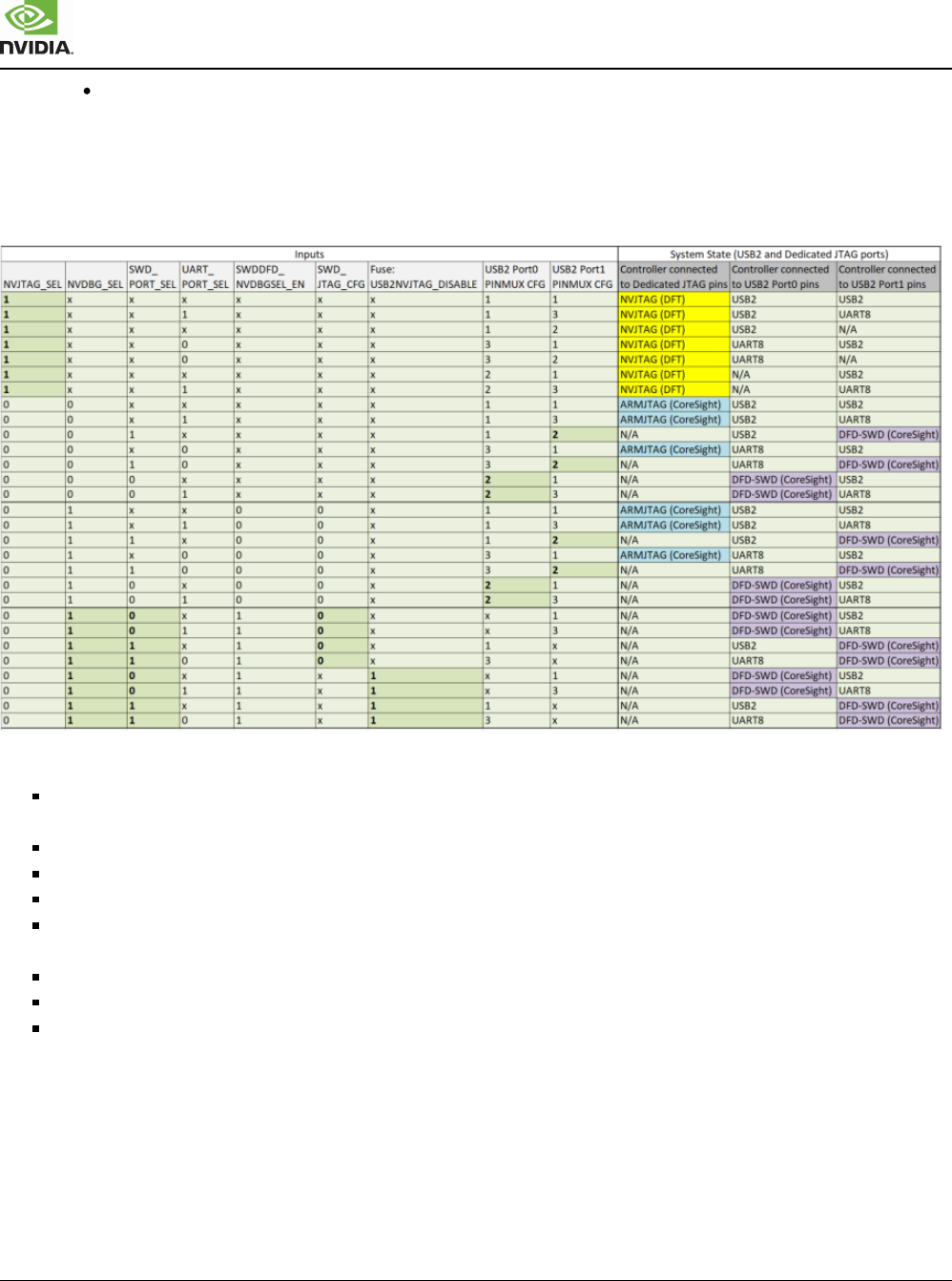
Xavier Series SoC Technical Reference Manual
XAVIER | TRM | DP-09253-002_v1.1 | SUBJECT TO CHANGE | www.nvidia.com Page of 6383 8287
software configurable MMIO register[bits] (e.g., SWDDFD_NVDBGSEL_EN, UART_PORT_SEL,
SWD_PORT_SEL, etc.)
The colors in the System State columns highlight which debug connection (NVJTAG vs. ARMJTAG vs. DFD-
SWD) is supported in that mode, while the bold text in the Inputs columns show some of the most important
inputs that play a role in that connection.
Notes:
SWDDFD_NVDBGSEL_EN, UART_PORT_SEL, SWD_PORT_SEL and SWD_JTAG_CFG and fields in register:
CORESIGHT_SWD_CSITECFG_CFG_CBDCR_0.
SWD_JTAG_CFG must always be '0.'
NVJTAG_SEL and NVDBG_SEL are pins.
fuse: FUSE_OPT_USB2NVJTAG_DISABLE_0 drives USB2NVJTAG_DISABLE.
USB2 Port 0/1 PINMUX CFG refer to XUSB_PADCTL_USB2_PAD_MUX_0[USB2_OTG_PAD_PORT0] and
XUSB_PADCTL_USB2_PAD_MUX_0[USB2_OTG_PAD_PORT1] respectively.
DFD-SWD refers to accessing CoreSight via SWD interface (pinmuxed over USB2 pins)
ARMJTAG refers to accessing CoreSight via JTAG interface
NVJTAG refers to accessing DFT's Test Master via JTAG interface.
Miscellaneous Debug Features
Ability to Configure AXI Transaction Properties for AXI-AP
Access Backbone allows the ability to issue transactions over CBB and DBB. The CBB and DBB AXI interface
contain various user-bits that govern certain transaction properties. Some of these can be modified to help

Xavier Series SoC Technical Reference Manual
XAVIER | TRM | DP-09253-002_v1.1 | SUBJECT TO CHANGE | www.nvidia.com Page of 6384 8287
enhance the debug capabilities. For example, while issuing an access over DBB, the stream-ID of the AXI
transaction can be configured using CORESIGHT_CFG_CSITE_MC_WR_CTRL_0 [ CSITE_SID ].
The following subsections describe the configurability of user bits on CBB and DBB AXI interfaces for AXI-
transactions from AXI-AP.
DBB User Bit Assignments
Table 8.63 AXI Master Write Request Channel
AXI-DBB awuser Bits What drives the corresponding AXI-DBB bits
for a transaction from ETR
What drives the corresponding AXI-DBB bits for a
transaction from AXI-AP
awuser[7:0] =
c2mc_StreamID[7:0]
CORESIGHT_CFG_ETR_MC_WR_CTRL_0
[ ETR_SID ]
CORESIGHT_CFG_CSITE_MC_WR_CTRL_0
[ CSITE_SID ]
awuser[8] = Coh_IO_acc CORESIGHT_CFG_ETR_MC_WR_CTRL_0
[ COH ]
^AWDOMAIN[1:0]
awuser[9] = wsb_ns AWPROT[1] AWPROT[1]
awuser[10] =
sc2mc_vpr_wr
CORESIGHT_CFG_ETR_MC_WR_CTRL_0
[ VPR ]
CORESIGHT_CFG_CSITE_MC_WR_CTRL_0
[ VPR ]
awuser[15:11] =
GSC_AID[4:0]
CORESIGHT_CFG_ETR_MC_WR_CTRL_0
[ GSC_AID ]
CORESIGHT_CFG_CSITE_MC_WR_CTRL_0
[ GSC_AID ]
awuser[17:16] = GSC_AL
[1:0]
CORESIGHT_CFG_ETR_MC_WR_CTRL_0
[ GSC_AL ]
CORESIGHT_CFG_CSITE_MC_WR_CTRL_0
[ GSC_AL ]
awuser[18] = user_adr[5] AWADDR[5] Refer to the Sub-Partition Bits section below.
awuser[21:19] = {
c2mc_adr1[8:6] }
AWADDR[8:6] Refer to the Sub-Partition Bits section below.
awuser[22] =
c2mc_sp_aware
CORESIGHT_CFG_ETR_MC_WR_CTRL_0
[SP_AWARE]
CORESIGHT_CFG_CSITE_MC_WR_CTRL_0
[SP_AWARE]
awuser[25:23] = reserved - -
awuser = [28:26]
c2mc_user_size
CORESIGHT_CFG_ETR_MC_WR_CTRL_0
[ HINT_SIZE ]
CORESIGHT_CFG_CSITE_MC_WR_CTRL_0
[ HINT_SIZE ]
Table 8.64 AXI Master Read Request Channel
AXI-DBB aruser Bits ETR AXI-AP
aruser[7:0] = c2mc_StreamID[7:0] CORESIGHT_CFG_ETR_MC_RD_CTRL_0
[ ETR_SID ]
CORESIGHT_CFG_CSITE_MC_RD_CTRL_0
[ CSITE_SID ]
aruser[8] = Coh_IO_acc CORESIGHT_CFG_ETR_MC_RD_CTRL_0
[ COH ]
^ARDOMAIN[1:0]
aruser[9] = rsb_ns ARPROT[1] ARPROT[1]
aruser[10] = sc2mc_vpr_rd CORESIGHT_CFG_ETR_MC_RD_CTRL_0
[ VPR ]
CORESIGHT_CFG_CSITE_MC_RD_CTRL_0
[ VPR ]
aruser[15:11] = GSC_AID[4:0]

Xavier Series SoC Technical Reference Manual
XAVIER | TRM | DP-09253-002_v1.1 | SUBJECT TO CHANGE | www.nvidia.com Page of 6385 8287
AXI-DBB aruser Bits ETR AXI-AP
CORESIGHT_CFG_ETR_MC_RD_CTRL_0
[ GSC_AID ]
CORESIGHT_CFG_CSITE_MC_RD_CTRL_0
[ GSC_AID ]
aruser[17:16] = GSC_AL[1:0] CORESIGHT_CFG_ETR_MC_RD_CTRL_0
[ GSC_AL ]
CORESIGHT_CFG_CSITE_MC_RD_CTRL_0
[ GSC_AL ]
aruser[18] =
user_adr[5]
ARADDR[5] Refer to the Sub-Partition Bits section below.
aruser[21:19] = {
c2mc_adr1[8:6] }
ARADDR[8:6] Refer to the Sub-Partition Bits section below.
aruser[22] =
c2mc_sp_aware
CORESIGHT_CFG_ETR_MC_RD_CTRL_0
[SP_AWARE]
CORESIGHT_CFG_CSITE_MC_RD_CTRL_0
[SP_AWARE]
aruser[25:23] = reserved - -
aruser[ ] = c2mc_user_size28:26 CORESIGHT_CFG_ETR_MC_RD_CTRL_0
[ HINT_SIZE ]
CORESIGHT_CFG_CSITE_MC_RD_CTRL_0
[ HINT_SIZE ]
AXI Master Read Data Channel
The only user bit driven on Read Data channel is rnv_vpr_resp_user. This signal indicates that this response
data was sourced from VPR aperture. This offers a hardware-only mechanism for the Master to know if the data
is from VPR region or not. Given that neither AXI-AP nor ETR are allowed to read from VPR region, this
optional bit is not taken in by DFD partition.
Register Definitions
Tha table below lists the register definitions of the CORESIGHT_CFG_{ETR,CSITE} {RD,WR}_CTRL_0
MC
Bits ETR CSITE
[28:26] = c2mc_user_size RW=0 RW=0
[25:23] = reserved RW=0 (not used) RW=0 (not used)
[22] = SP_AWARE RW=0 RW=0
[21:19] = ADR1_Bit8toBit6 RW=0 RW=0
[18] = USER_ADR_5 RW=0 RW=0
[17:16] = GSC_AL RO=0 RO=0
[15:11] = GSC_AID RO=0 RW=0
[10] = VPR_{RD,WR} RO=0 RO=0
[9] = {RSB,WSB}_NS RW=0 (not used) RW=0 (not used)
[8] = COH RW=0 RW=0 (not used)
[7:0] = SID RW=0 RW=0
Sub-Partition Bits

Xavier Series SoC Technical Reference Manual
XAVIER | TRM | DP-09253-002_v1.1 | SUBJECT TO CHANGE | www.nvidia.com Page of 6386 8287
Hardware Design Guidelines
If (sp_aware==0)
{
c2mc_adr1[8:6] = AxADDR[8:6];
user_adr[5] = AxADDR[5];
}
Else
{
c2mc_adr1[8:6] =
CORESIGHT_CFG_{CSITE,DFDAUX0,DFDAUX1}MC{RD,WR}_CTRL_0[ADR1_Bit8toBit6];
user_adr[5] =
CORESIGHT_CFG_{CSITE,DFDAUX0,DFDAUX1}MC{RD,WR}_CTRL_0[USER_ADR_5];
}
Software Usage Guidelines
Software should not program SP_AWARE field unless it wishes to use the sub-partition feature in MC. To use
the sub-partition aware feature for accesses from AXI-AP (CSITE) or DFDAUX0/1 ports, program the
SP_AWARE ADR1_Bit8toBit6 fields in the config register corresponding to the access {CSITE, DFDAUX0/1}x
{RD,WR}. Then make the sp-aware access on DBB.
CBB User Bit Assignment
Table 8.65 AXI Master Write Request Channel
AXI-CBB awuser Bits CSITE
awuser[14:11] = MSTR_ID[3:0] MISCREG_CSITE_SECURITY_0 [ MSTR_ID ]
awuser[10:9] = VQC[1:0] CORESIGHT_CFG_CSITE_CBB_WR_CTRL_0 [ VQC ]
awuser[8:2] = GRPSEC[6:0] MISCREG_CSITE_SECURITY_0 [ G7W:G1W ]
awuser[1:0] = FALCONSEC[1:0] CORESIGHT_CFG_CSITE_CBB_WR_CTRL_0 [ FALCONSEC ]
Table 8.66 AXI Master Read Request Channel
AXI-CBB aruser Bits CSITE
aruser[14:11] = MSTR_ID[3:0] MISCREG_CSITE_SECURITY_0 [ MSTR_ID ]
aruser[10:9] = VQC[1:0] CORESIGHT_CFG_CSITE_CBB_RD_CTRL_0 [ VQC ]
aruser[8:2] = GRPSEC[6:0] MISCREG_CSITE_SECURITY_0 [ G7R:G1R ]
aruser[1:0] = FALCONSEC[1:0] CORESIGHT_CFG_CSITE_CBB_RD_CTRL_0 [ FALCONSEC ]
RO = b'00
Register Definitions
Listed below are the register definitions of CORESIGHT_CFG_{CSITE} {WR,RD}_CTRL_0 registers
CBB
described above:
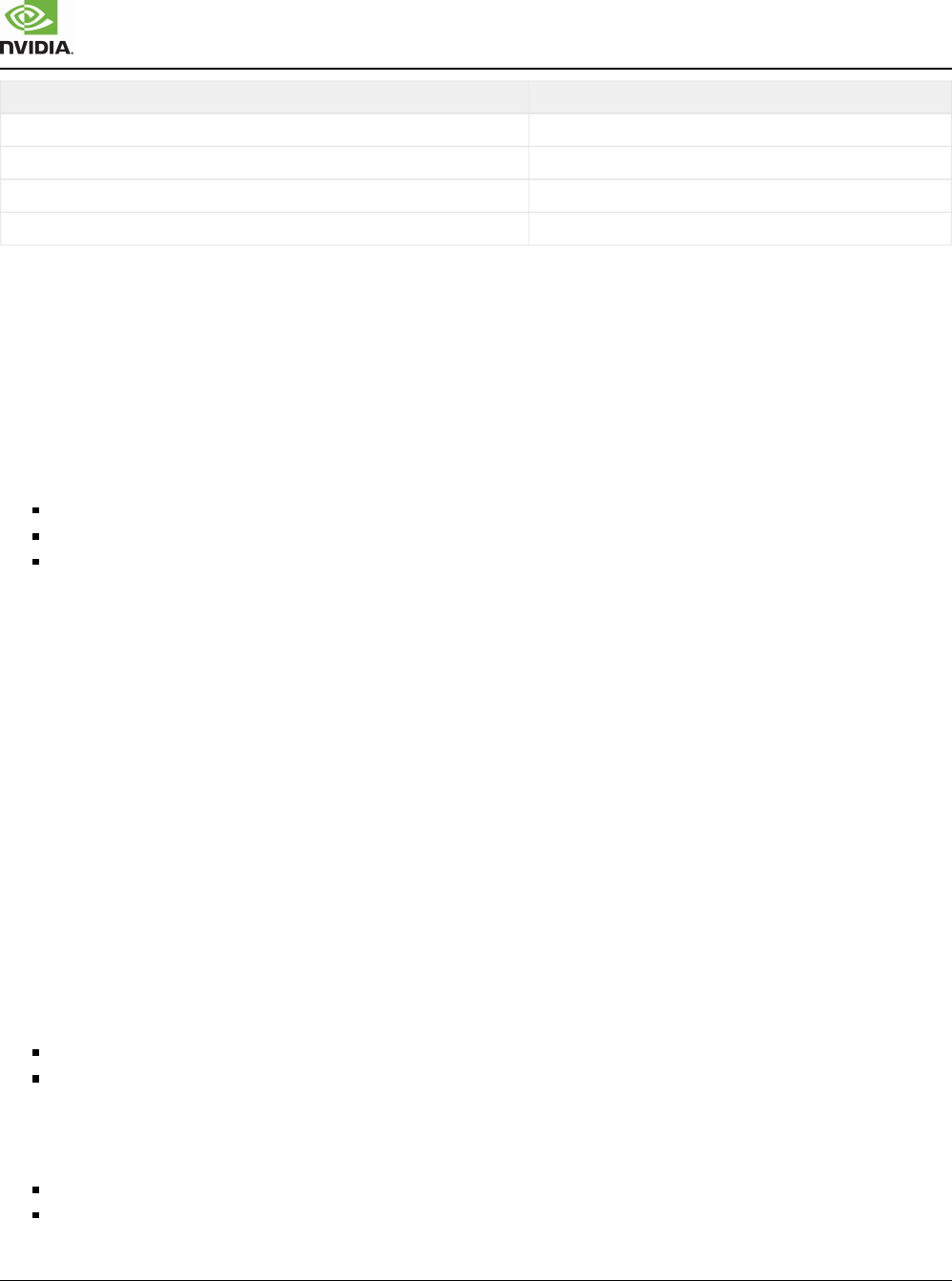
Xavier Series SoC Technical Reference Manual
XAVIER | TRM | DP-09253-002_v1.1 | SUBJECT TO CHANGE | www.nvidia.com Page of 6387 8287
Bits CSITE/AXI-AP
[14:11] = MSTR_ID[3:0] RO = 0xA (not used)
[10:9] = VQC[1:0] RW = b'00
[8:2] = GRPSEC[6:0] RO = b'000_0000 (not used)
[1:0] = FALCONSEC[1:0] RO = b'00
CORESIGHT_CFG_CSITE_CBB_{WR,RD}_CTRL_0 are protected by an independent SCR.
ETR AXI Interface
Although ETR uses an AXI3 interface, it does not support Transaction IDs (AWID, WID, BID, ARID, and RID).
The ETR's AXI interface does not have ports for these signals.
Since ETR is a master on DBB, we need to drive the Transaction ID signals for ETR as follows:
For the ETR AXI-DBB port, ARID is tied to 0x0 while AWID is tied to 0x1.
Ignore BID and RID (as these are driven by slave).
AXI-DBB does not support WID (although it claims to be AXI3 based socket), but the absence of WID on the ETR
interface is not an issue. If AXI-DBB has a WID port, it would be tied to 0x1 to indicate that ETR does not support
write interleaving.
Support Coherency Debug via CoreSight AXI-AP
ACE Lite Background
CoreSight supports ACE-Lite protocol for AXI interface at AXI-AP.
AxSNOOP and AxBAR Optimization
As CoreSight does not contain a cache of its own, AxSNOOP attribute can be ignored and assumed tied to
0b000. Support for native barrier transactions is absent in DBB, and so AxBAR can also be ignored and
assumed tied to 0b0.
AxDOMAIN Optimization
When AxSNOOP[3:0]==0b000 and AxBAR[0]==0b0,
^AxDOMAIN[1:0]==0 implies Non Snooping Access and
^AxDOMAIN[1:0]==1 implies Coherent Access.
AXI-DBB socket doesn't support the 2-bit signal, AxDOMAIN[1:0] on the read/write address channels, but rather
supports a 1-bit signal, COH_IO_ACC[0] on the read/write address channels.
COH_IO_ACC==0 generates a Non-Snooping Access whereas
COH_IO_ACC==1 generates a Coherent Access.

Xavier Series SoC Technical Reference Manual
XAVIER | TRM | DP-09253-002_v1.1 | SUBJECT TO CHANGE | www.nvidia.com Page of 6388 8287
1.
2.
3.
1.
2.
3.
4.
Assigning COH_IO_ACC = ^AxDOMAIN[1:0] is reasonable, but only when SMMU is bypassed. When a
transaction does not bypass SMMU, coherency/snoop is determined by the page table attribute in the SMMU.
Debugging Clusters with DCLS Implementation
For safety reasons, some of the auxiliary Cortex-R5 clusters (e.g., BPMP, SCE) have used the Dual-Core Lock-
Step Implementation to detect faults using redundancy and comparison. However, as the debug logic external
to the Cortex-R5 cores is not replicated, these debug signals are monitored on a Check Not Asserted (CNA)
Bus. Assertion of any signal on the CNA bus can be propagated as a fault indication. This can prevent debug
because as soon as any debug transaction occurs, it could potentially lead to a fault and thus change the
system environment. Also, there could be certain issues that can only be replicated when DCLS is enabled, so
we need ability to debug while DCLS is enabled. To support debugging while DCLS is enabled, configurable
bits are provided that can disable CNA bus monitoring thus preventing assertion of signals that are monitored
on the CNA bus from leading to an error/reset/fault assertion.
Subsequent subsections describe the guidelines to debug clusters with DCLS enabled for the Cortex-R5 cores.
BPMP
Programming the following registers would prevent the debug signals from generating any comparator error
/fault or trigger a CNA event/error/fault:
Write "1" to CPU_CNA_ERR field in the BPMP_MISC_ERR_RESET_MASK2 register ( Software usually leaves Note:
this field to its reset value (1), so programming this during debug might not be necessary.)
Write "0" to ERR63_ENABLE field in the BPMP_ERROR_COLLATOR_ERRSLICE1_MISSIONERR_ENABLE_0
register
Write "0" to ERR63_ENABLE field in the BPMP_ERROR_COLLATOR_ERRSLICE1_LATENTERR_ENABLE_0
register
APS_PROC_CFG_DCLS_ENABLE=1 allows the Cortex-R5s to execute in lock-step despite disabling the
debug signal monitoring. This allows for debugging BPMP without disabling lock-step execution of the Cortex-
R5-cores.
SCE
Program the following fields with '0' to prevent debug transactions to SCE from generating errors/faults:
ERR77 field in the SCE_EC_REGS_ERRSLICE2_MISSIONERR_ENABLE register in SCE_ERR_COLLATOR amap
space
ERR77 field in the SCE_EC_REGS_ERRSLICE2_LATENTERR_ENABLE register in SCE_ERR_COLLATOR amap
space
ERR77 field in the SCE_MISC_AUTOLOCK_EC_ERRSLICE2_MISSIONERR_ENABLE register in SCE_MISC amap
space
ERR77 field in the SCE_MISC_AUTOLOCK_EC_ERRSLICE2_LATENTERR_ENABLE register in SCE_MISC amap
space

Xavier Series SoC Technical Reference Manual
XAVIER | TRM | DP-09253-002_v1.1 | SUBJECT TO CHANGE | www.nvidia.com Page of 6389 8287
APS_PROC_CFG_DCLS_ENABLE=1 allows the Cortex-R5s to execute in lock-step despite disabling the
debug signal monitoring. This allows for debugging SCE without disabling lock-step execution of the Cortex-R5
cores.
Reset Guidelines
Upon reset, debug bus monitoring is disabled. Currently, this ensured that DCLS_ENABLE=0 upon reset. Thus,
even if the error-enable fields in the error-collator registers are '1' upon reset, that isn't an issue as
DCLS_ENABLE=0 suppresses all interrupts/errors/resets/faults from being generated due to assertions on the
debug bus.
Unified UART
In Xavier, depending on platform requirements, we have following UARTs available for printing debug logs:
UART3/UARTC
This UART is in AO-Cluster and hence can be used even in low power states like SC7.
UART6/UARTF
This UART is pinmuxed over the DPAUX0 pins.
UART8/UARTH
This UART is pinmuxed over USB2-Port0 and USB2-Port1 and can be available over either of the two at a
time.
Refer to the Software Application Note on how multiple processors can print UART logs over a single UART
without getting the eventual output log entangled.
CoreSight Debug APB Timeout and Access Block - Deadcodes
To not hang the debugger itself while making accesses on the Debug APB, CoreSight has an internal NV
module to:
Timeout the Debug APB accesses for each of CCPLEX, APE, BPMP, SPE, SCE, PVA, and RCE clusters on no
response.
Blocking the accesses which are guaranteed to result in timeout due to a non-responsive APE, PVA, etc. Either of
these could be non-responsive due to power down, clock gating, or under reset.
Both the timeout and access block features can be separately disabled by using bits in the
CORESIGHT_CFG_CTL_0 register.
For the case of Timeout, users have an option between choosing between a long timeout of 0xffff counts
(default) versus a short timeout of 0x200 (suited for pre-silicon rtl verif to shorten the testcase duration). This
can be done via the CORESIGHT_CFG_CTL_0.
In the event of either a timeout or access block, the access from coresight APB-AP is made to gracefully
complete by asserting respective master pready of the APBIC as 1. In addition, deadcodes are returned on the

Xavier Series SoC Technical Reference Manual
XAVIER | TRM | DP-09253-002_v1.1 | SUBJECT TO CHANGE | www.nvidia.com Page of 6390 8287
1.
2.
3.
a.
i.
ii.
iii.
b.
i.
ii.
iii.
c.
i.
ii.
prdata bus to immediately identify what caused a particular access to timeout/blocked. On receiving the
deadcode, the debugger can query the respective CORESIGHT_CFG_<module>_ALIVE_STATUS register to
check the cause of timeout/blocking.
The table lists the accesses that are blocked by CoreSight. Note that for accesses which are not blocked, they
result in a timeout over the debug APB if the CPUs are not able to respond before the timeout.
Yes indicates Accesses Blocked by CoreSight
Powergated? Under Reset? Clock gated?
Carmel | Cluster0 No No No
R5 | BPMP No Yes No
R5 | SCE No Yes No
R5 | RCE No Yes No
CVPVA Yes Yes No
PVA{0,1}_R5 Yes Yes No
PVA{0,1}_VPU{0,1} Yes Yes No
R5 | SPE Yes Yes No
A9 | APE Yes No Yes
The Cortex-R5s have Processor Integration Layers (PIL) around them that allow access to the debug ROM table
even if Cortex-R5s are clock-gated, and therefore can't be called as non-responsive.
For processors with multiple resets, we are interested only in nsysporresetn and presetdbg to derive a non-
responsive status. The former puts both processor and non-processor logic with debug registers under reset, and the
latter impacts the pipe-stages that transport debug signals.
For CVPVA, PVA0, and PVA1, the coresight accesses are blocked under following circumstances:
CoreSight accesses to CVPVA, PVA0, and PVA1 are blocked when one of the following condition becomes
true
CVPVA is rail gated
CVPVA is under reset (CVPVAPRESETDBGn is asserted)
Clock gating not applicable as components use DBGAPB and CSITE clocks (same as CoreSight)
CoreSight accesses to entire PVA<p> (includes Cortex-R5 PIL and VPS clusters in corresponding PVA) are
blocked when one of the following conditions becomes true ( <p> {0,1} )
PVA<p> is power gated
PVA<p> debug is under reset (PRESETDBGn associated with corresponding Cortex-R5 cluster in the
PVA cluster is asserted)
Clock gating not applicable as CoreSight components use DBGAPB and CSITE clocks (same as
CoreSight)
CoreSight accesses to an Cortex-R5 cluster inside a PVA<p> cluster are blocked when one of the following
conditions becomes true
PVA<p> Cortex-R5 cluster is under reset (nSYSPORESET associated with the Cortex-R5 cluster is
asserted)

Xavier Series SoC Technical Reference Manual
XAVIER | TRM | DP-09253-002_v1.1 | SUBJECT TO CHANGE | www.nvidia.com Page of 6391 8287
3.
c.
ii.
iii.
d.
i.
ii.
iii.
1.
2.
Power gating not applicable because power gating only occurs at entire PVA-level and not individually
for sub-clusters of PVA like Cortex-R5 cluster and VPS-clusters.
Clock gating not applicable as CoreSight components use DBGAPB or CSITE clocks (same as
CoreSight)
CoreSight accesses to a VPS<p,v> cluster inside a PVA<p> cluster are blocked when one of the following
conditions becomes true (<p,v> {00,01,10,11})
VPS<p,v> debug is under reset (VPUPRESETDBGn associated with the VPS<p,v> cluster is asserted)
Power gating not applicable because power gating only occurs at entire PVA-level and not individually
for sub-clusters of PVA like Cortex-R5 cluster and VPS-clusters.
Clock gating not applicable as CoreSight components use DBGAPB or CSITE clocks (same as
CoreSight)
CV
Rail Clamp
CVPVA
PRESETDBGn
PVA<p>
Power
Clamp
PVA<p>_
R5PIL
PRESETDBGn
PVA<p>_
R5PIL
SYSPORESETn
PVA<p>_VPS<v>
VPUPRESETDBGn
CVPVA PVA<p> PVA<p>_R5PIL PVA<p>_VPS<v>
1 x x x x x Blocked Blocked Blocked Blocked
0 0 x x x x Blocked Blocked Blocked Blocked
0 1 1 x x x ALLOW Blocked Blocked Blocked
0 1 0 0 x x ALLOW Blocked Blocked Blocked
0 1 0 1 0 0 ALLOW ALLOW Blocked Blocked
0 1 0 1 1 0 ALLOW ALLOW ALLOW Blocked
0 1 0 1 0 1 ALLOW ALLOW Blocked ALLOW
0 1 0 1 1 1 ALLOW ALLOW ALLOW ALLOW
where <p,v> {00,01,10,11}
When blocking is disabled and timeout enabled, the deadcode obtained from clusters that are PG'ed is
0xdead1002 as opposed to the expected TIMEOUT_EN deadcode. This is because, when PG-ed the ports are
clamped in such a way that 0xdead1002 is returned with PSLVERR, a read transaction is issued over Debug
APB. So the access does complete without a timeout and the deadcode is natively returned from the client.
CPU DBGACK Aggregation
CoreSight collects the DBGACKs from all the CPUs and updates them in its status registers.
During the halting of the CPUs, the WDT themselves should stop ticking to avoid firing away and unintentionally
causing system reset.
During the debug of timer software, the timers must themselves halt to observe if they are ticking correctly.
In all other cases the timers are expected to continue running.
As Xavier adds more CPUs, there is a need to aggregate the DBGACKs in a single place and broadcast a
single global signal. This is scalable since the system timers do not need to worry about the number of CPUs in
the SoC. CoreSight already has this info and all the DBGACKs.
For this a new register is added called CORESIGHT_CFG_DEBUG_ACK_QUAL_0 in the CoreSight
configuration aperture. When this bit is set, the corresponding DBGACK in
CORESIGHT_CFG_DEBUG_ACK_0 participates in the timer freeze else the effect of that DBGACK is ignored.

Xavier Series SoC Technical Reference Manual
XAVIER | TRM | DP-09253-002_v1.1 | SUBJECT TO CHANGE | www.nvidia.com Page of 6392 8287
The enable bit offset in CORESIGHT_CFG_DEBUG_ACK_QUAL_0 must match the corresponding CPU
DBGACK in CORESIGHT_CFG_DEBUG_ACK_0.
The global timer halt equation:
dfd2all_freeze_timers_req = | (CORESIGHT_CFG_DEBUG_ACK_0 [m:0] and
CORESIGHT_CFG_DEBUG_ACK_QUAL_0 [m:0])
dfd2all_freeze_timers_req is broadcast to various timekeeping elements timers, to RTC, and to TSC.
Each of the timers internally adds a halt on the debug (HDBG) bit to allow it to halt/continue ticking when the
dfd2all_freeze_timers_req is asserted. This register bit in the timer AMAP page can then follow the security
attributes for the timer AMAP or add its own security attribute via the Security Control Register in Xavier.
Additionally, a HDBG_CPU bit has also been added in TSC.
